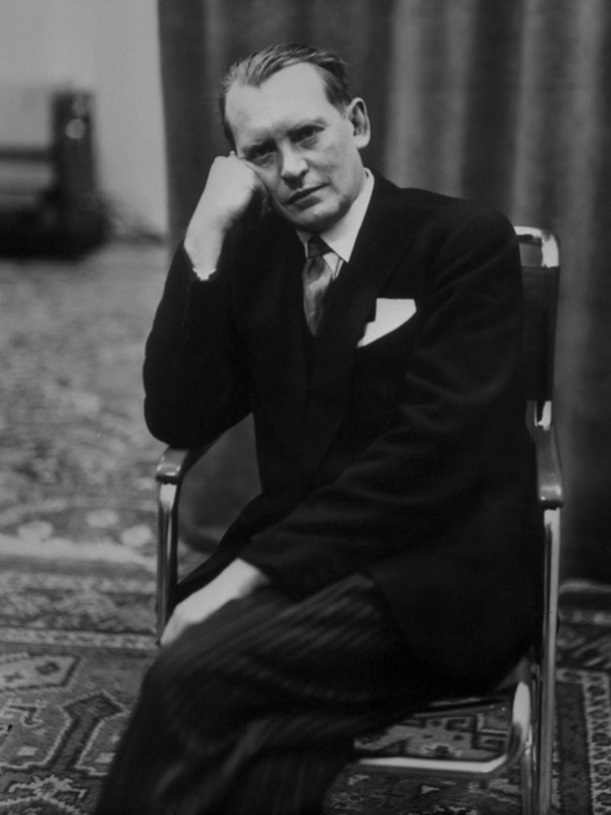
Edward Winter

Alexander Alekhine in Prague,
December 1933.
Photograph supplied by Olimpiu G. Urcan, courtesy of the ČTK
Fotobanka.
***
Bobby Fischer’s view of Alekhine appeared in the article ‘The Ten Greatest Masters in History’ (on pages 56-61 of Chessworld, January-February 1964):
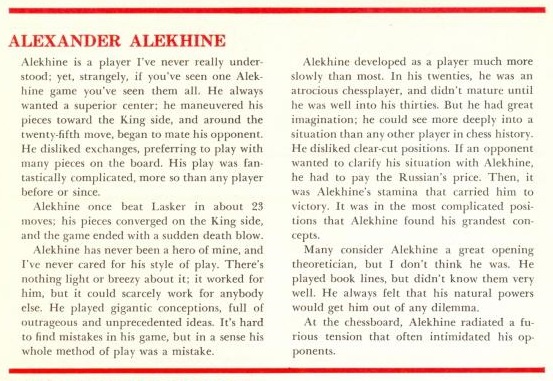
Would anyone venture to offer serious support to Fischer’s contention, ‘strangely, if you’ve seen one Alekhine game you’ve seen them all’?
(12011)
Column 63 on page 27 of The Chess Beat by Larry Evans (Oxford, 1982) discusses the spurious game Alekhine-Grigoriev ‘Moscow, 1915’, given by Alekhine in his first collection of best games, but now known to be more invention than reality. Evans writes that ‘The first 11 moves did take place but the rest was a total fabrication’. What Alekhine wanted to show off was the five queens position and the quiet winning move 24 Rh6. Yet Evans says that Black could have drawn anyway by ...
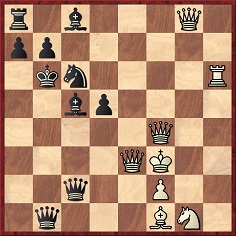
24...Bg4+ 25 Qgxg4 Bxe3 26 Qb4+ (Or 26 Qxe3+ Qc5) 26...Qxb4 27 Qxb4+ Kc7 28 Qd6+ Kb6 29 Qb4+ and White has no more than perpetual check.
Do readers have any more information about the circumstances of this ‘game’. We recall that the late D.J. Morgan once told us that in any case Alekhine had been Black.
(326)
The Quotes and Queries column in the February 1983 BCM takes up this question. Moreover, C.D. Robinson (Toronto, Canada) sends us a few more facts:
‘Dr Buschke exposed this “game” as a fabrication in 1950-51 in his Chess Life series “Alekhine’s early chess career”. Kotov came to the same conclusion in 1957 (see Krabbé’s “On mass suggestion”, Chess Life & Review, 1977, page 480). Despite this, Kotov includes the “game” in his biography of Alekhine as “Alekhine-N.N., Moscow 1915”. According to M.V. Anderson (BCM 1958, page 133) the “game” originated in du Mont’s Elements of Chess in 1925. Moreover, du Mont and M.E. Goldstein were then engaged in translating the French MS of My Best Games of Chess 1908-23, which was published in 1927. “Alekhine’s MS was in appalling writing, and there was no collaboration between Alekhine and his two translators”, says Anderson. “Goldstein told me ... ‘We found (the score) among his papers and had no reason to challenge it.’”’
Mr Robinson concludes: ‘It is clear that Alekhine’s text includes both suggestio falsi and suppressio veri.’
It seems reasonable to assume that Alekhine was so taken with the quiet rook move that he simply tried to pull the wool over the chess world’s eyes. There is much irony and even pathos in the fact that it has subsequently been proved that the rook move does not win at all.
(387)
Chess Curiosities by Tim Krabbé (George Allen & Unwin) has themes ranging from castling to Loman’s Move and the Saavedra Manoeuvre. All are examined in impressive depth; it is a safe bet that Krabbé is the only author ever to have devoted ten pages to a discussion of ‘Alekhine’s five queens game’.
(1094)
Headed ‘The Mythical “Five Queens’ Game”’, an item by D.J. Morgan on page 130 of the May 1956 BCM began:
‘The ghost has been truly laid ...’
He was reporting on a series of articles by Albrecht Buschke in Chess Life in 1950 which had demonstrated that the ‘five queens’ play given by Alekhine in a note to Game 26 in his first volume of Best Games was spurious.
C.N.s 326 and 387 touched on the matter, and since then it has been analysed in detail by Tim Krabbé, on pages 54-64 of Chess Curiosities (London, 1985) and on his website. The case is regularly cited as an example of Alekhine’s ‘dishonesty’.
How is it possible that, even today, there are authors who state that Alekhine won such a game? The latest instance noted by us is on page 381 of Best Play by Alexander Shashin (Newton Highlands, 2013).
See also Chess Games with Five Queens.
On page 69 of World Chess Champions (Oxford, 1981) in the chapter on Alekhine, Bernard Cafferty writes as follows:
‘He studied his speciality law at the Sorbonne and is supposed to have received a doctorate there in 1925 for his thesis “The Prison System in China”, but a recent search in the records of the famous institute of higher education has failed to reveal his name amongst the alumni. It seems that he began the course of study, but did not complete it.’
The research referred to was undertaken by Brian Reilly. Recently we had an opportunity to make a similar investigation ourselves, with the same negative result.
We should like to be quite clear on this matter: did Alekhine give himself the title ‘Doctor’ under false pretences, perhaps in an effort to build himself up in the eyes of the chess world for a title match with Capablanca?
(437)
From C.D. Robinson:
‘I too have drawn a blank in tracking down Alekhine’s doctorate ...
Let us suppose that Alekhine’s claim was false. He was living in Paris, home of the Sorbonne, and he was something of a public figure. From 1925, he was habitually referred to as Dr Alekhine in newspapers and chess magazines. At any moment he could have been exposed as a fraud and held up to overwhelming ridicule – the worst fate that could befall so proud a man. I cannot believe that he would have run such an enormous risk. If he wanted to claim a doctorate to which he was not entitled, it would have been much safer to involve a Russian university.
It seems likely that the doctorate was genuine, and that university archives are fallible.’
(487)
From Ken Whyld (Caistor, England):
‘Alekhine was not a doctor. He enrolled but registered only two of the four stages required. I have seen a photocopy of his academic transcript. The title was probably first “awarded” to him by du Mont in the English translation of My Best Games of Chess 1908-1923 where the early editions had it on the title page. Unlike the mendacious Zukertort, Alekhine did not claim the false title in the first place, but when it “stuck” he would certainly have found it a help to his career.’
Alekhine refers to his preparations for the doctorate examinations in a letter to Levenfish written just before the start of Moscow, 1925 (see page 207 of the July 1967 BCM).
(523)
In a discussion about the pro-Nazi articles attributed to Alekhine we wrote:
It could be argued that arrogance, lack of a sense of danger and indifference to possible repercussions were indeed traits of Alekhine’s character. Certainly he never seems to have worried about being caught out over score-tampering or his non-existent doctorate, and, as far as we recall, during his lifetime he never was.
(1233)
In C.N. 523 Ken Whyld suggested that Alekhine’s doctorate was probably first ‘awarded’ to him by du Mont in the English translation of My Best Games of Chess 1908-1923. In fact, though, the title was already firmly established well over a year before the book was published in around June or July 1927. Page 29 of the January 1926 Wiener Schachzeitung is the earliest reference we have found; using ‘Dr Aljechin’ for the first time, the magazine explains: ‘er holte sich kurz vor Weihnachten in Paris den Doktorthut’. The BCM seems to have started writing ‘Dr’ in its July 1926 issue.
(1374)
C.N. 1233 stated that as far as we could recall no-one disputed Alekhine’s doctorate during his lifetime. Not so, for we now note the following on page 28 of the November 1945 CHESS:
‘Prins in the Groene writes: “The world champion of France is going to disappear from the scene of affairs. A ‘Dr’ and officer in the French Army, but with his right to neither title any longer acknowledged, he is threatened with exclusion by several chess authorities.”
Oskam too states that Alekhine is not entitled to the title of “Dr” which, in general Continental usage, is a University degree not specially associated with medicine.’
(1842)
From the fine article by Walter Meiden in the April 1982 Chess Life (page 21) we take the following Euwe quotes:
‘Alekhine can see five or six times as much as I can, but I have a plan, and that plan sometimes permits me to win.’
‘Alekhine outplayed me tactically; I outplayed him strategically.’
‘Alekhine should have won the 1935 match; I should have won the 1937 match.’
(497)
The game Mellgren v Alekhine, Örebro tournament, 1935 (1 e4 c5 2 Nf3 Nc6 3 d4 cxd4 4 Nxd4 Nf6 5 Nc3 e5 6 Nxc6 bxc6 7 Bg5 Rb8 8 Bxf6 Qxf6 9 Bc4 Rxb2 10 Bb3 Bb4 11 Qd2 d5 12 exd5 e4 13 O-O-O Bxc3 14 Qe3 O-O 15 d6 Bg4 16 d7 Bxd1 17 Rxd1 Ba5 18 Qd4 Qxd4 19 Rxd4 Rxb3 20 White resigns) was published by Purdy on page 216 of the Australasian Chess Review, 1 August 1935 with the heading ‘Alekhine goes back to Labourdonnais for his latest novelty!’ However, the Frenchman’s ...e5 against McDonnell always came on the fourth move. Nowadays, of course, the line with 5...e5 is called the Lasker-Pelikan, although Emanuel Lasker played it in only one serious game in his entire life (the ninth match-game with Schlechter, 1910, drawn after 65 moves).
(577)
One might expect chess writers to be capable of reporting correctly the basic details of, at least, a famous event such as the 1927 world championship between Capablanca and Alekhine. It took place in Buenos Aires in 1927. There were 34 games, and Alekhine won with a score of +6 –3 =25.
On page 10 of 100 Classics of the Chessboard, A.S.M. Dickins and H. Ebert state that it took place in New York.
On page 163 of The Literature of Chess John Graham wrote: ‘The final result? Alekhine won by four games to three with 25 draws!’
On page 14 of Karpov-Korchnoi 1978 by Raymond Keene: ‘Matches varied in length from ten games (Lasker-Schlechter 1910) to 35 (Capablanca-Alekhine 1927).’
Ibid., page 124: ‘Most commentators were predicting a long match and the record of 35 games held by Capablanca v Alekhine 1927 appeared in danger.’
Ibid., page 138: ‘... the 35 games of the 1927 Capablanca-Alekhine match’.
Page 50 of the Larousse du jeu d’échecs states that the match lasted three months, and page 371 says that Alekhine was proclaimed world champion after the 27th match-game.
(585, 889 & 1015)
In Buenos Aires both Capablanca and Alekhine encountered the prodigy Rodrigo Flores.
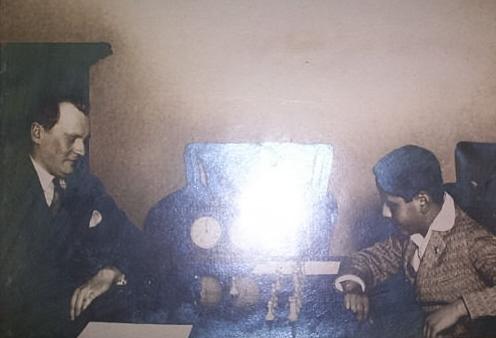
The game Alekhine v Cukierman, Paris, 1933 began 1 d4 d5 2 c4 e6 3 Nc3 Nf6 4 Bg5 Be7 5 e3 Nbd7 6 Nf3 O-O 7 Rc1 b6 8 cxd5 exd5 9 Bb5 Bb7 10 O-O a6 11 Ba4 c5 12 Bxd7. In My Best Games of Chess 1924-1937 (page 129) Alekhine gives this note to his 12th move:
‘Much more exact than 12 dxc5 Nxc5 etc., with a playable game for Black, as it happened in a game Capablanca-Teichmann in 1913. If now 12...Qxd7 then 13 dxc5 bxc5 14 Na4! with a decisive position advantage.’
However, Alekhine’s claim to have improved on the Cuban’s play is incorrect. Capablanca-Teichmann had gone 11...Rc8 12 Qe2 c5.
It would be unproductive to note slips in every old book, but it is worthwhile in the case of the great classics.
(617)
C.N. 3724 remarked that the Belgian magazine L’Echiquier sometimes employed an unusual form of the figurine notation. Below is the full game mentioned in that earlier item. It was given, with notes by Alekhine, on pages 339-341 of the August 1929 issue:

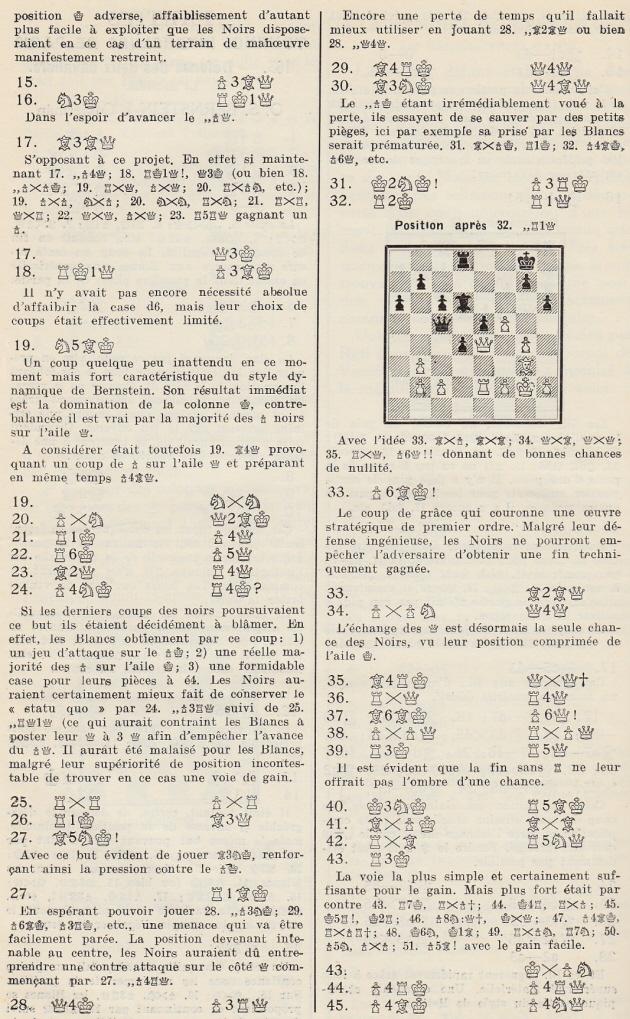

Ossip Samuel Bernstein – Josef Isaevich Cukierman
Two Knights’ Defence
Paris, 24 February 1929
1 e4 e5 2 Nf3 Nc6 3 Bc4 Nf6 4 d4 exd4 5 O-O d6 6 Nxd4 Be7 7 Nc3 O-O 8 Nde2 Be6 9 Bb3 Qd7 10 Nf4 Bxb3 11 axb3 Rfe8 12 Nfd5 Nxd5 13 Nxd5 Bf8 14 Qf3 Ne7 15 Bd2 c6 16 Ne3 Red8 17 Bc3 Qe6 18 Rfd1 f6 19 Nf5 Nxf5 20 exf5 Qf7 21 Re1 d5 22 Re6 d4 23 Bd2 Rd5 24 g4 Re5 25 Rxe5 fxe5 26 Re1 Bd6 27 Bg5 Rf8 28 Qe4 a6 29 Bh4 Qd5 30 Bg3 Qc5 31 Kg2 h6 32 Re2 Rd8 33 f6 Bc7 34 fxg7 Qd5 35 Bh4 Qxe4+ 36 Rxe4 Rd5 37 Bf6 d3 38 cxd3 Rxd3 39 Re3 Rd4 40 Kg3 Rf4 41 Bxe5 Bxe5 42 Rxe5 Rb4 43 Re3 Kxg7 44 h4 a5 45 f4 b5 46 h5 a4 47 bxa4 bxa4 48 Rc3 Rxb2 49 Rxc6 a3 50 Rg6+ Kh7 51 Ra6
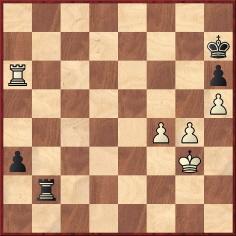
51...Ra2 52 g5 hxg5 53 fxg5 Ra1 54 Ra7+ Kg8
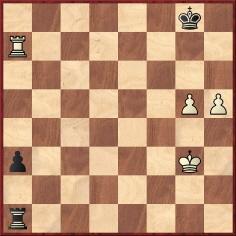
55 g6 a2 56 Kg2 Rb1 57 Rxa2 Rb5 58 Ra8+ Kg7 59 Ra7+ Kg8 60 Rh7 Rg5+ 61 Kh3 Rg1 62 Kh4 Rg2 63 Ra7 Rg1 64 Ra4 Kg7 65 Rg4 Rh1+ 66 Kg5 Rh2 67 Rg1 Rh3 68 Ra1 Rg3+ 69 Kf4 Rg2 70 Ra5 Kh6 71 Rf5 Rg1 72 Ke5 Rg2 73 Rf8 Kg7 74 Rf7+ Kg8 75 Rb7 Re2+ 76 Kf6 Rf2+ 77 Kg5 Rf8 78 h6 Resigns.
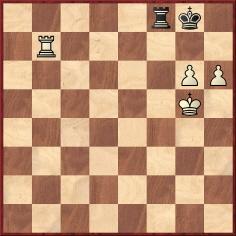
(8766)
Alekhine’s reference at move 51 to Tarrasch and Chigorin concerns their ninth match-game. The remainder of C.N. 8766 gave a relevant extract from Der Schachwettkampf zwischen Dr. S. Tarrasch und M. Tschigorin, Ende 1893 by Albert Heyde (Berlin, 1893), pages 50-51.
To the end Alekhine remained a remarkably fine chess writer and claimed that Gran Ajedrez contained some of his best analysis. However, his wartime Spanish works are not without their defects; apart from an incredibly high number of misprints (for which, presumably, Alekhine was not to blame), the world champion himself became careless. Those who have 107 Great Chess Battles may wish to note the following:
Page 2: Note to Black’s 21st move, fourth line. Alekhine missed the mate in four, writing on page 113 of Gran Ajedrez ‘mate en cinco’.
Page 71: After Black’s 5th move. The English book omits a nonsensical note by Alekhine: ‘If 5...CD3A, White could avoid the exchange of his AR by playing 6 D2R P4TD 7 CR3A A3T 8 P4AD! etc.’ (Gran Ajedrez, page 145).
Page 111: After 1 P4R P4AD 2 P3AD P4D 3 PxP DxP 4 P4D C3AD 5 C3AR A5CR 6 A2R PxP 7 PxP P3R 8 C3AD A5CD, Alekhine in fact added to the given note that a better course would be 8...C3AR 9 O-O D4TD etc. This, of course, is impossible. (Ajedrez Hipermoderno, volume II, page 12).
Page 221: Note to White’s 35th move. Alekhine actually wrote ‘38 R4A C6R+ 39 R5A, followed by 40 R6A etc.’ The last-mentioned move is illegal and suggests that Alekhine was indulging in blindfold analysis.
Spanish notation works as the English descriptive. R=king; D=queen; T=rook: A=bishop; C=knight; P=pawn. Thus the QP, Nimzowitsch Defence begins: 1 P4D C3AR 2 P4AD P3R 3 C3AD A5C.
(687)
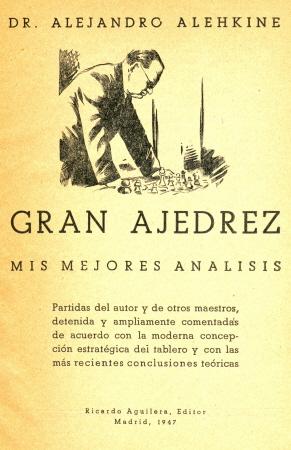
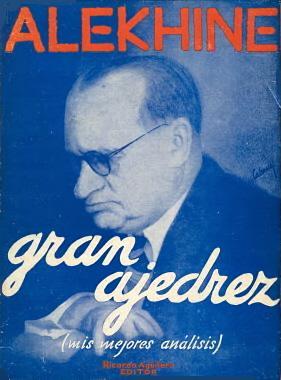
For analysis by Alekhine of a nineteenth-century game, see Anderssen v Zukertort.
Capablanca once chose his top 12 (active) masters, dividing them into three groups:
1) Alekhine, Capablanca, Lasker;
2) Bogoljubow, Nimzowitsch, Vidmar;
3) Euwe, Marshall, Réti, Rubinstein, Spielmann, Tartakower.
Source: Wiener Schachzeitung February 1929, page 61, the material being acknowledged as taken from the Glasgow Herald.
(694)
We note that the Scottish newspaper published this unsourced report on page 7 of its 8 December 1928 edition:
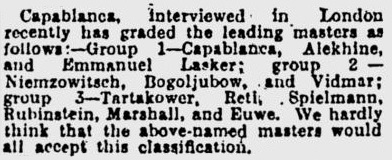
Of all the traps confronting the chess writer that of ‘annotating by result’ is one of the most formidable. So often it is implied that the winner did not put a foot wrong, while the opponent was doomed from the start. Agonía de un Genio by Pablo Morán has a curious example. On page 278 is the game Alekhine-Gallego, Gijón, 1944, which began: 1 e4 e5 2 Nf3 Nc6 3 Bb5 a6 4 Ba4 Nf6 5 O-O b5 6 Bb3 Be7 7 d4. This last move is awarded an exclamation mark, and there is a note saying that White takes advantage of Black’s divergence from the usual order of moves by playing d4 straight away without losing time with Re1. However, the same position crops up on page 294, except this time Alekhine is Black (against Medina, Sabadell, 1945). But now White’s 7 d4 is criticized, 7 a4 being recommended. (In fact, although he won against Gallego, Alekhine only drew with Medina.)
(704)
An endnote on pages 265-266 of Chess Explorations:
The discrepancy remained in the subsequent English edition, A. Alekhine, Agony of a Chess Genius (Jefferson, 1989). See pages 216 and 227 of that book.
What was Alekhine really like as a person? The following is taken from a recent review of World Chess Champions by Dale Brandreth in Chess Horizons:
‘One can read many accounts in the literature of the game: some purporting to show that he was vain, arrogant, selfish, often drunk, anti-Semitic, and prone to changing scores of his games in his later writings to show himself in an even more favorable light, while others show him as fair and always willing to analyse games even with the weakest players, capable of kindness towards younger players, especially, and a very reasonable annotator to give praise to his opponents. In my view he was very likely all of these things for most human beings have both good and bad points and these are not necessarily fixed and immutable.’
We imagine that Alekhine’s status has led to both virtues and vices being exaggerated. A small point: the score-tampering was probably more usual in the early, not late, Alekhine. (Offhand we can think of no examples from the 1930s and 40s.)
(722)
A splendid book is the CHESS volume on the 1937 world championship match with ‘exclusive statements’ by the two players. Here, for instance, is Euwe on Alekhine, from page 75:
‘I must above all marvel at the manner in which he treated the adjourned positions. This is all the easier to judge since I also had to analyse the adjourned games, and thus knew them through and through. When I think of the creative ideas which my opponent sometimes infused into the positions, of the unexpected turns which he was able to discover, then I must express the greatest admiration for his mastery of this phase of the game.’
(770)
See too Euwe and Alekhine on their 1937 Match.
One need look no further than the game-headings in the four-volume translation Herencia Ajedrecística de Alekhine by A. Kotov:
Tinner-Alekhine, Podebrad, 1936; Bad Naugheim, 1937; Kebitz; Scheveninguen (a dubious Spanish ‘transliteration’?); Magret, 1937; Match-Alekhine, Hamburg, 1930; Alekhine-Seitz, Hastings 1926-27 (neither player was in that tourney); Alekhine-Seitz, London, 1922 (Seitz was not there – Yates is meant); Brandley Beach, 1929; Apchenek; Mogreb, 1938; Bradly-Beach.
But the best, and one that says it all, is on page 86 of the second volume: Marco-Alekhine, Gaaga, 1921.
What is known about Alekhine’s brilliancy against Feldt? The following footnote on Leon Stolzenberg appears on page 129 of America’s Chess Heritage by Walter Korn:
‘Leon, who had been a medic in the hospital at Tarnopol in World War I, corrected an error, traceable to a collection of games by Alekhine (Berlin, 1922); A blindfold game, quoted therein as Alekhine-Von Feldt, was actually played against Dr Martin Fischer, the intern; and it occurred in 1916, not in 1917.’
(783)
Dale Brandreth’s latest book list reviews World Chess Champions (Oxford, 1981):
‘One interesting minor point on Alekhine of which I have personal knowledge is that the famous game Alekhine-Feldt (?) from the Tarnopol Hospital in 1916 was explained to me as being spurious by Leon Stolzenberg, the well-known US player who also happened to be convalescing in that hospital at the same time. He claimed that there was no such game played in that exhibition. Whether Alekhine played such a game in another exhibition in that period and confused the two (he wrote much from sheer memory) or whether there was a game there that could have had such a beautiful finale, is unknown, but this is but another mystery in the saga of Alekhine’s questionable games.’
(1191)
From Ed Tassinari (Scarsdale, NY, USA):
‘Regarding the Alekhine-Von Feldt game at Tarnopol Hospital, 1916, mention of this is made in an article by D. Richards “Alekhine: The Missing Years” in CHESS of 29 February 1964, pages 191-193. The author opines that the game occurred, and was probably played in September 1916. Richards also adds that Alekhine managed to win the city championship of Moscow in both 1915 and 1916; the 1915 victory being mentioned in Kogan’s Slovar shakhmatista (Leningrad, 1929), and that after his internment with the break-up of the Mannheim event (1914), was sent to Baden-Baden by the German authorities. There, with the other Russian competitors, he was allowed to live in a hotel. Richards states: “Here Alekhine began work on a book of the 1913-14 All Russian Masters’ Tournament, in which he had finished equal first with Nimzowitsch.” One wonders whatever became of this work. He further adds that Alekhine was soon released and by the end of the year was back in Russia since “he suffered from a heart disease, however, and was presumably considered unfit for military service ...” Are there any other contemporary references to Alekhine’s health, given the gravity of any heart ailment, especially for a chess master? In the recently translated Notes of a Soviet Master (parenthetically, the kind of book that ought to be translated into English) by Ilyin-Genevsky, the author makes no mention of any ailment of that nature, although he knew Alekhine during and immediately after World War I.’
Tony Gillam (Nottingham, England) informs us:
‘When Alekhine extricated himself from internment in 1914 he went first to Switzerland, then France, England, Sweden and St Petersburg. He played some chess in Sweden but apparently not in England.’
(1360)
C.N. 1360 mentioned Alekhine’s little-known visit to England just after the outbreak of the First World War. We now note that Alekhine himself referred to this in a letter published on page 338 of the September-October 1936 issue of Les Cahiers de l’Echiquier Francais:
‘I left Germany (without a false passport) in September 1914, and via France, England and Norway I returned to Russia, where I stayed until 1921 ...’
(1462)
Rob Verhoeven (The Hague, The Netherlands) sends a photocopy of pages 35-37 of the February 1929 Deutsche Schachblatter, which contains an interview with Alekhine by Dr Alexander Andrejewsky, taken from the Mährisch Ostrauer Morgenzeitung. Alekhine says:
‘In Mannheim fand im Sommer 1914 ein Schachturnier statt, das durch den Ausbruch des Krieges unterbrochen wurde. Ich musste so schnell wie möglich über die schweizerische Grenze fliehen und dann über Italien, Frankreich, England, Norwegen, Schweden und Finnland nach meiner Heimat zurückkehren ...’
(1557)
Alekhine’s comment on Sämisch-Navarro, Madrid, 1943:
‘Sämisch wanted to show in his last game of the tournament that he is capable of playing a game without running out of time.’
Source: tournament book, page 212.
(784)
A couple more examples of side-swipes by Alekhine at fellow masters:
Fine-Capablanca (Nottingham, 1936 tournament book, page 244) – drawn in 20 moves: ‘A delightful game for the annotator. I think it is the only one in this collection which does not even deserve a diagram.’ (It wasn’t.)
Euwe-Flohr (Zurich, 1934 tournament book, page 133) – drawn in 19 moves: ‘A typical Euwe-Flohr game!’
(947)
Did a world champion once drop off to sleep whilst defending his title? Yes, according to an article by Thomas Olsen, ‘Capablanca – and Some Others’ in CHESS, 14 November 1938. From page 86:
‘At Buenos Aires, Alekhine triumphed in a contest of long and tiring games, during one of which Capablanca, apparently or actually, fell asleep at the board waiting for Alekhine to move and had to be awakened by the officials.’
Not a likely story, even with the escape clause ‘apparently or actually’. If only ‘apparently’, there would have been no awakening.
(824)
From C.D. Robinson:
‘No, Capablanca did not fall asleep during a game of the 1927 world championship match. The circumstances of the 16th game were the reverse of soporific according to Alekhine’s account in Auf dem Wege zur Weltmeisterschaft (Berlin and Leipzig, 1932).’
We quote from page 178 of the English edition, On the Road to the World Championship 1923-1927 (Oxford, 1984):
‘My decision to agree a draw so early is explained only by the quite unusual circumstances in which this game took place. In fact, we were playing in the Jockey Club, not the usual venue, and it was so noisy there that we were forced to adjourn at move 24, i.e. even before the time control, in order to allow time for things to calm down. Later on, however, I was no longer in the mood for deep thought, and the game was agreed drawn without further ado.
Incidentally, the above lines may serve to show that the report that my opponent “fell asleep” during this game was nothing more than the invention of some witty newspaper man.’
(861)
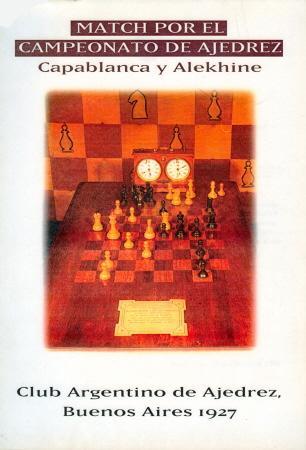
A very rare book published in Buenos Aires in 1994, Match por el campeonato de ajedrez Capablanca y Alekhine, reproduces about two dozen letters and telegrams exchanged by the two masters and the organizers, and an item of particular interest is a letter written on 18 October 1927 by Alekhine, in French, on stationery of the Majestic Hotel, Buenos Aires. The recipient was the President of the Club Argentino de Ajedrez, Lizardo Molina Carranza, to whom Alekhine complained of having read in the morning’s newspapers that game 17 would be played at the Jockey Club. Refusing to accept this, Alekhine commented that the previous day game 16 had been played there under conditions contrary to the spirit and letter of the match rules. In view of the unbearable noise in adjoining rooms, Capablanca had been obliged to stop his clock, thereby breaking off the game (an occurrence ‘probably unique in the annals of the world championship’). Finding mental effort impossible in such circumstances, Alekhine had accepted Capablanca’s draw offer despite having the better position.
The two key paragraphs in Alekhine’s letter are given below, with some corrected spelling:
‘A. Mon adversaire, vu le bruit insupportable qui régnait dans les pièces adjacentes à celle où se jouait la partie, se vit obligé à arrêter la pendule, suspendant ainsi de propio avisu [sic] le jeu, chose probablement unique dans les annales des championnats du Monde.
B. Moi-même ne vis d’autre solution pour sortir de cette atmosphère hostile à tout travail mental, que d’accepter la nullité proposée par mon adversaire, dans une position que je considérais avantageuse pour moi et qui, en tout cas, aurait pu donner lieu à une lutte sérieuse et prolongée.’
Regarding the story that Capablanca fell asleep during game 16, page 44 of Le match Capablanca Alekhine (Brussels, 1929) V. Soultanbéieff commented that, according to the United Press, this had occurred while Alekhine was reflecting on his 19th move and that Capablanca was not awoken by the match director until it was his move. A footnote on the same page stated that Alekhine had denied the sensational story.
Alekhine subsequently wrote about the matter in Auf dem Wege zur Weltmeisterschaft (Berlin and Leipzig, 1932), and here we quote the relevant passage from page 178 of the English edition, On the Road to the World Championship 1923-1927 (Oxford, 1984):
‘My decision to agree a draw so early is explained only by the quite unusual circumstances in which this game took place. In fact we were playing in the Jockey Club, not the usual venue, and it was so noisy there that we were forced to adjourn at move 24, i.e. even before the time control, in order to allow time for things to calm down. Later on, however, I was no longer in the mood for deep thought, and the game was agreed drawn without further ado.
Incidentally, the above lines may serve to show that the report that my opponent “fell asleep” during this game was nothing more than the invention of some witty newspaper man.’
We wonder whether any of the above has a bearing on C.N. 2403, which quoted an alleged incident reported on page 140 of the September 1928 Schweizerische Schachzeitung, in an account of the FIDE Congress in The Hague on 2 August. Below is our translation:
‘During one game in the world championship match, Mr Capablanca, who had the move and sufficient time in reserve, ventured to go into an adjoining room, leaving his clock running, in order to analyse the position in depth; this he did for an hour, on his pocket board. Since this case was not covered by the Regulations, the arbiter had no power to intervene. That power is now recognized: players must, except in case of absolute force majeure, remain under the surveillance of the arbiter.’
From page 78 of Portraits and Reflections by Stuart Hodgson (London and New York, 1929), a book discussed in C.N. 8889:
‘Alekhine won. The Invincible was beaten. Exactly why it happened has not been really explained. But I suspect light is thrown upon it by an incident which occurred during the long gruelling contest. The unfeeling world roared with laughter when it was learnt that during one of Alekhine’s long meditations Capablanca had fallen asleep and had to be awoken forcibly when his turn came. But any man who has ever played even one hard-fought four-hour chess match will not be much disposed to laugh at that incident.’
See Chess and Sleep.
From Charles Warburton’s My Chess Adventures, page 42:
‘Mr Cairncross replied with the Caro-Kann, an opening which to my mind is uninteresting, sterile, and which permits White altogether too much choice and initiative. It was with something of pleasure, but little surprise, that I learnt of Botvinnik beating Spielmann’s Caro in 11 moves, and Alekhine several times won match games in 12 or 13 moves against it. Typically convincing is the thought of Dr Emanuel Lasker who was known to say “anything is good enough to play once”, but apparently not the Caro-Kann for he never once played it in a match game!’
Where does one start? Botvinnik’s win was in 12 moves; for ‘match’ games (twice) read tournament and/or match; did Alekhine really win ‘several times’?; is the Lasker quote credible?; why the anti-Caro-Kann dogmatism?
(876)
An endnote on page 260 of Chess Explorations:
Alekhine’s (rare) quick wins against the Caro-Kann were discussed in C.N.s 116, 158, 257, 955 and 1118.
See also The Caro-Kann Defence.
From CHESS, 14 September 1935, page 7:
‘It is practically impossible nowadays to force a winning position with the black pieces against a player of master strength (even if not absolutely first-class standard) who is content to play for a draw.’
The surprising writer of these lines: Alekhine.
(888)
Would Lasker have attempted a world championship comeback after 1927? Under certain circumstances, according to Kotov’s Alexander Alekhine (page 118):
‘Emanuel Lasker immediately rejected any attempts to organize a match between him and the new world champion. “If the match had been won by Capablanca, I would have taken the opportunity to cross swords with him” – wrote Lasker. “But to do battle with youth in chess, thank you – no!”’
Where, if anywhere, did Lasker write these words?
(908)
No sign yet of where Lasker’s alleged words were written. See, however, in the Wiener Schachzeitung, March 1924, pages 86-87, an interview with Lasker with earlier comments along more or less similar lines.
(1051)
One error we are tired of seeing constantly repeated concerns Capablanca’s suggestion of modifying the rules of chess, and once again we feel that behind the inaccuracy is a desire to mock an immortal figure. A recent repetition is on page 94 of Soltis’s Lists book: ‘... after he lost the world title in 1927 Capablanca came up with his own version of an improved game of chess.’ The implication is clear: Capa was happy enough with the normal mode of play so long as he was champion but not once Alekhine had defeated him.
This is wholly untrue. Capablanca published an article in the Revista Bimestre Cubana, March-April 1926 (reprinted in Homenaje...) in which he suggested an additional form of chess to exist alongside the ‘real’ game, with a 10x10 board, two extra pawns and new pieces per side and the option for the former to advance one, two or three squares on their first move. Note the year: 1926.
(983)
See Chess Variants and Rule Changes.
In The Times of 24 August 1985, page 14 we see Raymond Keene vaunting a scoop:
‘Imagine my delight, then, at discovering the moves of a win by Alekhine against another player of the very highest class, which has so far eluded publication in any of the English language collections of Alekhine’s games. It has been known for some time that Alekhine’s lifetime score against Paul Keres consisted of five wins, one loss and eight draws, yet one of Alekhine’s wins proved impossible to track down.
At last, the score of the game emerged from an obscure Estonian document after a long search through the library of Bob Wade, the British Chess Federation coach. This week, I present this lost game to readers ...’
Before Mr Keene becomes even more carried away with his discovery, perhaps we could point out that the Alekhine-Keres game-score is given, with notes by J.H. Blake, on page 483 of the October 1935 BCM. Finding it there took 30 seconds.
The game was played in the 1935 Olympiad in Warsaw.
Another item from our Cuttings feature article:
An unnumbered page in Little book of Chess Secrets by Raymond Keene (Glasgow, 2013):
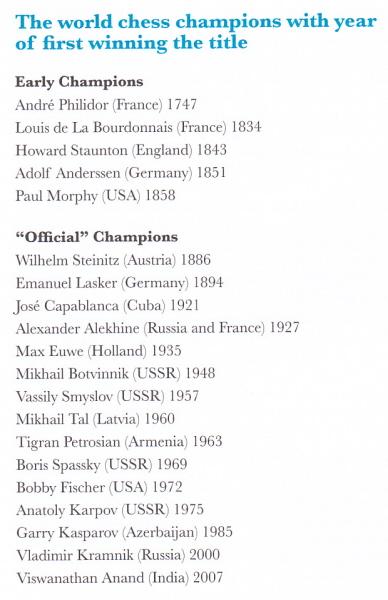
How is the reader to know from such a list that, for instance, Alekhine regained the world title in 1937 and held it until 1946?
Consulting the chart on pages 77-78 of Buzan’s Book of Mental World Records by T. Buzan and R. Keene (Hassocks, 2005) will not help. It has two columns, headed ‘Years’ and ‘Champion’, and includes this sequence:


Yet another Keene shambles over the basic history of the world chess championship.
Regarding our spot-check of Batsford Chess Openings, most of the errors (but not all of them) have been corrected in the ‘4th Revised Impression January 1986’, and we receive an acknowledgement from Raymond Keene in the book. And yet this new BCO is the clearest possible proof that getting facts right is not uppermost in the minds of the Batsford band.
In C.N. 945 we commented: ‘Since doing the above spot-check, we have noted roughly the same percentage of error for other such references in BCO.’ An identical point was made in our letter to Peter Kemmis Betty of Batsford dated 7 February 1985:
... you may care to know that subsequent perusal of this unhappy book has shown the same percentage of error. Naturally I should be prepared to pass on details if approached by one of the authors, so that future editions may be corrected.
Our offer of a second list was never accepted, and we therefore assumed, with our characteristic naïveté, that the various authors had decided to undertake the necessary correction work themselves. Will we never learn? The ‘4th Revised Impression January 1986’ still has a profusion of deficiencies. To show the extent of the problem as clearly as possible we shall take the references to just one great master, Alekhine. (We select him for no better reason than that he is ‘co-author’ Kasparov’s great hero.) Our spot-check list included the following corrections:
Page 32: Euwe-Alekhine. For 13...f6 read 13...c6.
Page 41: Alekhine-Tartakower. Black played 9...Kf7, not 9...Qf7.
Page 95: Rubinstein-Alekhine. Vienna, 1922 was not an Olympiad.
Page 99: Alekhine’s opponent was Michell, not Mitchell.
Page 167: Alekhine’s opponent was Rey Ardid, not ‘Ardid’, and the game was played at Saragossa, not ‘Germany’.
Page 191: Alekhine’s opponent was E., not L., Steiner.
Page 223: Alekhine-Podgorný. Played in 1943, not 1942.
Page 297: Bernstein-Alekhine. For 1934 read 1933.
But what about all the other examples of carelessness that could just as well have been mentioned, and which still appear incorrectly in BCO (4th attempt)? For instance:
Page 47: Alekhine-Prins. Venue missing.
Page 73: For Alekhine’s opponent read Kussman.
Page 80: Euwe-Alekhine, match 1935. Two mistakes. 14 Ne4 should read 14 Nxe5 and Alekhine, not Euwe, was White.
Page 99: ‘Rubinstein-Alekhine, 1924’. And yet we drew attention to this error in C.N. 917.
Page 143: ‘Euwe-Alekhine, match 1937’. The moves in question did not occur in any of the match games. Would it have been too much trouble to check in Alekhine’s second Best Games volume? That would have given the information that the moves were played in the 1926-27 Euwe-Alekhine match. (It might also have been noted that Alekhine gave 14 Qa4 a ‘?’.)
Page 150: Rabinovich-Alekhine, Moscow, 1920. Omission of an acknowledgement to Alekhine for analysis up to move 17.
Page 157: López Esnaola-Alekhine. For ‘Spain’ read Vitoria. (Checking that in Morán’s book on Alekhine takes a few moments.)
That is one player. It is now the BCO co-authors’ job to undertake a thorough overhaul of references to everyone else before they presume to offer the public a 5th Revised Impression.
(1159)
From John Donaldson (Berkeley, CA, USA):
‘Simon Constam of Hamilton, Canada raises a very interesting question. Page 12 of The Grünfeld Defence by William Hartston (London, 1971) gives the sequence 1 d4 Nf6 2 c4 g6 3 Nc3 d5 4 cxd5 Nxd5 5 e4 Nxc3 6 bxc3 c5 7 Nf3 Bg7 8 Be2 O-O 9 O-O b6 10 Be3 Bb7 11 e5 cxd4 12 cxd4 Na6 13 Qa4 Nc7, with the better game for Black, Rubinstein-Alekhine, 1924. I have seen no source on either Rubinstein or Alekhine that gives this game and could find no encounter in MegaDatabase 2005 that reached the position after 13...Nc7. Any help on resolving this mystery would be gratefully appreciated.’
Why and when this faulty game reference started appearing in chess literature is unknown to us, but we mentioned it in C.N. 917 after noting the citation ‘Rubinstein-Alekhine, match 1924’ on page 99 of that gaffes-à-gogo book Batsford Chess Openings (London, 1982).
(3607)
‘Euwe gave up match play during the German occupation of the Low Countries, and in the world championship in 1948 Euwe was badly defeated by Alekhine.’
Source: 1982 Britannica Book of the Year, page 107.
In fact, of course, Alekhine was badly defeated by life in 1946.
(836)
An endnote on page 266 of Chess Explorations added that the reference to Euwe’s abandonment of match play was also untrue. For example, in July 1941 he played a match against Bogoljubow in Carlsbad.
Alekhine and Réti had opposite views on the worth of Capablanca’s sixth move in his game (as White) against Yates at New York, 1924 (1 d4 Nf6 2 Nf3 g6 3 Nc3 d5 4 Bf4 Bg7 5 e3 O-O 6 h3). Alekhine, in the tournament book, said it was ‘not exactly necessary ... after the text-move, Black obtains some counter-play, the defense of which will demand all of the world champion’s care’. Réti, however, calls 6 h3 ‘a move of genius’ (Homenaje a Capablanca, pages 185-186) For him it was ‘the most profound move of the entire game’. He explains its idea as follows (our résumé): if Black is to make the most of the king’s bishop he will need to play, eventually, either ...e5 or ...c5. Capablanca’s plan is to prevent the former, so as to force the latter. This will transfer the battle to the queen’s side, where White will have every chance of securing an advantage, owing to the absence on that flank of Black’s dark-squared bishop. Capablanca, in view of the position of his own bishop in the centre of the board, prevents the centre from becoming the battlefield by 6 h3. He does not allow Black to play 6...Bg4, followed by ...Nbd7 and ...e5.
(916)
C.N. 547 mentioned that in the New York, 1924 tournament book Alekhine remarked that Capablanca played the long endgame against Yates ‘with his usual precision’. This was at variance with his criticism of the Cuban’s endgame skill elsewhere. Our item referred to page 27 of the January 1980 BCM; see too C.N. 2138 below.
Carl-Eric Erlandsson (Lund, Sweden) sends the following list from Ståhlberg’s I kamp med världseliten (Örebro, 1958), page 70:
‘My hardest opponents: Alekhine and Botvinnik; my most interesting opponent: Lasker; my most pleasant opponent: Keres; the greatest master: Alekhine; the greatest talent: Capablanca; the greatest strategist: Botvinnik; the greatest tactician: Lasker; the foremost endgame practitioner: Smyslov; the most imaginative master: Bronstein.’
A little query regarding L. Steiner-Alekhine, Folkestone Team Tournament, 1933. In My Best Games of Chess 1924-1937, page 128, Alekhine says of 14 B-Kt5: ‘A rather superficial developing move. Instead, 14 B-K3 was still preferable.’ The word ‘still’ is a surprise, since he had not recommended B-K3 earlier. On page 98 of the Book of the Folkestone 1933 International Chess Team Tournament (Whitehead & Miller, 1933), Tartakower writes that ‘14 B-K3 would not do because of KtxP. Correct was 14 B-B2, to be followed by B-K3 or Kt-K3.’
Are we right to suggest that Alekhine’s ‘14 B-K3’ is a misprint for ‘14 B-B2’? Then the ‘still’ would make sense, since B-B2 had been recommended on move 13.
(1201)
Our feature article Chess Variants and Rule Changes includes, in the section on Marseillais (double-move) chess, the following text (C.N. 1426):
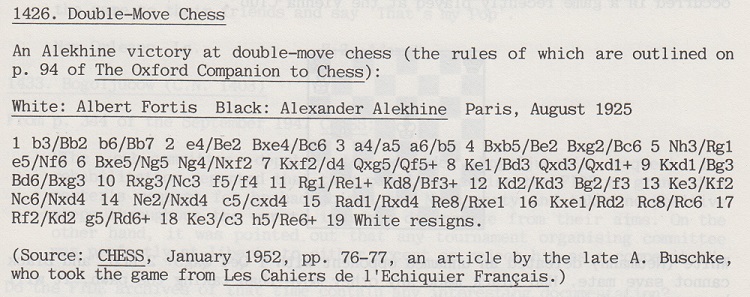
The following position occurred after Black’s 40th move in the third game of the 1927 world championship match between Capablanca (White) and Alekhine:
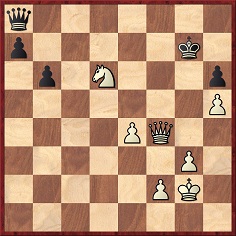
Capablanca finished with 41 Nf5+ Kf7 42 Qc7+ and Black resigned. Despite checking this game in about 20 books and magazines, we have found no comment on Capa’s 41st move. And yet it is not the quickest win. White could have played 41 Qf7+, with a forced mate in three more moves. The trouble with 41 Nf5+ is that Black has one possibility of holding out a move longer: 41...Kf8.
(1449)
Bled 1931 by Hans Kmoch translated by Jimmy Adams (Caissa Editions) starts with a highly interesting 12-page article (1976 vintage) on the tournament by Flohr. (If we are reading page xvi correctly, Flohr states that he was defeated by Alekhine in a simultaneous exhibition as early as 1925.)
(1491)
See too page 307 of Kings, Commoners and Knaves, where we quoted the English translation:
‘The first time I saw him was in 1925 (I first lost to him in an exhibition) ...’
In C.N. 8351 Steve Wrinn (Homer, NY, USA) mentioned regarding the Bled tournament book (Yorklyn, 1987) that the full above-mentioned Flohr article was reprinted on pages 26-30 of the March 2003 CHESS.
(8351)
We note that CHESS gave the same translation regarding the Alekhine passage, whereas in the 1976 64 article (pages 8-10 of the 27 February-4 March issue and pages 6-7 of the 5-11 March issue) Flohr’s comment in brackets stated that he was the first to lose against Alekhine in the 1925 display (‘Впервые я увидел его в 1925 году (я первым проиграл в сеансе ...’).
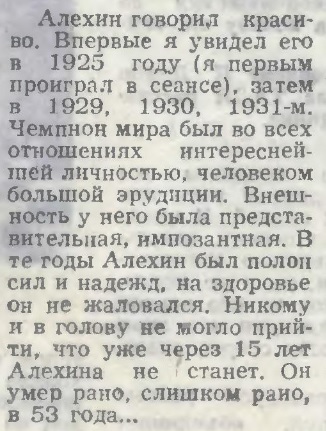
See too page 30 of Flohr’s memoirs Сквозь призму полувека (Moscow, 1986).
From page 48 of Evans on Chess by Larry
Evans (New York, 1974):
‘The “lapsus manus” variation derives its name from a slip of the hand made by world champion Alexander Alekhine in defense of his title.
Alekhine v Euwe, 5th match game 1935: 1 e4 e6 2 d4 d5 3 Nc3 Bb4 4 Ne2!? dxe4. Alekhine unintentionally moved his knight, sacrificing a pawn; but it turned out to be playable after 5 a3, and a new line was born.’
In fact, the ‘new line’ was already familiar, not to say famous. Alekhine played 4 Ne2 in his celebrated miniature against Nimzowitsch at Bled, 1931 – see page 94 of the second volume of his best games. There is no reason to believe it was a slip of the hand on either occasion.
Mr Evans is no doubt thinking of 1 e4 e6 2 d4 d5 3 Nc3 Bb4 4 Bd2 (Alekhine-Flohr, Nottingham, 1936), which Alekhine admitted, on page 17 of the tournament book, was a ‘lapsus manus’.
(1598)
From Photographs of Nottingham, 1936:
Alekhine in the first round (his lapsus manus opening against Flohr):
That picture is relatively well known, having been published, for instance, on page 16 of Chess Review, April 1946 and in The Treasury of Chess Lore by Fred Reinfeld (New York, 1951).
Alekhine’s note to 4 Bd2 in the tournament book:
‘A “lapsus manus”. I intended to play 4 P-K5 and P-B4, as, for instance, against Nimzowitsch at San Remo, 1930, but instead I made the move with the bishop first.’
From page 391 of Kings, Commoners and Knaves:
In La Nación in 1930 Alekhine described Flohr as ‘the second true talent to have emerged in the chess world since the War (the first was the Mexican Torre)’. The world champion also predicted ‘an exceptional chess future’ for Flohr.
Source: El Ajedrez Americano, August 1930, page 227.
‘It is fairly safe to prognosticate that for the next five years at least, Alekhine will be able to retain his title.’
Euwe in the Nieuwe Rotterdamsche Courant, an article reproduced on pages 150-153 of The Chess World, 1 January 1933.
In the same issue (pages 174-175) Alekhine was interviewed. Asked whether he thought that anybody could beat him, he replied:
‘No, I don’t think so. I have beaten them all, although I only beat Capablanca by a small margin. I just want to hold my own against my own generation. If one of the younger generation came along and beat me – well ... I don’t care.’
A photograph of Alekhine and Flohr in Nice, 1931, from page 284 of A Chess Omnibus:
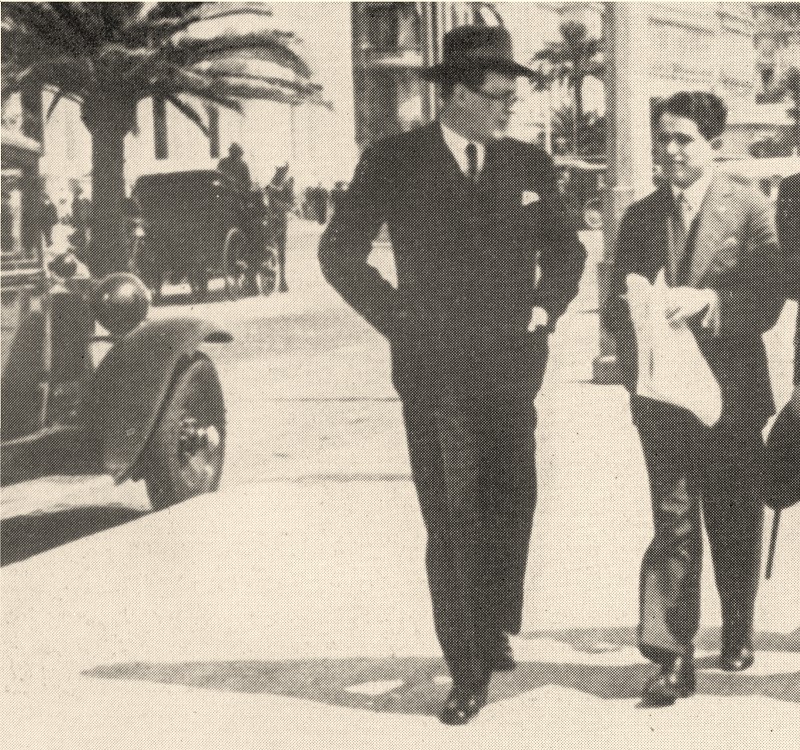
We have been asked what the source is for Alekhine’s remark about always believing he could find a saving resource, as quoted, for example, on page 75 of World Chess Champions (Oxford, 1981).
On pages 429-431 of the 14 August 1937 CHESS Alekhine annotated a game against W. Rosanov, describing it as ‘my first tournament game, which was played in a Moscow spring tournament in 1907’. The final paragraph of the introductory remarks reads:
‘It is possible that this game exerted a profound effect on my subsequent play and development. Certainly it stimulated my ambition and my desire to improve. On the other hand it endowed me with a curious psychological weakness which I had to work hard and long to eradicate – if I ever have eradicated it – the impression that I could always, or nearly always, when in a bad position, conjure up some unexpected combination to extricate me from my difficulties. A dangerous delusion!’
Two points need to be made here:
a) It would thus appear that the World Chess Champions reference to ‘when he was much younger Alekhine had written ...’ is incorrect (unless it can be shown that Alekhine had expressed the same thought on an earlier occasion).
b) We can find no reference to a Moscow tournament in the Spring of 1907 (when Alekhine would have been only 15), or to his playing in any 1907 tournament. At the Moscow Chess Club Autumn Tournament of 1908 Alekhine beat Rosanov (see volume II of Gaige’s crosstables, page 303). Was that the game Alekhine gave in CHESS? If so, his claim that it was ‘my first tournament game’ would be untrue; in August 1908 he took part in the Düsseldorf Hauptturnier A.
(1512)
From Jack O’Keefe (Ann Arbor, MI, USA):
‘There apparently was a Moscow 1907 Spring Tournament, and Alekhine did take part in it. The evidence is not only Alekhine’s memory (often inaccurate), but also a notebook which he kept in 1907, containing 17 of his games (and one other), described by V. Bibikov in issue 3 of the 1954 Shakhmaty v SSSR, page 91.
Three games (Alekhine-Parfenov, Budberg-Rozanov and Budberg-Alekhine) are from the Spring tournament; his game vs Budberg is dated 6 June. While the notebook does not confirm the Alekhine-Rozanov score, or that it was played in this event, or that it was Alekhine’s first tournament game, it at least confirms that Alekhine and Rozanov both played in the tournament.
Two more points may be of interest: 1) Alekhine played in two more Moscow club tournaments (Autumn 1907 and Spring 1908) before going to Düsseldorf, and 2) Alekhine’s win from Rozanov at the Moscow, 1908 Autumn Tournament began 1 e4 b6 (game 35 in My Best Games of Chess 1908-1923); the “first tournament game” was a Scotch.’
(1581)
The above two items were written in 1987 and 1988, i.e. long before publication of Alexander Alekhine’s Chess Games, 1902-1946 by Leonard M. Skinner and Robert G.P. Verhoeven (Jefferson, 1998), which shed so much further light on all phases of Alekhine’s career.
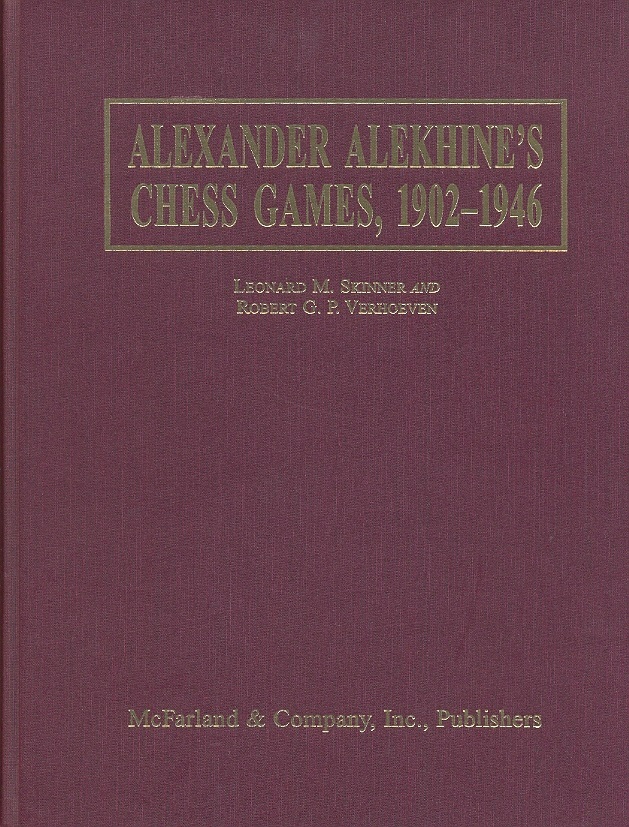
The March 1989 Revista Internacional de Ajedrez (pages 12-15) has an interview with the Spanish-born master Francisco José Pérez, a Cuban resident since the early 1960s. His reminiscences on Alekhine are of interest, and we give below a brief compendium of some of his replies to F.J. Ochoa de Echagüen:
‘He was, possibly, the greatest player of all time. I played four tournament games against him (3½-½ to Alekhine) and many friendly ones. ... He was not very good at fast chess. ... I spent a long time with him. He revised the manuscript of the book Ajedrez Hipermoderno which I wrote with Ricardo Aguilera. The book was a kind of bringing up to date of Réti, along the lines of Masters of the Chess Board. Those were six months of unforgettable collaboration with the master. He was staying at the Hotel Capitol, and two days a week he analysed with me. Incidentally, I will mention that in general he spoke well of the majority of chessplayers, except Nimzowitsch, who he said was mad.
(1854)
The Black allies in the following simultaneous game, taken from page 162 of the November 1932 American Chess Bulletin, were J.R. Newman, D. MacMurray, H. Chandler and A.S. Denker:
Alexander Alekhine – Allies
New, York, 8 November 1932
Queen’s Gambit Declined
1 d4 Nf6 2 Nf3 d5 3 c4 e6 4 Bg5 Be7 5 e3 O-O 6 Nc3 Nbd7 7 Rc1 c6 8 a3 Ne4 9 Bxe7 Qxe7 10 Nxe4 dxe4 11 Nd2 f5 12 c5 e5 13 Nc4 exd4 14 exd4 Nf6 15 Nd6 b5 16 d5 e3 17 f3 Nxd5 18 Bxb5 Nf4 19 Bc4+ Kh8 20 g3 Nh3 21 Qd4 f4 22 Qe4 Qf6 23 Qxc6 Bd7 24 Qxa8 Rxa8 25 Nf7+ Kg8 26 Ng5+ Drawn.
(1899)
A rarity in master praxis is the immediate pawn storm, whereby a player refrains from moving pieces in the opening. Examples are given on pages 14-16 of Wonders and Curiosities of Chess by Irving Chernev. A ‘new’ specimen may be found on page 84 of Alekhine in Europe and Asia by John Donaldson, Nikolay Minev and Yasser Seirawan, an excellent book. All Alekhine’s pawns moved before any piece was touched.
Alexander Alekhine (simultaneous) – E.D.G. Frahm
Jakarta, 1 March 1933
Sicilian Defence
1 e4 c5 2 b4 cxb4 3 a3 e6 4 axb4 Bxb4 5 c3 Be7 6 d4 d5 7 e5 Nc6 8 f4 f5 9 g4 Nh6 10 g5 Nf7 11 h4
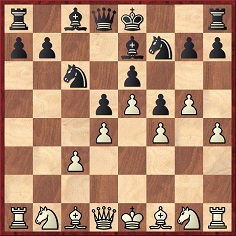
11...Qc7 12 Na3 Bxa3 13 Bxa3 Na5 14 Bb4 Nc4 15 Bxc4 Qxc4 16 Ne2 Bd7 17 h5 Bb5 18 Kf2 Qxe2+ 19 Qxe2 Bxe2 20 Kxe2 Kd7 21 Rhb1 g6 22 Rh1 a6 23 Bc5 gxh5 24 Rxh5 Rag8 25 Rb1 Kc8 26 Be7 h6 27 Bf6 Rh7 28 Rb6 Nd8 29 Bxd8 Kxd8 30 Rxe6 Rc7 31 gxh6 Rxc3 32 h7 Rh8 33 Rg6 Rc1 (sic – or 33...Rc8, etc.?) 34 Rg7 b5 35 Rxf5 Resigns.
(1969)
A footnote on page 68 of Kings, Commoners and Knaves mentioned that the subsequent Skinner/Verhoeven book on Alekhine (page 448) did indeed give 33...Rc8.
Chess history is such that it is possible for a master to be narrowly defeated in a world championship match and still be ignored by posterity. Isidor Gunsberg (1854-1930) lost to Steinitz in New York in 1890-91 by a two-game margin. He was also subsequently a prolific columnist, but few nowadays remember what, or even where, he wrote.
When Gunsberg died, Alekhine published a tribute in La Nación of 10 August 1930. He said that the deceased had been ‘a force of the first order between 1885 and 1893’ and that there were two aspects to Gunsberg’s chess individuality; ‘firstly, an absolute lack of originality and, secondly, a clearly exceptional ability to adapt’. Gunsberg showed uncommon skill and ingenuity in ‘understanding the strategic weaknesses of Chigorin’s style and the psychological weaknesses of Steinitz’s style’ and in exploiting these deficiencies during his matches against them. Alekhine continued:
‘For example, to the end of his days Chigorin never knew how to defend as Black against the Queen’s Gambit and believed that the quintessential problem for the second player lay in the satisfactory development of his queen’s bishop. Consequently, in his match against the Russian master, Gunsberg tried all imaginable forms of the Queen’s Gambit and the Queen’s Pawn Game; he thereby obtained, as White, results which were more than satisfactory.
Against Steinitz, who was a renowned connoisseur of the Queen’s Gambit but whose ideas at that time about how to defend against the Evans Gambit were baroque and unhealthy, Gunsberg exploited this factor to combat his great opponent.
... By no means was he a genius, but he was talented and a great worker. Moreover, Gunsberg was highly esteemed for his efforts during a particularly difficult transitional period for our art – to disseminate chess. He therefore has every right to the recognition of all who love chess.’
Scrutiny of the games in the two matches suggests that Alekhine’s thesis about Gunsberg’s opening choices was rather an exaggeration.
(1977)
Hanon Russell (Milford, CT, USA) has a collection of thousands of chess documents representing all periods. Its importance for serious historical research is immeasurable, but here we publish, with his kind permission, some lighter fare: masters’ comments on each other in correspondence. For example:
Letter from Alekhine to Norbert Lederer, 15 February 1924 (item 1365 in the Russell Collection):
‘... I consider Mr Bogoljubow a “non-gentleman”, a man from whom anything can be expected at any moment ... Mr Bogoljubow has, in every tournament in which we’ve participated (growing worse each time), brought with him such an atmosphere of hate, envy and reckless, malignant delight which doubtless disturbed me in developing my full strength.’
(1999)
W.D. Rubinstein (Aberystwyth, Wales) has submitted extracts from The Sports Hall of Shame by Bruce Nash and Allan Zullo (published by Pocket Books, New York, 1987).
Page 222 avers that Steinitz ‘was the most despised player who ever lived. He treated opponents as if they were nothing more than pawns who deserved to be captured ... Known as much for the Steinitz temper as he was for the Steinitz Gambit, the explosive grandmaster turned chess halls into mine fields.’
The same page reports that Alekhine ‘terrorised international chess competition during the first half of this century. His opponents faced the fury of hell after those rare moments when they uttered “checkmate”. That little word unleashed a volcano. Once, after he was forced to surrender in a major tournament, a raging Alekhine grabbed his lead-weighted king and hurled it like a bean-ball across the room, nearly braining a referee who ducked just in time.’
In short, merely spiced-up versions of some of the worst bits of Harold Schonberg’s Grandmasters of Chess.
(Kingpin, 1995)
Alekhine has been the subject of two main accusations of violent action after losing a game: a) destroying hotel furniture and b) throwing his king across the tournament hall. These were discussed on, respectively, page 156 of Chess Explorations and pages 279-280 of Kings, Commoners and Knaves.
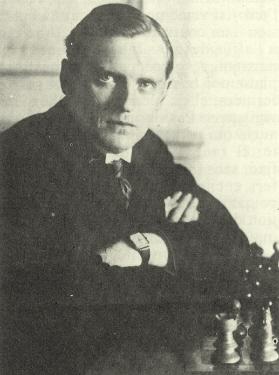
Alexander Alekhine
Page 3 of the January 1986 APCT News Bulletin had the following affirmation about Alekhine v Yates, Carlsbad, 1923:
‘Rumor has it that after losing this game, Alekhine went back to his hotel room and smashed the furniture.’
As reported in C.N. 1129, we requested a source for this (‘a contemporary reference, naturally, and not a Horowitz or Reinfeld potboiler’), but the February 1986 issue of the Bulletin (page 41) merely offered the following passage from page 128 of Reinfeld’s Great Brilliancy Prize Games of the Chess Masters (New York, 1961):
‘The story is told that one day after losing a game in the formidable Carlsbad tournament of 1923, Alekhine went back to his hotel room and smashed every stick of furniture. The following game [Alekhine v Yates] may well be the one that made him so rambunctious, for his defeat cost him clear first prize in the tournament.’
C.N. 1129 then pointed out that Alekhine’s loss to Yates was the second of three defeats at Carlsbad, 1923. Both Reinfeld and the APCT News Bulletin had overlooked that it was played as early as round seven (out of 17 rounds) and therefore did not ‘cost him clear first prize’. We added that the incident was often ‘rumoured’ to have occurred after Alekhine’s loss to Spielmann in the same tournament.
And there the matter was left. (As noted in C.N. 1276, our second letter to the APCT News Bulletin was neither published nor acknowledged.) But now we note that in an article published 11 years before Reinfeld’s book appeared (i.e. in Chess Review, May 1950, pages 136-138) he co-authored with Hans Kmoch an article on Carlsbad, 1923 which stated:
‘Alekhine was as furious as only he could be when he unexpectedly lost a game in his palmy days. On such occasions, rare though they were, he was filled with savage anger, so much so that he ran the danger of getting a stroke if he did not have an adequate outlet for venting his rage. Having resigned his game to Spielmann, he stormed back to his room at the Imperial (the best hotel in Carlsbad) and smashed every piece of furniture he could get his hands on.’
It may be wondered why Reinfeld was later to speculate, when writing solo, that the game in question had been against Yates.
Another article by Reinfeld and Kmoch in the 1950 Chess Review (February issue, page 55) said that at the end of his game against Grünfeld at Vienna, 1922 ‘Alekhine resigned – by taking his king and throwing it across the room’. Kmoch was a participant in the tournament.
Such accounts are insufficiently vivid for the likes of Harold C. Schonberg, who decided, on page 27 of Grandmasters of Chess, to make the throwing more dramatic and the destroying more frequent:
‘Alekhine once resigned, frantic with rage and frustration, by picking up his king and hurling it across the room, nearly braining a referee in the process. (Tournament pieces are weighted with lead; they can be dangerous weapons.) Alekhine would also relieve himself after a loss by going to his hotel room and destroying the furniture.’
In Grandmasters of Chess Schonberg exhibited scant concern for facts or fairness, and on page 220 he even professed that Alekhine was ‘as amoral as Richard Wagner or Jack the Ripper’. If morality is the issue, Schonberg’s act of writing such a thing is worth a moment’s contemplation.
(3196)
Mark Nieuweboer (Moengo, Surinam) refers to an article on Spielmann by Hans-Wilhelm Fink on pages 111-149 of Rudolf Spielmann Portrait des [eines] Schachmeisters in Texten und Partien by Michael Ehn (Koblenz, 1996). Pages 127-128 quote most of what Hans Kmoch wrote on pages 61-62 of his book Die Kunst der Bauernführung (Berlin-Frohnau, 1956). The relevant part of Kmoch’s book is the final paragraph of that section:
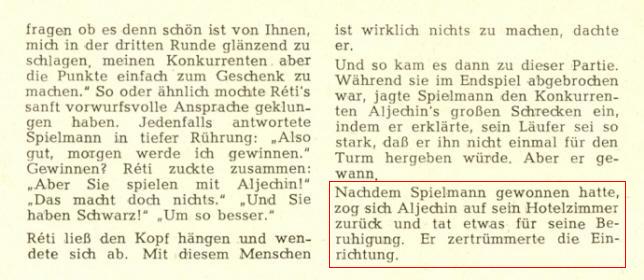
The passage in question (over 60 lines) is absent from the English edition of Kmoch’s book, Pawn Power in Chess (New York, 1959). Our correspondent asks whether Kmoch was present during the Carlsbad, 1923 tournament.
We add that Michael Ehn’s book on Spielmann is admirably researched.
(5013)
Addition on 24 January 2024:
In reaction to our feature article on Spielmann, on 12 July 2023 Michael Lorenz (Vienna) wrote ‘I beg to differ’ regarding our comment in C.N. 5013 that ‘Michael Ehn’s book on Spielmann is admirably researched’. He mentioned a few errors, and on 14 July 2023 we replied to him regarding his brief message:
I shall willingly quote it as an addition to the feature article – as your text stands or with any other examples you may care to add. Please let me know your preference.
We received no reply.
From an article ‘Unconventional Surrender’ by Hans Kmoch and Fred Reinfeld on page 55 of the Chess Review, February 1950:
‘Alekhine hit on still another way of resigning during the Vienna tournament of 1922. ... When he saw that Grünfeld had sealed 54...Q-B6 (the strongest move), Alekhine resigned – by taking his king and throwing it across the room.’
From page 4 of Why You Lose at Chess by Fred Reinfeld (New York, 1956):
‘Hans Kmoch and I once surveyed [methods of resigning] in an article called “Unconventional Surrender”. We recalled that Alekhine, who was unequaled as a desperate fighter in disheartening situations, occasionally [our emphasis] resigned by picking up his king and hurling it across the room.’
Notwithstanding the word ‘occasionally’, the Kmoch/Reinfeld article had not suggested that the conclusion of the Alekhine v Grünfeld game was other than an isolated incident.
As noted above, Kmoch was a participant in Vienna, 1922, but does any other source corroborate the claim about Alekhine which Kmoch made nearly three decades later?
(5843)
The above C.N. item was entitled ‘The anecdotalist’s plural’.
An addition in Chess with Violence:
From page 12 of How to Play Chess Like a Champion by Fred Reinfeld (New York, 1956):
‘... Alexander Alekhine was not only the greatest of the world champions; he was also the greatest chess artist of all time. He was a man of extraordinary nervous energy who had been known to fling his king across the room or smash furniture on the rare occasions when he lost. A rotten sport, maybe, but he took his chess very hard.’
‘Yes, Alekhine did it. He won the return match with Euwe. For nearly two years he had lived on sour milk, travelling around with his own cow.’
Source: Chess World, July 1954, page 160.
(Kingpin, 1995)
In a prize quiz set by Raymond Keene on page 99 of The Spectator, 19-26 December 1987 this player had to be identified:
‘He switched to milk in 1947. What was the effect?’
The answer given on page 51 of the 23 January 1988 issue was Alekhine, with an explanation that 1947 was a ‘misprint’ for 1937.
C.N. 11022 showed this double mishap on page 241 of the Complete Book of Beginning Chess by Raymond Keene (New York, 2003):
See also pages 384-385 of Kings, Commoners and Knaves.
In the same above-mentioned Spectator quiz, readers were asked, in a section entitled ‘They’re all mad’, which player died in his bath surrounded by women’s shoes. With predictable fallibility, Raymond Keene gave Morphy as the answer.
See Chess and Insanity.
Black in the game below was Dr Milan Vidmar’s son, then aged nearly 21.
Alexander Alekhine – Milan Vidmar Junior
Ljubljana, 11 December 1930
Queen’s Gambit Declined
1 d4 Nf6 2 Nf3 d5 3 c4 e6 4 Nc3 Nbd7 5 Bg5 Be7 6 a3 O-O 7 e3 c6 8 Bd3 dxc4 9 Bxc4 b5 10 Ba2 a6 11 e4 c5 12 e5 Ne8 13 Bxe7 Qxe7 14 d5 exd5 15 Nxd5 Qd8 16 O-O Nc7 17 Nxc7 Qxc7 18 e6 fxe6 19 Bxe6+ Kh8 20 Ng5 Nf6 21 Qf3 Bb7 22 Qh3 h6 23 f4 Ne4 24 Bf5 Rxf5 25 Qxf5 hxg5 26 fxg5 c4 27 Kh1Qc5 28 Qh3+ Kg8 29 g6 Ng5 30 Qg4 Ne4 and Black resigned.
Source: Magyar Sakkvilág, February 1931, page 70.
(2099)
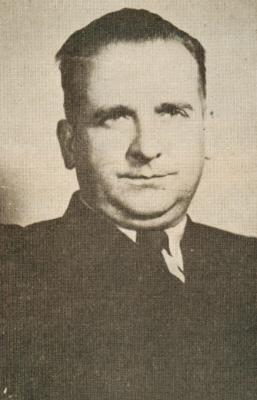
Milan Vidmar Jr (1909-80), in a photograph published on page 42 of the February 1950 Chess Review.
(6960)
Jean Hébert (Richelieu, Canada) sends a number of Alekhine games from Le Pion of 1924 which are not in the new Skinner/Verhoeven book on Alekhine. One of them (Alekhine’s win as White against A. Lambert in a blindfold exhibition in Montreal on 1 December 1923) has a strange symmetrical opening: 1 d4 d5 2 Nf3 Nf6 3 Bf4 Bf5 4 e3 e6 5 Bd3 Bd6 6 Bxf5 Bxf4 7 Bxe6 Bxe3 8 Bxf7+ Kxf7 9 fxe3.
(Kingpin, 1998)
The Czech writers Jan Kalendovský and Vlastimil Fiala are producing a series of detailed books on Alekhine in English. The first (187 pages) was published in 1992 and covered the period 1892-1921; the second (464 pages) takes the story up to 1924.
The second volume contains several interviews with Alekhine in which he expresses a high opinion of Capablanca’s endgame play. For example, page 265 quotes from page 14 of České slovo of 17 June 1923, where the Russian master stated that he felt superior in the opening (‘since Capablanca tends to underestimate its importance’) but added: ‘Naturally, as far as the endgame is concerned, Capablanca has no rival; no-one among the contemporary masters has any chance to beat him in it’.
Just a few years later, Alekhine had a very different assessment of the Cuban. On page 16 of his book Das New Yorker Schachturnier 1927 (Berlin, 1928) he wrote:
‘In the endgame he is not to be feared by a first-class master since here it is only exceptionally that he manages to raise his play above average.’
In fairness to Alekhine, his view may have changed because he drew an inferior rook ending against Capablanca in the fourth round of the 1924 New York tournament (a game which Mark Dvoretsky analysed in depth in an article on pages 36-43 of issue 3 of the American Chess Journal in 1995). On page 2 of his book On the Road to the World Championship 1923-1927 (Oxford, 1984) Alekhine described that game as a ‘revelation’ and wrote, ‘I was convinced that if I had been in Capablanca’s position I should certainly have won that game’.
In fairness to Capablanca, he was ill at the start of New York, 1924. It is, of course, impossible to know whether Alekhine was being sincere in any or all of the statements quoted above.
(2138)
From Missed Mates (an article of ours originally published by ChessBase):
In C.N. 2117 Richard Forster (Zurich) referred to the position which arose after White’s 25th move in Réti v Marshall, New York, 1924 (see pages 165-166 of the English-language tournament book, published in 1925):
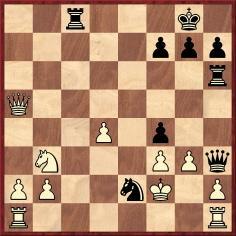
Play went 25...Nxg3 26 Rhg1, and Alekhine wrote: ‘Or 26 hxg3 Qxg3+ 27 Ke2 Qg2+ 28 Kd3 Rxh1 29 Rxh1 Qxf3+, to be followed by 30...Qxh1, with an easy win.’ Instead, there is 28...Qc2 mate.
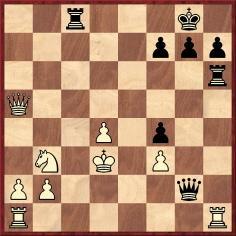
Analysis by Alekhine (position after 28 Kd3)
On page 33 of his 1929 book Schachmethodik Tartakower also ignored the mate, as did Soltis on page 270 of Frank Marshall, United States Chess Champion (Jefferson, 1994).
C.N. 2131 remarked that in the original 1925 edition of Alekhine’s tournament book W.H. Watts gave a nine-page errata supplement which mentioned (on page vi) 28...Qc2 mate, and when discussing the matter further on pages 283-284 of Kings, Commoners and Knaves we drew attention to some complications. Here is the complete game-score as it appeared in the tournament book (English and German editions):
Richard Réti – Frank James Marshall
New York, 6 April 1924
Queen’s Gambit Declined
1 Nf3 Nf6 2 c4 d5 3 cxd5 Nxd5 4 d4 Bf5 5 Nc3 e6 6 Qb3 Nc6 7 e4 Nxc3 8 exf5 Nd5 9 Bb5 Bb4+ 10 Bd2 Bxd2+ 11 Nxd2 exf5 12 Bxc6+ bxc6 13 O-O O-O 14 Qa4 Rb8 15 Nb3 Rb6 16 Qxa7 Qg5 17 Qa5 c5
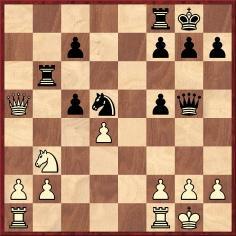
18 Qxc5 Nf4 19 g3 Rh6 20 Qxc7 Ne2+ 21 Kg2 Qg4 22 Rh1 f4 23 f3 Qh3+ 24 Kf2 Rc8 25 Qa5 Nxg3 26 Rhg1 Qxh2+ 27 Rg2 Qh4 28 Rc1 Re8 29 Qb5 Ne4+ 30 Kf1 Qh1+ 31 White resigns.
However, we observed, when Réti annotated the game on pages 259-260 of the September 1924 Wiener Schachzeitung he gave White’s 18th move as 18 dxc5. If that were correct, Alekhine would have missed no mate later in the game. Hanon Russell (Milford, CT, USA), who possessed the original score-sheets of both Réti and Marshall, informed us that they respectively gave White’s 18th move as ‘Dxc5’ and ‘QxP’. A later transcription error in the German notation would have been easily made (i.e. ‘Dxc5’ becoming ‘dxc5’).
On page 126 of Das New Yorker Schachturnier 1927 (Berlin, 1928) Alekhine wrote regarding the communication of game-scores by telegraph:
‘But in general more accurate wire information for the foreign press should be provided during American tournaments. In 1924, for example, a similar error resulted in a wholly incorrect judgment of Marshall’s win against Réti.’
Here, a further point in this complex affair may be added. In 1924 Alekhine also annotated the game in Le Pion (Montreal); see pages 116-117 of the May 1924 issue of La Stratégie. He gave White’s 18th move as Qxc5, and at move 26 merely wrote, ‘If 26 hxg3 Qxg3+ 27 Ke2 Qg2+, winning easily’.
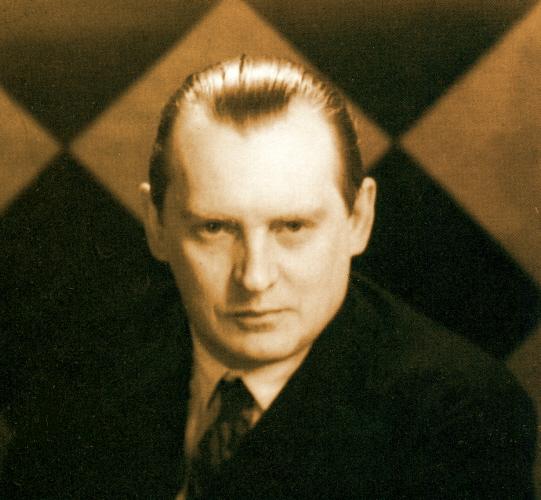
Alexander Alekhine
On page 76 of the 4/1998 New in Chess we mentioned that in a 1938 tournament game (in Montevideo) Alekhine essayed 1 d4 Nf6 2 c4 e6 3 Nf3 Ne4.
Here is A.E. Santasiere’s reaction to Alekhine’s play, on page 55 of the May-June 1938 American Chess Bulletin:
‘Annotating the champion’s South American games is like criticizing the behavior of a staid banker at a night club.’
(2248)
The conclusion of a quick game between Alekhine and Tartakower, played at Carlsbad on 8 May 1923 appeared in C.N. 1050, taken from the Wiener Schachzeitung, July 1923, pages 135-136.
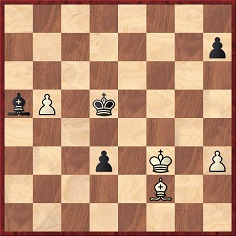
1 Ba7 Kc4! 2 b6 Kc3! 3 b7 d2 4 b8(Q) d1(Q)+ 5 Kg2 Qd5+ 6 Kg3 Kd3!! 7 Qb1+ Ke2 8 Qc2+ Bd2 9 Bc5 Kf1!! 10 h4 Qg2 mate. (Punctuation by Tartakower.)
Richard Forster writes:
‘The initial position is clearly drawn. White’s 8 Qc2+ isn’t the most accurate, but only 9 Bc5?? loses the game. 9 Qb2 and 9 Kh2 still draw.’
(2152)
See also Fast Chess.
Page 16 of Complete Games of Alekhine, volume 2, by V. Fiala and J. Kalendovský (Olomouc, 1996) refers to a four-game match between Alekhine and Bogoljubow played in Triberg in June/July 1921:
‘Alekhine and Bogoljubow wrote down an agreement pledging that the results would not be published in the next 15 years. ... Bogoljubow himself confirmed the existence of the secret match (which ended in a draw +1 –1 =2) only many years later. It was mentioned in the Introduction to the collection of games from the [1934] world championship match against Alekhine. In their lifetime neither protagonist made public mention of any game of this match.’
The book gives the four game-scores.
(2156)
Mark Nieuweboer (Moengo, Surinam) points out a report in Alexander Münninghoff’s book on Max Euwe (pages 155-156 of the Dutch original and page 112 of the English edition) that in 1935 the Dutchman played, in preparation for his world championship contest against Alekhine, a secret ten-game match against Rudolf Spielmann. Below is the relevant text, for which no corroborative source is supplied by the book:
‘… just before the final secondary school exams he met Spielmann for a drawing-room match. This latter piece of practical training went quite badly for him; we don’t know whether he found it hard to concentrate because of his schoolwork or whether he had underestimated Spielmann, who was clearly past his prime as a chessplayer, but the fact remains that the peripatetic Austrian veteran claimed this secret ten-game match in fairly superior style with 6-4 (+4 –2 =4).’
None of the games would seem to have been published.
(3194)
Alan McGowan (Waterloo, Canada) quotes three reports from 1935 which show that the existence of the match was not a secret and that, moreover, there is no unanimity as to who won the contest:
1) From page 402 of the September 1935 BCM:
‘In preparation for his match for the world championship, Dr Max Euwe has had a practice match with R. Spielmann, whom he beat by 4-2, with 2 draws.’
2) Pages 282-283 of Deutsche Schachblätter, 15 September 1935 also referred to the Euwe v Spielmann match, without giving the result:
‘Der holländische Vorkämpfer nimmt den Kampf sehr ernst; so hat er sich in Trainingskämpfen mit Spielmann und Eliskases geschult und in Wien theoretische Studien getrieben.’
3) The December 1935 Wiener Schachzeitung had an article reviewing the past year, and on page 354 it was stated that Spielmann had defeated Euwe:
‘... in einem Übungswettkampf schlug er Euwe 4:2 ...’
We can add that in De Groene Amsterdammer (an article reproduced on pages 185-186 of the June 1935 Tijdschrift van den Nederlandschen Schaakbond) Salo Landau wrote that Euwe and Spielmann were playing a training match in the absence of the press and witnesses, so that Alekhine would not have the benefit of seeing the games:
‘Het is bekend, dat Euwe op het oogenblik een oefenmatch speelt met Spielmann. Pers noch toeschouwers worden hierbij toegelaten, uit vrees, dat Aljechin de partijen te zien zal krijgen en daardoor het geheim der vorderingen van den Nederlandschen kampioen te weten zou komen.’
Can readers shed further light on the Euwe v Spielmann match?
(4174)
See also Secret Chess Contests.
On page 93 of the 7/1999 New in Chess Jan Timman referred to 40 Rb6 in the 31st Capablanca v Alekhine match-game as being ‘Fridstein’s recommendation’. (See also the detailed analysis by Hübner on pages 63-64 of the 8/1998 Schach.)
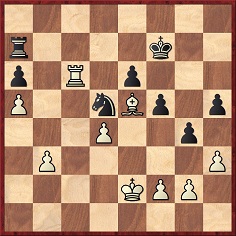
Yet 40 Rb6 is not a recent discovery. Page 212 of the April 1928 issue of Roberto Grau’s magazine El Ajedrez Americano commented:
‘The correct move would have been 40 Rb6, giving up the exchange but obtaining a pawn ending that appears won in the opinion of Capablanca himself. Let us see: 40 Rb6 Nxb6 (it is clear that if Black does not capture the rook 41 Rb8 follows, and Black has no way of taking control of the b-file, which is the key to Alekhine’s chances) 41 axb6 Rb7 42 Bc7 Ke7 43 Ke3 Kd7 44 Kf4 Rxc7 45 bxc7 Kxc7 46 Ke5 Kd7 47 d5!, breaking up the pawn base and winning on account of the king’s position.’
Důras too had recommended 40 Rb6 (‘!!’) on pages 23-24 of the February 1928 Československý Šach, although under the misapprehension that Black’s 39th move was …f4 rather than …g4.
(2343)
‘In the 11th game of their match in 1927 for the world’s championship, Capablanca took two hours on one move, and Alekhine took an hour and three-quarters for his reply.’
C.N. 2344 (see page 345 of A Chess Omnibus) noted that the above claim appeared, in more or less identical wording, on page 39 of Irving Chernev’s Curious Chess Facts (New York, 1937), page 101 of the same author’s Wonders and Curiosities of Chess (New York, 1974) and page 100 of Chess by Kenneth M. Grover and Thomas Wiswell (London, 1952).
In C.N. 6315 Alan O’Brien (Mitcham, England) noted that in another match-game, the 28th, this position arose:
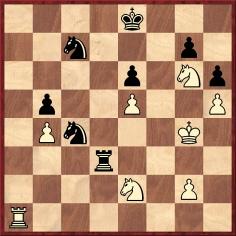
Alekhine played 41 Nef4 and wrote:
‘The text move was sealed and it took me an hour and 50 minutes to consider it, the record length of time for this match.’
The above is the English translation on page 199 of On the Road to the World Championship 1923-1927 (Oxford, 1984). See too pages 205 and 469 respectively of the original German and French editions of Alekhine’s book (Auf dem Wege zur Weltmeisterschaft and volume two of Deux cents parties d’échecs).
After 41...Rb3 42 Ra7 Kd8 43 g3 Alekhine reported that Capablanca thought for 40 minutes before offering a draw, which was accepted.
According to page 2 of Crítica, 30 November 1927 Alekhine took four hours and two minutes for the entire game, Capablanca’s total being two hours 30 minutes. The London Rules, under which the match was played, specified that on each play-day the session would last five hours and that the time-limit was 40 moves per two and a half hours.
Making all these ‘facts’ compatible with each other is far from easy.
Did Euwe chivalrously grant Alekhine a return match for the world title in 1937? Many authors think so. For example, Richard Eales wrote on page 167 of Chess The History of a Game (London, 1985): ‘But it was only Euwe’s sportsmanship which gave Alekhine the chance to play the match at all.’
Adri Plomp (Hilversum, the Netherlands) sends us a copy of the contract signed on 28 May 1935 between Alekhine, Euwe and the organizing committee for the 1935 match. Article 14 stated:
‘If Dr Euwe wins the match in accordance with Article 4, he is first of all obliged to play a return match against Dr Alekhine if the latter makes such a request within six months of the last game being played. Within a further six months thereafter Dr Alekhine must deposit 2,000 guilders with a bank ... The essential conditions for that match shall be the same as for the match regulated by this agreement, except that the names of Alekhine and Euwe shall be interchanged. It shall be played in Europe at a time acceptable to Dr Euwe, in view of his profession.’
(2473)
(2540)
An excerpt from an article on pages 1-4 of Ajedrez, January 1930 by Tartakower (in which he referred to himself in the third person):
‘In the great tournament in Pistyan, 1922, Tartakower managed to win his games against the two winners of the event, Bogoljubow and Alekhine.
In the game Alekhine-Tartakower, played in the early stages of the tournament, the loser stated after the game that he had been influenced by the indecisive way Tartakower played many of his moves. (In effect, having won a pawn but unable to find conclusive continuations, Tartakower was far from satisfied with his moves.) The battle should have finished in a draw, and it was only because of a serious mistake – extremely rare for him – that Alekhine lost the game.
Not wishing to incur further reproaches of the same kind, Tartakower then resolved to exercise even more self-control with all his moves. However, in Tartakower v Bogoljubow the loser claimed after the game that he had been influenced by the resolute way Tartakower played his moves.
As may be seen, it will never be possible to conduct the battle to the full satisfaction of the loser, who will always find some claim or other to make.’
(2540)
From Björn Frithiof (Älmhult, Sweden):
‘At the time of the Alekhine Memorial Tournament in 1956, many writers with personal memories of Alekhine wrote articles describing their impressions of him. One of Peter Romanovsky’s articles was reprinted on pages 248-251 of the 6/1956 issue of the Swedish chess magazine Tidskrift för Schack. (The actual Soviet source where the article was first published was not indicated.) Romanovsky relates that following the outbreak of the First World War in 1914, Russian players in Mannheim were transferred to Baden-Baden, where they all lived in the same hotel, Alekhine on the first floor and Romanovsky on the third. Romanovsky writes that here Alekhine started work on a book about the recent All-Russian Championship. Together, the two masters analysed the games every evening:
“Once we analysed a game for several hours, Alekhine recording extensive comments on several pages. I went to bed very late. At 4 a.m. I received a telephone call from Alekhine, who asked me to join him downstairs immediately. ‘We failed to notice the move b2-b4’, he said, ‘it refutes everything.’ We sat all morning and the next day, and it turned out that Alekhine was right.”
Has any of this material ever been discovered or published?’
Our correspondent also refers to Romanovsky’s recollections of a conversation with Alekhine immediately following the great St Petersburg, 1914 tournament:
‘After the last round I went up to Alekhine and congratulated him. Alekhine’s eyes were bright. “Thank you”, he said, “but you know, I consider my success only to be one step forward.” “What do you think about Lasker’s victory?”, I asked. “I am not quite satisfied”, he said. “I should have preferred Capablanca.”’
(2566)
In C.N. 2566 (see A Chess Omnibus, page 361) a correspondent referred to Romanovsky’s (lost?) reminiscences on Alekhine. We now note that his archives were discussed (although without anything about Alekhine) in a feature by Averbakh on pages 18-19 of Shakhmaty-in-English, September 1966: ‘P.A. Romanovsky’s collected works are now being compiled. An important part of the archives will be Petr Arsenievich’s unusual chess diaries and memoirs. They are accurately written, in small calligraphic handwriting.’
(2831)
On pages 132-133 of L’Echiquier, July 1925, Alekhine wrote an obituary of Teichmann in which he presented an overview of the development of chess theory:
‘His death marks the loss of one of the last representatives of the “classical” school, the principles of which were established and disseminated chiefly by Dr Tarrasch, who simplified them and thus made understandable for the public at large the brilliant, though sometimes excessively complex, ideas of Steinitz, the great forerunner.
The three basic principles of the school may be summarized as follows:
1. The importance of the pawn centre.
2. Exploitation of weaknesses in the enemy position.
3. The concept of free play, which was considered the objective of opening strategy.
However correct they may be, these principles, taken too narrowly and applied rigidly, gradually contributed to the decline of the “classical” school (“pseudo-classical”, in our view), and its rare devotees (Spielmann, for example) are now able to achieve merely succès d’estime in their major battles – despite all their innate talent.
Far from denying the validity of the above-mentioned principles, the representatives of the young generation take them as the very basis of their conception but interpret them more profoundly.
1. They replace the notion of pawn centre by centre alone, i.e. the central squares, domination of which – even by pieces – is the true aim of opening strategy.
2. Instead of exploiting a weak point, they prefer, in principle, the exploitation of a group of squares which have been weakened by, for instance, the disappearance of an enemy piece (a bishop which controlled the squares in question) or thanks to a special pawn configuration leaving the squares without defence.
3. The pieces’ freedom of action in the opening is subordinate to the need to create, from the very first moves, a harmonious plan of development which has the concrete aim of weakening the enemy position. Thus freedom of action takes on real importance only if it can contribute to exploiting an advantage acquired.
Teichmann belonged to the generation of Tarrasch, Pillsbury, Schlechter, Maróczy, etc. To the end of his days, he would not hear of these new ideas, which were so different from the ones familiar to players of his generation. This, in our view, explains his relative lack of success in recent years.
Even so, for about 20 years Teichmann was one of the most formidable tournament players, and he almost always achieved a highly respectable placing. His great success was at the Carlsbad tournament of 1911, where he won first prize, ahead of 26 [sic; 25] of the best players of the time.
… Although Teichmann’s tournament results were very considerable, they do not in themselves give a wholly exact idea of his strength and, in particular, of his deep understanding of the spirit of chess – within the limits permitted by his period. Nor should it be forgotten that he was often at a disadvantage owing to his ill-health (he lost an eye when very young) or that, despite his wrestler’s build, he did not have the real temperament of a fighter and often settled for a draw in cases where his strength would have allowed him to aspire to victory.
In conclusion, another great chess figure has gone, and of those there are all too few.’
(2464)
The Australian magazine Chess World, July 1961 (page 158) reprinted from The Hindu an account by Leonard Barden of his interview with Fischer at Leipzig the previous autumn:
‘… I was astonished to discover how unorthodox his views were about the great chess masters of the past.
Lasker, considered by many the greatest chessplayer who ever lived, was dismissed by Bobby as “a weak player”. He told me he had played through the games of Alekhine but they were “nothing too interesting … he’d make some manoeuvres and then the other guy would fall for some combination”.
Among the world champions, Bobby had the greatest respect for Capablanca, whose games he had studied in some detail; but he’d also considered Chigorin, the man admired by the Russians, to be very interesting.’
A number of previous C.N. items have concerned Fischer’s article ‘The Ten Greatest Masters in History’ in the US magazine Chessworld, January-February 1964 (pages 56-61).
(2489)
See Fischer’s Views on Chess Masters.
A few extracts from an article ‘Secrets of San Remo, 1930’ by S. Tartakower on pages 421-424 of CHESS, 20 August 1939, starting with a characteristic piece of whimsy:
‘Now for some words on the Committee at San Remo. They promised an annual tournament but this promise was forgotten among subsequent events. In 1930 fascism did not show itself externally – except by the strictness with which the railway officials forbade travellers to put their feet on the seats! But inwardly the attentive observer was able to see that the regime sought to change, little by little, the Italian spirit.
… The tournament itself was, of course, an unparalleled triumph for Alekhine, who increased his prestige enormously and also his dictatorlike position in the chess world. Showing an extraordinary mastership of theory, strategy and technique, he won 13 games out of 15 and, without a loss, had only two draws. Even these two – playing Black against Spielmann and Bogoljubow – were annoying to his conquering spirit and for half a year afterwards he was showing in his travels how he could have obtained a decisive advantage in these two games also!
… Alekhine’s “will to win” was well shown in the last round by his game against Grau, which lasted until late at night – the last contest of the tournament! – for it was a numerically equal ending with bishops of different colours. The poor Argentine master could not understand the reason for all this persistence but, as Alekhine explained later, he wished not only to better his score but continued also for the artistic reason of realizing a hidden advantage that he had seen for a long time.
… In the game Alekhine-Rubinstein played in the fourteenth round – the one before the last – it appeared to be to Alekhine’s advantage to try for a draw, which would give him first prize, rather than chase an uncertain win. When somebody suggested to Rubinstein before the game that he would do well to accept such a pacific situation the great Akiba replied: “A Rubinstein always plays to win!”
Lacking thus a quiet and objective outlook, Rubinstein fell into an opening trap which cost him a pawn and, despite a heroic resistance, the game.’
(2587)
Christian Sánchez (Rosario, Argentina) queries statements of Tartakower’s about the game between Grau and Alekhine, i.e. that it was a middle-game, rather than an endgame, with bishops of opposite colours and that although Tartakower spoke of a ‘hidden advantage’ Alekhine was a pawn ahead. Our correspondent also wonders why the game was ‘the last contest of the tournament’, given that Grau resigned after Alekhine’s 38th move.
(2604)
Euwe gave an assessment of Tartakower on pages 106-107 of the April 1956 Chess Review:
‘Tartakower was all action – in gestures and in words. He possessed within him all the good, and perhaps also a few of the bad qualities. He did occasionally appear quarrelsome and once, by overstrictly applying the letter of a regulation, incurred an unsportsmanlike odium. He raised or made up controversies. But, personally, he usually remained in the background, taking sides with one or the other, but without showing partiality to friends. Just as passionately as he at one time championed the interests of “X”, he would next time combat the opinions of that same “X”.
Tartakower had a special word of encouragement for the newcomers who underwent a trying time when their debut fell short of being overwhelmingly convincing. “All of us required a lot of time to learn the game.”
Tartakower was not a “joiner”, and he hated mass demonstrations When the case “Alekhine” came up, following the 1946 London Tournament, Tartakower held aloof. “Everybody now criticizes Alekhine’s anti-semitism. For all that, didn’t we know about it all of 15 years ago?” And Tartakower proceeded to take up a collection for Alekhine who was then in destitute circumstances in Portugal. He signed himself up for a pound sterling. He took up the cudgels for the underdog, but he defended himself personally against those holding the upper hand, also and specifically on the chessboard. A remark such as “Alekhine is unbeatable” could drive him into a rage and provoke him to such a degree that, in his next encounter, he played a class above his own strength, against which the unsuspecting Alekhine could not hold his own.
In the 1922 Pistyan tournament, as Black, he commenced his game with Alekhine in the following defiant fashion: 1 d4 d5 2 c4 c6 3 Nf3 Nf6 4 cxd5 cxd5 5 Nc3 Nc6 6 Bf4 Ne4?! – and won in 31 moves.’
In an interview he gave towards the end of his life, Euwe had the following exchange with Hans Bouwmeester:
‘Euwe: Tartakower was a very interesting man – a paradox. A fine, often trenchant, writer. When, in London in 1946 Alekhine’s collaboration with the Nazis came into question, Tartakower maintained that it was not for us but for the French Government to judge the case. That Alekhine was anti-semitic, we have all known since 1934, he said.
Bouwmeester: Some say that Tartakower was organizing a collection for Alekhine around that time?
Euwe: I recall that – but with Tartakower you never knew whether he was serious or not.’
Euwe also stated: ‘Alekhine may have hoped the Germans would win because he owned several houses in Leningrad. As things went, he lost everything …’
Source: CHESS, September 1981, page 199.
(2605)
From an article by Tartakower, ‘Secrets of San Remo, 1930’, on pages 421-424 of CHESS, 20 August 1939:
‘Coming second in so important a competition, Nimzowitsch was considered the prince of chess. Nevertheless he was less dangerous to Alekhine throughout the tournament than Rubinstein, who had the chance, two rounds before the end, of catching up with the leader. That is why in the game Alekhine-Rubinstein played in the 14th round – the one before the last – it appeared to be to Alekhine’s advantage to try for a draw, which would give him first prize, rather than chase an uncertain win. When somebody suggested to Rubinstein before the game that he would do well to accept such a pacific situation the great Akiba replied, “A Rubinstein always plays to win”.
Lacking thus a quiet and objective outlook, Rubinstein fell into an opening trap which cost him a pawn and, despite a heroic resistance, the game.’
Concerning that game, see The Rubinstein Trap. With regard to Tartakower’s comments about the standings, it should be noted that before the 14th round Alekhine led with 12 points, followed by Nimzowitsch and Rubinstein (9 points). Alekhine won the tournament by a 3½-point margin.
(10489)
Olimpiu G. Urcan contributes, from the studio archives of the Italian photographer Oscar Vianello, a number of shots taken in San Remo in 1930. The first shows Alekhine in play against Bogoljubow; the second and third pictures were taken during his game against Yates.
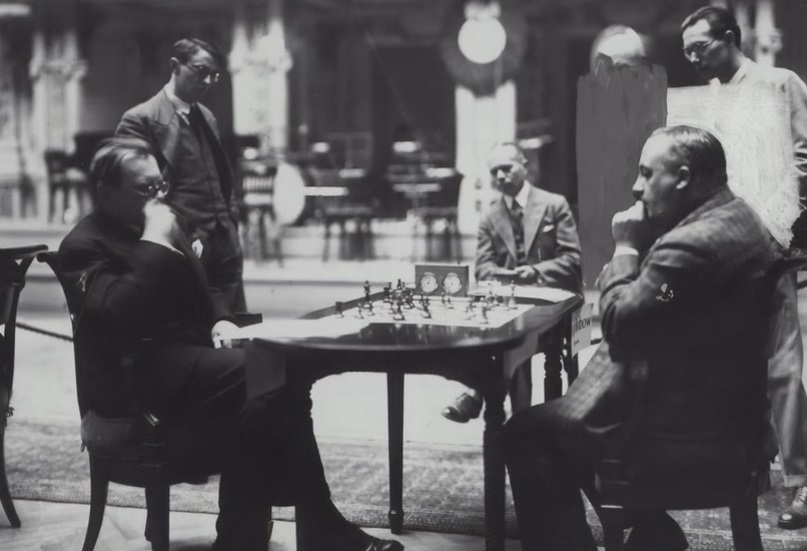
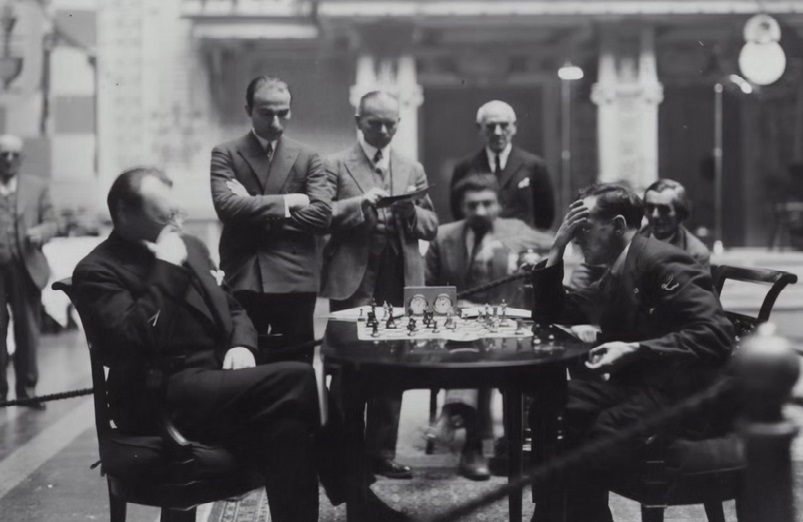
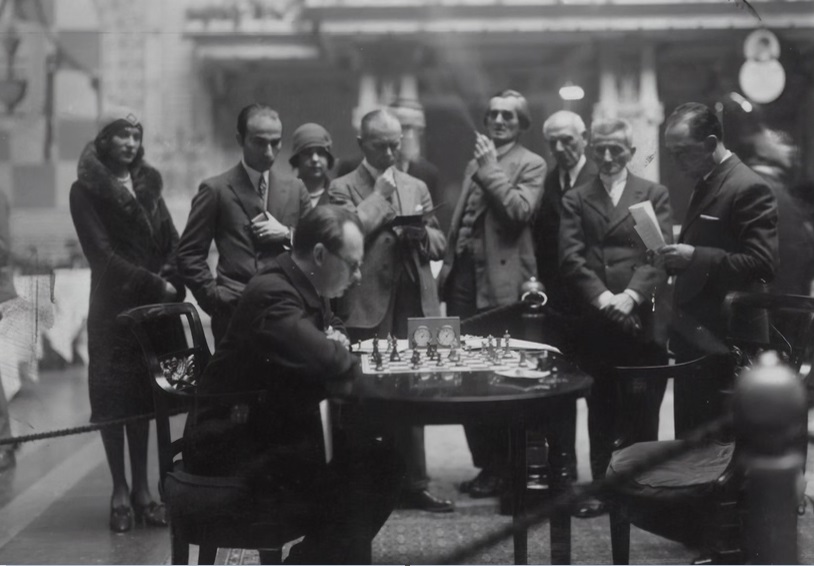
From the same source, below are two shots of Alekhine with his wife:
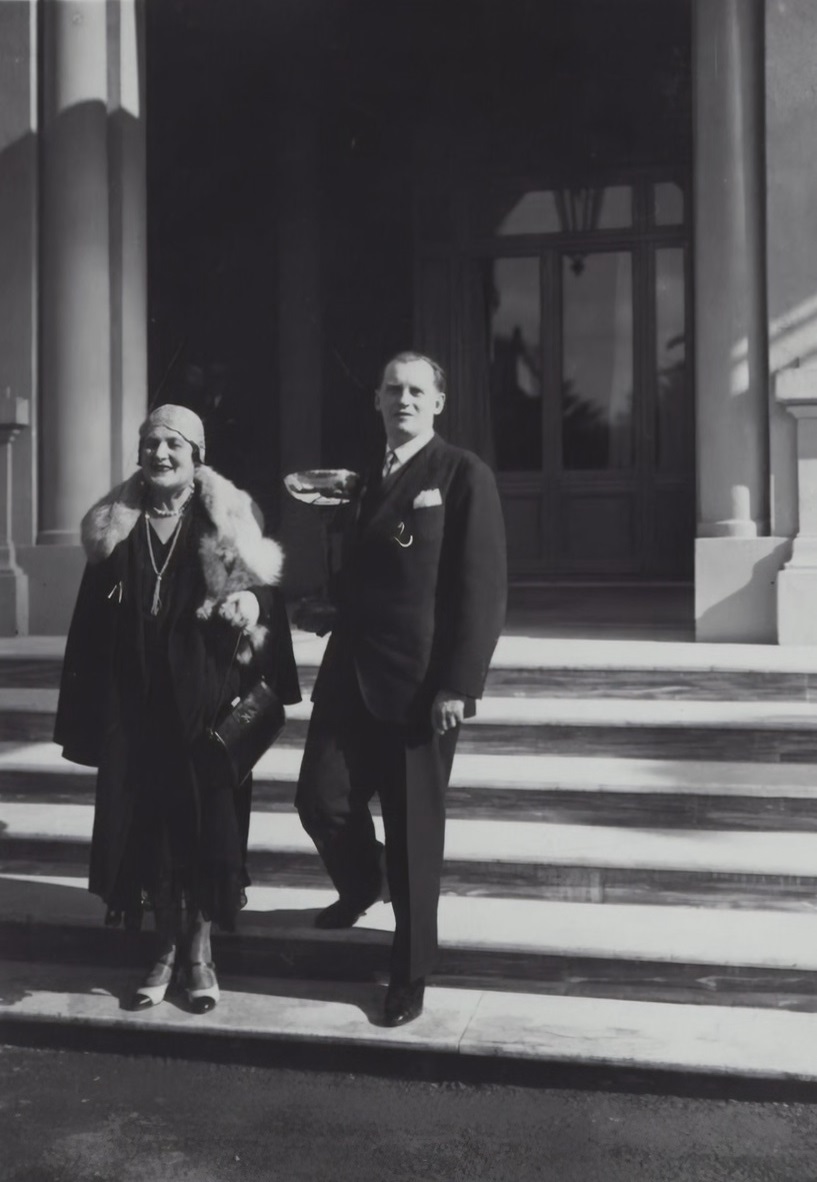
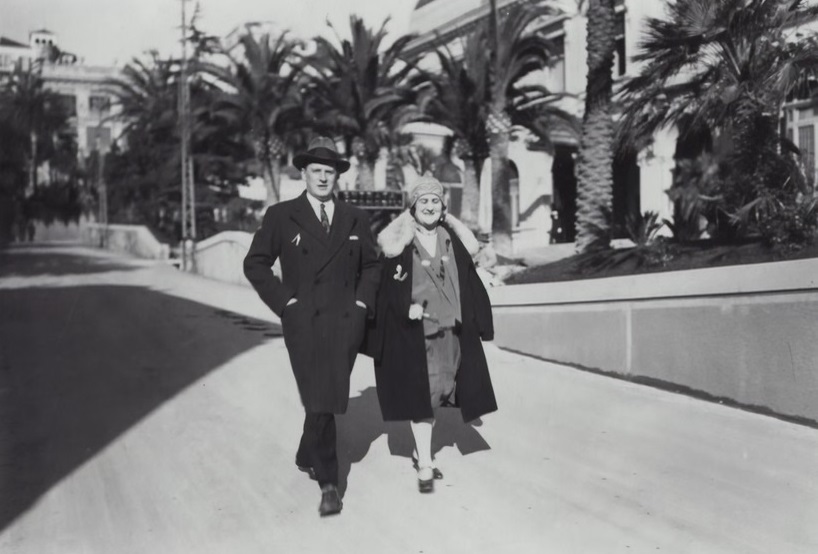
From the Hulton Archive, Olimpiu G. Urcan has also sent us this December 1931 photograph of Alekhine and his wife:
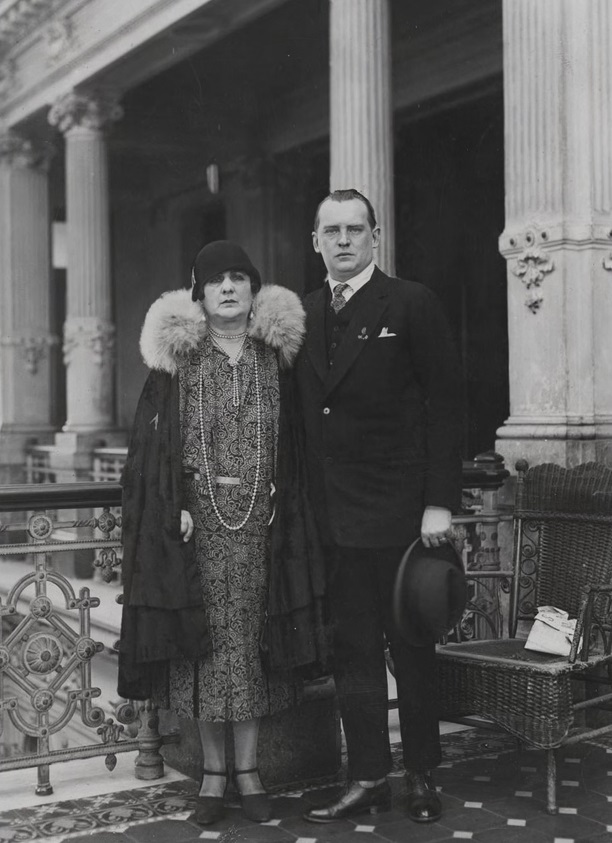
Regarding Raymond Keene’s treatment of Znosko-Borovsky v Alekhine, Paris, 1925, see a brief article by Olimpiu G. Urcan.
With respect to masters’ preferences regarding the minor pieces, Gerald Abrahams wrote on page 63 of Teach Yourself Chess (London, 1951):
‘The late Alexander Alekhine, a player whose style lent itself to combinations on the crowded board, seemed to prefer the knight.’
Such generalities are easily put forth, and this one seems particularly questionable.
(2732)
The recent death of D.A. Yanofsky prompts us to record here two remarks by world champions. Firstly, Alekhine’s posthumous book Gran Ajedrez reproduced photographically part of his annotations (in English) to the famous game Yanofsky (aged 14) v Dulanto, Buenos Aires, 1939. At move 22 Alekhine wrote:
‘The whole little game is characteristic of the incisive style of the young Canadian, who was practically the only revelation of the Buenos Aires Team Tournament.’
In the introduction to Yanofsky’s book Chess the Hard Way! (London, 1953) Euwe, for his part, declared:
‘Considering his youth and his talent, I have no doubt that Abe Yanofsky will one day belong to the strongest of the strong ones, and many of my colleagues share this opinion.’
Chess the Hard Way! is, we believe, one of the best autobiographical games collections. Today, alas, it seems all but forgotten, as does Yanofsky’s 1957 treatise on the phase for which he was the most famed, How to Win End-Games.
(2376)
Christian Sánchez draws our attention to page 10 of the May 2001 issue of Gambito and some bizarre comments attributed to Manuel de Agustín in an interview conducted two years previously by Miguel Ángel Nepomuceno:
‘Manuel de Agustín [1916-2001] was one of Spain’s best chessplayers, and among his staunch friends he counted the Franco-Russian world champion Alekhine (whom he brought to Madrid in 1943 to play in a national tournament and to save him from his Nazi persecutors) and, especially, the Polish Jew GM Ossip Bernstein, whom he got out of a concentration camp in Teruel and saved from certain death.
“I tried to make the imprisoned Republicans’ lives a little less arduous by taking chess into their cells and playing numerous simultaneous games with them, as well as organizing tournaments for them. If during the time I was with them somebody asked me for help, I did not hesitate to offer it. When Keres came to Madrid to play in the great tournament of 1943, he was wearing an SS uniform, and the very day of his arrival I accompanied him to buy a suit, because his uniform was not appropriate in a country which had just emerged from a civil war. He was a Jew, and this was never written; like Alekhine, he enjoyed the protection of the Governor of Poland, but the only thing Alekhine wanted was to remain in Spain and leave, via Casablanca, for America, like so many other refugees. However, he died suddenly in Estoril when he was very close to his objective.”’
We need hardly stress that the above remarks should be treated with considerable circumspection.
(2801)
From pages 30-31 of the March-April 1946 American Chess Bulletin:
‘In 1927 Alekhine played again in New York and he was in a position to make good his challenge, because he had succeeded in interesting the chess circles of Buenos Aires in the match. However, he was fairly hard put to finish second in the tournament.
He explained after the match with Capablanca that in New York he had purposely not played his best in order to mislead the Cuban. However, I am sure this was one of his curious childish attitudes and in reality he played as well as he knew how.’
(2856)
From an article by V. Halberstadt entitled ‘Reminiscences of Alekhine’ on pages 69-70 of the March 1956 BCM:
‘One day at the Régence I asked him, “Alexander Alexandrovich, may I show you a correspondence game I played (in 1925-26) in the France-Italy match?” and I commenced the demonstration.
1 d4 d5 2 c4 Nf6 3 cxd5 Nxd5 4 e4 Nf6 5 Nc3 e5 6 Nf3 exd4 7 Nxd4; here Alekhine stopped me with “Your move is a bad one, since Black can play 7…Bc5 and if you play 8 Be3 Black replies 8…Ng4, as I said in the notes to my game against Marshall at Baden-Baden”.
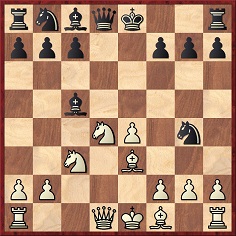
I looked up at him and asked innocently “and if then I should play 9 Ne6?” Surprise on Alekhine’s part, and, with a laugh, “Well, I never saw that”.’
The Alekhine note was published on page 66 of his 1932 book Auf dem Wege zur Weltmeisterschaft and, as it happens, also on page 66 of the English translation. See too page 26 of the second ‘Chess Stars’ monograph on Alekhine (Sofia, 2002). Alekhine presented a different set of annotations to the Marshall game in his second volume of Best Games.
The diagrammed position above occurred in the simultaneous game Alekhine v Mooyman and Citroen, Soerabaja, 6 March 1933 (see page 452 of the Skinner/Verhoeven book on Alekhine). The then world champion’s ninth move was not Ne6 but Bc4 (‘!’).
Halberstadt did not indicate the year of his conversation with Alekhine, but he referred to 9 Ne6 when annotating the above-mentioned correspondence game on pages 60-61 of the March 1926 La Stratégie:
Vitaly Halberstadt – Alberto Rastrelli
Correspondence match (France-Italy), 1925-26
Queen’s Pawn Opening
1 d4 d5 2 c4 Nf6 3 cxd5 Nxd5 4 e4 Nf6 5 Nc3 e5 6 Nf3 exd4 7 Nxd4 c5 (‘If 8…Bc5 9 Be3 Ng4? 9 Ne6 Qxd1+ 10 Rxd1 Bxe6! 11 Bxc5, etc., best.’ – Halberstadt.) 8 Bb5+ Bd7 9 Nf5 Bxb5 10 Qxd8+ Kxd8 11 Nxb5 Nxe4 12 Bf4 a6 13 Nc7 Ra7 14 Nd5 Nd7 15 O-O-O b5 16 Rhe1 g6
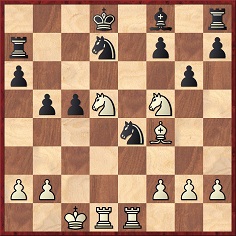
17 Rxe4 gxf5 18 Bg5+ Kc8 19 Re8+ Kb7 20 Ne7 Nb6 21 Nxf5 f6 22 Bf4 Ra8 23 Re6 h5 24 Nd6+ Resigns.
(2899)
From page 113 of Jubileum Uitgave van de Soerabajasche Schaakclub by W.N. Dinger (Soerabaja, 1936) we reproduce a photograph of Alekhine (in centre) at a 43-board simultaneous display in Soerabaja on 4 March 1933:
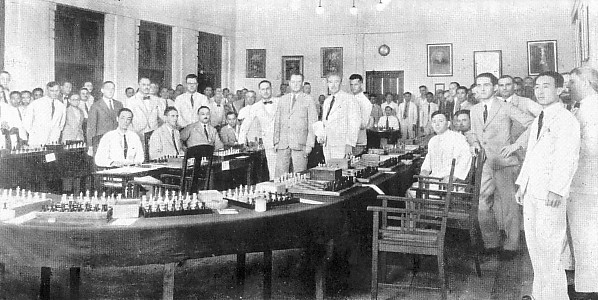
(3441)
A master more skilled at blindfold chess than orthography was Koltanowski. On page 59 of With the Chess Masters (San Francisco, 1972) he referred to ‘Duncan Philidor’. A sample of other lapses in the book was listed in C.N. 1234 (see pages 159-160 of Chess Explorations), and these included the point that on page 92 he gave E. Sapira’s name as ‘Sapiro’ (five times). For example:
‘Sapiro was a witty hunchback with great chess talent (He was killed by the Nazis in the 1940 invasion of Belgium.)’
However, on page 102 of their 1988 book Histoire des maîtres belges M. Wasnair and M. Jadoul stated (without, unfortunately, specifying any source) that Sapira died two or three years later:
‘En 1942-43, afin d’échapper à l’holocauste nazi, il traverse la France et c’est là, au pied des Pyrennées qu’il disparaît, victime d’un “Thénardier” qui le détrousse et le vend aux Nazis.’
Some of Sapira’s best games are readily accessible in databases. Here we give an interesting loss which was annotated by Alekhine on page 163 of L’Echiquier, August 1925:
A. Tackels – Emmanuel Sapira
Antwerp, 25 July 1925
Queen’s Gambit Declined
(Notes by Alekhine)
1 Nf3 d5 2 d4 Nf6 3 c4 c6 4 Nc3 e6 (‘In my opinion 4…dxc4 5 e3 b5 6 a4 b4, etc. is preferable.’) 5 Bg5 dxc4 (‘If Black intended to take the c-pawn he would have done better to play first 5…h6 {6 Bh4 dxc4 7 e4 g5, etc.}.’) 6 e4 Bb4 7 e5 (7 Bxf6 Qxf6 8 Bxc4 would be simpler, with clear positional superiority.’) 7…h6 8 exf6 (‘And not 8 Bh4 g5 9 Nxg5 because of 9…Qa5!’) 8…hxg5 9 fxg7 Rg8 10 h4 g4 11 Ne5 Rxg7 12 Nxg4 c5! (‘The start of an ingenious offensive, and the only way of offsetting White’s chances on the king’s side.’) 13 a3 Bxc3+ 14 bxc3 Qa5 (‘But this is too subtle. With 14…cxd4 15 Bxc4 dxc3 {and not 15…Nc6 16 h5!} he would have had good drawing chances.’) 15 Rh3 cxd4 16 Qxd4 e5 17 Re3? (‘With the simple manoeuvre 17 Nxe5 Bxh3 18 Nxc4, followed by 19 Qxg7 he could have refuted the combination started by Black’s 14th move; the text move, in contrast, should cause him to lose.’) 17…Nc6 18 Nf6+ Ke7 19 Nd5+ Kd6!
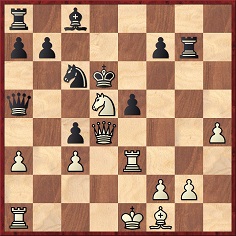
20 Qe4 f5 (‘Or 20…Rg4 21 f4 {if 21 Qf3 Qxd5 22 Rd1 Nd4} 21…Qxd5! 22 Rd1 Qxd1+ 23 Kxd1 Rxf4, followed by 24…Rxf1+ wins. However, the text move is also sufficient.’) 21 Qxc4 Be6 22 Rd1 Nd4? (‘The decisive mistake. By playing 22…Bxd5 23 Rxd5+ {if 23 Red3 Ne7, etc.} 23…Qxd5 24 Rd3 Nd4, etc. he would have won easily.’) 23 Qb4+ Qxb4 24 Nxb4 a5 25 Nc2 Bb3 26 cxd4 (‘The simplest, since the endgame two pawns ahead is easily won.’) 26…Bxc2 27 dxe5+ Ke7 28 Rc1 Be4 29 Rc7+ Kf8 30 Rxg7 Kxg7 31 Bd3 Bxd3 32 Rxd3 Rc8 33 Rd7+ Resigns. (‘An eventful game played with great vigour by both sides.’)
(2906)
A passage concerning the 1937 Euwe-Alekhine match from page 22 of The Final Candidates Match Buenos Aires, 1971 by Reuben Fine (Jackson, 1971):
‘… Alekhine sent his second, Eliskases, packing and won, while Euwe, who retained me as second, with Grünfeld in the shadows to consult on openings, also lost in the over-the-board complications. Chess remains a one man game.’
(2918)
See also Chess Seconds and Ernst Ludwig Klein.
From Dan Scoones (Port Coquitlam, BC, Canada):
‘I have always been curious about several photographs that appear in the introduction to the New York, 1924 tournament book (as reprinted by Dover Publications). In the first place, few were actually taken at New York. Several of them are mislabelled, and one is famously reversed. The photograph of Réti was taken at Moscow, 1925, as was the one of Lasker playing Capablanca. The photograph of Tartakower was obviously taken many years after 1924. Why is the photograph of Alekhine playing Bogoljubow labelled Alekhine and Bogoljubow playing in Russia when it is well known that Alekhine never set foot in Russia after 1921, and when it is equally obvious (if only from the spelling “Aljechin” ) that the photograph was taken in Germany during their 1934 match? Are we really expected to believe that the photograph of Edward Lasker playing Emanuel Lasker was taken during their sixth-round marathon? Where is the clock? And the scoresheets, for that matter? Why has the photograph of Emanuel Lasker solving a study been reversed? Any light you can shed on the true provenance of these photographs would be most welcome.’
As a starting-point it may be noted that the original edition of the book (published in 1925) had a different set of photographs (apart from the portraits of Yates, Edward Lasker and Janowsky, as well as the group shots of the players and the tournament committee).
(2922)
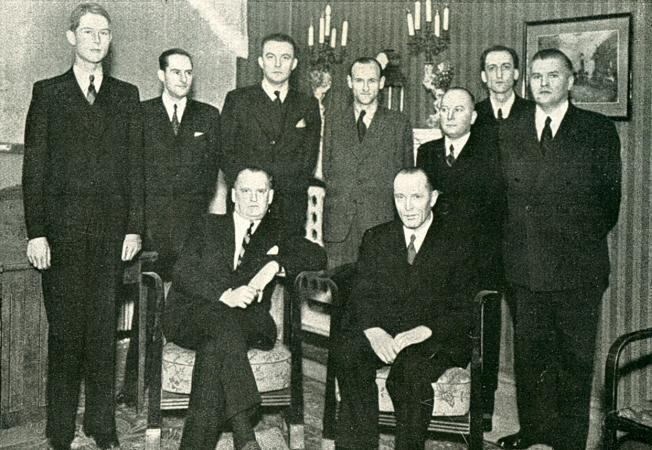
Photograph in the Prague, 1942 tournament book. Standing: K. Junge, J. Podgorný, J. Foltys, F. Sämisch, J. Rejfír, C. Kende (organizer), F. Prokop. Seated: A. Alekhine, O. Důras.
(2926)
The above photograph was also given in C.N. 3534.
From Per Skjoldager (Fredericia, Denmark):
‘On page 47 of his book Af en skakstympers skriftemål Harald Enevoldsen relates the following story from a simultaneous display by Aron Nimzowitsch in 1923, in which Harald and his older brother Jens took part (they were aged 16 and 13 respectively):
“The way he handled the pieces was somewhat peculiar. He did not use the first, second and third fingers as we did, but the second, third and fourth. This – as it seemed – very sophisticated manner of moving the pieces we copied immediately, and I use it even today.”
On page 65 of Alt om skak (Odense, 1943) there is a picture of Alekhine giving a simultaneous display in Copenhagen in 1935. It is clear that he is moving the pieces in a similar way:
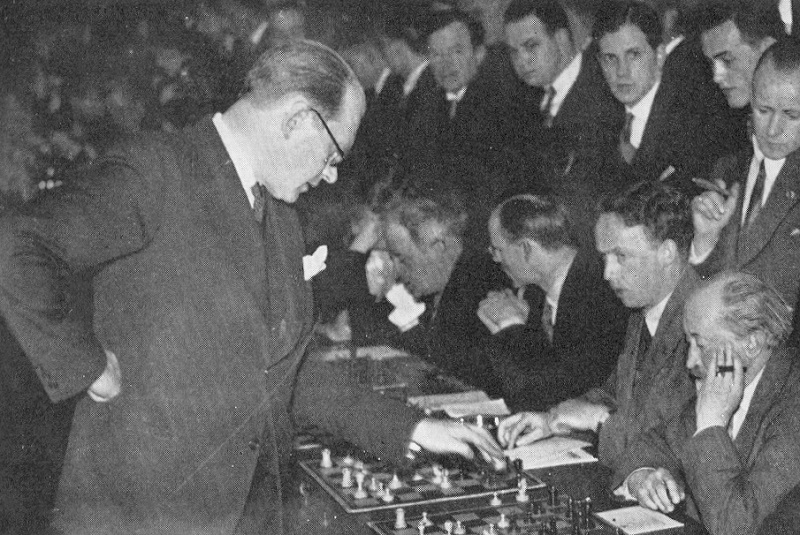
The question is whether both Nimzowitsch and Alekhine had this peculiar habit or whether Enevoldsen was mixing up the two. Any other evidence?’
(3055)
A brief digest from the section on Alekhine (‘the sadist of the chess world’) on pages 52-55 of The Psychology of the Chess Player by Reuben Fine:
‘… we are told that his mother taught him the game at an early age.’
‘His father is reported to have lost two million rubles at Monte Carlo.’
‘Alekhine was reputed to have become a member of the Communist party.’
‘A report was broadcast during the war that Alekhine was confined to a sanatorium in Vichy, France for a while; but I have been unable to obtain any details.’
‘It was said that he became impotent early in life.’
(3082)
On page 36 of his book Curious Chess Facts (New York, 1937) Chernev questioned Alekhine’s analysis of game 40 in My Best Games of Chess 1908-1923. It was his second match-game against Levitzky in St Petersburg, 1913, and Alekhine (White) began 1 e4 e5 2 f4 exf4 3 Bc4 Nf6 4 Nc3 Bb4 5 Nge2 d5 6 exd5 f3 7 gxf3 O-O 8 d4 Bh3.
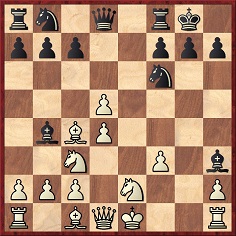
Here Alekhine played 9 Bg5 and commented:
‘The plausible move was 9 Nf4, protecting both pawns and attacking the bishop, but upon this Black had the following win in view: 9…Re8+ 10 Kf2 Ng4+! (seemingly inoffensive because of White’s reply) 11 Kg3 Nf2!!, etc. With the text-move White definitely assumes the initiative.’
Chernev stated that in this line, ‘Actually, White can win by replying 12 Qg1!!’ Whether or not White’s advantage is decisive, it certainly seems that he has the better game and that, therefore, Alekhine’s analysis was faulty.
(3093)
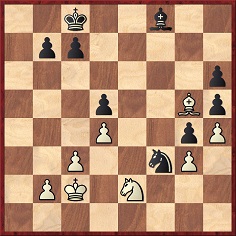
White to move
This position occurred at the end of a game between Alekhine (White) and Joaquim Val[l]adão Monteiro at the headquarters of the Brazilian Chess Federation in Rio de Janeiro on 31 May 1939. Alekhine declared it drawn, and on pages 78-79 of his book Dicionário Brasiliense do Jogador de Xadrez (Rio de Janeiro, 1956) Black gave the following analysis by Eliskases (our translation from the Portuguese):
‘The game is drawn. If 1 Be3 Bd6! (to prevent 2 Nf4) 2 Bxh6 (if 2 Bf4 Bf8! 3 Be5? Nxe5 4 dxe5 Kd7 5 Nf4 Bg7! with advantage to Black) 2…Kd7 3 Bf4 Bf8! 4 Be3 Bd6 5 Bf4 with repetition of moves. If White tries to win with 4 Be5 Black has the better chances, by continuing with 4…Nxe5 5 dxe5 Ke6 6 Nf4+ Kxe5 7 Nxh5 Bh6! In that position the white knight cannot withdraw, so Black de facto has a won game. Rio de Janeiro, 12 October 1944 – Erich Gottlieb Eliskases.’
We note that Eliskases made no mention of 7 Ng6+ (as an alternative to 7 Nxh5).
Wanted: biographical information regarding Joaquim Val[l]adão Monteiro, whose other chess books included Dicionário Brasiliense de Têrmos Enxadrísticos (Rio de Janeiro, 1953).
(3270)
See too our subsequent article Joaquim Valladão Monteiro.
A set of stamps issued by Kyrgyzstan in 2000:
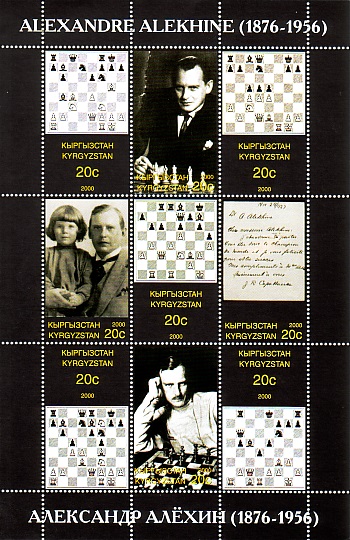
Instead of 1892-1946, Alekhine’s dates were given as 1876-1956. These were, we believe, the birth-year and death-year of his last wife, but how could such a mix-up have happened?
(3318)
Christian Sánchez suggests that the mix-up occurred because the dates 1876-1956 also appear on Alekhine’s tombstone in the Montparnasse Cemetery, Paris.
(3459)
See also Graves of Chessmasters.
From Steve Wrinn:
‘On page 102 of his book Max Euwe (Alkmaar, 2001) Alexander Münninghoff relates that in 1934 Hans Kmoch successfully persuaded a reluctant Euwe to challenge Alekhine for the world’s championship, as Kmoch felt that “Alekhine’s form was – at least temporarily – in decline”. Münninghoff then makes three separate references to the game Alekhine-Lilienthal from the Hastings, 1933-34 tournament, which Kmoch supposedly saw as emblematic of that decline:
1. “Alekhine’s loss against the young and promising Hungarian Lilienthal was especially revealing in Kmoch’s eyes: for the first time in his career, Alekhine had been outplayed in a series of complicated tactical manoeuvres.”
2. (Münninghoff, paraphrasing Kmoch’s words to Euwe) “Didn’t you see Alekhine’s Hastings games? Don’t you know how he fumbled against Lilienthal?”
3. (Münninghoff, paraphrasing again) “Why don’t you have another look at that game of his against Lilienthal, then you will see that it wasn’t an accidental slip-up.”
I find all this rather perplexing, as Alekhine lost no games at Hastings, 1933-34, and in fact defeated Lilienthal in the game in question. Moreover, a quick check with Fritz indicates that Alekhine never stood worse during the tactical phase of that game; nor did he “fumble” or “slip up”. How Münninghoff can be so mistaken about a game that he himself considers the central topic in a “conversation that would have a decisive impact on the history of chess” is a mystery to me.’
We offer a few comments:
a) The original (1976) Dutch edition of Münninghoff’s book (pages 148-149) had a similar account. Euwe was listed as a co-author (for the annotations) and he also contributed the Foreword.
b) Kmoch wrote the chapter on Euwe in the former world champion’s book Zóó schaken zij! (Amsterdam, 1938). On page 151 he noted Alekhine’s relative failure at Hastings, 1933-34 but made no mention of the Lilienthal game. The chapter was expanded for the English edition, i.e. Meet the Masters (London, 1940), but there was still no reference to Lilienthal. To quote from page 258:
‘Then came a break in his chess career through his devoting himself to his mathematical studies for a while. Alekhine’s slight lapse in the Christmas tournament at Hastings, 1933-34 suddenly gave him the idea of challenging the now world champion to another match, and by the summer of 1935 the great event had been arranged.’
c) On page 123 of his monograph Max Euwe (Berlin and Leipzig, 1938) Kmoch stated that one January evening in 1934 he and Euwe were discussing Alekhine’s performance at Hastings (equal second with Lilienthal behind Flohr), and the conversation turned to the fact that Euwe had a 7-7 score against Alekhine in their last 14 games. No other master had put up such resistance against the world champion, and that evening Euwe decided to challenge him for the title. For the record, Kmoch’s original text is reproduced below:
‘Im Januar wohnte ich bei Dr. Euwe. Eines Abends sassen wir beisammen und plauderten über das letzte Weihnachtsturnier in Hastings, wo Flohr den ersten Preis gewann, während Aljechin und Lilienthal die zwei folgenden Preise teilten.
Es bedeutete damals noch eine grosse Sensation, wenn Aljechin einmal nicht Erster wurde, und so kam es, dass sich unser Gespräch bald nur noch um den Weltmeister drehte. Natürlich kamen auch die Ergebnisse der Spiele zwischen Euwe und Aljechin zur Sprache: 7:7 aus den letzten 14 Partien, ein prachtvoller Erfolg für den Holländer. Keinem anderen Meister der Welt ist es geglückt, Aljechin so guten Widerstand zu bieten (welche Feststellung übrigens auch heute noch zutrifft). Und irgendwie kam es, dass Euwe an diesem Abend den Entschluss fasste, Aljechin zum Kampf um die Weltmeisterschaft herauszufordern.’
d) We can supply no explanation for Münninghoff’s statement that Alekhine lost to Lilienthal or for his belief that the game was otherwise significant.
e) Pre-1934 predictions that Euwe had chances of becoming world champion are not too difficult to find. For example, the text below appeared on page 54 of the February 1931 BCM:
‘The popular Dutch champion is still under 30, so he should be a strong candidate for the world championship before long.’
On the other hand, we note the following on page 3 of the January 1936 BCM:
‘Euwe has fulfilled the prophecy of Dr Emanuel Lasker, when he was still a boyish student, that he would one day win the world title.’
When and where did Lasker make such a prediction about Euwe?
(3348)
See also Chess Predictions.
Christian Sánchez has sent us a letter written by Capablanca which was presented (and billed as previously unpublished) on page 25 of Magazine Actual, May 1997. Below are the original and our English translation:
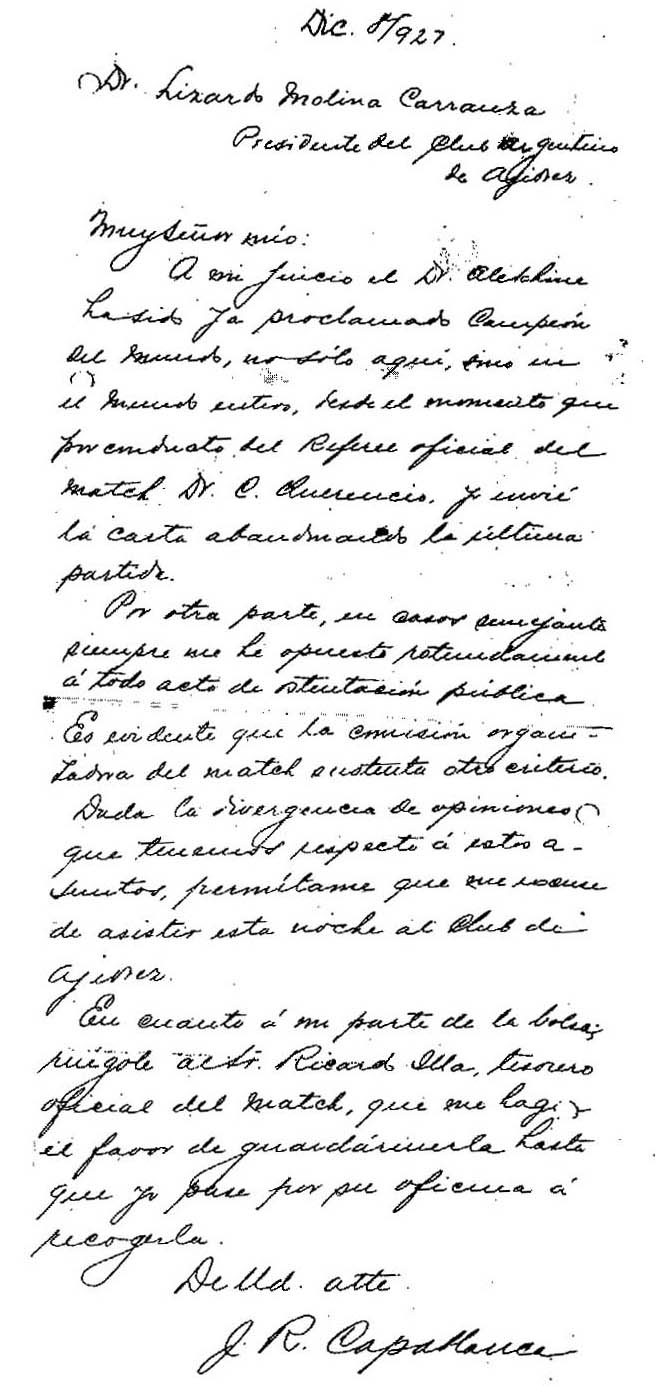
‘8 December 1927
President of the Club Argentino de Ajedrez
Dr Lizardo Molina CarranzaDear Sir,
In my opinion, Dr Alekhine was already proclaimed world champion, not only here but throughout the entire world, from the moment when, through the official match referee, Dr C. Querencio, I sent the letter in which I resigned the final game.
Moreover, in similar cases I have always emphatically opposed any act of public ostentation. It is clear that the organizing committee of the match is applying a different criterion.
Given our difference of views with respect to these matters, permit me to refrain from attending tonight at the Chess Club.
As regards my share of the purse, I am asking Mr Ricardo Illa, the official match treasurer, kindly to retain it for me until I go to his office to collect it.
Yours sincerely,
J.R. Capablanca.’
The context is that on 29 November 1927 Capablanca had written to Alekhine (in French) to resign the 34th and last match game, adding ‘you are therefore the world champion’. The day the above-quoted letter was written to Lizardo Molina Carranza (8 December 1927) Alekhine was ‘officially proclaimed world champion’ at the Club Argentino de Ajedrez, as reported on page 123 of the January 1928 issue of El Ajedrez Americano. After an address by Carranza on the significance of the match, Alekhine spoke, thanking the Club for its work and declaring himself against changes to the world title match rules.
A photograph of the ceremony appeared on page 166 of Match por el título mundial (Buenos Aires, 1978). On the far right is Lizardo Molina Carranza, with Alekhine standing on his right. Ricardo Illa is seated, his hands clasped.
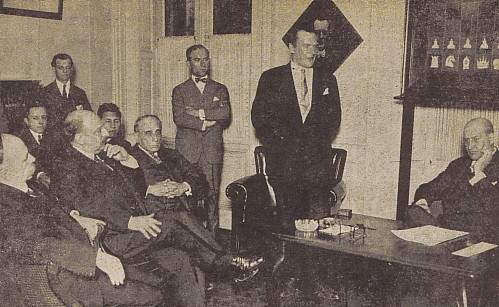
(3428)
Footage of old events (such as living chess displays featuring Capablanca and Alekhine, against Sir George Thomas and Bogoljubow respectively) can be viewed at the following site: http://www.britishpathe.com/.
(3491)
See also Chess Masters on Film.
‘Alekhine was both on 31st October 1892 in Moscow.’
That unpropitious start comes on the first page of the first chapter of Alexander Alekhine Master of Attack by A. Raetsky and M. Chetverik (London, 2004). However, the most striking feature of this Everyman Chess potboiler is that the names of many of Alekhine’s opponents have been mangled (two examples being ‘Kakiato’ and ‘Afric’, both on page 42). It is lamentable that anyone would even consider bringing out a book on Alekhine without consulting Alexander Alekhine’s Chess Games, 1902-1946 by L. Skinner and R. Verhoeven (Jefferson, 1998).
(3507)
C.N. 3225 recalled that the observation ‘Chess is vanity’ is widely attributed to Alekhine and asked whether he ever used those words. We drew attention to the following passage on page 19 of the January 1929 BCM:
‘Alexander Alekhine, interviewed in Paris by the Eclaireur de Nice on 24 November, said with regard to his victory over Capablanca at Buenos Aires: “Psychology is the most important factor in chess. My success was due solely to my superiority in the sense of psychology. Capablanca played almost entirely by a marvellous gift of intuition, but he lacked the psychological sense.”
From the commencement of the game, the champion continued, a player must know his opponent. “Then the game becomes a question of nerves, personality and vanity. Vanity plays a great part in deciding the result of a game.”
We are indebted to the Central News for the above item of information.’
It has not yet proved possible to find the original text of the interview in the French source, but here we draw attention to what appeared in the quotes chapter of The Joys of Chess by F. Reinfeld (New York, 1961), page 286:
‘“Chess is a matter of vanity.”
– Alexander Alekhine, Chess Review, 1934.’
However, this proves to be a non-source, for Reinfeld did not make it clear that the item in question was merely an article by Barnie F. Winkelman entitled ‘Vanity and Chess’ on pages 156-157 of the September 1934 Chess Review. The quotation introduced Winkelman’s article, as follows:
‘“Chess is a matter of vanity …”
Dr Alexander Alekhine
(From a reported interview.)’
|
That is all. The last two paragraphs of Winkelman’s article discussed the ‘reported’ Alekhine quote (whose authenticity has yet to be established):
|
|
(3522)
Some information about Hans Frank (1900-46), the most prominent Nazi leader to be strongly interested in chess, is available in the books on Alekhine by P. Morán and L. Skinner/R. Verhoeven, and we began presenting material about him in C.N. 3527. The subsequent feature article includes a number of photographs of Alekhine with Frank, such as the following (from C.N. 9890):
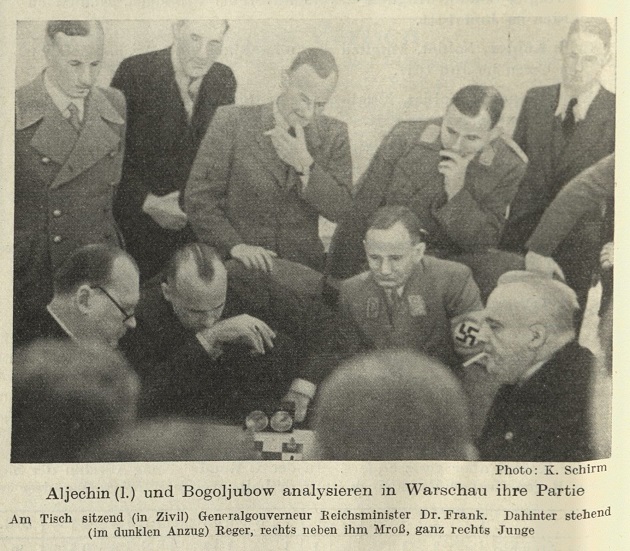
Deutsche Schachzeitung, November 1941, page 162.
See also the references to chess in our feature article Chess: Hitler and Nazi Germany.
Page 282 of A Chess Omnibus quoted remarks by Alekhine (from an interview in Informaciones, 3 September 1941) about ‘a most beautiful Sèvres vase’ which he won in St Petersburg at the age of 16 and to which he was deeply attached. Below are photographs of him from page 225 of the Russian edition of the St Petersburg, 1909 tournament book and from page 175 of El Ajedrez Americano, November 1935:
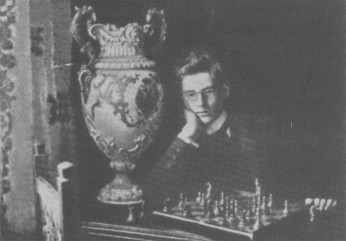
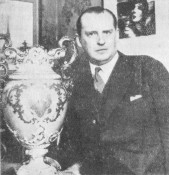
(3697)
Concerning the photograph of Alekhine in C.N. 9916, from page 109 of El Ajedrez Americano, April 1938, Dan Scoones mentions that in a BBC radio interview in 1938 Alekhine described the vase as ‘the only thing I was allowed to bring out of Russia in 1921 when I left’.
The full audio file and transcript are easily found on the Internet. As mentioned in a ChessBase article dated 14 June 2010, we believe that both were first made available online in 2003, by Hanon Russell at the Chess Café.
(9924)
Another photograph of Alekhine with his vase was published on page 12 of Tidskrift för Schack, January 1934:
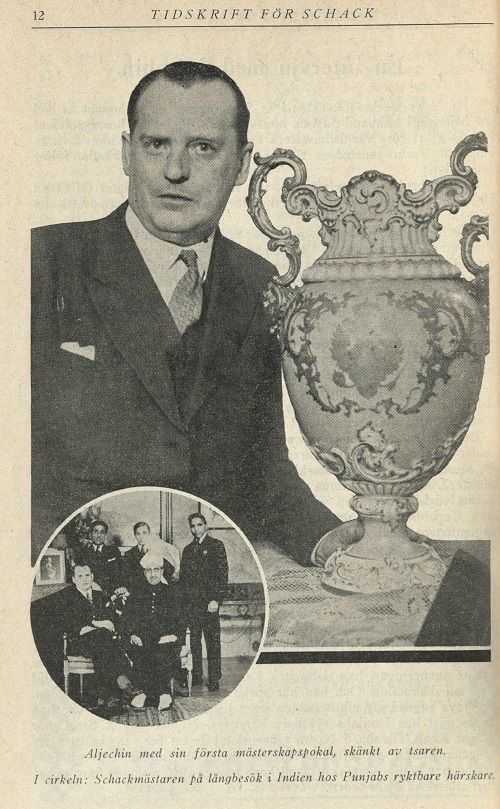
Acknowledgement for the above scan: the Cleveland Public Library.
The mirror image presented by the Swedish magazine is amended below:
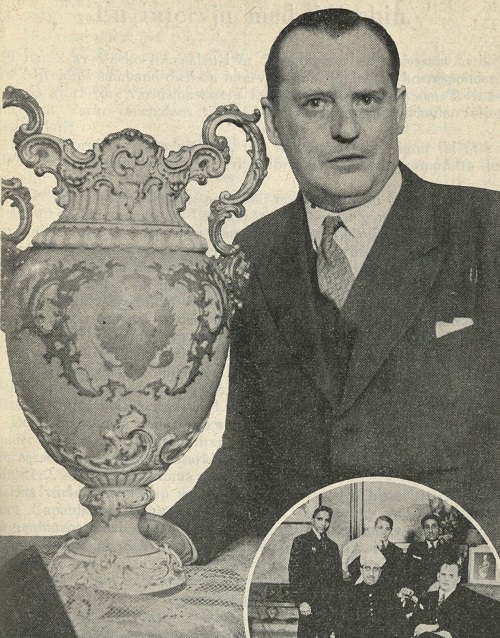
The smaller picture ...
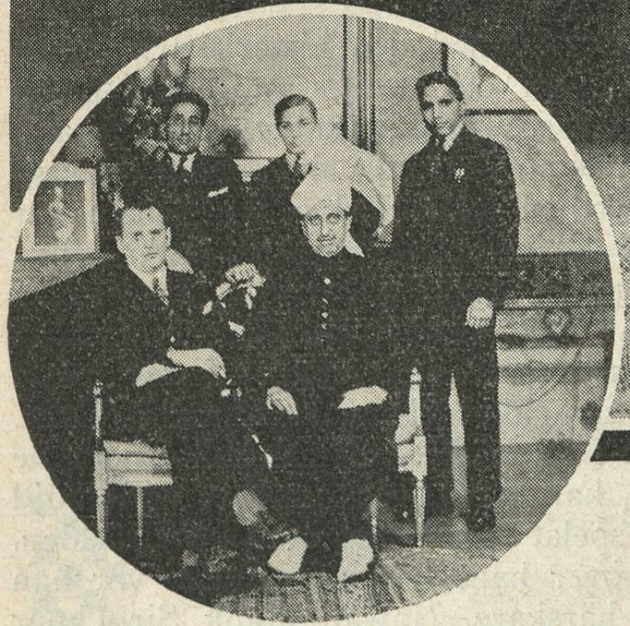
... may be compared with a photograph which we have given in Sultan Khan from page 5 of the American Chess Bulletin, January 1932:
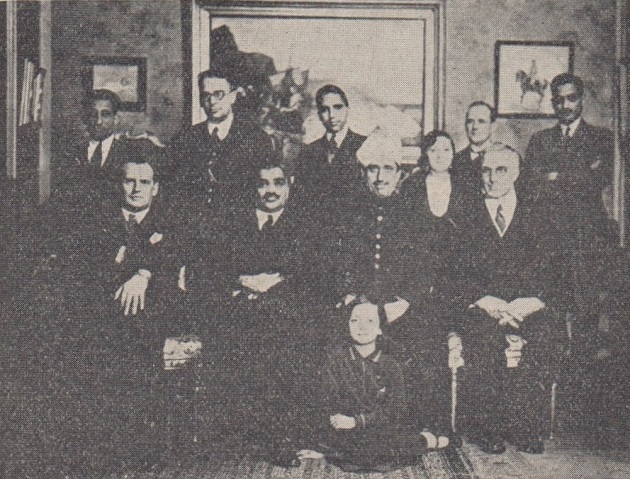
(11339)
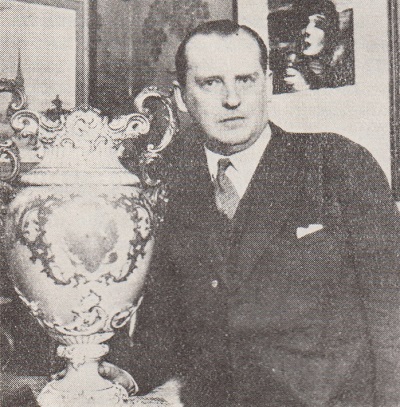
El Ajedrez Americano, November 1935, page 175 (C.N. 3697)
From Michael Clapham (Ipswich, England):
‘Page 13 of Shakhmatnoye Obozreniye for January, February, March and April 1909 includes the well-known photograph of the 16-year-old Alekhine with the vase awarded to him for winning the Masters’ Tournament in St Petersburg that year. Lower down the page the object is described as a “precious porcelain vase from the Imperial Factory”, and a footnote described the object in detail.
The board position appears to relate to Alekhine’s win against B. Gregory at St Petersburg, 1909 (game one in his first Best Games collection):
The following is from pages 26-27 of the Russian-language tournament book:
A question that arises is why references exist to a Sèvres vase (i.e. from France and not from the Imperial Porcelain factory in St Petersburg), as in Alekhine’s conversation with Informaciones, quoted in your feature article Two Alekhine Interviews (1941).
Andrew Soltis muddies the waters on page 14 of Soviet Chess 1917-1991 (Jefferson, 2000), when discussing the First Soviet Championship, held in Moscow in 1919:
“Alekhine wrote that the players had been promised a first prize of an ivory Chinese set. But the organisers improvised instead with belongings of émigrés confiscated from pawn shops: Alekhine, who placed first by a full point, selected ‘some bulky vase’ apparently impressed by the weight.”
Page 34 of Alexander Alekhine’s Chess Games, 1902-1946 by L. Skinner and R. Verhoeven (Jefferson, 1998) states, in a discussion of the 1909 tournament, that “the first prize consisted of a cut glass vase”. A similar claim was made on page 45 of Emanuel Lasker Second World Champion by I. and V. Linder (Milford, 2010): “He [Alekhine] was awarded the title of Master, along with the first prize, a luxurious crystal vase donated by Tsar Nicholas II.” Page 26 of Max Euwe The Biography by A. Münninghof (Alkmaar, 2001) referred to a Sèvres vase which Alekhine “had received from the Tsar in 1914 for winning the all-Russia tournament of St Petersburg”.
Returning to Shakhmatnoye Obozreniye for January, February, March and April 1909, I note that page 16 gives details of the diploma in watercolour which Alekhine also received:
The artist is named as Yuri Artsybushev, and the diploma was also reproduced on page 37 of the Russian edition of the St Petersburg, 1909 tournament book.’
(11661)
Calle Erlandsson informs us that during a recent visit to the Stockholm Chess Union he took photographs of two works of art on its premises, which included ...
‘... a portrait of Alexander Alekhine by Gabriel Strandberg (1885-1966), donated to the Union by Uno Hedin on 2 September 1997.’
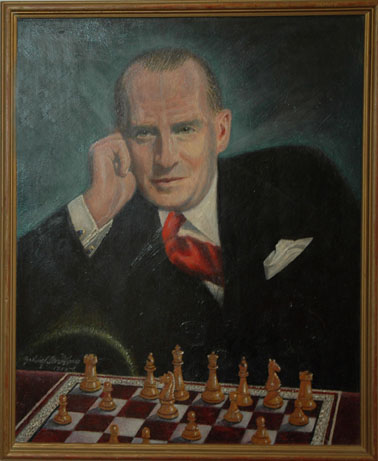
We note that this is based on the photograph of Alekhine which was, for instance, the frontispiece to the first (1939) edition of My Best Games of Chess 1924-1937:
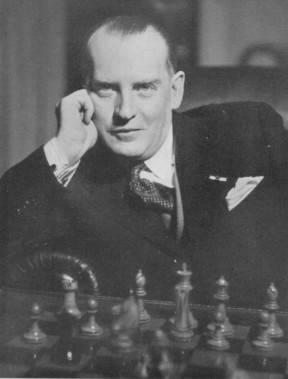
(3730)
C.N. 3737 asked which chessplayer was being described by the following:
The answer is Grace Alekhine, the world champion’s last wife. Her obituary on pages 99-100 of the April 1956 BCM reported that she was American-born and married Alekhine at Villefranche-sur-Mer in 1935, at which time she was the widow of a British tea-planter in Ceylon. She retained her British nationality to the end of her life. ‘The last few years she had spent partly in her studio in the French capital, and partly at St Ives, Cornwall, where she was a member of the local chess club.’
It was on page 11 of the October 1947 issue of CHESS that she wrote, from Dieppe, about chess notation:
‘I sincerely hope Mr Wood will not continue with his combination notation as I find it extremely unpleasant. I am thoroughly familiar with the algebraic notation and enjoy games in French, Spanish, German or Czech so it is not on that account that I object to his innovation. If he continues with it, I shall not renew my subscription again.’
Below is an example (from page 337 of the August 1947 CHESS) of the notation occasionally used at that time:
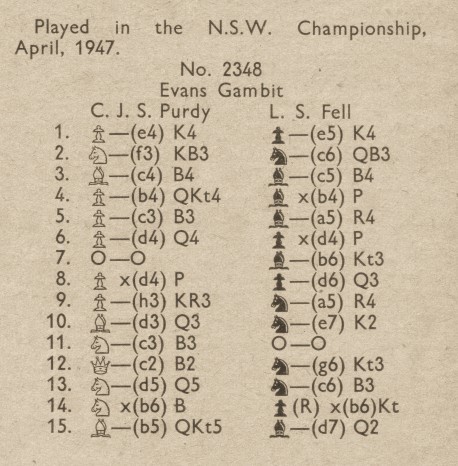
Page 54 of the February 1937 BCM reported that ‘Madame Alekhine (France)’ had won third prize in the ‘Third Class (morning)’ tournament at Hastings. She won £1, while her husband received £15 for finishing top in the Premier Tourney.
The photograph below, taken later that year, comes from page 277 of the Kemeri, 1937 tournament book (published in Riga in 1938):
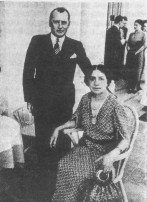
(3747)
Andy Ansel (Walnut Creek, CA, USA) informs us that he has a programme for Margate, 1938 signed not only by the players in the Premier Tournament but also by Madame Alekhine, who competed in Section A of the Second Class Tournament:
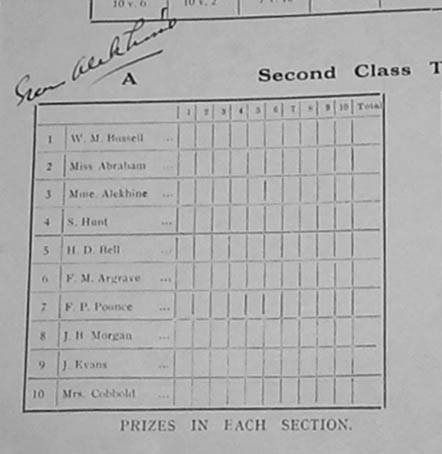
(3759)
Dominique Thimognier (St Cyr sur Loire, France) sends us an extract from page 2 of the Bulletin de la FFE, April-July 1934, which contained an account of the 1933-34 women’s championship of France. This stated that Maud Flandin finished second but was declared champion because the first-placed player, named Tonini, was Italian. The following game was given:
Jacobson – Maud Flandin
French Women’s Championship, 1933-34
Queen’s Gambit Declined
1 d4 d5 2 e3 c6 3 c4 e6 4 Nf3 Bd6 5 Bd3 Nf6 6 O-O Nbd7 7 Re1 O-O 8 Nc3 Re8 9 e4 dxe4 10 Nxe4 Nxe4 11 Bxe4 Nf6 12 Bd3 h6 13 Ne5 Qc7 14 c5 Be7 15 b4 Rd8 16 Be3 b6 17 f4 Nd5 18 Qh5 Bf6 19 Be4 Bxe5 20 fxe5 Nxe3 21 Rxe3 Rxd4 22 a3 bxc5 23 bxc5 Rc4 24 Re2 Rxc5 25 Rf1 f5 26 Qe8+ Kh7 27 Bb1 Rxe5 28 Rxe5 Qxe5 29 Qxc6 Rb8 30 Qa4 Qe3+ 31 Kh1 Rb2 32 Qd1 Bb7 33 Rg1 Qf2 34 Qf1 Qxf1 35 Rxf1 Bxg2+ 36 Kg1 Bxf1 37 White resigns.
Our correspondent also draws attention to page 3 of the June 1935 issue of L’Echo des Echecs, which reported that Maud Flandin participated in the next French championship, which began on 30 May 1935. Other contestants included Grace Alekhine. The magazine stated that the winner would be designated as a participant in the women’s world championship in Warsaw later that year (although it turned out that the tournament in Poland had no representative of France).
The July 1935 issue of L’Echo des Echecs (page 2) related that Maud Flandin was again second, behind Mlle P. Schwarzmann. As the full results were not given, regarding Grace Alekhine it can only be said that she finished outside the top four.
After that, our correspondent’s trail on Maud Flandin goes cold, although he is able to point out a report on page 7 of the November 1944 Bulletin de la FFE that Grace Alekhine was the women’s champion of Paris in 1944:
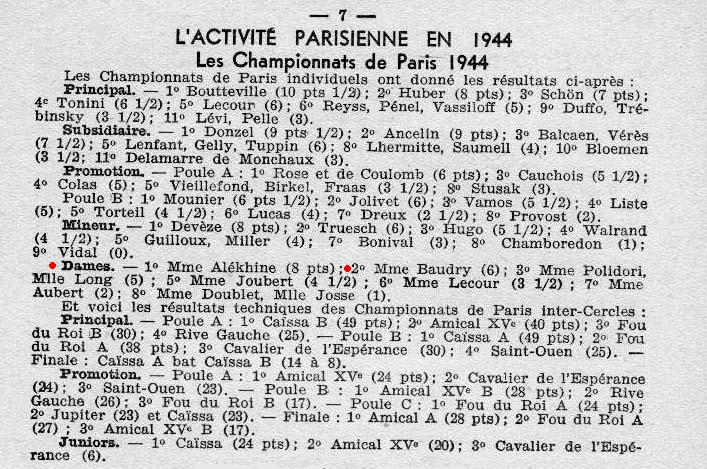
(4102)
In an article entitled ‘As I Saw Alekhine At Kemeri 1937’ on pages 252-254 of the May 1973 Chess Life & Review Paul Tamm described playing many casual games with Grace Alekhine:
‘... Mrs Alekhine was quite a good player and could easily compete in women’s tournaments. I was at that time a first-class player and still had trouble, when the two of us played without Alekhine present, gaining an edge of one or two points over Mrs Alekhine by the end of the day. I asked why she didn’t compete in women’s tournaments for the world title, and she replied simply that it probably wouldn’t be wise for two Alekhines to be aspiring for the world’s highest title. While answering this she was industriously knitting.’
(4263)
From Christian Sánchez refers to the age of Grace Alekhine, as show by a card at the Familysearch.org website, as well as a second one from the same source. Both gave her date of birth as 26 October 1886 instead of 26 October 1876.
(7565)
Christian Sánchez notes an early mention of Alekhine’s future wife, including a reference to her chess, on page 6 of the San Francisco Call, 13 October 1904:
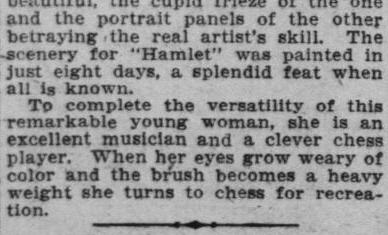
(8075)
A miscellany of three rare photographs of Alekhine. The first dates from around 1927, the second shows him in play against Flohr at Hastings, 1933-34, and the third was taken at Hastings, 1936-37.
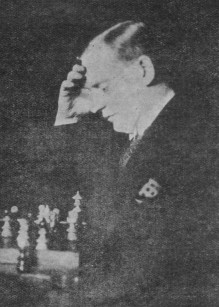
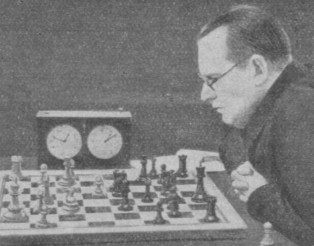
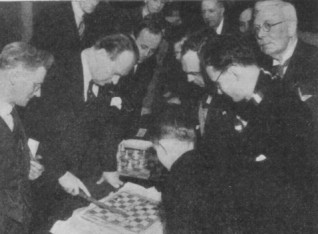
(3796)
We are hopeful that a reader can help us find out more about an incident reported in C.N. 790 (see pages 119-120 and 263 of Chess Explorations), i.e. the claim that shortly before the Vienna, 1922 tournament Alekhine tried to kill himself.
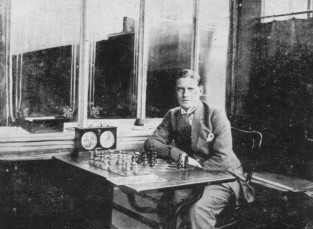
Alexander Alekhine
On 27 June 1984 James J. Barrett (Buffalo, NY, USA) wrote to us:
‘Did you know that Alekhine once plunged a knife into his abdomen while in a hotel lobby, in the presence of his friend Edmond Lancel? I have never seen a reference to this episode in all the Alekhine material I have read.’
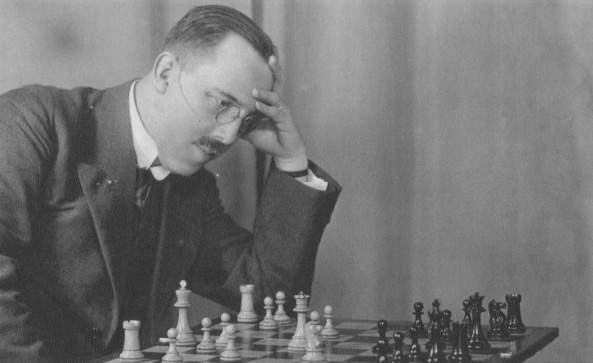
Edmond Lancel
Mr Barrett subsequently provided particulars, i.e. an extract from Lancel’s article about Alekhine on pages 1152-1153 of the April 1946 issue of L’Echiquier Belge. Below is the relevant passage, in our translation:
‘Alekhine took a few days off to rest in Aachen, where I was staying. Since the beginning of the year, we had been together on several occasions. We spent the evening of his birthday together at the Hotel Corneliusbad. He confided in me, talked to me about his life and showed me pictures of people close to him. We played, as we often did, several training games in preparation for the important Vienna tournament, which was to take place from 13 November to 2 December. Around three o’clock in the morning, without any warning whatsoever, in the grand hall of the hotel which was deserted except for my partner and myself, Alekhine suddenly tried to commit suicide in a moment of despair by stabbing himself in the stomach, and fell unconscious at my feet. I alerted the people at the hotel; the director, doctor, ambulance and police were summoned. The situation appeared extremely serious, and Alekhine did not regain consciousness. However, thanks to the rapid and energetic intervention of those called, he came around and a few days later he had recovered. Nonetheless, this incident was significant, occurring as it did shortly before the Vienna tournament. I did my best to dissuade my old friend from participating, for I was sure that he would not do well. My efforts were in vain; he insisted on playing ...’
(3842)
Jeremy Silman (Los Angeles, CA, USA) asks whether any further details are available regarding Edmond Lancel’s claim on pages 1152-1153 of the April 1946 issue of L’Echiquier Belge that in 1922 Alekhine tried to stab himself to death in the lobby of the Hotel Corneliusbad in Aachen.
As reported in an endnote on page 263 of Chess Explorations, in C.N. 862 C.D. Robinson commented:
‘Alekhine is alleged to have stabbed himself about 3 a.m. after celebrating his birthday. The actual date would be either 20 October or 1 November, according to whether he kept his birthday on the Russian date of 19 October or the Western date of 31 October. This allows a maximum of 24 days in which to recover from a serious wound and to travel from Aachen to Vienna for a tournament beginning on 13 November ... Lancel is wrong when he claims that Vienna, 1922 was Alekhine’s worst result between Scheveningen, 1913 and Nottingham, 1936. The earlier limit should be Vilna, 1912 (the All-Russian Tournament).’
C.N. 1854 offered an excerpt from the reminiscences of Francisco José Pérez in the March 1989 Revista Internacional de Ajedrez (page 14). Regarding Alekhine he said:
‘While playing in a tournament in Sabadell in 1945, Alekhine said that he did not have the courage to commit suicide; his wife had written to him saying that she did not want to hear from him any more.’
(6127)
To add cultural depth to their output, many chess authors quote the masters of the past, i.e. they say (without specifying a source) what another writer said (without specifying a source) the master said.
From page 19 of Catastrophe in the Opening by James Plaskett (London, 2005):
‘Alexander Alekhine once said that to wrest a point from him an opponent would have to beat him three times: once in the opening, once in the middlegame and once in the ending.’
Did Alekhine ‘once’ make such a claim? As noted in C.N. 2104 (see page 230 of Kings, Commoners and Knaves) Larry Evans’ introduction to the eighth game in Fischer’s My 60 Memorable Games began:
‘Alekhine said, in his prime, that to wrest a point from him it was necessary to win the same game three times: once at the beginning, once in the middle, once at the end.’
However, the only such remark that we have managed to find was by Tartakower (CHESS, 14 March 1939, page 241), in a discussion of his victory over Alekhine at the Folkestone Olympiad in 1933:
‘As usual against “Alexander the Great”, one had to beat him three times over to score a single point against him.’
Incidentally, the phrase ‘Alekhine said, in his prime, that ...’ defeated the translators of at least two editions of Fischer’s book:
The photograph below (from his prime, not his youth) appeared on page 316 of the November 1933 Tijdschrift van den Nederlandschen Schaakbond:
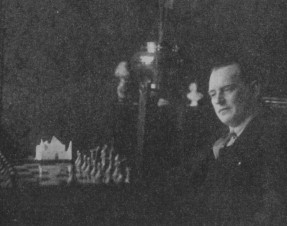
Alexander Alekhine
(3896)
Christian Sánchez is prompted by C.N. 3896 to point out the following observations by Euwe on page 15 of the January 1966 BCM:
‘In former times, once having lost the first phase of the game, the amateur made some more weak moves and then went down to defeat. That is no longer the case. In general, one mistake is not sufficient to lose a game of chess; it takes two mistakes to decide the issue. That is why the very strong players so seldom lose a game. Certainly they make mistakes from time to time, but they restrict them to one per game. And now it appears that the amateur also knows that he need not despair after his first error – provided, of course, that this error is not too serious. He can still fight, and his master opponent has to make things so complicated that the amateur falters a second time. Chess has become twice as difficult: to score one point, you have to win twice.’
(3898)
Two more second-hand versions:
‘It was said that you had to beat Alekhine three times in one game to defeat him – once in the opening, once in the midgame, and once in the ending.’
Source: page 237 of Combinations The Heart of Chess by I. Chernev (New York, 1960).
‘... Alekhine’s boast that to lose he had to be beaten three times – once in the opening, once in the middle game, once in the ending.’
Source: page 209 of New Ideas in Chess by L. Evans (Las Vegas, 2011).
(9029)
From page 179 of Master Chess by Lodewijk Prins (London, 1950):
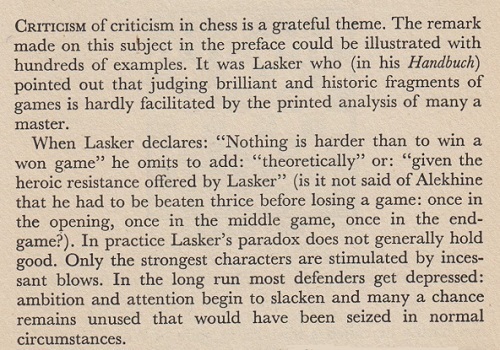
(10415)
The reference by Prins to Alekhine in the previous item is relevant to a matter discussed in a number of C.N. items.
Prins had also written on page 127:
‘Remember the saying that to win one game from Alekhine he had to be beaten thrice: once in the opening, once in the middle game and once in the end game.’
For the suggestion that Alekhine made the remark about himself no reliable source has been found. There are only the unsubstantiated assertions of Larry Evans.
(10416)
Some of Tartakower’s most interesting reminiscences appeared in a series of articles in Chess Review in the early 1950s. They included forgotten specimens of his play, and below is an excerpt from ‘End-game secrets’, on pages 328-329 of the November 1951 issue:
These miraculous examples of last-minute salvation remind me of a miraculous ending, never previously published, that turned up in a skittles game played by Dr Alekhine and myself at the Palais Royal Chess Club in Paris on 23 July 1925.
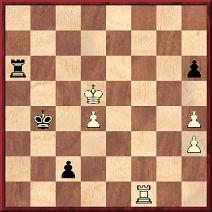
Tartakower v Alekhine
1...Ra5+ (Or 1...Kb3 2 Ke5 Kb2 3 d5 c1(Q) 4 Rxc1 Kxc1 5 d6 Kd2 6 d7 Ra8 7 Ke6 Ke2 8 Ke7 Kf3 9 d8(Q) Rxd8 10 Kxd8 Kg3 {or 10...h5 11 Ke7 Kg3 12 Kf6 Kxh4 13 Kg6 Drawn}11 h5! Kxh3 12 Ke7 Kg4 13 Kf6 Kxh5 14 Kf5 and White draws!) 2 Ke6! Rh5 3 d5 Rxh4 4 d6 Rxh3 5 d7 Rd3 6 Ke7
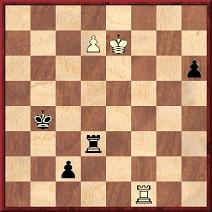
6...h5 (Or 6...Kb3 7 d8(Q) Rxd8 8 Kxd8 Kb2 9 Ke7 c1(Q) 10 Rxc1 Kxc1 11 Kf6 drawing.) 7 d8(Q) Rxd8 8 Kxd8 h4
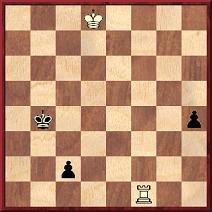
(Now the black pawn seems out of the white king’s reach; yet, by what seems nothing short of a miracle, the king can catch up to the pawn. A similar theme has been utilized by several endgame composers, among them Réti.) 9 Ke7 h3 10 Kf6 h2 (Again, if 10...Kb3 11 Kg5 Kb2 12 Kg4, drawing. Now that the rook pawn has advanced to its seventh rank, however, White is in a position to demonstrate a more piquant drawing method, in which his rook does most of the work. His king’s cooperation is no longer required.) 11 Ke7 (Also possible, of course, is 11 Kg5 Kc3 12 Kg4 Kb2 13 Kg3 c1(Q) 14 Rxc1 Kxc1 15 Kxh2, drawing. But the method selected by White is more amusing.) 11...Kc3 12 Rh1 Kd3 13 Kd8 Ke3 14 Ke7 Kf3 (Black threatens 15...Kg2.) 15 Rc1! Ke3 (Now he threatens 16...Kd2.) 16 Rh1! Drawn.’
(3900)
We wonder whether any languages have a special (technical) term for the process, favoured for Russian books, whereby photographs are touched up, apparently by a gloved ten-year-old. Particularly ham-fisted examples will be welcomed, and below we repeat from C.N. 3757 (an item which itself discussed picture-tampering) a photograph of Capablanca and place alongside it the version which appeared as the frontispiece to I. Ilyin-Genevsky’s book Match Alekhin-Capablanca (Leningrad, 1927):
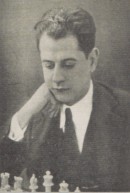
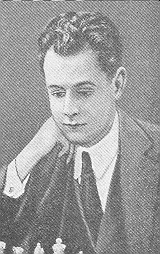
The Capablanca picture was also the basis for an Alekhine-Capablanca sketch found in various sources, such as the plate section of Complete Games of Alekhine, volume three by V. Fiala and J. Kalendovský (Olomouc, 1998):
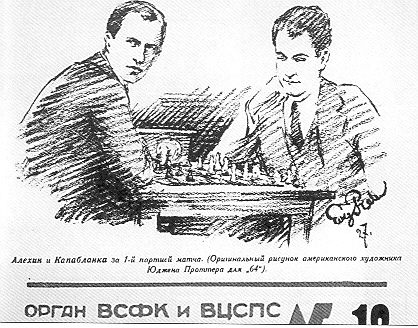
(3901)
Alekhine annotated his brilliancy against Bogoljubow (Hastings, 21 September 1922) in such publications as the tournament book, the November 1922 La Stratégie and his first Best Games volume. No two sets of notes were identical. On pages 44-46 of the March 1923 Schweizerische Schachzeitung the game was given with the heading ‘D’après les commentaires de M. Aljechin dans la Nation Belge’. Can a reader provide those annotations, to enable us to see whether they too were different?
(3925)
Luc Winants (Welkenraedt, Belgium) and Leonard Skinner (Cowbridge, Wales) provide Alekhine’s notes in La Nation Belge, 16 November 1922. In some respects they differ from all the other sets of annotations by Alekhine mentioned in C.N. 3925.
‘1 d4 f5 Une défense risquée, que je n’ai adoptée jusqu’à présent que fort rarement dans les rencontres sérieuses. Mais dans la partie présente je devais absolument jouer pour le gain, afin de m’assurer le premier prix, tandis qu’à mon adversaire la nullité suffisait pour obtenir le troisième. Par suite je me suis vu contraint de courir un certain risque, qui fut d’ailleurs justifié par le résultat. 2 c4 Cf6 3 g3 e6 4 Fg2 Ce fianchetto préconisé par Steinitz et Rubinstein ne me semble pas être la plus forte ligne de jeu pour les Blancs, car par les coups suivants les Noirs obtiennent une partie au moins égale. 4...Fb4+ 5 Fd2 Fxd2+ 6 Cxd2 La reprise avec la Dame suivie de Cc3 est peut-être un peu préférable. 6...Cc6 7 Cgf3 O-O 8 O-O d6 9 Db3 Cette manœuvre n’empêche pas les Noirs de réaliser leur plan, mais il est déjà difficile de proposer pour les Blancs une ligne de jeu efficace. 9...Rh8 10 Dc3 e5! Ceci est possible parce [qu’après] la prise du pion, le CD blanc sera attaqué par la Dame noire. 11 e3 a5 Il était très important d’empêcher pour un moment le coup 12 b4 comme on le verra de suite. 12 b3 Et non 12 a3 à cause de 12...a4. 12...De8! 13 a3 Dh5! Maintenant les Noirs ont obtenu une position d’attaque car les Blancs ne peuvent pas répondre à ce coup, ni par 14 dxe5 dxe5 15 Cxe5 Cxe5 16 Dxe5 à cause de 16...Cg4 et gagnent, ni par 14 b4 à cause de 14...e4 15 Ce1 axb4 etc. 14 h4 Un bon coup de défense, qui ouvre au CR de nouvelles cases et renouvelle la menace dxe5, etc. 14...Cg4 15 Cg5 Les Blancs désirent déplacer au plus vite le gênant Cavalier adverse. 15...Fd7 16 f3 Si 16 Fxc6 Fxc6 17 f3 alors 17...exd4! 18 fxg4 dxc3 19 gxh5 cxd2 etc. avec une fin de partie de beaucoup supérieure. 16...Cf6 17 f4 Déjà nécessaire vu la menace 17... f4 etc. 17...e4 18 Tfd1 Afin de protéger le pion g3 menacé par Dg4, suivi de Ch5, etc. 18...h6 19 Ch3 d5! Par ce coup les Noirs annihilent complètement les chances de l’adversaire au centre et obtiennent bientôt d’une manière inattendue l’initiative du côté D. 20 Cf1 Ce7 Préparant a4! 21 a4 Cc6 Maintenant par contre ce Cavalier peut entrer dans le jeu adverse via b4-d3. 22 Td2 Cb4 23 Fh1 Une manœuvre compliquée qui a pour but de créer des chances d’attaque du côté Roi, et qui démontre clairement l’infériorité de la position des Blancs. 23...De8! Ce coup très fort assure aux Noirs dans tous les cas un nouvel avantage : ou bien la domination de la case d5, en cas de 24 cxd5, ou alors l’ouverture d’une ligne du côté Dame après 24 c5 b6, ou enfin comme dans la partie le gain d’un pion. 24 Tg2 Ils essayent toujours de parvenir à g4 mais même cette faible chance ne leur sera pas accordée. 24...dxc4 25 bxc4 Fxa4 26 Cf2 Fd7 27 Cd2 b5! La reprise de la lutte pour la case centrale, lutte dont les péripéties aboutissent à une fin émouvante et originale. 28 Cd1 Cd3! Ce coup prépare la combinaison qui suit. Bien plus faible aurait été 28...bxc4 car le Cavalier blanc aurait enfin trouvé une bonne case à e5. 29 Txa5 Si 29 cxb5 alors 29...Fxb5 30 Txa5 Cd5 31 Da3 Txa5 32 Dxa5 Dc6 avec une attaque gagnante. 29...b4! 30 Txa8 Ou bien 30 Da1 Txa5 31 Dxa5 Da8 32 Dxa8 Txa8 et l’entrée de cette Tour dans le jeu des Blancs décide la partie. 30...bxc3!! Comme on le verra ceci est bien plus fort que 30...Dxa8 31 Db3 Fa4 32 Db1 et les Blancs peuvent encore se défendre. 31 Txe8 c2!! La pointe. 32 Txf8+ Rh7 33 Cf2 Evidemment le seul coup. 33...c1(D)+ 34 Cf1 Ce1! Menace d’un mat étouffé. 35 Th2 Dxc4 Une nouvelle menace de mat par Fb5 37 Cd2 Dc1, etc. qui force les Blancs de sacrifier sur-le-champ l’échange. 36 Tb8 Fb5 37 Txb5 Dxb5 38 g4 La seule chance d’obtenir encore un peu de jeu, qui amène une nouvelle surprise. 38...Cf3+ 39 Fxf3 exf3 40 gxf5 Forcé car si 40 g5 les Noirs obtiennent deux pions passés par 40...Cg4 etc. 40...De2!! Ce coup amène une position de problème. Aucune pièce blanche ne peut jouer sans perte immédiate. Par exemple 41 Ch3 (ou 41 Cg4) 41...Cg4!! etc.; Si 41 Th3 Cg4 et gagnent dans les deux cas. Donc après deux coups insignifiants de pion, ils devront jouer e4, ce qui mène à une liquidation immédiate avec une fin gagnante pour les Noirs. 41 d5 Rg8! Et non le coup plausible 41...h5 car les Blancs se sauveraient alors par 42 Ch3-g5+-f3. 42 h5 Rh7 43 e4 Cxe4 44 Cxe4 Dxe4 45 d6 Afin de disloquer les pions noirs car ceux des Blancs ne peuvent plus être défendus. La partie est irrémédiablement perdue. 45...cxd6 46 f6 gxf6 47 Td2 De2! Une jolie fin digne de cette partie. Les Noirs forcent une fin de pions gagnée 48 Txe2 fxe2 49 Rf2 exf1(D)+ 50 Rxf1 Rg7 51 Rf2 Rf7 52 Re3 Re6 53 Re4 d5+ 54 Abandonnent.’
Below is a photograph of Alekhine and Bogoljubow from the October 1929 Schweizerische Schachzeitung:
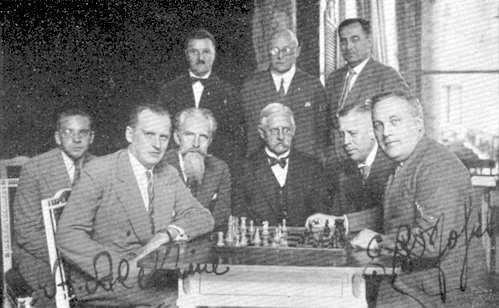
(3929)
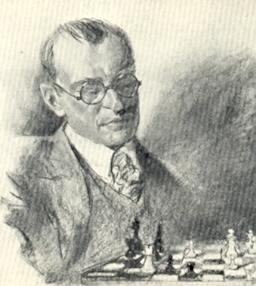
Alexander Alekhine
A quote vaguely ascribed to Alekhine (e.g. on the Internet) is ‘combination is the soul of chess’. Whether he ever made such a remark we cannot say, but certainly he stated (in November 1934, in his Introduction to La Défense du Fianchetto de la Dame by V. Kahn) that the centre is the soul of chess.
Alekhine wrote that Philidor’s observation about pawns being the soul of chess was both right and wrong and that it needed to be understood as meaning ‘Les pions, comme facteur de domination du centre, sont l’âme des échecs’. Philidor, added Alekhine, instinctively realized the importance of the centre but erred in believing that it needed to be dominated by pawns, a pardonable mistake also made by theoreticians (‘including the dogmatic Tarrasch’) for a century and a half. It was not, Alekhine said, until shortly before 1914 that Nimzowitsch, among other young players, began affirming that the centre could be controlled by pieces, even from afar, a paradox at the time but now accepted as true. Kahn’s book, concluded Alekhine, did not refute Philidor’s principle but was most successful in complementing it. (‘Son étude ne réfute pas le principe de Philidor, elle le complète de la plus heureuse façon. C’est le centre qui est l’âme des échecs.’)
(3977)
The full Alekhine text mentioned in C.N. 3977, as published on pages 5-6 of La Défense du Fianchetto de la Dame by Victor Kahn (Monaco, 1949):
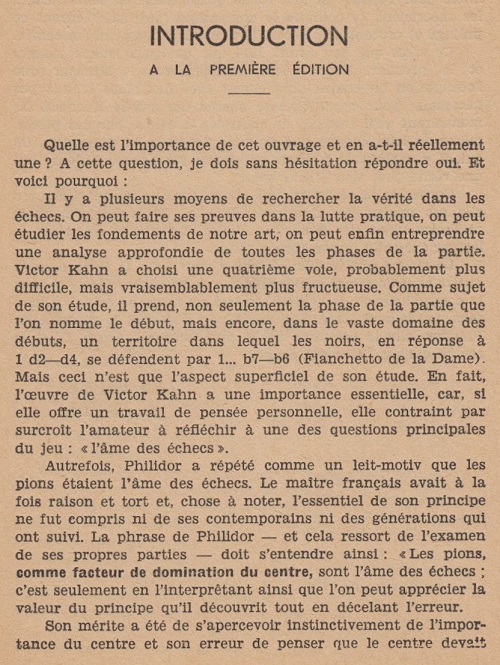
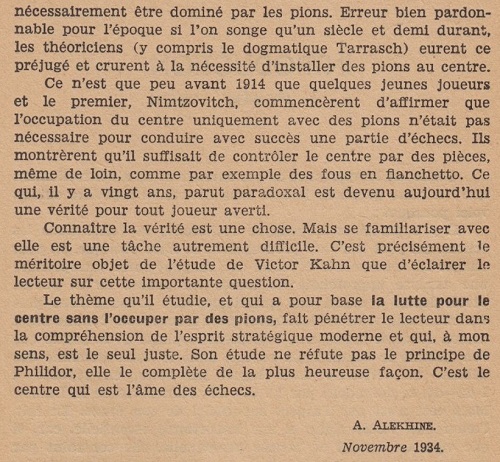
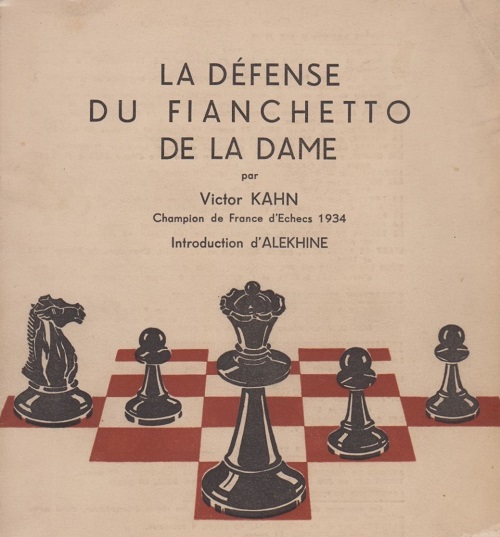
(9192)
We add, courtesy of the Cleveland Public Library, Alekhine’s Preface to Mes problèmes et études d’échecs by Frédéric Lazard (Paris, 1929):
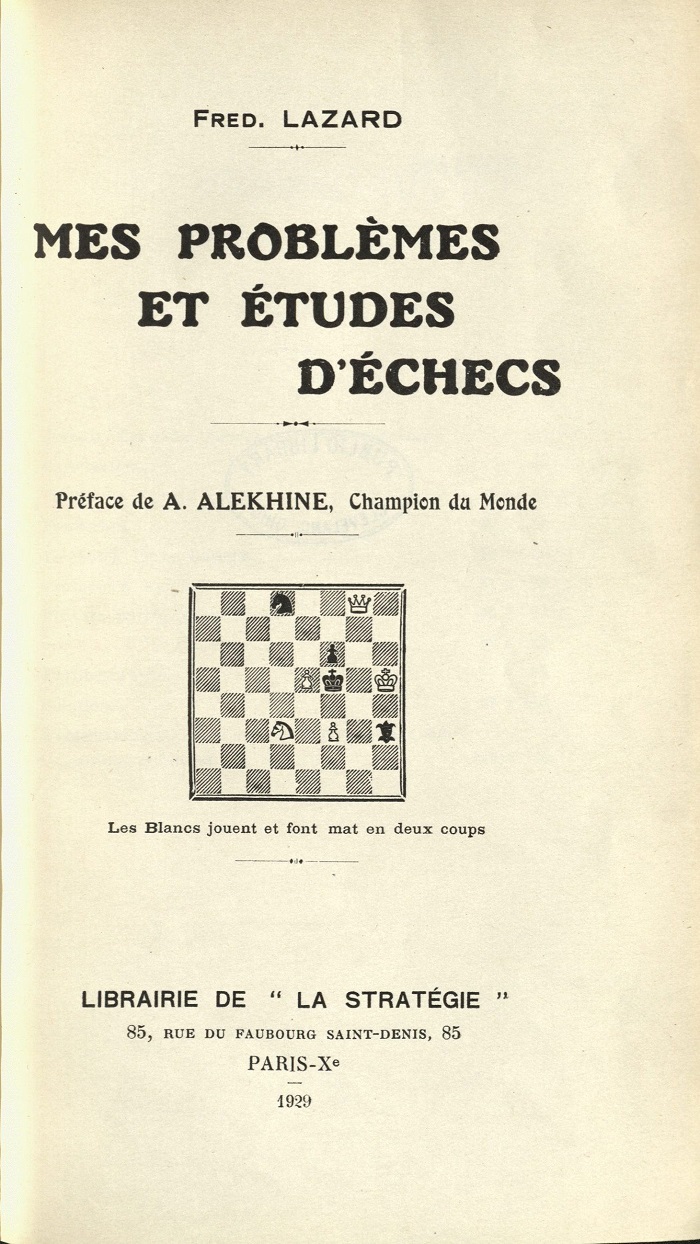
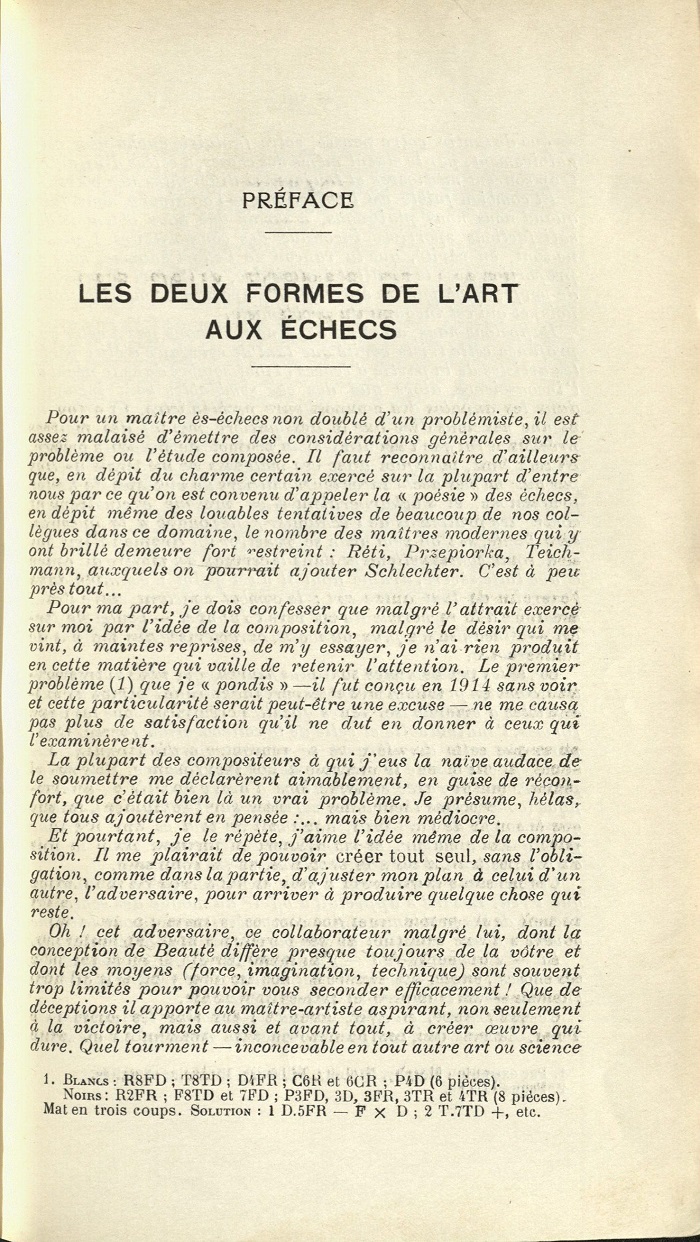
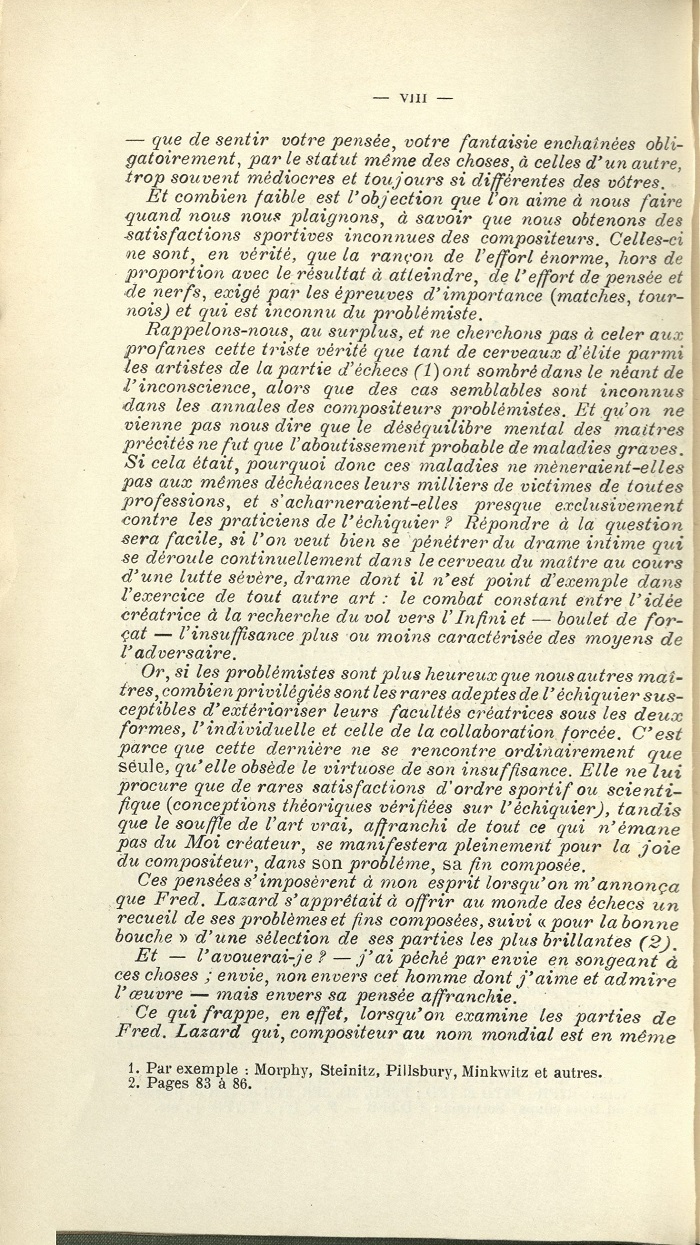
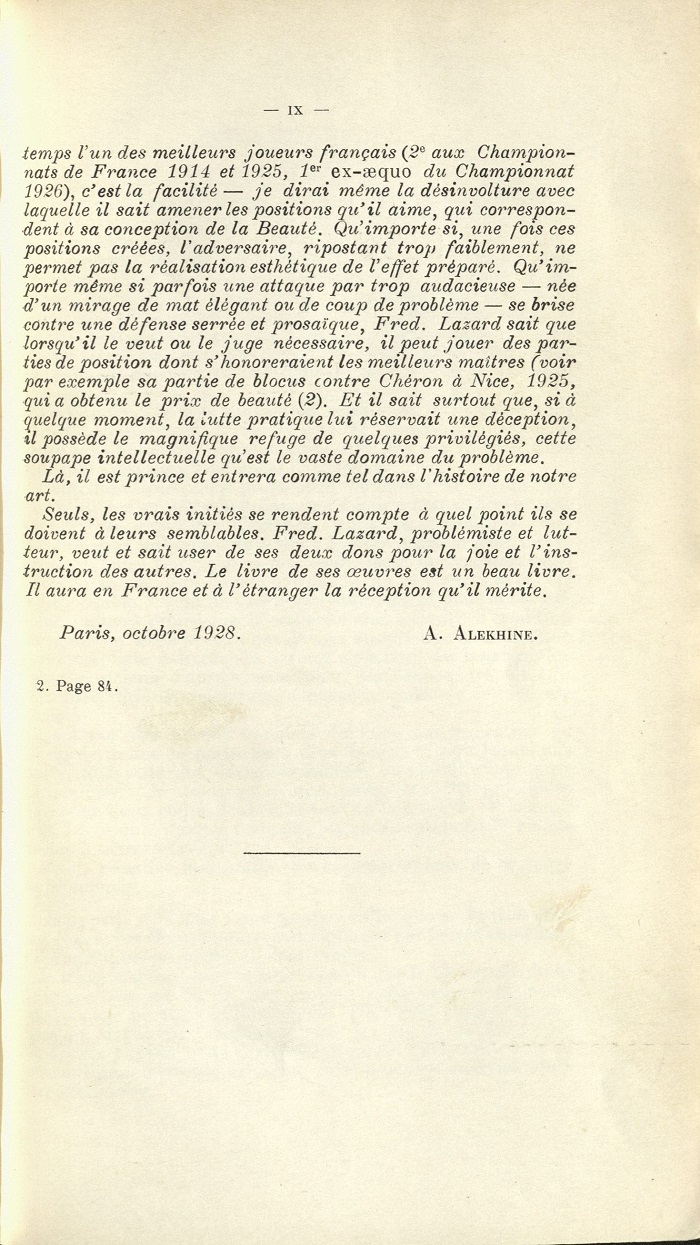
From an article entitled ‘Glimpses of Alekhine’ by M.E. Goldstein on pages 86-87 of Chess World, 1 May 1946:
‘As con-translator with J. du Mont ... of the French MSS of Alekhine’s book My Best Games of Chess 1908-1923 I naturally met the maestro on a number of occasions. In 1926 we both competed in the Scarborough tournament, and I lost in 40 [sic] moves.
In this tournament Alekhine upbraided me for failing to do more than draw against Sir George Thomas, a game in which I had only a minimal advantage. In fact, even Alekhine’s genius failed to reveal any winning line in the inevitable post mortem.
Alekhine said, “Now I’ll have to beat my old school friend, Victor Khan, or Thomas may come ahead of me.” He did, which was just as well, as Thomas was only half a point behind.
Until well into the small hours of the mornings, Alekhine, Bogoljubow, Colle, Sir George Thomas and myself used to play “Two-Move Chess”. In this fantastic form of the game, a player is permitted to make two moves at a time, provided he does not check on the first move.
Alekhine proved a past-master in this game also; his ability to check on the second move and thus restrict his opponent’s choice was one reason for his superiority over the other players.’
C.N. 3964 mentioned that Alekhine also won a Kriegspiel tournament while in Scarborough.
Goldstein’s account might be taken to imply that his draw against Sir George Thomas occurred at the end of the tournament, but page 303 of the July 1926 BCM states that it was played in the third round of seven. Before the seventh round the leading scores were Alekhine 4½ and Sir George Thomas 4. Both won their final games.
From the same issue of the BCM comes this photograph taken in Scarborough, although not during play in the tournament:
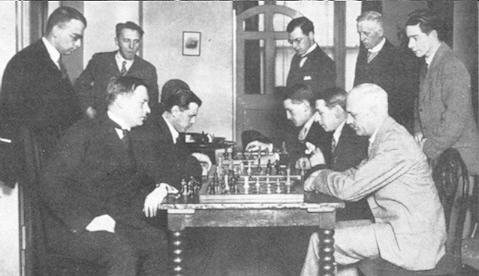
At the board (left to right and from the front) are A. Alekhine and Sir G.A. Thomas; E. Znosko-Borovsky and E. Colle; S. Landau and V. Buerger. The players standing are A. Seitz, V. Kahn, M.E. Goldstein, C.Y. Dawbarn and G.M. Reid.
(3981)
One of the few top-level chess masters to have taken up Kriegspiel was Alekhine, as is shown by two quotes from the 1926 BCM (March, page 124 and July, page 314 respectively):
‘Monsieur Alekhine (now a naturalized Frenchman and an official representative of French chess) remained in this country for a short time after his success at Hastings. On 9 January he spent the afternoon at the Imperial Chess Club playing Kriegspiel and beat every one of his opponents.’
‘The Kriegspiel Tournament [in Scarborough] was won by Alekhine, who is an adept at this lighter branch of the game, and Mrs Stevenson gained a popular success in coming second.’
(3496)
This group photograph from the French Championship in Nice, September 1925 was published on page 179 of L’Echiquier, September 1925:
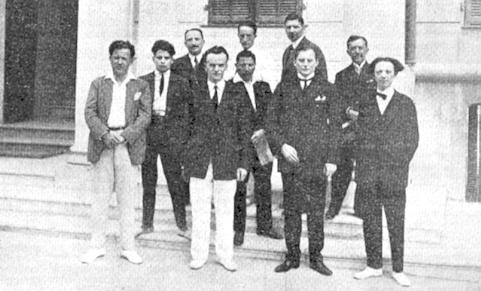
From left to right: A. Chéron, H. Bertrand, F. Lazard, R. Crépeaux, R. Gaudin, M. Duchamp, R. Casier, A. Alekhine, A. Silbert, G. Renaud
(3989)
Another one was published on the Supplément page of the September 1925 issue of L’Echiquier:
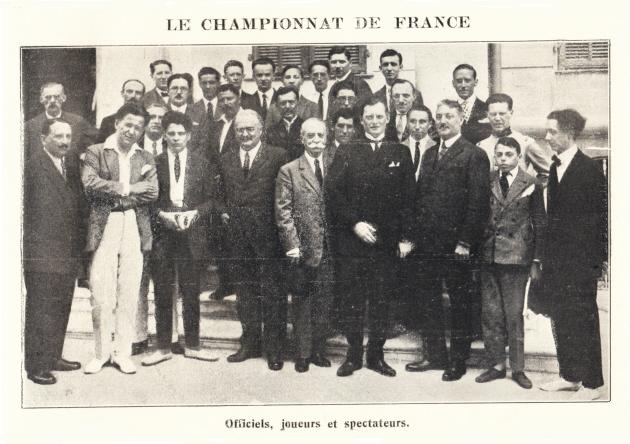
A fine individual shot of Alekhine, apparently taken around the same time, may be seen at the Gallica website.
(8235)
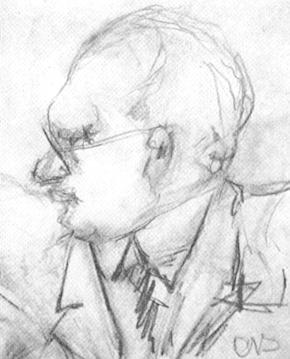
This sketch of Alekhine was by A. Baratz, who gave it in his book Testament d’Alekhine (Paris, 1971). His drawings of Bernstein and Tartakower appeared on pages 69 and 99 of With the Chess Masters by G. Koltanowski (San Francisco, 1972). On page 99 Koltanowski called him ‘M. Baratz’ and, on page 146, ‘Andre Baratz’. Page 753 of Le guide des échecs by N. Giffard and A. Biénabe (Paris, 1993) gave his forename as ‘Alexandre’, whereas the entry (one line) on page 31 of the Dictionnaire des échecs by F. Le Lionnais and E. Maget (Paris, 1967) provided no forename or even initial. Jeremy Gaige’s Chess Personalia (Jefferson, 1987) had ‘Abraham’.
(4023)
From Steve Wrinn:
‘Alekhine to me has always possessed a rather protean image in photographs: in certain shots he appears handsome, confident and self-possessed, while in others his appearance is very much the reverse. Two striking examples of this contrast are the photograph of Alekhine in the Berne, 1932 tournament book and the one of him at Nottingham, 1936 which appeared in the obituary article on page 16 of the April 1946 Chess Review:
The former is, in my opinion, one of the best of Alekhine, and shows a self-assured and still somewhat youthful champion at the height of his powers. Those are hardly adjectives one would apply to the man in the Nottingham photograph just four years later (four years which, of course, included the loss of the world championship and a less-than-optimal lifestyle). To judge from the position on the board, the Nottingham photograph was taken during Alekhine’s first-round game against Flohr, just after the “lapsus manus” 4 Bd2 and Flohr’s reply 4...dxe4.’
Below we add another Nottingham, 1936 photograph, from page 229 of the October 1936 Chess Review:
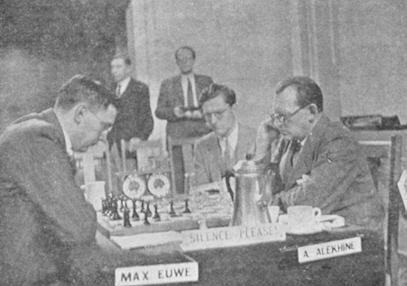
The caption stated that the seated onlooker was the Review’s correspondent Paul Hugo Litwinsky (who later changed his surname to Little).
Our correspondent also writes:
‘On pages 90-91 of Achieving the Aim (Oxford, 1981) Botvinnik writes about visiting Triberg in 1973 and being shown a then-unpublished photograph of Bogoljubow and Alekhine, taken around 1922. This picture, says Botvinnik, gave him a better understanding of the young Alekhine, a far different man from the one he met in person in 1936-38:
“Alekhine was gesticulating with his right hand and, with raised eyebrows and a sly look on his face, was relating something. ... There was so much expressiveness, humour, spiritual strength and calm certainty in his appearance that I understood how he could withstand the severity of the struggle with the great Cuban and take the world championship.”
I wonder if this photograph has been published anywhere since 1973. It would be a delight to see it.’
Still on the subject of Alekhine pictures, the two below are worth comparing:
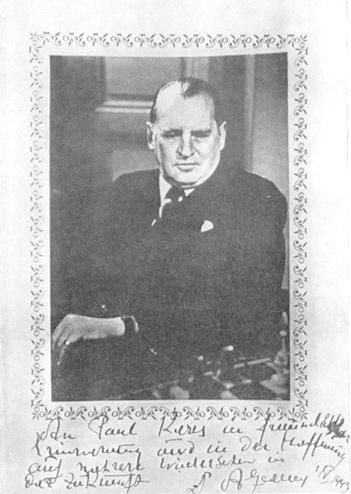
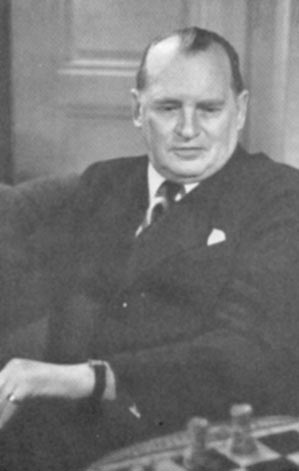
The first, a rare instance (from 1943) of one leading master inscribing a photograph of himself to another, comes from Meie Keres by V. Heuer (Tallinn, 1977), whereas the second is the frontispiece of the first volume of Alechinuv šachový odkaz by A. Kotov (Prague, 1956).
(4024)
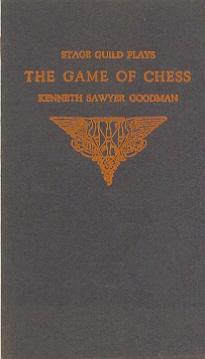
A play (one act) which is seldom mentioned nowadays is The Game of Chess by Kenneth Sawyer Goodman, first produced in Chicago on 18 November 1913. It is a struggle to find anything worth quoting from it, and we make do with the following exchange:
‘Constantine: Your excellency tires of the game, perhaps?
Alexis Alexandrovitch: No, I never tire of the game. When I do that, I shall tire of life itself.’
It cannot have taken too much imagination to adapt Samuel Johnson’s celebrated remark (recorded by James Boswell in The Life of Samuel Johnson), ‘When a man is tired of London, he is tired of life.’
(4072)
Is Alekhine the only master to have been the subject of a play and a film?
The play, Knight of the ID by Richard Laurie, was set in Portugal in 1946 and had its première in August 1997.
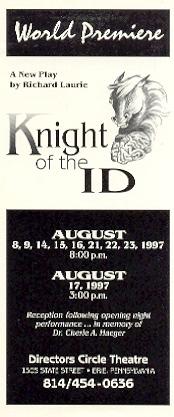
The film, The White Snow of Russia, was a 1980 Soviet production written by Kotov, with Aleksandr Mikhailov as Alekhine. Below are three photographs, taken from pages 44-47 of the 4/1982 Boletín Ajedrez Radio Rebelde (an article by Natalia Lazareva which had appeared in the August 1980 issue of a publication identified by the Cuban magazine as Films Soviéticos):
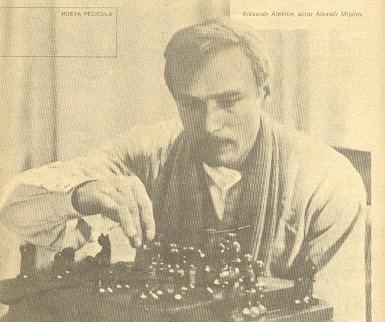
Aleksandr Mikhailov as Alekhine
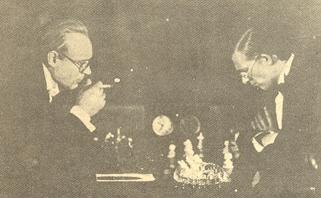
‘La Partida decisiva por el Campeonato Mundial’
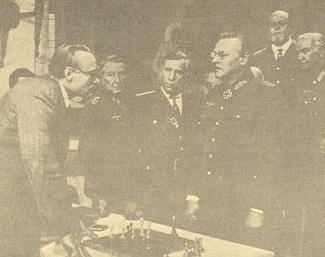
‘La Segunda Guerra Mundial. Praga. Una simultánea’
(4073)
A strange matter from two decades ago (C.N. 1181 – see page 96 of Chess Explorations) is revived here.
One of Alekhine’s most notable sacrificial experiments was in the sixth game of his 1937 world championship match against Euwe. As White he opened 1 d4 d5 2 c4 c6 3 Nc3 dxc4 4 e4 e5 5 Bxc4 exd4 6 Nf3 and won quickly after Euwe’s 6...b5? In his notes (My Best Games) Alekhine said that his ‘chief’ variation started 6...dxc3 7 Bxf7+ Ke7 8 Qb3 Nf6, etc., which contradicts Reinfeld’s claim (The Human Side of Chess, page 211) that the ‘greatest gamble of his life’ was played ‘on the spur of the moment’.
It always seems to have been assumed that Alekhine was the first to play this piece sacrifice, but we found the following game, recorded as having been played 13 years earlier, in 120 Partidas Cortas de Ajedrez by Gumersindo Martínez (Havana, 1947), page 74:
José Fernández Migoya – N.N.
Havana, 1924
Queen’s Gambit Declined
1 d4 d5 2 c4 c6 3 Nc3 dxc4 4 e4 e5 5 Nf3 exd4
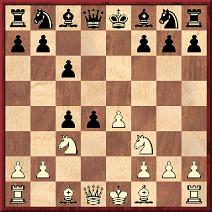
6 Bxc4 dxc3 7 Bxf7+ Ke7 8 Qb3 Nf6 9 O-O Na6 10 Bg5 h6 11 Bh4 g5 12 Nxg5 hxg5 13 Bxg5 Bg7 14 e5 Rf8 15 exf6+ Bxf6 16 Rfe1+ Kd6 17 Rad1+ Kc7 18 Bf4+ Resigns.
Can any further particulars be found?
(4079)
Concerning the sixth match-game against Euwe, 1937 the following remark by Alekhine appeared in his second Best Games collection after 1 d4 d5 2 c4 c6 3 Nc3 dxc4 4 e4:
‘It is almost incredible that this quite natural move has not been considered by the so-called theoreticians. White obtains now an appreciable advantage in development, no matter what Black replies.’
Following 4...e5 5 Bxc4 exd4 there came 6 Nf3, ‘yet another of Alekhine’s sacrificial hazards, which would hardly bear repetition’ in the words of R.N. Coles on page 77 of Dynamic Chess (London, 1956).
At a library in Havana in 1986 we copied down this score from page 74 of 120 Partidas Cortas de Ajedrez by Gumersindo Martínez (Havana, 1947). Now we are able to show the page, courtesy of the Cleveland Public Library:
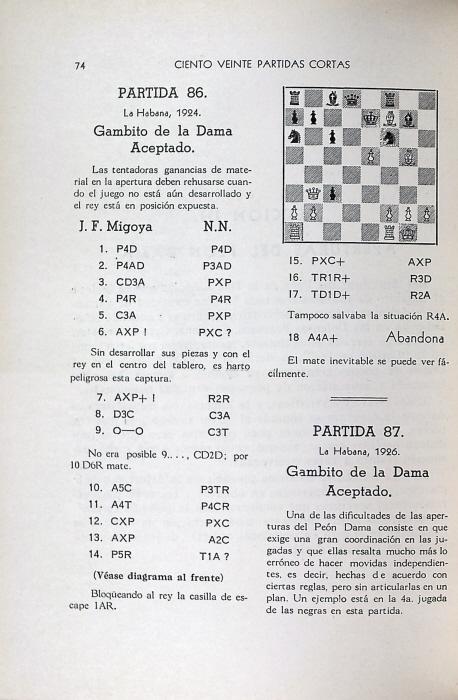
(8250)
Below is part of a letter to us dated 26 July 1977 from D.J. Morgan concerning his meeting with Alekhine:
‘A happy memory comes to mind.
After returning from the First War I belonged to the Liverpool C.C. Somewhere early in the 1920s A. came round to give a blindfold exhibition. I was one of the ten victims. Following the show three of us went back with him to his little hotel (The Angel, Dale St., I remember). We saw the dawn of the next day.
I happen to ask where I went wrong.
“Ah. Board 8, you played 21 B-B4. No! No!! Kt-Kt5 eh?”
I had no idea; from memory!
In a tin box under his iron bedstead he had the MS of his “Best Games”.
A powerful, pleasant personality.’
See Chess Morganisms.
That admirable book Alexander Alekhine’s Chess Games, 1902-1946 by Leonard M. Skinner and Robert G.P. Verhoeven (Jefferson, 1998) lists, on page 770, only one exhibition (not blindfold) by Alekhine in Liverpool. It was on 29 September 1923, he scored +24 –1 =6, and one of the victories was over E. Spencer (see game one in Alekhine’s book Auf dem Wege zur Weltmeisterschaft). Can any reader in the Liverpool area kindly do a little hunting in local records to trace the blindfold display?
(4204)
From Leonard M. Skinner (Cowbridge, Wales):
‘I came across a rather puzzling statement in David Bronstein’s book 200 Open Games (London, 1974). On page 16, in the preamble to a demonstration game (a King’s Gambit Accepted) against Petrosian, Tbilisi, 1963, Bronstein writes:
“As commander of the attacking army I chose as our subject one of the variations I had analysed in the well-known Keres attack and which I had once tested out on Alekhine himself.”
The suggestion that Bronstein (born in 1924) played the variation against Alekhine is not really credible. Can you throw any further light on the statement?’
It would appear to be a translation error. The text on page 22 of the Russian edition (Moscow, 1970) refers to a line of play which Keres, not Bronstein, played against Alekhine:
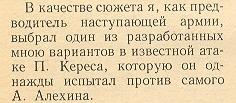
It may be recalled that Keres v Alekhine, Salzburg, 18 June 1942 began 1 e4 e5 2 f4 exf4 3 Nf3 Nf6 4 e5 Nh5 5 Qe2 Be7 6 d4 O-O 7 g4 fxg3.
(4210)
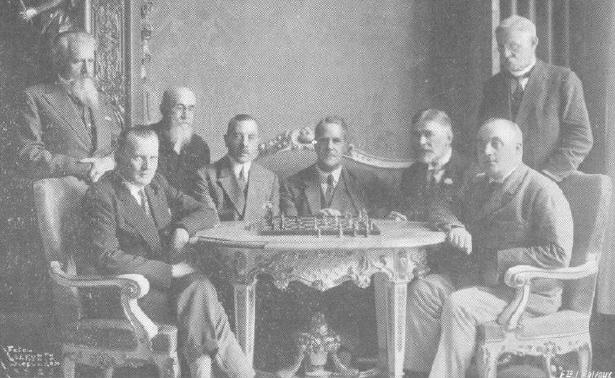
This photograph was published as a supplement to the January 1930 issue of L’Echiquier. Alexander Alekhine and Efim Bogoljubow are seated in the foreground and the FIDE President, Alexander Rueb, is in the centre. Who are the others?
(4237)
Tartakower’s oft-quoted commentary on Lasker, Capablanca and Alekhine (see, for instance, pages 3, 18 and 29 of the Baden-Baden, 1925 tournament book published by Caissa Editions in 1991) was presented as follows by Koltanowski on page 52 of the Chess Digest Magazine, March 1972:
‘Tartakower, when Alekhine was stunning the chess world in 1930-33, made this witty remark: “Lasker was world champion, Capablanca is world champion, and Alekhine plays like a world champion.’
Since Alekhine became world champion in 1927, this is just another example of Koltanowski’s difficulty with elementary facts.
(4279)
From an article by the pitifully undependable George Koltanowski, on page 52 of the Chess Digest Magazine, March 1972:
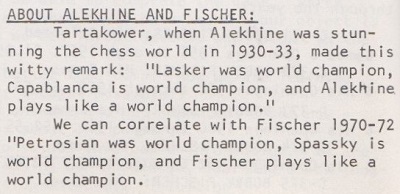
Koltanowski’s reference to Tartakower was given in C.N. 4279, which pointed out that in the 1930s Capablanca was no longer the world champion. We gave mid-1920s references for the remark, and below is what Bernhard Kagan wrote, without identifying the speaker, on page 344 of Kagans Neueste Schachnachrichten, 1 July 1925:

A similar observation (‘Capablanca has the title, Lasker has the results, but only Alekhine has the style of a real world champion’) appeared in an article by Tartakower in issue 4-5 of Shakhmaty, 1925. It was reproduced on page vii of the Baden-Baden, 1925 tournament book by N.I. Grekov (Moscow, 1927):

Elsewhere, Tarrasch has been named in place of Tartakower. From pages 176-177 of The Great Chess Masters and their Games by Fred Reinfeld (New York, 1952):
‘It was the St Petersburg International Tournament [in 1914] that catapulted Alekhine to world fame as a grandmaster and not merely a brilliant player. The main object of attention was of course the duel between Lasker and Capablanca, but Alekhine came very near to stealing the show by thrusting Rubinstein, Nimzowitsch and Bernstein aside and then outpacing Tarrasch and Marshall and coming a fine third to Lasker and Capablanca. It was in this famous tournament that Alekhine first displayed that white-hot fusion of logic and fantasy that was to enthrall chessplayers for three decades; that was to prompt Tarrasch to declare later on that “Lasker used to be the world champion, Capablanca is the world champion, but Alekhine plays as a world champion should play.”’
Given that Alekhine, aged 21, finished well behind Lasker and Capablanca at St Petersburg, 1914 (by a margin of 3½ points and 3 points respectively), it is odd to suggest that he ‘came very near to stealing the show’. What Reinfeld termed ‘a fine third’ was called ‘a poor third’ in the entry on Alekhine in the Oxford Companion to Chess (1984 and 1992 editions) and ‘a bad third’ on page 46 of Championship Chess by P.W. Sergeant (London, 1938).
An earlier claim that Tarrasch made the remark about the three world champions was published on page 86 of Chess World, 1 May 1946, in an article, ‘Glimpses of Alekhine’, by M.E. Goldstein:
‘Before Alekhine defeated Capablanca, Dr Tarrasch, a man not given to fulsome praise, wrote that “Lasker was world champion, Capablanca is world champion, but Alekhine plays as a world champion should play”. To the man in the street, Alekhine was the man to watch – the sacrifice of the queen for a mating attack represented the triumph of mind over matter, which everyone could appreciate. On the other hand, the positional cavortings of a Capablanca or a Rubinstein were beyond the ken of ordinary men.’
When presenting Réti v Alekhine, Baden-Baden, 1925 (under the heading ‘The Gem of Gems’) on pages 110-111 of the 1 June 1946 issue of Chess World, C.J.S.Purdy wrote:
‘We disagree with Mr Goldstein when he says that Alekhine’s chess is easier for the ordinary player to understand than Capablanca’s. Capablanca’s moves may often surprise, but usually their logic is soon apparent after examination. But many of Alekhine’s moves depend on some surprise that comes far too many moves ahead for an ordinary mortal to have the slightest chance of foreseeing it. Alekhine’s chess is like a god’s. One can revere, but never hope to emulate.’
(9384)
See also our feature article How Many Moves Ahead?
Below is a reference to Alekhine from page 184 of Grandmasters of Chess by Harold C. Schonberg (Philadelphia and New York, 1973):
‘It infuriated him when his name was pronounced Al-OKCH-in. That was a Jewish pronunciation; the correct pronunciation was Al-YEKCH-in.’
What evidence exists that any particular pronunciation of his name infuriated Alekhine? An ipse dixit by Schonberg hardly suffices.
(4284)
From Avital Pilpel (Haifa, Israel):
‘Some evidence of Alekhine being annoyed at the pronunciation “Al-OKCH-in” – though without any reference to this being the “Jewish” pronunciation – is a paragraph on page 17 of the January 1972 issue of the Israeli magazine Shachmat, in a report on the Alekhine Memorial Tournament (my translation from the Hebrew):
“Al-YEKCH-in and not Al-OKCH-in [The spelling of the two pronunciations differs in Hebrew. A.P.].In Hebrew (and other languages) the wrong pronunciation (and spelling) of the ex-world champion’s name took root for some reason. Alekhine’s own insistence on the right pronunciation can be demonstrated by the fact that, if someone asked on the telephone, “Can I speak with A.A. Al-OKCH-in?”, Alekhine would reply, “there is no such person, there’s Al-YEKCH-in”. (This is what Lev Lubimov writes in his book In Exile. During his years as an émigré from Russia the writer would often meet with Alekhine.) It is corroborated too by chess players who knew Alekhine, and if anybody needs more proof, in English the name is written ‘Alekhine’. It seems to us that the evidence is conclusive on this question.”
Can anyone give chapter and verse from the Lubimov book?’
(4289)
From Martin Weissenberg (Savyon, Israel):
‘In an article on Alekhine at the Chess Café Hans Kmoch recalled:
“... Alekhine used to get angry if his name was pronounced Al-YOH-khin, the way Russians sometimes pronounced it. The correct Russian pronunciation, he said, was Al-YEH-khin, explaining that the name was derived from that of a tree (‘alyesha’) that grew abundantly near one of his family’s estates. ‘Al-YOH-khin’, he claimed, was a Yiddish distortion of his name, like Trotsky for Troitsky or Feigl for the German Vogel. But strangely, no-one whom I ever heard pronounce the name Al-YOH-khin was Jewish.”
Kmoch mentioned that his article was an English version of a paper entitled “Alekhine and his Luck” which had appeared in the Deutsche Schachzeitung, but no publication date was provided.’
(4304)
In response to the question at the end of C.N. 4289, Vitaly A. Komissaruk (Kasan, Russian Federation) quotes from page 177 of Lev Lubimov’s book На чужбине (‘In Exile’), published in Moscow in 1963 and reprinted in Tashkent in 1965:
‘“Шахматный король” – так звали А.А. Алехина за границей и так он сам себя называл -- выехал из России ещё молодым.Он воспитывался в училище правоведения, вырос в старорежимном кругу. Любил подчёркивать, что он хорошего дворянского рода, упорно настаивал, чтобы фамилию его произносили без точек над “е”. Когда, например, кто-нибудь спрашивал по телефону, можно ли поговорить с А.А. Алёхиным, он неизменно отвечал: “Нет такого, есть Алехин.”’
English translation:
‘“Chess king”, as A.A. Alekhine was known abroad and as he called himself, left Russia at a very young age. He attended law college and was raised in circles known as “old regime” [i.e. before the 1917 Revolution]. He liked to point out his descent from a noble family and insisted on pronouncing his last name without the dots above the “e”. For instance, when anybody asked on the telephone for “A.A. Alëkhin” he would always reply, “Such a person does not exist; there is Alekhin”.’
(7974)
From page 327 of the Australasian Chess Review, December 1936:
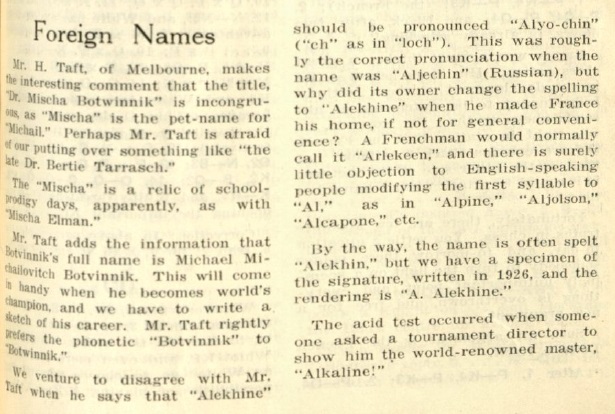
(11772)
In a letter to us dated 11 February 1972 C.H.O’D. Alexander wrote:
‘Capa was undoubtedly one of the two or three most gifted players who ever lived – but lazy (that’s why Alekhine beat him). Nowadays he would have to work much harder – especially at the openings – than he did. I think Fischer is equally gifted (his style is very much like Capa’s) and a much harder worker; so in fact I put Fischer ahead of him. I’m now inclined to think Fischer the best there has ever been.’
We subsequently asked Alexander how he would place the other main contenders for the title of greatest player ever, to which he replied:
‘Very close – probably 1 Lasker 2 Botvinnik, Capablanca 4 Alekhine, but there are so many different ways of defining “greatest player” which give different answers.’
As regards Capablanca and Alekhine’s respective characters, Alexander informed us:
‘Capablanca was a conceited man (i.e. he thought very well of himself) who liked chess because he excelled at it.
Alekhine was a vain man (i.e. he liked other people to think well of him) who – though he had childish and vicious streaks that Capablanca was free from – did at least really love chess.’

(4293)
A paragraph from a letter that Harry Golombek wrote to us on 26 February 1972:

(11823)
Gábor Gyuricza (Budapest) writes:
‘Page 10 of the 1964 booklet Le gambit de Budapest by Jacques Le Monnier mentions the following game: 1 d4 Nf6 2 c4 e5 3 dxe5 Ng4 4 e4 Nxe5 5 f4 Ng6 6 Be3 Bb4+ 7 Kf2 Qe7 8 Nf3 (if 8 Qd5 d6) 8...Nc6 9 Qd5 b6 =+ (“Chéron-Alekhine, Vevey, 1925”). I find that quite strange because a) I have never seen the game published anywhere else and b) Alekhine liked to play this variation with White but not with Black. Can full, correct information about the game be found?’
(4295)
In the early 1920s, chess magazines reported that Alekhine had adopted that spelling of his surname. See, for example, page 207 of the May 1922 BCM and page 5 of the January 1923 American Chess Bulletin. However, matters were not clear-cut, and ‘Alekhin’ appeared on the cover and title page of his first Best Games collection, published in 1927:
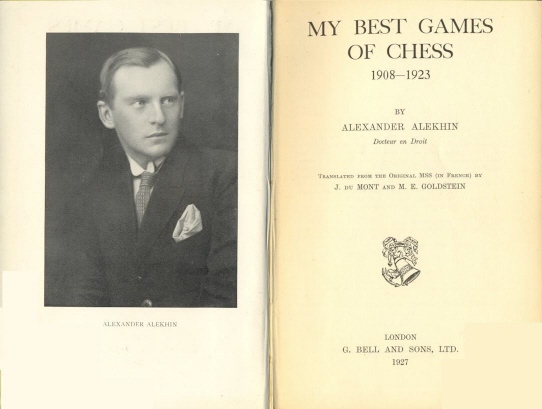
When, in his late teens, he had begun receiving international attention, the chess press spelled his surname various ways. For example:
So when was ‘Alekhine’ first seen? Such a question naturally cannot be answered precisely, but that spelling pre-dates all the above quotes. See, for instance, page 289 of the 9 August 1908 issue of Deutsches Wochenschach and page 258 of the August 1908 Deutsche Schachzeitung.It was also used on page 152 of The Year-Book of Chess, 1909 by E.A. Michell (London, 1909).
(4310)
From Chess and Bridge:
The following remark is by Harry Golombek in a review of Schachgenie Aljechin by H. Müller and A. Pawelczak (Berlin-Frohnau, 1953) on pages 160-161 of the May 1954 BCM:
‘... [Pawelczak’s] categoric statement on page 52 that “Aljechin war ein ausgezeichneter Bridgespieler” (Alekhine was an excellent bridge player) is quite false. I played quite a lot of bridge with Alekhine in 1939 in South America and, even by my modest standards, Alekhine was a very weak bridge player. I well remember his wife remarking to him, after he had made some particularly atrocious mistake, “If you go on like this you’ll lose us our château in France”.’
(4344)
See too ‘Recollections of Alekhine’ by Harry Golombek, Chess Review, May 1951, pages 140-141. That article was also published on pages 191-196 of Fred Reinfeld’s The Treasury of Chess Lore (New York, 1951). Reinfeld himself expressed a view on Alekhine (‘There is general agreement that he was abominable at bridge’) on page 170 of The Great Chess Masters and Their Games (New York, 1952).
Golombek wrote about the bridge-playing of Lasker, Ståhlberg, Landau, A.R.B. Thomas, B.H. Wood, Alekhine, Grace Alekhine, Capablanca and Rossetto in his article ‘World Champions I Have Met’ on pages 10-14 of The Chess Player’s Bedside Book by R. Edwards and R. Keene (London, 1975).
From page 7 of Why You Lose at Chess by Fred Reinfeld (New York, 1956):
‘Alexander Alekhine was undoubtedly the greatest chessplayer in the history of the game, but what he really prided himself on was his ... bridge playing. All I know about bridge is that it’s played with a deck of cards – or maybe two decks (it’s very confusing) – but people in a position to judge have told me that Alekhine was a miserable bridge player. I can well believe it. Just as we misjudge our strong points, so we misjudge our weaknesses.’
(5907)
We have been looking over our agreeable correspondence with the late Pablo Morán. In one letter (undated but probably written in September 1977) he told us regarding his book Agonía de un Genio that an English translation by Frank Mur was under way and that the Spanish original was full of errors (‘como habrá comprobado está repleto de errores’). On 17 June 1987 he mentioned that the new edition would contain many corrections and important fresh material (‘tendrá muchas mejoras respecto a la edición en español, pues hemos corregido las erratas y mejorado mucho el texto con nuevas partidas y descubrimientos importantes’). One curiosity is that the following year Morán sent us a cutting from El Correo de Asturias of 12 July 1988 which announced his election as President of the Federación Asturiana de Ajedrez. The newspaper added that his Alekhine book ‘ha sido traducido recientemente al inglés y al ruso’. We recall no other reference to a Russian translation.
For the reasons set out in C.N.s 4016 and 4357 it now seems unlikely that the Spanish and English editions were right to state that the 15-move game was won by Alekhine against Muñoz at Sabadell, 1945, but can the facts be established beyond doubt? Two questions may be raised here:
1. Was the game published, by Morán or anyone else, before 1972?
2. What happened to Morán’s library and archives after his death on 25 November 1995 (as reported on pages 6-8 of issue 416 of Jaque, January 1996)?
(4387)
Mr Miquel Artigas (Sabadell, Spain) writes:
‘On page 7 of issue 43 of the Spanish magazine Gambito, published in 2000, there is an article by Alfonso Romero entitled “La biblioteca de Pablo Morán” which states that Moran’s library was placed in the Biblioteca Provincial de Asturias “Ramón Pérez de Ayala”. According to Romero there were about 2,000 volumes, but nothing was said about Morán’s private archives.’
Denis Teyssou (Paris) reports that a record of Pablo Morán’s
chess library, held at the Biblioteca Provincial de Asturias
‘Ramón Pérez de Ayala’ in Oviedo, can be consulted online
(1,246 books and magazines, but no private archives). It is
necessary to a) click on ‘Aquí’, b) click on ‘Consultar
el catálogo’, c) in the ‘Buscando en’ option, select
‘Bca. de Pablo Morán’, d) type ajedrez in the box
labelled ‘Materia’ and e) click on ‘Buscar’. [The
link is currently broken.]
Pablo Morán’s best-known book is his monograph on Alekhine, of which an English edition, edited and translated by Frank X. Mur, was published by McFarland & Company, Inc. in 1989. It was released in paperback in 2010:
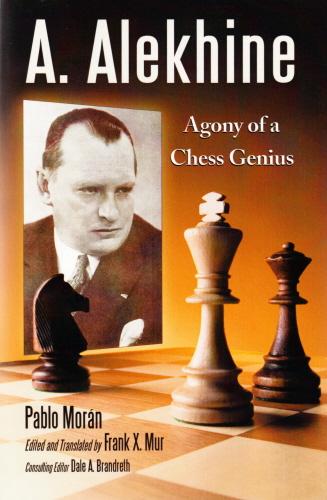
The English translation was a long-term project, as is shown by a letter to us from Pablo Morán in September 1977:
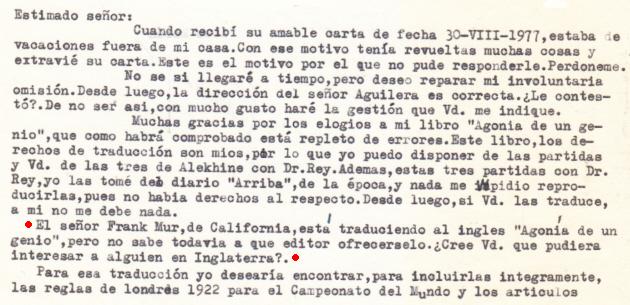
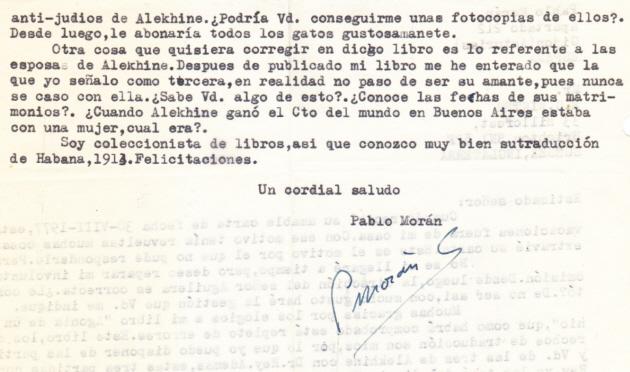
(8305)
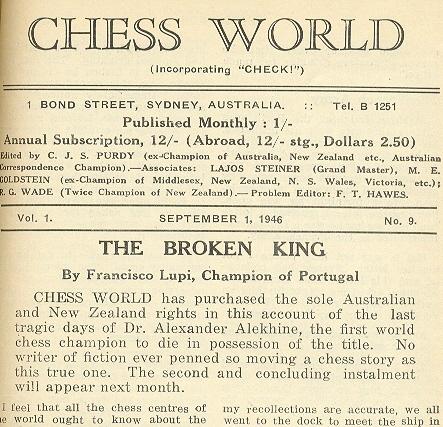
The prime contribution of Francisco Lupi to chess literature was his celebrated two-part article ‘The Broken King’, the full text of which is included in Morán’s book. The English version was originally published in Chess World, 1 September 1946, pages 161-165 and 1 October 1946, pages 185-187. As may be seen above, the Editor, C.J.S. Purdy, accorded it high praise:
‘No writer of fiction ever penned so moving a chess story as this true one.’
(4388)
C.N. 50 gave, from Agonía de un genio by Pablo Morán (Madrid, 1972), the game Mampel v Alekhine, Gijón, 16 July 1945 with annotations by Lupi, whose final comment was ‘As in the days of San Remo!’ In C.N. 156 Anthony Saidy (Santa Monica, CA, USA) suggested that Alekhine’s play against Mampel did not justify Lupi’s great enthusiasm.
The final game (Estoril, January 1946) in the short match between Alekhine and Lupi was also shown in C.N. 50.
After Alekhine’s death in 1946 the Portuguese master Francisco Lupi wrote an account of the world champion’s final phase, under the title ‘The Broken King’. From page 185 of Chess World, 1 October 1946:
‘In those last weeks, grief, sickness and poverty entirely crushed him.’
And from the following page:
‘Fifteen days before his death, I was called on the telephone and heard Dr Alekhine ask me sadly whether I wanted to work with him on “Comments on the Best Games of the Hastings Tournament”, adding: “I am completely out of money and I have to make some to buy my cigarettes”.’
See too Alekhine’s Death.
The Portuguese champion Francisco Lupi gave some further observations about Alekhine on pages 204-207 of CHESS, April 1947:
‘With all respect to Botvinnik, I am not altogether convinced that the great master and Soviet champion would have won his match against Alekhine.
I knew Alekhine well during his last years. Throughout many a journey in Spain together, en route to participate in tournaments, I have come to know his every gesture. I have seen him attired superbly and I have seen him, not so much later, looking like a tramp. It has struck me how both in his play and in himself, how extraordinarily his style revealed itself in a capacity to improvize – and a capacity to recuperate. ...
It is true that, when he received here in Lisbon the news of the British Chess Federation’s negotiations for his match against Botvinnik, the great man was at his lowest ebb. But a few days afterwards, I watched him playing so beautifully, so ingeniously in friendly conflict with the well-known English problemist G.F. Anderson – no second-rate player either – that I felt his powers of recuperation were unimpaired.
It has frequently been said that, after his last match against Euwe, Alekhine had never recaptured the fire of his San Remo days. I should answer this by saying, simply, that in his later years he inclined more towards soundness and simplicity.’
On page 205 Lupi discussed Alekhine’s game against Paul Schmidt in the Warsaw-Cracow tournament on 10 October 1941 (game 2311 in the Skinner/Verhoeven book on Alekhine). Before presenting Lupi’s account we reproduce the relevant part of the game from page 171 of the November 1941 Deutsche Schachzeitung (notes by Blümich) and page 173 of the 1 November 1941 issue of Deutsche Schachblätter (annotations by Alekhine).
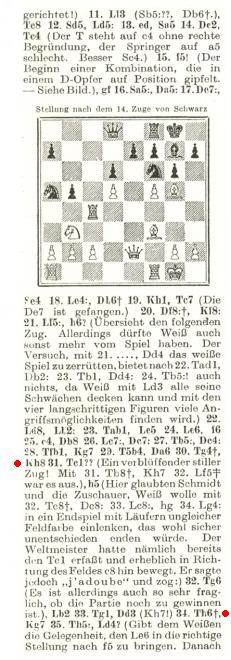
Deutsche Schachzeitung
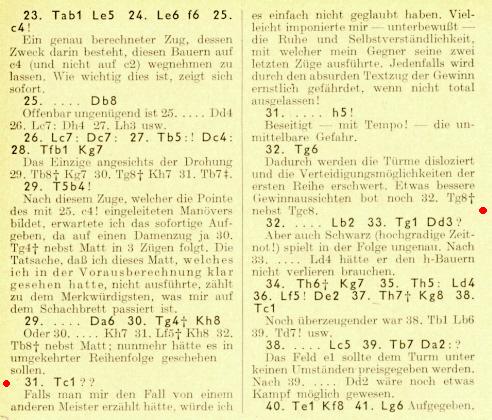
Deutsche Schachblätter
Our diagram shows the position before Alekhine played 31 Rc1 h5 32 Rg6 (instead of 31 Rb8+ Qc8 32 Rxc8+ (or 32 Bxc8) and 33 Bf5 mate):
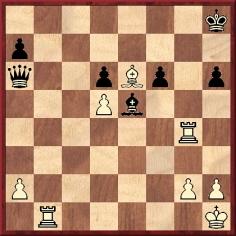
In CHESS Lupi wrote:
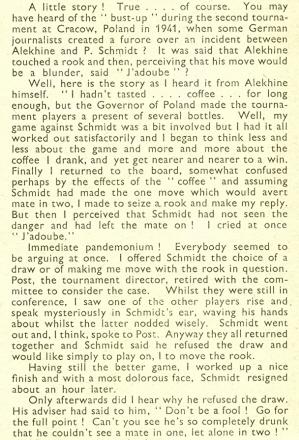
To the small number of photographs of Lupi which are available, we add one from opposite page 145 of La vida de Arturito Pomar by Juan M. Fuentes and Julio Ganzo (Madrid, 1946):
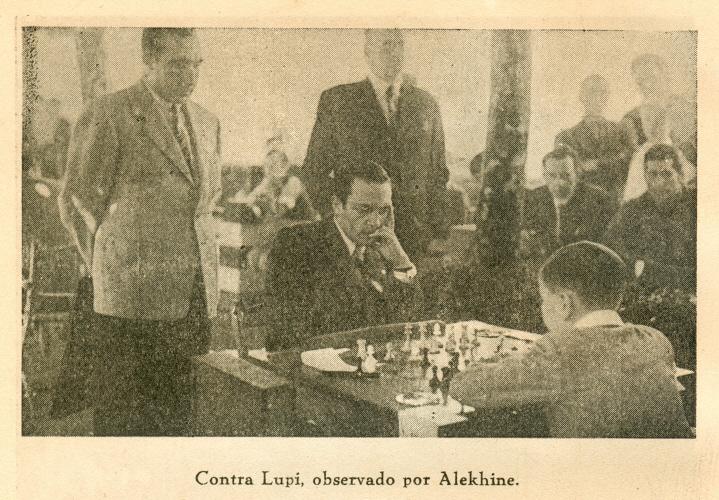
(5551)
See too Arturo Pomar (1931-2016).
We recall that the book (which we have never seen) was mentioned in the entry on Znosko-Borovsky on page 312 of An illustrated Dictionary of Chess by Edward R. Brace (London, 1977), after which a reader of CHESS (August 1978 issue, page 353) queried whether it existed. It is, however, listed in the Cleveland Library, as follows:
‘Kapablanka i Alekhin: bor’ba za mirovoe pervenstvo v shakhmaty / Evg. A. Znosko-Borovskii?.
Parizh: Société “N.P. Karbasnikoff”, 1927.
Item Description: 128 p. : ill. ; 20 cm.’
Leonard Skinner (Cowbridge, Wales) has sent us a photocopy of what appears to be the first monograph about Alekhine, Geniy Kombinatsiy Grossmeister A. A. Alekhin by A. Mirles (Kiev, 1926). It is 56 pages long and has notes to well-known specimens of Alekhine’s play, together with a 16-page biography.
(4430)
Addition on 12 December 2023 to our feature article on Eugene Znosko-Borovsky:
We are very grateful to the Cleveland Public Library for a number of scans, a selection of which follows:
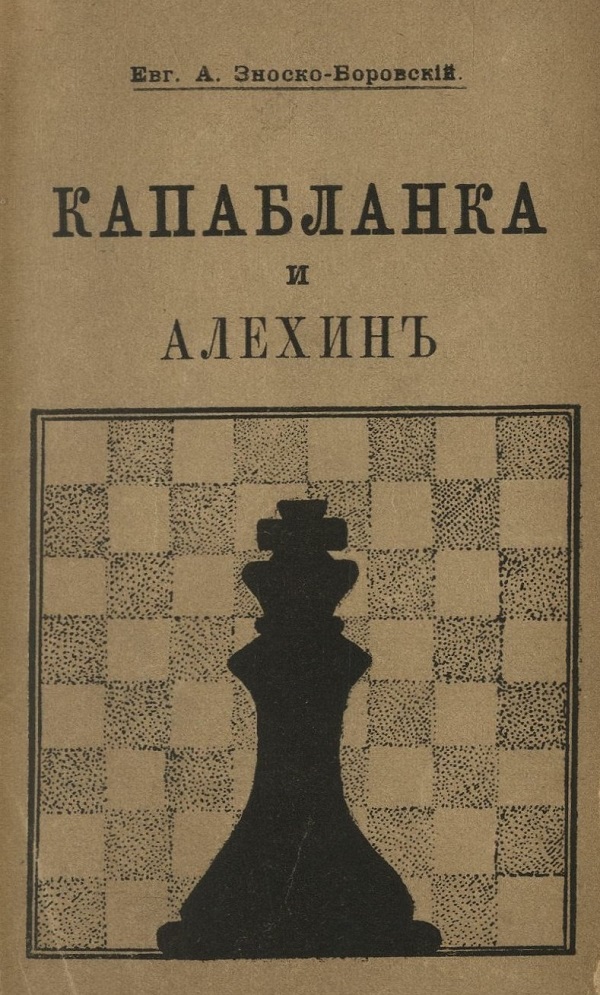
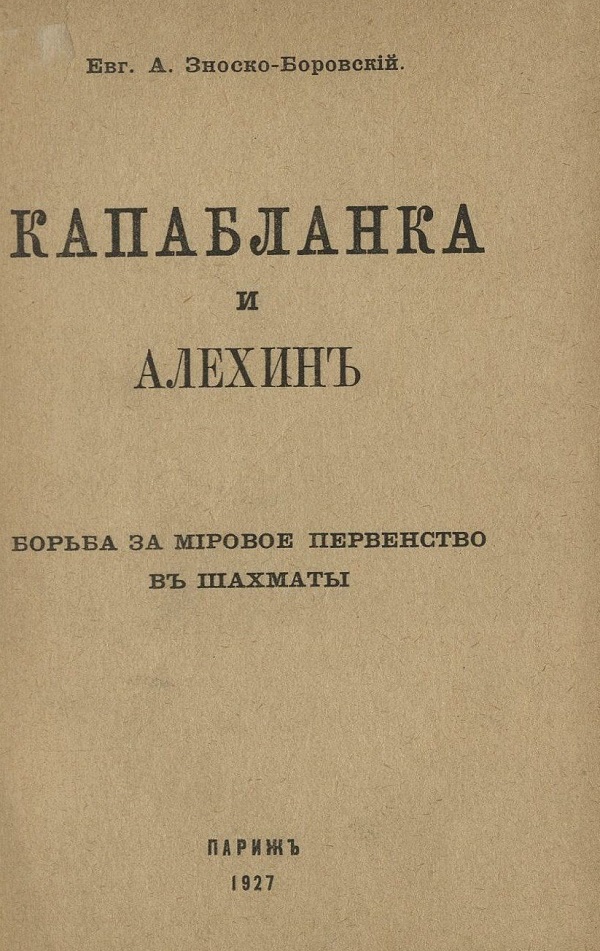
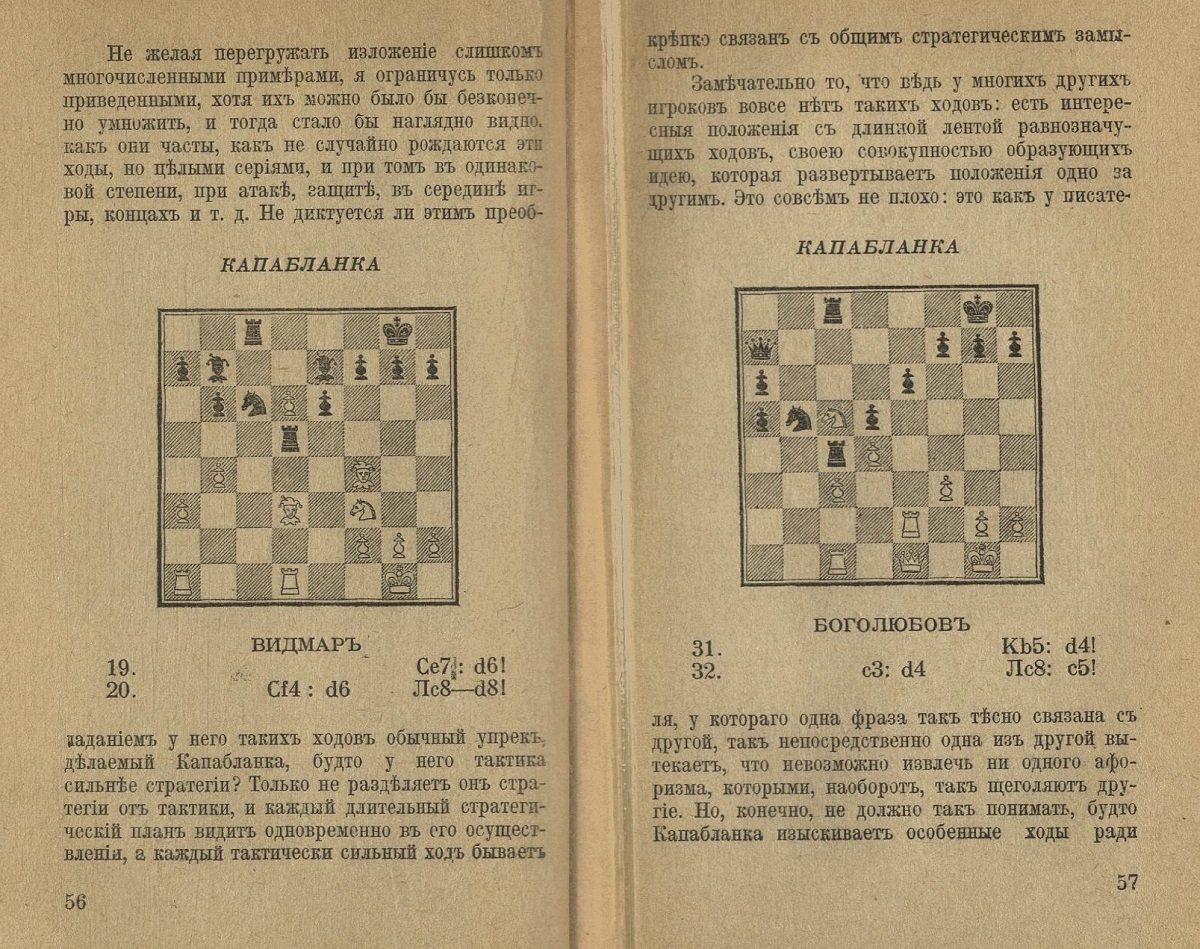
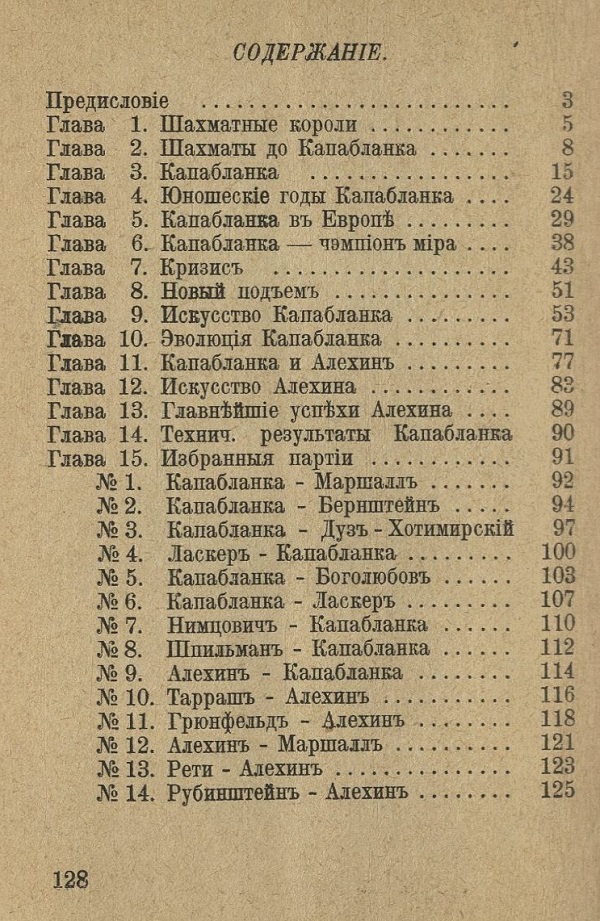
The front cover of Alekhine’s first book gave a curious rendering of his name: A. v. Alchechin:
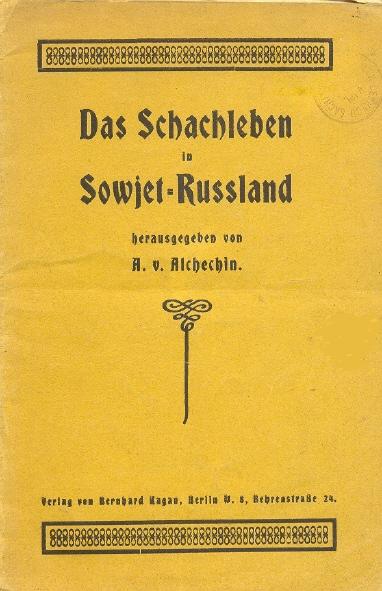
(4431)
Alekhine’s involvement in The Basis of Combination in Chess by J. du Mont was mentioned in C.N. 4436; du Mont reported that Alekhine had given him a text which ‘I could use in any way I wished, and which the publisher did in fact use on the blurb of the book when it came out’.
George Routledge & Sons, Ltd. certainly made the most of Alekhine’s encomium, emblazoning part of it on the front dust-jacket:
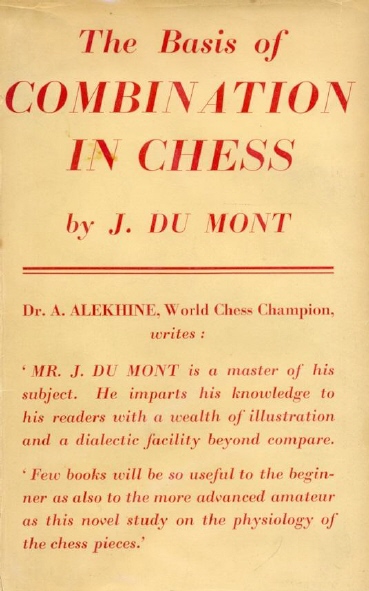
The front-jacket flap had the full version:
‘The Basis of Combination in Chess
From Dr Alekhine, Chess Champion of the World
It is principally by learning to know and to appreciate the pieces from this point of view – marvelling at their powers and pitying them in their weaknesses (poor isolated pawns, poor pinned rooks and knights) – that it is possible to become an efficient director of the tragi-comedies which are played on the 64 squares.
Mr J. du Mont has carefully studied his flock, composed of such varied elements. He is a master of his subject. He knows the teams which work well together (e.g. the two bishops) and those which do not get on so well (e.g. two knights which cannot effect a mate), the units which are in absolute need of the assistance of their companions (as the united pawns) and those which of their own power are often able to work miracles (the queens in Q endings, the king in pawn endings). He knows all this and imparts his knowledge to his readers with a wealth of illustration and a dialectic facility beyond compare.
Few books will be so useful to the beginner as also to the more advanced amateur as this novel study on the physiology of the chess pieces.’
A shorter text by Tartakower appeared on the back-jacket flap:
‘A great expert and a great teacher, Mr J. du Mont, in this book, gets very near to the ideal of instructing and entertaining at the same time.
Profound ideas, emitted without insistence, without preaching, smilingly, making light of the difficulties of the subject, in passing, strolling along, but always moving forward hand in hand with the intrigued reader towards the ultimate aim: to improve, enrich and deepen his game.’
(4441)
Regarding the manuscript of Alekhine’s first volume of Best Games (also mentioned by D.J. Morgan in C.N. 4204), Gene Gnandt (Houston, TX, USA) quotes from the reminiscences of Brian Reilly in an interview on page 353 of the September 1981 BCM. W.H. Cozens asked him about Alekhine’s occasional presence in Nice, where the young Reilly had lived:
‘I first met Alekhine in July 1923, in Paris during the first National Championship organized by the newly formed French Chess Federation. I had accompanied Renaud as his second. Somewhat to his own surprise he won the title, half a point ahead of the favourite, A. Muffang. Alekhine was one of the onlookers. He came over to congratulate his old friend Renaud and added, with a twinkle: “And now, Georges, there is only one more thing for you to do: that is, learn how to play!”
A few months later Alekhine came to Nice, bringing the manuscript of his My Best Games 1908-1923 with the object of having the French text checked by Renaud. (I should add that Alekhine had virtually three mother tongues – Russian, German and French. He had learnt French from a French governess and spoke it like a native, but his schooling had been in Russian.) Every afternoon he and Renaud arrived at the club where they played through the games with a small band of young players eagerly listening to Alekhine’s comments. We soon started asking questions and making suggestions, most of which were refuted out of hand; occasionally Alekhine did agree to add a variation or a few words of clarification. It is not often that an author has occasion to show his work before publication like this.’
There is a discrepancy over the exact chronology, as the Skinner/Verhoeven book on Alekhine (pages 187-188) contains a blindfold victory over Reilly in Nice on 27 March 1923, i.e. a few months before the French championship, but the substantive point is that already that year the original French manuscript was well under way, if not virtually finalized. In which language or languages Alekhine was expecting publication is not known. The first edition was My Best Games of Chess 1908-1923, brought out by G. Bell in summer 1927. As noted in C.N. 4436, the book did not appear in French until 1936.
(4439)
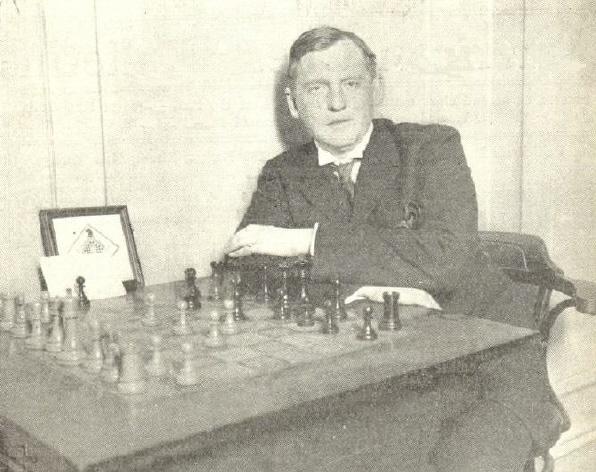
Alekhine’s writings occasionally ‘improved on’ the moves he had played, and five games where there are grounds for, at the very least, suspecting such score-tampering are listed below:
Additions will be welcome.
(4537)
See too Réti v Alekhine, Baden-Baden, 1925.
At a dinner organized by the Spanish Chess Federation at the Casino de Madrid in December 1935 Capablanca was questioned about his rivals. The Alekhine v Euwe world championship match was then being played in the Netherlands, and the Cuban was guarded on that subject. As for the future, he believed that he himself had the greatest right to challenge for the world title, followed by Flohr (who had enjoyed much success in recent years) and Lasker (regarded by Capablanca as still in the first rank of champions, despite his age). The Cuban had very high praise for Botvinnik, whom he considered more likely to become world champion than such other young players as Lilienthal and Reshevsky. Finally, Capablanca spoke highly of Tartakower, saying that he was, when on form, one of the most redoubtable masters.
The report, published on pages 491-492 of the December 1935 issue of El Ajedrez Español, is given below:
‘En estas contestaciones estuvo reservado respecto al resultado del match Alekhine-Euwe; nos reafirmó en nuestro convencimiento de que en orden de derechos la posición de los candidatos al título mundial son: Capablanca, Flohr (cuyos éxitos en estos últimos años son indiscutibles y de gran valor, según el maestro cubano) y Lasker, quien a pesar de su edad todavía está en primera fila de campeones, a juicio de quien le desposeyó del título mundial. De Botvinnik (el campeón ruso), hace Capablanca magníficos elogios y lo considera con más condiciones para llegar al título máximo que otros jóvenes que se han revelado en los últimos años, como Lilienthal y Reshevsky. También hace elogios de Tartakower, al que estando en forma considera uno de los más temibles grandes maestros.’
(4577)
Below is an extremely scarce, though poor-quality, photograph of Capablanca and Alekhine in Buenos Aires, which we reproduce from page 2 of the newspaper Crítica, 18 September 1927:
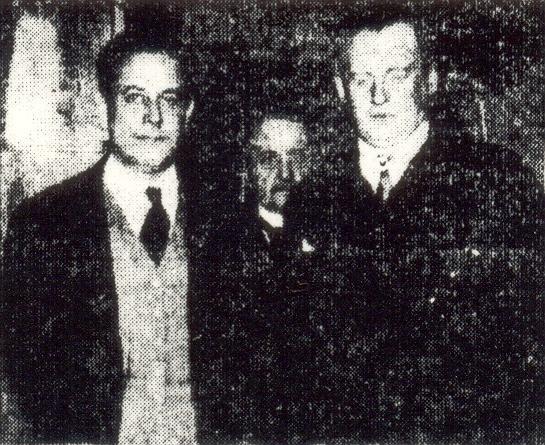
(4586)
From pages 6 and 17 of the 9 October 1927 issue of Carteles magazine:
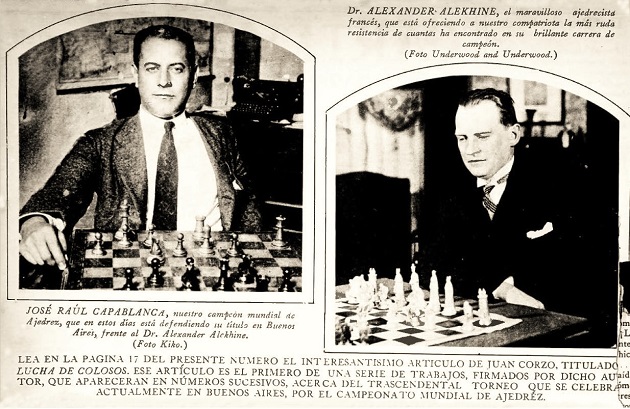
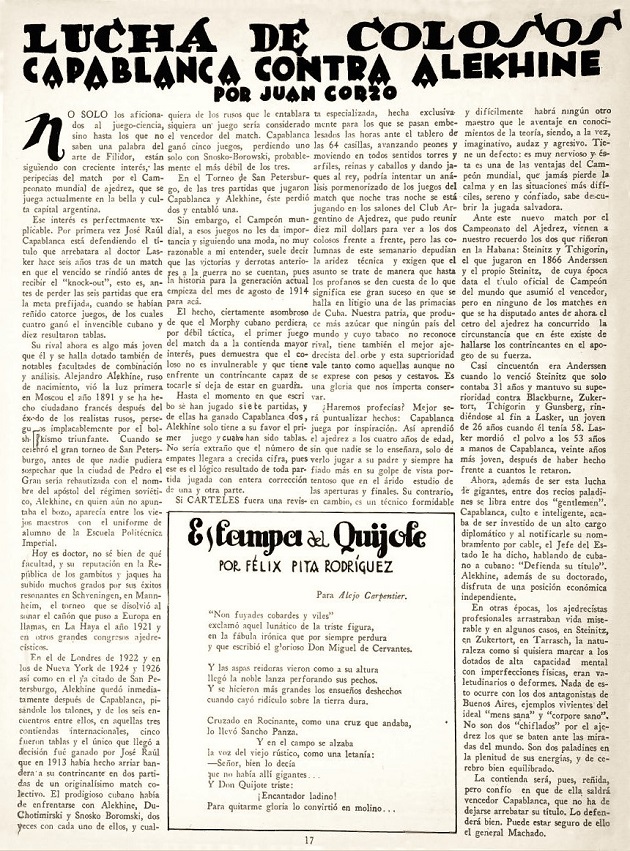
(11260)
From Christian Sánchez we have received the following news report on page 3 of La Nación, 17 December 1926:
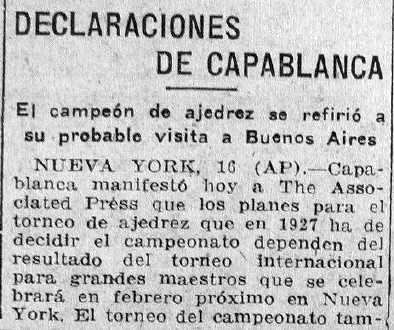
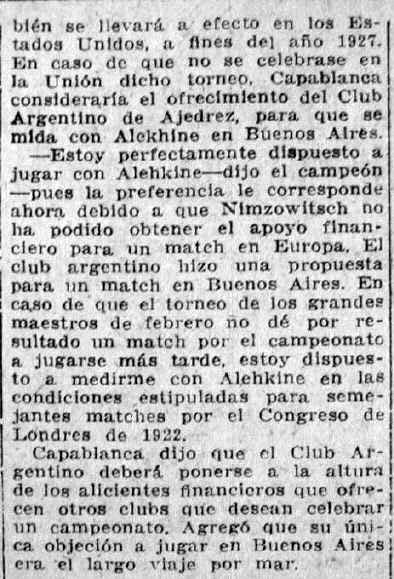
At that time it was unknown where the next world championship match would take place and who Capablanca’s opponent would be. In the report the Cuban stated that he was perfectly willing to play against Alekhine, under the London Rules, and that Alekhine now had priority since Nimzowitsch had been unable to obtain financial support for a match in Europe. Page 194 of our book on Capablanca quoted a letter dated 21 September 1926 in which he gave Nimzowitsch until 1 January 1927 ‘to show what you can do towards obtaining the necessary funds for the match’, after which we remarked that ‘the deadline of 1 January 1927 came and went without Nimzowitsch following up his challenge’. The report in La Nación shows that, already by mid-December 1926, Capablanca had been notified of the failure of Nimzowitsch’s attempt.
(4599)
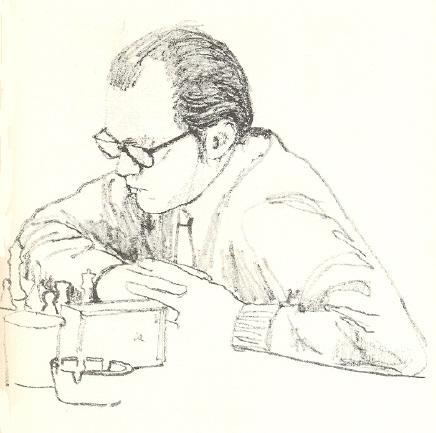
The question in C.N. 4656 set a little trap, since the sketch might easily be taken to depict Alekhine; compare, for instance, the photograph of the world champion opposite page 160 of Kings of Chess by William Winter (London, 1954):
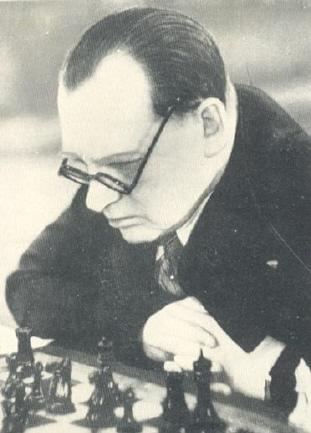
The sketch, however, was of William Addison. Source: page 12 of The 1969 United States Chess Championship and World Championship Zonal Qualifier by Morton Siegel (Newburgh, circa 1969).
(4672)
Simon Browne (Chelsea, Australia) refers to the participation of Capablanca and Alekhine in the Buenos Aires Olympiad, 1939 and to this comment on page 643 of Alexander Alekhine’s Chess Games, 1902-1946 by L.M. Skinner and R.G.P. Verhoeven (Jefferson, 1998):
‘Although both the French and Cuban teams got through to the final, the pair still did not play each other, since they both opted to take a rest day on the occasion of the France-Cuba match.’
As Mr Browne points out, Alekhine did play in that match, which took place on 14 September 1939. His win, over Alberto López Arce, was given on page 647 of the Alekhine book.
Our correspondent also refers to Capablanca’s explanation of his absence, in an article for the Argentine newspaper Crítica the following day. Below is the English translation from page 295 of our book on the Cuban:
‘Last night’s match between France and Cuba was drawn two-all. I should like to explain my absence, which was due to purely personal reasons.
Neither France nor Cuba was a leading contender in this competition, which meant that from that point of view there was no special significance in whether or not I played. There was only the question of the spectacle itself, which of course could not influence the course of the tournament.
Once more it is necessary to emphasize that the event being held at the Politeama is a tournament for teams, not individuals. A week ago I notified the Argentine Chess Federation that I did not intend to play against Alekhine, and I explained my reasons for this decision.
I made this announcement to the Federation so that my intentions were known in advance, and to prevent disappointment on the part of the public. My not playing yesterday was thus not an act of discourtesy to the Federation, nor a lack of consideration for the Buenos Aires public.
Therefore there was no question, as has incorrectly been stated, of my refusing a favour asked by the Federation. I have, and have always had, the best intentions towards the chess public and the organizing body.’
To some, unfortunately, this statement may be an irresistible springboard for speculation, and especially since it has not been established what reasons Capablanca gave to the Argentine Chess Federation or, indeed, whether he gave them in writing. Nor, incidentally, do we recall any public comment by Alekhine on Capablanca’s refusal to play him in the Olympiad.
The following week both masters wrote to the President of the Argentine Chess Federation, Augusto De Muro, regarding a possible world championship rematch. Page 240 of our book on Capablanca reproduced their respective letters, from page 34 of CHESS, 20 October 1939, and, rather than giving them again here, we quote Fred Reinfeld’s assessment on pages 194-195 of The Human Side of Chess (New York, 1952):
‘Capablanca was pathetically eager, even at this late date, to arrange a return match. He wrote a letter to the President of the Argentine Chess Federation, abounding in such phrases as, “I am disposed to play [...] whenever it can be arranged. ... I have not the slightest objection to make. ... I am disposed to accept this modification. ... Also I will accept whatever [reasonable] modification ... you will have no difficulty in coming to an agreement with me. ... I should be at your service.” Etc., etc.
It was a ticklish moment for Alekhine. Hurriedly snatching at the first available script, he wrapped himself in the Tricolor with great dignity, and sounded the note of “I would [could] not love thee, Dear, so much, loved I not honor more.” He gravely explained that “I am subject to mobilization as an official interpreter in the reserve”. Considering Alekhine’s age and world fame, there is little doubt that he could have obtained the necessary leave, in the period of “the phony war”. But he did not want to play Capablanca, as we know, and this time he adopted a subterfuge which would have served admirably in an Offenbach operetta ...’
It seems to us, though, that much more research is required, in the Argentine Federation’s archives (if any) and in local newspapers, before conclusions of any kind can be reached. The confusion prevailing at the time is reflected in articles in two consecutive issues (November and December 1939) of the chess magazine El Ajedrez Americano, which was published in Buenos Aires. Whereas the former (pages 321-322) spoke of a rematch as a virtually certainty, even stating that the Cuban was remaining in Buenos Aires until it came about, the latter (page 353) referred at length to the financial burden in the aftermath of the Olympiad. The November issue reported the masters’ purported standpoints, without giving sources.
We hope that readers will be able to assist us in piecing together additional facts about this final phase of the Alekhine-Capablanca rematch saga.
(4696)
Willibald Müller (Munich, Germany) draws attention to the following letter on page 57 of Erich Eliskases, Caballero del Ajedrez by Guillermo G. Soppe and Raúl O. Grosso (Córdoba, 1997):
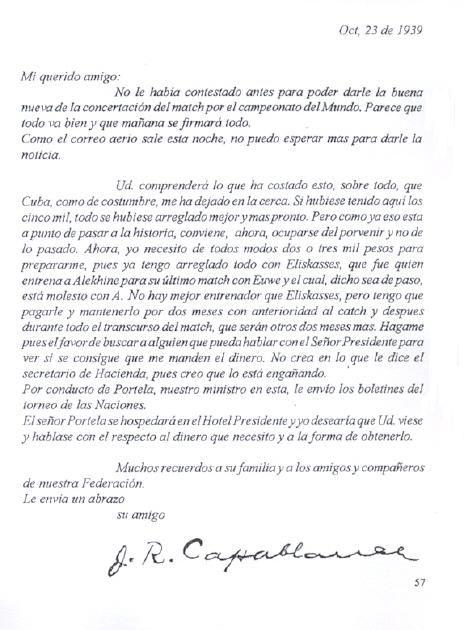
Page 20 describes the letter as ‘una inédita carta entregada por el presidente de la Federación cubana de Ajedrez’, and readers will certainly recognize its significance in several respects. Below is an English translation:
‘23 October 1939
My dear friend,
I did not reply to you earlier, so as to be able to give you the good news about the agreement on the match for the world championship. It appears that all is going well and that tomorrow everything will be signed.
As the airmail leaves tonight, I can wait no longer to give you the news.
You will understand what this has cost, and especially since Cuba, as usual, has left me in the lurch. If I had had the five thousand here, everything would have been settled better and faster. But that is about to pass into history, and now is the time to turn to the future and not to what has happened. Now, I need in any case two or three thousand pesos to prepare myself, as I have already arranged everything with Eliskases, who seconded Alekhine for his last match with Euwe and who, incidentally, is annoyed with A. There is no better second than Eliskases, but I have to pay him and retain him for two months before the match and then throughout the entire duration of the match, which will be another two months. Please therefore do me the kindness of seeking someone who can speak to the President to see whether it can be arranged for them to send me the money. Do not believe what you are told by the treasury secretary, as I believe that he is deceiving you.
Through Portela, our minister, I am sending you the bulletins of the Nations Tournament.
Señor Portela will be staying at the Hotel Presidente, and I should like you to see him and speak to him about the money I need and how to obtain it.
With best wishes to your family and to the friends and companions of our Federation.
Kind regards from your friend,
J.R. Capablanca.’
(4742)
Javier Asturiano Molina (Murcia, Spain) draws attention to these reminscences on page 157 of Ajedrez inmortal de Capablanca by M. Euwe and L. Prins (Buenos Aires, 1959):
‘Cuando hablé con Capablanca por última vez – fue en la escalinata del teatro Politeama de Buenos Aires, donde se disputaba el Torneo de las Naciones en 1939 – Capablanca abogaba apasionadamente por un match por el campeonato mundial. “No importa con quién, cómo ni dónde”, me dijo, “con tal que no se permita a Alekhine seguir encerrado más tiempo en su torre de marfil. Tiene que jugar o ser descalificado. Esta situación es una locura. Tiene que jugar, lo ha de hacer ...”’
A number of comments are called for. Firstly, the text appeared at the end of the chapter on the 1927 world championship match, a chapter whose authorship was credited (on page 139) to Euwe. However, Euwe did not participate in or attend the 1939 Olympiad. Secondly, the title page stated that the Spanish text was a translation, by L.A. Asterblum, from the German. Page 166 of that (1952) book by Euwe and Prins, Capablanca Das Schachphänomen, specified, as the Spanish book did not, that the text about the conversation in 1939 was written by Prins. Thirdly, the German is not identical to the Spanish, and below we give a translation direct from the German:
‘When I spoke with Capablanca for the last time – it was on the steps of the Politeama Theatre in Buenos Aires, where the Tournament of Nations took place in 1939 – he passionately argued for a world title match. “It does not matter what, how or where”, is roughly what he said, “as long as Alekhine is no longer allowed to retreat into his ivory tower. He must play or be disqualified. This situation is madness. He must, he must ...”’
We note that the text is absent from the original Dutch edition, Het schaakphenomeen José Raoul Capablanca y Graupera (The Hague, 1949), where it would have been expected on page 173.
(4774)
Ricardo Velasco (London) mentions a photograph of Capablanca and Alekhine taken in Buenos Aires in 1927 which has been widely disseminated on the Internet in the past year or so, billed as the only existing picture of both masters at the board during their world championship match.
However, another photograph was given on page 4 of the Argentinian newspaper Crítica of 9 March 1942. Since we have only a photocopy, the reproduction below is not of good quality:
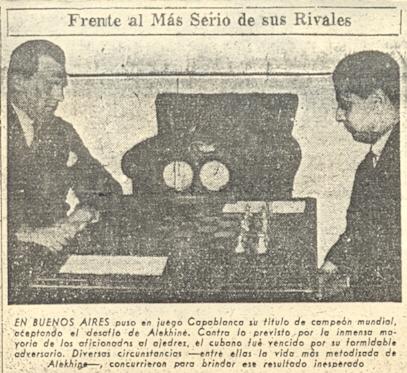
A photograph of Capablanca alone at the board appeared on page 3 of El Ajedrez Americano, October 1927:
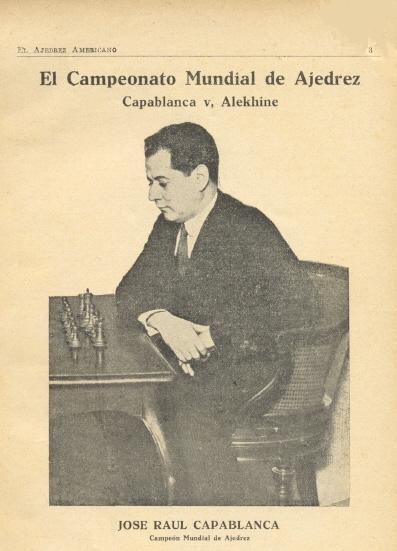
For Alekhine alone, we turn to La Prensa of 30 November 1927 (another photocopy):
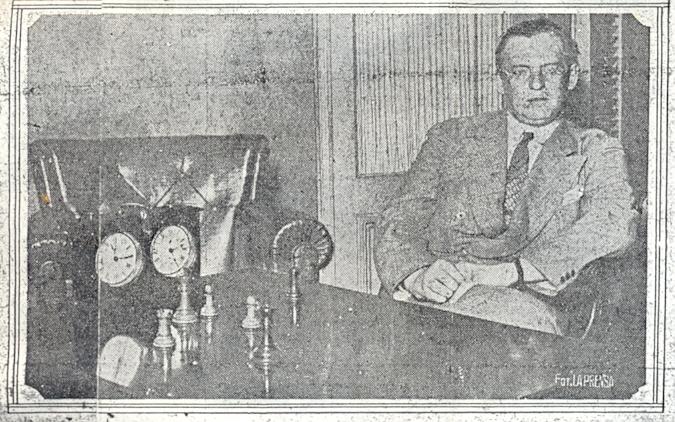
The newspaper’s caption read, ‘El profesor Alekhine junto al tablero donde se jugó la partida final del campeonato’.
As noted in C.N. 4586, a photograph of Capablanca and Alekhine standing together was published on page 2 of Crítica, 18 September 1927:

The previous day the Argentinian newspaper (page 3) had given the following picture by Bravo:
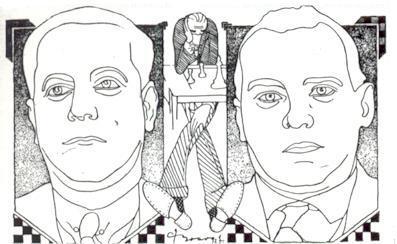
The caricatures of Capablanca and Alekhine below also come from Crítica (11 October 1927, page 4 and 24 September 1927, page 7 respectively):
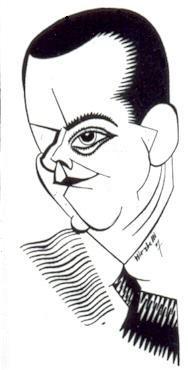
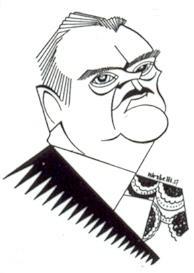
(4814)
Olimpiu G. Urcan writes:
‘The picture of Capablanca in C.N. 4814 which was on page 3 of the October 1927 issue of El Ajedrez Americano is part of a rather strange photograph of both Capablanca and Alekhine which has been published in several places. A poor-quality version is on page 330 of Miguel A. Sánchez’s José Raúl Capablanca. A Chess Biography (Jefferson, 2015) with a caption stating that it was published in the 16 September 1927 edition of Crítica and that “though it is a poor image, and probably retouched, it is of extraordinary historical value”.
I have found a better copy on page 38 of the January 1928 issue of Cine-Mundial:’

(9944)
Marcelo Sibille (Montevideo, Uruguay) draws attention to a photograph on page 27 of the April 1955 issue of the Argentinian magazine Ajedrez:
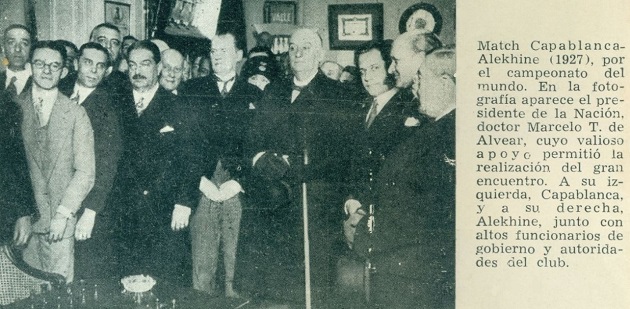
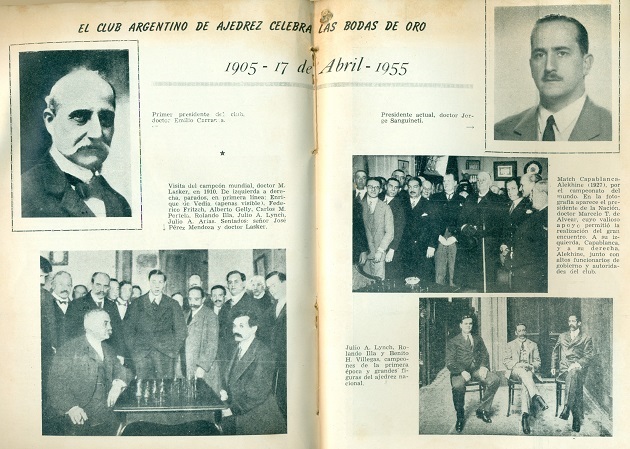
(9954)
We have received the following game from Luc Winants (Boirs, Belgium):
Alexander Alekhine (blindfold) – Léon Neirynck
Brussels, 18 March 1922
English Opening
1 c4 e5 2 g3 Nf6 3 Bg2 c6 4 Nc3 Bb4 5 Nf3 d6 6 d4 exd4 7 Nxd4 Be6 8 Nxe6 fxe6 9 Qb3 Na6 10 O-O Rb8 11 Bf4 e5 12 Be3 Bc5 13 Bxc5 Nxc5 14 Qc2 O-O 15 Rad1 Qe7 16 Rd2 Rbd8 17 h3 Ne6 18 e3 Nd7 19 Ne4 Ndc5 20 h4 Nxe4 21 Qxe4 Nc5 22 Qc2 Rf6 23 b4 Ne6 24 Qe4 Rf7 25 Bh3 Nc7 26 f4 exf4 27 Rxf4 Rdf8 28 Qxe7 Rxe7 29 Rxf8+ Kxf8 30 Rxd6 Rxe3 31 Rd7 Re7 32 Kf2 Rxd7 33 Bxd7 Drawn (at the proposal of Black).
Source: La Nation Belge, 29 March 1923 [sic].
The occasion was a 12-board blindfold display.
(4700)
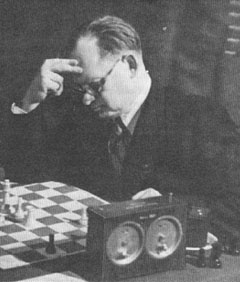
Wolfgang Franz (Oberdiebach, Germany) points out that the position on the board occurred in Alekhine’s game against Mario Napolitano, Munich, 16 September 1942, before 49 Ra5:
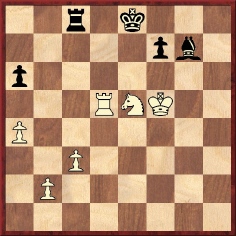
We can add that another photograph of that game was published on page 279 of Alt om Skak by B. Nielsen (Odense, 1943):
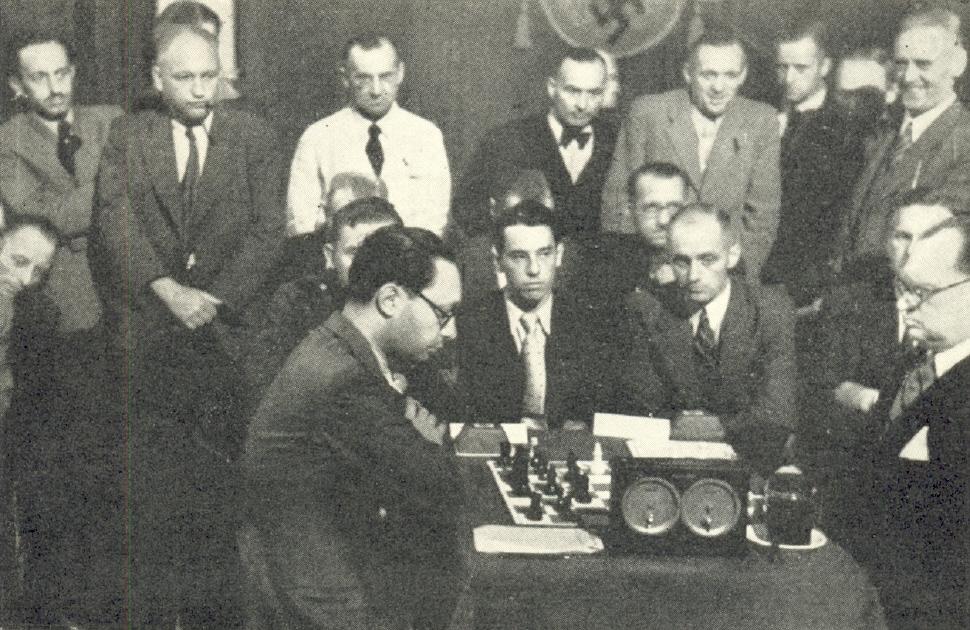
(4762)
One of four photographs provided by Michael Clapham:
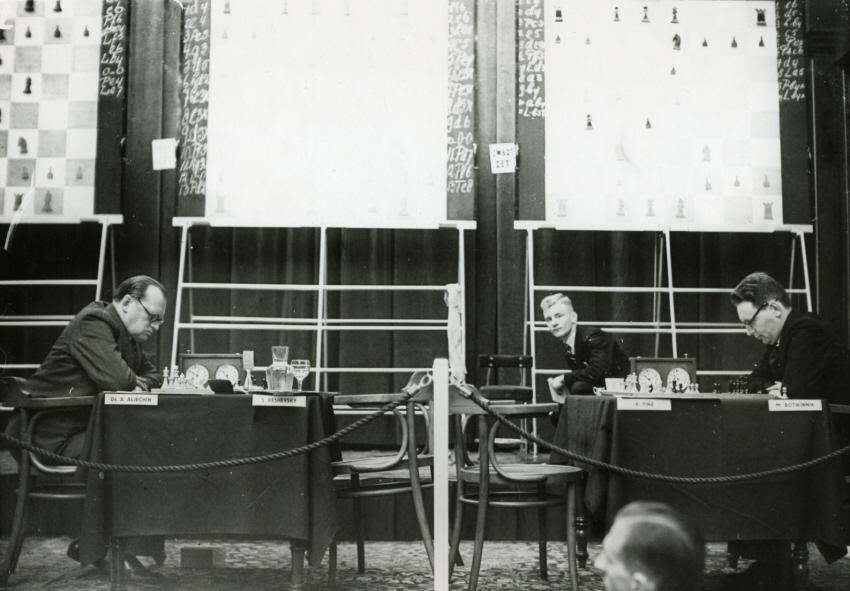
Alexander Alekhine and Mikhail Botvinnik, AVRO, Amsterdam, 6 November 1938
(4791)
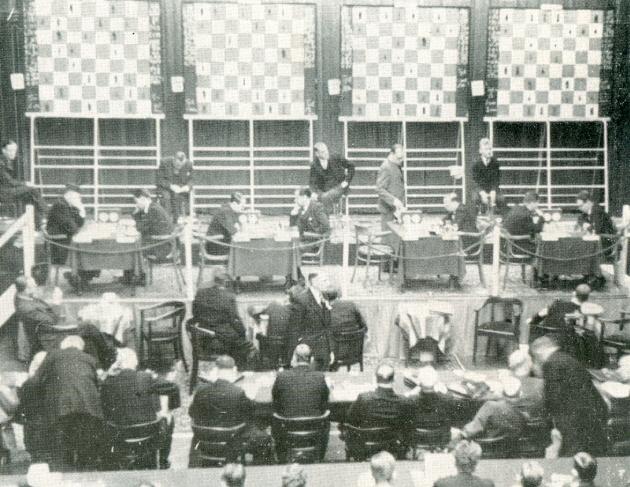
This photograph was taken in Amsterdam on 6 November 1938 during the first round of the AVRO tournament, the players being, from left to right, Euwe, Keres, Flohr, Capablanca, Alekhine, Reshevsky, Fine and Botvinnik. It was one of many shots from De Telegraaf reproduced on pages 139-142 of CHESS, 14 December 1938.
(6640)
Page 268 of Kings, Commoners and Knaves quoted a description of Nimzowitsch as ‘one of the great masters of nineteenth-century chess’ (David Spanier) and a reference to ‘the nineteenth-century master Siegbert Tarrasch’ (Cathy Forbes). Now we add the following from page 6 of MakeYour Own Chess Set by David Carroll (Englewood Cliffs, 1974):
‘Gradually the modern game emerged and developed. By the nineteenth century, masters like Morphy, Capablanca and Lasker were giving chess a heritage and were helped by the efforts of such men as Alexander Alekhine ...’
(4823)
Dale Brandreth (Yorklyn, DE, USA) writes:
‘For many years I have owned Alekhine’s copy of the famous tournament book on Carlsbad, 1907 by Marco and Schlechter. On the spine it has “A.A.” stamped, and on the endpapers there is a note in the hand of Albert Pinkus stating that he acquired the book in June 1949.’
Can readers help in deciphering the marginalia on the two pages below, concerning the games Johner v Rubinstein and Janowsky v Schlechter?
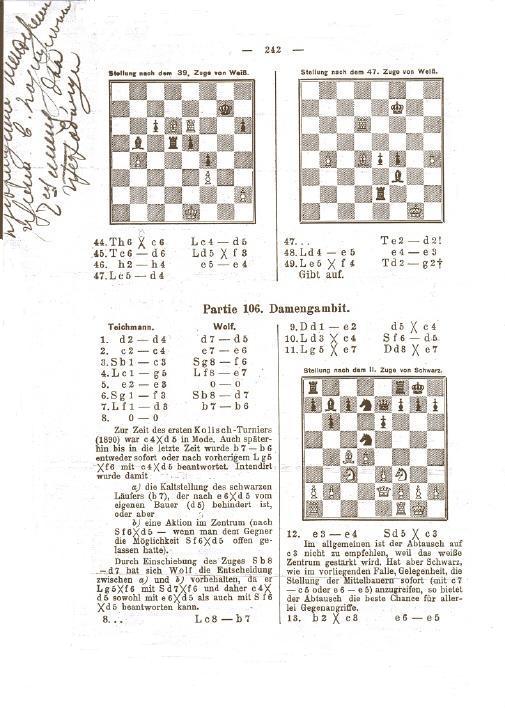
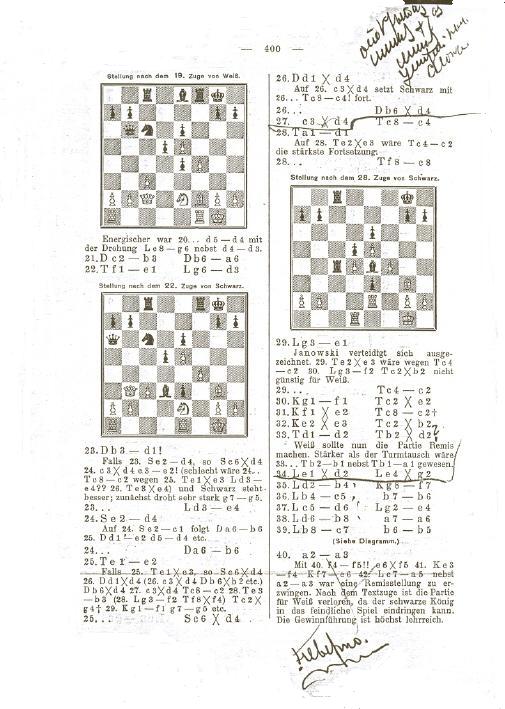
(4849)
Jan Kalendovský (Brno, Czech Republic) submits a photograph of Alekhine with his wife after the 1937 world championship match against Euwe. It comes from an unidentified Dutch publication.

(4880)
The five photographs below are reproduced from the American Chess Bulletin of 1924:
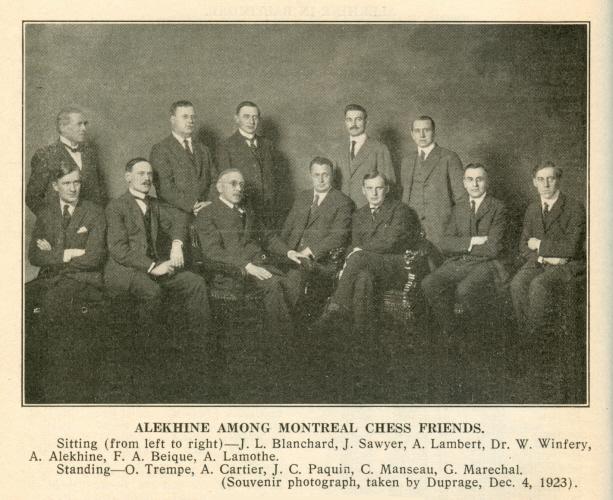
January 1924 Bulletin, page 6
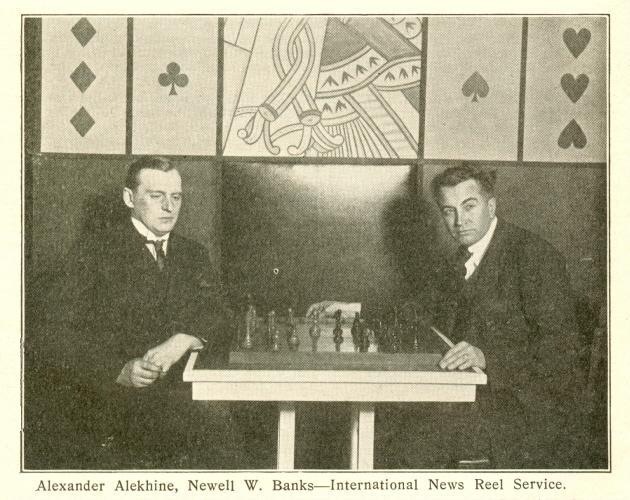
February 1924, page 28
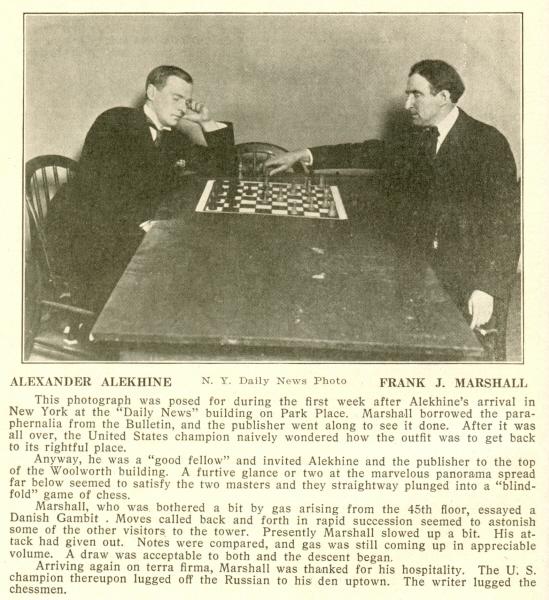
February 1924, page 30
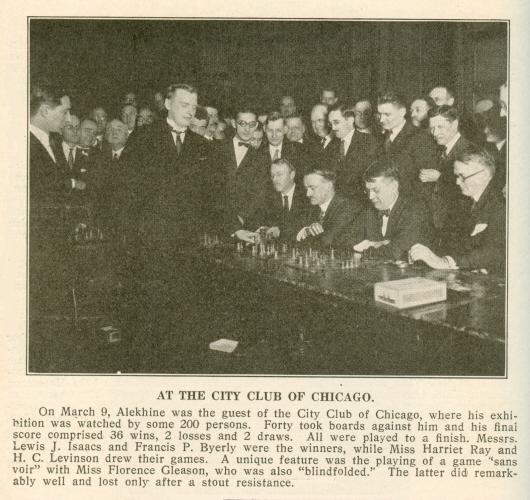
March 1924, page 56
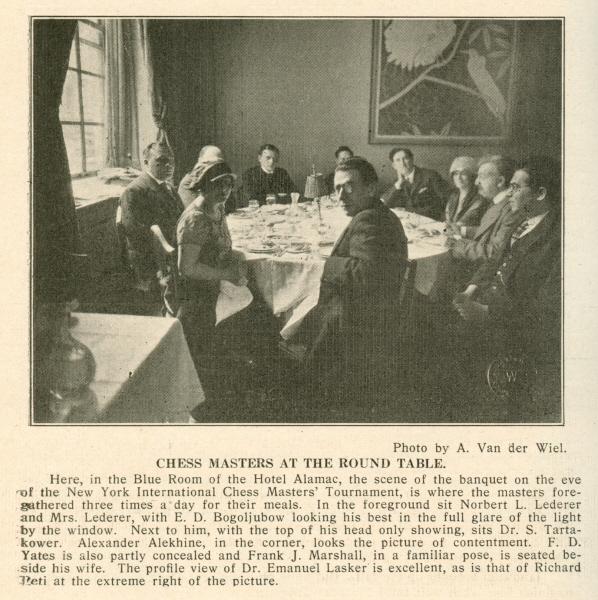
May-June 1924, page 106
(4985)
On page 43 of issue 27 of Kingpin (Summer 1997) we discussed Gleason v Alekhine, Chicago, 9 February 1924, which both sides played blindfold. (See pages 305-306 of Kings, Commoners and Knaves.)
The score as given on page A3 of the Brooklyn Daily Eagle, 21 February 1924:
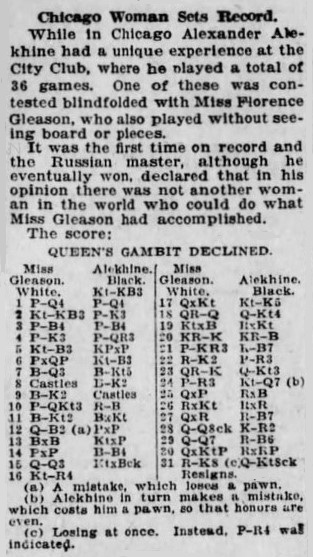
1 d4 Nf6 2 Nf3 d5 3 c4 e6 4 e3 c5 5 Nc3 a6 6 cxd5 exd5 7 Bd3 Nc6 8 O-O Bg4 9 Be2 Be7 10 b3 O-O 11 Bb2 Rc8 12 Qc2 Bxf3 13 Bxf3 cxd4 14 exd4 Nxd4 15 Qd3 Bc5 16 Na4 Nxf3+ 17 Qxf3 Ne4 18 Rad1 Qg5 19 Nxc5 Rxc5 20 Rfe1 Rfc8 21 h3 Rc2 22 Re2 h6 23 Rde1 Qg6 24 a3 Nd2 25 Qxd5 Rxb2 26 Rxd2 Rxd2 27 Qxd2 Rc2 28 Qd8+ Kh7 29 Qd7 Rc3 30 Qxb7 Rxh3 31 Re8 Qb1+ 32 White resigns.
A photograph taken during Alekhine’s exhibition, with Florence Gleason mentioned in the caption, was shown in C.N. 4985. Information about her is still sought.
(10183)
Christian Sánchez draws attention to an extract from an article entitled ‘The Psychology of Chess’ by H. Rogosin on pages 21-22 of Chess Review, January 1939:
‘Blackburne, the famous Englishman, in 1899 was quoted as recalling any number of games played in 1862. In the present day, Alekhine, world’s champion, is supposed to be able to recall every game of note of the last 30 years, with all their moves.’
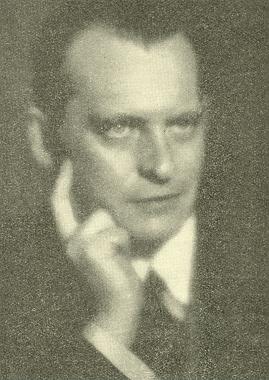
Alexander Alekhine
Regarding Alekhine, we add two comments by Capablanca:
‘Consider the fact that the great masters of truly superior class, like Alekhine and Bogoljubow, young men, know every opening variation that has been frequently used by other masters; that Alekhine, for instance, who is only 33, knows every game played in any tournament or match in the past 25 years ...’
Source: Revista Bimestre Cubana, March-April 1926.
‘He has what is probably the most marvelous chess memory that ever existed. It is said that he knows by heart every game played in any tournament by either a first-class club player or a master during the last 25 or 30 years. He certainly knows by heart all of the games ever played by any of the first-class masters.’
Source: New York Times, 19 February 1927, page 10.
(5010)
See also Memory Feats of Chess Masters.
From page 23 of The Bright Side of Chess by Irving Chernev (Philadelphia, 1948):
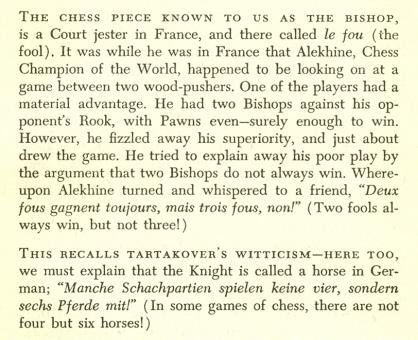
Earlier sources for these quips are sought. Regarding the Alekhine one, the following appeared on page 49 of CHESS, January 1942:
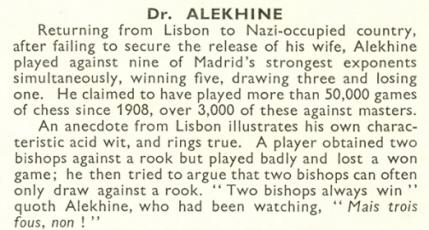
(5044)
The full alleged sentence in French appeared on page 91 of Chess World, 1 May 1946:
‘In French the piece we call the bishop is called “le fou” (the fool).
A Lisbon player who had just lost a game was explaining volubly how he should have won because he had the bishops. Alekhine was looking on. He said:
“Deux fous gagnent toujours – mais trois fous, non.”
(Two fools always win, but not three.)’
(10152)
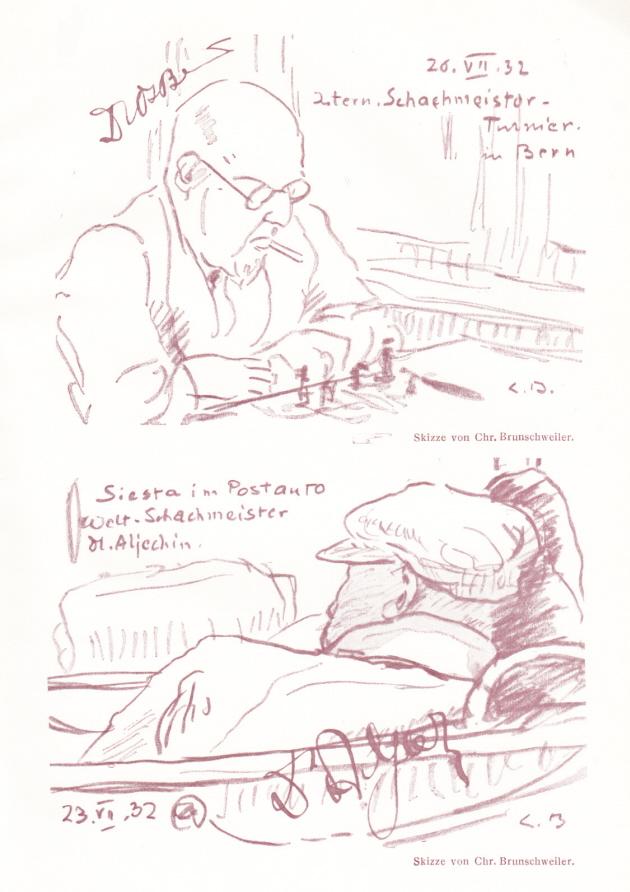
These sketches by Chr. Brunschweiler appeared in the Berne, 1932 tournament book.
(5054)
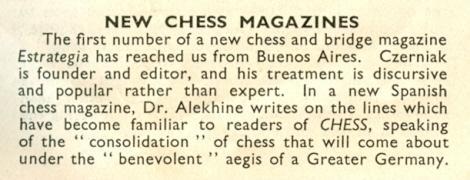
The above is a news item on page 129 of CHESS, June 1942. Can a reader identify the ‘new Spanish chess magazine’ and what did Alekhine write there?
(5073)
The photographs below come from the Gijón, 1944 tournament book, Torneo internacional de ajedrez by Juan Fernández R. Rúa (Madrid, 1945):
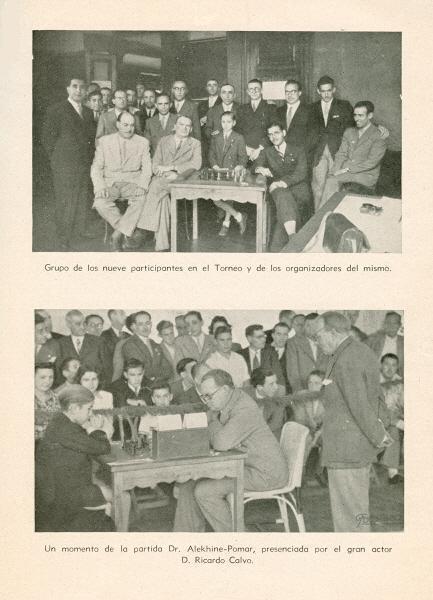
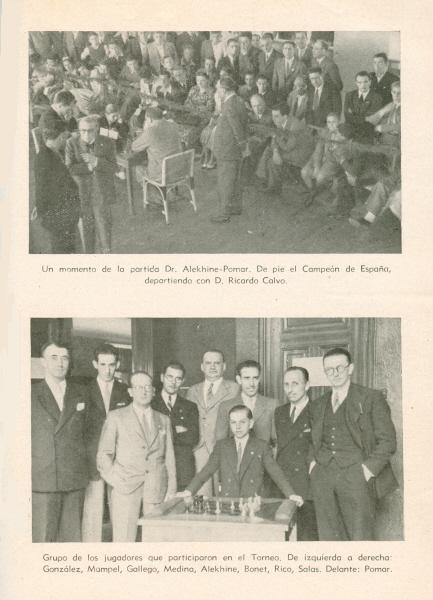
(5110)
Christian Sánchez provides an article by Hartwig Cassel (1850-1929) on page 2 of section 3 of the 21 August 1927 issue of La Prensa, although it was written in June (in New York). Cassel reported that in the opinion of the New York chessplayers the Capablanca v Alekhine match would not be of interest, as Capablanca would win easily. He stated that, on the basis of recent tournament results, Lasker and Bogoljubow had a greater right to challenge the Cuban, as Alekhine lacked the requisite stature for the match.
The article was unfortunate too not only in misspelling Cassel’s name on both occasions it was mentioned but also in claiming that in a game between Capablanca and Alekhine at New York, 1927 the following position had arisen ...
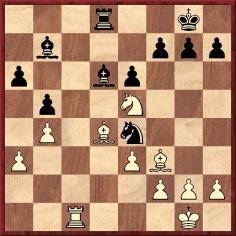
... and that Capablanca had played 1 Nd3, the game being drawn a few moves later. Instead, wrote Cassel, 1 Nc6 Bxc6 2 Rxc6 would have caused the loss of Black’s a-pawn, after which Capablanca might well have won the game.
In reality, the above position never occurred, as Alekhine pointed out on page 29 of the February 1928 American Chess Bulletin:
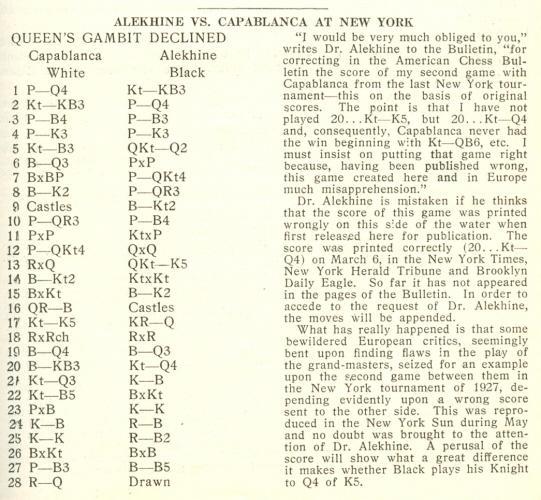
The New York Sun (mentioned by the Bulletin) had as its chess columnist Hartwig Cassel.
On page 97 of his book on New York, 1927 the explanation offered by Alekhine was that a telegraphic error had resulted in 20...Ne4 being given, instead of 20...Nd5, in South American and European chess magazines:
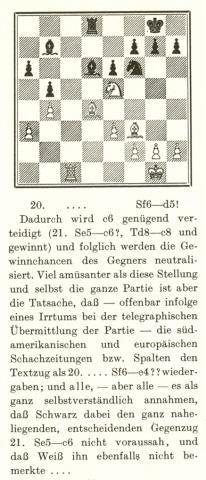
For an English version of the note, see page 308 of the Skinner/Verhoeven book on Alekhine.
Finally, page 117 of the July-August 1929 American Chess Bulletin had a photograph taken at Bradley Beach, 1929 which featured both Alekhine and Cassel. The latter died about a month afterwards.
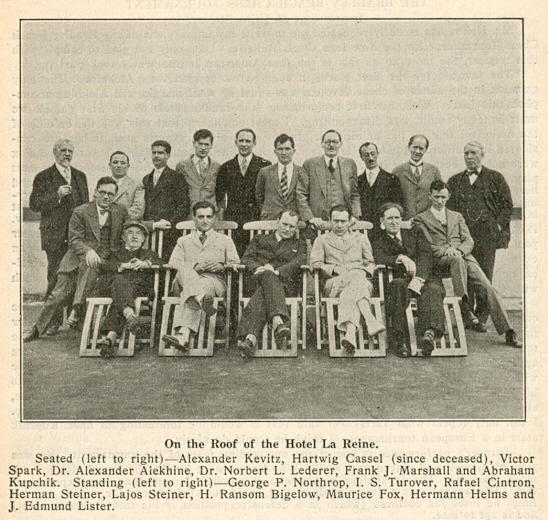
The person between Herman and Lajos Steiner is not identified.
(5117)
From page 129 of the July-August 1929 American Chess Bulletin:
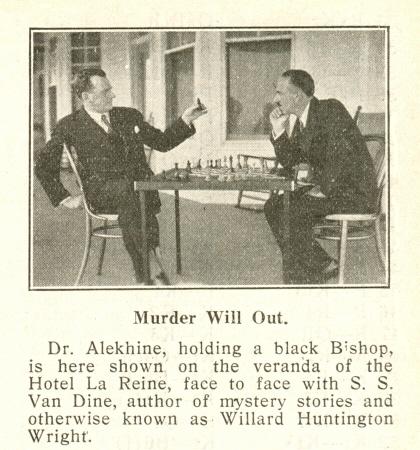
(5126)
See also C.N. 5948.
‘Be more considerate to small boys.’ That request was made to Alekhine by Gerald Abrahams in 1936, as related on pages 135-136 of his book Not Only Chess (London, 1974).
At a simultaneous display in Liverpool in autumn 1923 Abrahams, then aged 16, was the last surviving player:
‘And there was Alekhine, standing over the board, insisting on instantaneous replies. He thought, then made his move, rapped sharply on the table and made impatient sounds in Russian.
The position was hard. Pawns wedged with pawns, and my king bishop and knight, endeavouring to be on guard at all moments against his king, and two fantastically wheeling knights. After 12 lightning moves under these conditions the boy went wrong, found a pawn indefensible, and resigned. The grandmaster swept the pieces aside brusquely, and stalked away. He was, let me emphasize, entirely within his rights.’
After describing how differently Capablanca later behaved towards him in similar circumstances, Abrahams related that at Nottingham in 1936 Alekhine’s wife (‘a delightful American lady’) required assistance with a visa renewal.
‘Alekhine asked me to oblige, and I gladly did so. He said, “If I can ever do anything for you, please ask me.” I replied, “You can do something for me.” He raised an interrogative eyebrow. I said, “Be more considerate to small boys.” The frozen blue eyes stared at me for some seconds. “Yes”, he said, I remember, Liverpool 1923. You had pawns, bishop and knight against my pawns and two knights. You should have drawn that game.”’
Although Abrahams stated that Alekhine faced 60 opponents, the master’s score given on page 403 of the November 1923 BCM and page 197 of the Skinner/Verhoeven book on Alekhine was +24 –1 =6. The exhibition took place on 29 September 1923.
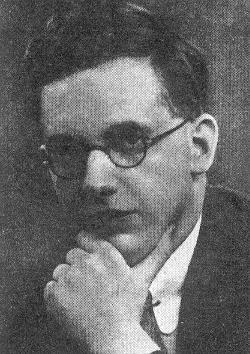
Gerald Abrahams
(5127)
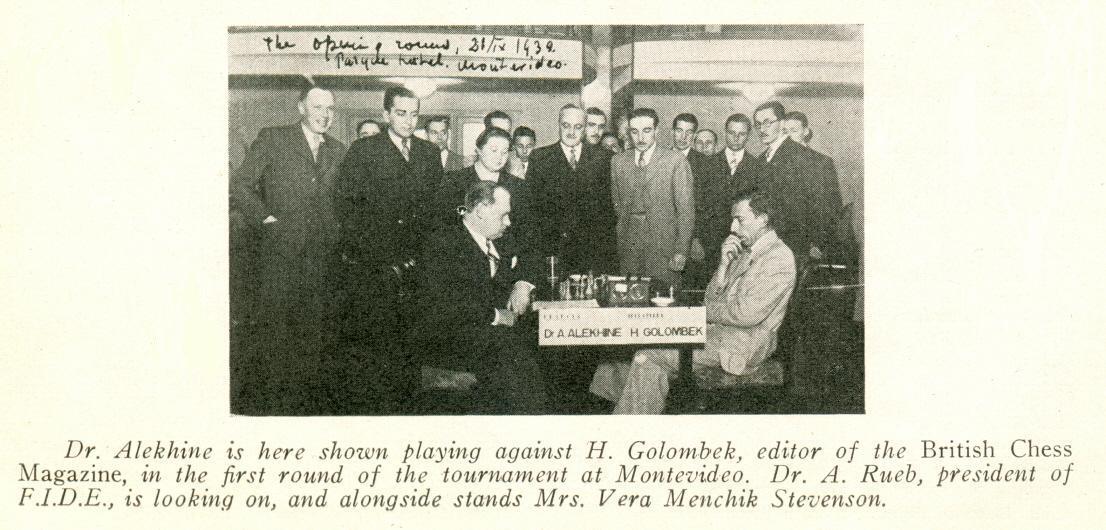
This photograph was published on page 54 of the March-April 1940 American Chess Bulletin. The reference to Rueb is rather surprising.
(5168)
We are grateful to the Cleveland Public Library for this better-quality scan of the photograph:
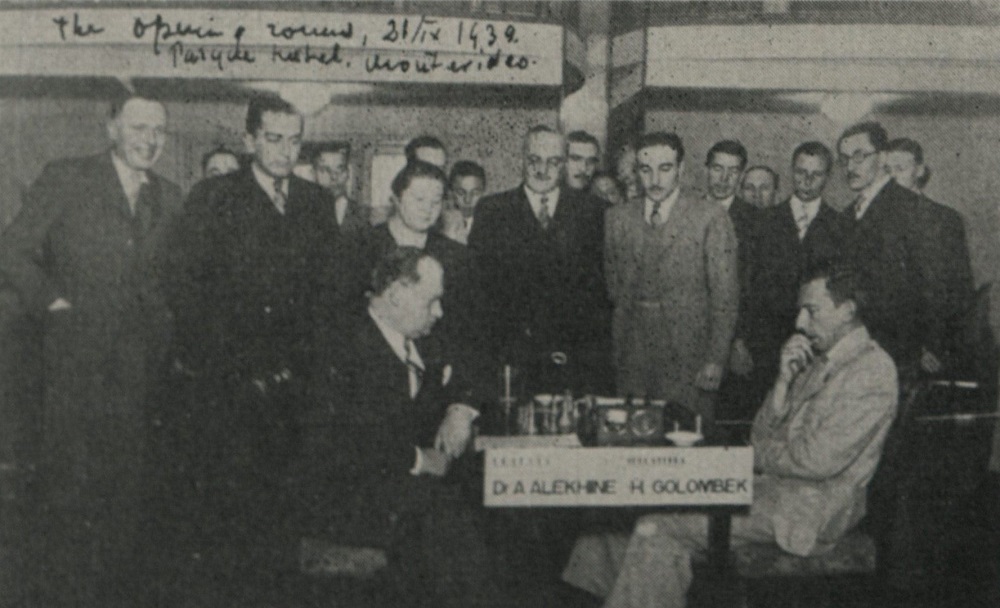
C.N. 3202 (see page 281 of Chess Facts and Fables) discussed the claim that in a game at Kemeri, 1937 Alekhine played two moves in succession. His encounter with Vladas Mikenas has been mentioned in that context, but Sandro Litigio (Como, Italy) writes:
‘An article “How I outplayed Alekhine!” by Mikenas on pages 52-54 of the January 2006 CHESS has his detailed comments on the game against Alekhine at Kemeri, 1937. As Mikenas mentions no double move, it would seem that any such incident must have occurred in a different game.’
(5181)
The extract below from page 114 of CHESS, 14 December 1937 is relevant to our items ‘Two moves in succession’ (C.N.s 3202 and 5181) and ‘Heaven’ (C.N.s 5600, 6813 and 8672):
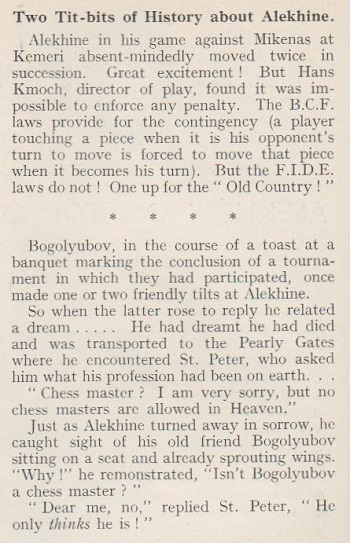
(9432)
Concerning the Alekhine v Bogoljubow world championship rivalry, page 297 of Learn from the Legends by Mihail Marin (Göteborg, 2004) states:
‘Ironically, Alekhine himself remarks in one of his comments to an emphatic win against his challenger: “This game is a clear hint about the pointlessness of the whole match”.’
We take that to be a rather simplified version of Alekhine’s observation (in his second volume of Best Games) about Bogoljubow’s 29th move in game four of the 1934 contest:
‘This game – more than any other – proves how useless from the sporting point of view was the arrangement of this second match, and at the same time explains my indifferent play on a number of occasions. I felt sure that Bogoljubow was no longer able to take advantage of the opportunities my play might present to him, and – very unfortunately for the general artistic value of the present match – the score 7 to 1 in my favour after the 22nd game fully justified my sanguine outlook.’
We should like to draw together any other comments by Alekhine, either at the time or afterwards, on the overall status, value or importance of the 1934 match.
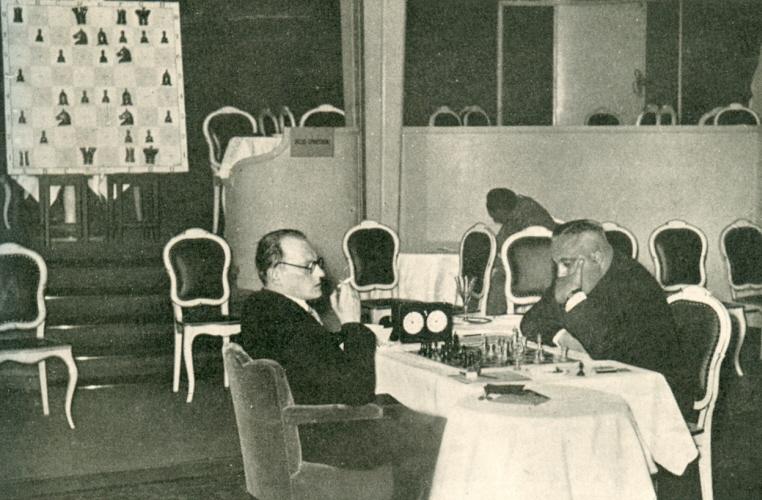
A. Alekhine v E. Bogoljubow, 25th match-game, Berlin, 11 June 1934
Page 490 of Alexander Alekhine’s Chess Games, 1902-1946 by Leonard M. Skinner and Robert G.P. Verhoeven (Jefferson, 1998) quoted a passage by Nimzowitsch in De Telegraaf, 1 May 1934 in which he reported on his conversation with Bogoljubow after the eighth match-game:
‘Apparently he believed that his performance in the match was being influenced by some hypnotic power brought about by Alekhine. In spite of being assured by Nimzowitsch that this was impossible, Bogoljubow insisted that it could be done. He seemed unable to comprehend that Alekhine was deliberately playing on his well-known sense of optimism in dealing with complicated tactical situations. Instead of defusing and simplifying the positions that Alekhine provoked, he aided and abetted Alekhine’s strategy by entering into the tactics with great enthusiasm.’
For further notes on hypnosis, see pages 170-171 of Kings, Commoners and Knaves. As regards optimism, it may be recalled from C.N. 832 (page 120 of Chess Explorations) that in an interview Bogoljubow stated:
‘People who know nothing about chess or character evaluation claim that I am an optimist. Quite the contrary, though, I am of a pessimistic nature. My wife always says (and quite correctly too), “Always expect the worst; if things then actually turn out better, you’ll be happy”.’
We quoted that passage from page 986 of L’Echiquier, March-April 1935, which mentioned that the interview had first appeared in Kasseler Neueste Nachrichten, 17 December 1932. Can a reader provide a copy of that original publication?
(5274)
Steve Wrinn draws attention to the following remark by Emanuel Lasker:
‘Bogoljubow, it seems, believes in the art of subjecting one person to the will of another by some extraordinary power. Can such an art exist? Decidedly no. If it did exist and someone set himself up as a teacher of this art, he would have the whole world for his customers and yet derive no advantage therefrom, because his pupils would hypnotize him and then suggest to him the return of the tuition fee.’
This comes from page 11 of Lasker’s book Games Played in the Return Match for the World’s Championship (London, 1935), and for the context we reproduce below the full page:
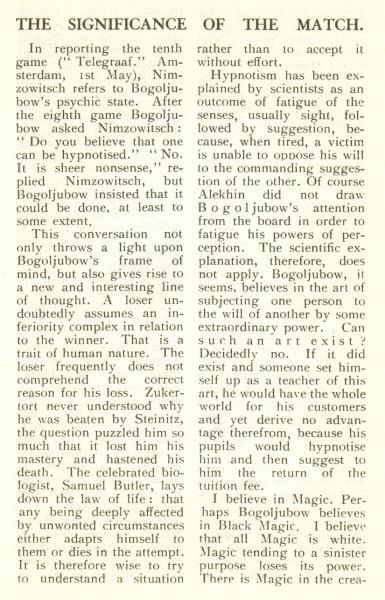
(5282)
See also Chess and Hypnosis, which includes the following:
See too page ix of Bled 1931 International Chess Tournament (Yorklyn, 1987), in a 1976 article by Flohr translated from 64:
‘This time, Nimzowitsch said that “Alekhine has hypnotized all of us”. But this was not original, since both before and after Alekhine all world champions “have hypnotized and will hypnotize”.’
Javier Asturiano Molina asks about an article by Alekhine in Skakbladet after Nimzowitsch’s death.
C.N. 1931 mentioned the tribute, which was published in the May 1935 issue of the Danish magazine:
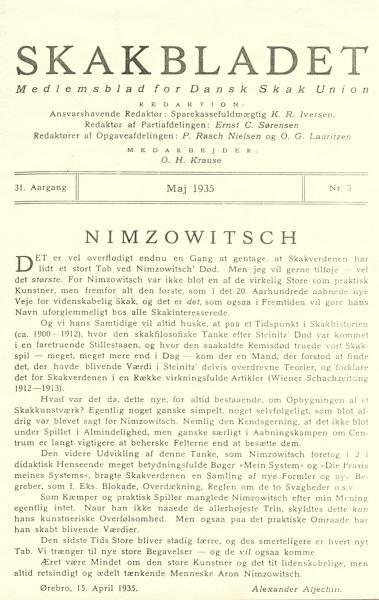
(5275)
Addition on 5 July 2025:
In his ‘TheArticle’ piece of 5 July 2025, Raymond Keene reports learning of Alekhine’s ‘virtually unknown obituary’ of Nimzowitsch (Skakbladet, 1935). He naturally does not mention that the complete text has been available online (C.N. 5275) since November 2007.
That complete Nimzowitsch Memorial Issue of Skakbadet (May 1935) is available online.
From Oliver Beck (Seattle, WA, USA):
‘In a bookstore I recently came across two boxes of books and other rare and interesting chess material which once belonged to Paul Hugo Little (Litwinsky). C.N. 4935 showed him at the board with Euwe and Alekhine during their game at Nottingham, 1936, in a photograph taken from Chess Review, and I wonder if he was seated there as an indirect result of the disturbance created by Euwe and others during the Flohr v Capablanca game in the third round (see A.J. Mackenzie’s comments on page 3 of the tournament book, as well as Alekhine’s note to Capablanca’s 37th move on page 59), although he may have received that privilege through his donation of prizes (page xiv). I am interested in learning more about this incident, which may have cost Capablanca sole possession of first place.
Little, who died in 1987, was an interesting character. His many notes in the material I acquired show him to have been a stickler for detail and accuracy. For example, among the newer books is a copy of With the Chess Masters which was signed and dedicated to him by George Koltanowski. This, however, did not stop Little from correcting it throughout with a ballpoint pen, finding many of the errors you pointed out on page 160 of Chess Explorations.’
Below are the passages by Alekhine and Mackenzie referred to by our correspondent:
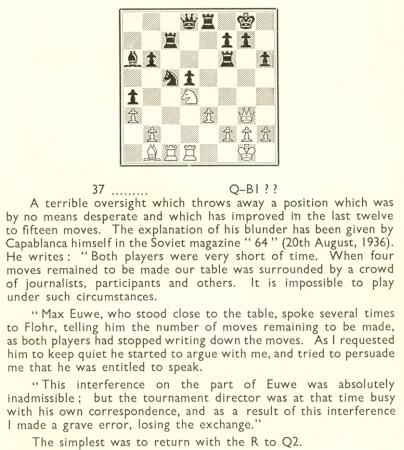
Above: from Alekhine’s notes to Flohr v Capablanca, in the Nottingham, 1936 tournament book (with incorrect diagram)
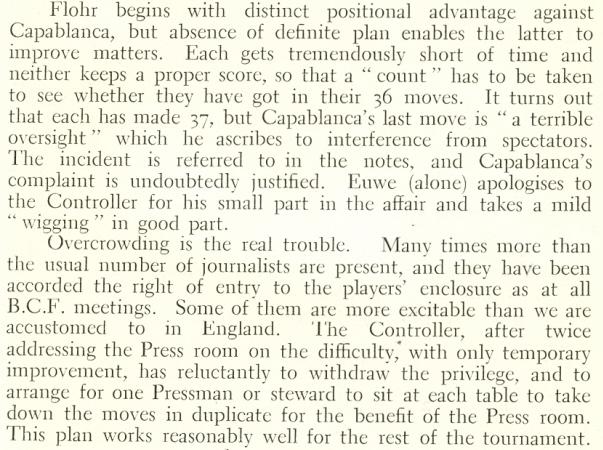
From A.J. Mackenzie’s round-by-round commentary in the Nottingham, 1936 tournament book
An English translation (by Kenneth Neat) of all Capablanca’s notes to the Flohr game on page 2 of the 20 August 1936 issue of 64 appeared on page 279 of our book on the Cuban. Moreover, C.N. 211 mentioned that on page 166 of The Great Chess Tournaments and Their Stories (Radnor, 1975) A. Soltis expressed unjustified doubts about the account:
‘The only problem with Capablanca’s version of the incident is that the time limit was 36 moves in two hours, not 40. This would mean that Black’s blunder came after the time control.’
There is, though, a simple explanation. C.N. 211 quoted from page 314 of the Australasian Chess Review, November 1936:
‘The players were now so clock-pressed that they had not even been able to write down their last few moves. At any rate, Capablanca had not. Therefore, he did not know that he had made his 36. Hence this clock-blunder when the race was actually over.’
See also pages 432-433 of the September 1936 BCM and, in particular, the note to 37...Qc8:
‘Both players were so short of time they did not even know how many moves they had made. This explains the repetition of moves, and also their meaningless manoeuvres; and also how it happened that Black made a mistake when the time-limit was finished.’
(5292)
The remainder of C.N. 5292 had a note about P.H. Little.
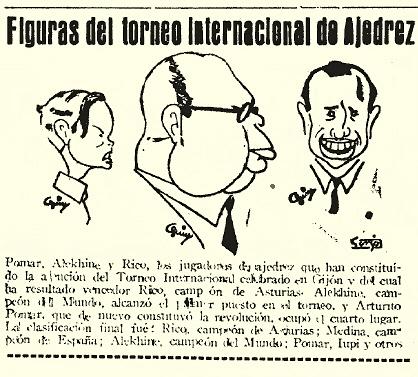
Christian Sánchez sends the above cutting with caricatures of Arturo Pomar, Alexander Alekhine and Antonio Rico at Gijón, 1945, from page 6 of the Spanish (Cuenca) newspaper Ofensiva of 2 August 1945.
The caricature of Alekhine must be one of the last published during his lifetime.
(5307)
On pages 39-40 of Chess and its Stars (Leeds, 1936) Brian Harley published an open letter to Alekhine:
‘Dear Master,
The chess world undergoes agonies in its struggles with the spelling of your name, which has as many versions as Shakespeare’s.
Twenty years ago you were “Aljekhin”; then you suffered a “c” change to “Aljechin”; and then again we met with “Alechin”. We thought you had attained, with your French citizenship, the ultimate stage with “Alekhine”. And now, in an article in a chess magazine, you sign yourself “Alekhin”.
I recall that I was once asked at a Congress to point out Alkaline, when I made the comment that the acid test of a chessplayer should be the knowledge of the correct spelling of a champion’s name. So I implore you, Master, to make an announcement of a final, fixed and unalterable version: and to stick to it.
Brian Harley.’
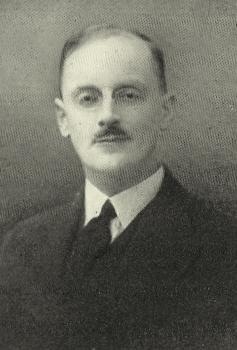
Brian Harley
(5311)
From Dan Scoones:
‘Regarding Alekhine’s two-volume set in English entitled My Best Games of Chess, for many years I assumed that the books had originally been published in French, not least because of the existence of a two-volume set under Alekhine’s name, Deux cents parties d’échecs, but those volumes correspond to the first My Best Games of Chess book and to another work by Alekhine, Auf dem Wege zur Weltmeisterschaft. There are two questions of interest:
1. Were Alekhine’s two Best Games volumes translated from an unpublished manuscript?
2. Does Deux cents parties d’échecs contain some of the original manuscript, or is the whole thing a retranslation from English?’
The matters raised by our correspondent are not clear-cut, but we offer some pointers:
The first volume of My Best Games of Chess (London, 1927) stated that it was ‘translated from the original MSS (in French) by J. du Mont and M.E. Goldstein’. For an illustration of that title page, see C.N. 4310.
The second volume (London, 1939) contained no mention of any translator:
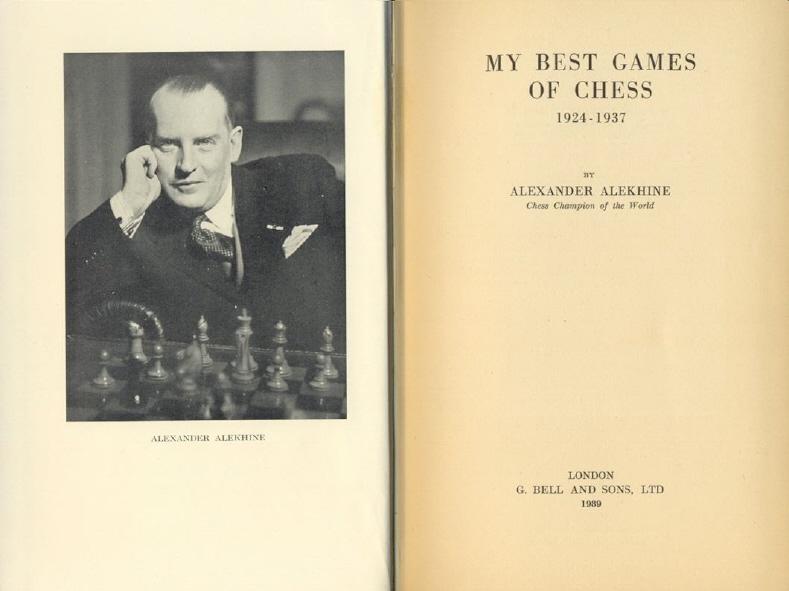
The only acknowledgment (deleted later on) for another party’s involvement in the book was on the imprint page:
‘The Author is indebted to Mr E.R. Cordingley for his valuable assistance in reading the proofs.’
In 1947, the year after Alekhine’s death, this second volume of Best Games was re-issued with a memoir by Julius du Mont (which made no reference to any translation involvement by himself). However, the obituary of du Mont by D.J. Morgan on pages 119-120 of the May 1956 BCM stated that du Mont had translated ‘Alekhine’s two volumes of My Best Games of Chess (the first with M.E. Goldstein)’.
That is certainly the common view, but is the reference to the second volume correct? It may be relevant to note a letter contributed by du Mont on page 173 of the May 1946 CHESS:
‘There is one aspect of Dr Alekhine’s character which may come as a surprise to chessplayers generally, for in that respect he has not been very advertised, that of kindliness and readiness to help.
In 1938 I happened to meet Dr Alekhine and his wife in the Strand Palace Hotel [in London] and he asked me to sit at their table. I had not met him or corresponded with him for some years, not since I translated his first book for a very substantial fee. I was neither wealthy nor influential, nor was I the editor of a chess publication. I was carrying in my hand the proofs of my Basis of Combination in Chess. Dr Alekhine asked me what it was and I said it would not interest him, but he insisted that everything interested him and he took a very long time glancing through the proofs. In the end he said: “I like the idea very much. Would you like me to read the proofs for you and to check the analysis?” I was dumbfounded and suitably expressed by appreciation. Some ten days later the proofs came back corrected, and in two places some valuable additions were made to the analysis. A charming little note accompanied the package with encouraging words of appreciation and enclosing another letter which Dr Alekhine said I could use in any way I wished, and which the publisher did in fact use on the blurb of the book when it came out.
As a contrast I may say that the first man I met who had read Dr Alekhine’s comments on the blurb asked me, “What did that cost you?” I avoided being ungentle by not answering.’
Alekhine was in London in January 1938 (C.N. 3817 discussed his game that month against Elaine Saunders), but du Mont’s account makes no mention of any arrangement to translate Alekhine’s second volume of Best Games (which was published on 18 October 1939, as reported on the inside front cover of CHESS, November 1939). Are there thus grounds for believing that du Mont was not the translator (in which case, who was?), or did du Mont provide confirmation elsewhere that he did indeed translate it? In either case, why was no translator named in the book?
A further consideration about du Mont is that in the late 1930s he was preparing, jointly with Tartakower, the 665-page book 500 Master Games of Chess. Although it was not published until 1952, the manuscript was delivered in 1939 (see the BCM, April 1952, page 105 and May 1952, page 133). It would be exceptional if, in 1938-39, du Mont were able to work concurrently on both that huge project and a translation of the Alekhine book, quite apart from finalizing in 1938 The Basis of Combination in Chess.
Deux cents parties d’échecs was published in Rouen in 1936 (in a single volume) by the French Chess Federation, which stated in an introductory note that Alekhine had generously provided the material:
‘Un geste généreux du grand Champion A. Alekhine nous a permis d’enrichir la littérature échiquéenne française d’un document inestimable, d’un choix unique de chefs-d’oeuvre.’
Pages xvii-xxiv carried a Preface by Alekhine dated September 1936, but we see no relevant information about the genesis of the collection, which was the first appearance of Alekhine’s best games in French.
The book was reprinted in two volumes by the BCM in 1973 and 1979 respectively and was re-issued by Bernard Grasset, Paris, also in two volumes, in 1999 and 2000. Broadly speaking, the first volume corresponds to My Best Games of Chess 1908-1923 and the second to Alekhine’s 1932 book Auf dem Wege zur Weltmeisterschaft. As far as we know, Alekhine’s second volume of Best Games has never, to this day, appeared in French.
C.J. Feather’s English translation of Auf dem Wege zur Weltmeisterschaft was published by Pergamon Press in 1984 under the title On the Road to the World Championship 1923-1927.
The above jottings are not, alas, direct answers to our correspondent’s questions about the manuscripts of Alekhine’s books, as we are still at the stage of laying the groundwork. Readers are invited to help us pursue the matter, and not least on the basis of the works’ contents. Do comparisons between various editions yield any clues?
(4436)
Our feature article on Elaine Saunders includes the following:
‘She is a genius.’ That was Alekhine’s observation on the 12-year-old Elaine Saunders after playing her in a simultaneous exhibition in London on 22 January 1938. From page 190 of CHESS, 14 February 1938:
‘Dr Alekhine was televised by the British Broadcasting Corporation in January, “lookers-in” seeing him make, once again, the move which regained for him the world’s championship.
On 22 January he played simultaneously against 30 of Kent’s strongest players and after four and a half hours had won all but three ... Twelve-year-old Elaine Saunders, British girl champion, covered herself with glory by holding out to the very end, succumbing in a rook-and-pawn endgame in the very last game to finish. Dr Alekhine, speaking afterwards, said, “She is a genius”.
... [Elaine Saunders] became famous overnight – as far as the general public was concerned – as a result of her fine show against Alekhine. Pictures of her with eye to a telescope, boxing a punchball, walloping her father blindfold, etc. were published in many of the daily papers.’
A photograph (featuring Alekhine in play against R.C. Noel-Johnson, Elaine Saunders, C. Chapman, H.H. Cole, H. Israel and W.J.E. Yeeles) of the display at the Charing Cross Hotel, London was published on page 115 of the March 1938 BCM:

We have never seen the moves of her game against Alekhine.
(3817)
Elaine Saunders gave an account of her game against Alekhine on page 224 of British Chess by G.S. Botterill, D.N.L. Levy, J.M. Rice and M.J. Richardson (Oxford, 1983):
‘The incident which received the most publicity was the “affair Alekhine”. Most of the pre-war giants were kindly if a little condescending towards me but the new world champion – he had just regained the title from Euwe – showed me no mercy. He took on 30 Kent players at the Charing Cross Hotel and after five hours demolished all except myself. [In fact, Alekhine’s final score was +27 –2 =1.] The ending was equal. He stood over our board and glowered. “Give the child a draw”, said someone in Russian in the audience, which despite the midnight hour were everywhere on chairs and even under tables. “I know what I am doing”, came the reply, and of course he did. I lost.’
(3826)
C.N. 3817 mentioned that we had never seen the moves of Elaine Saunders’ game against Alekhine. Maurice Carter (Fairborn, OH, USA) informs us that in a letter to him dated 19 February 1993 David Pritchard (later Elaine Saunders’ husband) was able to provide part of the game-score:
Alexander Alexandrovich Alekhine – Elaine Saunders
London, 22 January 1938
Sicilian Defence
1 e4 c5 2 Nf3 Nc6 3 d4 cxd4 4 Nxd4 d6 5 c4 Nf6 6 Nc3 g6
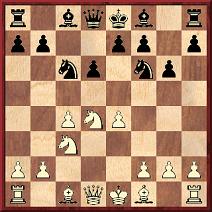
7 c5 dxc5 8 Nxc6 Qxd1+ 9 Nxd1 bxc6 10 f3 Bg7 11 Be3 Nd7 12 Rc1 Rb8 13 b3 O-O 14 Nf2 Bb7 15 Nd3 Bd4 16 Kf2 f5 17 exf5 Rxf5 18 Be2 Rbf8 19 Rhd1 Rd5 20 b4 cxb4 21 Nxb4 Bxe3+ 22 Kxe3 Re5+ 23 Kf2 Nc5 24 Nd3 Nxd3+ 25 Bxd3 Ra5 26 Bc4+ Kh8 27 Rd7 Bc8 28 Rxe7 Rc5 (David Pritchard: ‘Elaine’s score then became corrupt. The end position (in which Elaine resigned – this was published) was ...
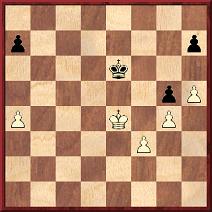
... after move 73 with (presumably) Elaine to move – she doesn’t remember.’)
(3874)
A group photograph from page 173 of Deutsche Schachblätter, 1 June 1936:
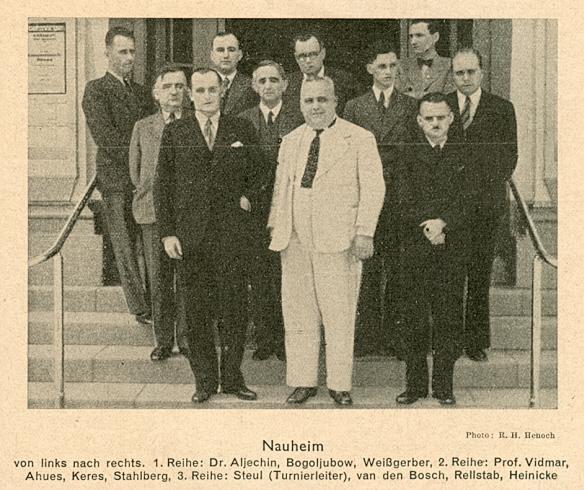
(5244)
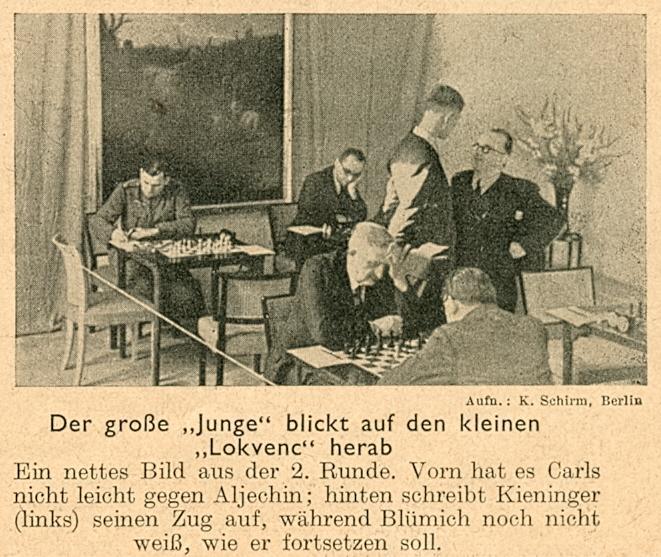
This photograph comes from page 167 of the 1 November 1941 Deutsche Schachblätter. Taken in Cracow on 7 October 1941, it shows G. Kieninger and M. Blümich in the background, K. Junge in conversation with J. Lokvenc and, in the foreground, C. Carls and A. Alekhine.
(5259)
Dominique Thimognier submits pages 20-21 of the Bulletin de la Fédération Française des Echecs, 15 April 1929:
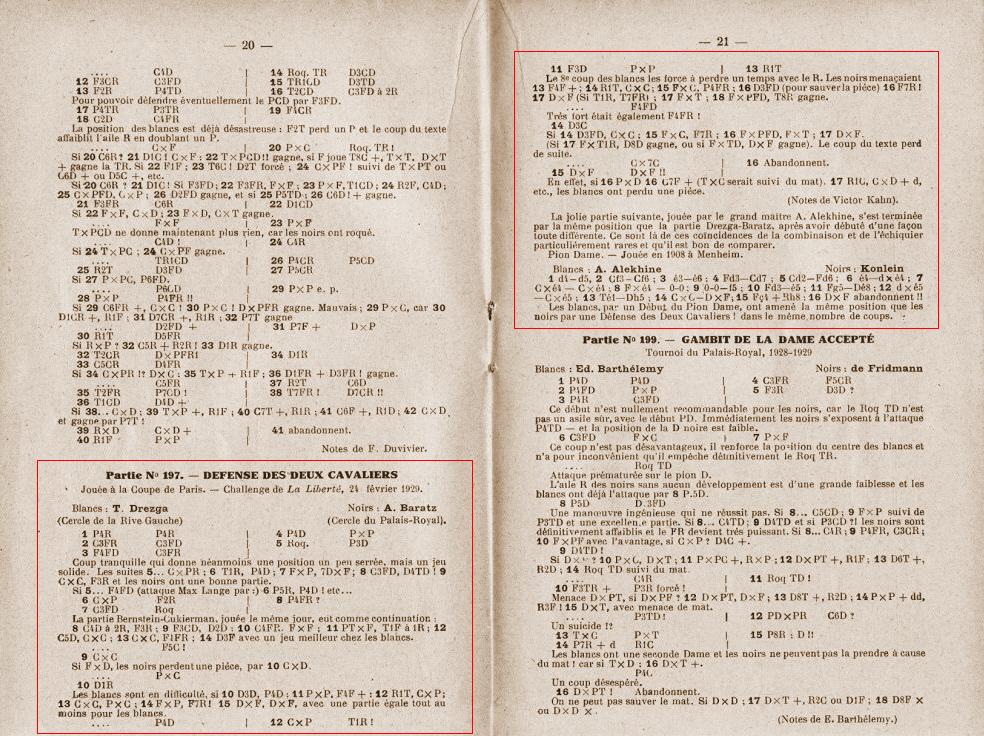
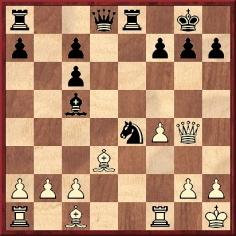
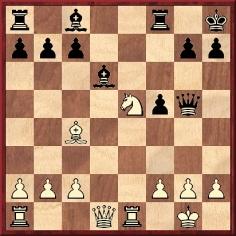
Left: Baratz (in 1929) played 15...Qxd3. Right: Alekhine (in 1908) played 16 Qxd6.
It will be noted that as the venue of the Alekhine game the Bulletin gave ‘Menheim’, which is a Bjelica-style misspelling for Düsseldorf.
We add a few further remarks. The Bulletin provided a precise date for the Drezga v Baratz game, 24 February 1929, and on pages 114-115 of the March 1929 L’Echiquier it was indicated that after Baratz’s victory the coincidence was pointed out by Alekhine.
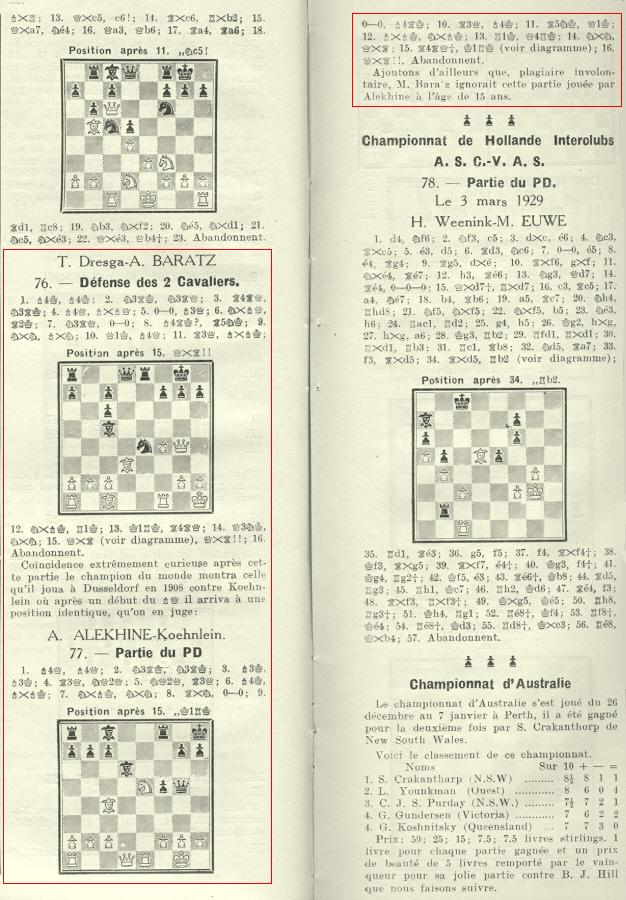
The two games are often discussed jointly (see, for instance, 666 Kurzpartien by Kurt Richter and 1000 Best Short Games of Chess by Irving Chernev). We should welcome examples of similar coincidences.
Alekhine’s victory came in round four of the Hauptturnier A in Düsseldorf on 6 August 1908 and was given on pages 137-138 of the tournament book and on pages 11-12 of the January 1909 Deutsche Schachzeitung. Alekhine was aged 15 at the time of the game. After 16 Qxd6 the anti-climactic finish (not included in the above French-language magazines) was 16...Qxg2+ 17 Kxg2 Resigns. For Köhnlein (1879-1916) it was the only loss in the 14-man event, which he won. He was also known as a composer, and a collection of his best productions in both fields is Friedrich Köhnlein Schachmeister und Problemkomponist by Walter Fentze (Nuremberg, 1984).
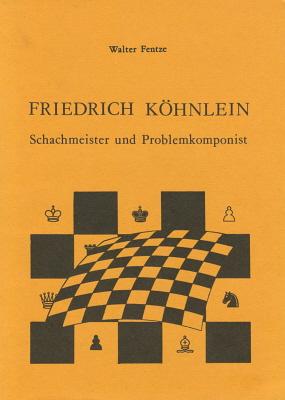
Our collection includes a bound volume of the Deutsches Wochenschach, 1904 inscribed by Köhnlein:
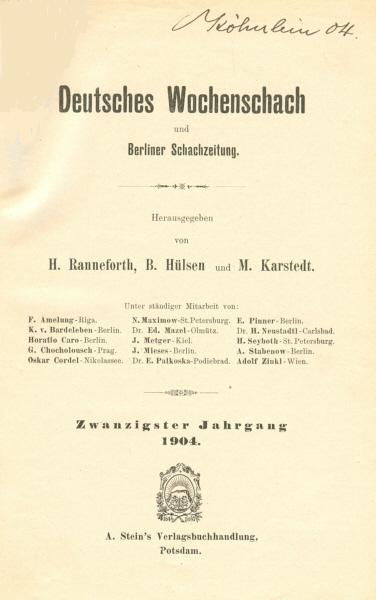
A label explains the volume’s provenance:
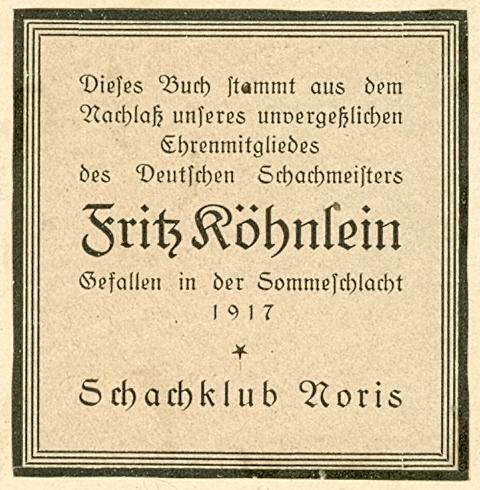
(5327)
Charles Sullivan (Davis, CA, USA) refers to two positions from games in Alexander Alekhine’s Chess Games, 1902-1946 by Leonard M. Skinner and Robert G.P. Verhoeven (Jefferson, 1998):
a) Alekhine v Turover, Bradley Beach, 3 June 1929 (pages 359-360):
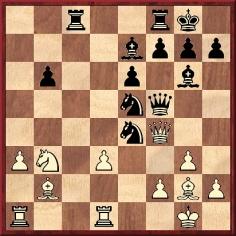
Play is said to have continued 21 Qxe5 Qxe5, and our correspondent asks if both players overlooked 21...Qxf2+, which wins for Black.
The book gave two sources for this game: the Brooklyn Daily Eagle, 13 June 1929, page 32, and the American Chess Bulletin, July-August 1929, pages 130-131. We do not have the newspaper, but according to the game-score in the Bulletin Black’s queen stood at h5, not f5 (18...Qa5-h5).
b) Sämisch v Alekhine, Prague, 15 December 1942 (page 696):
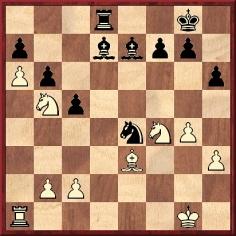
The continuation is given in the book as 26 Nxa7 Bg5, and Mr Sullivan asks if both players really missed 26...Ra8, which wins the knight.
Here, the source specified by Skinner and Verhoeven was page 51 of the Lachaga booklet Prag, 1942 (Martínez, 1973). We have checked the score in another book (also listed in the bibliography, on page 790): Durasův turnaj – Praha 1942 by Karel Prucha (Prague, 1943). It too had the same sequence (1 e4 e5 2 Nf3 d6 3 d4 Nd7 4 Bc4 c6 5 a4 h6 6 Nc3 Be7 7 O-O Ngf6 8 Qe2 Qc7 9 Rd1 Nf8 10 dxe5 dxe5 11 Ne1 Ne6 12 Bxe6 Bxe6 13 Nd3 O-O 14 Be3 b6 15 h3 c5 16 f4 exf4 17 Nxf4 Qe5 18 Nd3 Qh5 19 Qxh5 Nxh5 20 g4 Nf6 21 Nf4 Rad8 22 Rxd8 Rxd8 23 a5 Bc8 24 Nb5 Nxe4 25 a6 Bd7 26 Nxa7 Bg5). Before concluding that there was indeed a double blunder by Sämisch and Alekhine, we should like to know what moves were given in any other publications of the time. The game (drawn at move 41) is absent from the various Czech and German sources currently available to us.
(5333)
From Leonard Skinner (Cowbridge, Wales):
‘I have looked again at my print of the Brooklyn Daily Eagle, and it seems that I misread Black’s 18th move. It should be 18...Q-R4 (Qh5). Because of the state of the microfilm in the Library of Congress my print was not as good as one might want, so I originally took the move to be 18...Q-B4, i.e. Qf5.’
(5337)
The question has been taken up by Peter Anderberg in an article ‘Der junge Sämisch’ on pages 52-73 of the April-June 2010 issue of Kaissiber. He reports that Sämisch gave the game in the chess column of the Berliner Lokal-Anzeiger, 16 January 1943 and that after 22 Rxd8 ...
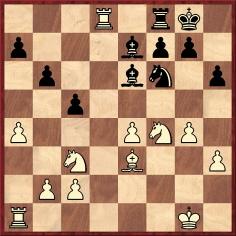
... the reply was 22...Bxd8, and not 22...Rxd8. Thus in the Berliner Lokal-Anzeiger version of the score (1 e4 e5 2 Nf3 d6 3 d4 Nd7 4 Bc4 c6 5 a4 h6 6 Nc3 Be7 7 O-O Ngf6 8 Qe2 Qc7 9 Rd1 Nf8 10 dxe5 dxe5 11 Ne1 Ne6 12 Bxe6 Bxe6 13 Nd3 O-O 14 Be3 b6 15 h3 c5 16 f4 exf4 17 Nxf4 Qe5 18 Nd3 Qh5 19 Qxh5 Nxh5 20 g4 Nf6 21 Nf4 Rad8 22 Rxd8 Bxd8 23 a5 Bc8 24 Nb5 Nxe4 25 a6 Bd7 26 Nxa7 Bg5 27 c4 Ra8 28 Nb5 Bxb5 29 cxb5 Nd6 30 Nd5 Bxe3+ 31 Nxe3 Nxb5 32 Nd5 Ra7 33 Ra4 f6 34 Nxb6 Nc7 35 Nd7 Rxa6 36 Nxc5 Rc6 37 Ra5 Rb6 38 b3 Rd6 39 Ra7 Rc6 40 Ra5 Rd6 41 Ra7 Drawn) no opportunity to win the white knight with ...Ra8 arose at move 26. The article in Kaissiber includes Sämisch’s annotations to the game (see pages 72-73).
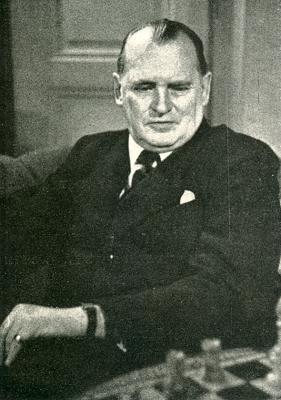
Alexander Alekhine (Prague, 1942 tournament book by Karel Prucha)
(6553)
C.N.s 3232 and 3265 (see page 334 of Chess Facts and Fables) referred to the classicist Gilbert Highet (1906-78), who coined the phrase ‘the small, flat world of the chessboard’. It is still proving impossible to trace the first publication of the article in question, whose copyright was ascribed to the Oxford University Press (1957) when the piece was reproduced on pages 18-22 of The Joys of Chess by Fred Reinfeld (New York, 1961). Page 13 mentioned that the article, entitled ‘Chess Men’, was originally a radio talk.
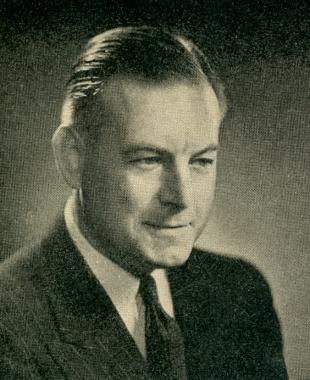
Gilbert Highet
Another reference to chess occurred on page 92 of Professor Highet’s book Man’s Unconquerable Mind (New York, 1954):
‘After Stalin had won his struggle for power against Trotsky, Trotsky’s work in building up the Red army was expunged from Communist history books and is now virtually forgotten inside the USSR. Such distortions are extended to quite small details. Thus, the most distinguished of modern chess masters was a Russian, Alekhine; since he repudiated the Bolshevik revolution, his name is not mentioned in Russian histories of chess.’
On page 134 Highet intimated that he had only a secondary source for that chess information: page 12 of British Chess by Kenneth Matthews (London, 1948). The matter seems to us far more complex. For example, page 34 of Soviet Chess by D.J. Richards (Oxford, 1965) noted that Russian editions of Alekhine’s games collections were published (e.g. in 1927 and 1932).
Do readers know of any extensive, authoritative overview of how Russian chess literature treated Alekhine after his departure from the Soviet Union?
(5336)
Page 14 of Chess World, 1 January 1947 quoted from an article by Botvinnik in Ogonyok which was subsequently published in Albrecht Buschke’s periodical Chess News from Russia. An extract is given below:
‘During the Nottingham tournament of 1936 I happened to watch a curious scene. Bogoljubow was sitting deeply bent over the board, and was thinking tensely. Alekhine was briskly wandering around the table, fixedly looking at his opponent. Willy-nilly, I became interested, drew near to the table and saw the position after Alekhine had made his 35th move P-N5 [g5].
What can Black do? He has an extra pawn, but the situation is tense and the material superiority does not tell. White threatens 36 PxP, after which his bishop would be very strong.
Bogoljubow played 35...PxP. He had not taken the pawn off the board when Alekhine hurriedly approached and, without sitting down, played 36 P-B5!!, noisily banging down the piece. This sacrifice was so unexpected that Bogoljubow literally jumped out of his chair, in spite of his solid constitution. Evidently he had figured only on 36 PxPch K-N1; and in view of the threat, ...P-K4, Black’s situation would be quite secure.’
Alekhine’s annotations to the game can be found in the Nottingham, 1936 tournament book and in his second volume of Best Games.
(5348)
Charles Sullivan raises the subject of Alekhine v Nowarra, Cracow, 17 October 1941, as given on page 670 of Alexander Alekhine’s Chess Games, 1902-1946 by Leonard M. Skinner and Robert G.P. Verhoeven (Jefferson, 1998).
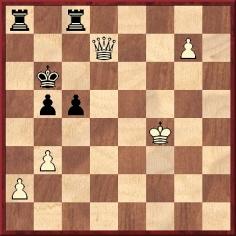
Our correspondent asks whether, after 52 Qe6+ Rc6, Alekhine really overlooked 53 g8(Q), which wins at once.
The book’s source was pages 172-173 of the November 1941 Deutsche Schachzeitung:
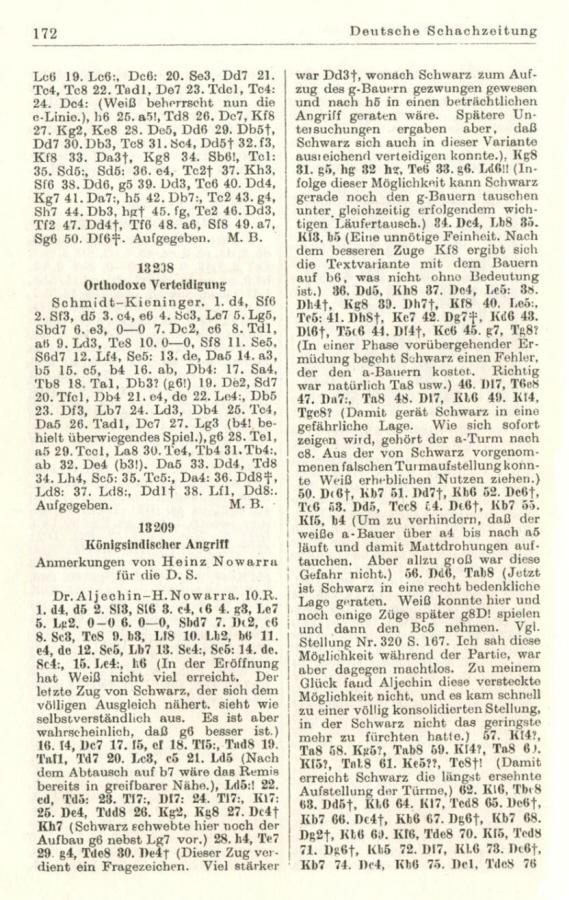

It will be seen that Heinz Nowarra provided notes, and that the game-score corresponds to what appeared in the Skinner/Verhoeven book. However, a correction to the score was published on page 181 of the December 1941 magazine, where ‘M.B.’ (Max Blümich) indicated that White’s 52nd move was Qd6+, not Qe6+:

We have few biographical details on hand concerning Heinz Nowarra. A small photograph of him was given on page 158 of the December 1942 Deutsche Schachzeitung, with the information that he was born in 1897.
(5354)
From Yasser Seirawan (Amsterdam):
‘I am currently writing a romance/adventure novel which features a chess theme. It was originally written in 1980 and 1981, but a baggage mishap during a flight to Berlin caused me to lose my only (handwritten) copy. Laptops did not exist in those days. Now, half a lifetime later, I have revived the project. How many grandmasters have written a novel?’
Two works come to mind: Belye i chernye by A. Kotov (Moscow, 1965) and Los Voraces 2019 by A. Soltis (Jefferson, 2004). Regarding the former, which concerned Alekhine’s life, see C.N. 4073 for information about the ensuing film. The dust-jacket of the Czech translation of the novel (Prague, 1971) is reproduced below:
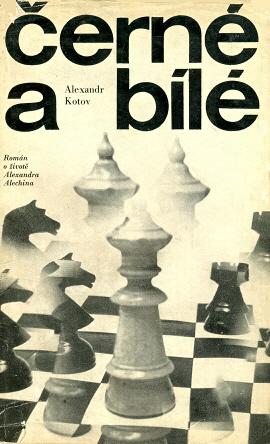
(5366)
C.N. 593 quoted from page 80 of Lessons from My Games by Reuben Fine (New York, 1958):
‘Both Alekhine and Capa were anxious to see Euwe do badly. I was rather amused when a most critical situation arose in my game with Euwe and both the ex-world champions whispered suggestions in my ear.’
Fine reiterated that claim about the game (a 19-move draw) on page 33 of his book Bobby Fischer’s Conquest of the World’s Chess Championship (New York, 1973):
‘... at the Nottingham tournament in 1936, when I was playing Euwe, then world champion after his defeat of Alekhine in 1935, both Alekhine and Capablanca spontaneously came up to me during the game to suggest moves, even though I had not asked them to do so.’
(5394)
Charles Sullivan asks about the last-round game Alekhine v Salwe, Hamburg, 6 August 1910, which is given as follows on pages 51-52 of Alexander Alekhine’s Chess Games, 1902-1946 by Leonard M. Skinner and Robert G.P. Verhoeven (Jefferson, 1998):
1 d4 d5 2 Nf3 Nf6 3 c4 e6 4 Bg5 Be7 5 e3 b6 6 Nc3 Bb7 7 cxd5 Nxd5 8 Bxe7 Qxe7 9 Bb5+ c6 10 Bd3 Nd7 11 O-O O-O 12 Rc1 Rfc8 13 Qd2 c5 14 Nxd5 Bxd5 15 e4 Bb7 16 Qe2 cxd4 17 Nxd4
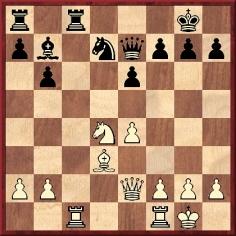
17...Ne5 18 Rfd1 g6 19 f3 Kh8 20 Kh1 Kg8 21 Kg1 Kh8 22 Kh1 Kg8 Drawn.
Mr Sullivan comments:
‘If the game-score is correct, the last five moves by Alekhine (starting with 18 Rfd1) are blunders which would lose a piece to, for example, 18...Rxc1 19 Rxc1 Rd8. Can you shed any light on this?’
The Skinner/Verhoeven volume reproduced the game, faithfully, from pages 147-148 of the Hamburg, 1910 tournament book, but we wonder whether Black’s 17th move was 17...Nc5 rather than 17...Ne5, as the remainder of the game would then make more sense. 17...Nc5 was, in fact, the move given on page 122 of Alexander Alekhine I Games 1902-1922 (Sofia, 2002), but we have yet to find this short draw in any contemporary source other than the tournament book.
(5429)
From page 23 of the January 1952 Chess Review:
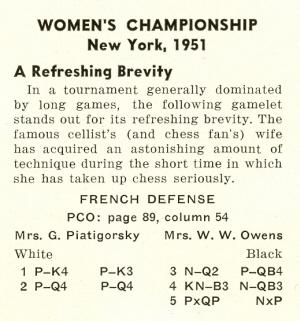
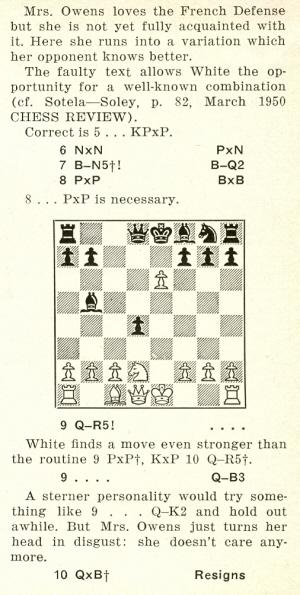
In reality, the play as far as 9 Qh5 had already been seen, with a transposition of moves, in a game won by Alekhine against Sánchez in Bogotá in March 1939. It was published on page 35 of the March-April 1939 American Chess Bulletin and, with notes by Tartakower, on pages 410-412 of the September 1939 BCM. Alekhine mentioned the opening on page 128 of his book Gran Ajedrez (Madrid, 1947); see also page 64 of 107 Great Chess Battles (Oxford, 1980).
The encounter was described by Alekhine as ‘una partida de exhibición contra el campeón de Bolivia, Sánchez, en Bogotá, marzo de 1939’. There is no reason why a Bolivian should not play a game in Colombia, but verification of Sánchez’s identity is sought. The above-mentioned item in the American Chess Bulletin described him as the ‘winner of the 1938 “Olympic” tournament at Bogotá’.
(5436)
From Christian Sánchez:
‘According to the Colombian master Luis Augusto Sánchez, in a text quoted in a review of the book Jaque al olvido by Boris de Greiff, he was defeated by Alekhine in 1939: “[Alekhine], que me derrotó en las simultáneas del año 39 ...”
A question that arises is whether Luis Sánchez was “the Bolivian champion” or “the Bolivarian champion”. Support for the latter version is to be found at the Ajedrez en Colombia website, with this reference: “del campeón bolivariano Luis Augusto Sánchez”. The adjective “bolivariano” refers to the Colombian region Bolivar, and not to the country Bolivia. However, it is hard to know whether, assuming that there was confusion between Bolivarian and Bolivian, it was created by Alekhine or by somebody involved in his (posthumous) book Gran Ajedrez.’
We do not have a copy of Jaque al olvido and shall be grateful to any reader who can help us to acquire one.
(5400)
Christian Sánchez writes:
‘Luis Augusto Sánchez Montenegro was born in Neiva (Colombia) on 20 July 1917 (El Tiempo, 22 February 1969, page 18) and died on 20 April 1982 (El Tiempo, 22 April 1982, page4-A). He won the chess championship in the first Bolivarian Games, which took place in Bogotá (Colombia) on 10-20 August 1938 (El Tiempo, 21 August 1938, page 9).
The Bolivarian Games are a sports event, similar to the Olympic Games, in which countries liberated by Simón Bolívar can participate (Bolivia, Colombia, Ecuador, Panama, Peru and Venezuela).
Alekhine played Sánchez on 21 March 1939 in a simultaneous exhibition in Bogotá (El Tiempo, 22 March 1939, page 1). The game lasted 28 moves, and not 25 as the known score indicates.
Thus Alekhine won against the Bolivarian champion (“campeón bolivariano”), i.e. the champion of the Bolivarian Games, and not the “Bolivian” champion (“campeón de Bolivia”) as stated in his posthumous book Gran Ajedrez.’
(9908)
Further to the discussion on Pal Benko and ...b5 (see C.N.s 3957 and 3967), Gerd Entrup (Herne, Germany) raises the wider question of the earliest occurrence in play of the general ideas behind the Benko Gambit (not necessarily in the first few moves). He proposes Marshall v Réti, New York, 1924, which was annotated on pages 37-40 of Alekhine’s book Das Grossmeister-Turnier New York 1924 (Berlin and Leipzig, 1925) and on pages 18-20 of the English translation.
The game began 1 d4 Nf6 2 Nf3 g6 3 c4 Bg7 4 Nc3 O-O 5 e4 d6 6 Bd3 Bg4 7 h3 Bxf3 8 Qxf3 Nfd7 9 Be3 c5 10 d5 Ne5 11 Qe2 Nxd3+ 12 Qxd3 Nd7 13 O-O Qa5 14 Bd2 a6 15 Nd1 Qc7 16 Bc3
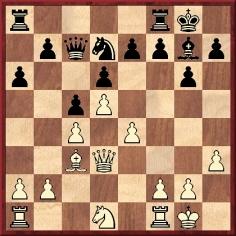
Réti played 16...Ne5, and Alekhine wrote: ‘Bereitet das folgende allzu kühne Bauernopfer vor – im Bestreben, gewaltsam remis zu vermeiden.’ [‘Preparing for the subsequent over-daring sacrifice of the pawn with the intention of avoiding a forced draw.’]
After 17 Qe2 b5 Alekhine commented:
‘Diesen Bauern konnte Weiß ruhig nehmen, da Schwarz Schwierigkeit gehabt hätte, dafür positionellen Ersatz zu erlangen, z.B. 18 c4-b5: a6-b5: 19 De2-b5:! c5-c4 (offenbar die beabsichtigte Pointe des Bauernopfers) 20 Lc3-e5: Lg7-e5: (oder 20...Tf8-b8 21 Db5-c6 Dc7-c6: 22 d5-c6: Lg7-e5: 23 Ta1-c1 Le5-b2: 24 Tc1-c4: mit Vorteil, da Schwarz den a-Bauern wegen 25 Tc4-c2 usw. nicht nehmen darf) 21 Sd1-e3 c4-c3 22 b2-c3: Dc7-c3: 23 Ta1-c1 und Weiß hätte zum mindesten ein sehr leichtes Remis gehabt. Nach der Ablehnung des Opfers wird er dagegen erst hart kämpfen müssen, um es zu erreichen.’ [‘White could safely have captured this pawn, as Black would have difficulty in obtaining positional compensation, for instance: 18 PxP PxP 19 QxP P-B5 (clearly the reason for the pawn sacrifice) 20 BxKt BxB (or 20...KR-Kt 21 Q-B6 QxQ 22 PxQ BxB 23 QR-B BxP 24 RxP with advantage, as Black dare not capture the QR pawn, on account of 25 R-B2) 21 Kt-K3 P-B6 22 PxP QxP 23 QR-B, and White would have had at least a very easy draw. After the refusal of the sacrifice, on the other hand, he can now reach that goal only after hard fighting.’]
The game continued 18 cxb5 axb5 19 f4 Nc4 20 Bxg7 Kxg7 and was drawn at move 50.
(5457)
Tim Bogan (Chicago, IL, USA) comments that if ‘general ideas’ is taken to mean that Black sacrifices a queen’s-side pawn for pressure on the opened files, the game Nimzowitsch v Capablanca, St Petersburg, 1914 may be regarded as an early model.
We add that Alekhine made a similar point about that game (describing it as ‘sensational’) in his notes to van Scheltinga v Opocenský, Buenos Aires, 1939. See pages 165-167 of Gran Ajedrez (Madrid, 1947) and pages 200-202 of 107 Great Chess Battles (Oxford, 1980).
(5461)
Charles Sullivan refers to Tarrasch v Alekhine, Hastings, 18 September 1922. Alekhine annotated the game on pages 45-47 of his tournament book (published in London in 1924); in the Dover reprint (New York, 1968) the page numbers are 41-43. See also pages 172-173 of the Skinner/Verhoeven volume on Alekhine.
Our correspondent asks whether the game-score in these sources is faulty, given that Alekhine would have been unlikely to miss the opportunity in the position below (after 34 Bxh1) to win the white bishop with 34...d4.
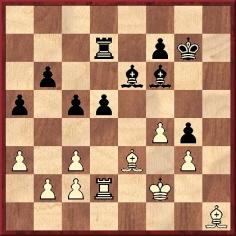
We suspect (but cannot prove) that there is indeed an error in the game-score. When moves 1-37 were published on pages 36-37 of the November 1922 Chess Amateur Black’s 32nd move was given as ...Re8 and not ...Rd7. In that case, the position after 33 Rh1 Rxh1 34 Bxh1 would not give the possibility of winning the bishop. An alternative explanation is that at move 32 Alekhine played ...Rd6. That is the move given on page 378 of Alexander Alekhine I Games 1902-1922 (Sofia, 2002).
(5495)
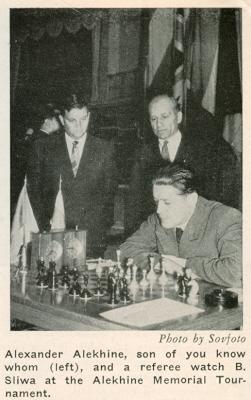
Source: Chess Review, January 1957, page 6.
(5497)
Page 229 of Kings, Commoners and Knaves referred to Alekhine’s alleged description of a dream in which chess masters were banned from Heaven but Bogoljubow gained entry because ‘he only thinks he’s a master’. See, for instance, pages 21-22 of The Bright Side of Chess by Irving Chernev (Philadelphia, 1948). We pointed out that the same yarn had appeared on page 6 of the July 1898 American Chess Magazine, and that item is reproduced below:
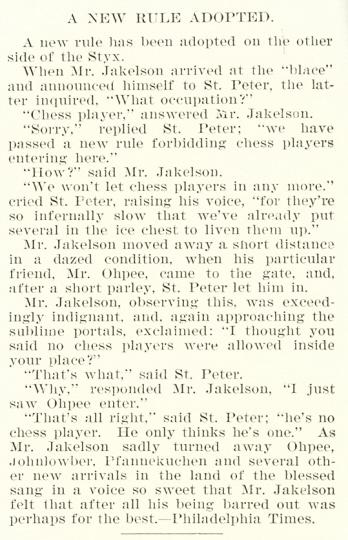
When were Alekhine and Bogoljubow introduced into the story?
(5600)
An avoid-at-all-costs book is Chess Stories Through the Ages by Donald L. Boone (Lexington, 2010). For a sample snippet we cull from page 34 this ‘once’ anecdote concerning ‘Alehkine’ and ‘Bofolubov’:
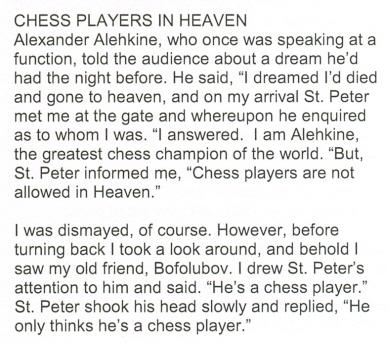
Noting that the story had appeared on page 6 of the July 1898 American Chess Magazine, C.N. 5600 asked when Alekhine and Bogoljubow were introduced into it. The earliest instance we can offer now is in an article ‘Humour and Chess’ by J. du Mont on page 133 of the May 1941 BCM:
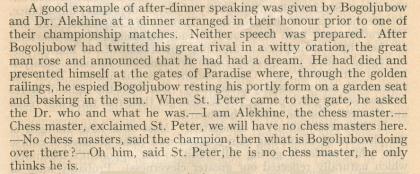
6813)
A ‘once’ yarn from a column by Al Horowitz on page 8 of the September 1948 Chess Review:
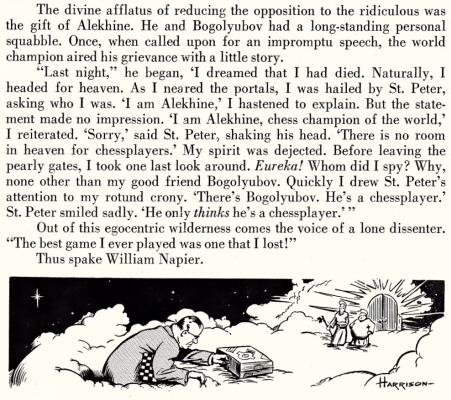
Horowitz also considered that the story, worded differently, merited a full page (page 134) in his book The New York Times Guide to Good Chess (New York, 1969).
(8672)
From page 114 of CHESS, 14 December 1937 is relevant to our items ‘Two moves in succession’ (C.N.s 3202 and 5181) and ‘Heaven’ (C.N.s 5600, 6813 and 8672):

(9432)
Two pairs of self-contradictions from Reuben Fine, as given in C.N. 1424:
On page 37 of the November 1953 CHESS Irving Chernev pointed out these statements by Fine:
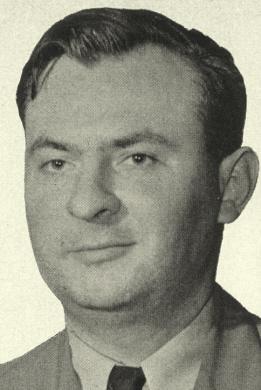
Reuben Fine
The other example was shown by us on page 10 of CHESS, October 1976:
(5597)
We add here some further remarks of Fine’s, in a comparison between Alekhine and Keres on pages 142-143 of his book Chess Marches On! (New York, 1945):
‘Despite the many points of similarity there are a number of important respects in which they differ. Chief among these are Alekhine’s superior grasp of psychological factors and his all-consuming ambition ...
Reliance on psychology has been both an asset and a handicap for Alekhine. The legitimate use of psychology in master play is to maneuver the opponent into positions where he feels ill at ease, which do not “lie right” for him, as the German puts it. Alekhine has been able to apply this principle with consummate skill on a number of occasions – the match with Capablanca is the most notable. At other times, however, chiefly when he was at the height of his fame, around 1932-1934, Alekhine has exaggerated the human factor out of all proportion. In one French tournament he even went so far as to make a serious attempt to win by hypnosis.’
What exactly happened at that ‘one French tournament’?
Another question concerns the extent to which Fine applied (or claimed to apply) ‘psychological factors’ in his own games. That matter is raised tentatively, however, since few topics lend themselves so readily to waffle as does ‘chess psychology’.
(5616)
Our feature article about Reuben Fine also quotes the following:
Fine on Alekhine:
‘When I first met him, at Pasadena in 1932 ...’
Source: The World’s a Chessboard by R. Fine (Philadelphia, 1948), page 165.
‘When I first met Alekhine in New York in 1932 ...’
Source: Bobby Fischer’s Conquest of the World’s Chess Championship by R. Fine (New York, 1973), page 9.
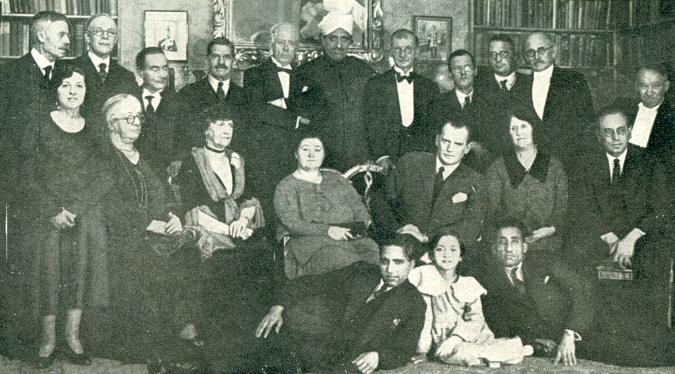
Centre background: Colonel Nawab
Sir Umar Hayat Khan
Back row (left to right): C.D. Locock, R.H.S. Stevenson, P.W.
Sergeant, C. Wreford Brown, Sir Ernest Graham-Little, M.P., R.C.
Griffith, F.D. Yates, J. du Mont, A. Rutherford, J.B. Whieldon
Next row: Miss Joseph, Mrs Latham, Mrs Arthur Rawson, V.
Menchik, A. Alekhine, Mrs Stevenson, J.A. Seitz.
Foreground: S. Basalvi, Aziz, Mir Sultan Khan.
The photograph came from the February 1932 BCM, and the magazine’s key has been given. Page 71 explained the occasion:
‘Colonel Sir Umar Hayat Khan arranged one or two receptions at his residence in honour of Dr Alekhine, the champion of the world. On each evening a dinner followed, characterized by all Sir Umar’s well-known hospitality. On 15 December after full justice had been done to the repast, speeches were made by Sir Ernest Graham-Little, MP, J. Whieldon, C. Wreford Brown and R.C. Griffith; Miss Vera Menchik and Dr Alekhine himself responded to the good wishes and thanks accorded them by the company.
The group photo we give as frontispiece was taken by Malik Ghulam Mohammed Khan, one of the most trusty of Sir Umar’s entourage and a warrior of great distinction. The small photo hanging on the wall to the right of the mirror (behind R.C. Griffith and F.D. Yates) shows Sir Umar in his official robes as Herald of the Princes at the great Durbar.’
(5602)
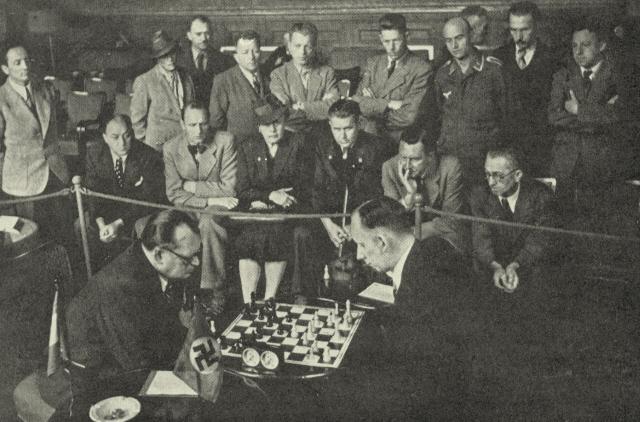
A. Alekhine v K. Richter, Munich, 1941. Source: page 71 of Alt om Skak by B. Nielsen (Odense, 1943)
(5648)
From the plates section of the book on the 1931 Olympiad:
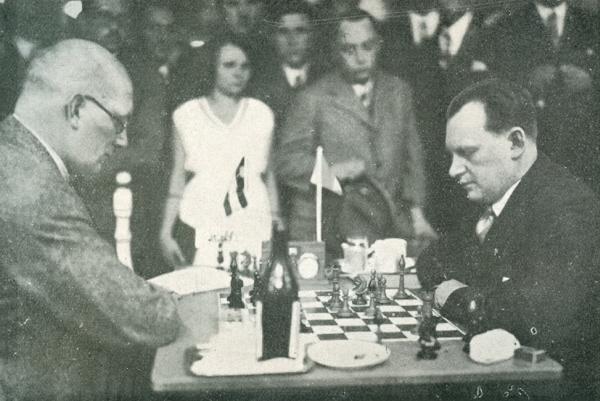
Ernst Grünfeld and Alexander Alekhine (Prague, 1931)
(5676)
Alexander Nikolaevich Zamega (Naberezhnye Chelny, Russia) comments on the apparent invisibility of the black queen, even allowing for the unusual chess set (e.g. the white king on g1).
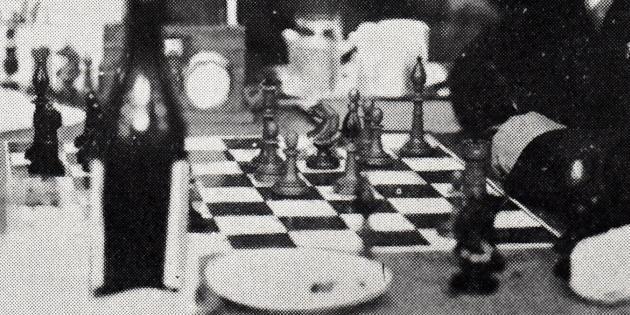
The game as it appeared on pages 12-13 of the Czech tournament book (which gave Kostić’s notes, translated from pages 180-182 of the July-August 1931 issue of Kagans Neueste Schachnachrichten): 1 d4 d5 2 Nf3 Nf6 3 c4 e6 4 Nc3 c5 5 cxd5 Nxd5 6 e4 Nxc3 7 bxc3 cxd4 8 cxd4 Bb4+ 9 Bd2 Bxd2+ 10 Qxd2 O-O 11 Be2 Nd7 12 O-O b6 13 Rac1 Bb7 14 Qf4 Nf6 15 Bd3 Rc8 16 Rxc8 Bxc8 17 Rc1 Bb7 18 h3 Re8 19 e5 Nh5 20 Qg4 Bxf3 21 Qxf3 g6 22 g4 Ng7 23 Bb5 Rf8 24 Qe3 h5 25 Be2 Qd5 26 a3 Rd8 27 Bf3 Qd7 28 Qg5 hxg4 29 hxg4 Rc8 30 Rd1 Qd8 31 Qh6 Qf8 32 Kg2 Ne8 33 Qh4 Qxa3 34 Rh1 Kf8 35 Qg5 Resigns.
A further complication is that whereas both the book and the magazine gave White’s 30th move as Rd1 (as did page 236 of the August 1931 Wiener Schachzeitung), the Skinner/Verhoeven volume on Alekhine (page 398) and some databases have Re1.
(8500)
Michael Clapham forwards a photograph of Alekhine playing a game of living chess, against Bogoljubow, at the Münsterplatz, Villingen, Germany in April 1934:
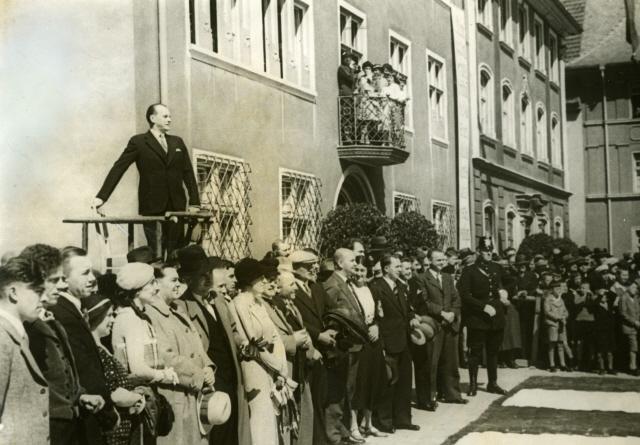
Below is the information provided on the reverse of the picture:
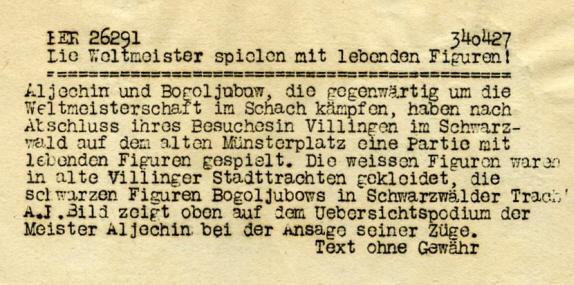
(5834)
Also from Mr Clapham comes this game, from a 25-board display:
Alexander Alekhine v Keltisch1 e4 Nf6 2 e5 Nd5 3 c4 Nb6 4 d4 d6 5 Nf3 Bg4 6 Be2 dxe5 7 Nxe5 Bxe2 8 Qxe2 N8d7 9 c5 Nd5
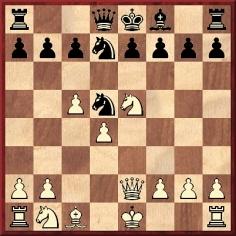
10 c6 Nxe5 11 cxb7 Rb8 12 dxe5 e6 13 Qb5+ Qd7 14 Qxd7+ Kxd7 15 Nc3 Bb4 16 Bd2 Bxc3 17 Bxc3 Nxc3 18 bxc3 Rxb7 19 O-O Rd8 20 f4 Ke7 21 Rf2 Rdb8 22 Rd2 Rb1+ 23 Rxb1 Rxb1+ 24 Kf2 Rc1 25 Ke3 Rxc3+ 26 Kd4 Rc1 27 Ke3 h5 28 g3 a5 29 Rd4 Rc5 30 Ke4 g6 31 a3 c6 32 Rd3 Rd5 33 Rb3 Kd8 34 Rb7 Rd7 35 Rxd7+ Kxd7 36 Kd4 Kc7 37 Kc5 Kb7 38 h3 Kc7 39 g4 hxg4 40 hxg4 Kb7
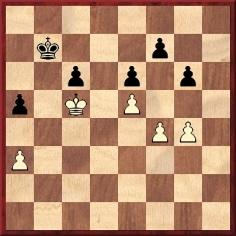
41 g5 Kc7 42 a4 Kb7 43 Kd6 Kb6 44 Ke7 c5 45 Kxf7 c4 46 f5 c3 47 fxg6 c2 48 g7 c1Q 49 g8Q Qf4+ 50 Ke7 Qb4+ 51 Kf6 Qf4+ 52 Ke7 Qb4+ 53 Kf6 Qf4+ 54 Ke7 Drawn.
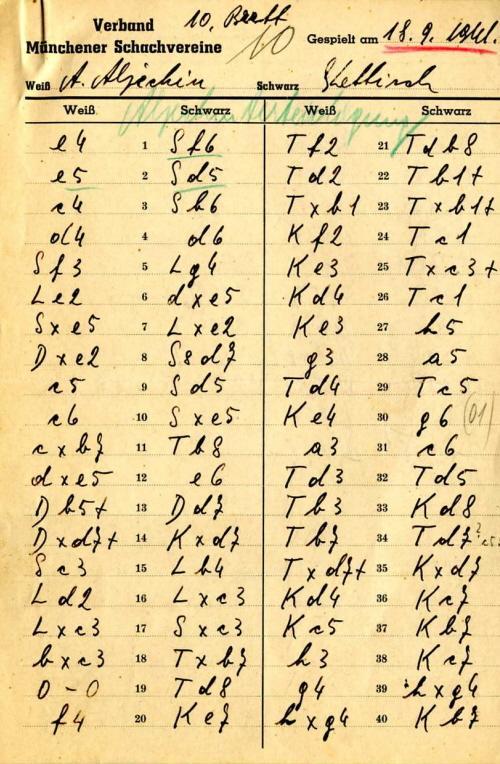
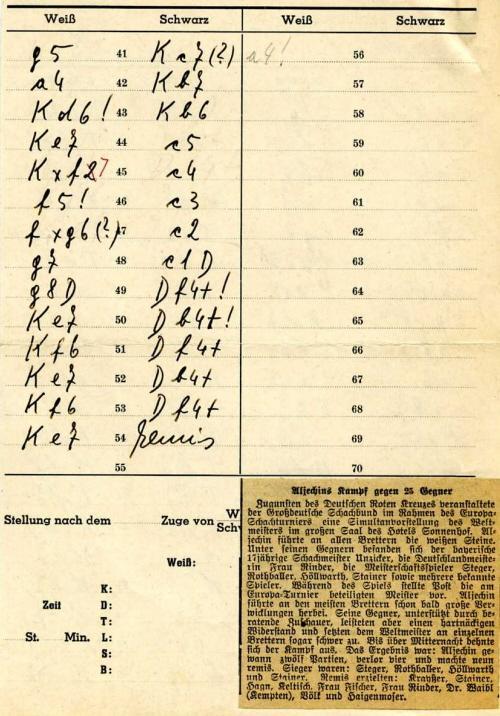
In the newspaper report Unzicker is mentioned as one of Alekhine’s opponents. A photograph featuring both of them was given in C.N. 4373.
(5835)
The above-mentioned photograph, from page 13 of 125 Jahre Münchener Schachclub 1836-1961 (Munich, 1961) shows the 16-year Wolfgang Unzicker (far right) in play against Alekhine in Munich, 1941:
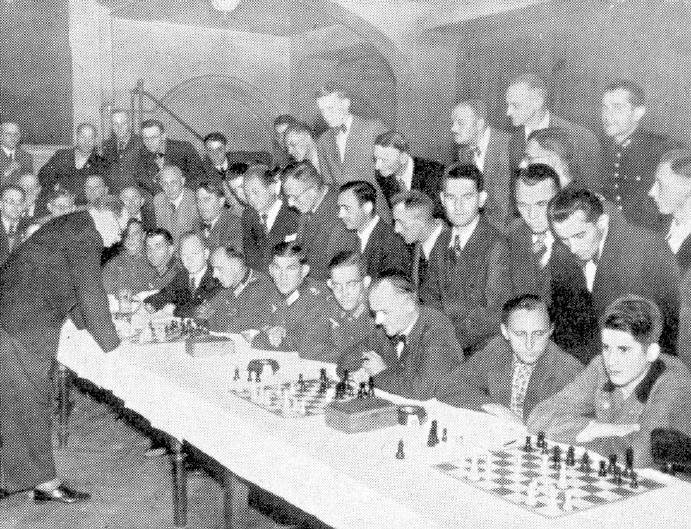
Dominique Thimognier sends this bizarre cutting from Le Figaro of 3 December 1927:
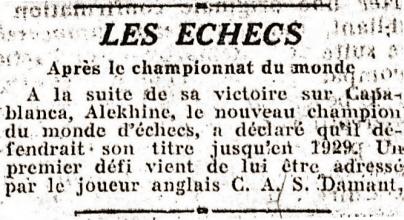
For reasons unexplained, the French newspaper reported that the new world champion, Alekhine, had just been sent a first challenge for his title, by the English player C.A.S. Damant.
(5846)
Pages 318-349 of the November 2008 issue of the Moscow magazine Караван (Karavan) have an extensive article Капабланка: гений игры for which we supplied a number of photographs of Capablanca and his second wife. The other illustrations include, courtesy of the Agence France-Presse, a shot of Alekhine outside the Café de la Paix, Paris in 1927.
(5878)
C.N. 5878 referred to a photograph of Alekhine in the November 2008 edition of the Moscow magazine Караван (page 346), and we now have permission to reproduce it (credit: Collections/Roger-Viollet Archives):
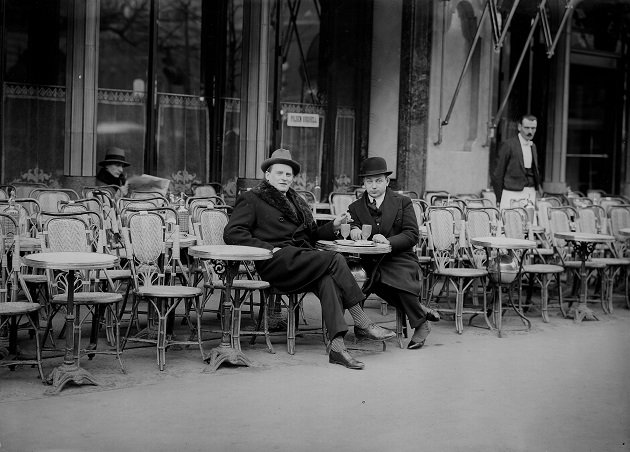
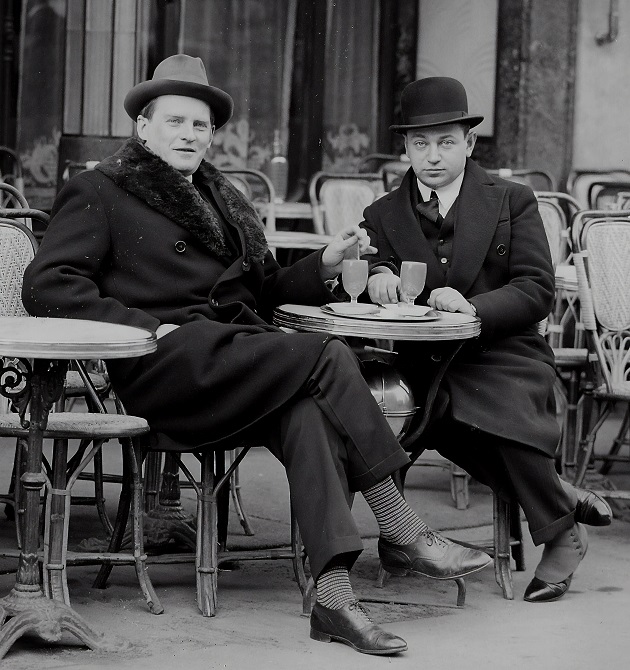
The Archives state that Alekhine and his unidentified companion were at the Café de la Paix in Paris in 1927.
(11607)
From Luc Winants:
‘In an old notebook of Victor Soultanbéieff’s I have found two cuttings with the same photograph, and they name Alekhine’s companion as Andrei Sedykh (Андрей Седых). He was a Russian emigrant and prominent writer, his real name being Yakov Moiseievich Tsvibak (1902-94).’
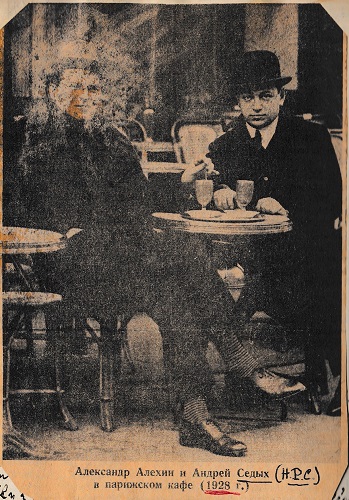
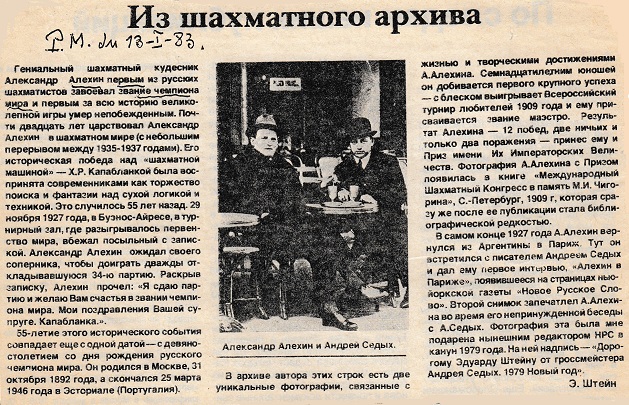
(11616)
From page 237 of Why You Lose at Chess by Fred Reinfeld (New York, 1956):
‘I shall never forget the description of the final scene of the 1935 match for the world championship. Both Alekhine, the defeated champion, and Euwe, the new champion, were in tears. There was this difference: Alekhine, the defeated, wept tears of sorrow. Euwe, the victor, wept tears of joy.’
In which contemporary source did the ‘description’ in question appear?
(5907)
Prompted by the Reinfeld quote regarding Euwe and Alekhine, Michael Clapham has sent us from his collection a photograph taken at the end of the 1935 world championship match:
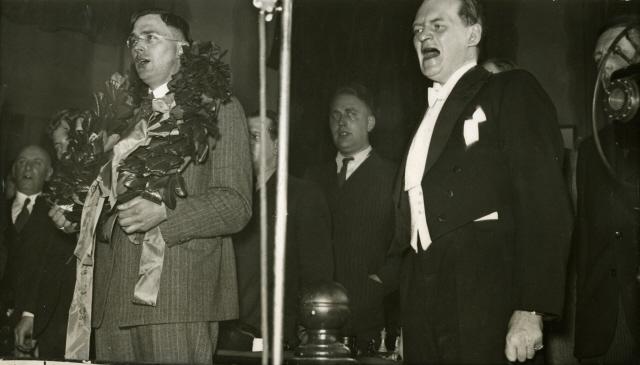
(5914)
Concerning the involvement of Eric Klein in the 1935 world title match, see our feature article on him.
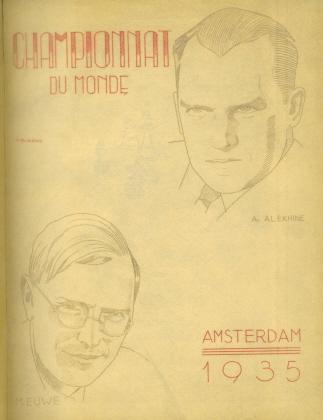
From Jan Kalendovský comes a photograph (source unknown) of Alekhine at the studios of Metro-Goldwyn-Mayer with Renée Adorée (1898-1933) and Fred Niblo (1874-1948):
Can it be confirmed that the photograph was taken during Alekhine’s visit to Los Angeles in May 1929?
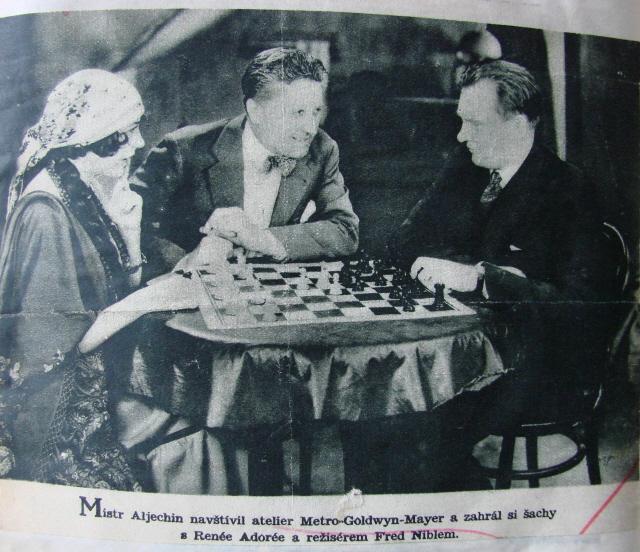
(5915)
David Picken (Greasby, England) and Luc Winants (Boirs, Belgium) note that Renée Adorée played the role of a gypsy in an MGM film directed by Fred Niblo, Redemption. Shot in 1929 and starring John Gilbert, it was not released until 1930. Without the production delays it would have been his first talking picture.
We add that Redemption was unsuccessful, as noted, for instance, on page 66 of La fabuleuse histoire de la Metro Goldwyn Mayer en 1714 films (Paris, 1977). See also pages 261-262 of volume one of The Great Movie Stars by D. Shipman (London, 1989). According to page 544 of Close-Ups From the Golden Age of the Silent Cinema by J.R. Finch and P.A. Elby (New York and London, 1978) Gilbert’s ‘greatest film was The Big Parade with Renée Adorée’.
(5922)
Lonnie Kwartler (Chester, NY, USA) notes misprints in the pages of Lasker’s Lehrbuch des Schachspiels reproduced in C.N. 5924: ‘Mares’ should read Marco, and in the next diagram White’s king is missing, from h1.
The review of the Lehrbuch on page 318 of the July 1926 BCM commented, ‘There are unfortunately a large number of misprints, which will require correction in a second edition.’ Later versions did indeed make improvements. However, while including such corrections, the English-language edition of Lasker’s Manual, first published in 1927, introduced new problems, and we look at one of them now.
The victim of a famous Alekhine brilliancy (New York, January 1924) was named as Kußmann (i.e. Kussmann) by Lasker in his Lehrbuch (see either page 104 or page 108). In the English edition (page 137) it came out as ‘Kubmann’, i.e. with apparent confusion between the Eszett (ß) and the letter b. The spelling ‘Kubmann’ persisted in subsequent editions of Lasker’s Manual.
In, respectively, Auf dem Wege zur Weltmeisterschaft and his second volume of Best Games Alekhine named his opponent as A. Kußman and A. Kussman. Use of the initial A. may be due to his having played a draw against Abraham S. Kussman on another occasion: in a clock simultaneous display in New York on 23 March 1929 (American Chess Bulletin, April 1929, pages 62 and 65).
As regards the brilliant miniature which Alekhine won, it is rather surprising that page 734 of the Skinner/Verhoeven volume entertained, albeit tentatively, the possibility that Alekhine played two almost identical games, against L. Kussman and L. Kubmann (the sources being, respectively, the above-mentioned books by Alekhine and Lasker).
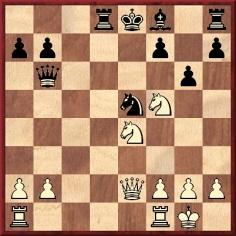
So, who had the misfortune in the above position to face 16 Qb5+ from Alekhine? We wonder whether there is any reason to doubt the information supplied when the game was published on page 8 of the January 1924 American Chess Bulletin:
‘A simultaneous game played between Alexander Alekhine and Leon Kussman, dramatic editor of the Jewish Morning Journal, in the former’s exhibition at the Newspaper Club of New York, January 13, 1924 – the Russian New Year’s Day.’
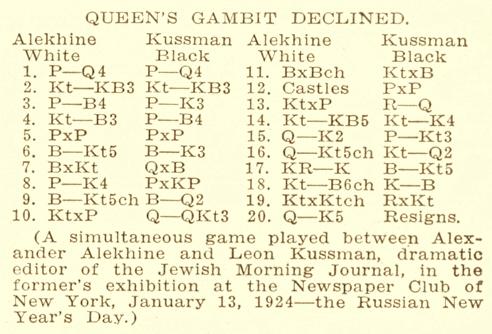
(5930)
Russell Miller (Camas, WA, USA) informs us that the ancestry.com webpage offers basic information about Leon Kussman, such as his dates: 1884-1977.
Our collection includes an inscribed copy of Kussman’s poems in Yiddish, Mein Stam (New York, 1940):
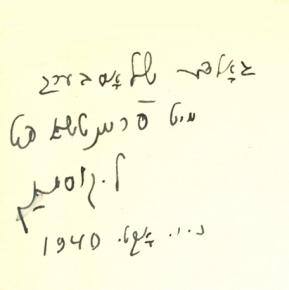
(5965)
One of T.H. Tylor’s very rare forays into chess writing was ‘The Grand Masters’ on pages 26-29 of the anthology Home and Away (London, 1948). Directed at a mainstream audience, the article contained little that is quotable, although on page 28 he described Alekhine as ‘perhaps the greatest chess genius of them all’.
(5966)
In connection with the new algebraic edition of the Nottingham, 1936 volume (Milford, 2009) Hassan Roger Sadeghi (Lausanne, Switzerland) notes the misconception that it was Alekhine’s last tournament book; a volume on Madrid, 1943 is sometimes overlooked.
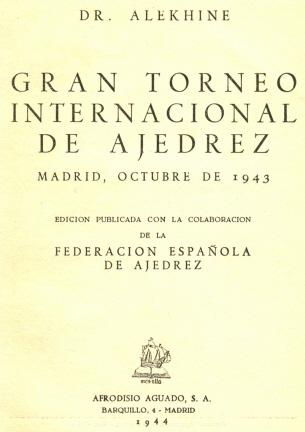
Gran torneo internacional de ajedrez differed from Alekhine’s other tournament books in that the 105 games were unannotated, although each had an introductory paragraph. Two sample pages are shown below:
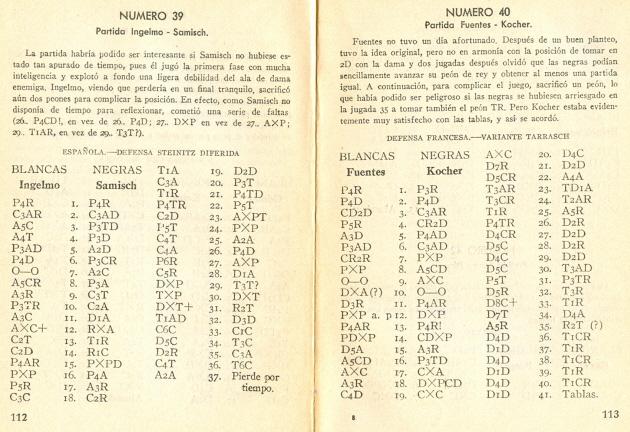
(6162)
Christian Sánchez points out an interview with Capablanca by Adelardo Fernández Arias in ABC on 12 May 1932.
Many of the standard interview topics were covered. In particular, the Cuban complained about being unable to obtain a rematch with Alekhine and said that FIDE was not strong enough to run the world championship. He was sure that he could regain the title, and especially if Alekhine lost in the early games, which would demoralize him. Capablanca evoked race and climate when stating that Slavs were the best chessplayers. He also commented that he had earned more money from chess than anyone else, although the sums to be derived from the game were not high. He believed that chess should be taught in schools to help children organize their thoughts and, regarding actual play, expressed a particular liking for pawns. Asked about women players, Capablanca named only Vera Menchik, whom he described as ‘very strong’. On the subject of important games, as a curiosity he referred to a simultaneous display in Moscow in 1925 at which the People’s Commissars Rykov and Krylenko were present. He added that Trotsky was a good player, as Lenin had been. Among chessplaying celebrities, he mentioned the pianist Rosenthal.
(6171)
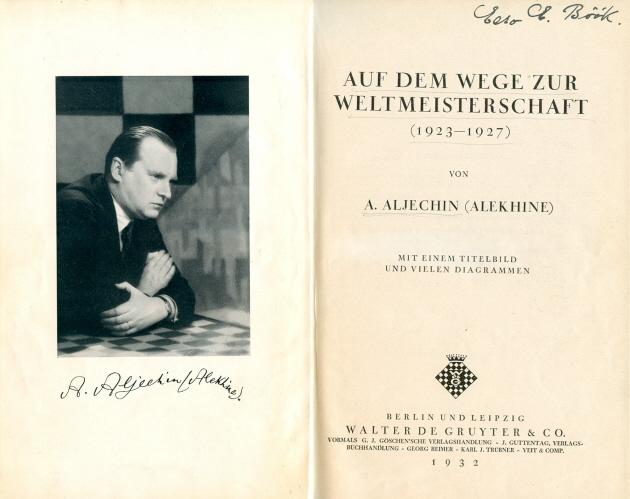
(Title page inscribed by Eero Böök)
The above photograph by Man Ray was also the frontispiece of Alekhine’s Chess Games, 1902-1946 by L. Skinner and R. Verhoeven (Jefferson, 1998).
A second shot was number 48 in Man Ray’s Paris Portraits: 1921-39 by Timothy Baum (Washington, 1989):
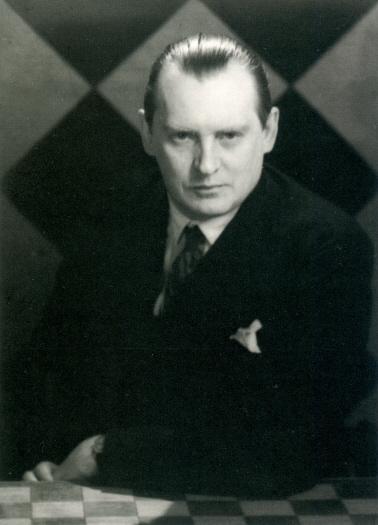
(6191)
Now, Jeremy Silman draws attention to a third photograph, apparently from the same time. The website dates it circa 1925, which seems to us less likely than the ‘circa 1928’ in the book mentioned in our earlier item, Man Ray’s Paris Portraits: 1921-39 by Timothy Baum (Washington, 1989).
(8363)
Alekhine’s first volume of Best Games has appeared in various languages, but does a complete Spanish translation exist?
We have the very rare edition Mis mejores partidas de ajedrez 1908-1923 (Montevideo, 1929), translated from the English by ‘Passer By’, but it is only 100 pages long and stops after Game 50 (Alekhine v Rabinovich, Moscow, 1918). The front cover states ‘primera serie’and ‘50 partidas’, and it seems that no volume with the remaining 50 games was published.
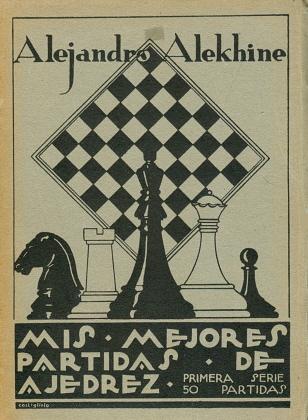
(6313)
Regarding C.N. 6313, information has been received from Josep Alió (Tarragona, Spain) and Javier Asturiano Molina. The latter points out the strange existence of websites claiming that a Spanish translation of the first volume of Alekhine’s Best Games was published by Afrodisio Aguado, Madrid in 1924; such an early date might have been expected to arouse suspicion. Two editions from that publisher have been found; they date from the 1940s, but only one has an exact year of publication (1947). In common with the 1929 Uruguayan volume discussed in C.N. 6313, only the first 50 games were given. No translator’s name appeared. The Spanish text was the same as in the 1929 book, but there were differences in lay-out.
The dust-jacket of one of the editions had a curious description of the work as posthumous.
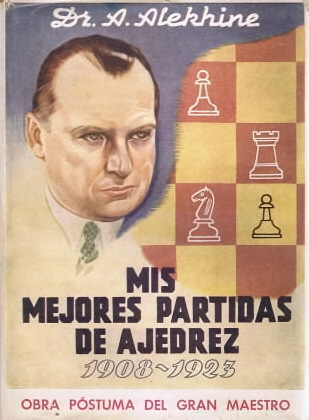
A photograph was included of Alekhine signing his contract for the book:
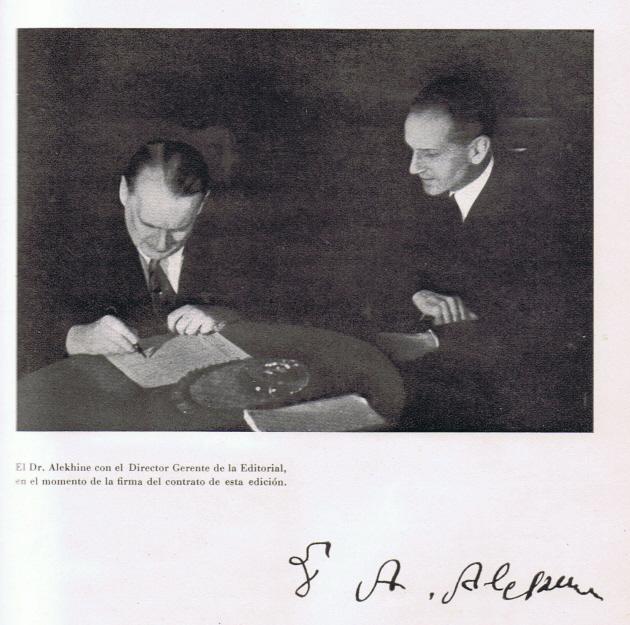
Our correspondents note furthermore that a full version of Alekhine’s book (100 games) was published by Ricardo Aguilera, Madrid in 1974 and 1986. In 2001, La Casa del Ajedrez (Madrid) also brought out an edition.
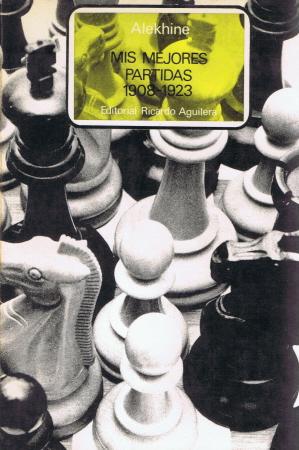
The 1974 edition from Ricardo Aguilera
Mr Alió, who has provided the illustrations for the present item, comments:
‘The imprint page of the Ricardo Aguilera edition says:
‘Versión de la edición realizada por Editorial Afrodisio Aguado, S.A., Madrid, en 1944, según la traducción del original de M. Golmayo.’
It is interesting to note that Golmayo was the translator of the 1940s edition, but there is no explanation of the difference in the number of games. Even though there are 100, not 50, games, it is stated that the edition is a “version” of the 1940s one.’
(6328)
A claim that Alekhine scored only 17 wins out of 50 games in a 1930s simultaneous exhibition in Riga was discussed in C.N.s 2793 and 3450 (see page 257 of Chess Facts and Fables).
At the webpage of the National Digital Library of Latvia Dominique Thimognier (Fondettes, France) has found a number of reports for the period 11-18 September 1935 in the Latvian publication Rits. An example, from page 5 of the 13 September 1935 issue, is reproduced below.
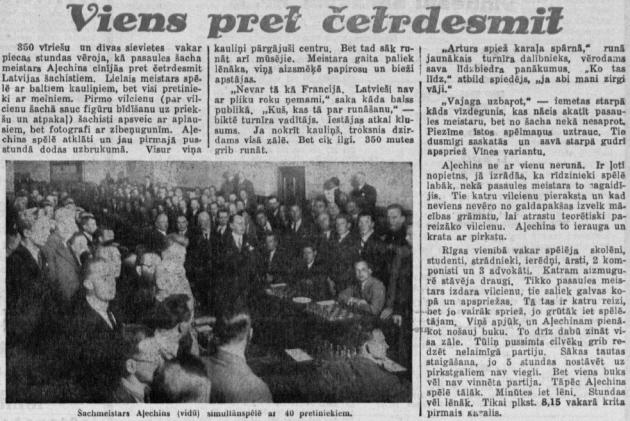
We shall be grateful if a reader with knowledge of Latvian can check whether any of the reports refer to a particularly low score by Alekhine in one of his displays.
(6321)
Olimpiu G. Urcan provides, courtesy of the State Russian Museum Archive, this photograph of Alekhine in Riga on the same occasion as in the photograph given above in C.N. 6321:
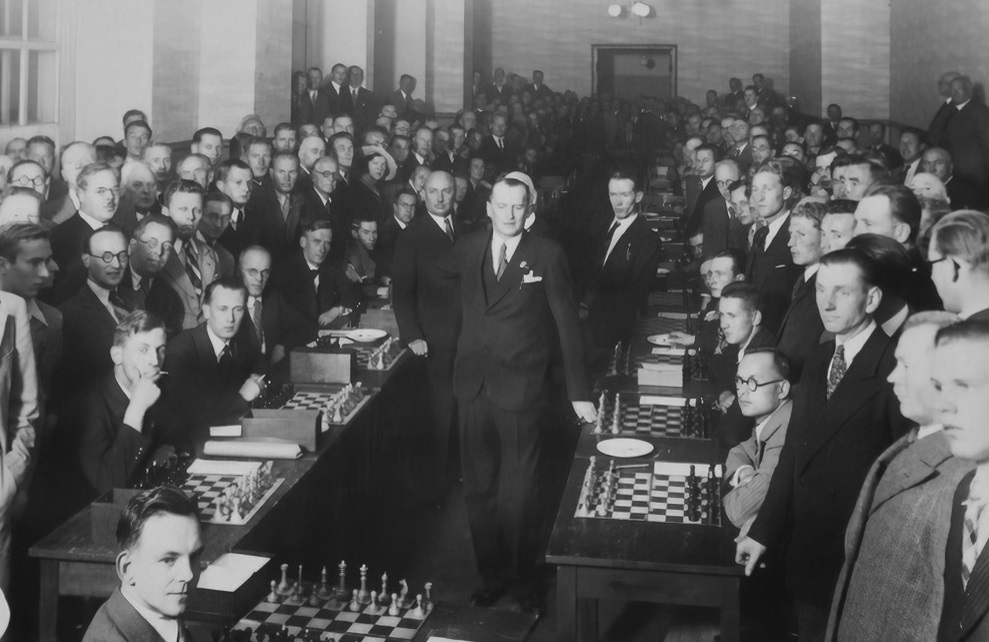
On 27 January 1935 Alekhine gave a clock simultaneous exhibition in Barcelona (+10 –0 =3). Seven of the games (against Catalá, Lloréns, Busto, Vilardebó, Duffo, Cherta and Ribera) were published in the books on Alekhine by Morán and Skinner/Verhoeven, and we have now received from Andrés Vicente Sanz (Valencia, Spain) five of the six others:
Alexander Alekhine – V. Marín
Barcelona, 27 January 1935
Queen’s Gambit Declined
1 d4 d5 2 c4 e6 3 Nc3 Nf6 4 Bg5 Be7 5 e3 O-O 6 Nf3 Ne4 7 Bxe7 Qxe7 8 Qc2 Nxc3 9 Qxc3 Nc6 10 a3 a5 11 Rc1 a4 12 cxd5 exd5 13 Bb5 Bd7 14 O-O Rfc8 15 Qc5 Qd6 16 Rc3 Nb8 17 Bxd7 Qxd7 18 Ne5 Qe6
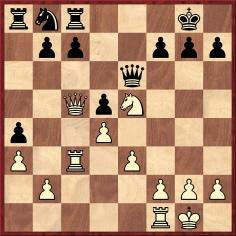
19 Qb5 b6 20 Rfc1 Ra5 21 Qe2 c5 22 Nd3 Nd7 23 Nf4 Qd6 24 Qg4 Raa8 25 Qf5 Nf6 26 f3 g6 27 Qe5 Qxe5 28 dxe5
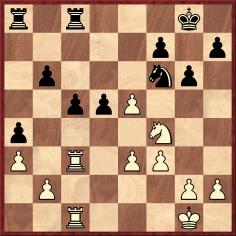
28...g5 29 Nh3 Nd7 30 Rd3 d4 31 exd4 cxd4 32 Re1 Ra5 33 Rxd4 Nxe5 34 Nxg5 Nd3 35 Rxd3 Rxg5 36 Rd2 Rgc5 37 Kf2 Rc2 38 Ree2 Rxd2 39 Rxd2 Rc4 40 Ke3 b5 41 Rd8+ Kg7 42 Rb8 Rc2 43 Rxb5 Rxg2 44 h4 Rh2 45 Rb4 Kg6 46 Rxa4 Rxb2 47 Rb4 Ra2 48 a4 f6 49 Kf4 Ra1 50 Ke4 Ra3 51 f4 Ra1 52 f5+ Kf7 53 Rb7+ Kg8 54 Ra7 Resigns.
Source: La Vanguardia, 15 February 1935, page 14.
Alexander Alekhine – J. Cabestany
Barcelona, 27 January 1935
Queen’s Gambit Declined
1 d4 Nf6 2 c4 e6 3 Nc3 d5 4 Bg5 Nbd7 5 Nf3 Be7 6 e3 c6 7 Bd3 dxc4 8 Bxc4 b5 9 Bd3 a6 10 O-O c5
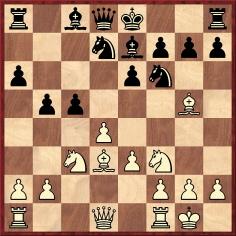
11 a4 b4 12 Ne2 Bb7 13 a5 Rc8 14 Qb3 Bd5 15 Bc4 cxd4 16 Bxd5 Nxd5 17 Bxe7 Qxe7 18 Nexd4 O-O 19 Rfc1 Qd6 20 g3 f5 21 Ng5 Nc5 22 Rxc5 Rxc5 23 Ngxe6 Rf6 24 Nxc5 Qxc5 25 Rd1 Kf8 26 Ne6+ Rxe6 27 Rxd5 Qc1+ 28 Rd1 Resigns.
Source: La Vanguardia, 15 February 1935, page 14.
Alexander Alekhine – Comas
Barcelona, 27 January 1935
English Opening
1 Nf3 c5 2 c4 Nc6 3 d4 cxd4 4 Nxd4 g6 5 e4 Bg7 6 Nc2 Nf6 7 Nc3 a6 8 Be2 O-O 9 O-O d6 10 Be3 b6 11 f4 Bb7 12 Bf3 Qc7 13 Rc1 Rac8 14 Qd2 Nb8 15 b3 b5
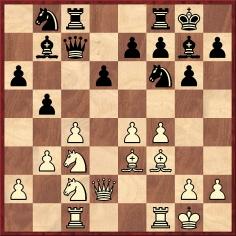
16 e5 dxe5 17 fxe5 Nfd7 18 Bxb7 Qxb7 19 Bh6 Nxe5 20 Bxg7 Kxg7 21 cxb5 Rfd8 22 Qf4 f6 23 Nd4 Qb6 24 Na4 Qd6 25 Rxc8 Rxc8 26 bxa6 Nxa6 27 Rd1 Kg8 28 h3 Nb4 29 Nb2 Nxa2 30 Kh1 Nc4 31 Qg4 Resigns.
Source: La Vanguardia, 22 February 1935, page 12.
Alexander Alekhine – Maristany
Barcelona, 27 January 1935
Sicilian Defence
1 e4 c5 2 c4 Nc6 3 d3 d6 4 f4 Nf6 5 Nf3 g6 6 Be2 Bg7 7 O-O O-O 8 Nc3 Ng4 9 h3 Nf6 10 Be3 Qc7 11 Rc1 Qb6 12 Rb1 Qd8 13 g4 h5 14 Ng5 hxg4 15 hxg4 Qd7
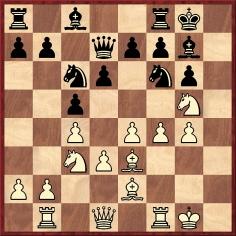
16 f5 Ne5 17 Kg2 e6 18 Rf2 b6 19 Qh1 Bb7 20 Qh3 Rfe8 21 Rh1 a6 22 fxe6 fxe6 23 Nh7 Rf8 24 Nxf8 Rxf8 25 g5 Nh5 26 Bxh5 Rxf2+ 27 Bxf2 gxh5 28 Qxh5 Qf7 29 Qxf7+ Kxf7 30 Rh3 Kg6 31 Bh4 Bc6 32 Kf2 b5 33 cxb5 axb5 34 Ne2 Resigns.
Source: La Vanguardia, 22 February 1935, page 12.
Alexander Alekhine – R. Doménech
Barcelona, 27 January 1935
French Defence
1 e4 e6 2 d4 d5 3 Nc3 Bb4 4 Ne2 dxe4 5 a3 Bxc3+ 6 Nxc3 f5 7 f3 exf3 8 Qxf3 c6 9 Bf4 Nf6 10 O–O-O O-O 11 Bc4 Nd5 12 Rhe1 b5 13 Nxd5 exd5 14 Bd3 a5 15 Qg3 Na6 16 Bg5 Qc7 17 Re5 Bd7 18 Rde1 Rae8
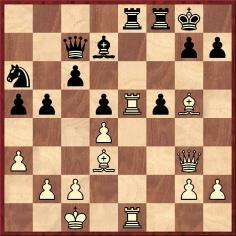
19 Bh6 Bc8 20 Rxe8 Qxg3 21 Rxf8+ Kxf8 22 hxg3 gxh6 23 Bxf5 Bxf5 24 Rf1 Kg7 25 Rxf5 Nc7 26 Kd2 Ne6 27 Ke3 Kg6 28 g4 Kg7 29 b3 a4 30 bxa4 bxa4 31 c4 Nc7 32 Kd3 Kg6 33 Kc3 Resigns.
Source: La Vanguardia, 22 February 1935, page 12.
The chess column in La Vanguardia was conducted by Ramón Rey Ardid, and in the 1 February issue (page 12) he listed the 13 opponents. The missing game, against Vallvé, was probably published in the chess column of the 8 February 1935 issue, which has yet to be found.
With no photograph to offer from the Barcelona display, we reproduce a shot taken in Madrid, from El Ajedrez Español, March 1935:
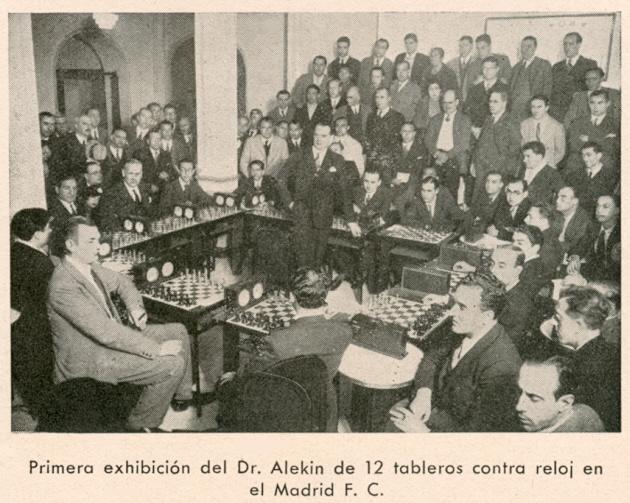
(6395)
Josep Alió (Tarragona, Spain), Pierre Bourget (Quebec, Canada), Jan Kalendovský (Brno, Czech Republic) and Christian Sánchez (Rosario, Argentina) have provided the remaining game from Alekhine’s 13-board clock simultaneous display. It was published on page 12 of La Vanguardia, 8 February 1935:
Alexander Alekhine – Vallvé
Barcelona, 27 January 1935
Sicilian Defence
1 e4 c5 2 Nf3 Nc6 3 d4 cxd4 4 Nxd4 Nf6 5 Nc3 d6 6 Bg5 e6 7 Nxc6 bxc6 8 e5 Qa5
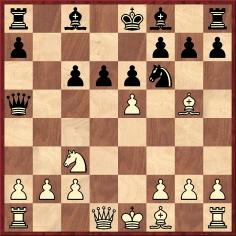
9 Bb5 Rb8 10 Bxc6+ Bd7 11 Bxd7+ Nxd7 12 O-O Nxe5 13 f4 Nd7 14 f5 exf5 15 Nd5 f6 16 Rxf5 Qd8 17 Qe2+ Be7 18 Be3 Rb7 19 Bd4 Ne5 20 c4 Qc8 21 Raf1 O-O 22 b3 Bd8 23 Qe4 Bb6 24 Kh1 Bxd4 25 Qxd4 Qe6 26 Qe4 Rbf7 27 Nf4 Qe7 28 Rh5 g6 29 Rh3 f5 30 Qd4 g5 31 Nd5 Qe6 32 Re3 f4 33 Ree1 Qh6
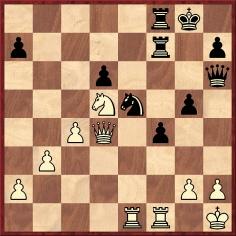
34 Rxe5 dxe5 35 Qxe5 Qg7 36 Re1 Qxe5 37 Rxe5 h6 38 c5 f3 39 gxf3 Rxf3 40 c6 Rf1+ 41 Kg2 Kg7 42 Re7+ Kg6 43 Re2 Rc1 44 c7 Kh5 45 b4 Rc4 46 Re3 Rc2+ 47 Kg1 Rff2 48 c8(Q) Resigns.
R. Rey Ardid’s Vanguardia chess columns are available online.
Javier Asturiano Molina adds the full names of Alekhine’s opponents in the games presented in C.N. 6395:
As mentioned in C.N. 6395, another game from the same display, against Catalá, was given in the Morán and Skinner/Verhoeven monographs on Alekhine. However, Mr Sánchez now points out that when the game was published on page 14 of La Vanguardia, 15 February 1935 it lasted 37, and not 28, moves and had a different sequence between moves 11 and 17:
Alexander Alekhine – Catalá
Barcelona, 27 January 1935
Ruy López
1 e4 e5 2 Nf3 Nc6 3 Bb5 b6 4 O-O Nd4 5 Nxd4 exd4 6 c3 a6 7 Bc4 Nf6 8 e5 d5 9 Bd3 Ne4 10 cxd4 c5 11 Nc3
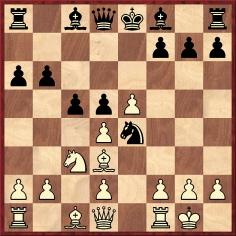
11...Ng5 (Mr Sánchez comments that the moves in the present score are more logical than the sequence in above-mentioned books, which was 11...Bb7 12 dxc5 Bxc5 13 b4 Bd4 14 Qe1 Ng5 15 Kh1 h5 16 f4 Ne6 17 Qe2.) 12 dxc5 Bxc5 13 b4 Bd4 14 Kh1 Bb7 15 Qg4 Ne6 16 f4 h5 17 Qe2 g5 18 fxg5 Nxg5 19 Bb2 Ne4 20 e6 fxe6 21 Nxe4 Bxb2 22 Rab1 Bd4 23 Nf6+ Ke7 24 Rbe1 Qd6 25 Nxh5 Raf8 26 Qg4 Rxf1+ 27 Bxf1 Bf6 28 Nf4 e5 29 Ng6+ Kf7 30 Nxh8+ Bxh8 31 Qh5+ Kg8 32 Qe8+ Qf8 33 Qd7 Qf2 34 Rd1 Qf7 35 Qd8+ Qf8 36 Qxb6 Qf7 37 Bxa6 Resigns.
Finally, Mr Alió observes, on the basis of other reports in La Vanguardia, that the clock display was played in difficult circumstances for Alekhine. At 22.15 on Saturday, 26 January 1935 he began a simultaneous exhibition against 43 strong players from Barcelona, scoring +33 –6 =4. The display did not finish until 05.00 on the Sunday, and later the same day the clock simultaneous exhibition took place, against opposition which included the ten best players in Barcelona. Our correspondent provides a photograph of the 43-board display, from page 1 of La Vanguardia, 26 March 1946:
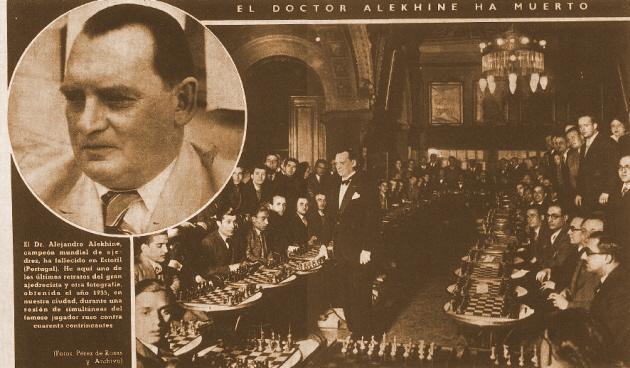
(6399)
Daniel King (London) asks for information on the old story about Alekhine playing two games, with alternate colours, against a pair of amateurs who hatched a scheme whereby the master’s moves in the first game were repeated against him in the second one, the aim being to ensure that he could not win both games.
We recall the following feature on pages 48-50 of the February 1927 Wiener Schachzeitung (a special ‘chess humour’ issue):
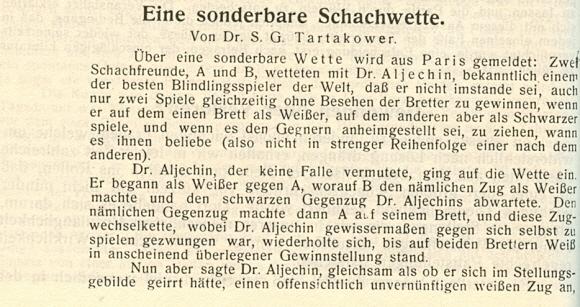
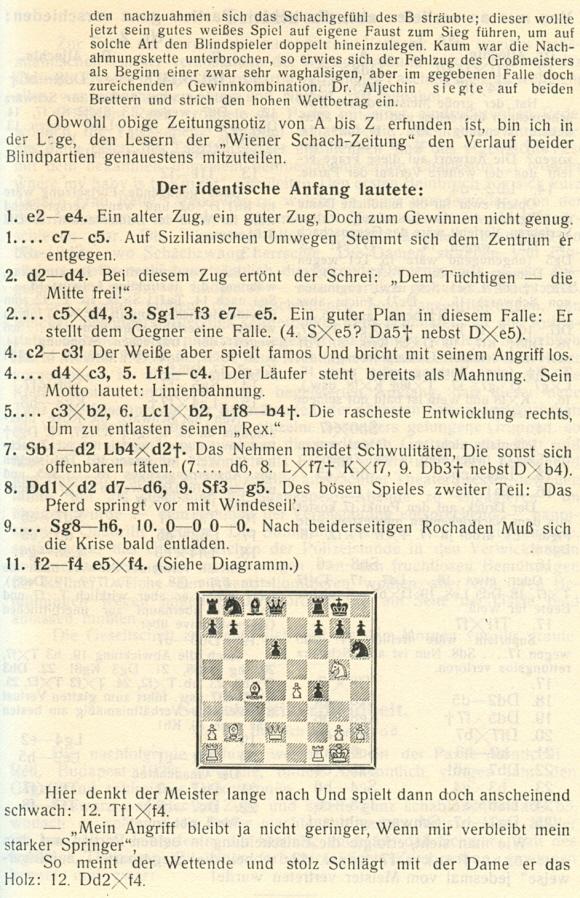
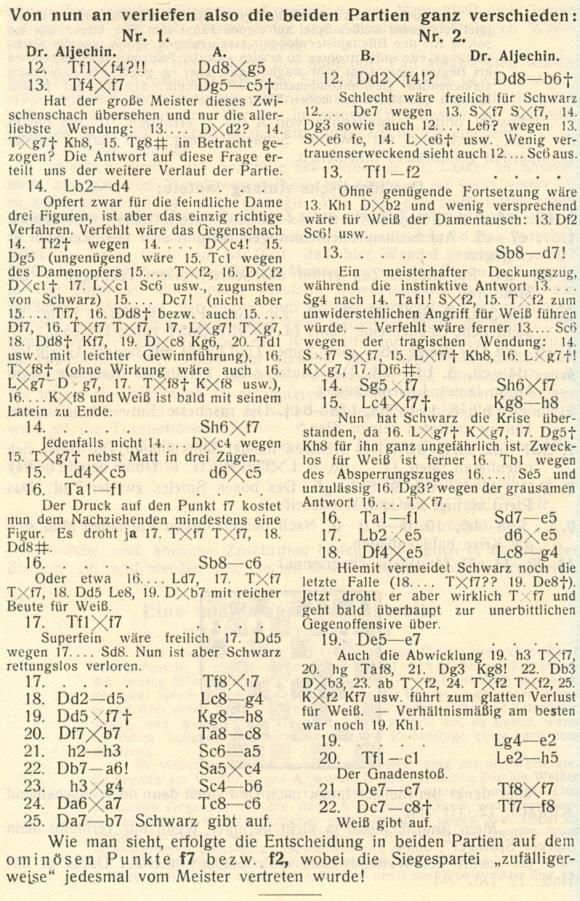
(6452)
Thomas Binder (Berlin) reverts to a subject raised in C.N. 6452: stories about preventing a master from obtaining a 100% score in a pair of games through the trick of repeating in the second game his own moves from the first one.
C.N. 6452 quoted an article by Tartakower on pages 48-50 of the February 1927 Wiener Schachzeitung, and we now add an item on page 281 of the July 1884 BCM:
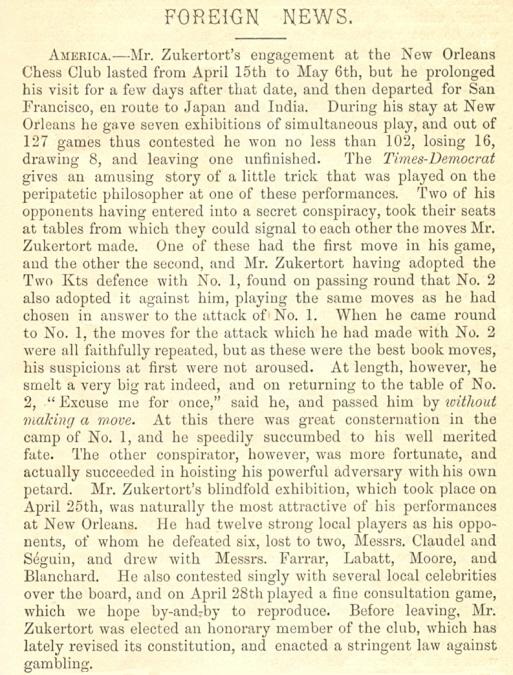
(6944)
Jan Kalendovský sends two photographs of Alekhine at the 1931 Olympiad in Prague:
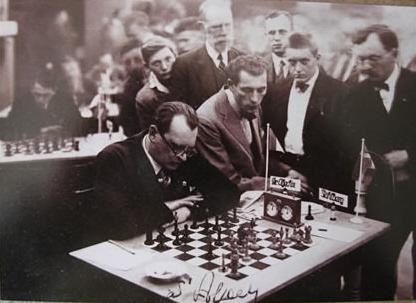
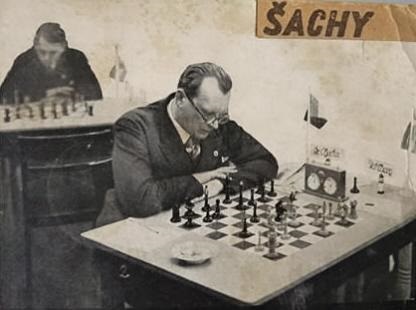
We note that a cropped version of the first photograph was published on page 153 of the September-October 1931 American Chess Bulletin:
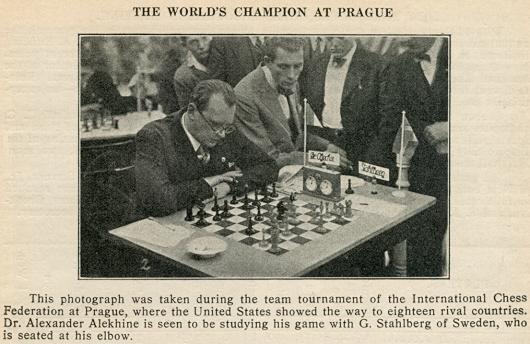
(6507)
A question concerning this photograph, from page 153 of the September-October 1931 American Chess Bulletin, is whether the person seated at Alekhine’s elbow is indeed Ståhlberg. For purposes of comparison, below are two photographs of the Swedish master from the period in question:
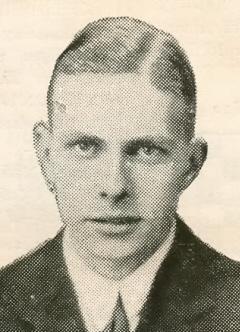
Source: Tidskrift för Schack, January 1930, page 10.
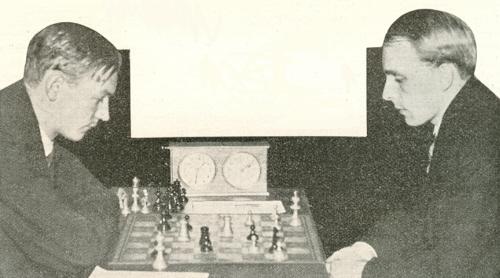
G. Stoltz v G. Ståhlberg. Source: Tidskrift för Schack, December 1931, page 205.
As regards the unpopulated version of the Alekhine photograph, Jan Kalendovský notes that it appeared on the front cover of Šachy by Karel Zmatlík (Prague, 1934):
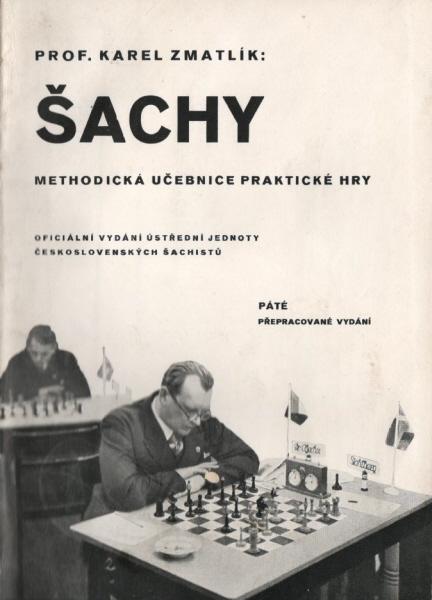
(6525)
Knud Lysdal (Grindsted, Denmark) sends us from his collection a number of photographs taken during the Prague, 1931 Olympiad, including the following:
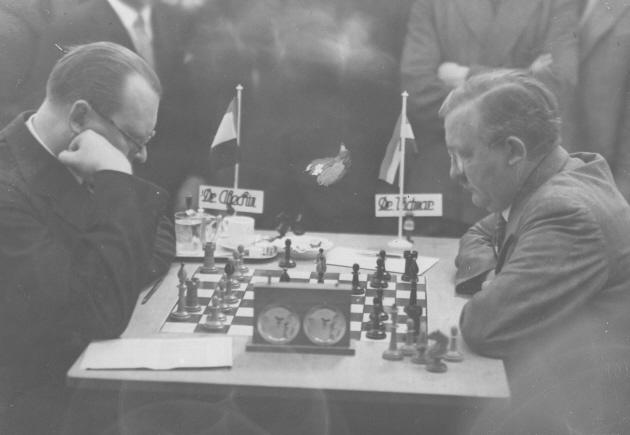
A. Alekhine v M. Vidmar
This article by G.H. Diggle, taken from page 4 of Chess Characters (Geneva, 1984), was first published in Newsflash, January 1975:
‘Perhaps the most exciting memory of any chessplayer is his first Tournament. The present writer’s début (or débâcle) was in the 3rd Class Section of the Scarborough Festival, 1928, where if he didn’t “conquer”, he at least “came and saw” for the first time such bygone heroes as W. Winter (1st Prize, Premier), E. Colle (2nd), R.P. Michell (3rd), Sir George Thomas, F.D. Yates, Victor Buerger, H. Saunders and Vera Menchik – the last-named at the age of 22 playing for the first time in the ranks of the masters, and confounding the “doubting ones” by beating Yates (then British Champion) in the very first round. The pair presented a strange contrast – the pleasant buxom and impassive girl and the small wiry professional, “peering and blinking” at the board, with a great heap of notes and news cuttings at his elbow (for he was handicapped by having to report the Tournament for several papers besides playing in it). Nevertheless, he had a kindly smile for his young opponent at the end of the game.
The highlight of the Congress came halfway through it when (as had been hoped) Dr Alekhine (who had just become world champion by defeating Capablanca) arrived for a three-day visit. Next evening the champion gave a simultaneous display, winning 24 and drawing one. The drawn game was the last outstanding, and the Doctor, having perambulated over three hours for his 24 victories, gratefully dropped into a chair opposite the sole survivor, who had (truth to tell) a won game with K, B, N and two pawns against Alekhine’s K and solitary rook. But what with the crowd converging all round him, the haunting fear of the Doctor’s giving up his rook for the two pawns and leaving him to win in 50 moves with K, B and N against K, and a humane reluctance to keep the world champion up all night after his arduous evening, he soon blundered away his N and agreed to a draw, receiving in return a profuse handshake from the great master.
One sadder memory. Isidor Gunsberg, then aged 74, also visited the Tournament, but his health was clearly failing, and he died two years later. In his prime it was said that “he conducted at different times more chess columns, and more at one and the same time, than any other journalist of his day”.’
Page 773 of the Skinner/Verhoeven book on Alekhine records that the world champion gave two simultaneous displays in Scarborough in 1928, conceding only one draw in each. The sole game-score available, on page 339 (a draw against C. Dawbarn), does not match the details in the above article.
(6538)
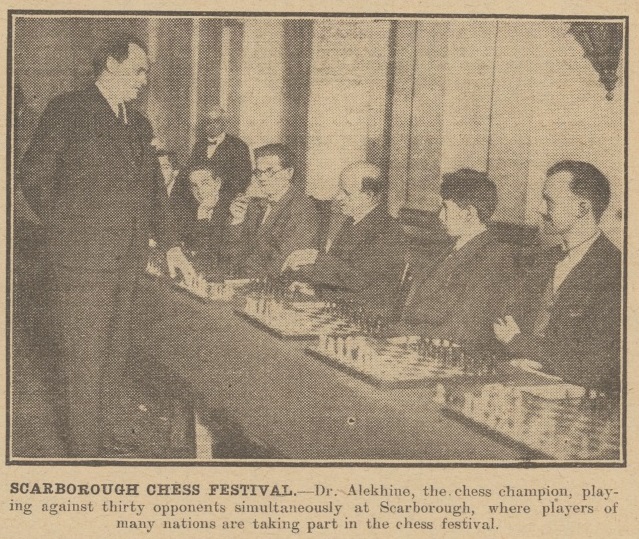
Daily Mirror, 2 June 1928, page 16
See Chess Photographs in the Daily Mirror.
Olimpiu G. Urcan provides, courtesy of the Hulton Archive, a photograph of Vera Menchik in play against Alekhine in the second round of play in the London tournament, 2 February 1932:
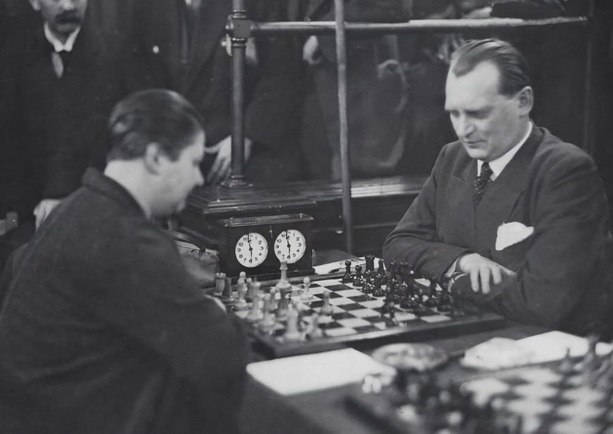
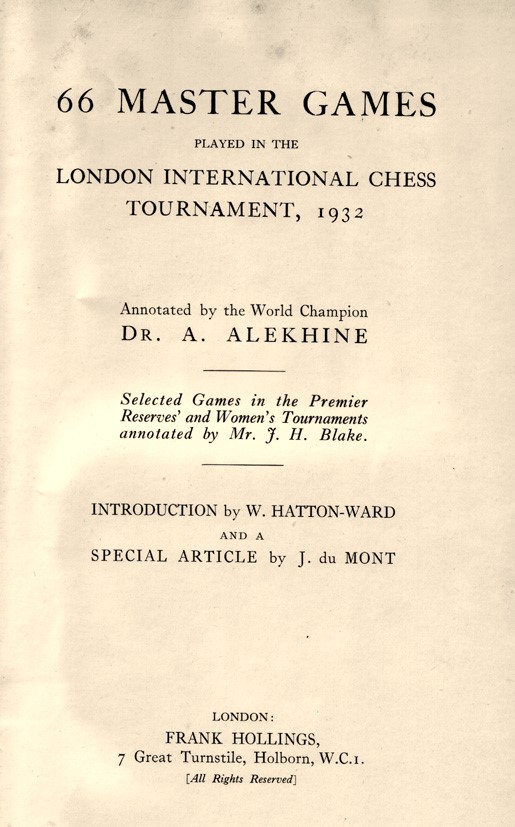
Robert Desjarlais (Bronxville, NY, USA) asks for information about a quote often ascribed to Alekhine, although without any reliable source:
‘During a chess competition a chess master should be a combination of a beast of prey and a monk.’
There are textual variants, but the above wording had a page to itself (88) in Bruce Pandolfini’s Treasure Chess (New York, 2007). Of itself, that naturally proves nothing (C.N. 5280 shows why), and we do not recall seeing the sentiments expressed in Alekhine’s writings.
There is, though, the following ‘once’ version on page 8 of Blunders and Brilliancies by Ian Mullen and Moe Moss (Oxford, 1990):
‘Alekhine was once quoted as saying that the successful tournament player must combine the chief characteristics of a research scientist, an ascetic monk and a beast of prey.’
At Google Books we found this sentence about Alekhine in an article ‘Chess Masters in Action’ by C.H.O’D. Alexander published in the Irish Digest, 1959:
‘Playing him, one gets a strong sense of someone dedicated to the game – a mixture of monk and scientist.’ [In fact, Alexander was writing about Botvinnik. See C.N. 6596.]
Only a snippet of Alexander’s text is available on-line, and we shall be grateful to any reader who can supply the full article – and especially since it seems also to contain information of relevance to the Alexander v Botvinnik c4/c5 matter (C.N.s 4292 and 6185).
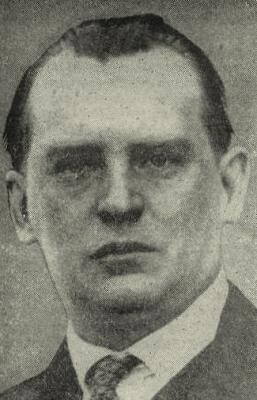
Alexander Alekhine
(6587)
We have acquired the full article ‘Chess Masters in Action’ by C.H.O’D. Alexander, which was published on pages 79-82 of the Irish Digest, October 1959. Extracts are provided below, and there is a surprise concerning the monk/scientist quote attributed to Alekhine (C.N. 6587). ...
‘For me, Alekhine will always epitomize chess, and I shall always remember my games with him with pleasure, even though he did win a brilliancy prize against me for one of them.’
‘[Lasker, Capablanca and Alekhine] all had a genius for the game. Euwe, though he had great natural talent, always struck me as essentially a man of high all-round ability who systematically devoted this ability to making himself a great chessplayer.
Everything that could be learnt about chess Euwe learnt, and taught to others ...’
‘Smyslov, a big slow-spoken redhead in the middle 30s who looks more like a Scot than a Slav, has a style as massive as his personality; after being beaten by Smyslov you feel as if you have been run over by a steamroller.’
‘Botvinnik is in the greatest tradition of world champions, with Morphy, Lasker, Capablanca and Alekhine. Playing him, one gets a strong sense of someone dedicated to the game – a mixture of monk and scientist. When I played Botvinnik in Amsterdam in 1954 I was temporarily demoralized by watching him write down his first move. Slightly short-sighted, he gave his entire attention to recording the move in the most beautifully clear and precise script; only after completing this to his entire satisfaction did he again bend his mind to the game. This calm but intense concentration on even the most trivial aspect of the game made me feel like a fly under the scientists’ microscope.’
From that final extract it can be seen that (contrary to the impression derived from the Google Books snippet) the description ‘a mixture of monk and scientist’ concerned Botvinnik, not Alekhine. Nonetheless, as noted in C.N. 6587 the Mullen/Moss book Blunders and Brilliancies claimed that Alekhine had referred to ‘a research scientist, an ascetic monk and a beast of prey’.
C.N. 6587 also mentioned the possible relevance to C.N.s 4292 and 6185 of Alexander’s remark about how Botvinnik wrote down his first move.
The Irish Digest stated on page 79 that the article by Alexander was ‘condensed from The Listener’.
(6596)
For the full Listener text see C.N. 8138.
From page 185 of Rich As A King by Susan Polgar and Douglas Goldstein (C.N. 8957):
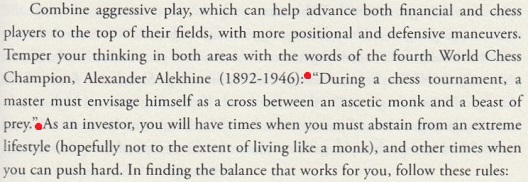
The alleged Alekhine quote has been discussed in C.N.s 6587, 6596 and 8138, and below is a chronological compilation of the occurrences already noted, together with a few additional ones:
Page 611 of The Listener, 16 August 1958 (article by C.H.O’D. Alexander).
Page 29 of CHESS, September 1988 (article by Nigel Davies).
Page 8 of Blunders and Brilliancies by Ian Mullen and Moe Moss (Oxford, 1990).
Page 11 of Essential Chess Quotations by John C. Knudsen (Falls Church, 1998).
Page 88 of Treasure Chess by Bruce Pandolfini(New York, 2007).
Page 139 of Counterplay by Robert Desjarlais (Berkeley and Los Angeles, 2011). An endnote on page 233 merely mentioned as the source the 1990 Mullen/Moss book.
Page 26 of Vladimir Nabokov A Literary Life by David Rampton (Basingstoke, 2012).
Page 185 of Rich As A King by Susan Polgar and Douglas Goldstein (New York, 2015).
In short, with regard to Alekhine there has been no primary source, or recognition that, without one, any version of the quote is pointless and unusable.
(8958)
From page 22 of Aleksandr Alekhin by A. Kotov (Moscow, 1973):
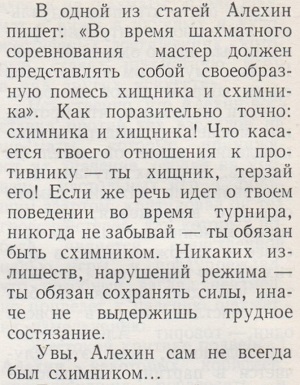
The English translation by K.P. Neat on page 16 of Alexander Alekhine (London, 1975):
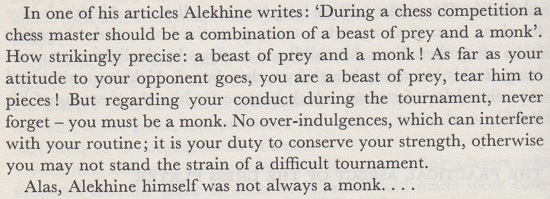
Kotov’s output on Alekhine is bestrewn with unsourced quotes. Regarding the one under discussion here, we have yet to find anything relevant in his two-volume work Shakhmatnoe Nasledie A.A. Alekhina (Moscow, 1953 and 1958).
(11062)
Pierre Bourget (Quebec, Canada) points out this pair of photographs of Alekhine and Bogoljubow, with Emanuel Lasker (Berlin, 1929):
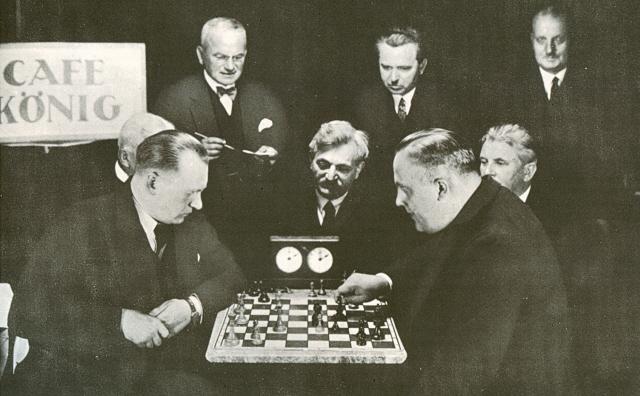
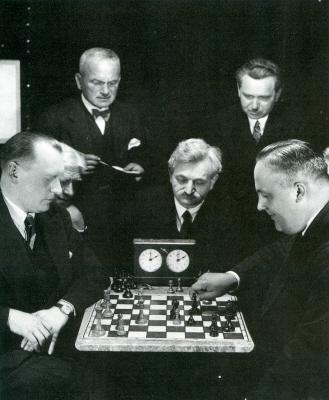
They were published respectively on page 75 of Umkämpfte Krone by R. Stolze (East Berlin, 1986) and page 51 of Schach 2000 Jahre Spiel-Geschichte by R. Finkenzeller, W. Ziehr and E.M. Bührer (Aarau, Stuttgart, 1989).
Can the other persons be named? The man standing on the left also appeared with Alekhine and Bogoljubow in a photograph on page 191 of Grandmasters of Chess by Harold C. Schonberg (Philadelphia and New York, 1972).
(5667)
Alan McGowan identifies the man standing on the right as Ehrhardt Post (1881-1947). We add below a photograph of Post from page 12 of the 1 January 1942 issue of Deutsche Schachblätter:
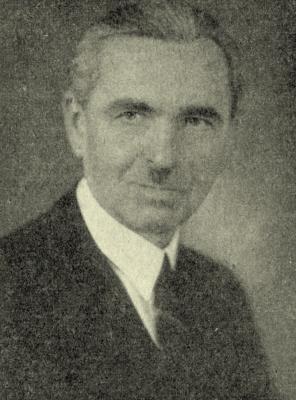
(5697)
from page 24 of Famous Chess Players by Peter Morris Lerner (Minneapolis, 1973):
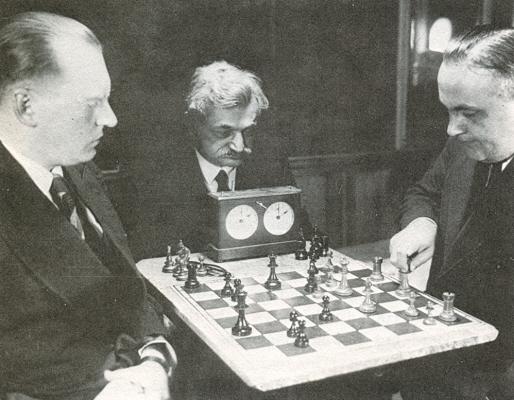
(6312)
Albert Silver (Rio de Janeiro, Brazil) points out some film
footage of the occasion, entitled ‘Campionato di scacchi
a Berlino’.
(7724)
C.N. 5667 referred to this photograph on page 191 of Grandmasters of Chess by Harold C. Schonberg (Philadelphia and New York, 1972), mentioning that the man behind the players remains nameless:
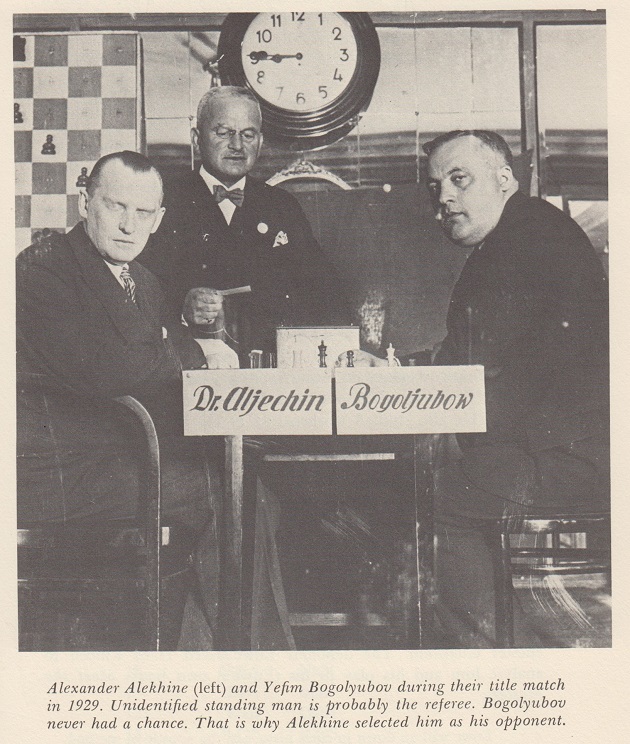
Page 8 credited the picture to Burt Hochberg. Although Alekhine’s eyes seem closed, it may be a matter of photographic exposure, given the following on page 79 of Umkämpfte Krone by Raymund Stolze (East Berlin, 1986):
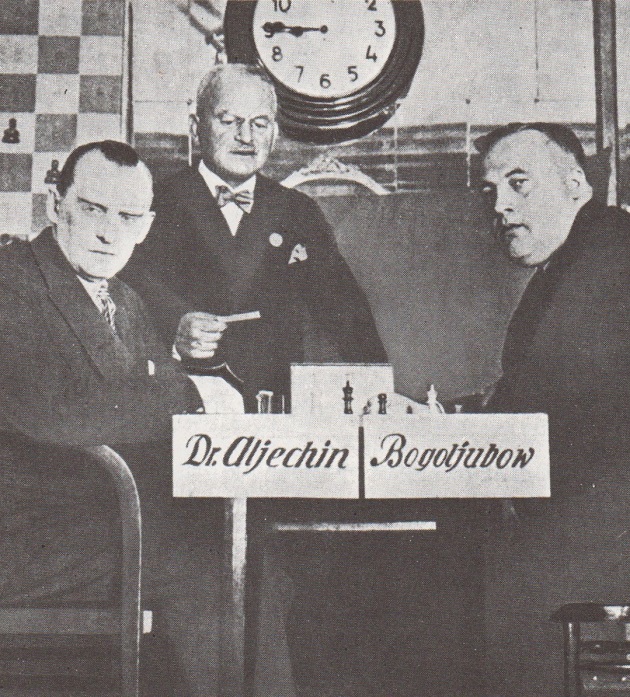
Can the position on the board and/or on the demonstration board be identified?
(11355)
On the basis of a more generously cropped version, Alan McGowan points out that the photograph under discussion shows the 12th match-game, played in Berlin on 11-12 October 1929:
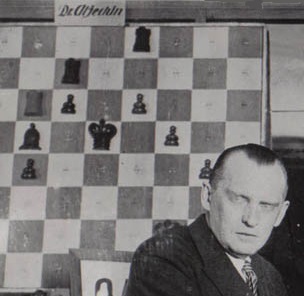
The pawn chain is white.
(11359)
Peter Anderberg (Harmstorf, Germany) identifies the man standing between Alekhine and Bogoljubow as P. Matzdorff, a board member of the Berliner Schachgesellschaft, as shown in this photograph on page 13 of Das internationale Schachmeisterturnier zur Hundertjahrfeier der Berliner Schachgesellschaft by Kurt Richter (Berlin, 1928):
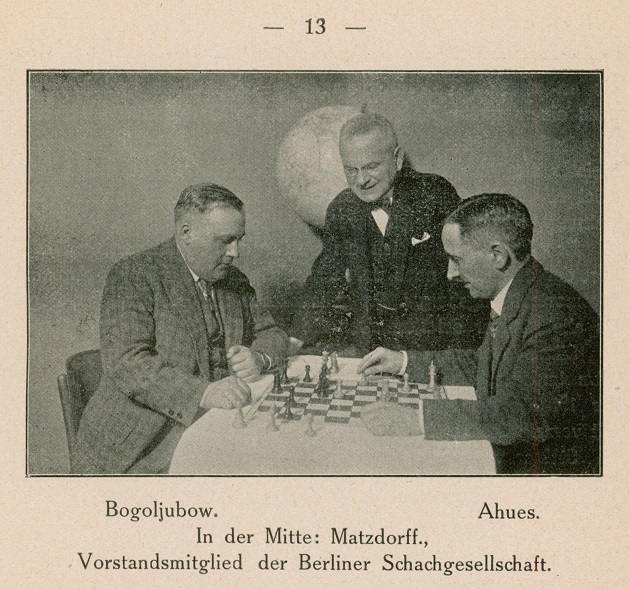
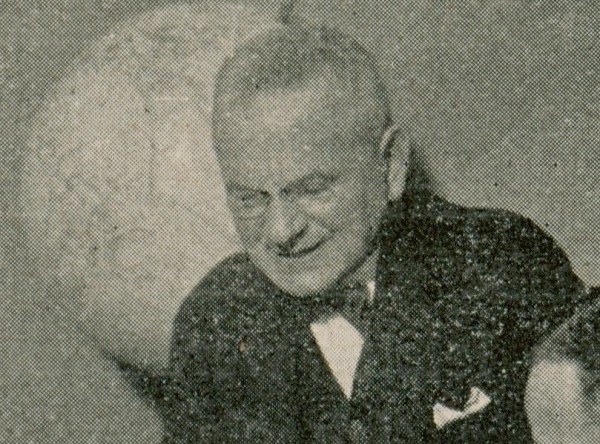
(11760)
Olimpiu G. Urcan notes the following from page 5 of Wiener Bilder, 20 October 1929:

At the end of the caption, the name is given as ‘Paul Mazdorf’.
(12157)
In C.N. 11756 a correspondent tentatively but incorrectly suggested that the person might have been Otto Conrad.
‘No world championship match ever produced a finer struggle than this.’
So wrote R.N. Coles on page 119 of Battles-Royal of the Chessboard (London, 1948), with regard to the 11th game of the 1929 Alekhine v Bogoljubow match. (He placed the game, a 63-move draw, in Wiesbaden instead of Heidelberg.)
Bogoljubow’s annotations were published on pages 408-410 of the December 1929 Kagans Neueste Schachnachrichten.
From page 170 of the November 1929 American Chess Bulletin:
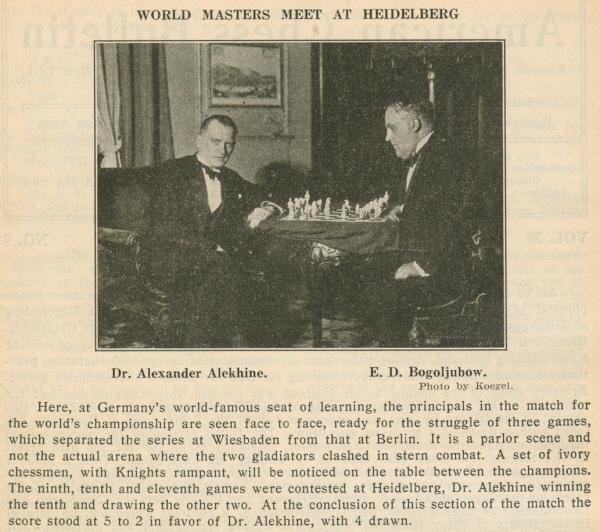
(6692)
From Olimpiu G. Urcan comes this photograph on page 643 of the Illustrated London News, 12 October 1929:
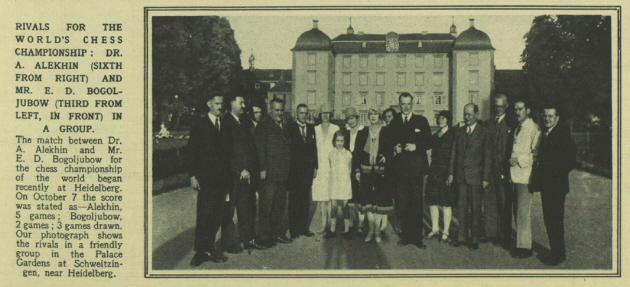
(7510)
Instances of surprisingly high praise are always welcome. Pages 63-64 of the December 1929 Chess Amateur introduced as follows Bogoljubow’s 71-move victory over Alekhine in the 14th game of that year’s world championship match:
‘One of the finest games we have ever published.’
(8654)
A news item on page 26 of the Chess Amateur, November 1928:
‘La Nation belge states that the Alekhine-Bogoljubow match will be played next May, starting at Bad Kissingen and continuing in India! The authority for these statements is dubious.’
What was the ‘authority’?
(9818)
Charles Sullivan asks about the game E. Znosko-Borovsky v A. Alekhine, St Petersburg, 27 January 1914, as given on pages 92-93 of the Skinner/Verhoeven volume on Alekhine.
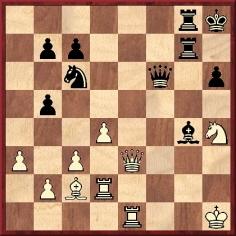
After 34 Rh2 Ne7 35 Ng2 Rg5, instead of 36 Be4 White could have won a piece with 36 Qxe7, and our correspondent therefore wonders whether the game-score is correct, and whether the move-order was perhaps 34...Rg5 35 Be4 Ne7 36 Ng2 c6.
Unable to trace the game-score in any 1914 source, we contacted Leonard Skinner (Cowbridge, Wales), who has kindly forwarded the earliest publication of the game known to him (as included in his book): Alekhine’s notes on pages 209-212 of Shakhmatny Vestnik, July 1915. The relevant phase is reproduced below:
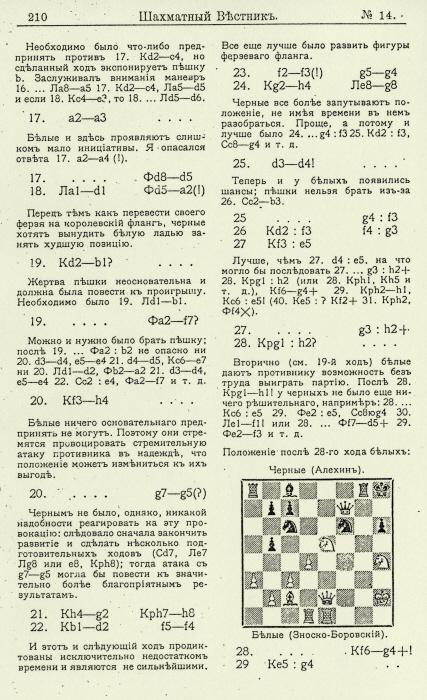
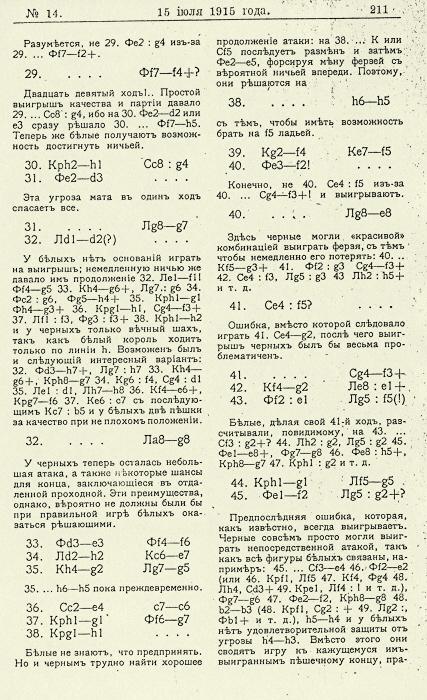
Given that the Skinner/Verhoeven book reproduced the game-score accurately, the question is whether an oversight occurred at the board at move 36 or whether Alekhine erred in the move-order which he submitted to the Russian periodical.
(5693)
From page 515 of Alexander Alekhine’s Chess Games, 1902-1946 by Leonard M. Skinner and Robert G.P. Verhoeven (Jefferson, 1998):
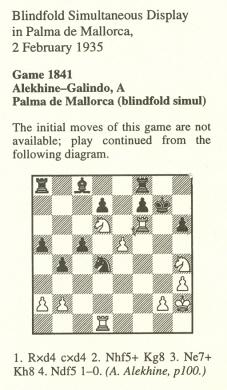
The source indicated (A. Alekhine) is the English-language edition of Pablo Morán’s monograph (Jefferson, 1989).
Andrés Vicente Sanz (Valencia, Spain) has sent us the complete game as published on page 3 of El Mundo Deportivo, 7 February 1935:
Alexander Alekhine – A. Galindo
Blindfold exhibition, Palma de Mallorca, 2 February 1935
Ruy López
1 e4 e5 2 Nf3 Nc6 3 Bb5 Bc5 4 c3 Nf6 5 d4 exd4 6 e5 Nd5 7 cxd4 Bb4+ 8 Bd2 Bxd2+ 9 Qxd2 Nce7 10 Nc3 c6 11 Bc4 b5 12 Bb3 O-O 13 Ne4 Ng6 14 Nd6 Qe7 15 O-O Qe6 16 h3 Ngf4 17 Bxd5 Nxd5 18 Ng5 Qg6 19 f4 h6 20 Nf3 a5
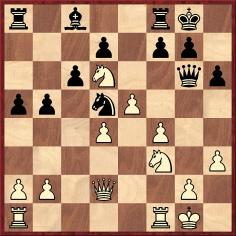
21 f5 Qg3 22 f6 Qf4 23 fxg7 Kxg7 24 Qxf4 Nxf4 25 Nh4 Ne2+ 26 Kh2 Nxd4 27 Rf6 b4 28 Rd1 c5 29 Rxd4 cxd4 30 Nhf5+ Resigns.
(6390)
Lilienthal never defeated Alekhine in a tournament but was successful against him in blitz play. Since confusion sometimes arises over the matter, we reproduce the account provided by Lilienthal on page 24 of his autobiographical work Életem, a sakk (Budapest, 1985):
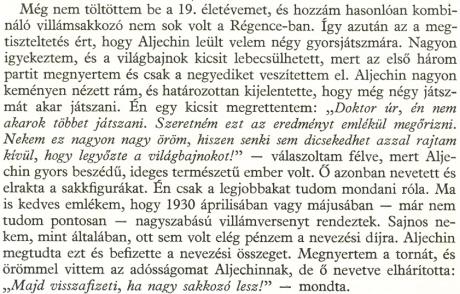
Below is the German translation, from pages 19-20 of Schach war mein Leben (Thun, Frankfurt/Main, 1988):
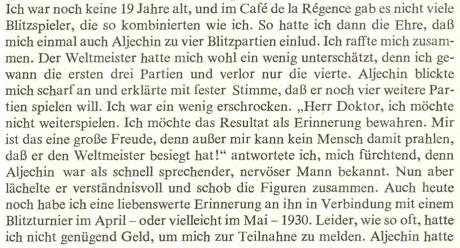

(6570)
As noted on page 629 of the Skinner/Verhoeven volume on Alekhine’s games, Louis Zollner was aged 84 when he defeated the world champion in a simultaneous display in Newcastle on 24 September 1938. The game, in which Alekhine played the Evans Gambit, was taken from page 102 of CHESS, 14 November 1938, where it was part of a seven-page feature on Zollner. Regarding his victory, in 30 moves, Zollner commented: ‘This must be my farewell effort, I fear.’
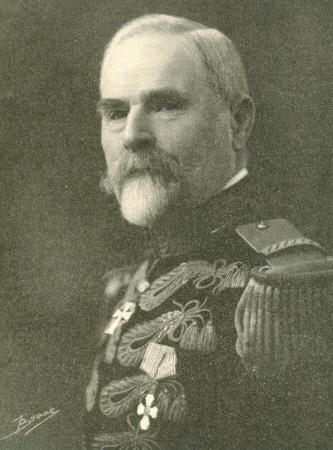
Louis Zollner (1854-1945). Source: CHESS, 14 November 1938, page 99.
(6607)
From pages 109-110 of Shostakovich A Life by Laurel E. Fay (Oxford, 2000):
‘Chess was chiefly a youthful infatuation; although he followed match play, he was never as serious a competitor as Prokofiev or David Oistrakh. In old age one of the favourite yarns he liked to retell was how, as a callow teenager, he had challenged and lost to Alexander Alekhine, something which could have taken place only before the future world champion left Russia for good in the spring of 1921.’
The source for this information is given on page 310:
‘M. Dolgopolov, “Budem znakomï – Alekhin ...”, Izvestiya, 17 August 1974, 5. Among others who recall hearing the composer recount versions of this story are Yevgeniy Dolmatovsky and Mstislav Rostropovich.’
A photograph of Shostakovich at the chessboard was given on page 354 of the November 1946 BCM:
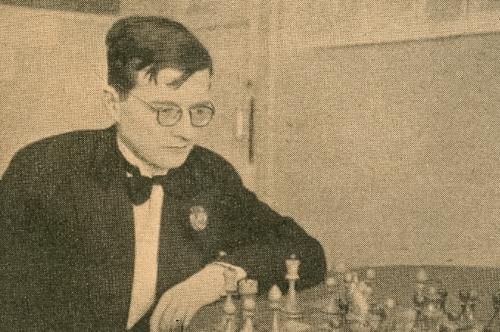
(6656)
Marcelo Sibille (Montevideo, Uruguay) mentions that a longer account of the meeting between Shostakovich and Alekhine is to be found on pages 396-397 of another biography, published in 1997: Shostakovich Su vida, su obra, su época by Krzysztof Meyer, the source specified being an article by M. Dolgopolov in the 6/1975 issue of Sputnik.
We see no reference to Alekhine in an earlier edition of Meyer’s book, in Polish, Szostakowicz (Cracow, 1973), but the story can be found in the later editions in French and German: on pages 476-477 of Dimitri Chostakovitch (Paris, 1994) and pages 477-478 of Schostakowitsch Sein Leben, sein Werk, seine Zeit (Mainz, 2008).
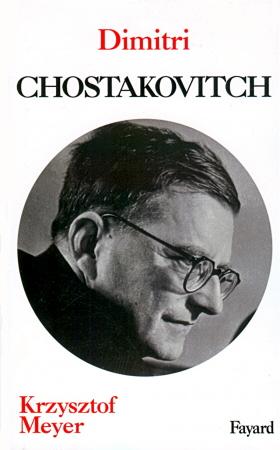
No English translation of Meyer’s book is known to us, but we have procured a copy of the English edition of the June 1975 Sputnik (‘Digest of Soviet Press’). Below is the article by Mikhail Dolgopolov on Shostakovich and Alekhine, from pages 105-107:

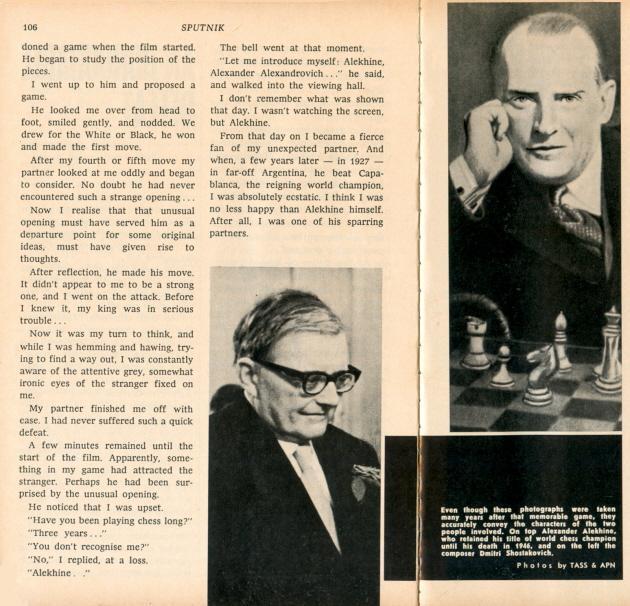
(7079)
Gloria Martín and Javier Boldó (Santa Cruz de Tenerife, Canary Islands, Spain) possess two pictures inscribed by Alekhine:
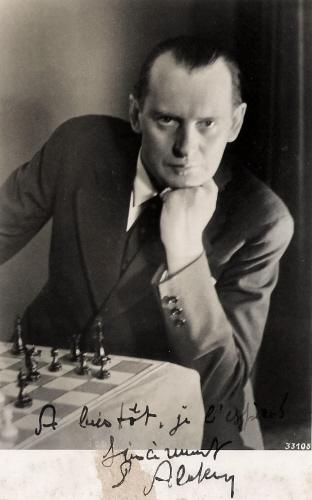
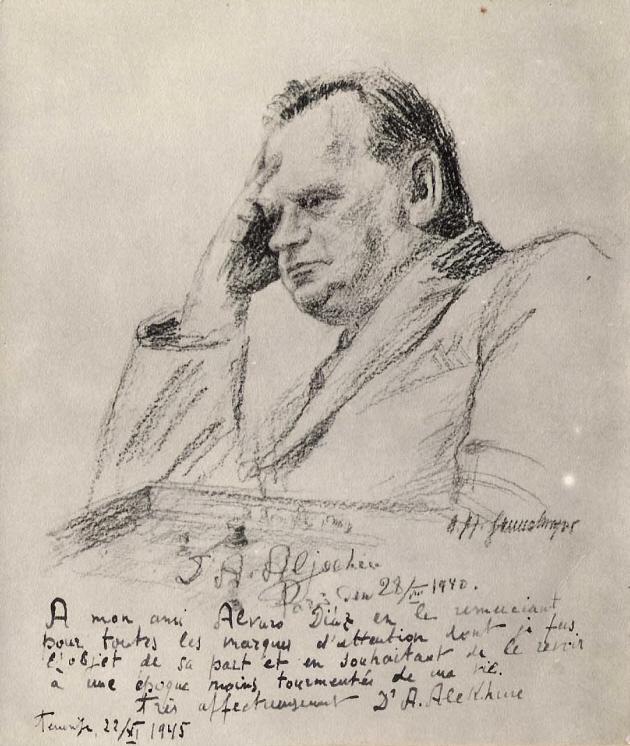
The second item (with Alekhine’s inscription, written a few months before he died, on a photograph of a sketch made five years previously) is of particular interest. The warm dedication is to Alvaro Díaz, whom Alekhine thanks for his many kindnesses, adding that he hopes to see Díaz again at a less turbulent time in his life.
(6672)
One of Euwe’s most famous wins is the ‘Pearl of Zandvoort’, the 26th game of his 1935 world title match against Alekhine. See, for instance, page 150 of Euwe’s From My Games 1920-1937 (London, 1938) and such well-known books as Wellmuth’s The Golden Treasury of Chess, Fine’s The World’s Great Chess Games and Schonberg’s Grandmasters of Chess. Various chess encyclopaedias (e.g. by Sunnucks, Golombek and Brace) have an entry for the ‘Pearl of Zandvoort’, and it is, in short, a matter on which no half-competent writer would go wrong.
From page 158 of The Big Book of Chess by Eric Schiller (New York, 2006):

The Euwe win given by Schiller as the ‘Pearl of Zandvoort’ was played in Amsterdam.
(6683)
Page 33 of The World Champions Teach Chess compiled by Y. Estrin and I. Romanov (London, 1988) quoted a comment by Nimzowitsch after Alekhine’s triumphs at San Remo, 1930 and Bled, 1931:
‘He makes short work of us as if we were little chickens.’
We are unaware of a Russian edition of the book, but the German version, Weltmeister lehren Schach (Hollfeld/Obfr., 1985), had put the following:
‘Er legt uns wie Grünschnäbel um.’
The most direct translation of Grünschnäbel is ‘greenhorns’ or, possibly, ‘whippersnappers’.
Nimzowitsch’s remark was quoted by Hans Kmoch in an article on Alekhine at the Chess Café:
‘At Bled, Alekhine’s superiority drove the proud Nimzowitsch to despair. When he resigned to the world champion after only 19 moves he was near tears. “It’s incredible”, he complained. “Only a few years ago we were all about equal”, he said, referring to the chess elite of that time, “but now he treats us like patzers.”’
Kmoch was present at the Bled, 1931 tournament. Page 53 of the English edition (Yorklyn, 1987) of his book on the event, translated by Jimmy Adams, had the following text in the introduction to the round in which the Alekhine v Nimzowitsch game was played:
‘Nimzowitsch could not recover from his astonishment. After taking both pawns, he left the board and, shaking his head, repeated several times, “He is treating us like patzers.”’
The words ‘He is treating us like patzers’ were also quoted, by Flohr, on pages viii-ix of the English book, in a 1976 article translated from 64.
The original edition of the Bled, 1931 tournament book (Leningrad, 1934) was a translation of Kmoch’s unpublished German text, which may or may not be extant. Below is the relevant passage, from page 53:
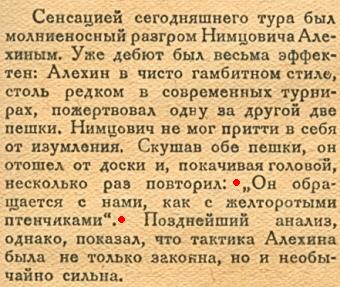
‘Он обращается с нами, как с желторотыми птенчиками.’
A literal rendering is ‘He treats us like yellow-beaked fledglings’. The term ‘yellow-beaked’ in Russian means young and inexperienced.
It is hoped that other sightings of the Nimzowitsch quote can be found. The unsatisfactory situation at present is that we have Estrin’s text in German but not the original Russian and Kmoch’s text in Russian but not the original German.
(6684)
On pages 67-69 of the March 1932 issue of Kagans Neueste Schachnachrichten Nimzowitsch wrote an article about whether his third place at Bled, 1931 (after Alekhine and Bogoljubow) was to be regarded as a relative failure:
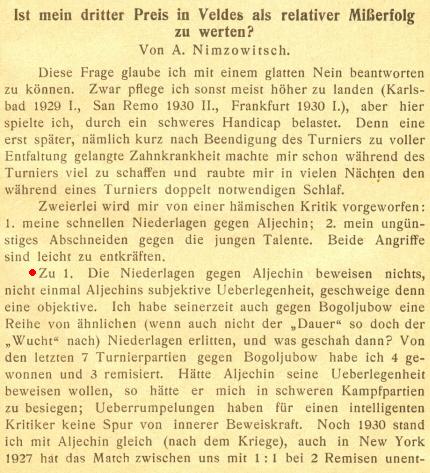
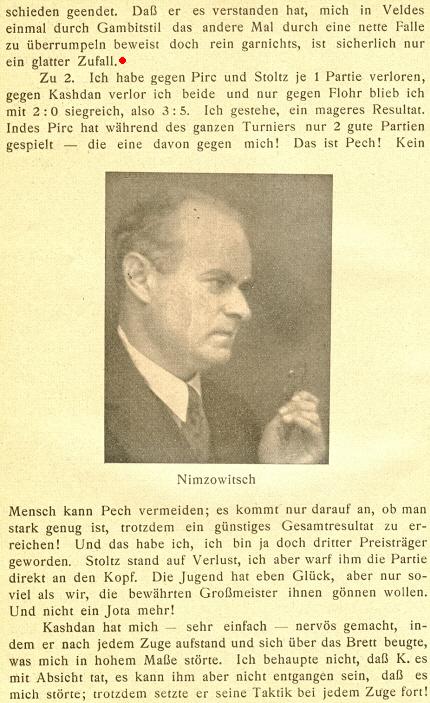
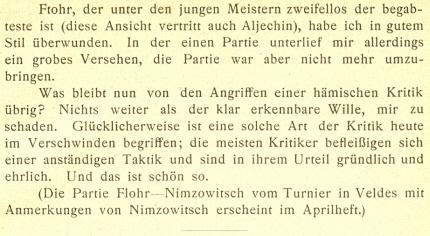
In the passage marked with red Nimzowitsch states that his two defeats against Alekhine prove nothing. He mentions that although at one time he suffered a series of defeats against Bogoljubow, his latest score against him in tournament games is four wins, three draws and no losses. Nimzowitsch adds that as recently as 1930 (presumably 1920, since he also writes ‘after the War’) he stood equal with Alekhine; moreover, he had a tied result in his games with him at New York, 1927. Nimzowitsch’s conclusion is that Alekhine, to demonstrate his superiority, would have to defeat him in hard battles, whereas his two victories over him in the Bled tournament, one in gambit style and the other by catching him out with a pretty trap, proved absolutely nothing and were certainly pure chance.
(6695)
A passage from an article by Roberto Grau on San Remo, 1930 was quoted in C.N. 1041:
‘When Alekhine beat Nimzowitsch in such masterly style the first to congratulate him was the defeated man himself. This gesture by the aggressive Nimzowitsch is a token of his admiration for his opponent’s skill, and as he rose from the board he said in a loud voice, “Alekhine plays phenomenally”.’
Source: El Ajedrez Americano, March 1930, pages 66-69.
(7180)
Wanted: substantiation of this ‘once’ quotation:
‘Alekhine once said, “There must be no reasoning from past moves, only from the present position”.’
Source: The Golden Dozen by Irving Chernev (Oxford, 1976), page 260.
(6704)
Dan Scoones refers to comments by Alekhine in his 1938 radio interview (see C.N. 5838): ‘Look forward all the time is the thing to do.’ ... ‘I never look back on a game or a match but try all the time to see how I may improve my play.’
From Dominique Thimognier comes an article ‘Ce que nous disait Alekhine!’ by Louis Betbeder, which was published in a brochure for the 1967 French championship. One piece of advice by Alekhine (in Betbeder’s reported speech and under the heading ‘Objectivité du jugement’) was:
‘Savoir si l’on est mieux que l’adversaire est, par conséquent, essentiel; se poser très souvent la question, en particulier pendant qu’il réfléchit. Juger surtout une position en oubliant complètement l’histoire de la partie et en ne considérant que la géographie, c’est-à-dire le diagramme actuel.’
(6720)
From Steve Wrinn:
‘C.N.s 6704 and 6720 discussed the claim by Chernev that Alekhine “once” stated, “There must be no reasoning from past moves, only from the present position”.
There is a good example of this view, expressed in Alekhine’s own words, in his comments on a note by Euwe in game 19 of their 1937 world championship match, on pages 134-135 of Alekhine’s book The World’s Chess Championship 1937 (London, 1938).
Euwe was White, and play went 13 Re1 Nb4 14 Bb5+ Kf8 15 Qe2 Bc5
16 Nd1. Having played 13 Rf1-e1, Euwe rejected 16 Re1-f1 and wrote:
“Of course not 16 R-B1, as this would admit something that was not true, namely, that 13 R-K1 was a mistake.”
Alekhine then added his own comment:
“An interesting remark, important for the comprehension of Dr Euwe’s chess personality; he simply does not want to admit that at the 16th move the best policy may be to return with the rook to KB1, and this solely because at the 13th move this rook went from KB1 to K1. For my part I confess that if I had White I would be satisfied with the fact that my 13th move had forced my opponent to lose the power to castle; and that I would have made my choice only on the basis of a close examination of the respective value of the moves possible – not taking into account which squares the corresponding pieces had occupied a few moves earlier. As a matter of fact it appears that 16 R-B1 would have been the simpler alternative; for in that case 16...B-B4 would have led to nothing after 17 P-QR3 Kt-B7 18 R-Kt1.”
So in this case a “once” quotation at least approaches the truth – for once.’
(7232)
Pages 14-15 of 100 Classics of the Chessboard by A.S.M. Dickins and H. Ebert (Oxford, 1983) gave Alekhine v Sämisch, Berlin, 1923 under the heading ‘The Classic Blindfold Game’. The co-authors claimed:
‘Happening to meet in Berlin, the two players decided to take the opportunity of playing each other blindfold, creating as a result this astonishing brilliancy.’
The book added that Sämisch called Alekhine’s victory ‘the most brilliant game I have ever seen’. The moves: 1 e4 c5 2 Nf3 Nc6 3 Be2 e6 4 O-O d6 5 d4 cxd4 6 Nxd4 Nf6 7 Bf3 Ne5 8 c4 Nxf3+ 9 Qxf3 Be7 10 Nc3 O-O 11 b3 Nd7 12 Bb2 Bf6 13 Rad1 a6 14 Qg3 Qc7 15 Kh1 Rd8 16 f4 b6 17 f5 Be5 18 fxe6 Bxg3 19 exf7+ Kh8 20 Nd5 Resigns.
It is one of Alekhine’s most spectacular miniatures, number 97 in his first collection of Best Games (London, 1927). The heading was ‘Exhibition Game played at Berlin, February 1923’. The book did not suggest that either master was blindfold. Nor did the German translation, Meine besten Partien 1908-1923 (Berlin and Leipzig, 1929), although we have one later edition in German (Berlin, 1983), which states ‘Beiderseits ohne Ansicht des Brettes’. Various editions of the book Meisterspiele by Rudolf Teschner say that both players were without sight of the board, and Sämisch’s praise of Alekhine is quoted:
‘“Die genialste Partie, die ich je gesehen habe”, äußerte Sämisch voll Bewunderung für seinen Gegner.’
As shown below, Tartakower cited Sämisch when he published the game (a ‘Gastkampf’ , which Tartakower dated 1921, instead of 1923, with no intimation of blindfold play but with an additional move at the end) on page 276 of Die hypermoderne Schachpartie (Vienna, 1924):
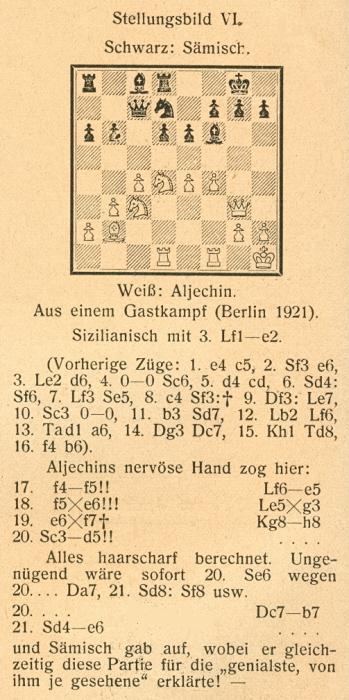
January, rather than February, 1923 was specified when the game appeared on pages 218-219 of the second volume of Complete Games of Alekhine by V. Fiala and J. Kalendovský (Olomouc, 1996). The co-authors asserted that the game was first published on page 16 of the Observer, 4 March 1923. In neither that volume nor in the Skinner/Verhoeven book on Alekhine (see page 184) was it suggested that Alekhine or Sämisch played the game blindfold. Moreover, the score was not included in Blindfold Chess by E. Hearst and J. Knott (Jefferson, 2009).
The brilliancy is absent from all the chess magazines of 1923 that we have consulted so far.
(6741)
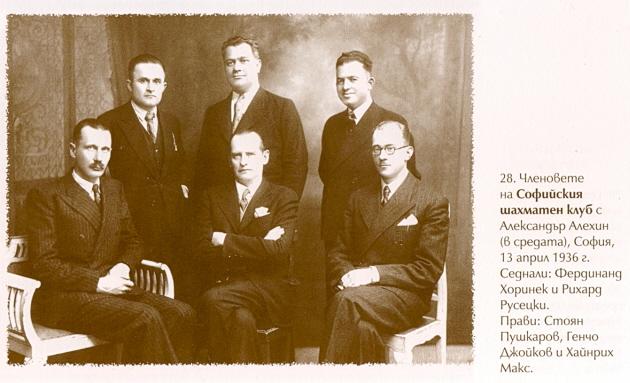
This group shot featuring Alekhine (Sofia, 13 April 1936) comes from Bulgarskiyat shakhmat v snimki by S. Sergiev (Sofia, 2006). The book has, in all, 684 pictures, running through to the Topalov era, and can be ordered from Karel Mokrý’s chess bookshop (which was warmly recommended in C.N. 4737).
(6749)
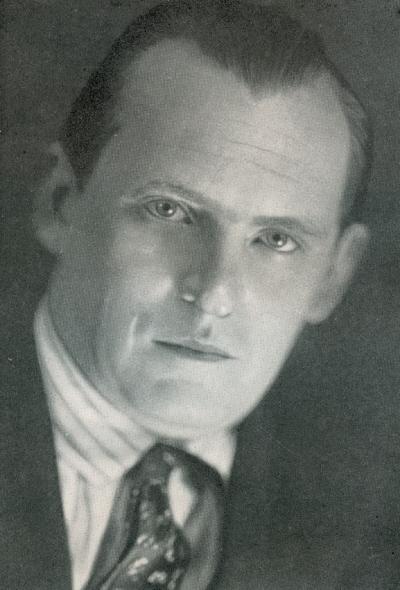
This photograph of Alexander Alekhine is surprisingly little-known, even though it was the frontispiece of his book Meine besten Partien (1908-1923), published by Walter de Gruyter & Co., Berlin and Leipzig in 1929.
(6754)
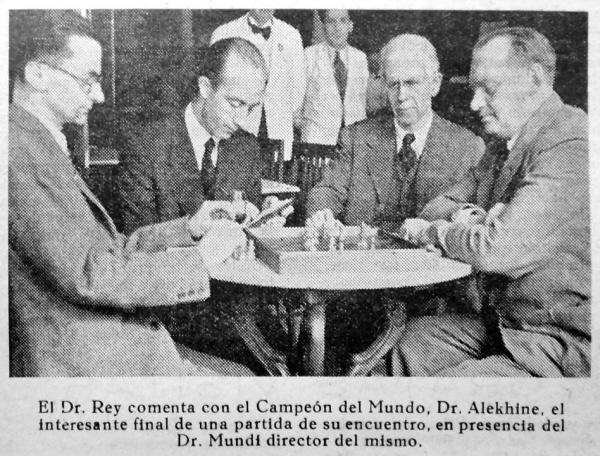
Eduardo Bauzá Mercére (New York, NY, USA) has provided the above photograph from the Alekhine v Rey Ardid match in Saragossa, 1944. He reports:
‘It appeared in the bulletin of rounds 8-9 of the 1957 Spanish championship (27-28 October), also played in Saragossa.’
(6828)
Jan Kalendovský has sent us from the archives of the city of Pilsen (Plzen) an application by the association of Czech chessplayers of the West Bohemian sector for an exception to be made to the general ban on meetings, so that Alekhine could give a 35-board simultaneous exhibition on 1 February 1943:
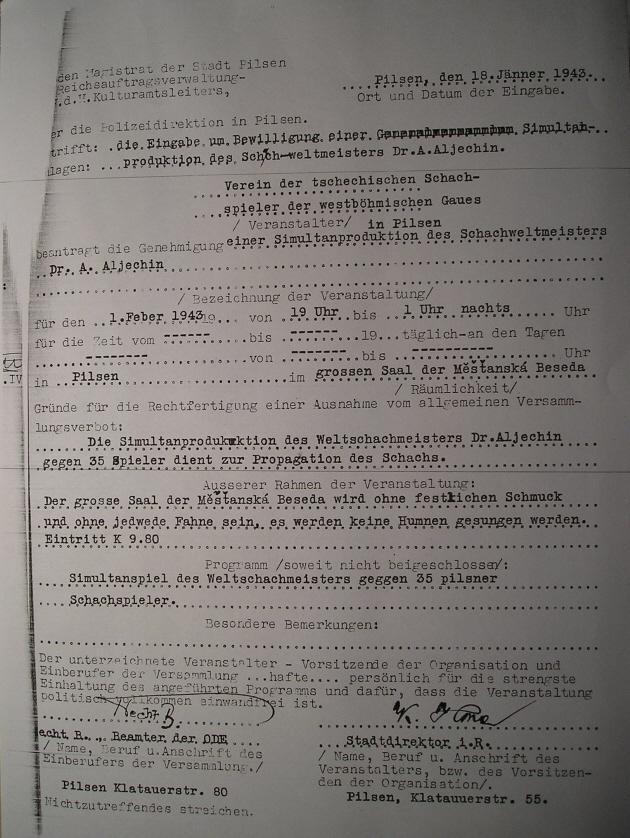
The application was accepted, the display took place, and two games are given on page 697 of the Skinner/Verhoeven book on Alekhine.
(6860)
Jan Kalendovský has sent us, courtesy of Miloslav Míc, a photograph which was taken during the simultaneous display by Alekhine discussed in C.N. 6860 (Pilsen/Plzen, 1 February 1943):
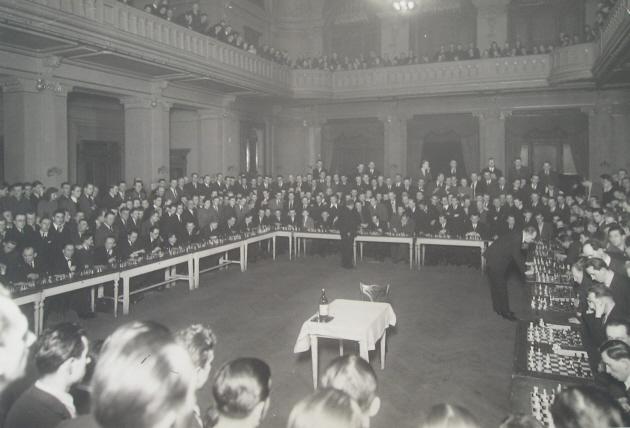
(6885)
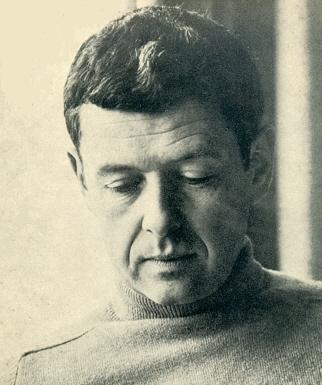
This photograph of James Whitfield Ellison comes from the dust-jacket of his chess novel Master Prim (London, 1968).
Pages 189-198 included a 29-move game between Julian Prim and Eugene Berlin, and that part of the story was reproduced on pages 143-146 of A Book of Chess by C.H.O’D. Alexander (London, 1973). Alexander did not identify the game, which was Alekhine v Sterk, Budapest, 1921.
C.N. 2830 (see pages 2-3 of Chess Facts and Fables) discussed that brilliancy prize game, noting that Alekhine’s first volume of Best Games contracted it by one move.
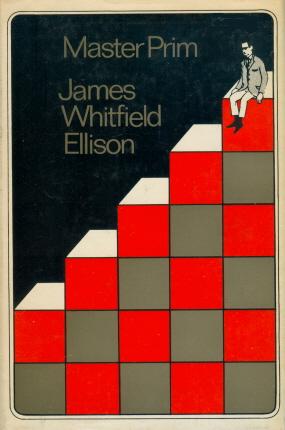
(6934)
From Oliver Beck:
‘While observing a game of chess, a character in Stefan Zweig’s Schachnovelle (Buenos Aires, 1942) points out its similarity to Alekhine v Bogoljubow, Bad Pistyan, 1922. In fact, beginning with 38...Kh7 the game described in Zweig’s novella appears identical to that game.
I find it interesting that Zweig was inspired to use the Alekhine v Bogoljubow game as a model, and I wonder what his source for this game might have been. There appears to be no obvious connection between the text on pages 33-37 of the Suhrkamp Verlag edition ofSchachnovelle (Frankfurt, 2001) and the game’s annotations found on either page 139 of the tournament book or pages 84-85 of Tartakower’s Die hypermoderne Schachpartie.
Zweig’s source may have been another book of collected games. We learn that the aforementioned character had become familiar with this game through his study of “ein Schachrepetitorium, eine Sammlung von hundertfünfzig Meisterpartien” (page 64), and in a letter written in Petrópolis, Brazil on 29 September 1941 and quoted on page 111 of Siegfried Unseld’s afterword, Zweig writes:
“... habe eine kleine Schachnovelle entworfen, angeregt davon, daß ich mir für die Abgeschiedenheit ein Schachbuch gekauft habe und täglich die Partien der großen Meister nachspiele.”
Can a likely source be identified?’
The matter was discussed in detail in an article ‘Stefan Zweig Schachspieler’ by Egbert Meissenburg on pages 20-28 of 65 Jahre Schachnovelle edited by S. Poldauf and A. Saremba (Berlin, 2007):
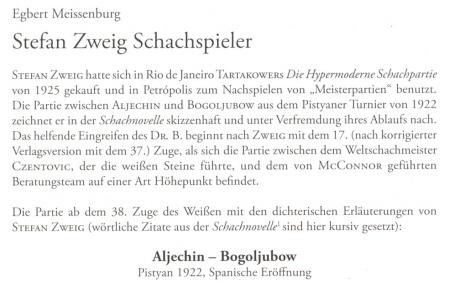
(6940)
On page 208 of Combinations The Heart of Chess (New York, 1960) Irving Chernev wrote of Alekhine:
‘His contributions to chess theory are of such importance as to justify saying, “The openings consist of Alekhine’s games with a few variations”.’
The identical words are on page 251 of Chernev’s book The Golden Dozen (Oxford, 1976).
Had the sentiments in double quotation marks been expressed by someone else before 1960 or can they legitimately be attributed to Chernev?
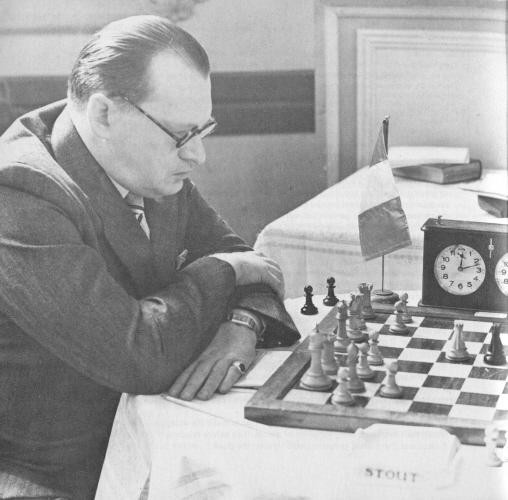
This fine photograph of Alekhine is from page 250 of The Golden Dozen. It is not difficult to identify the game in progress, but a clue is offered: Alekhine’s opponent was discussed in C.N. 3809.
(6945)
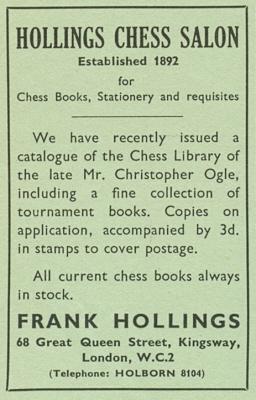
This advertisement on an inside cover page of the October 1956 BCM states that the Hollings Chess Salon was established in 1892, but we are also intrigued by the reference to ‘a catalogue of the Chess Library of the late Mr Christopher Ogle’. Does any reader have a copy of that catalogue?
Our interest in Ogle was prompted many years ago by the well-known anecdote regarding London, 1922, and for ease of reference C.N. 3083 is reproduced here:
If chess literature is to feature anecdotes, let them at least have a point. One story, set during the London, 1922 tournament, which has some purpose was related by David Hooper in the Capablanca entry of Anne Sunnucks’ Encyclopaedia of Chess:
‘These two rivals [Capablanca and Alekhine] were taken to a variety show by a patron, Mr Ogle, who recalled that Capablanca never took his eyes off the chorus, whilst Alekhine never looked up from his pocket chess set.’
In the first edition of The Oxford Companion to Chess (the Alekhine entry) the patron was named in full as Christopher Ogle, and in at least one other modern outlet he has been described as a ‘chess patron’. That remains to be demonstrated, but our particular interest is in knowing the source of the Ogle/ogling recollection and whether there are further reminiscences from London, 1922.
(6956)
Game 43 in Alekhine’s first volume of Best Games,against ‘M. Prat’, was described as ‘one of 20 simultaneous games played at Paris, September 1913’. The book was published in 1927; the German and Dutch editions brought out in 1929 identified Black as ‘J. Prat’ and did not stipulate the number of games in the exhibition. On the other hand, Deux cents parties d’échecs (Rouen, 1936) said that it was a 20-board display and that Black was ‘N. Prat’.
La Stratégie (October 1913, page 415) gave only the conclusion of the game and did not offer corroboration of Alekhine’s later statement that after Black’s 21st move he announced mate in ten:
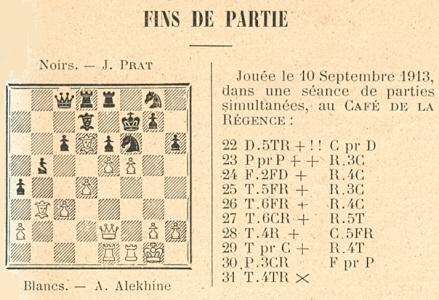
As regards the number of players, 16 was the figure specified on page 360 of the September 1913 issue of the French magazine:
‘Le 10 septembre, également à La Régence, M. Alekhine conduit simultanément seize parties; avec une rapidité surprenante, il obtient le brillant résultat de quinze gagnées et une seule perdue contre M. le Dr de Hayes.’
(7040)
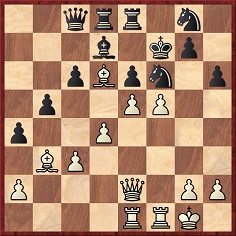
White announced mate in ten: 22 Qh5+ Nxh5 23 fxe6+ Kg6 24 Bc2+ Kg5 25 Rf5+ Kg6 26 Rf6+ Kg5 27 Rg6+ Kh4 28 Re4+ Nf4 29 Rxf4+ Kh5 30 g3 any 31 Rh4 mate.
C.N. 7040 discussed discrepancies surrounding this famous Alekhine victory, and more are added now.
As regards Black’s identity, we have never seen a full name, but only ‘Prat’, with or without an initial. Our earlier item pointed out that in the English, German/Dutch and French editions of Alekhine’s first Best Games book the initial was given as M., J. and N. respectively. A fourth option, I., is in the Russian edition (Moscow and Leningrad, 1927). Although ‘M. Prat’ is the most common version, a misunderstanding may have arisen through M. being an abbreviation for Monsieur (as discussed, in another context, in C.N. 6693).‘J. Prat’ was the name when the 22 Qh5+ finish was published on page 415 of La Stratégie, October 1913 (reproduced in C.N. 7040). The earliest occurrence of the full game-score that we can cite is on pages 286-287 of Shakhmatny Vestnik, 15 September 1913, shown here courtesy of the Royal Library in The Hague:
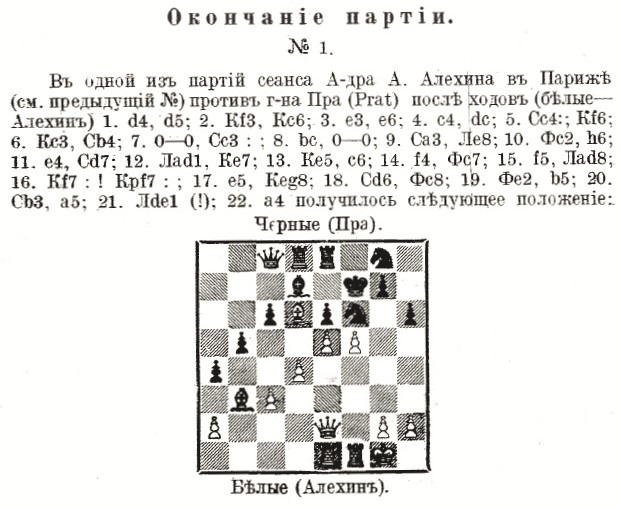

The heading stated that Alekhine played ‘against Mr Prat’; г-на is an abbreviation of the genitive singular form Господина (‘Mr’).
The Royal Library has also kindly provided the item on page 273 of the 1 September 1913 edition of Shakhmatny Vestnik to which the 15 September issue referred:
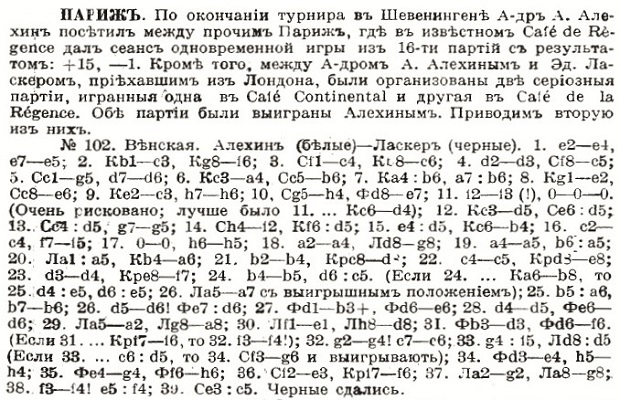
The report that Alekhine’s exhibition in Paris comprised 16 games (+15 –0 =1) corresponds to the information on page 360 of La Stratégie, September 1913:
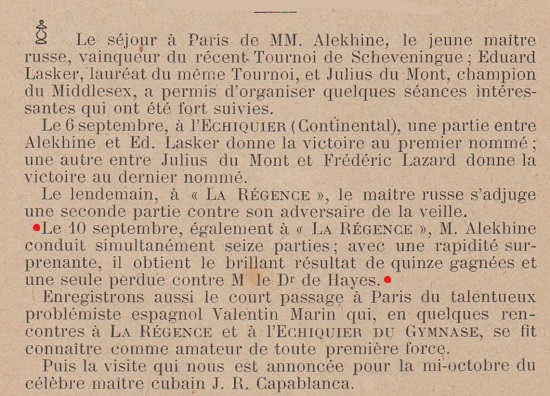
As previously shown, page 415 of the October 1913 issue of La Stratégie also gave the date of the display as 10 September 1913. The fact that the above issue of Shakhmatny Vestnik was, formally at least, dated 1 September is not a stumbling-block, given the 13-day difference between the Julian and Gregorian calendars and the inclusion of Alekhine’s game against Edward Lasker, played on 7 September. It is, though, unclear why ‘August 1913’ was in the heading to the Prat game on page 119 of volume one of Complete Games of Alekhine by J. Kalendovský and V. Fiala (Olomouc, 1992). Page 87 of Alexander Alekhine’s Chess Games, 1902-1946 by L.M. Skinner and R.G.P. Verhoeven (Jefferson, 1998) put only ‘1913’ (and ‘J. Prat’), but the previous page duly referred to the 16-board display on 10 September 1913.
Although page 192 of Capablanca-Magazine, 15 November 1913 also dated the game ‘10 September 1913’, there was a mysterious assertion that it was played in ‘Carisban, Russia’:
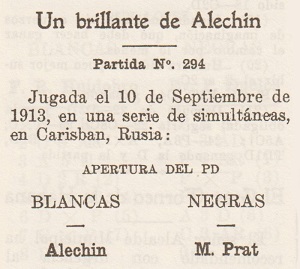
The English and French editions of Alekhine’s first Best Games book stated that the simultaneous display consisted of 20 games, which contradicts the reports in Shakhmatny Vestnik and La Stratégie. Below are the headings in the various editions of Alekhine’s book, in chronological order of publication (London, 1927; Moscow and Leningrad, 1927; Berlin and Leipzig, 1929; The Hague, 1929; Rouen, 1936):
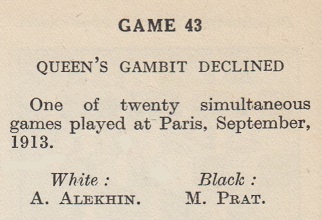
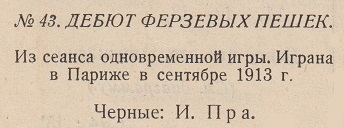
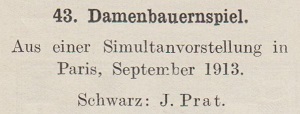

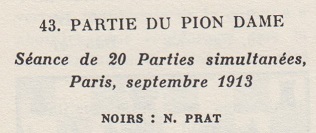
All these books recorded that the game began 1 d4 d5 2 Nf3 Nc6 3 c4 e6 4 Nc3 dxc4 5 e3 Nf6 6 Bxc4, whereas Shakhmatny Vestnik and Capablanca-Magazine had 1 d4 d5 2 Nf3 Nc6 3 e3 e6 4 c4 dxc4 5 Bxc4 Nf6 6 Nc3. The latter order is not among the five versions of the game in FatBase 2000, although the CD included 1 d4 d5 2 Nf3 Nf6 3 c4 e6 4 Nc3 dxc4 5 e3 Nc6 6 Bxc4.
The lengthiest coverage of Alekhine v Prat that we have seen is on pages 199-215 of How to Think Ahead in Chess by I.A. Horowitz and Fred Reinfeld (New York, 1951). The worst treatment is on page 308 of The Games of Alekhine by Rogelio Caparrós and Peter Lahde (Brentwood, 1992). Alekhine’s brilliant conclusion beginning with 22 Qh5+ was not even mentioned:
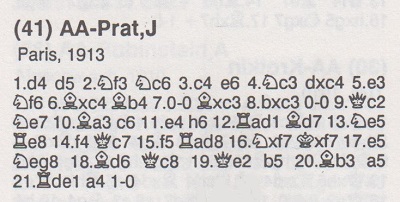
(10042)
C.N. 847 asked about the exact moves of the famous game Alekhine v Keres, Munich, 1942. After 1 d4 Nf6 2 Nf3 b6 3 c4 Bb7 4 g3 e6 5 Bg2 Be7 6 O-O O-O 7 b3 d5 8 Ne5 c6 9 Bb2 Nbd7 10 Nd2 ...
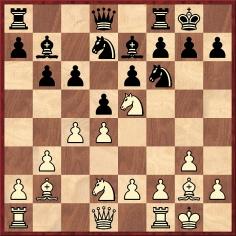
... the question posed was whether play went 10...c5 11 e3 Rc8 12 Rc1 Rc7 (Gran Ajedrez, 107 Great Chess Battles, Alekhine’s Best Games of Chess 1938-45) or 10...Rc8 11 Rc1 c5 12 e3 Rc7 (books on Alekhine by Kotov and Müller/Pawelczak).
On page 268 of Chess Explorations we remarked that when annotating the game on pages 143-144 of the 1 October 1942 issue of Deutsche Schachblätter Alekhine gave 10...Rc8 11 Rc1 c5, contrary to the move order in his (posthumous) book Gran Ajedrez. Moreover, in the German magazine Alekhine stated that the opening moves were 1 Nf3 Nf6 2 c4 b6 3 d4 Bb7, whereas Gran Ajedrez indicated 1 d4 Nf6 2 Nf3 b6 3 c4 Bb7.
This photograph of Alekhine and Keres was taken a few months earlier, at Salzburg, 1942:
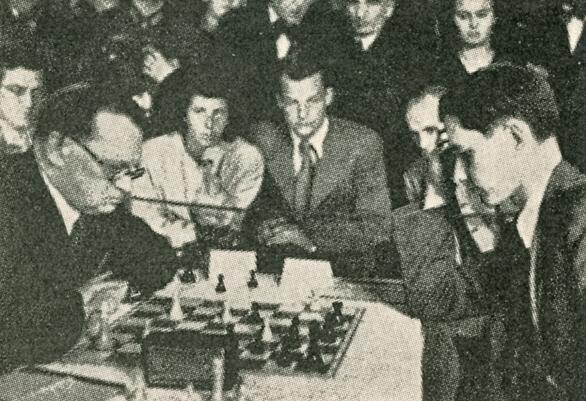
Source: Alt om Skak by B. Nielsen (Odense, 1943), page 273.
(7055)
From Javier Asturiano Molina:
‘Page 140 of the October 1942 Deutsche Schachzeitung gave the opening moves as 1 Nf3 Nf6 2 c4 b6 3 d4 Bb7, and the later sequence as 10...Rc8 11 Rc1 c5 12 e3 Rc7. The same version was provided by Ramón Rey Ardid when he annotated the game on pages 285-286 of Ajedrez Español, October-November 1942.’
(7073)
From page 376 of the 14 July 1938 issue of CHESS:
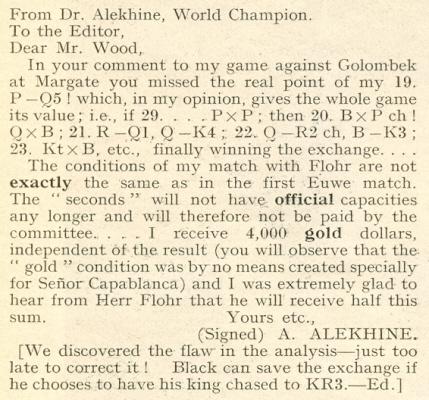
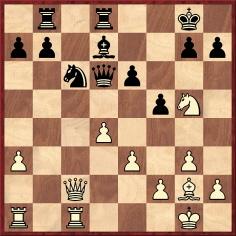
The position in the Alekhine v Golombek game (before 19 d5) had been given on page 360 of the 14 June 1938 CHESS, with this note:
‘Black might well have tried capturing the pawn, e.g. 19...PxP 20 R-Q1 Kt-K2 21 P-K4?! P-KR3 with some freedom.’
On the same page CHESS indicated the time taken on the game: one hour by White and two hours by Black.
Alekhine’s remark on the projected match with Flohr was in response to this paragraph on page 337 of the 14 June 1938 CHESS:
‘Dr Alekhine and Flohr have signed a contract for a world’s championship match in the autumn (fall) of 1939. The match will be played at various places in Czechoslovakia and the financial and other conditions are to be exactly the same as for the Alekhine-Euwe matches.’
(7061)
Further to C.N. 7104, below are four more sketches by L. Nardus at Scheveningen, 1913, published on page 311 of The Field, 9 August 1913:
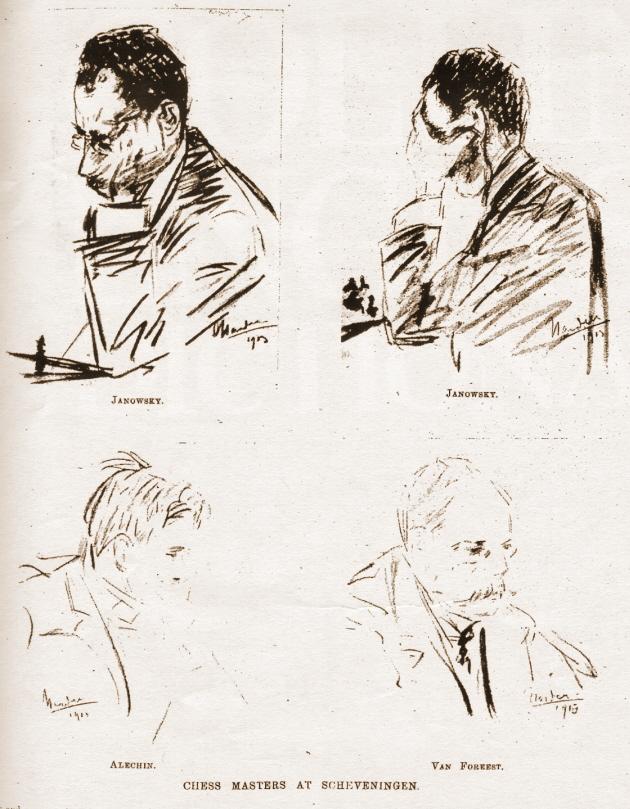
(7145)
In C.N. 5875 Olimpiu G. Urcan (Singapore) provided a link to a photograph of Chigorin at the website of the Bibliothèque nationale de France. He now points out three further pictures from the same collection:
On Alekhine’s left is Tartakower, whose opponent that day (11 February) was Znosko-Borovsky. The man standing between Tartakower and Znosko-Borovsky is the tournament director, Alphonse Goetz. Mr Urcan comments that by zooming in it is even possible to read the time on Alekhine’s watch.
(7131)
John Blackstone (Las Vegas, NV, USA) has forwarded this an interview with Capablanca on page C3 of the Brooklyn Daily Eagle, 12 February 1928:
A few gleanings:
‘I confess it did. I never dreamt that my former good form could fail me at such an inopportune time. But Dr Alekhine is worthy of any man’s steel. If you don’t believe it, try it.’
‘I cannot fully explain it and I hate alibis. The fact is that I was not my normal self and I made mistakes that now that I look back upon them are quite unaccountable.’
‘I knew then that the jig was up.’
‘Yes, that was shocking. I cannot recognize myself as the player who lost it.’
‘The opening of the game has been so thoroughly analysed and masters have the middle-game combinations down so pat that there is little of mystery in the game for them. Given a clear head and good health, there should be no trouble in drawing a game at will.’
(7134)
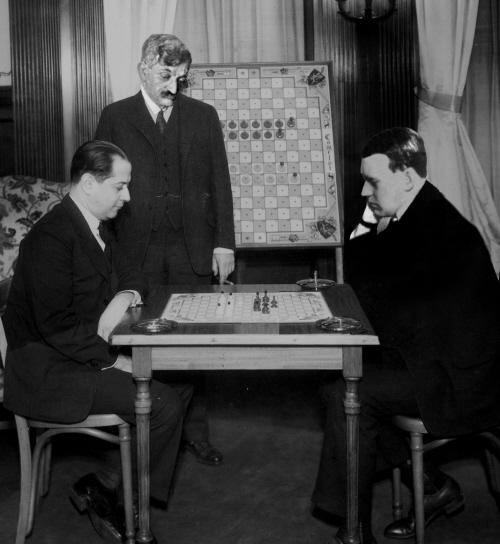
The above photograph (Capablanca, Lasker and Alekhine) comes from a webpage of the World Camelot Federation, and we reproduce it with the permission of the Federation’s President and Founder, Michael Nolan (Troy, MI, USA). He informs us that he created it on the basis of this picture:
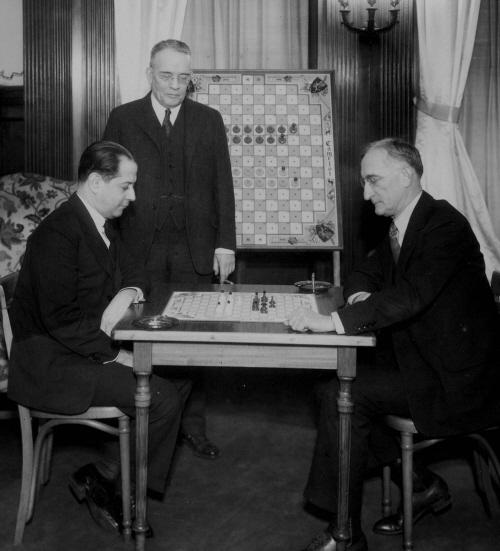
Here, Capablanca’s opponent is the Camelot and bridge expert Sidney Lenz, while E.V. Shepard (another bridge authority) looks on.
See too our article A Fake Chess Photograph.
(7164)
Wijnand Engelkes (Zeist, the Netherlands) reports that he has visited the Rua Alexander Alekhine in Estoril, Portugal:
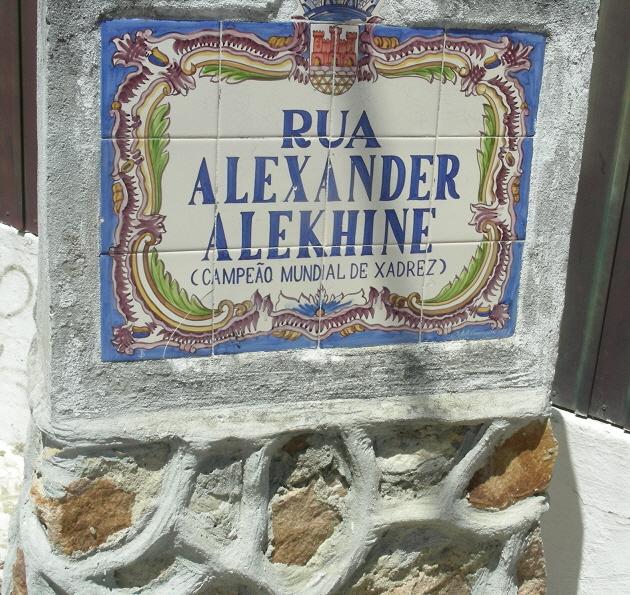
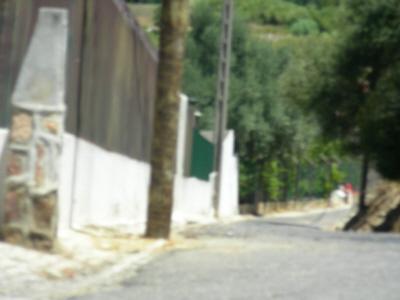
Our correspondent comments:
‘The Rua Alexander Alekhine is beyond the tourist area of Estoril (city of Cascais) and a half-hour walk from the São João railway station. The street-sign is on the stone object on the left of the second picture. The Rua Alexander Alekhine is a small road on a slope, located at a high point in Estoril. There are no houses. On one side are the backs of the houses of an adjacent road, whereas the other side is empty land. There is really nothing there apart from a lonely tree at the top of the hill.’
(7174)
See Street Names with Chess Connections.
‘[Capablanca] had a better conceit of himself than had Alekhine, but was a much nicer and much better-liked man. Alekhine was qualified as a lawyer and had a powerful intellect. He was the only man I ever met who was arrogant without being conceited. What do I mean by arrogant? He treated inferiors as if they were inferiors – but he very rarely made Capablanca’s mistake of taking his own powers for granted.’
Source: page 139 of Not Only Chess by Gerald Abrahams (London, 1974).
(7179)
The accusation that Alekhine did not intervene on behalf of Dawid Przepiórka was rebutted in a footnote to Alekhine’s obituary on page 87 of the June 1946 Revue suisse d’échecs:
‘Le reproche de ne pas être intervenu en faveur du maître Przepiórka en 1942, lors de son séjour à Varsovie, est infondé. On sait maintenant, par des témoignages récents venant de la capitale polonaise, que le grand maître et compositeur polonais tomba victime de la persécution anti-juive en 1940 déjà, donc deux ans avant la visite d’Alekhine.’
The obituary was written by Erwin Voellmy and Jean-Charles de Watteville, and page 84 had a woodcut of Alekhine by Voellmy:
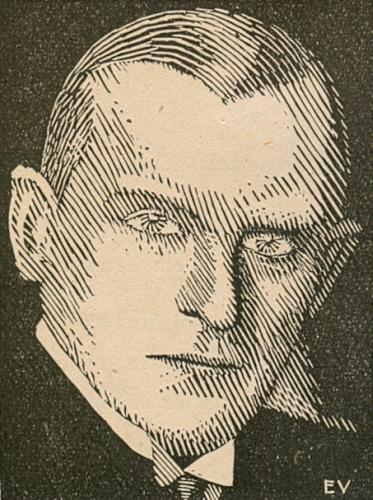
(7182)
The woodcut had originally been given on page 3 of the January 1928 Schweizerische Schachzeitung.
‘I dominate them all!’ is a remark commonly ascribed to Alekhine. The earliest appearance known to us is on page 171 of the May 1946 CHESS:

This was part of a three-page feature ‘Alekhine ... The Man and the Master’ by Thomas Olsen (about whom we lack biographical information).
(7209)
C.N. 8947 asked who wrote the following about Alekhine:
‘After his blindfold displays he would drink brandy in ordinary tumblerfuls.’
Suggestions included Arnold Denker and Harold C. Schonberg, but the most popular answer, in view of possible Internet searches, was Thomas Olsen.
From page 188 of The Great Chess Masters and Their Games by Fred Reinfeld (New York, 1952), in the chapter on Alekhine:

The previous year Reinfeld had included the following on pages 197-198 of The Treasury of Chess Lore (New York, 1951):
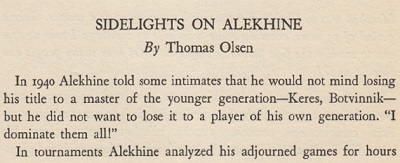
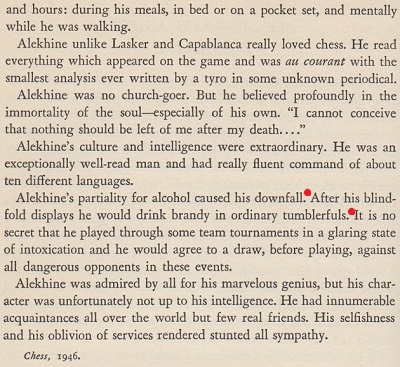
The next step is to verify that the quote is indeed in the magazine CHESS. Below is the relevant part of the May 1946 edition (pages 169-172):
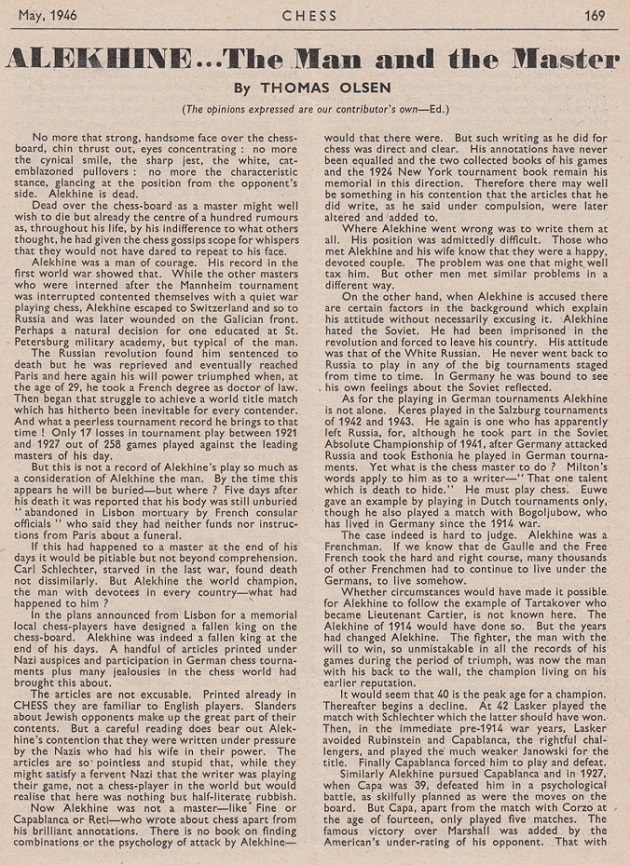
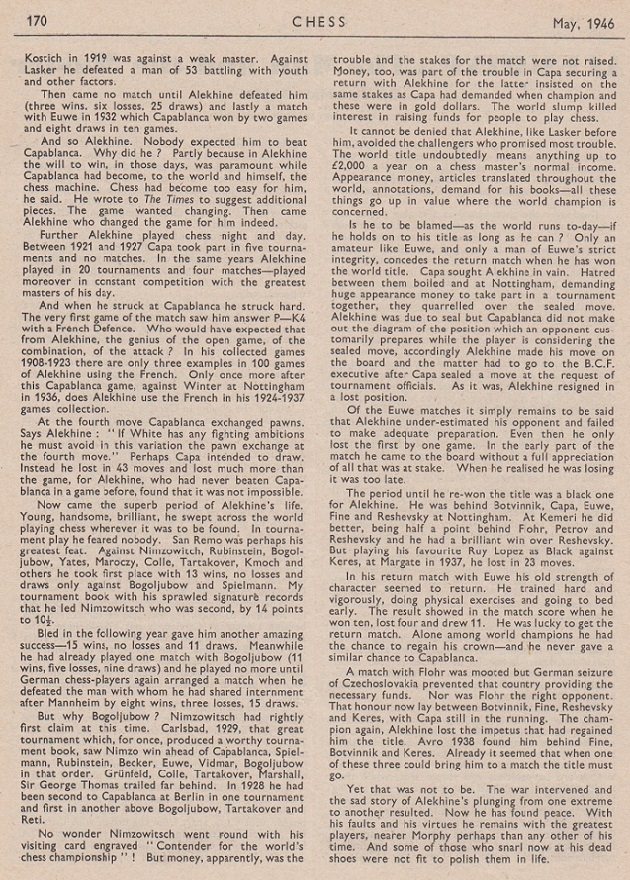
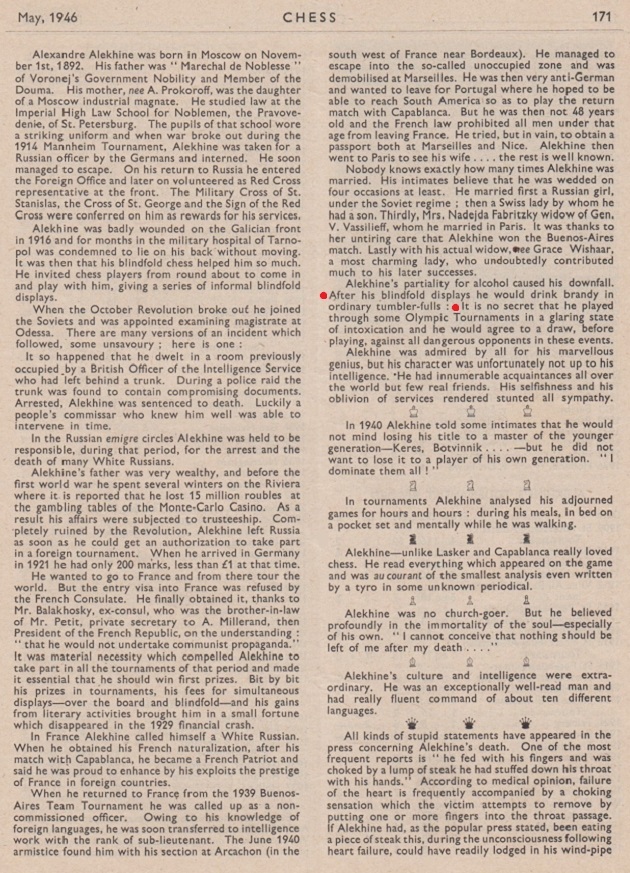
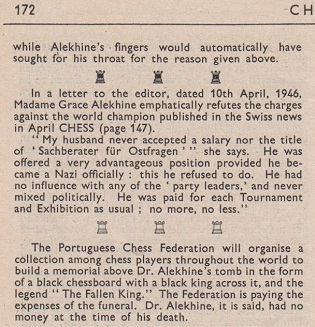
However, if Thomas Olsen were the evident answer to our poser, C.N. 8947 would not have described the question as ‘exceptionally difficult’.
Page 198 of the June 1946 CHESS stated:
‘ALEKHINE NOTES
(continued)In the May number of CHESS owing to a technical mistake the above title was omitted from the top of page 171. Mr Thomas Olsen’s article “Alekhine ... The Man and the Master” finishes with page 170, and the notes which follow are not from his pen.’
Consequently, Reinfeld’s later attributions to Olsen are incorrect, as is the reference in C.N. 7209 to ‘a three-page feature “Alekhine ... The Man and the Master” by Thomas Olsen’.
It is now tempting to assume that the writer of the remaining Alekhine material in the May 1946 CHESS was the magazine’s editor, B.H. Wood, but that is not so. Page 44 of the 12 November 1955 CHESS carried a review of Reinfeld’s The Treasury of Chess Lore which included this correction:
‘There are several quotations from CHESS; one of these (page 197), probably through our not making the authorship clear ourselves, is ascribed to Thomas Olsen instead of B. Reilly.’
How much unsigned material Brian Reilly wrote for CHESS naturally cannot be known, but in the mid-1940s he was indeed working for the magazine, as he informed W.H. Cozens on page 360 of the September 1981 BCM.
(8950)
C.N.s 7209 and 8950 showed the earliest known appearance of a famous remark ascribed to Alekhine, ‘I dominate them all’ (page 171 of the May 1946 CHESS):

This second-hand version related to unnamed third parties is often reduced to a general boast by Alekhine, as in this ‘once’ version on page 251 of The Golden Dozen by Irving Chernev (Oxford, 1976):
‘Alekhine played chess as if his life depended on it. He had to win, win, win, and live up to what he once said, “I dominate them all!”’
The phrase was used to advertise Al Horowitz’s New York Times column on page 233 of the April 1972 Chess Life & Review:

Another occurrence is on the back cover of the Dover edition of Fred Reinfeld’s collection 100 Instructive Games of Alekhine (New York, 1959):
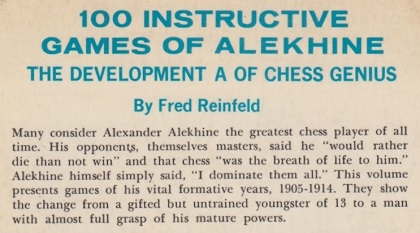
The quote also stood alone in the heading (page 168) of the Alekhine chapter in Reinfeld’s The Great Chess Masters and Their Games (New York, 1952):

Reinfeld amplified on page 189:
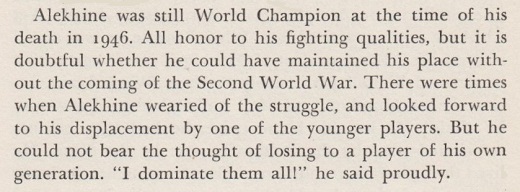
(8970)
Page 39 of Famous Chess Players by Peter Morris Lerner (Minneapolis, 1973):
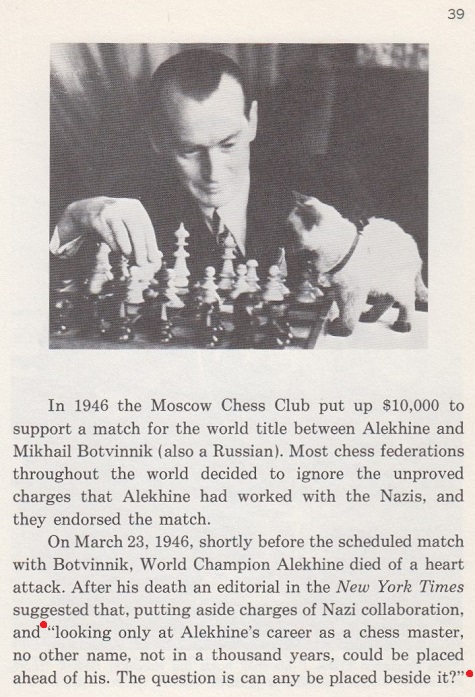
It is easy to imagine writers reproducing the New York Times quote from that book, perhaps to glorify Alekhine or, alternatively, to criticize the newspaper’s suggestion that his claimed supremacy would endure for 1,000 years.
The text provides a curious illustration of how nothing in secondary sources should be accepted at face value. The brief New York Times article was published shortly after Alekhine’s death (in the 26 March 1946 edition), and below are the opening and closing passages:
‘When a game has been played for a thousand years the naming of one man as its greatest exponent requires an act of daring. ...
A pity that it [Alekhine’s life] was clouded at the close by charges of Axis collaboration based on a tangle of incidents yet to be explained. Leaving that aside, however, and looking only at Alekhine’s career as a chess master, no other name, not in the whole 1,000 years, can be placed ahead of his. The question is, Can any be placed beside it?’
(7375)
Chessplayers and Animals has many photographs of Alekhine, including the following (pages 3-4 of the 12 April 1936 issue of Pesti Napló Képes Melléklet):
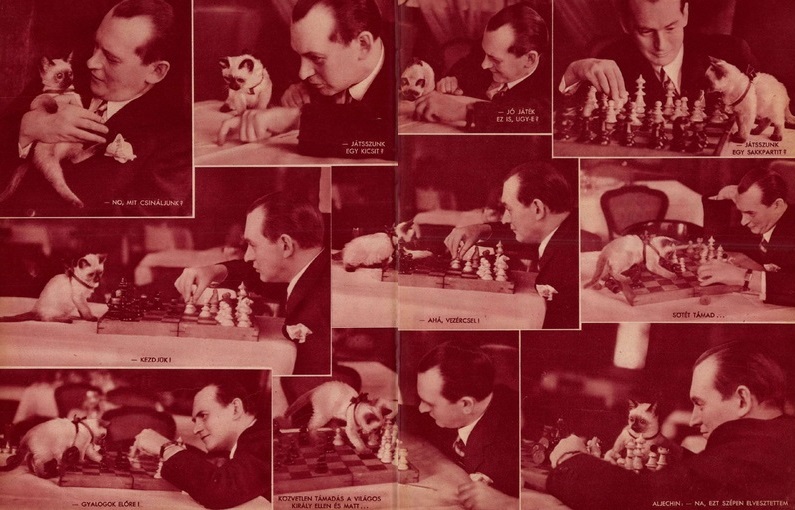
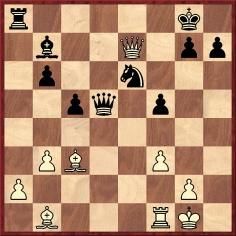
This situation (White to move) arose in a game between Alfredo Olivera and Carlos Hounie Fleurquin in Montevideo in September 1939. White played 1 Re1, but Alekhine, a participant in the tournament, showed the line 1 Be4 fxe4 2 fxe4 Qxe4 3 Qf7+ Kh8 4 Bxg7+ Nxg7 5 Qf8+ Rxf8 6 Rxf8 mate.
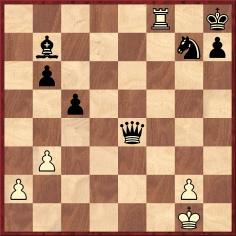
Our source is Brian Harley’s column in The Observer, 5 November 1939, page 16:
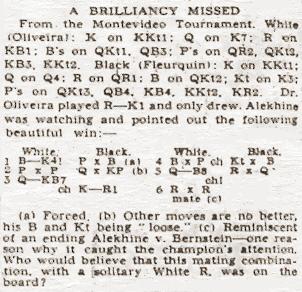
For Oliveira read Olivera, and it may be noted that 2...Qg5 would offer more resistance. Can the complete game-score be found?
(7200)
From page 38 of Blunders and Brilliancies by Ian Mullen and Moe Moss (Oxford, 1990):
‘The late Isaac Kashdan who, in the 1920s and 30s, was Alekhine’s heir apparent ...’
(7255)
Michael Clapham draws attention to a passage on page 58 of Championship Chess by P.W. Sergeant (London, 1938):
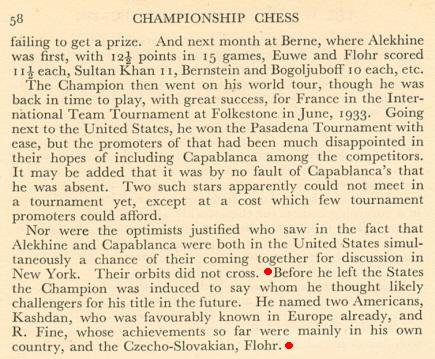
(In the first paragraph the chronology is confusing, the Pasadena tournament having taken place in 1932.) As regards the comment about Kashdan, Fine and Flohr at the end of the second paragraph, we add the following from page 477 of the November 1933 BCM:
‘United States. – Dr Alexander Alekhine, before leaving New York for Europe on 5 [sic] September, told an interviewer that he regarded as specially likely future opponents Kashdan, Fine and Flohr, with the first-named the most probable. “America’s chances of possessing the next champion”, he said, “are excellent”.’
A correction appeared on page 527 of the December 1933 BCM:
‘In our first paragraph under the heading United States last month (page 477) the words “the first-named” should have been “the two first-named”, as Dr Alekhine included Reuben Fine with Isaac Kashdan in his choice of most probable future challengers for the world championship. He is said, indeed, to have described Fine as “a real threat” for the title.’
More information about the interview is sought.
Around the same time, Alekhine was interviewed by Kashdan himself, on pages 9-10 of the September 1933 Chess Review (see C.N. 5631). Alekhine was asked about US masters, but no names were mentioned in his reply:
‘We wanted to know what he thought of the American players, and how they compared with the younger European stars. “Your double success in the International Team Tournaments has put America in the first rank among the chessplaying nations. No other country has so many promising young masters. In New York City alone you have at least a dozen young men who have nothing to fear from the leaders of any country in Europe. I predict many new successes, and you have enough talent developing to keep in the top flight indefinitely.”’
(7259)
Writers on Mikhail Botvinnik tend to pass over a significant article which he contributed to International Championship Chess by B. Kažic (London, 1974). Published on pages 244-250, it is entitled ‘Botvinnik on his Meetings with World Champions’ and discusses Lasker, Capablanca, Alekhine and Euwe. An observation from page 248:
‘Alekhine’s was a complex character. As soon as he felt any signs of hostility, he would shoot out his quills like a porcupine. When people were kind he felt bound to behave in the same way.’
We should like to know whether Botvinnik’s original text is available, since the English version is sometimes defective. For example, page 247 has the following regarding AVRO, 1938:
‘The tournament marked the greatest in Capablanca’s entire career.’
A word such as ‘failure’ or ‘disappointment’ seems to be missing after ‘greatest’.
There is an interesting passage on pages 246-247, concerning the period after Hastings, 1934-35:
See too pages 92-93 of the English edition of the tournament book (Yorklyn, 1998). Botvinnik’s own notes appeared in the first volume of his Best Games series; for instance, on pages 181-183 of the English edition (Olomouc, 2000).‘At the invitation of S.O. Weinstein, Capablanca came to the Soviet Embassy in London and immediately agreed to play in Moscow. It was a while before Capablanca actually came. Weinstein inconsiderately asked him about a possible match with Alekhine and suddenly the Cuban changed colour! He glared and could not calm down for a long time. Capablanca and Alekhine remained enemies for the rest of their lives.
Capa was phenomenal at calculating positions, but he was also a shrewd tactician. At the tournament in Moscow I played Black and skilfully brought the game to even play, when, unexpectedly, Capablanca in the end “overlooked” a man!? But – no! White had, in fact, been preparing a quiet move and a variation in which he actually took the pawn. All of this was artfully concealed.’
(7263)
The famous brilliancy F. Herrmann v H. Hussong, Frankfurt, 1930 published on pages 314-315 of the October 1930 Deutsche Schachzeitung, October 1930, and, with Alekhine’s notes taken from Denken und Raten, on pages 340-342 of the December 1930 issue of Kagans Neueste Schachnachrichten:
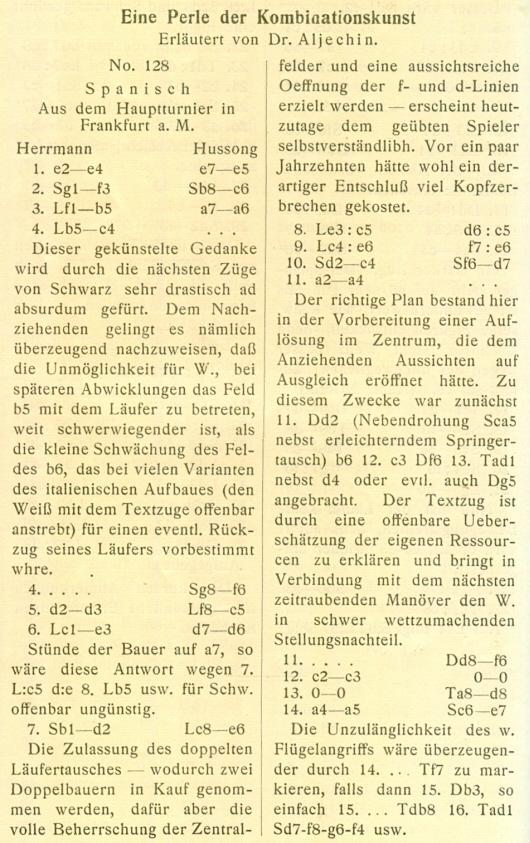
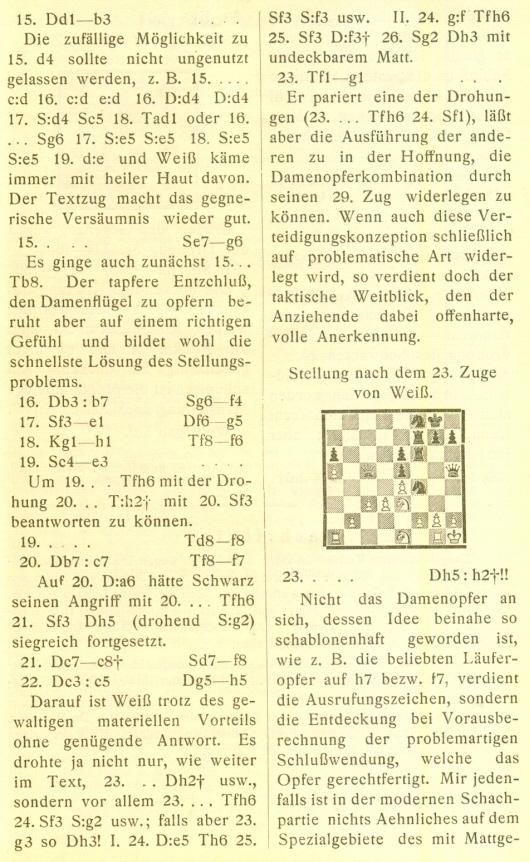
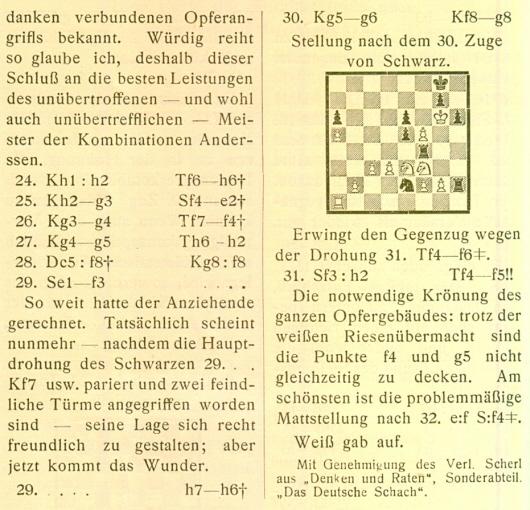
(7402)
For further information on this game see our feature article on C.J.S. Purdy.
Olimpiu G. Urcan has submitted a series of photographs from the Illustrated London News:
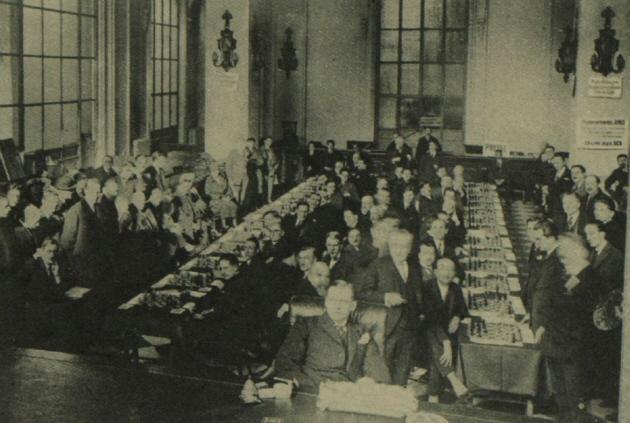
Alexander Alekhine (blindfold exhibition in Paris). 25 February 1925, page 205
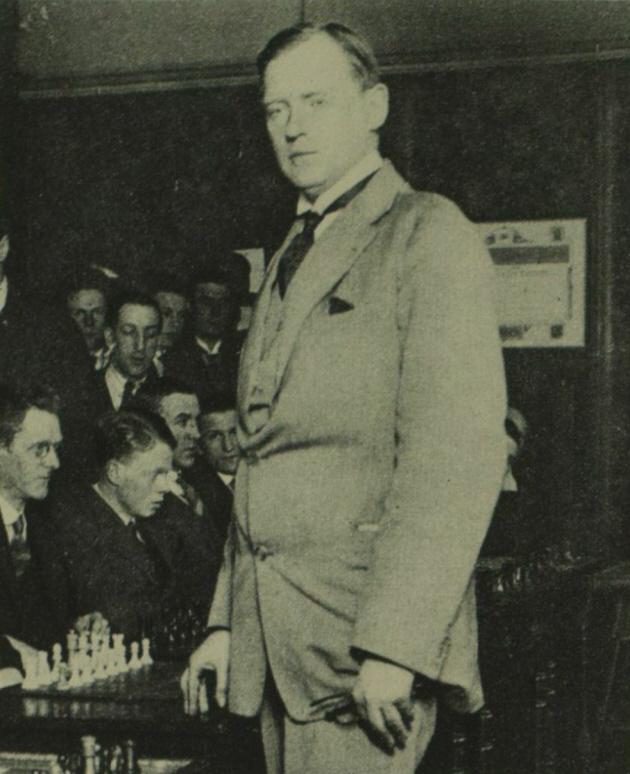
Alexander Alekhine. 10 December 1927, page 1064
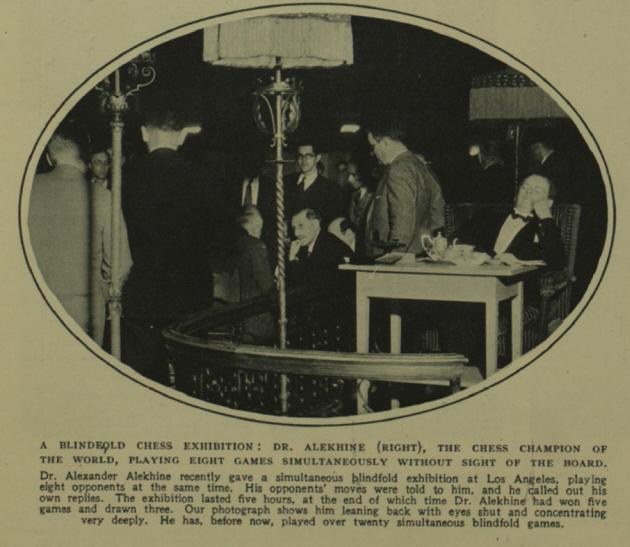
1 October 1932, page 498
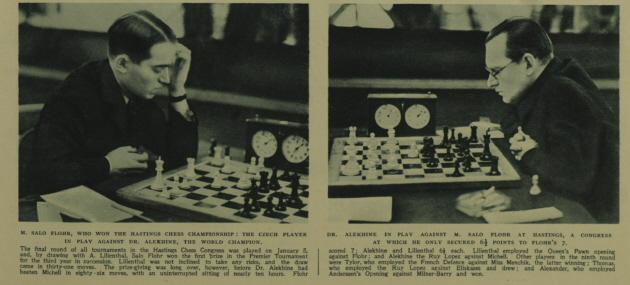
13 January 1934, page 67
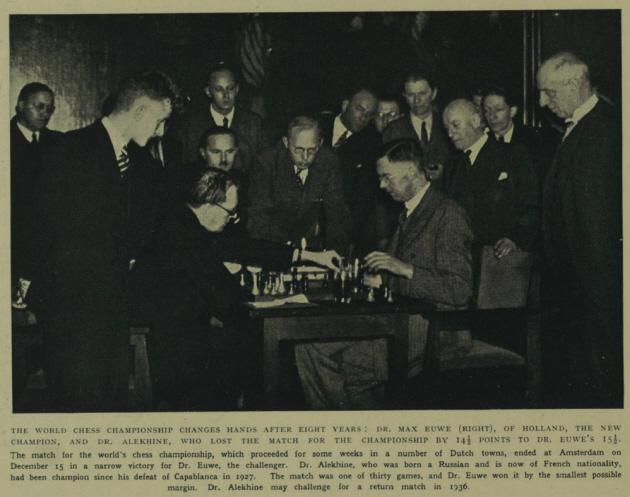
28 December 1935, page 1186
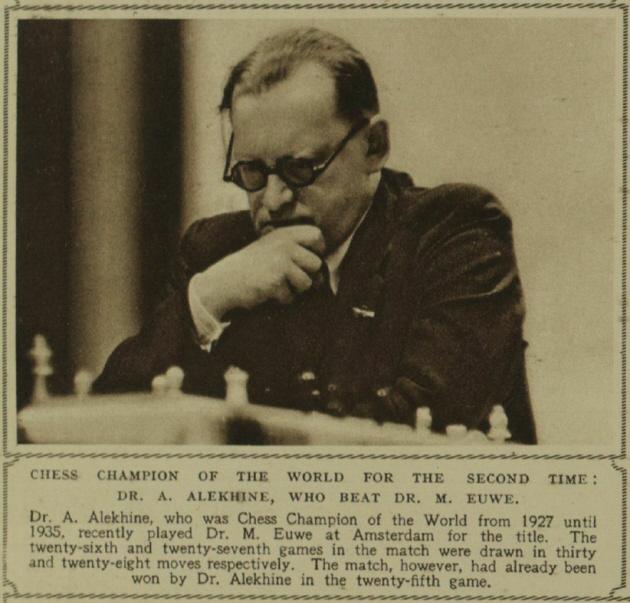
18 December 1937, page 1106
(7490)
Dominique Thimognier supplies this photograph from page 1 of the Paris publication Le Matin of 23 December 1941:
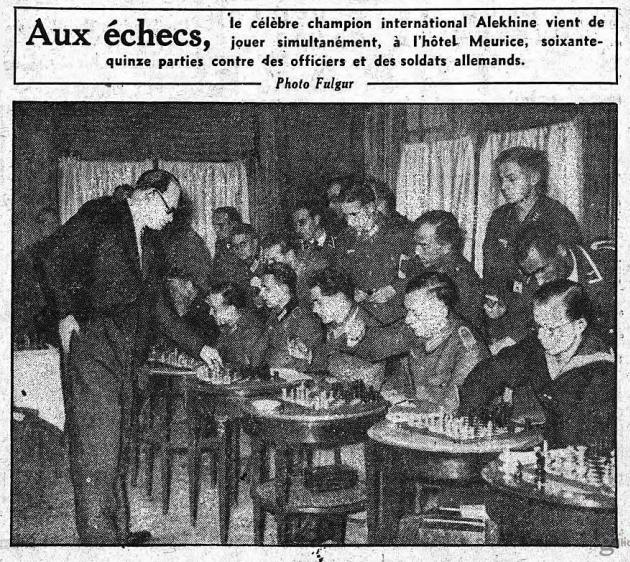
This simultaneous display at the Hôtel Meurice against the German military was mentioned on page 677 of the Skinner/Verhoeven book on Alekhine. There are discrepancies, such as whether Alekhine faced 75 boards or 50.
(7629)
Wolfgang Franz (Oberdiebach, Germany) notes that a better-quality version of the Alekhine photograph was on the front cover of the February 1993 Rochade Europa:
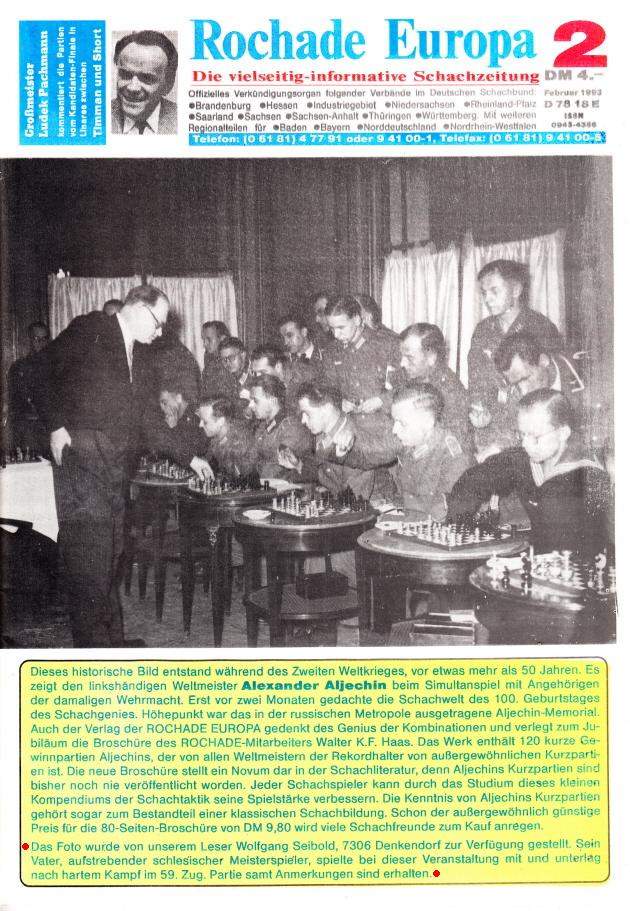
Page 45 of the September 1993 issue gave the game Alekhine v Seibold, dated 21 December 1942 (sic). See page 677 of the Skinner/Verhoeven book on Alekhine.
Mr Franz also points out that the score of the simultaneous display was +40 –4 =6 according to page 5 of the January 1942 Deutsche Schachzeitung but +39 – 4 =7 in this report in La Gerbe of 8 January 1942:
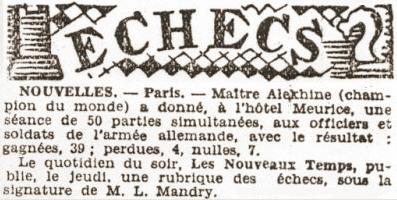
Leonard Skinner (Cowbridge, Wales) provides the report on page 16 of Schach-Echo, 7 January 1942:
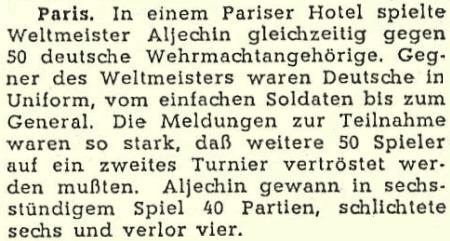
Nothing has been found to support the statement in Le Matin (C.N. 7629) that the Alekhine display was on 75 boards.
(7634)
Peter Anderberg notes that the first page of the Lower Saxony supplement to the February 1993 issue of Rochade Europa had a second photograph of Alekhine’s simultaneous exhibition:
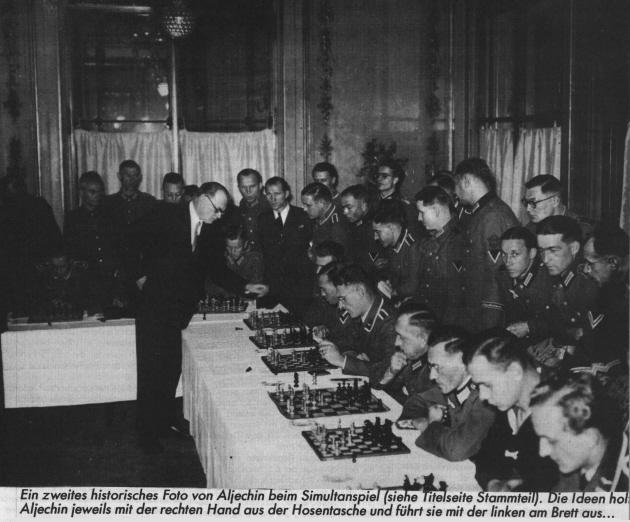
(7642)
Félix Valderrama Loyola (Barquisimeto, Venezuela) reports that during a meeting which he had with Julio Bolbochán in Caracas 20 years ago the latter stated that his elder brother, Jacobo, gave Alekhine considerable assistance as a sparring partner in Buenos Aires in connection with the 1927 world championship match.
Our correspondent asks what solid information exists concerning Alekhine’s preparation for that match, beyond what he wrote in Auf dem Wege zur Weltmeisterschaft (Berlin and Leipzig, 1932).
(7502)
Page 251 of Schackvärlden, August 1937 had a photograph from the brilliancy Alekhine v Reshevsky, Kemeri, 1937:
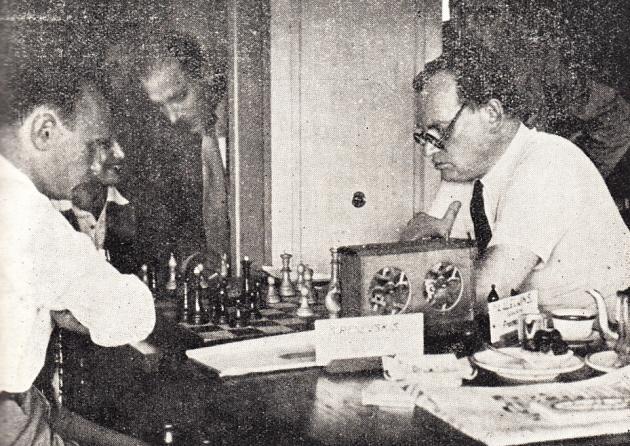
(7561)
Josep Alió informs us that he has recently acquired the third personal notebook of the Catalan player V. Vallés. It covers the period May 1942 to December 1945, and the introduction states that the first volume began in 1935.
Pages 145-156 of volume three concern Sabadell, 1945, and pages 145, 146 and 147 provide an introduction to the tournament, including Vallés’ notes to his first-round game as Black against Alekhine (1 d4 Nf6 2 c4 e6 3 g3 c5 4 d5 d6 5 Bg2 Be7 6 Nc3 O-O 7 Nf3 exd5 8 cxd5 Re8 9 O-O Nbd7 10 e4 Bf8 11 Re1 Qa5 12 Bd2 b5 13 a3 Qb6 14 Qc2 a5 15 a4 b4 16 Nb5 Ba6 17 Bf1 Ng4 18 Bc4 Nde5 19 Nxe5 Nxe5 20 Be2 Bxb5 21 axb5 g6 22 Be3 Bg7 23 f4 Nd7 24 Bc4 a4 25 Rxa4 Rxa4 26 Qxa4 Bxb2 27 Bf2 Bc3 28 Re2 Qc7 29 b6 Qd8 30 b7 Nb6 31 Qb5 Nxc4 32 Qxc4 Qb6 33 e5 dxe5 34 Bxc5 Qxb7 35 fxe5 Rxe5 36 Rxe5 Bxe5 37 Bxb4 Qc7 38 Qxc7 Bxc7 39 Kg2 f5 Drawn).
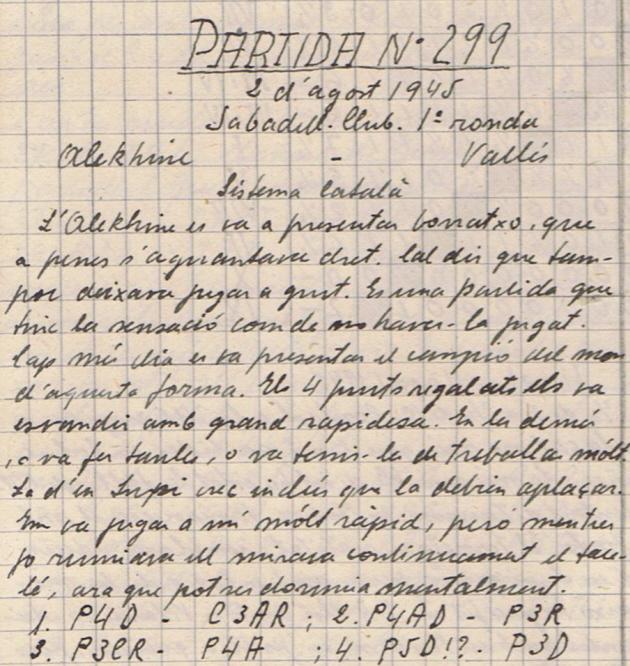
Below are some extracts in our correspondent’s translation from the Catalan:
‘Alekhine turned up drunk; scarcely could he stand. It must be said that he did not let me play the game comfortably. It is a game that I have the feeling of not having played. On no other day did the world champion appear in such a state … He played very rapidly, but while I was thinking he continuously looked at the board, although he may have been mentally sleeping.’
After 31...Nxc4: ‘He now proposed a draw, but after thinking about it (moral and psychological considerations, mainly) I told him no; “Play a little more.” I think he became angry or took a dislike to me from then onwards.’
After 37 Bxb4: ‘“You want to win this?”, he asked with a scoff. I made a gesture and said, “Well, if you want a draw ...” or something like that. And then he said: “No! No! We shall play”, giving the public the impression, which was not the case, that the draw was being requested by me.’
After 39...f5: ‘And he said: “Yes, it is a draw.” And I did not know what to say, being ashamed.’
(7563)
From Olimpiu G. Urcan:
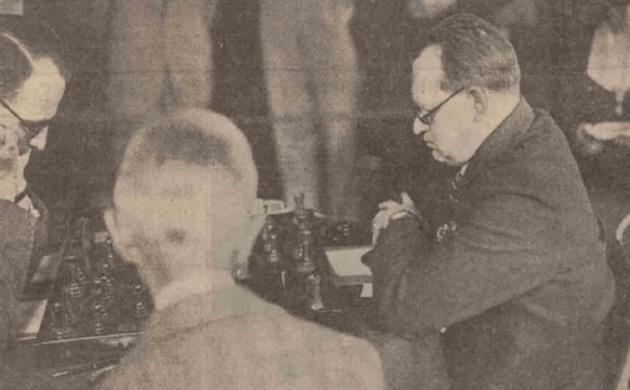
P.S. Milner-Barry v A. Alekhine
(Plymouth tournament, 5 September 1938)
Western Morning News and Daily Gazette, 6 September 1938,
page 11
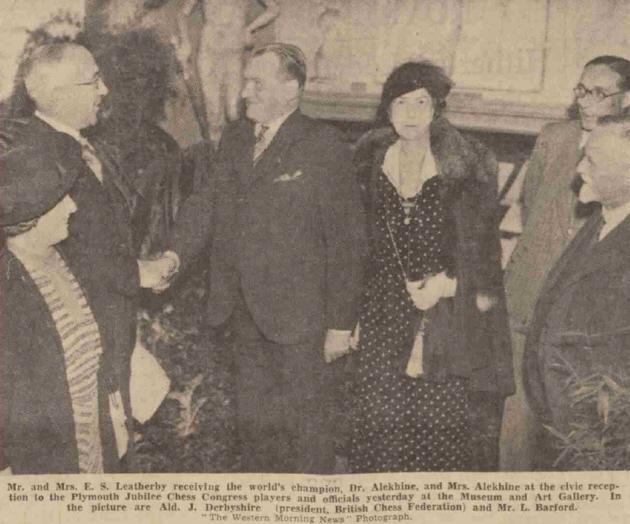
Western Morning News and Daily Gazette, 9 September 1938, page 5
(7612)
Michael McDowell (Westcliff-on-sea, England) asks whether information is available about the problem ascribed to Alekhine on page 370 of CHESS, 28 May 1955:
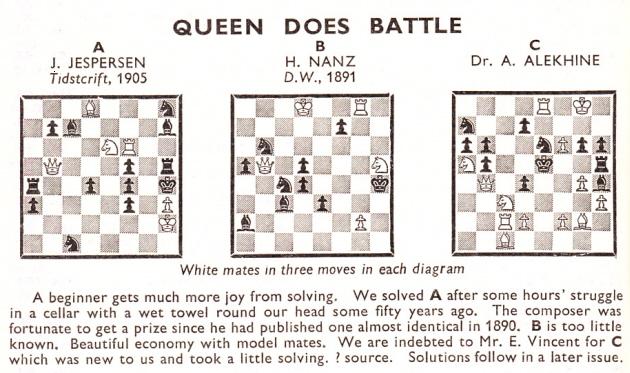
The key move was given on page 443 of the 10 August 1955 issue, but without further particulars about the source of the composition.
(7670)
A database showing the alleged Alekhine problem has been pointed out by Han Bükülmez (Ecublens, Switzerland). The source specified there is L’Italia Scacchistica, 1932, and courtesy of Luca D’Ambrosio (Bolzano, Italy) and Alessandro Sanvito (Milan, Italy) we reproduce page 173 of the 1 June 1932 issue:
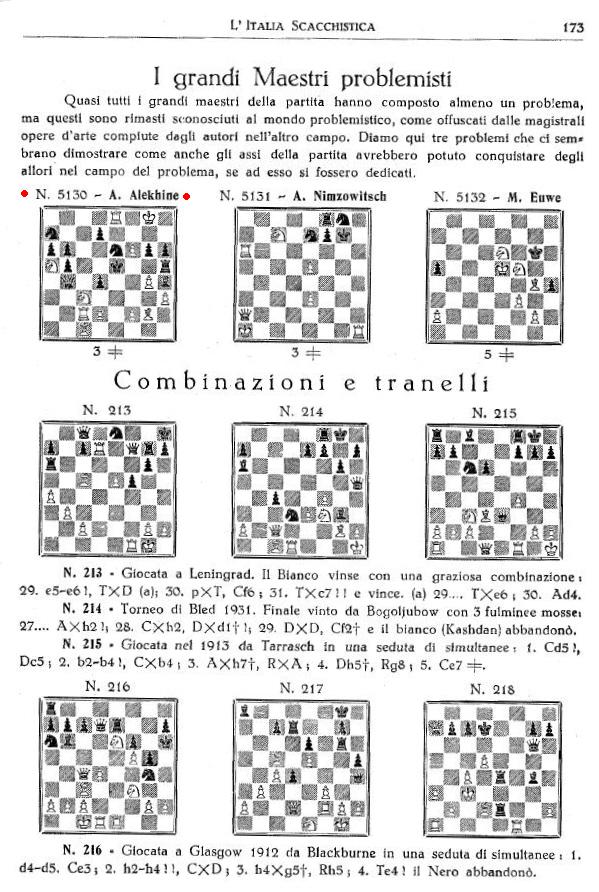
That, of course, is hardly the end of the story. How much further back can the problem be traced?
(7682)
Michael McDowell has forwarded pages 42-43 of the latest issue (105) of the Russian problem magazine Shakhmatnaya Kompozitsiya, in which three composers, A. Vasilenko, V. Aberman and I. Agapov, have improved significantly on the three-mover attributed to Alekhine:
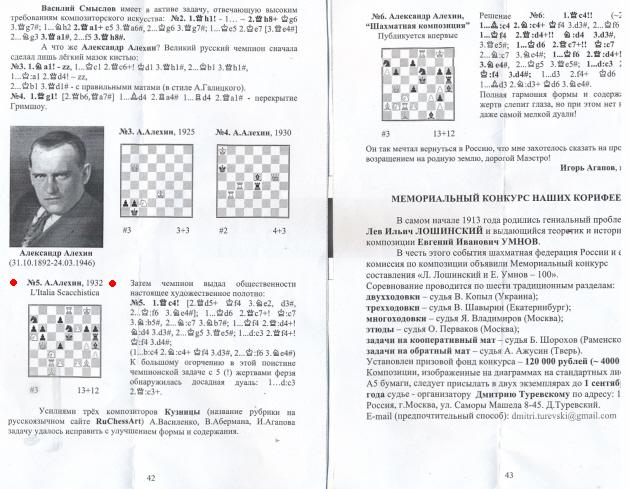
(7740)
Concerning Alekhine as a problem solver see A Chess Washout.
A widely-published blindfold game won by F. Sämisch against N.N.:
1 e4 e6 2 d4 d5 3 Nc3 Bb4 4 e5 c5 5 Bd2 cxd4 6 Nb5 Bc5 7 b4 Bb6 8 Qg4 Kf8 9 Nf3 Nc6 10 Qf4 f6 11 exf6 Qxf6 12 Nc7 Bxc7 13 Qxc7 h6 14 b5 d3
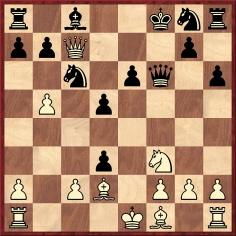
15 Bxd3 Qxa1+ 16 Ke2 Qf6 17 bxc6 Qe7 18 Bb4 Qxb4 19 Qd8+ Kf7 20 Ne5 mate.
Wanted regarding this game-score: the oldest possible citations from magazines and columns of the time. But when was ‘the time’? ‘Aachen, 1943’ was the heading when the game was published on pages 174-175 of The Joys of Chess by Fred Reinfeld (New York, 1961), but other books tend to give the date as 1934. See, for instance, pages 363-364 of Irving Chernev’s Best Short Games collection, which introduced the game as follows:
‘“Of all the modern masters that I have had occasion to observe playing blindfold chess, it is Sämisch who interests me the most; his great technique, his speed and precision have always made a profound impression on me.” So said Alekhine, himself one of the most magnificent exponents of the art.’
Alekhine made the remark on page 19 of Auf dem Wege zur Weltmeisterschaft (Berlin and Leipzig, 1932):
‘Von allen modernen Meistern, die ich beim Blindspiel zu beobachten Gelegenheit hatte, gefiel mir Sämisch am besten; seine große Technik, seine Schnelligkeit und Sicherheit haben mir imponiert.’
The French version, from page 270 of Deux cents parties d’échecs (Rouen, 1936):
‘De tous les Maîtres modernes que j’ai eu l’occasion d’observer au jeu à l’aveugle, c’est Sämisch qui m’intéresse le plus; sa grande technique, sa rapidité et sa sûreté m’ont toujours fait une profonde impression.’
(7683)
A position from Yates v Alekhine in the first round of the New York, 1924 tournament:
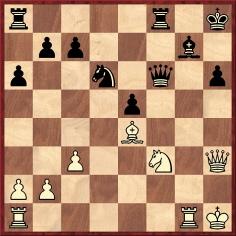
Yates played 29 Bd5, and on pages 17-18 of the tournament book (New York, 1925) Alekhine wrote:
‘Losing a piece. What follows is sheer desperation.’
The continuation was 29...c6 30 Rxg7 Kxg7, and White resigned after Black’s 35th move.
It was later found that White could have played 30 Nh4, but when was the discovery made?
Below is what appeared on page 332 of The Personality of Chess by I.A. Horowitz and P.L. Rothenberg (New York, 1963):

The matter was taken up by Sheldon McDonald of Connecticut on page 16 of the January 1978 Chess Life & Review, in the ‘Ask the Masters’ column, and a reply from Ken Rogoff followed:
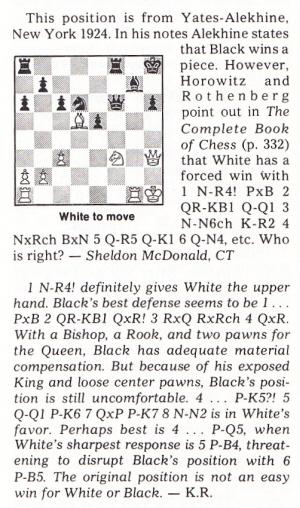
The Complete Book of Chess was the new title of the Horowitz/Rothenberg work when it was reissued in 1969. The co-authors’ text leaves the reader to infer that they found 30 Nh4, but such was not the case. Horowitz’s magazine, Chess Review, had the following on page 291 of the December 1938 issue:
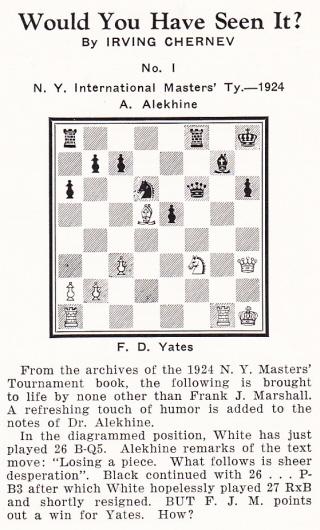
The solution on page 301 (also with incorrect move numbers throughout):
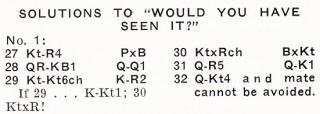
Nowadays the possibility of 30 Nh4 is regularly mentioned, though without attribution to Marshall or anyone else. See, for instance, page 43 of the second volume of the Chess Stars work on Alekhine (Sofia, 2002). For his part, Alekhine annotated the game briefly on pages 73-74 of La Stratégie, April 1924 (notes reproduced from Le Canada) and on page 99 of Wiener Schachzeitung, April 1924, but neither set of notes has anything of relevance to the play under discussion here.
(7746)
Dominique Thimognier has found the following games:
Alexander Alekhine – Cercle Rouennais des Echecs
Paris, 28 February 1932 (simultaneous display against 60
teams/300 players)
Queen’s Gambit Declined
1 d4 Nf6 2 Nf3 e6 3 c4 d5 4 Nc3 c6 5 Bg5 Nbd7 6 e4 dxe4 7 Nxe4 Bb4+ 8 Nc3 Qa5 9 Bd2 O-O 10 Bd3 Qd8 11 O-O Re8 12 Qc2 Nf8 13 Rad1 b6 14 a3 Be7 15 Rfe1 Bb7 16 b4 c5 17 dxc5 Bxf3 18 gxf3 bxc5 19 Bf4 Qb6 20 b5 Red8 21 Ne4 Ng6 22 Bg3 Rd4 23 Bf1 e5 24 Nc3 Bd6 25 Ne2 Rxd1 26 Rxd1 Bc7 27 Nc3 Qe6 28 Ne4 Qe7 29 Qa4 Nh5 30 Qa6 Bb6 31 Nc3 f5 32 Nd5 Qd8 33 Nxb6 Qxb6 34 Rd6 Qb8 35 Bd3 Qf8 36 Rd7 Nhf4 37 Bf1 Qc8 38 Qxc8+ Rxc8 39 Rxa7 Ne6 40 Bh3 Rd8 41 b6 Nd4 42 b7 Nxf3+ 43 Kf1 f4 44 Ra8 Nd2+ 45 Ke2 Resigns.
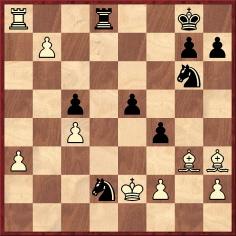
Source: Journal de Rouen, 17 March 1932.
Alexander Alekhine – Cercle Rouennais des Echecs
Paris, 28 February 1932 (simultaneous display against 60
teams/300 players)
Vienna Game
1 e4 e5 2 Nc3 Nc6 3 Bc4 Bc5 4 Qg4 g6 5 Qg3 Nf6 6 d3 Nh5 7 Qf3 Qf6 8 Nd5 Qxf3 9 Nxf3 Bb6 10 g4 Ng7 11 Bh6 Ne6 12 c3 d6 13 Nf6+ Ke7 14 Nd5+ Ke8 15 b4 Ncd8 16 a4 c6 17 Nxb6 axb6 18 d4 exd4 19 cxd4 b5 20 Bb3 Nc7 21 h3 Be6 22 Bc2 bxa4 23 Rxa4 Rxa4 24 Bxa4 b5 25 Bc2 Kd7 26 Kd2 Bc4 27 Ra1 Nde6 28 Ke3 Ra8 29 Rxa8 Nxa8 30 Nd2 Ba2
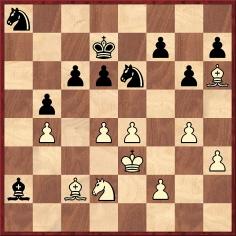
31 f4 Nac7 32 f5 Nd8 33 Nf3 f6 34 fxg6 hxg6 35 h4 Nf7 36 Bf4 Be6 37 g5 fxg5 38 hxg5 Na6 Drawn.
Source: Journal de Rouen, 31 March 1932.
Alexander Alekhine – Cercle Rouennais des Echecs
Rouen, 29 May 1932 (clock simultaneous display against six
teams)
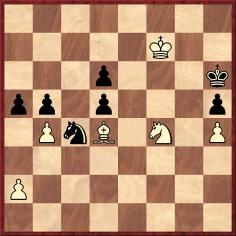
Alekhine announced mate in five moves.
Source: Journal de Rouen, 9 June 1932.
The solution was given in the following week’s edition: 51 Kg8 Ne5 52 bxa5 b4 53 a6 b3
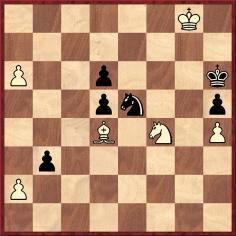
54 axb3, followed by 55 Bg7 mate.
Alexander Alekhine – Three members of the Cercle Rouennais
des Echecs
Rouen, 29 May 1932 (clock simultaneous display against six
teams)
Queen’s Gambit Declined
[1 d4 d5 2 c4 e6 3 Nc3 Nf6 4 Bg5 Nbd7 5 Nf3 c6 6 e4] dxe4 7 Nxe4 Qa5+ 8 Nc3 Bb4 9 Bd2 O-O 10 a3 Be7 11 Nd5 Qd8 12 Nxe7+ Qxe7 13 Bd3 e5 14 O-O exd4 15 Nxd4 Qd6 16 Bb4 c5 17 Nf3 Qc7 18 Bc3 Re8 19 Re1 Rxe1+ 20 Qxe1 Kf8 21 Rd1 b6
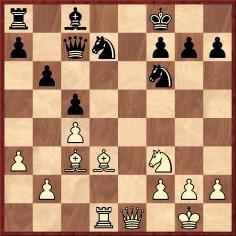
22 Bxh7 Bb7 23 Bf5 Bxf3 24 gxf3 Re8 25 Qd2 Ne5 26 Bxe5 Qxe5 27 Qd6+ Qxd6 28 Rxd6 Re2 29 b4 cxb4 30 axb4 Re5 31 Bh3 Nh5 32 Kf1 Nf4 33 Bc8 Rh5
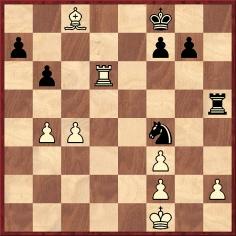
34 h3 Nxh3 35 Bg4 Rh4 36 Rd8+ Ke7 37 Rd7+ Kf6 38 Rxa7 Nf4 39 Ke1 Nd3+ 40 Ke2 Ne5 41 Rc7 Nxg4 42 fxg4 Rxg4 43 b5 Re4+ 44 Kd3 Re6 45 c5 bxc5 46 Rxc5 Rd6+ 47 Kc3 Ke6 48 Rc7 Rd7 49 Rc4 Ke7 50 Kb4 Kd6 51 b6 Kd5 52 Kb5 g6 53 Rc7 Resigns.
Source: Journal de Rouen, 23 June 1932. The opening moves were garbled in the newspaper, and the sequence suggested in square brackets above is merely one of a number of possible corrections.
Alexander Alekhine – Charles Dupin
Lille, 3 July 1932 (simultaneous display against 32 players,
including two blindfold games)
Queen’s Gambit Declined
1 d4 d5 2 c4 e6 3 Nc3 c6 4 Nf3 Nf6 5 Bg5 Nbd7 6 e4 dxe4 7 Nxe4 Be7 8 Nc3 Qc7 9 Qc2 h6 10 Bh4 e5 11 O-O-O exd4 12 Rxd4 O-O13 Bg3 Qa5 14 a3 a6 15 Bd6 Re8 16 Bxe7 Rxe7 17 Bd3 Nf8 18 Rf4 Nh5 19 Rh4 Ne6 20 Re1 Nf6 21 Re5 b5 22 c5 Nd7 23 Re2 Ndxc5 24 Bh7+ Kf8 25 Kb1 Nd7 26 Ne4 Qc7 27 Ng3 Nf6 28 Nf5 Re8 29 Qc3 Nxh7 30 Rxh6 Kg8 31 Ne5 Nf4
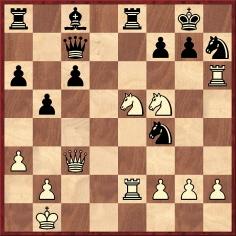
32 Nd7 Resigns.
Source: Journal de Rouen, 21 July 1932.
Alexander Alekhine – Pierre Biscay, Marcel Berman and Marcel
Duchamp
Paris, 15 June 1935 (simultaneous display against 36 teams)
Sicilian Defence
1 e4 c5 2 d4 cxd4 3 Nf3 Nc6 4 Nxd4 Nf6 5 Nc3 d6 6 Bg5 Qb6 7 Bxf6 gxf6 8 Nb3 e6 9 Qf3 Be7 10 O-O-O a6 11 Qg3 Bd7 12 Qg7 O-O-O 13 Qxf7 Qxf2 14 Qh5 Rdg8 15 h4 Ne5 16 Kb1 Be8 17 Qh6 Rg6
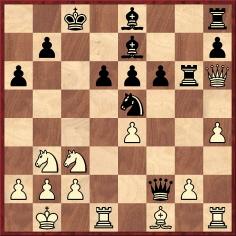
18 Qc1 Rhg8 19 Nd4 Bf8 20 b3 Rg3 21 Nce2 Re3 22 g3 Bh5 23 Rh2 Qxh2 24 Qxe3 Bg4 25 Rd2 Qh1 26 Qf2 Nf3 27 Nxf3 Qxf3 28 Qg1 Qxe4 29 Qa7 Bxe2 30 Bxe2 Bh6 31 Rd4 Qh1+ 32 Rd1 Qe4 33 Qa8+ Kc7 34 Qxg8 Qxe2 35 Qxh7+ Kc6 36 Qd3 Qe5 37 g4 Bg7 38 Qd4 f5 39 Qxe5 dxe5 40 g5 e4 41 h5 e3 42 h6 Bf8 43 Rh1 f4 44 Kc1 f3 45 Kd1 Bb4
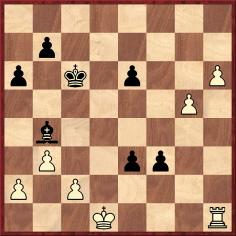
46 c3 Bxc3 47 Kc2 e2 48 Kxc3 f2 49 White resigns.
Source: Journal de Rouen, 20 June and 4 July 1935.
Alexander Alekhine – Marcel Berman
Rouen, 14 March 1937 (simultaneous display against 35 players)
Alekhine’s Defence
1 e4 Nf6 2 Nc3 d5 3 e5 Nfd7 4 e6 fxe6 5 d4 c5 6 Nf3 cxd4 7 Nxd4 Nf6 8 Bb5+ Nc6 9 Nxc6 bxc6 10 Bxc6+ Bd7 11 Bxa8 Qxa8 12 O-O g6 13 Qe2 Bg7 14 Nb5 O-O 15 Be3
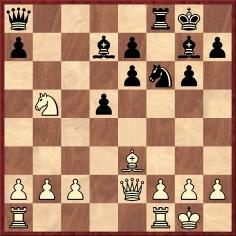
15...Qb7 16 a4 a6 17 Nd4 e5 18 Nf3 Bg4 19 h3 Bh5 20 Qd2 Ne4 21 Qa5 Bxf3 22 gxf3 Rxf3 23 Qd8+ Kf7 24 Kh2 d4 25 c3 dxe3 26 fxe3 Qxb2+ 27 Kg1 Rxf1+ 28 Rxf1+ Nf6 Drawn.
Source: Journal de Rouen, 27 March 1937.

Alexander Alekhine – Thierry
Rouen, 14 March 1937 (simultaneous display against 35 players)
Queen’s Gambit Accepted
1 d4 d5 2 c4 dxc4 3 Nf3 Bf5 4 Nc3 e6 5 e4 Bg6 6 Bxc4 Nf6 7 Qe2 Bb4 8 Bd3 O-O 9 O-O Nbd7 10 Rd1 c6 11 Bg5 Be7 12 e5 Bxd3 13 Rxd3 Nd5 14 Bxe7 Qxe7 15 Qd2 Nxc3 16 bxc3 Rad8 17 h3 Nb6 18 a4 f6 19 a5 Nc4 20 Qa2 fxe5 21 Qxc4 e4 22 Re3 exf3 23 Qxe6+ Qxe6 24 Rxe6 fxg2 25 Kxg2 Rd5 26 a6 Kf7 27 Re3 b6 28 Rae1 Rd7 29 Re6 Rc7 30 Rd6 Re8
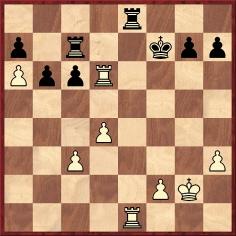
31 Re3 Rxe3 32 fxe3 Ke7 33 White resigns.
Source: Journal de Rouen, 24 April 1937.
(7796)
Olimpiu G. Urcan provides, courtesy of the Hulton Archive, this photograph of Alekhine’s display against consulting teams in Paris on 28 February 1932:

Below are two photographs from Valitud partiid 1931-1958 by Paul Keres (Tallinn, 1961), pages 37 and 201:
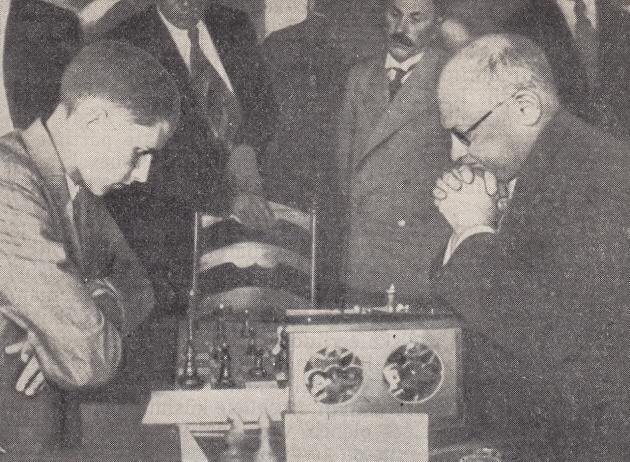
Paul Keres v Savielly Tartakower, Kemeri, 1937
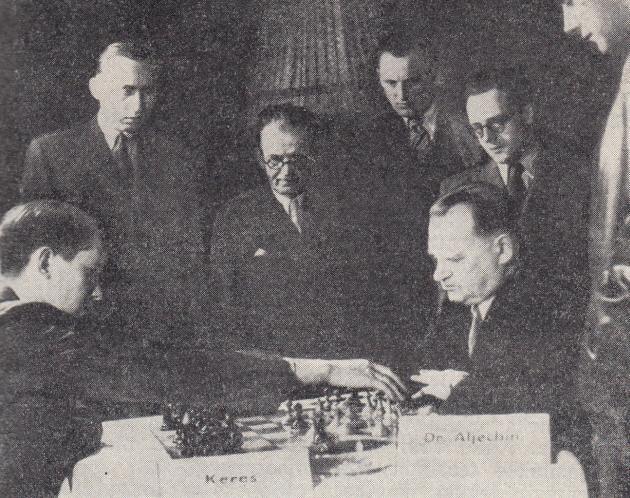
Paul Keres v Alexander Alekhine, Prague, 1943
(7802)
Simon Browne (Somerville, Australia) notes the remarks by Alekhine about possible world championship rivals on page 178 of 107 Great Chess Battles (Oxford, 1980):
‘Before 1940 I was quite certain that two masters, Botvinnik and Flohr, wished to fight for this title. Neither of the two matches could be brought about, and the above-mentioned challengers know very well that I had decided to face them.
As regards Keres, his position in 1938-39 was less resolved; he gave the impression of preferring to let a few years pass. But in 1943, perhaps influenced by the disastrous results he obtained against me in recent meetings (+3 =3 –0 in my favour) he resolutely declared that he had not the slightest intention of challenging me to a match. Fine too, in 1940, made an analogous declaration.’
These remarks were originally published on page xix of Alekhine’s book ¡Legado! (Madrid, 1946), and Mr Browne asks whether it is possible to find statements by Keres or Fine along the lines indicated by Alekhine.
Readers’ assistance will be appreciated. Firstly on this topic, we would draw attention to an earlier article by Keres, ‘The World Chess Championship’, published on pages 51-53 of the March 1941 Chess Review.
(7839)
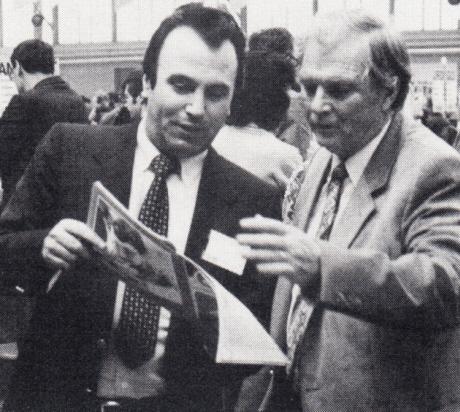
Alexander Roshal (left) is with Alex A. Aljechin (the world champion’s son) at the 1982 Olympiad in Lucerne. The photograph comes from page 586 of the December 1982 Schweizerische Schachzeitung.
(7840)
An article by G.H. Diggle in the November 1979 Newsflash and on page 52 of Chess Characters (Geneva, 1984):
‘Of all ex-world champions, Alekhine has (from some quarters) been “most notoriously abused”. For example, Harold Schonberg (Grandmasters of Chess) while acknowledging the master’s genius, opines that “few would care to say much in his favor as a human being”. He was, it seems, a “loner” and a “social monster” – he could not bear to lose at chess or even at more frivolous pastimes – amongst other disagreeable accomplishments he was, in adversity, an inveterate ping pong ball crusher. On one occasion (we read) when his opponent stood at match point, the Doctor “grabbed the ball”, shouted “Stop the game! Adjourned!” and then “tried to pass it off as a joke”. (But perhaps it was a joke; though not so good as the one about the wealthy “Britisher” of foreign extraction, who attempted to ride to hounds, but soon exclaimed: “Hi! Stop ze chase! I tumble! I fall off! Stop ze fox!!”)
But William Winter (Kings of Chess), who was Alekhine’s companion at many congresses, gives a far more favourable picture. “He was excellent company and full of good stories about his fellow-masters, all completely unmalicious. An excellent trait in his character was the generous praise he was always willing to bestow on any fine performance by one of his rivals. For example, he described the game played by the British champion, Yates, against Vidmar at San Remo as ‘the greatest game since the War’.” He also called one of his own losses to Yates a “belle partie”. Winter’s estimate is supported fully when one examines Alekhine’s notes to My Best Games of Chess, Nottingham, 1936 and The World’s Chess Championship, 1937 (v Euwe). They are unbiased, human and often humorous. He calls Euwe’s 35th move in Game 19 a defence “which, in my opinion, very few masters would have found” and Euwe’s king’s knight in Game 25 “the most hated knight of the match”. He is always scrupulously fair to Capablanca, with whom he was then at variance; and he deals with his own blunders without extenuation: “An awful move; the fact that White was very short of time is, to my mind, as little to be considered as an excuse as, for instance, the statement of the law-breaker that he was drunk at the moment that he committed the crime. The inability of an experienced master to deal with the clock should be considered as grave a fault as a miscalculation.”
He was, no doubt, in some respects, an unreliable man. An eminent chess editor (who had known all three masters) once told the BM that had any journalist attempted to arrange interviews with Fischer, Alekhine and Botvinnik respectively, Fischer would not have “bothered with the guy”, Alekhine would have said “Yes” and then failed to turn up, and Botvinnik would not only have granted the interview but would have been there dead on time.’
As regards Alekhine and table tennis, see page 152 of The World’s Great Chess Games by Reuben Fine (New York, 1951) and some remarks by Spassky in an interview with Leonard Barden on page 13 of the January 1970 Chess Life & Review. Concerning Vidmar v Yates, see C.N. 3227 (page 123 of Chess Facts and Fables).
(7973)
From Michael Negele (Wuppertal, Germany):
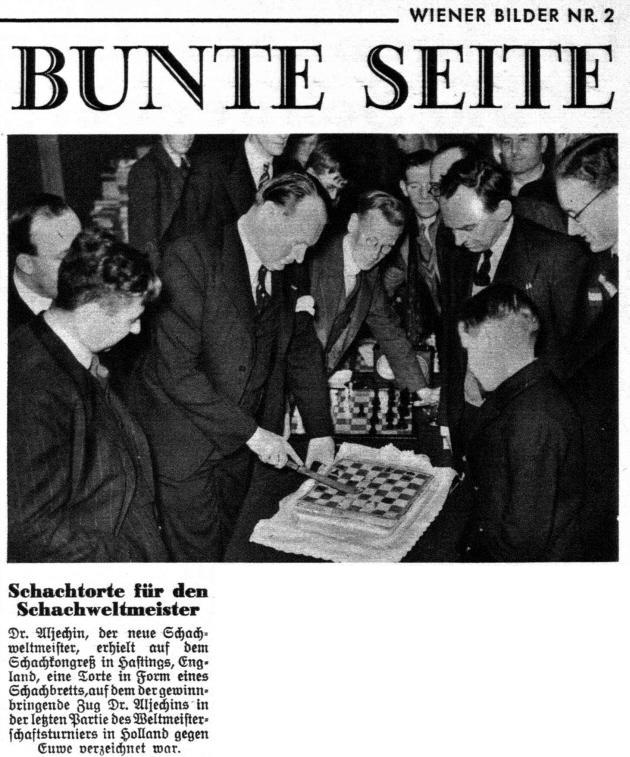
Source: Wiener Bilder, 9 January 1938, page 6. The occasion was mentioned on, for instance, page 79 of The World-Championship Match by B.H. Wood (Sutton Coldfield, 1938), and below we quote from page 26 of Chess for the love of it by A.R.B. Thomas (London, 1973):
‘Alekhine had just regained his world title from Euwe and he came to the congress [Hastings, 1937-38] as a spectator. In Holland he had been presented with a cake which showed the final position on the board when he regained his title. Before our first round started, he cut up the cake and gave each of us ten competitors a piece. Every day he watched the play intently and discussed the games afterwards with the players. More and more he convinced me that he truly loved chess and indeed was unable to understand that people could exist who were unable to sacrifice their whole lives to play chess, once they had learnt its beauty. He was an utterly dedicated man.’
(7981)
Dominique Thimognier has forwarded a shot of Alekhine which was published on page 29 of La Tunisie Revue Mensuelle Illustrée, February 1938:
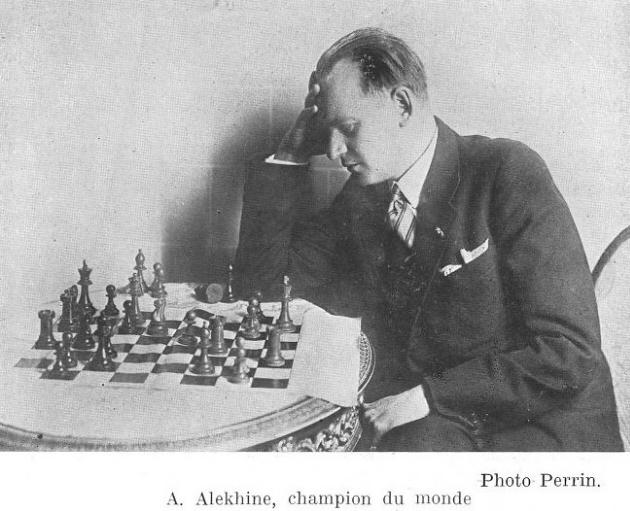
Our correspondent adds that according to the article which followed, the photograph was taken during the world champion’s tour of Tunisia in December 1934.
We note that the position is the conclusion of Alekhine’s victory over Lasker in Zurich earlier that year.
(8043)
A Chess Omnibus had this footnote on page 308:
Another straightforward example of K. Whyld’s propensity for distortion and untruth is his assertion (Kingpin, Summer 1997, page 61) that on page 264 of Chess Explorations we ‘savaged’ Irving Chernev over a Lasker/Capablanca matter. The public record is 100% clear there too. As regards Whyld’s conduct regarding F.M. Edge (see pages 245-260 of A Chess Omnibus), at the Chess Café on 1 August 2000 we quoted a number of Frank Skoff’s apposite observations about Whyld, from a communication to C.N. dated 17 November 1989. Among the milder ones were: ‘He thinks calling people names (including myself) somehow is proof by itself’ and ‘It is astonishing how little value K.W. places on truth: He prefers its suppression at any cost. Why?’
Below is the complete passage on page 264 of Chess Explorations:
C.N. 564 quoted from pages 38-39 of Chernev’s Wonders and Curiosities of Chess:
‘A strange disaster occurred to Lasker and Capablanca in 1934. Alekhine beat Lasker at Zurich in 26 moves, sacrificing his queen to do so; Lilienthal beat Capablanca at Hastings in 26 moves, sacrificing his queen to do so!’
Alas, the Lilienthal-Capablanca game was played on 1 January 1935.
Would anyone other than K. Whyld suggest that the above passage ‘savaged’ Irving Chernev?
From John Donaldson comes a further photograph (Pasadena, 1932) contained in the archives of Jacqueline Piatigorsky:
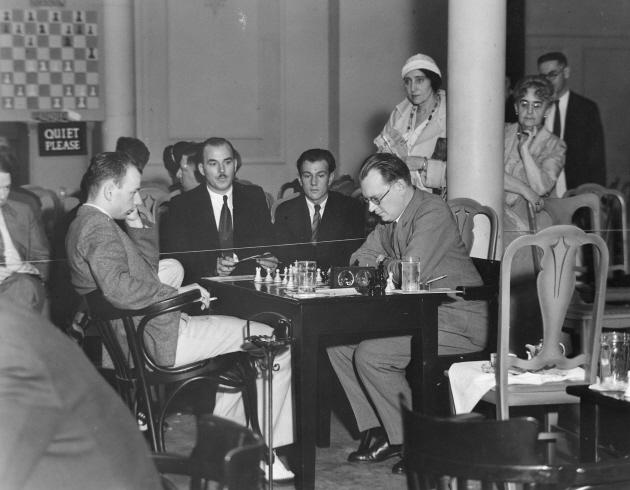
The shot appeared in small format in the monograph on Dake, Grandmaster from Oregon by Casey Bush (Portland, 1991). As mentioned in C.N. 3306, we have a copy of the book extensively inscribed and annotated by Dake. From the plates section:
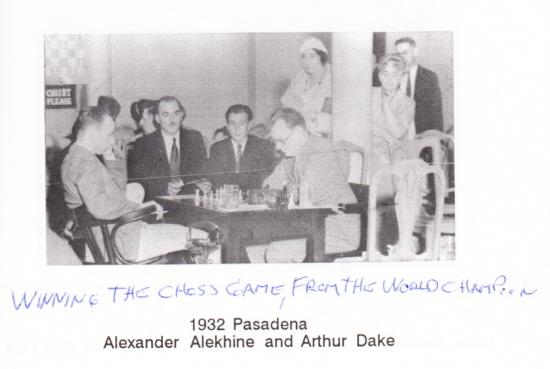
From the bottom of the book’s last page:
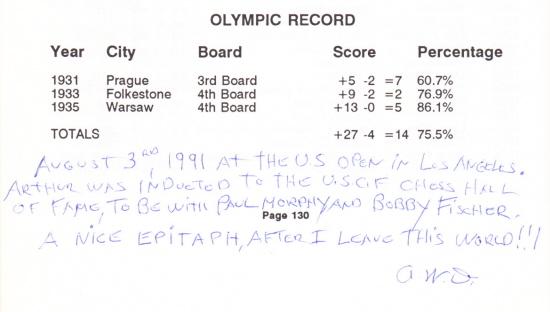
(8049)
Two correspondents in Paris, Christophe Bouton and Denis Teyssou, inform us that they have created a webpage concerning notebooks written by Alekhine towards the end of his life.
Future C.N. items will revert to a number of matters, but for now we invite readers to peruse the material presented so far. It is not to be missed.
(8060)
A search in Google Books, or on the Internet more generally, throws up all kinds of claims as to when Alekhine became French. For example, from page 234 of the New Encyclopaedia Britannica (various editions) and the Universalium website:
‘After the Russian Revolution of 1917, Alekhine became a naturalized French citizen ...’
On the other hand, the introduction to a Keres v Alekhine game in the various editions of L’art de faire mat by Georges Renaud and Victor Kahn – both of whom knew Alekhine well – stated ‘naturalisé français en 1929’.
The year 1925 is often seen too, but an editorial note on page 22 of the January 1962 Europe Echecs (C.N. 8025) gave a specific date in 1927, commenting that the world title match in Buenos Aires began as a contest between a Russian and a Cuban and was won by a Frenchman:
‘Pour conclure ces souvenirs concernant Alekhine, rappelons un fait curieux: né en 1892 à Moscou, Alekhine a été naturalisé français par décret du 2 novembre 1927 alors qu’il disputait en Amérique du Sud, du 16 septembre au 30 novembre 1927, le championnat du monde qu’il remporta contre Capablanca. Si bien que le match commencé par un Russe contre un Cubain fut gagné par un Français.’
Can official documentation be found regarding Alekhine’s naturalization?
(8054)
Dominique Thimognier writes that a CD-ROM on ‘Naturalisations en France entre 1900 et 1950’ records that Alekhine was naturalized on 5 November 1927, the same day as his wife (née Fabritsky, born in Odessa on 19 March 1884). The decrees were numbered 11670-27 and 11676-27 respectively.
We are also grateful to Stéphane Krebs (Cafquefou, France) for providing the same information, from the genealogie.com website.
(8058)
From Denis Teyssou:
‘I have consulted the 38 files of Alekhine’s naturalization record at the French national archives in Pierrefitte-sur-Seine and have posted a facts page.
Alekhine tried several times to become a French citizen between 1924 and 1927 and finally obtained citizenship with the support of Fernand Gavarry, who was the President of the French Chess Federation and a Plenipotentiary Minister at the Foreign Affairs Ministry. On 20 April 1927 Gavarry sent a letter on the Federation’s stationery asking the French authorities to grant Alekhine French citizenship so that he could lead the national team at the first International Team Tournament, to be held in London in July 1927. However, Alekhine had to await the promulgation of a new Law on naturalization to obtain a French passport.
My page also comments on Alekhine’s date of birth (C.N.s 4719 and 4739). I report too that in April 1922, three months after his arrival in France, Alekhine was suspected of Bolshevism, which, besides his frequent trips abroad, contributed to delays in the processing of his naturalization application between 1924 and 1927.’
(8284)
Denis Teyssou informs us that he has been authorized to post on his website documents relating to Alekhine’s application for French citizenship in the 1920s.
(8366)
Denis Teyssou points out that the registration record of Alekhine’s last marriage (26 March 1934) is available on line at the website of the Conseil général des Alpes-Maritimes (page 4):
‘Alexandre Alekhine, homme de lettres, né à Moscou (Russie) le dix-neuf octobre mil huit cent quatre-vingt-douze, quarante [et] un ans, domicilié à Villefranche-s-mer, fils majeur de Alexandre et de Agnès Prokhoroff, divorcé de Nadezda Simonovna Fabritzky depuis le dix-neuf février mil neuf cent trente-quatre.’
‘Grâce Wishaar, sans profession, née à Beverly, état de New Jersey (Etats-Unis d’Amérique) le vingt-six octobre mil huit cent quatre-vingt-six, quarante-sept ans, domiciliée à Villefranche-s-mer, fille majeure de Emile Bernard et de Marie Ida Smith, divorcée de Henry James Bromley, veuve de Archibald Freeman.’
Mr Teyssou notes that Grace Wishaar’s year of birth was given as 1886, rather than 1876. See page 254 of Chess Facts and Fables and C.N. 7565.
(8074)
From page 34 of Famous Chess Players by Peter Morris Lerner (Minneapolis, 1973):
‘From 1921 to 1927 Alekhine won practically every tournament in which he played. Only the current world champion, José Capablanca, and ex-world champion Emanuel Lasker could restrain him.’
By no means did Alekhine win practically every tournament during that period, and below is a comment of ours in The Games of Alekhine:
‘As he neared his goal of a match against Capablanca, his playing-record remained patchier than is sometimes imagined, particularly in tournaments which also featured other potential challengers.’
(8008)
With readers’ help we hope to draw up an accurate list of Alekhine’s wives with as many biographical dates as possible. As a starting-point, there follows an extract from the obituary of Alekhine by Erwin Voellmy and Jean-Charles de Watteville on pages 85-86 of the June 1946 Schweizerische Schachzeitung:
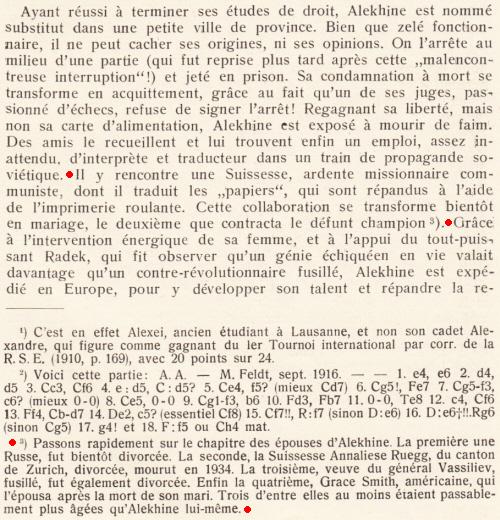

(8009)
Dominique Thimognier draws attention to the article ‘Souvenirs d’une époque révolue’ by Jeanne Léon-Martin published on pages 3, 4 and 22 of the January 1962 Europe Echecs, having originally appeared in the Bordeaux newspaper Sud-Ouest. Our correspondent comments:
‘She and her husband, the problemist Gabriel Léon-Martin, were friends of Alexander Alekhine and his third wife, Madame Vassilieff. There is a detailed explanation of how Jeanne Léon-Martin introduced Grace Freeman to Alekhine, and how this led to his divorce from Madame Vassilieff.
The article must cast serious doubt on the oft-repeated story that Alekhine met Grace Freeman during a simultaneous exhibition in Tokyo, given that Madame Léon-Martin specifies that his separation from Madame Vassilieff occurred earlier and that Grace Freeman “accompanied Alekhine on his world tour”.
The article is also interesting for the details provided regarding Alekhine’s home life (rue de la Croix-Nivert, Paris) and his interest in bridge.
On the other hand, it supplies scant information regarding dates. Madame Léon-Martin was the “pioneer” of women’s chess in France, and she organized the first French championships (starting in 1924). Her article indicates that she introduced Grace Freeman to Alekhine when she, Grace Freeman, had just enrolled for the French championship. The first reference to Grace Freeman that I have found in a list of participants in the French women’s championship is in February 1931. She participated again in 1932 and 1941. (A photograph taken during the 1941 championship may well feature her, but I am not sure.) It would therefore appear that Alekhine and Grace Freeman met in 1931 or 1932, before Alekhine’s world tour (which began at the end of 1932).
I would also mention an article by Genna Sosonko, “Alexander Alekhine, The Paris years” on pages 80-87 of the 1/2010 New in Chess. It relates how Alekhine met Nadezhda Semenovna Vasilieva, née Fabritskaya, at a Russian ball in Paris in 1924, but unfortunately Sosonko provides no sources.’
The Sosonko article can also be found on pages 38-49 of his latest anthology, The World Champions I Knew (Alkmaar, 2013).
We transcribe a few extracts from Jeanne Léon-Martin’s article:
‘Il [Alekhine] fit la connaissance, avant son départ pour l’Amérique d’où il revint champion du monde, de Mme Vassilieff, veuve d’un général ...
Un jour, une Américaine, Mme Freeman, vint me demander de bien vouloir l’inscrire comme participante [in a women’s tournament]. Elle était grande, gaie et paraissait fort enthousiaste du jeu d’échecs. Sur le bateau qui la ramenait des Etats-Unis, un tournoi d’échecs avait été organisé et elle avait gagné un livre d’Alekhine: Deux cents parties d’échecs. Elle habitait un coquet appartement, très moderne, à Montparnasse, et je fus invitée chez elle avec quelques-unes de ses compatriotes. Mme Freeman me confia qu’elle serait très heureuse si Alekhine pouvait lui dédicacer le livre qu’elle avait gagné.[Since Deux cents parties d’échecs was not published until 1936, the book in question may well have been the English edition of Alekhine’s first volume of Best Games, published in 1927.]
... Ayant organisé une rencontre pour “samedi prochain”, j’avais la conscience absolument tranquille et j’étais plutôt satisfaite d’avoir fait plaisir à tous.
Ce samedi-là, lorsque nous sommes arrivés mon mari et moi – Mme Freeman devait venir plus tard – Alekhine chantait une de ses chansons préférées: “J’embrasse votre main, madame”, accompagné au piano par Mme Isnard. Lorsque Mme Freeman fut là et après qu’Alekhine eut dédicacé son livre, je laissai le champion, Mme Freeman et des amis faire une partie de bridge derrière les fameuses tentures ... partie qui durait encore lorsque nous primes congé.
Quelque temps après, je reçus un coup de téléphone de Madame Alekhine me donnant rendez-vous à la Régence. Cela ne me surprit pas. Nous avions l’habitude de nous rencontrer quelquefois dans Paris pour prendre le thé. “Alors, lui dis-je, comment trouvez-vous Mme Freeman? Sympathique, n’est-ce pas?
– Oui, certainement ... Trop peut-être! Elle a beaucoup plu à Alekhine. Déjà, dès cette première rencontre, à la fin de la partie de bridge, il a tenu à la raccompagner ... C’est fini pour moi. Je sais qu’elle a gagné et que j’ai perdu.”
J’étais bouleversée. Il me semblait que j’étais coupable. Avec l’expérience que la vie lui avait durement inculquée, elle comprit mon désarroi. Très bonne et peut-être un peu fataliste, elle me dit sans animosité:
“Mme Freeman saura garder Alekhine.” J’aurais voulu la consoler. Ce fut elle qui me consola. Sensiblement plus âgée qu’Alekhine, elle devait mourir peu après.
Mme Freeman devint Mme Alekhine. Elle l’accompagna lors de son tour du monde, en Asie, en Indonésie. Ils habitèrent jusqu’à la guerre de 1939 le château d’Arques-la-Bataille, près de Dieppe, propriété de Mme Freeman.’
(8025)
Chris Turnbow (Memphis, TN, USA) notes a press release concerning the pianist Nikolai Lugansky, who states:
‘Alekhine was always my favourite chessplayer, even in my childhood. I was impressed by his ability to find the thread for a combination of almost any position. The quadruple world champion viewed every chess game as a work of art – as a chess fan, that way of thinking of things is very close to my own.’
The unusual term ‘quadruple world champion’ evidently reflects the fact that Alekhine won four world title matches.
Our correspondent asks whether light can be shed on the following statements about Alekhine (not by Lugansky) in the press release:
‘In 1939, during the chess Olympics in Buenos Aires, he called for the German team to be disqualified because of the German attack on Poland. After the Olympics he performed charity games, with funds going to the Polish Red Cross.’
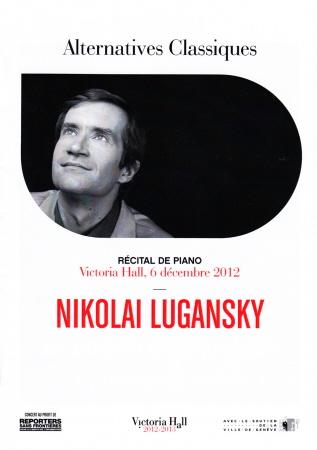
(8010)
Chess researchers soon learn that their work, however painstaking, is liable to be either plagiarized or, conversely, ignored. A familiar Alekhine brilliancy illustrates the latter course:
1 e4 c5 2 Nf3 e6 3 d4 b6 4 d5 d6 5 Nc3 a6 6 a4 Nf6 7 Bd3 h6 8 O-O Be7 9 h3 O-O 10 Re1 exd5 11 Nxd5 Nbd7 12 Bf4 Nxd5 13 exd5 Nf6 14 c4 Re8 15 Bc2 Nh7 16 Qd2 Bd7 17 Bxh6 gxh6 18 Qxh6 f5
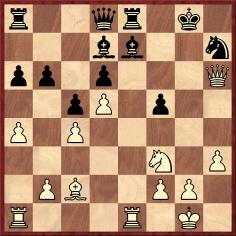
19 Re6 Bxe6 20 Qxe6+ Kg7 21 Qxf5 Nf8 22 Qg4+ Kh6 23 Ra3 Bf6 24 h4 Ra7 25 Ng5 Re1+ 26 Kh2 Qe8 27 Rf3 Qe5+ 28 g3 Qxb2 29 Rf5 Ng6
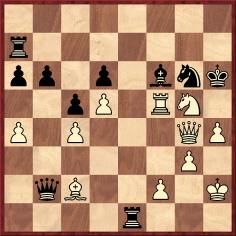
30 Qh5+ Resigns.
When the game was published on page 267 of the June 1934 BCM (‘played in a simultaneous display in Czechoslovakia last year’) Black was named as ‘Ing. Kontay’, and no other details were provided (C.N. 1041). However, pages 479-480 of Alexander Alekhine’s Chess Games, 1902-1946 by L. Skinner and R. Verhoeven (Jefferson, 1998) showed that the exhibition took place in Prague on 20 November 1933 and that Black’s name was Koutný. The source specified was Československý Šach (January 1934, pages 11-12):

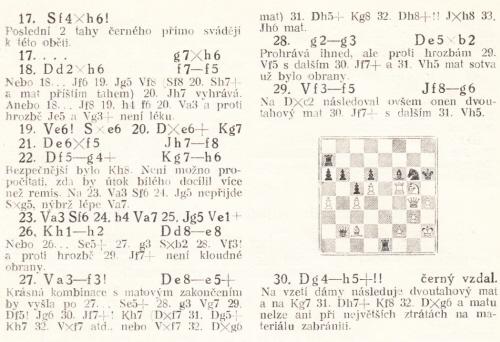
Thus apart from the unrecorded forename of Black (‘Ing.’ means engineer, i.e. inženýr), all key details concerning the game were readily available in 1998.
Readers who recall C.N. 3507 [see above] will not be surprised to learn that page 5 of Alexander Alekhine Master of Attack by A. Raetsky and M. Chetverik (London, 2004) went astray, dating the game not 1933 but ‘1935’. A date one further year out (‘1936’) was on page 75 of another Everyman Chess book, The Times Winning Moves by R. Keene and B. Jacobs (London, 2003):
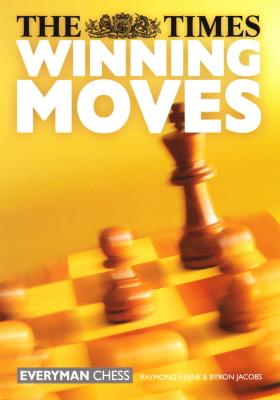
The inaccurate or incomplete references to other Alekhine games in The Times Winning Moves (see pages 29, 33, 35 and 41) could all have been avoided by consulting Alexander Alekhine’s Chess Games, 1902-1946. Below is the last of those four positions, offering a small example of how chess information and knowledge go backwards in the hands of hack writers:
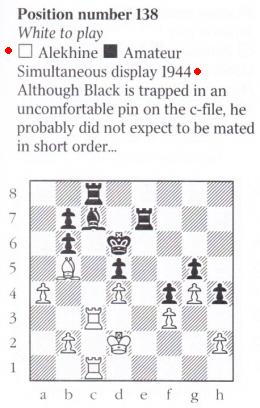
Keene and Jacobs, 2003.
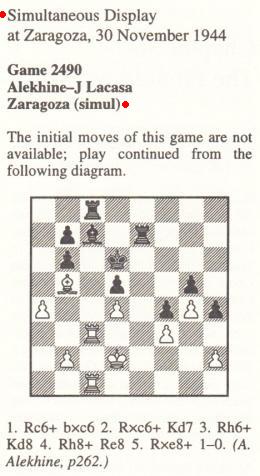
Skinner and Verhoeven, 1998
When this game ending was given in the Spanish and English editions of Pablo Morán’s monograph on Alekhine (see pages 337-338 and 262 respectively), it was pointed out that Black was a well-known figure, Juan Lacasa Lacasa.
A more general point is that many of the other positions in the 2003 Keene/Jacobs book published by Everyman Chess were mere repeats of what had already appeared in two similar volumes by Raymond Keene for Batsford, The Times Winning Moves (1991) and The Times Winning Moves 2 (1996). For instance, ‘Yanowsky v Toriran, Canada, 1953’ is in the second and third books (on, respectively, pages 78 and 57).
(8116)
From our article on World Champion Combinations by Raymond Keene and Eric Schiller (New York, 1998):
Keene and Schiller report that Euwe dethroned Alekhine in 1937; everybody else believes that Euwe won the title in 1935 and lost it in 1937.
From page 73 of Chessnicdotes II by G. Koltanowski (Coraopolis, 1981):
‘During the International tournament in Paris, 1927, Dr Alexander Alekhine had all of the contestants up to his hotel suite. He had just returned from Argentina, having beaten Jose Raoul Capablanca for the world title in Buenos Aires. After a special rapid transit round robin tournament, coffee, tea, whiskey, cake and “klatch”, I managed to corner our host and asked him: “Is there anyone in the world today that could take the world title away from you?” Alekhine twiddled his blond hair and smilingly replied, “Non! I am the greatest!”’
Wanted: information about ‘the International tournament in Paris, 1927’.
(8158)
See Koltanowski for other examples of his writings about Alekhine.
On page 331 of the November 1952 Chess Review Tartakower wrote concerning the Capablanca:
‘On that occasion [in 1938], he remarked, “I relied too much on intuition and didn’t prepare properly for my world championship match with Alekhine in 1927. I paid the penalty.”
“Thereafter I tried to avoid intuitive play as much as possible, and this cost me many a valuable point.
“So intuition was at fault?”, I inquired.
“Intuition”, Capablanca replied, “is a wonderful means to an end; but intuition should not be made the end of all the means that intelligence places at our command. This may seem like one of the paradoxes you love so dearly; but it is, just the same, a tragic truth which I have felt very deeply in the course of a career which has been rich in kaleidoscopic changes.”’
(8163)
Asked about chess books which had a profound influence on him, John Nunn replied (see the 3/2002 New in Chess, page 98):
‘When I was a young player, I read The Most Instructive Games of Chess Ever Played by Irving Chernev which made chess seem extremely easy. However, I then read Alekhine’s Best Games of Chess, which made chess seem impossibly difficult. I eventually discovered that the truth lies somewhere between the two.’
Dr Nunn informs us:
‘I was referring to the 1924-37 volume by Alekhine. I recall being particularly impressed by 18...Nxf2 in Rubinstein v Alekhine, Semmering, 1926, or rather the fact that Alekhine must have seen it some time in advance.’
(8196)
Javier Asturiano Molina notes a passage on page 82 of Half a Century of Chess by Mikhail Botvinnik (Oxford, 1984):
‘There, in England, I finally gained international recognition, and after the tournament [Nottingham, 1936], on the pages of Manchester Guardian, Alekhine declared that Botvinnik had every chance of becoming world champion.’
Our correspondent asks if Alekhine’s exact words can be found.
The article was published on pages 13-14 of the Manchester Guardian, 29 August 1936, and the full text is given below:

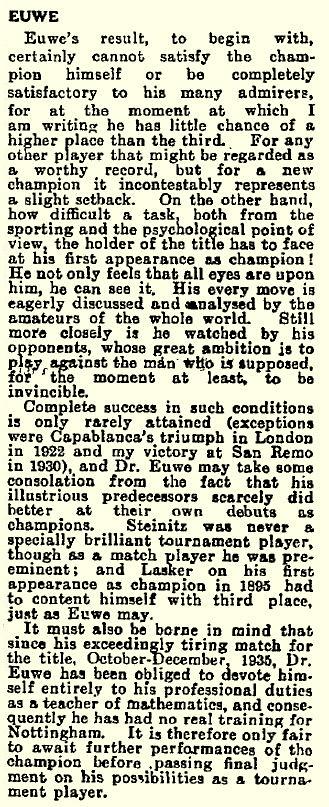
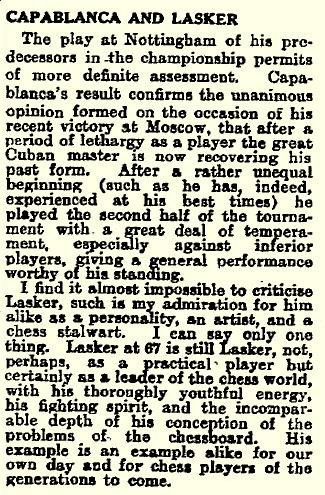
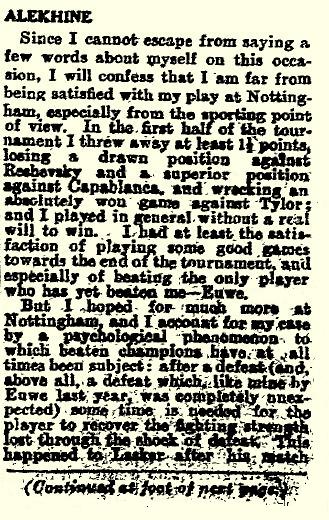
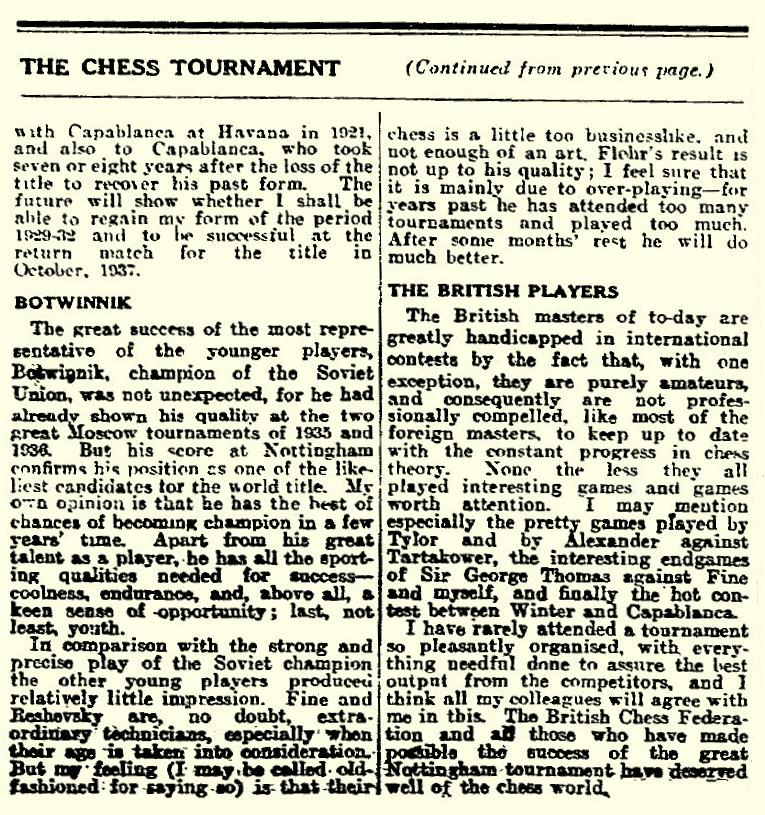
(8233)
From pages 84-85 of The Fireside Book of Chess by I. Chernev and F. Reinfeld (New York, 1949):
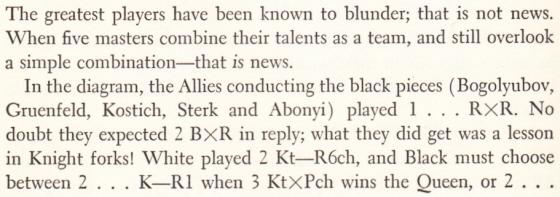
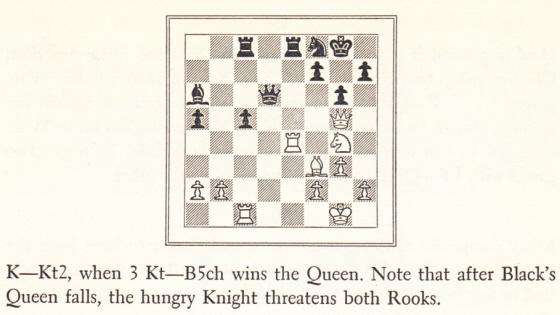
From page 30 of The Delights of Chess by Assiac (London, 1960):
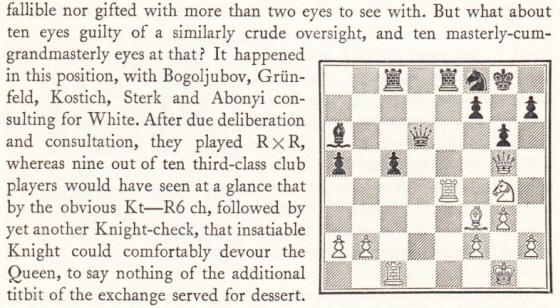
Both books omitted to identify the venue, date and opposing side, yet they contradict each other as to whether Bogoljubow and his allies played White or Black, and whether the move was ...Rxe4 or Rxe8. Chernev and Reinfeld were correct on both points.
Bogoljubow and his allies had Black against Alekhine, Sämisch, Steiner, Tartakower and Vajda. The game took place in Budapest on 20 September 1921 and was published on pages 1-4 of the January 1922 issue of Kagans Neueste Schachnachrichten. The magazine reported that the rate of play was 20 moves per hour and that the Black allies were in time-trouble when they blundered with 32...Rxe4.
The full score is on pages 146-147 of Alexander Alekhine’s Chess Games, 1902-1946 by L. Skinner and R. Verhoeven (Jefferson, 1998).
(8308)
Regarding the consultation game (Budapest, 1921) won by Alekhine, Sämisch, Steiner, Tartakower and Vajda against Abonyi, Bogoljubow, Grünfeld, Kostić and Sterk, we add that one phase was discussed by Tartakower on page 110 of Die Hypermoderne Schachpartie (Vienna, 1924).
(8592)
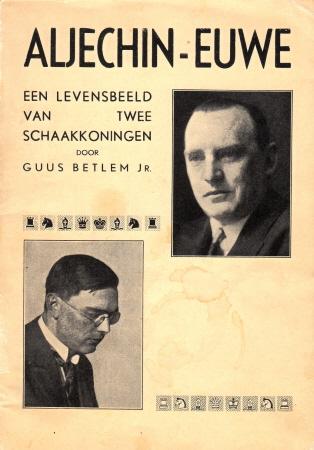
‘He is a poet who creates a work of art out of something which would hardly inspire another man to send home a picture postcard.’
That well-known quote (Euwe on Alekhine) provides a small illustration of the current state of chess ‘scholarship’ on the Internet. It is commonly given sourcelessly, but what happens if, as is only reasonable, basic information is wanted about the occasion and context (e.g. whether Euwe was writing in general or was referring to a particular game or theme, and whether he expressed the sentiments before or after winning the world title from Alekhine)? We leave readers to try to find any websites which:
i) mention that the remark comes from Euwe’s book Meet the Masters (London, 1940). See pages 27-28.
ii) give the full paragraph with its context (Euwe’s introduction to Alekhine v Lasker, Zurich, 1934):
‘Curious is Alekhine’s knack of developing a seemingly harmless attack, within a few moves, into a hurricane which smashes down all resistance. His methods are simple; it is not so much any particular move which is important, as the whole series of moves – and the move after that! He is a poet who creates a work of art out of something which would hardly inspire another man to send home a picture postcard.’iii) provide, especially in the case of Dutch-language webpages, Euwe’s original text, from page 16 of Zóó schaken zij! (Amsterdam, 1938):
‘Eigenaardig is de kunst van Aljechin, een oogenschijnlijk onschuldigen aanval binnen enkele zetten te doen aangroeien tot een orkaan, welke alle tegenstand breekt. Hij gebruikt dan vaak heel eenvoudige middelen, waarbij niet elke zet afzonderlijk maar de heele reeks van zetten en vooral ook de volgende beslissende beteekenis heeft. Hij is dichter, die kunstwerken schept met dezelfde middelen, welke een ander nauwelijks voldoende zou vinden om een briefkaartje te schrijven.’
There have also been, of course, many printed versions of the Euwe quote without a source. Curiously, a few English-language publications continue, after the word ‘postcard’, with:
‘The wilder and more involved a position, the more beautiful the conceptions he can evolve.’
See, for instance, page 50 of The New Yorker, 28 October 1972 (an article by George Steiner on the 1972 world championship match), pages 15-16 of Steiner’s book The Sporting Scene (London, 1973) and Kasparov’s Foreword to Alexander Alekhine’s Best Games (London, 1996). All three publications had ‘conception’ in the singular.
In fact, that sentence by Euwe came several pages later in Meet the Masters, on page 32. The Dutch text (on page 19 of Zóó schaken zij!) was:
‘Hoe wilder en verwarder een stelling is, des te fraaiere combinaties weet de wereldkampioen ons voor te tooveren.’
(8474)
A detail of Alekhine from the Carlsbad, 1911 group photograph (Wiener Schachzeitung, September-October 1911, pages 304-305):
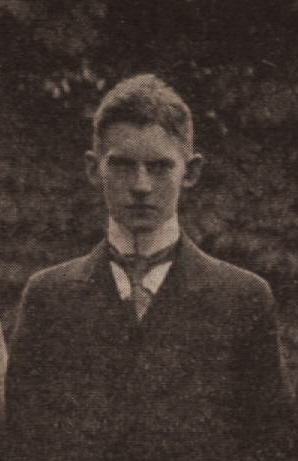
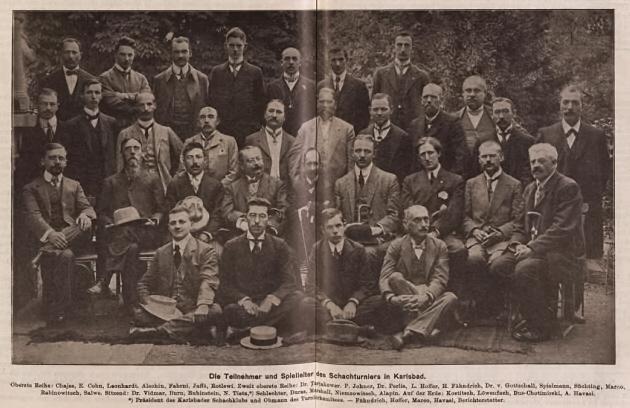
(8574)
Further to the references to Rudolf Spielmann in Chess: the Need for Sources, the passage below comes from page 111 of The Bright Side of Chess by Irving Chernev (Philadelphia, 1948):
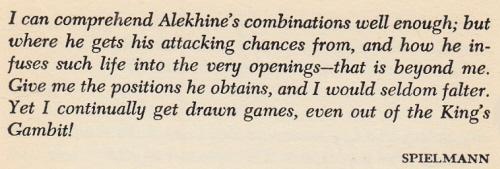
Can the original text be traced?
(8579)
From page 3 of Meet the Masters by Max Euwe (London, 1940):
‘Ordinary mortals can envy Alekhine’s genius in the discovery of charming and startling combinations; the more skilful player who feels himself quite capable of executing such combinations has a different feeling on the subject. To quote Spielmann, who is surely competent to pass an opinion on combinative skill: “I can comprehend Alekhine’s combinations well enough; but where he gets his attacking chances from and how he infuses such life into the very opening – that is beyond me. Give me the positions he obtains, and I should seldom falter. Yet I continually get drawn games, even out of the King’s Gambit.”
Well said, Master Spielmann! Alekhine’s real genius is in the preparation and construction of a position, long before combinations or mating attacks come into consideration at all.’
In case it helps in tracing the original of Spielmann’s words, below is the relevant section of pages 2 and 3 of the Dutch edition of Euwe’s book, Zóó schaken zij! (Amsterdam, 1938):
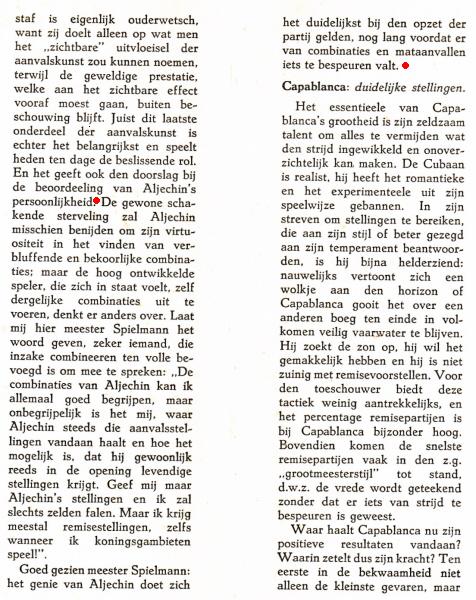
(8603)
Charles Krauthammer (‘current member of Chess Journalists of America’, the dust-jacket of Things That Matter proclaims) has only one thing to say about Alekhine, on page 56 (in an article from the Washington Post, 27 December 2002):
‘... Alexander Alekhine, who in 1935 was stopped while trying to cross the Polish-German frontier without any papers. He offered this declaration instead: “I am Alekhine, chess champion of the world. This is my cat. Her name is Chess. I need no passport.” He was arrested.’
Alekhine’s supposed words replicate what appeared on page 277 of The Golden Dozen by Irving Chernev (Oxford, 1976), but the story has been seen in many forms. Chernev, for instance, made no reference to an arrest or any other consequences.
On page 328 of the November 1956 Chess Review, in an article about the 1935 Olympiad in Warsaw, Reuben Fine wrote:
‘He began by arriving at the border without a passport. When he was asked for one, he replied: “I am Alekhine, chess champion of the world. I have a cat called Chess.” After this episode was straightened out, Alekhine came to the tournament and went through most of his games in a state of mild inebriation. Most remarkably, his play did not seem to be affected, though his eccentricities did cost him the world championship in the match with Euwe a few months later.’
That text was reproduced on page 47 of Fine’s book Lessons from My Games (New York, 1958). ‘After this episode was straightened out ...’ is not much of a dénouement, but the rapid switch to the subject of alcohol helps mask the anti-climax.
When relating the tale on page 59 of his Psychoanalytic Observations on Chess and Chess Masters (New York, 1956) Fine gave Alekhine a little extra dialogue (‘I do not need papers’) and introduced the requisite psychological slant (Alekhine ‘began to show some signs of megalomania’). He also beefed up the finale, adding after the Alekhine quote:
‘The matter had to be straightened out by the highest authorities.’
(8462)
Luc Winants submits the game below, which comes from an ‘alternating blindfold simultaneous display’ (six boards) given by Alekhine and Landau at the Hotel Atlanta, Rotterdam:
Alexander Alekhine and Salo Landau (blindfold, in tandem) –
C. Fontein, E.W. Beekman and P. van Reeuwijk
Rotterdam, 8 February 1934
Sicilian Defence
1 e4 c5 2 Nf3 Nc6 3 d4 cxd4 4 Nxd4 Nf6 5 Nc3 d6 6 Bg5 e6 7 Be2 Be7 8 O-O O-O 9 Kh1 d5 10 exd5 Nxd5 11 Bxe7 Ncxe7 12 Nxd5 Nxd5 13 c4 Nf6 14 Nb5 Qe7 15 Qd6 Qxd6 16 Nxd6 b6 17 Rad1 Ba6 18 b3 Rfd8 19 Bf3
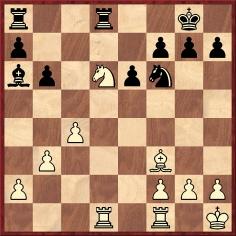
19...Nd5 20 cxd5 Rxd6 21 Rfe1 exd5 22 Rxd5 Rxd5 23 Bxd5 Rc8 24 h4 Kf8 Drawn.
Source: Rotterdamsche Nieuwsblad, 9 February 1934, page 23.
Mr Winants comments:
‘This game was played on board six. The book on Alekhine by Skinner and Verhoeven has four other games in the display (games 1767-1770 on pages 486-487). The game played on board four, against A.M. Broer, A. de Bruyn and P. van Os, is still missing.’
(8496)
From pages 151-152 of Chess Traps, Pitfalls, and Swindles by I.A. Horowitz and Fred Reinfeld (New York, 1954):
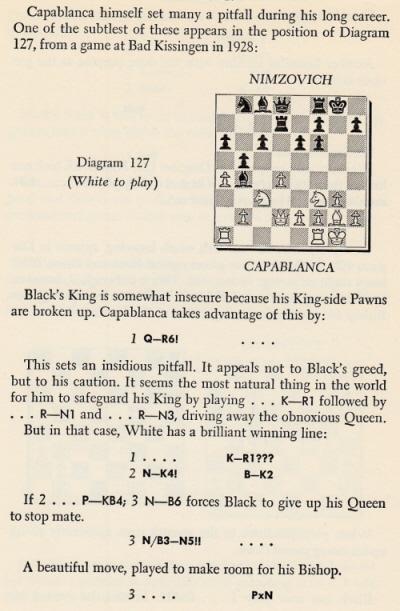
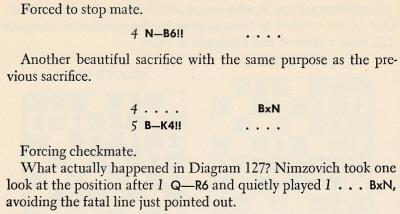
In the initial diagram the white queen should be on c1. We do not know the basis for the co-authors’ statement that after the move Qh6 Nimzowitsch merely ‘took one look at the position’ before ‘quietly’ capturing the knight. Indeed, we cannot say when either player became aware of the mating line; on page 470 of the December 1928 BCM J.H. Blake wrote that it was pointed out by Alekhine.
The world champion annotated the game deeply in the Basler Nachrichten, 8 September 1928:
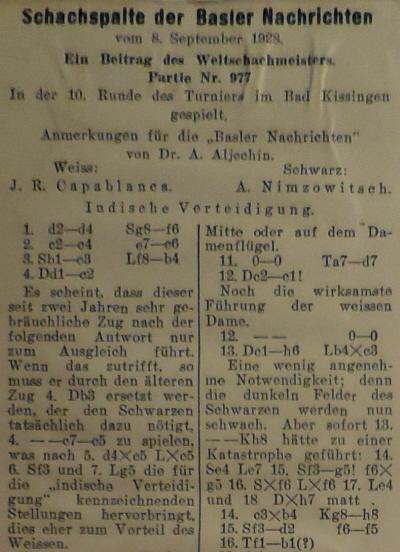
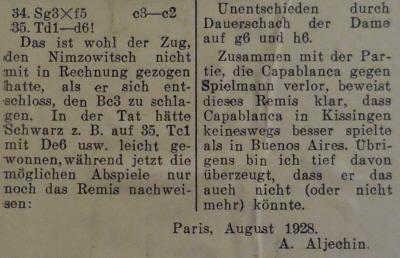
The full notes, incorporating some further remarks, were reproduced on pages 164-167 of the October 1928 Schweizerische Schachzeitung:
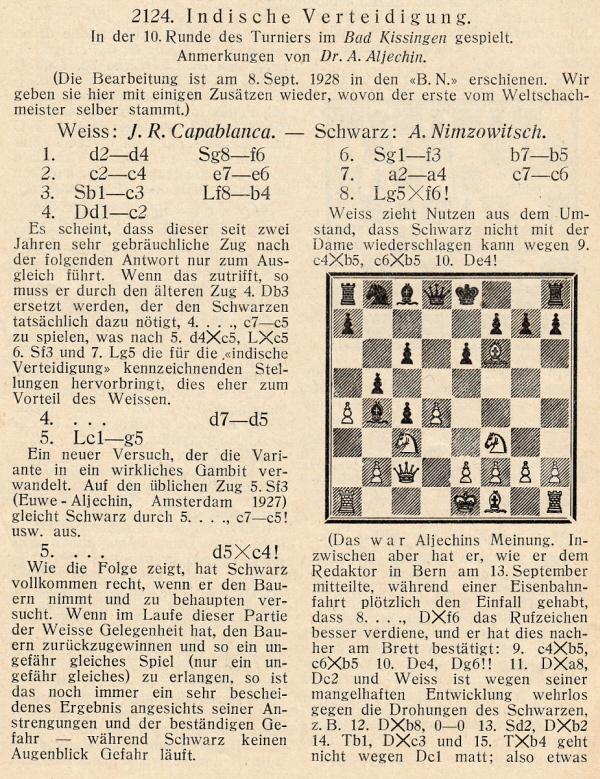
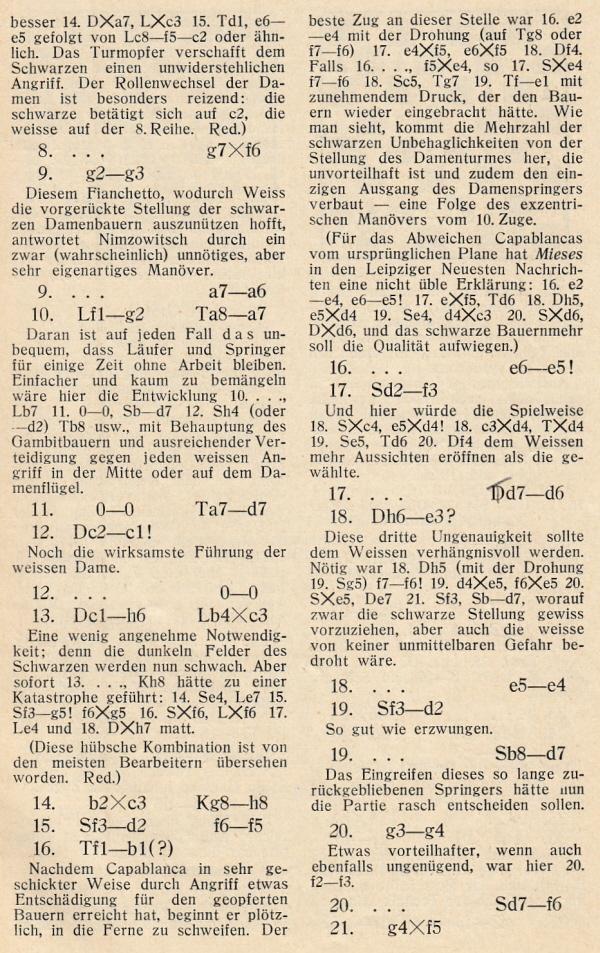
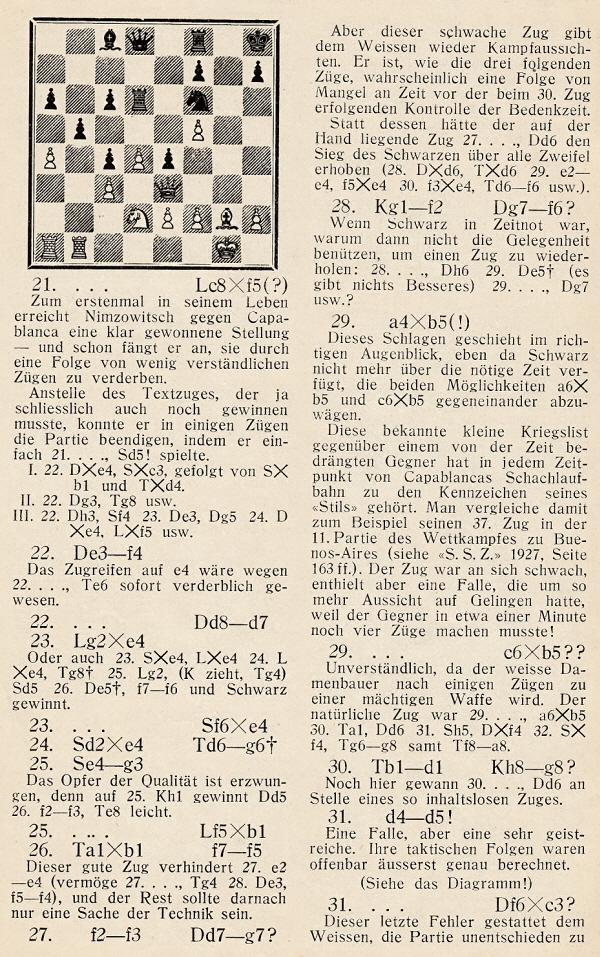
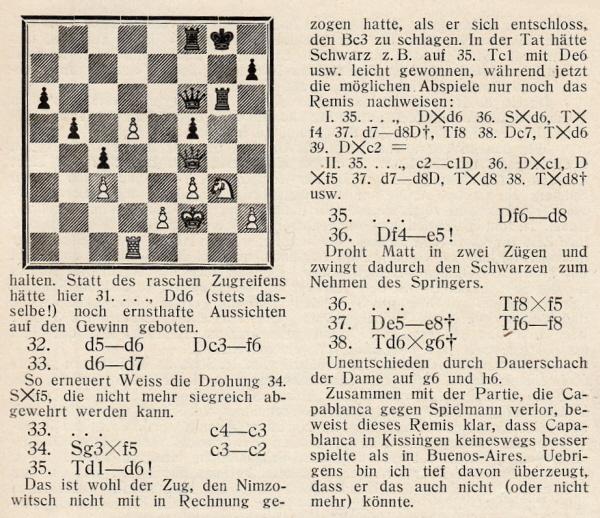
A different German version of Alekhine’s notes appeared, via Tidskrift för Schack, on pages 252-255 of Kagans Neueste Schachnachrichten, August 1929.
From pages 377-378 of the December 1928 Deutsche Schachzeitung:

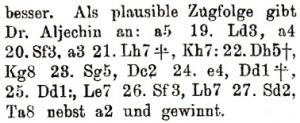
When the Deutsche Schachzeitung had annotated the full game on pages 273-274 of its September 1928 issue, the ‘insidious pitfall’ was overlooked, the following being the note to 13...Bxc3:
‘Es drohte Sc3-e4. Dennoch sollte sich Schwarz lieber die beiden Läufer erhalten, z. B. 13...Kh8! 14 Se4 Le7 als Tg8 und Tg6.’
Similarly, the notes in The Field, reproduced on pages 83-84 of the January 1929 Chess Amateur, stated after 13...Bxc3:
‘To stop Kt-K4. Better, however, would have been 13...K-R1 14 Kt-K4 B-K2, followed by ...R-Kt1 and ...R-Kt3.’
On pages 27-29 of Schachjahrbuch 1928 by L. Bachmann (Ansbach, 1929) the moves 12...O-O 13 Qh6 Bxc3 14 bxc3 Kh8 were given without comment. Nor was the mating trap mentioned in C.S. Howell’s annotations on pages 137-138 of the September-October 1928 American Chess Bulletin.
A detailed set of annotations appeared in Tartakower’s German-language tournament book. See too the coverage of the game on pages 37-41 of Aaron Nimzowitsch 1928-1935 by Rudolf Reinhardt (Berlin, 2010), or pages 39-43 of the English edition (Alkmaar, 2013)
(8594)
From page 275 of the July 1928 BCM:

The blindfold game against Damant [sic] is on pages 339-340 of the Skinner/Verhoeven collection of Alekhine’s games. The other one is given below, from page 26 of the 19 July 1928 edition of the Brooklyn Daily Eagle:
Alexander Alekhine (blindfold) – Charles Wreford Brown
London, 8 June 1928
Centre Counter Game
1 e4 d5 2 exd5 Nf6 3 d4 Nxd5 4 Nf3 c6 5 Be2 Bf5 6 O-O e6 7 c4 Nf6 8 Nc3 Be7 9 Re1 Nbd7 10 Bf4 O-O 11 Nh4 Nh5 12 Nxf5 Nxf4 13 Nxe7+ Qxe7 14 Bf3 Qb4 15 Qd2 Ng6 16 b3 Rad8 17 Rad1 Nf6 18 Qc2 Qa5
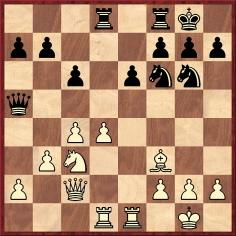
19 Ne4 Rxd4 20 Nxf6+ gxf6 21 g3 Rfd8 22 Kg2 Rd2 23 Qb1 Qg5 24 Rxd2 Rxd2 25 Re4 Qa5 26 Re2 Ne5 27 Bh5 Rxe2 28 Bxe2 Qd2 29 Qe4 Ng6 30 a4 f5 31 Qf3 Qg5 32 Kf1 Qc1+ 33 Kg2 Qg5 34 Kf1 Drawn.
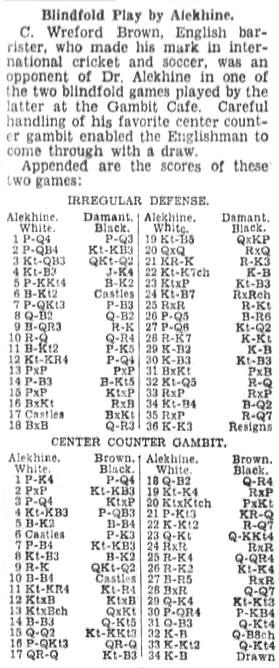
(8700)
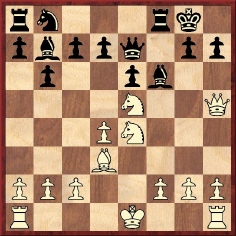
White to move
This famous position (11 Qxh7+) comes from a game extensively discussed in Chaos in a Miniature (Edward Lasker v George Thomas, London, 1912), but a noteworthy addition is that two decades later Lasker played it with the black pieces.
First, an extract from page 109 of the American Chess Bulletin, July-August 1933:
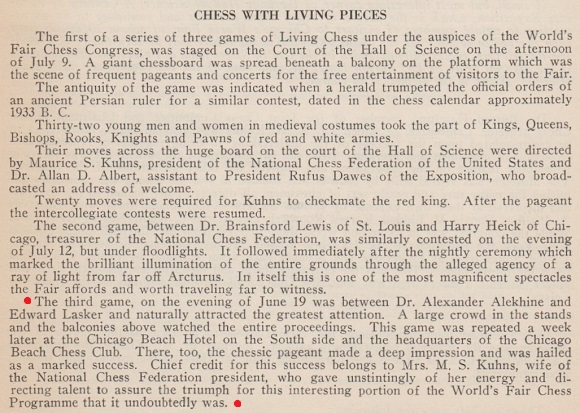
And from page 4 of the September 1933 Chess Review:
‘... on the evening of 19 June came the awaited meeting between Dr Alekhine and Edward Lasker. This naturally drew the largest gathering of any single chess event with the exception of the blindfold display. Alekhine won in good style, but the game itself was less important to the audience than the idea of the spectacle. This game was repeated later at the Chicago Beach Hotel.’
Neither US magazine gave the moves of the Alekhine v Lasker game, which in any case was pre-arranged. From pages 160-161 of Lasker’s The Adventure of Chess (New York, 1950):
‘In a chapter on eccentricities of the game, Liddell’s book [Chessmen by Donald M. Liddell (New York, 1937)] brings a picture of a board with living pieces used in a game played in the open-air amphitheater of the Century of Progress Exposition at Chicago, in 1933. I happened to direct that game, and the picture recalled to my mind a tragicomic incident which occurred toward the end of it. The chess pieces were mostly boys and girls from Chicago high schools, dressed in real old-Indian costumes. On the day of the game a bright, hot sun was shining, and over 5,000 onlookers crowded every available spot in the arena. To the majestic tune of a march especially composed for the occasion by the well-known composer DeLamarter, who was a resident of Chicago, the chess pieces, in impressive array, descended a wide stairway and took their places on the board. The world champion, Alekhine, had been engaged for the occasion to play the game with me which the living pieces were to show, and a tower was provided from which Alekhine and I called our moves through megaphones. To make sure that the performance would not take more than an hour at most, we had decided to select a short game with which we were both familiar, rather than actually engaging in a contest ourselves. The choice of the committee had fallen on a rather well-known game which I had won some 20 years previously against the British champion, Sir George Thomas. Alekhine agreed, but insisted that he should play the winning side. Everything went fine for about a half hour, when suddenly my queen’s rook’s pawn fainted. The poor fellow had been standing motionless in the hot sun all that time, and instead of making it known to someone that he was feeling ill, he held out bravely until he finally collapsed. He was carried out on a stretcher and replaced by an “understudy” whom we had held in readiness in case one of the actors did not show up.
I doubt that a very large percentage of the crowd knew chess, but the colorful spectacle certainly served as a spellbinding introduction to learning the game.’
Below is the photograph mentioned by Lasker, as published opposite page 98 of Liddell’s book (and between pages 132 and 133 of the London, 1976 edition):
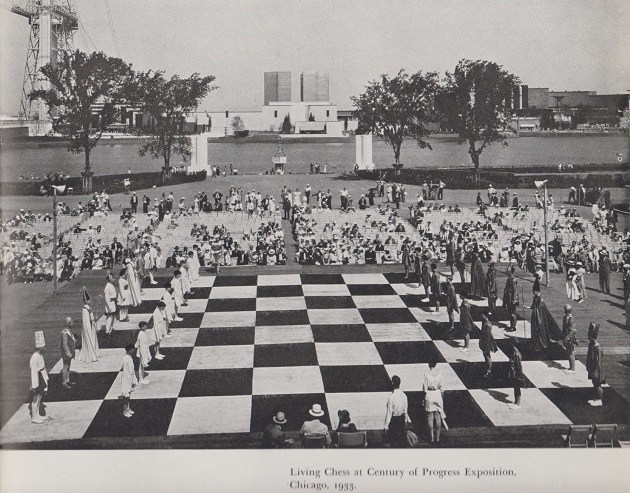
(8917)
It is difficult to know what to make of Alekhine’s remark in brackets at the end of a letter published on page 161 of the August 1941 CHESS:
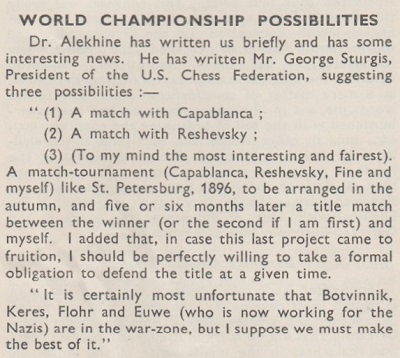
(8964)
The score below is taken from pages 59-60 of Ajedrez uruguayo (1880-1980) by Héctor Silva Nazzari (Montevideo, 2013):
José Montalbán – Alexander Alekhine
Montevideo, 27 October 1926
Trompowsky Opening
1 d4 Nf6 2 Bg5 c5 3 d5 Qb6 4 Bxf6 gxf6 5 Qc1
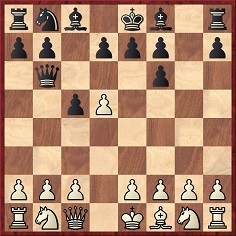
5...Bh6 6 e3 d6 7 c4 Bf5 8 Nc3 Nd7 9 f4 e5 10 g3 exf4 11 gxf4 O-O-O 12 Qd2 Qb4 13 Nb5 Qxd2+ 14 Kxd2 Nb6 15 Bd3 Bxd3 16 Kxd3 Rhg8 17 Ne2 a6 18 Nbc3 Rg6 19 Rhg1 Kd7 20 Ng3 Rdg8 21 Nce2 Nc8 22 Nf5 Bf8 23 Rg3 Ne7 24 Ke4 Nxf5 25 Kxf5 Ke7 26 Rag1 Rh8 27 Rh3 Bh6 28 Ng3 b5 29 Rc1 Kd7 30 b4 cxb4 31 cxb5 axb5 32 Ne4 Ra8 33 Rc6 Rxa2 34 Nxf6+ Kd8 35 Rxd6+ Kc8 36 Ne4 Bf8 37 Rxg6 fxg6+ 38 Ke6
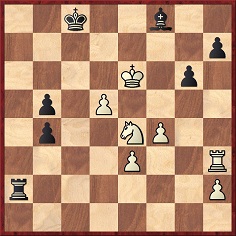
38...b3 39 Nc3 b2 40 d6 b4 41 Nb1 Ra1 42 e4 Bxd6 43 Rb3 Rxb1 44 e5 Kd8 45 h4 Ke8 46 h5 gxh5 47 White resigns.
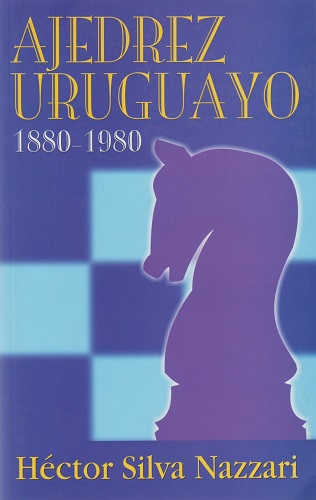
Page 57 provides information on that first visit of Alekhine’s to Uruguay: +84 –7 =9 in four simultaneous displays, 11½ points out of 12 in six two-board sessions with clocks, a lecture and a blindfold display (score unknown). The circumstances of the game against Montalbán are not specified.
(8972)
From page 8 of Chess Tactics by Alexander Kotov (London, 1983):
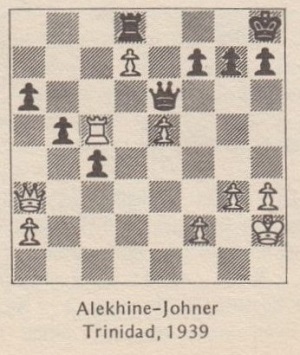
Why the name Johner?
The position, well known, is on page 635 of the Skinner/Verhoeven book on Alekhine as a victory by the world champion against A. Nestor in a simultaneous display in Port of Spain, Trinidad on either 31 January or 4 February 1939. The only full game available from Alekhine’s visit to Trinidad is a draw against Raymond Young (who had written on page 11 of the August 1993 Chess Life that Alekhine’s two displays were ‘on successive nights’ and that he believed they took place ‘in late 1939 or early 1940’).
As noted by Skinner and Verhoeven, the Alekhine v Nestor conclusion appeared in the Deutsche Schachzeitung in 1939 (in a feature on pages 197-198 of the July issue):

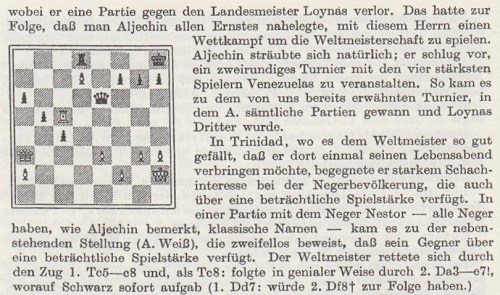
The position and solution were given again on pages 310 and 318 of the December 1939 issue, the finish being described as ‘wunderhübsch’.
Another early publication of the ending was in Brian Harley’s column on page 20 of the Observer, 30 July 1939:
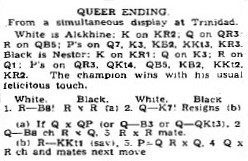
On page 71 of Achieving the Aim (Oxford, 1981) Botvinnik referred to his title match discussions with Alekhine immediately after AVRO, 1938:
‘We agreed that I should send a formal challenge to an address he gave in South America (Alekhine was intending to buy some land in Trinidad) ...’
(9000)
Christian Sánchez writes:
‘The Trinidad Guardian of 14 May 2008 gives a detailed account of Alekhine’s visit to the island, but only his opponent’s middle initial can be added: A.L. Nestor.’
(9005)
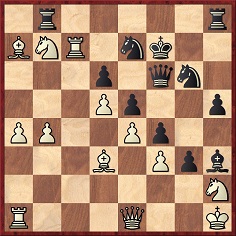
Black to move
This was the position after White’s 38th move in the game between L.J. Isaacs and V. Buerger in the Chicago v London cable match, 6 November 1926 (1 e4 d6 2 d4 Nf6 3 Bd3 g6 4 Nf3 Bg7 5 O-O O-O 6 h3 Nc6 7 c3 Nd7 8 Nbd2 e5 9 d5 Ne7 10 g4 Nc5 11 Bc2 f5 12 Nh2 f4 13 f3 Kf7 14 Rf2 Bf6 15 Nb3 Nd7 16 Bd2 h5 17 Rg2 Rh8 18 g5 Bg7 19 h4 Nb6 20 Be1 Nc4 21 Qc1 Bh3 22 Re2 Nc8 23 Bf2 Bf8 24 Bd3 N4b6 25 Na5 Rb8 26 a4 Be7 27 Kh1 Bxg5 28 hxg5 Qxg5 29 Qg1 Qf6 30 Qe1 g5 31 c4 Ne7 32 b4 Ng6 33 c5 Nc8 34 cxd6 cxd6 35 Rc2 g4 36 Rc7+ Nce7 37 Nxb7 g3 38 Bxa7).
One of several magazines which published the game, noting that it was to be adjudicated by Alekhine, was the American Chess Bulletin (December 1926, pages 157-158). Page 158 mentioned that a suggestion by Capablanca was 38...Rxb7 39 Rxb7 Rc8. Buerger annotated the game on pages 72-73 of The “British Chess Magazine” Chess Annual 1926 by M.E. Goldstein (Leeds, 1927), without commenting on the final position.
As reported on, for instance, page 161 of the March 1927 Chess Amateur, Alekhine adjudicated the game as a win for Black, but is it known whether he supplied any analysis or commentary?
(9027)
Eduardo Ramirez (Chicago, IL, USA) draws attention to the analysis by Alekhine on pages 102-103 of the March 1927 BCM:
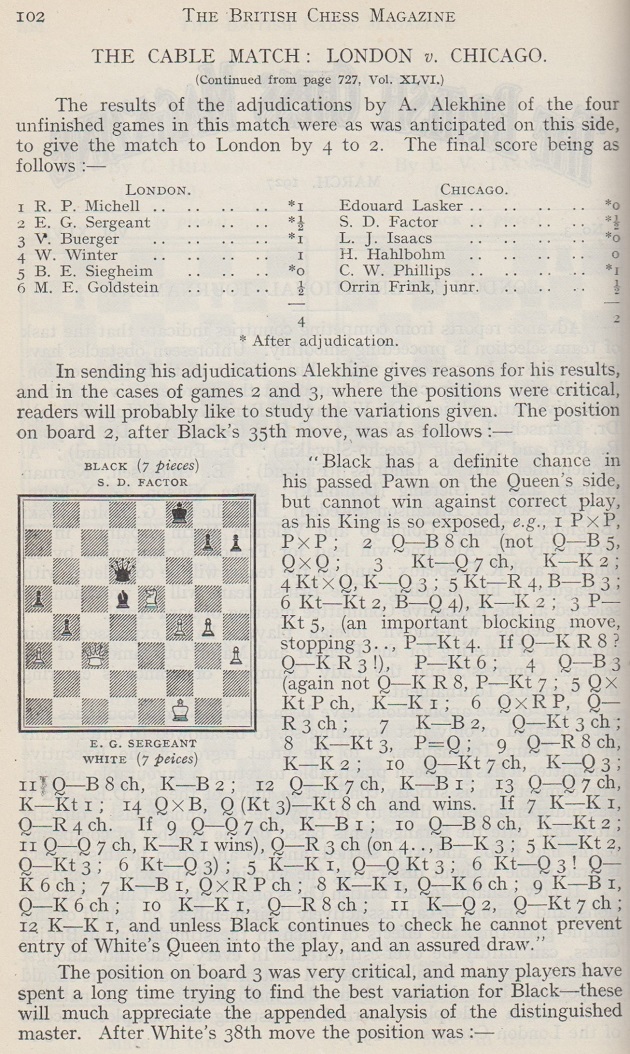
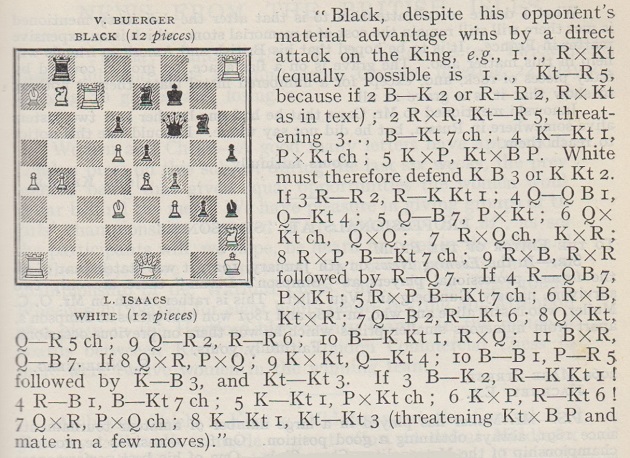
(10597)
Page 165 of CHESS, 14 January 1939:
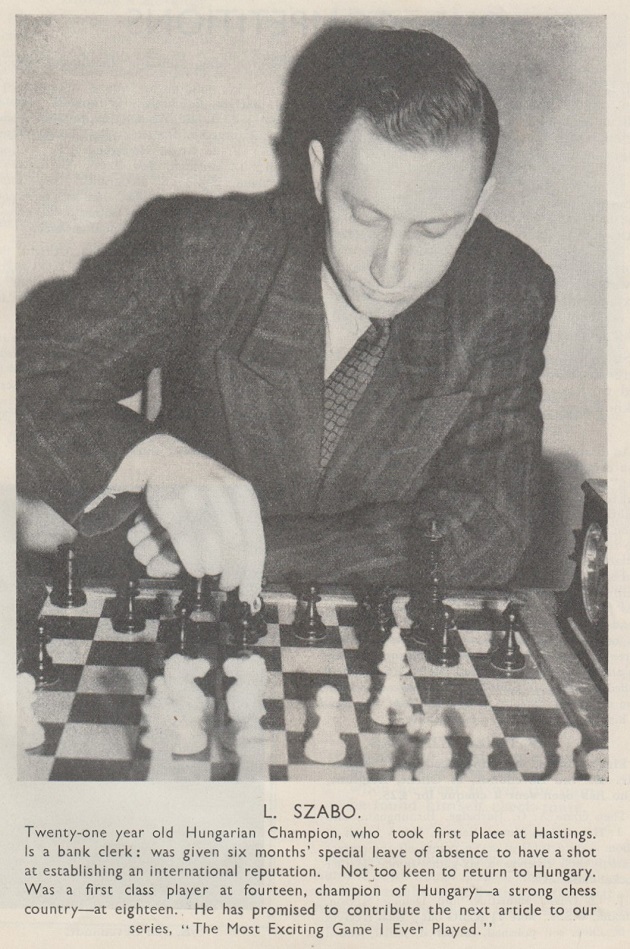
For his article ‘The Most Exciting Game I Ever Played’ on pages 213-215 of CHESS, 14 February 1939, László Szabó chose his win as White against Pirc at Hastings, 1938-39 but commented in his introduction:
‘At Warsaw in 1935 I had a most wonderful game against Dake, of USA, which Dr Alekhine stated to be, for him, the most exciting game of the whole International Team Tournament. It was so exciting, actually, that I think it would be bad for everybody’s nerves to publish it again.’
Full notes to both encounters are in Szabó’s book My Best Games of Chess (Oxford, 1986), and concerning his draw with Dake he wrote on page 12:
‘My greatest chess experience at the Warsaw Olympiad was my meeting with the world champion, Alekhine. Well, I did not meet him across the board, since he was on first board for the French team, and I played fourth position in the Hungarian team. The world champion played against Lajos Steiner, who played on the first board. Alekhine’s behaviour during play aroused my interest. Why did he stand up after most of his moves, go behind his opponent’s back and contemplate the board from there with arms crossed? I have seen this pose of Alekhine’s many times since in pictures, and I used to wonder whether he stood behind his opponent for psychological effect, or to control events on the board from another angle.
... according to many contestants – Alekhine among them – I played the wildest game of the Olympiad against the American Dake.’
In CHESS and in his book Szabó stated that his game against Pirc ended 63 b7 Resigns, whereas page 8 of Hastings 1938/39 International Chess Congress edited by Dale A. Brandreth (Yorklyn, 1978) had 63 b7 Qg5+ 64 Kf3 Qf5+ 65 Ke3 Qg5+ 66 Kd4 1-0.
(9056)
From page 81 of the February 1971 Chess Life & Review (‘Larry Evans on Chess’):
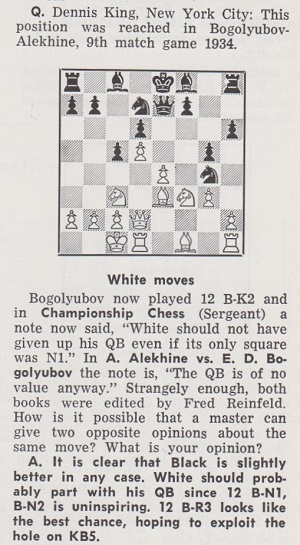
It was hardly justified for Dennis King to assert that Reinfeld gave ‘two opposite opinions’ on White’s 12th move. Concerning P.W. Sergeant’s Championship Chess (London, 1938), Reinfeld brought out updated editions (New York, 1960 and 1963), with extra games but without revising Sergeant’s annotations. The other book, A. Alekhine vs. E.D. Bogoljubow (Philadelphia, 1934), was co-written by Reinfeld with Reuben Fine.
Such points passed Evans by, and his cursory remark that 12 Bh3 ‘looks like the best chance’ did not mention that the move was recommended by Bogoljubow, though not by Alekhine.
Below is a non-exhaustive compendium of notes to Bogoljubow’s 12th move (after 1 d4 c5 2 d5 e5 3 e4 d6 4 f4 exf4 5 Bxf4 Qh4+ 6 g3 Qe7 7 Nc3 g5 8 Be3 Nd7 9 Nf3 h6 10 Qd2 Ngf6 11 O-O-O Ng4):
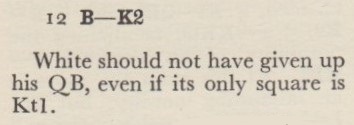
Championship Chess by P.W. Sergeant (London, 1938), page 192

A. Alekhine vs. E.D. Bogoljubow by F. Reinfeld and R. Fine (Philadelphia, 1934), page 28

Schachkampf um die Weltmeisterschaft by E. Bogoljubow (Karlsruhe, 1935), page 56
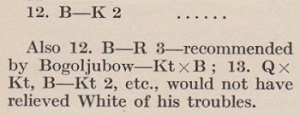
My Best Games of Chess 1924-1937 by A. Alekhine (London, 1939), page 140

Alekhine vs. Bogolubow by I.A. Horowitz and S.S. Cohen (New York, 1934), page 13

Deutsche Schachzeitung, May 1934, page 146 (annotator: M. Blümich)
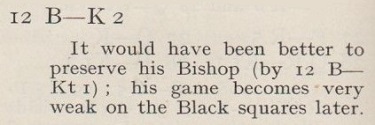
BCM, June 1934, page 264 (annotator: J.H. Blake)

Alexander Alekhine II Games 1923-1934 by A. Khalifman (Sofia, 2002).
Some annotators made no comment on 12 Be2, examples being Lasker in his match-book (page 38), Kmoch on page 146 of the May-June 1934 Wiener Schachzeitung and Tartakower on page 551 of L’Echiquier, 8 August 1934.
The game was played in Pforzheim on 25 April 1934. Page 55 of Bogoljubow’s above-mentioned match-book gave the players’ times as two hours and 41 minutes for White and 58 minutes for Black. See too pages 96-97 of Wonders and Curiosities of Chess by I. Chernev (New York, 1974).
(9116)
Eladio Mejuto (Madrid) sends an ironic report published on page 5 of El Sol, 23 May 1922 about Alekhine’s detention at the Spanish border on suspicion of being a Bolshevik:

(9134)
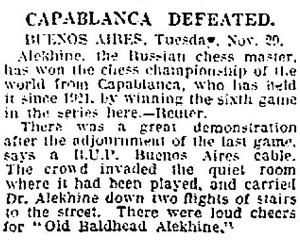
Daily Express, 30 November 1927, page 1
The nickname was referred to on page 1 of the January 1928 BCM:

See too page 109 of The Kings of Chess by William Hartston (London, 1985).
(9143)
From Christian Sánchez:
‘The colloquial expression “viejo y peludo” (sometimes with the intensifier “nomás”) is used in Argentina to congratulate, acclaim or praise a sportsman regarding his achievements. For example: “Leguisamo, viejo y peludo nomás”, in a tango sung by Carlos Gardel in 1927; also, “Burruchaga, viejo y peludo nomás”, as shouted by the sports commentator Víctor Hugo Morales during the World Cup final in 1986.
“Viejo y peludo”, of uncertain origin and probably meaning “grown up” or “experienced”, can be translated literally as “old and hairy/bearded”, but not “old baldhead”, which would be “viejo y pelado”.’
(9215)
Wanted: more information about this photograph, which is from page 69 of Alt om Skak by B. Nielsen (Odense, 1943), in the chapter on Alekhine:
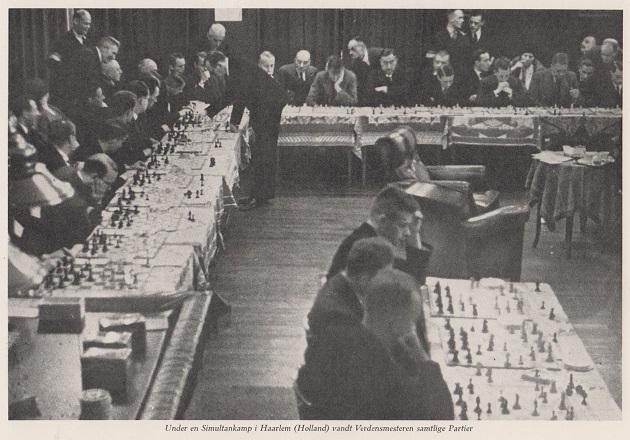
(9157)
Dan Scoones points out that the boards and the fact that Alekhine was making a move with his right hand indicate that the photograph has been reversed.
We give an enlarged version in amended form.
Photographic evidence that Alekhine was right-handed can be found in C.N.s 6328 (signing a contract) and 7981 (cutting a cake), but clips in Chess Masters on Film show him making moves with his left hand.
(9170)
Bent Kølvig (Rødovre, Denmark) and John Rasmussen (Hicksville, NY, USA) note that the Danish photograph caption states that the world champion won all the games.
The only possibility that we see from the excellently researched list of results on pages 765-786 of Alexander Alekhine’s Chess Games, 1902-1946 by L. Skinner and R. Verhoeven (Jefferson, 1998) is a display in Haarlem on 28 April 1937, although Alekhine, who was not then the world champion, scored 29 wins and one draw from 30 games.
(9181)
From page 140 of the May 1951 Chess Review, in an article entitled ‘Recollections of Alekhine’ by Harry Golombek:
‘Witness, too, his writings on the game, which must rank with the best that the chess world has produced. The number of young players whose imagination has been stirred and for whom fresh vistas have been opened by his My Best Games of Chess 1908-1923 must be legion.
It is true, however, that in writing this book and others, he owed much to other masters and was not always frank in acknowledging the debt. In his collections of games, for example, he owed a great deal to the French masters, Renaud and Kahn.’
Did either Renaud or Kahn ever write about the matter? And did Golombek give more details, e.g. to justify his words ‘this book and others’ and ‘for example’?
From an article (‘New Chess King Ruled by Fancy’) by Leon Wexelstein in the New York Times, 11 December 1927, page XX10:
‘To find out from Alekhine the ingredients that go into the making of genius in chess was not easy. As well try to learn what makes for a Heifetz, an Einstein, a Walt Whitman, a Tolstoy – or a Tunney. If genius could be readily analysed, then genius could be made to order – and genius cannot be made to order. It is there – or it isn’t.Does, for instance, mathematical ability play a part? What are the rôles apportioned to fancy, to memory, to prudence? How does it feel to play 26 boards at the same time, and “blindfold”, as Alekhine has done? Does one weary? In what way? These questions were put to Alekhine.
“Mathematical ability?” he said. “Not at all. Dr Emanuel Lasker is the only one who, so far as I know, has any. I haven’t, myself. Or, if anything, very mediocre ability in mathematics. I don’t think it counts – in chess. What does? Well, fancy is one. And a flair for abstract reasoning is another.”
Alekhine laughed a little.
“Anyway”, he said, don’t place too much weight on inheritance. You might be a brilliant player even if no-one in the train of your family had ever seen a chessboard.”’
It would be helpful to know where and when Alekhine made the statements quoted in Wexelstein’s article.
(9214)
Alan McGowan has found film reports on the tournaments at Prague, 1942 (start: 0’30”) and Prague, 1944 (start: 4’05”). The former newsreel, for instance, includes footage of Alekhine and Junge, and we have made these screen-shots:
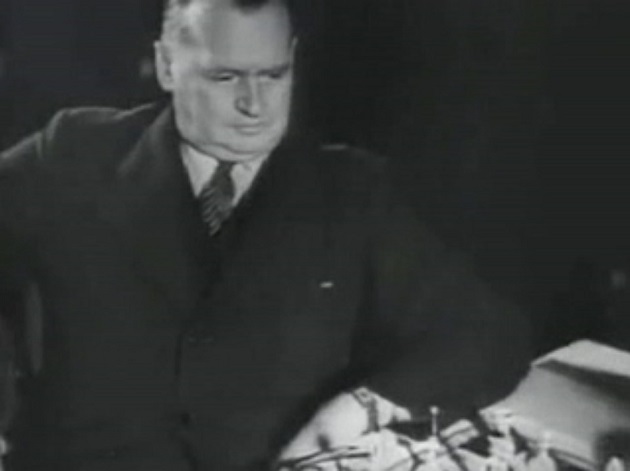
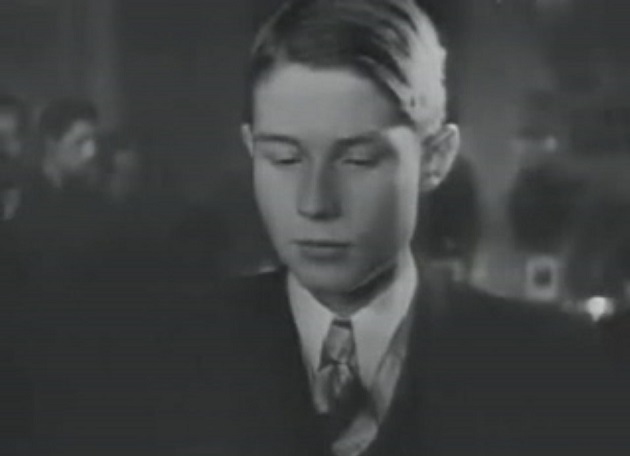
(9289)
An addition on 28 July 2023 to Chess: Hitler and Nazi Germany:
From his collection Olimpiu G. Urcan shares this photograph taken at Salzburg, 1942. It shows Junge, N.N. and Alekhine watching a game played by Paul Schmidt:
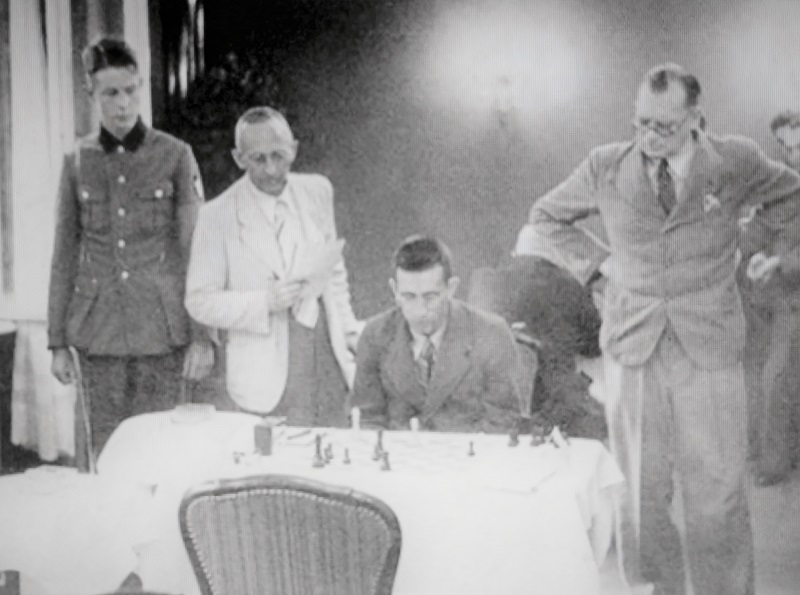
Varadachary’s Annotated Chess Masterpieces (Incomplete) by Vithal Rajan (2006) comprises 11 playlets, and a sample page from the first one, ‘Alekhine’s Greatest Defeat’, should suffice:
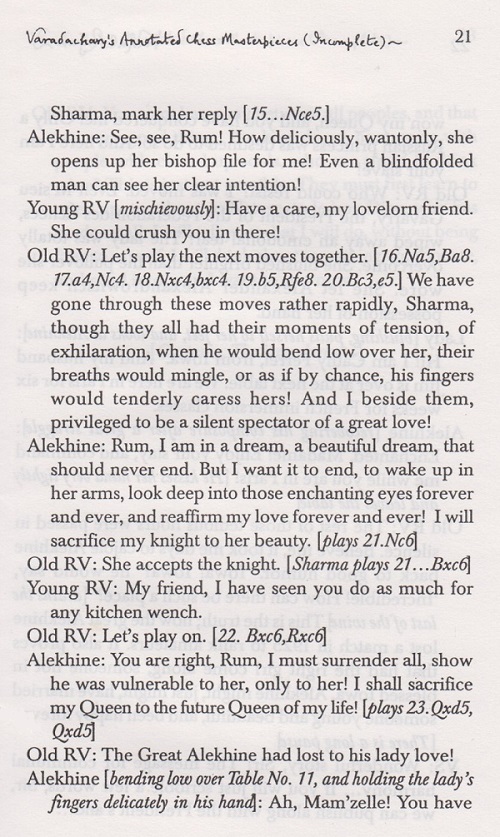
(9310)
C.N. 741 (see page 118 of Chess Explorations) pointed out the reference to canoeing in Alekhine’s Who’s Who entry. Below is the full text, which has some obvious errors, published on page 13 of Who Was Who, 1941-1950 (London, 1952):
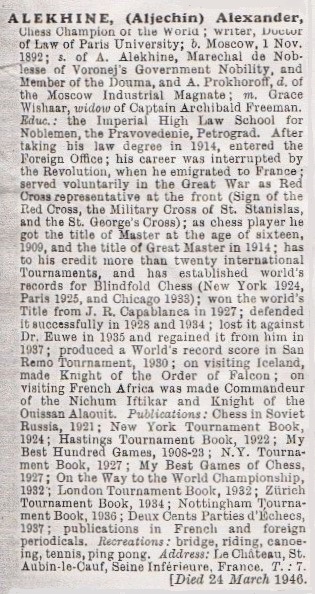
Has any researcher looked into the awards and honours attributed to Alekhine?
(9316)
Regarding the address given in the final line, C.N.s 4250, 4251, 4262 and 4345 have discussed Alekhine’s château in St Aubin-le-Cauf. In C.N. 4251 David McAlister (Hillsborough, Northern Ireland) wrote:
‘I am the custodian of the Ulster Chess Union archives, and amongst them is a letter dated 15 July 1938 from Alekhine to the Union’s secretary, William Minnis, indicating his willingness to give a simultaneous exhibition in Belfast. The headed notepaper has the address Le Château St Aubin-le-Cauf (Seine Inférieure), as well as a telephone number, St Aubin-le-Cauf No. 7.’
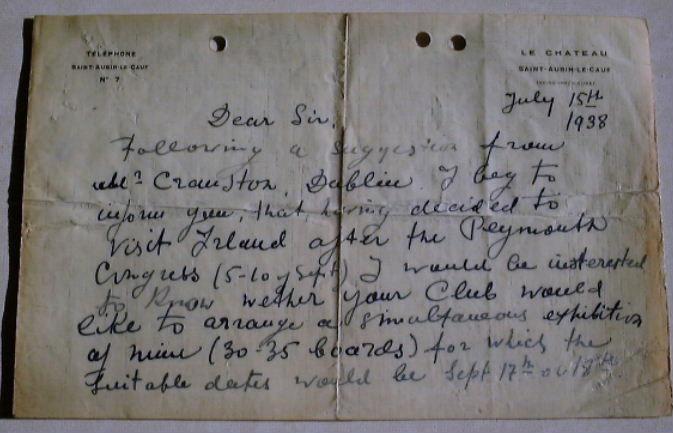
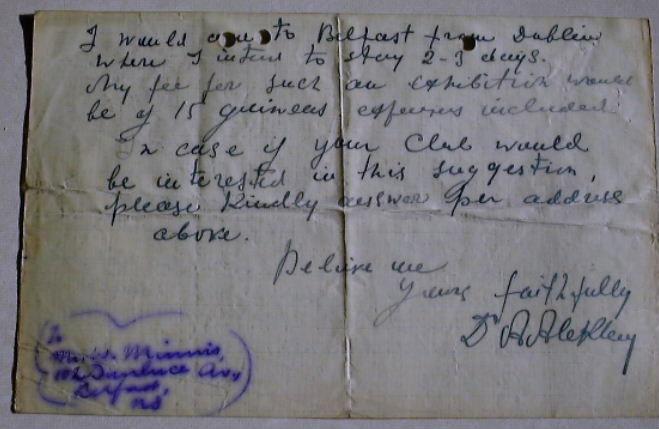
Hassan Roger Sadeghi drew attention to information available online about the Châtellenie, which has rooms named after various chess pieces, as well as a ‘chambre Alekine’ [sic].
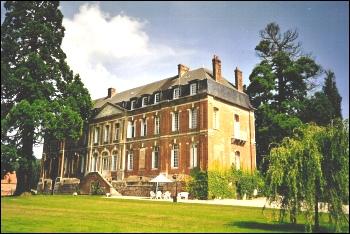
In C.N. 4345 we reported, with a further link, that Alekhine’s château was owned by Agnès and Jean-Pierre Bosselin. Their daughter, Véronique Perrin-Bosselin, wrote to us as follows:
‘We are very interested in the illustrious former owner of our property and in providing information to our guests about its history. My grandfather acquired the castle from Madame Alekhine after the War. It had been completely looted during the evacuation and was then used by the German Army, which converted it into a hospital. A few years ago my parents transformed the château into guest rooms and reception halls, and all the bedrooms naturally have names with a chess theme. In addition to rooms named after chess pieces (rook, knight, king and queen), there is an Alekhine Room.
The château would be available for any kind of special event related to chess.’
The above article originally appeared at ChessBase.com.
See too C.N. 11017.
The above website also includes this historical note on the Châtellenie:
‘Dans les années 30, ce château d’été fut acheté par Grace Wishar, veuve d’un planteur de thé britannique de Ceylan, qui épousa en 1934 Alexandre Alekhine (1892-1946). Le château de St Aubin sera la dernière résidence de cet illustre champion du monde d’échecs franco-russe resté invaincu.
Pendant la guerre, le château sera occupé par un régiment de l’armée allemande qui y fait son quartier général et le transforme en hôpital. De cette époque reste le poste de garde, petite maison en brique construite par l’armée allemande à l’entrée du domaine.
A la mort d’Alekhine en 1946, son épouse, le cède à la famille des actuels propriétaires qui le découvrent vandalisé, vidé de tout meuble et pillé de tout matériau réutilisable.
Depuis, les propriétaires s’emploient à rénover et faire vivre cet ensemble architectural.’
We are grateful to Véronique Perrin for permission to reproduce from her website the plaque which refers to Alekhine’s residence in the château, and for sending us a close-up picture:
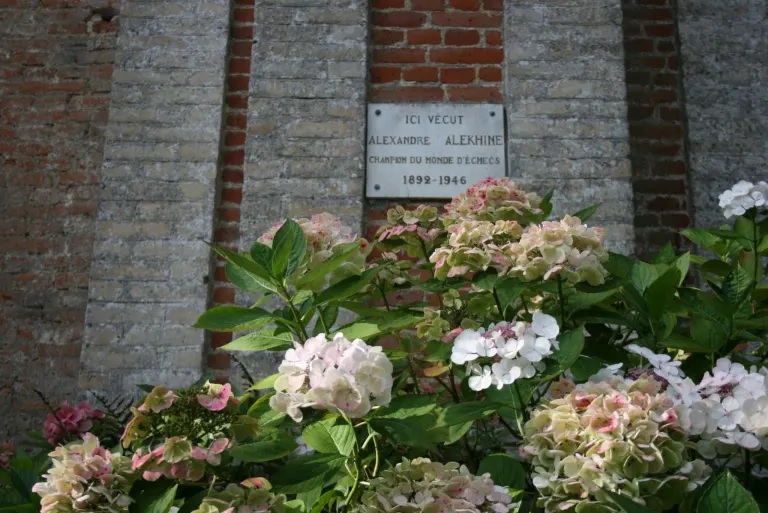
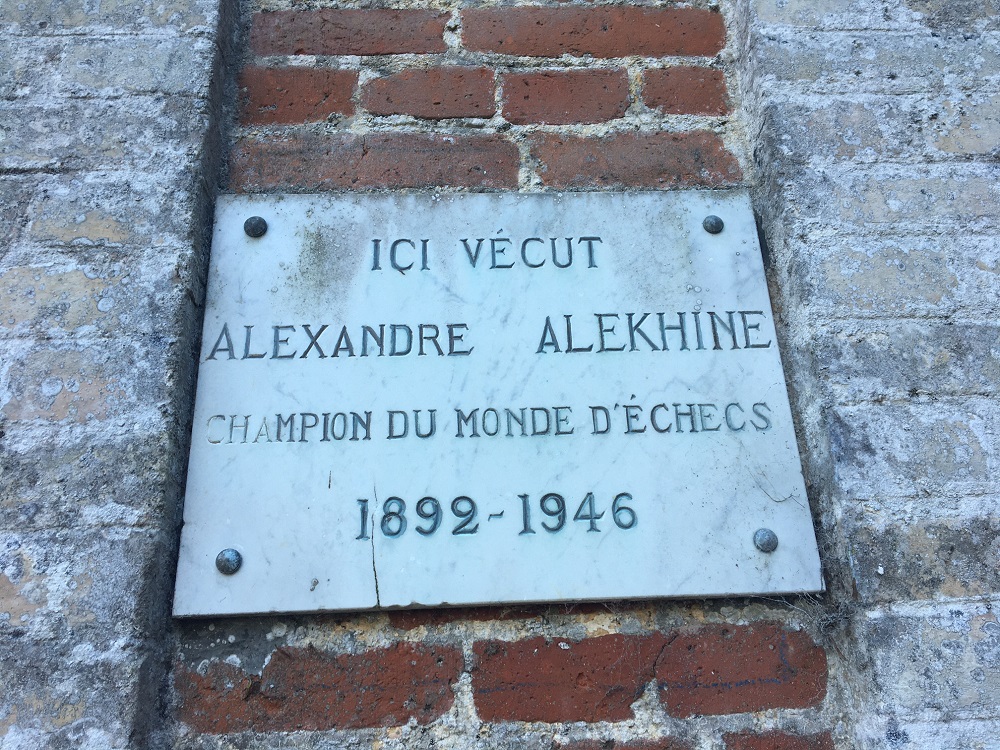
(5211)
From Steve Wrinn:
‘I have a question concerning the precise regulations governing Alekhine’s world championship matches against Bogoljubow and Euwe. All were scheduled for 30 games, with 15½ points being required for victory and with the added proviso that the victor must score at least six wins. But information on precisely what would have occurred if neither player won the required six games during the first 30 games is often incomplete and contradictory. To take the Alekhine-Euwe 1935 match, for example, here are three widely divergent descriptions of the match conditions:
a) On page 284 of its September 1935 issue the Wiener Schachzeitung stated:
“Die Bedingungen sind gleicher Art wie bei den letzten Weltmeisterschaftskämpfen. Es werden mindestens 30 Partien gewechselt. Wer die Mehrzahl der Punkte erreicht, ist Sieger, vorausgesetzt, daß er sechs Partien gewonnen hat. Andernfalls wird der Wettkampf bis zum sechsten Sieg fortgesetzt.”
This indicates that play would continue after 30 games even if Alekhine were in the lead but had not attained six wins. There is no mention of the possibility of a drawn extended match as referred to in my point b below. Additionally, according to the first sentence, such conditions also held true for Alekhine’s matches against Bogoljubow. (See, however, my point c below.)
b) Skinner and Verhoeven, on page 534 of Alexander Alekhine’s Chess Games, 1902-1946, cite The Times of 3 and 4 October 1935 and paint a very different picture:
“The match would consist of 30 games and the title would go to the player who first scores 15½ points, with at least six won games. If after 30 games Alekhine has a majority of points, but not necessarily six won games, the match is to be given up as a draw and Alekhine retains the championship. If Euwe is ahead after 30 games have been played but without six wins, then the match will be continued until either Euwe wins six games or Alekhine equals his score. In the latter case Alekhine retains the title and the match is drawn.”
Those last two sentences amount to a de facto requirement that the challenger (in this case Euwe) win an extended match by at least two points; in other words, a 6-5 victory would be impossible to achieve past the 30th game, as the previous 5-5 score would have brought the contest to a close. A related point is that under such conditions only the challenger could win an extended match, as once the trailing champion equalized the score he would retain his title via a drawn result.
Times, 3 October 1935, page 10
Times, 4 October 1935, page 16
c) On page 9 of his Tagebuch vom Wettkampf Aljechin-Euwe (Vienna, 1936) Hans Kmoch stated explicitly that the proviso that the champion would retain his title upon equalizing the score at any time after the 30th game, and the concomitant de facto requirement for the challenger to win an extended match by two points, were not in effect for the 1935 match. He added that they had been in effect for Alekhine’s earlier matches (i.e. the two contests against Bogoljubow). He thus contradicts both points b and a above. Kmoch also wrote that in 1935 a drawn match was possible only if the score was equal after 30 games and each player had won at least six games (the situation that would, in fact, have occurred if Alekhine won the 30th game):
“Wenn nach der 30. Partie ein Stand von 15:15 erreicht wurde und beide Spieler mindestens 6 Partien gewonnen haben, dann wird der Wettkampf als unentschieden abgebrochen und Aljechin behält seinen Titel. Im anderen Falle kann der Wettkampf nicht unentschieden ausgehen und es entscheidet unter allen Umständen die 6. Gewinnpartie. Diese letztere Bestimmung differiert von jenen früherer Wettkämpfe Aljechins: dort hieß es nämlich, daß der Wettkampf zugunsten des Weltmeisters unentschieden abgebrochen werde, falls der Weltmeister nach 30 Partien im Nachteil ist, es ihm aber später gelingt, gleichen Stand zu erreichen.”
That three contemporary sources could give such varying and irreconcilable accounts is remarkable. What were the exact final rules for the 1929, 1934, 1935 and 1937 world championship matches?
Incidentally, Skinner and Verhoeven (pages 364, 490 and 593) briefly mention the 15½ points/six wins requirement for the 1929, 1934, and 1937 world championship matches, but provide no further details, except to note that Euwe as world champion would retain the title if the 1937 match were tied after 30 games. The Wiener Schachzeitung offered the same minimal information (15½ points/six wins) for Alekhine’s 1929 and 1934 matches against Bogoljubow (see page 253 of the August 1929 issue and page 97 of the April 1934 issue), but did not spell out the conditions under which those contests would have continued after the 30th game.’
(9341)
Regarding the 1928 match between Bogoljubow and Euwe, see FIDE Championship (1928).
From Oliver Beck:
‘In “Echecs et Maths”, an essay on pages 42-51 of Marcel Duchamp: abécédaire, approches critiques edited by Jean Clair (Paris, 1977), François Le Lionnais claimed that although he and Marcel Duchamp were brought together through Dada and a strong philosophical and artistic affinity, their long friendship ultimately resulted from a shared interest in chess. He then provided an interesting summary of Duchamp’s chess career.
... An event not referred to in “Echecs et Maths” is a simultaneous exhibition in which Alekhine faced 36 teams in Paris on 15 June 1935. Details of the event are on page 60 of Le Lionnais’ Le Jardin des échecs (Paris, 1936), and the next two pages published Alekhine’s loss (included on page 526 of the Skinner/Verhoeven book on Alekhine) to Equipe de VU, a team consisting of Le Lionnais, Mmes Vogel and Melikoff, MM. Casciani, Melikoff and Wissiotzky.
C.N. 7796 gave Alekhine’s loss to the team comprising Pierre Biscay, Marcel Berman and Duchamp. Alekhine’s overall result was +27 –6 =3.
Page 46 of “Echecs et math” had a photograph of the French chess team (Kahn, Alekhine, Betbeder, Duchamp and Voisin) on a balcony during the 1933 International Team Tournament in Folkestone.’
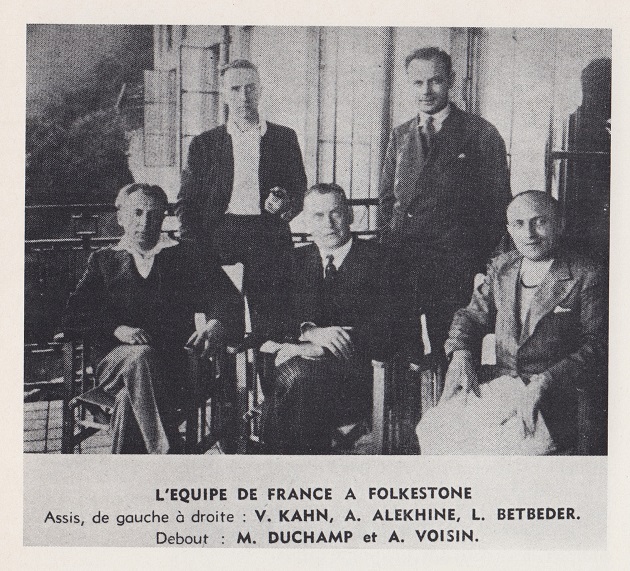
(9465)
Jan Kalendovský has sent the items below:
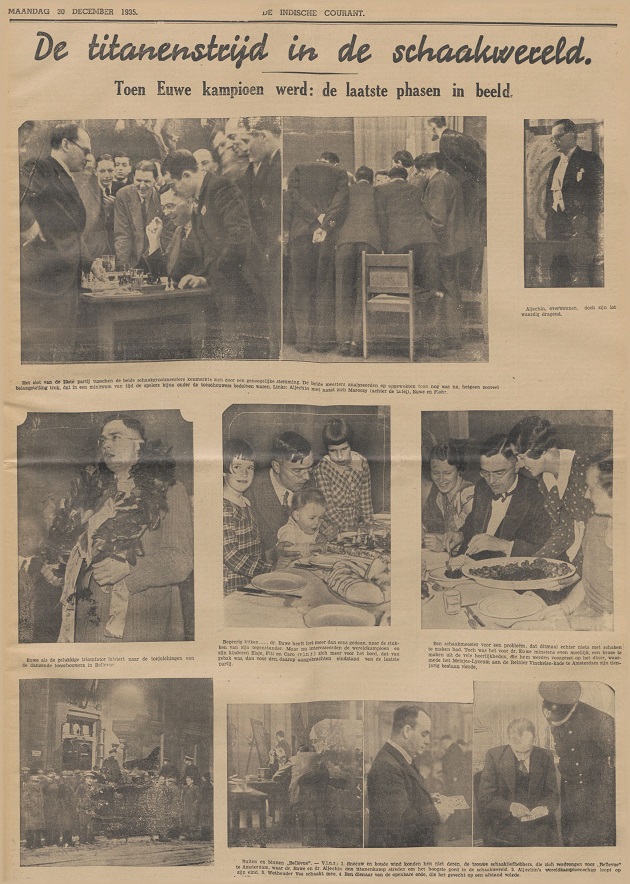
De Indische Courant, 30 December 1935, page 13
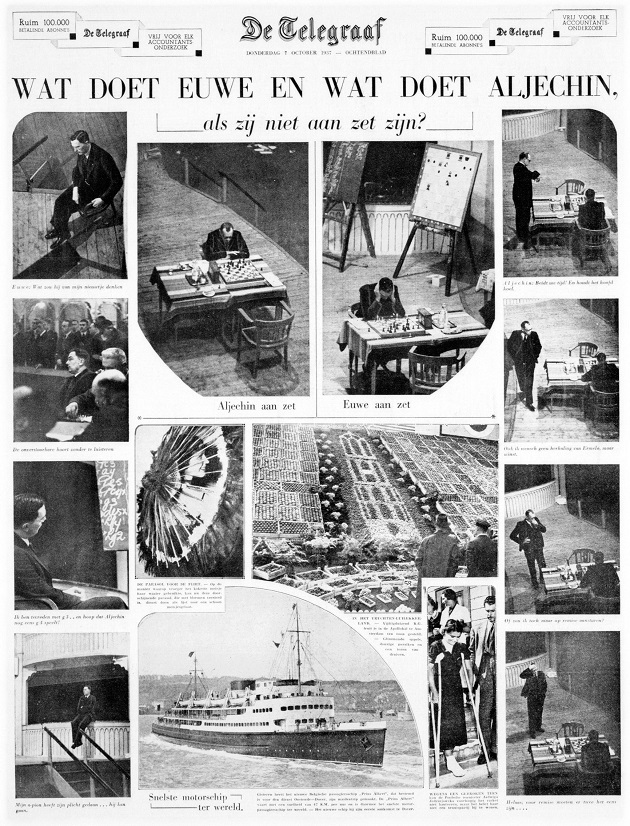
De Telegraaf, 7 October 1937, page 4
(9514)
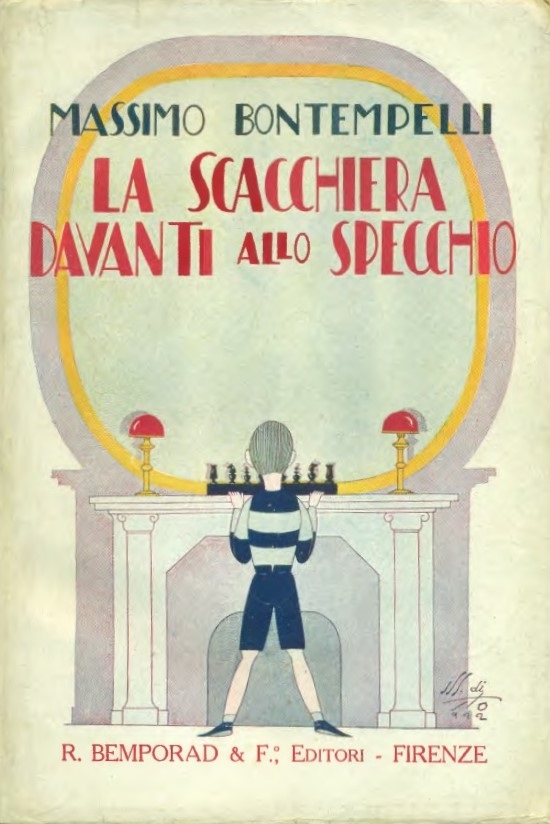
From Oliver Beck:
‘In Massimo Bontempelli’s La scacchiera davanti allo specchio (Florence, 1922), a children’s book with similarities to Through the Looking Glass, a child enters a mirrored world where he is told of the importance of chess pieces by a reflected white king:
“... e devi sapere che i pezzi degli scacchi sono molto molto più antichi degli uomini: molti secoli dopo che c’erano gli scacchi sono nati gli uomini, che sono all’ingrosso una specie di pedoni, con i loro alfieri, re e regine; e anche i cavalli, a imitazione dei nostri. Allora gli uomini hanno fabbricato delle torri per fare come noi. Hanno poi fatto anche molte altre cose, ma quelle sono tutte superflue. E tutto quello che accade tra gli uomini, specialmente le cose più importanti che si studiano poi nella storia, non sono altro che imitazioni confuse e variazioni impasticciate di grandi partite a scacchi, giocate da noi. Noi siamo gli esemplari e i governatori dell’umanità.” (Pages 98-101.)
In La donna del Nadir (Rome, 1924) Bontempelli returned to the history of chess in a short essay entitled “Clima sacro”. Commenting on a report of a ten-board blindfold exhibition by Alekhine in Milan, and after suggesting that this achievement was made possible only by Alekhine’s ability to operate outside of any human faculty, Bontempelli offered the following:
“Non senza ragione del gioco degli scacchi non si conosce l’origine: esso probabilmente preesisteva all’apparizione dell’uomo sulla terra, e forse anche alla creazione del mondo; e se il mondo ripiomberà nel caos, e il caos si ridissolverà nel nulla, il gioco degli scacchi rimarrà, fuori dello spazio e del tempo, partecipe dell’eternità delle Idee.” (Page 60.)
On page 186 of the Skinner/Verhoeven book on Alekhine there is an account of his ten-board blindfold exhibition in Milan on 25 March 1923, and the following page shows two games from the event: a spirited win by Luca Morelli, referred to in C.N. 6903, and a loss by Giuseppe Padulli. The Padulli game also appears on page 120 of L’antica Storia della Società Scacchistica Milanese dal 1881 agli anni ’60, volume 1 by Alessandro Sanvito (Bologna, 2014). However, there it is recorded as a draw after 50 Rc2 (instead of 50 Kc2 h5 and resigns, which indicates a double blunder).
The Sanvito book states too (page 62) that Alekhine visited the Società Scacchistica Milanese and faced 14 opponents in a simultaneous blindfold exhibition at the salons of the Società Artisiti e Patriottica, winning each game. No date is given.
Estelle Gilson has produced an English translation of La scacchiera davanti allo specchio, with original illustrations: The Chess Set in the Mirror (Philadelphia, 2007).’
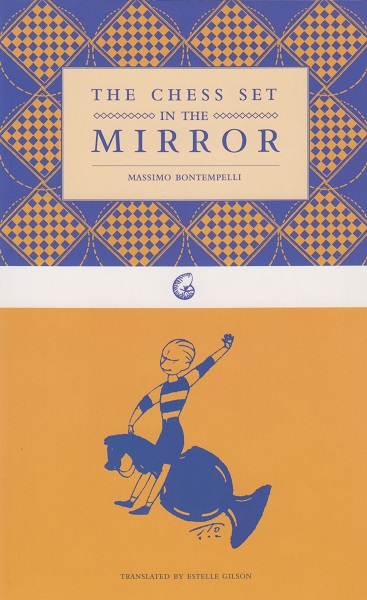
(9629)
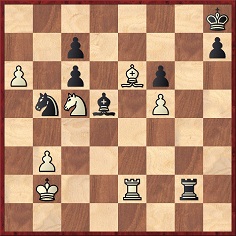
Position after 49...Rg2
In C.N. 9629 a correspondent referred to a discrepancy in the conclusion of the blindfold game Alekhine v Padulli, Milan, 25 March 1923. Whereas page 187 of the Skinner/Verhoeven volume gave ‘50 Kc2 h5 1-0’, page 120 of L’antica Storia della Società Scacchistica Milanese dal 1881 agli anni ’60, volume 1 by Alessandro Sanvito (Bologna, 2014) stated that the game was drawn after 50 Rc2.
As always, the Skinner/Verhoeven book gave a source for the game, and it is shown below, courtesy of Henk Chervet of the Koninklijke Bibliotheek in The Hague. Pages 82-83 of the April 1923 L’Italia Scacchistica:
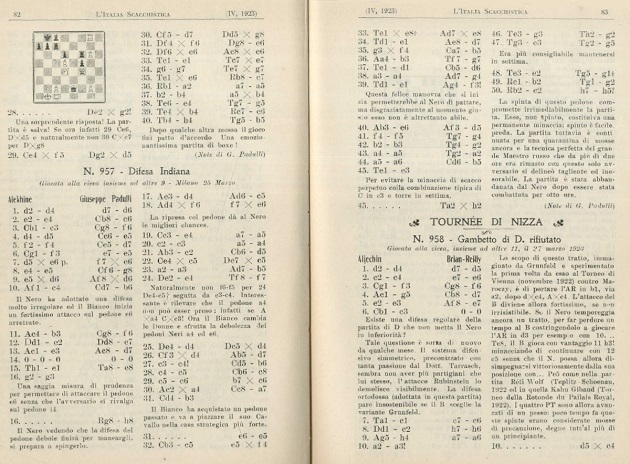
The final note by Padulli states that after his move 50...h5 (‘?’) play in this remaining game of the display continued for more than two hours (another 40 or so moves) before he resigned, and that the game lasted eight hours in all.
To summarize: L’Italia Scacchistica had ‘50 Rb2-c2’, a king move, given that the Italian word for king is Re, but it would give away the white rook on e2. The Skinner/Verhoeven volume nonetheless put 50 Kc2 and did not mention that the game continued for dozens more moves. The Sanvito book made a correction, to 50 Rc2, but, for reasons unknown, stated that the game was then drawn.
The score: 1 d4 d6 2 e4 Nc6 3 Nc3 Nf6 4 d5 Ne5 5 f4 Ned7 6 Nf3 e5 7 dxe6 fxe6 8 e5 Ng8 9 exd6 Bxd6 10 Bc4 Nb6 11 Bb3 Nf6 12 Qe2 Qe7 13 Be3 Bd7 14 O-O-O O-O 15 Rhe1 Rae8 16 g3 Kh8 17 Bd4 Bc5 18 Bxf6 gxf6 19 Ne4 a5 20 c3 a4 21 Bc2 Nd5 22 Nxc5 Qxc5 23 a3 Bb5 24 Qe4 Rf7 25 Qd4 Qxd4 26 Nxd4 Bd7 27 c4 Nb6 28 c5 Nc8 29 c6 bxc6 30 Bxa4 Na7 31 Nb3 e5 32 Nc5 exf4 33 Rxe8+ Bxe8 34 Re1 Bd7 35 gxf4 Nb5 36 Bb3 Rg7 37 Rd1 Nd6 38 a4 Bg4 39 Re1 Bf3 40 Be6 Bd5 41 f5 Rg4 42 b3 Rg2 43 a5 Ra2 44 a6 Nb5 45 Re3 Rxh2 46 Rg3 Rg2 47 Re3 Rg5 48 Re2 Rg1+ 49 Kb2 Rg2 50 Rc2 h5, and White eventually won.
(9633)
From page 302 of the 14 May 1938 CHESS:
‘“What has been decided?”, we asked Dr Alekhine, “with regard to an eventual match against Flohr?”
“I go to Prague at the end of May and will discuss there with Flohr and, probably, the representatives of the Czechoslovakian Chess Federation the arrangements of a possible match at the end of 1939.”
Rumour says that Bata, the Czechoslovakian boot and shoe magnate, is keenly interested in Flohr’s challenge and willing to finance a match.’
Page 215 of the May 1938 BCM reported:
‘... it is now fairly certain that Dr Alekhine will play S. Flohr next year at Zlín, in Czechoslovakia.’
In World Championship Disorder we commented that ‘there has probably never been another period in chess history with so many “projected matches” that failed to materialize’.
(9677)
Dan Scoones also draws attention to the chess content (reports and photographs) in La russie illustrée/Иллюстрированная Россия, and particularly in the issue dated 11 February 1928.
Readers should have little difficulty in identifying the board position in the front-cover photograph of Alekhine.
(9757)
From page 30 of the January 1957 Chess World:
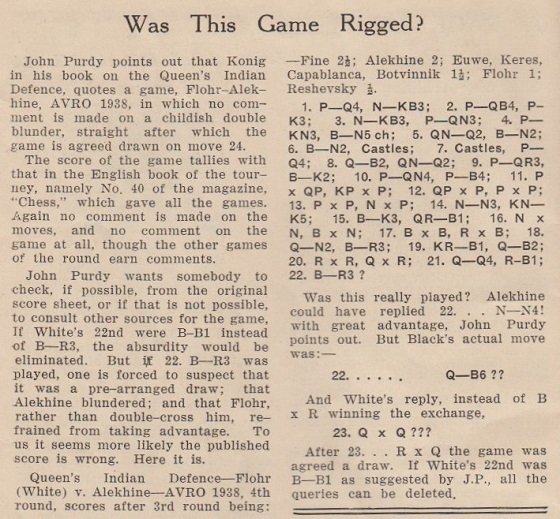
The question in the headline was answered on page 60 of the March 1957 issue:
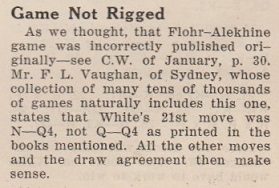
The full score of Flohr v Alekhine, AVRO, 12 November 1938: 1 d4 Nf6 2 c4 e6 3 Nf3 b6 4 g3 Bb4+ 5 Nbd2 Bb7 6 Bg2 O-O 7 O-O d5 8 Qc2 Nbd7 9 a3 Be7 10 b4 c5 11 cxd5 exd5 12 dxc5 bxc5 13 bxc5 Nxc5 14 Nb3 Nfe4 15 Be3 Rc8 16 Nxc5 Bxc5 17 Bxc5 Rxc5 18 Qb2 Ba6 19 Rfc1 Qc7 20 Rxc5 Qxc5
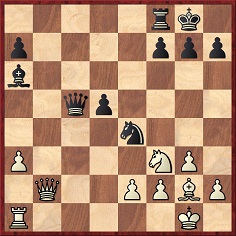
21 Nd4 Rc8 22 Bh3 Qc3 23 Qxc3 Rxc3 Drawn.
Apart from the two mentioned by Purdy, the sources that we have consulted state that White’s 21st move was Nd4, and not Qd4, with one notable exception: page 632 of the Skinner/Verhoeven volume on Alekhine.
The publications cited by Purdy are shown below, beginning with page 131 of the 14 December 1938 issue of CHESS (the sole source indicated by the Skinner/Verhoeven book):
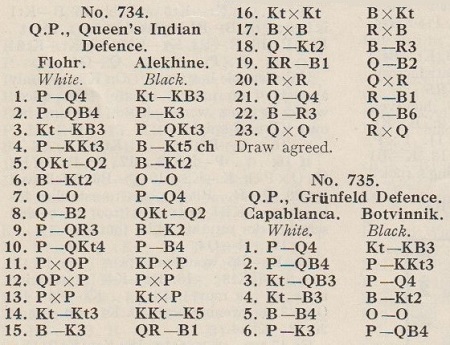
In the relevant part (pages 46-47) of König’s book The Queen’s Indian Defence (London, 1947) our copy has a handwritten correction at move 21:

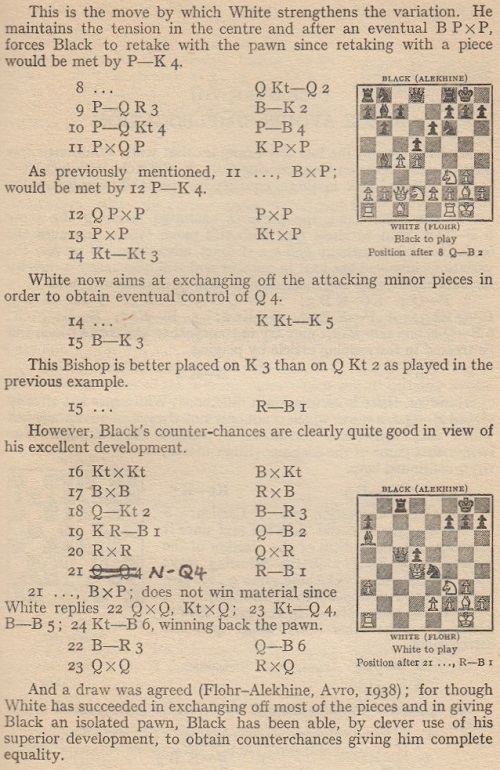
(9797)
An advertisement from the back cover of the Schweizerische Schachzeitung, December 1947:
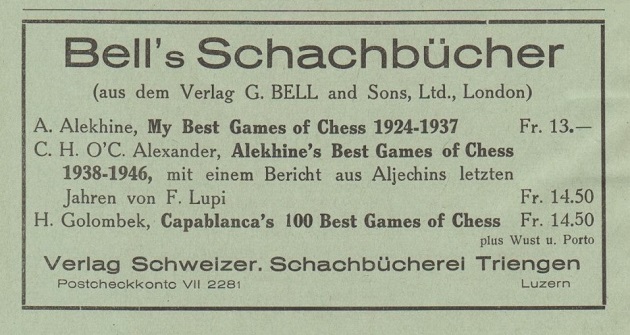
C.H.O’D. Alexander’s book was published nearly two years later, the dates in the title being 1938-1945. No material by Francisco Lupi was included, and we wonder whether the intention had been to give a new text by him or merely to reproduce the articles which, as discussed in C.N. 4388, he published shortly after Alekhine died.
The years in the book title are given as 1938-46 in the skimpy ‘Bibliography’ on page 6 of Alekhine move by move by Steve Giddins (London, 2016), and the following page has Mr Giddins’ contribution on the topic of Alekhine’s Death:
‘And even his death has been questioned, with suggestions he may have been murdered by a Soviet hitman. Admittedly, this latter theory has much less substance, and should probably be grouped with those that suggest the moon landings were faked and that Princess Diana was murdered by Lord Lucan, with Elvis Presley (or was it Dick Cheney?) driving the getaway car.’
(9888)
From page 104 of How to Play Winning Chess by Fred Reinfeld (New York, 1962):
‘Yet, for all his daring at the chessboard, he was burdened with strangely timorous quirks of character. After fleeing from Russia in 1921 he had lived in great poverty for some time in Germany. This harrowing period left a lifelong mark on him. I can vividly recall meeting him for the first time at the Pasadena tournament of 1932, for my naive hero-worshiping attitude was jarred by some of his strange whims. For example, although he was virtually a chain-smoker, he always kept his cigarettes in his pocket. When he wanted to smoke, he would reach into his pocket and maneuver one cigarette out without removing the pack. In this way he avoided the social necessity of offering his companion or opponent a cigarette.’
(9900)
See too Chess and Tobacco, which includes the following:
From pages 384-385 of Kings, Commoners and Knaves:
Innumerable books affirm that Alekhine gave up smoking in preparation for his 1937 match with Euwe, as if that were an unprecedented decision. From page 62 of the April 1929 American Chess Bulletin:
‘He [Alekhine] no longer smokes. We understand that he bid farewell to Lady Nicotine soon after the New York tournament of 1927 …’
In an article about Carlsbad, 1929 in the New York Times, 28 August 1929, pages 19 and 20 Alekhine wrote concerning F. Sämisch:
‘That the hopes placed in him in this tourney may not be realized is due – paradoxical as it sounds – according to the observation of the author of this article, to an excessive use of nicotine. Certainly a cigarette has a soothing effect for a moment. However, a player deep in thought and excited is easily apt to smoke too much, thus, in the first line, spoiling his memory and ruining his nerves and his power of resistance. Only when I rid myself of the passion for cigarettes did I attain enough confidence to win the world championship.’
From page 35 of Famous Chess Players by Peter Morris Lerner (Minneapolis, 1973):
‘Although Alekhine gave up smoking for the world championship, he took up the habit again as soon as the match was completed. One night he went to bed with a lighted cigarette and woke up amid flames. Luckily, he was not injured.’
The following appeared on page 27 of the February 1931 American Chess Bulletin:
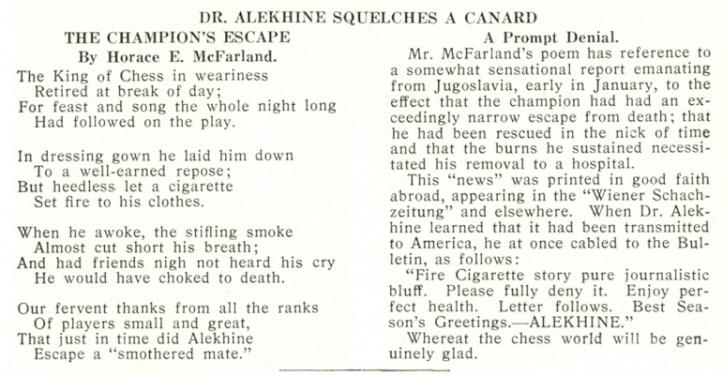
The report in the Wiener Schachzeitung (on page 374 of the December 1930 issue) was nearly 40 lines long.
(5169)
The above-mentioned report on page 374 of the December 1930 Wiener Schachzeitung:
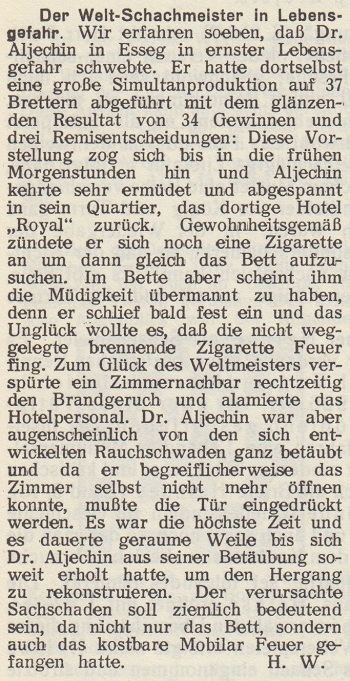
An addition from the Daily Herald (London), 30 December 1930, page 2:
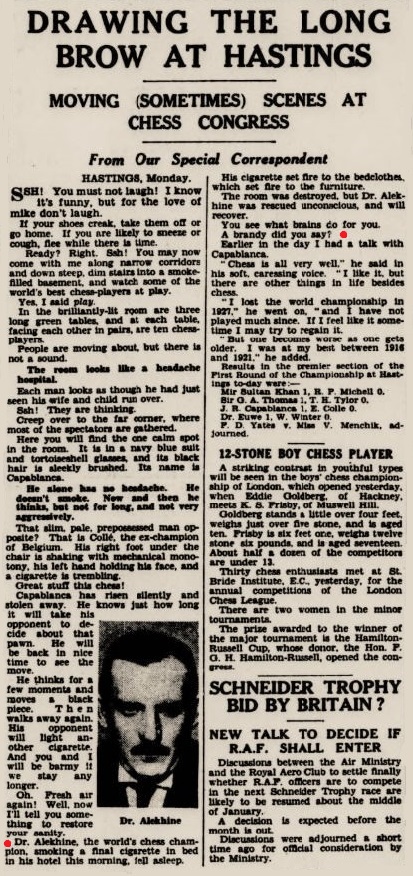
The report, headed ‘Monday’ (i.e. 29 December 1930), states, improbably, that the hotel fire occurred ‘this morning’. On that day, as shown by page 389 of the Skinner/Verhoeven book on Alekhine, the world champion was in Novi Sad, having previously been in Subotica. On 23 December 1930 he gave a simultaneous exhibition in Osijek, the city referred to in the Wiener Schachzeitung report (Esseg in German).
(10859)
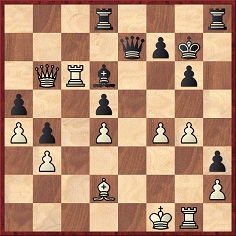
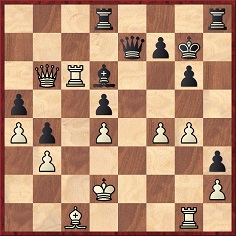
Black to move
C.N. 9903 asked which annotator gave ...Qe2 mate in both the above positions.
The answer is C.H.O’D. Alexander, in his annotations to Balparda v Alekhine, Montevideo, 1938 on pages 15-17 of Alekhine’s Best Games of Chess 1938-1945 (London, 1949):
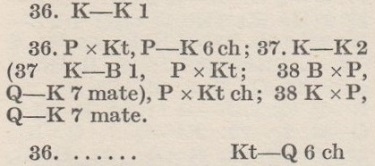
The mistake was pointed out in a review on page 5 of the October 1949 CHESS, and the note was amended in subsequent editions:
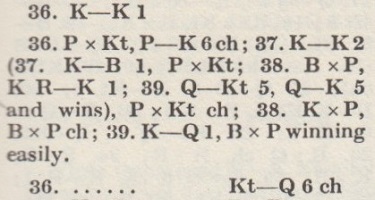
The full score of the Balparda v Alekhine game, which was played in the sixth round of the Montevideo tournament on 14 March 1938: 1 d4 Nf6 2 Nf3 b6 3 g3 Bb7 4 Bg2 c5 5 c3 e6 6 O-O Be7 7 b3 O-O 8 Bb2 cxd4 9 cxd4 b5 10 Nbd2 Qb6 11 e3 a5 12 a3 Nc6 13 Ne5 d6 14 Nxc6 Bxc6 15 Bxc6 Qxc6 16 Rc1 Qb7 17 Qf3 d5 18 Rc2 Bd6 19 Rfc1 Qe7 20 Qe2 Rfb8 21 Nb1 h5 22 Rc6 h4 23 g4 Ne4 24 f3 Ng5 25 Kg2 b4 26 a4 e5 27 Nd2 Re8 28 Qb5 e4 29 f4 h3+ 30 Kg3 Rad8 31 Rf1 g6 32 Qb6 Kg7 33 Bc1 Ne6 34 Rg1 Rh8 35 Kf2 Nxf4 36 Ke1 Nd3+ 37 Kd1 Bxh2 38 Rf1 Bd6 39 White resigns.
The game was published on page 280 of the June 1938 BCM:
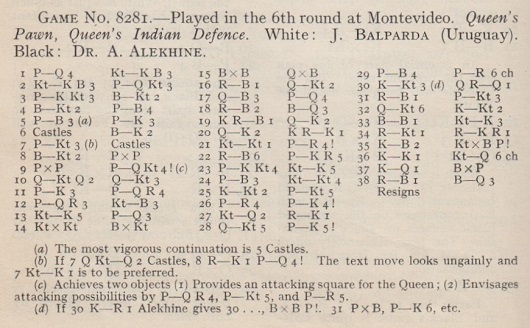
We do not know whether the reference to ‘Alekhine gives ...’ in note (d) is based on a written or an oral comment.
The game was annotated by, among others, Santasiere, on page 54 of the May-June 1938 American Chess Bulletin. Showing its customary deep research, the Skinner/Verhoeven book on Alekhine recorded on page 623 that the game had been published in 1938 issues of El Ajedrez Americano, Xadrez Brasileiro and De Schaakwereld. All three gave annotations, and we are grateful to the Royal Library in the Hague for copies of the Brazilian and Dutch periodicals.
A group photograph was shown in C.N. 4000, from page 113 of El Ajedrez Americano, April 1938, and from the same issue (pages 109, 110 and 113 respectively) further pictures are added:
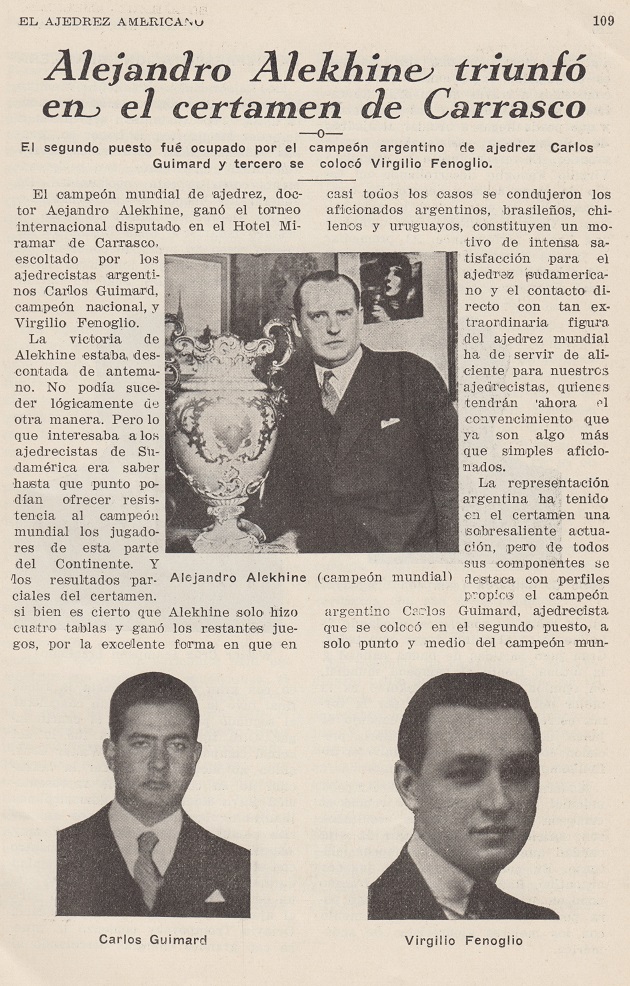
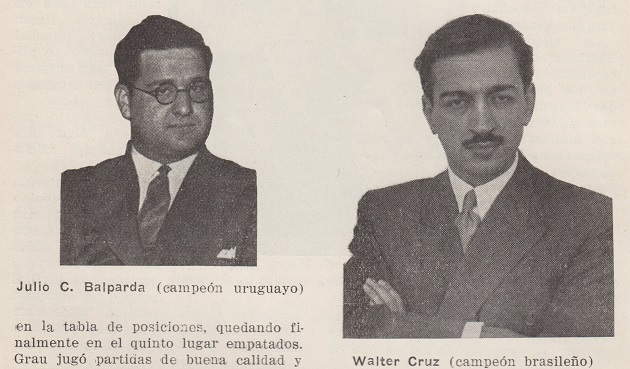
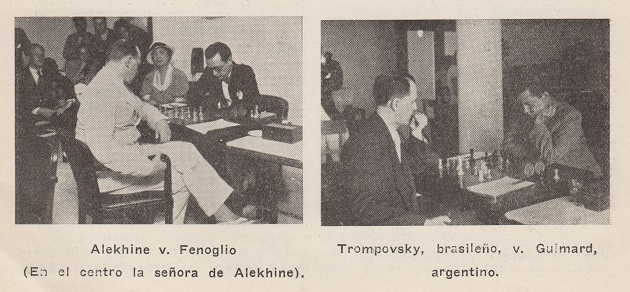
Another group photograph is on page 64 of Roberto Grau, el maestro by G.C. Grau, J.R. Delfino and J. Morgado (Buenos Aires, 2007).
From the chessgames.com page on Balparda:

However, from page 82 of Ajedrez uruguayo (1880-1980) by Héctor Silva Nazzari (Montevideo, 2013):
‘La carrera ajedrecística de Balparda fue corta como lo fue su vida al fallecer prematuramente el 8 de julio de 1942 a los 39 años de edad.’
(9916)
Gerard Killoran (Ilkley, England) provides a cartoon from page 8 of the Sun (Sydney), 30 October 1929:
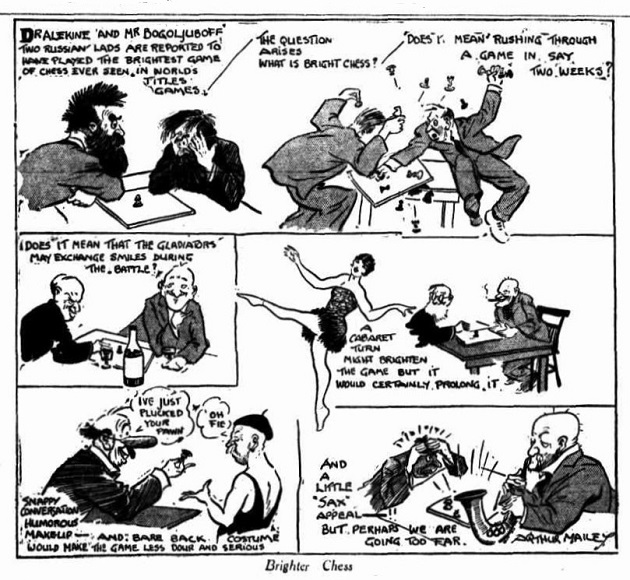
The cartoonist, Arthur Mailey (1886-1967), was an Australian test cricketer.
(9976)
A Spanish website has a large number of chess photographs. One recommended search, ‘ajedrez 1943’, gives these 12 shots:
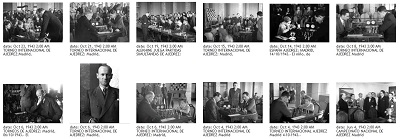
(9978)
Richard Jones (Bologna, Italy) raises the question of whether Capablanca was a poor loser, and particularly in the immediate aftermath of his match defeat by Alekhine in 1927.
As shown on pages 202-206 of our monograph on the Cuban, his public statements about Alekhine’s victory were generous. The conclusion of the match was discussed on pages 348-350 and 521 of Miguel A. Sánchez’s 2015 book on Capablanca, but a properly documented account of what happened in Buenos Aires at the end of November 1927 remains to be written. With optimum use of source material, the chess historian must try to show what is certain, what is probable, what is unlikely and what is untrue, and at every stage the reader is entitled to ask, ‘Where did that come from?’ With erratic use of source material, Miguel A. Sánchez often makes do with a mixture of facts, assertion, imagination and speculation.
Concerning Capablanca’s letter of resignation of game 34, we do not know when the original first became public. One book which reproduced it (on a page chiefly comprising the fake Alekhine-Capablanca photograph) was Umkämpfte Krone by R. Stolze (East Berlin, 1986):
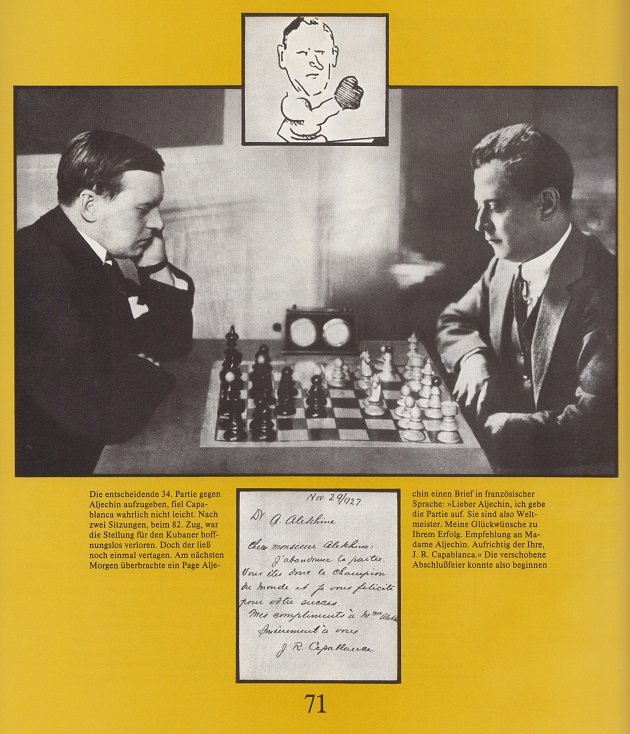
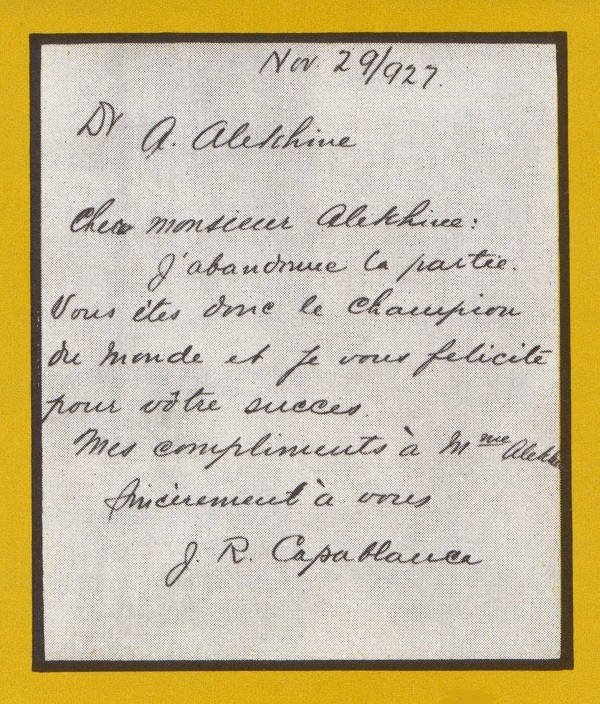
Correct French would have been desirable.
On page 521 of his book Sánchez characteristically referred to ...
‘... the text, originally written in French, although with some grammatical inaccuracies (probably because of Capablanca’s state of mind) and later fixed ...’
(10022)
Concerning Capablanca’s letter to Alekhine dated 29 November 1927, which was shown in C.N. 10022, Thierry Lafargue (Mont de Marsan, France) draws attention to an article entitled ‘Le séjour de Karpov à Paris’ by Roland Lecomte on page 197 of Europe Echecs, July 1976. It recorded that at a reception in his honour in Paris on 2 June 1976 Karpov was presented with the original letter, which had been bequeathed to the Ligue de l’Ile-de-France by its late Honorary President, Louis Sol. The document ‘est destiné à être la possession du champion du Monde en titre’.
The relevant parts of the report:
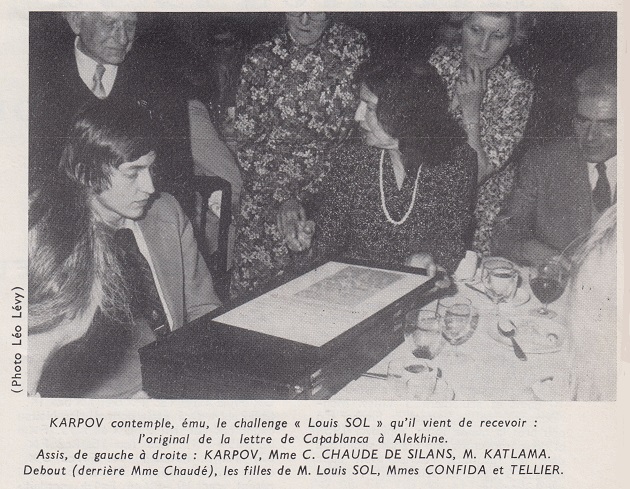
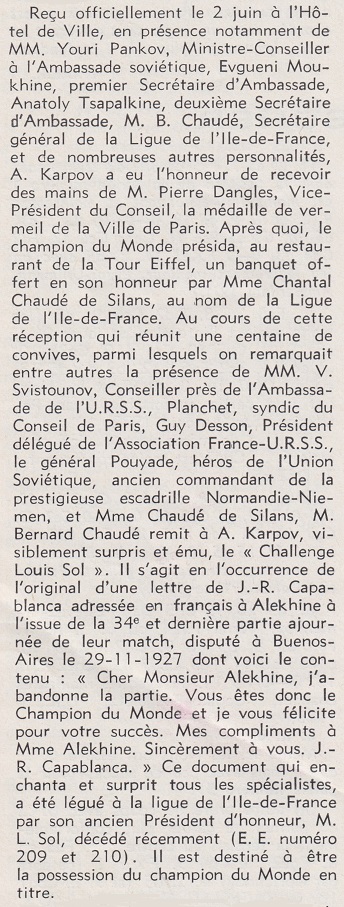
Mr Lafargue asks where Capablanca’s letter is today.
(10050)
Guy Gignac (Donnacona, Canada) informs us that he recently acquired this photograph:
Assistance with identifying the group will be welcomed.
(10109)
Michael Clapham comments that the photograph appears to be a reverse image, given that the coats are buttoned on the left.
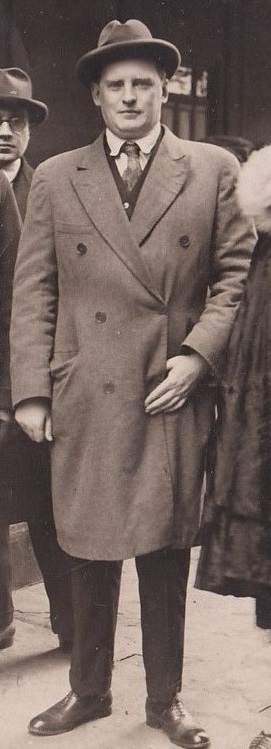
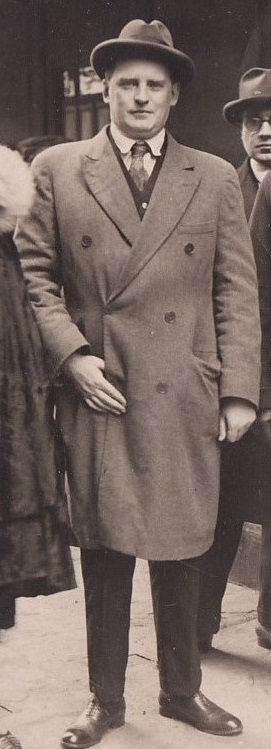
(10113)
Javier Asturiano Molina and Eduardo Bauzá Mercére note that the wording on the reverse of the photograph is:
‘Leyenda
‘El maestro Alekhine y su esposa momentos después de desembarcar con las autoridades del Club A. [Argentino] de Ajedrez.’
It is also indicated that the photographer was José Amorós, for La Razón. Did the picture appear in that publication?
Finally, the following words are stamped upside down: ‘Foto del revés’ (‘reversed photograph’).
(10151)
The Gallica website of the Bibliothèque Nationale de France has a photograph of Alekhine playing blindfold at the Café de la Rotonde au Palais-Royal in Paris.
(10114)
Hans Renette (Bierbeek, Belgium) forwards a photograph from page 3 of Die Deutsche Zeitung im Ostland, 26 September 1942:
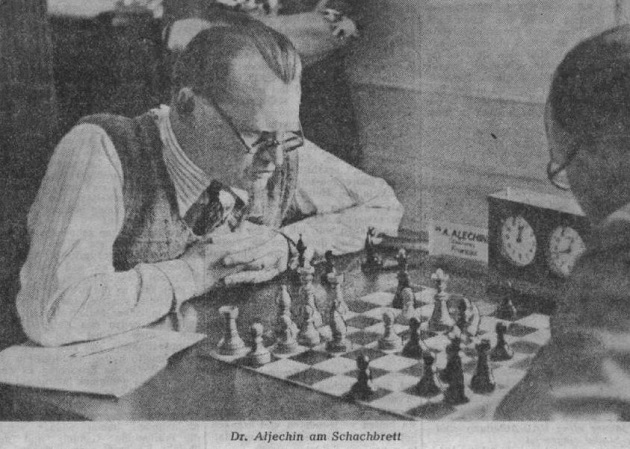
We included the picture in Kings, Commoners and Knaves, identifying the game as Alekhine v E. Steiner, Kemeri, 1937. The photograph had appeared, without any particulars, in Nad šachovnicemi celého světa by K. Opocenský and V. Houška (Prague, 1960):
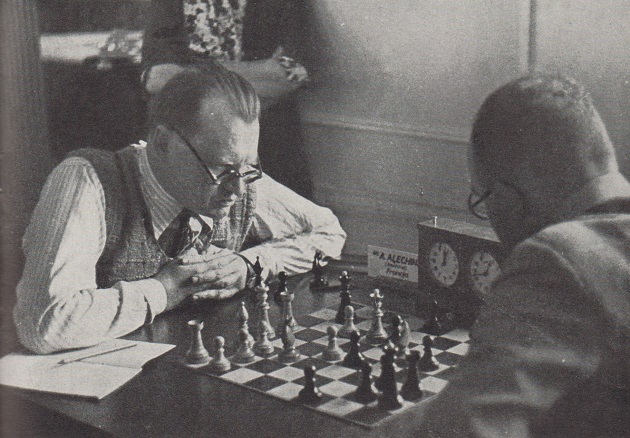
(10117)
From page 166 of Studies for Practical Players by Mark Dvoretsky and Oleg Pervakov (Milford, 2009), translated by Jim Marfia:
‘It often happens that a game, or the analysis which follows, will produce study-like positions. Some do not require any sort of further finishing work – they stand before us practically ready-made. Others are more like diamonds in the rough, awaiting further polishing. Alekhine had those kinds of positions, too.’
There followed this ‘bit of a study’:
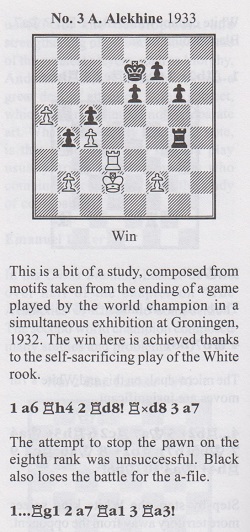
Leaving aside, in the above extract, the incorrect date (1932) and the notational mishap, we observe that, as usual, Alexander Alekhine’s Chess Games, 1902-1946 by L.M. Skinner and R.G.P. Verhoeven (Jefferson, 1998) is the source to consult. From page 475:
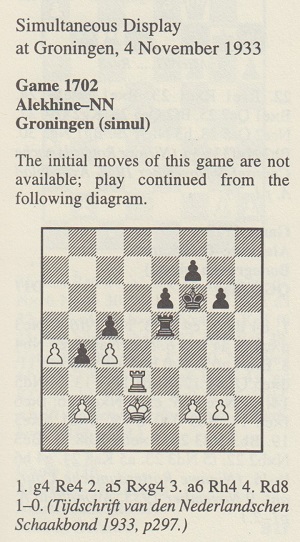
Below is the coverage on pages 296-297 of the Tijdschrift van den Nederlandschen Schaakbond, November 1933:
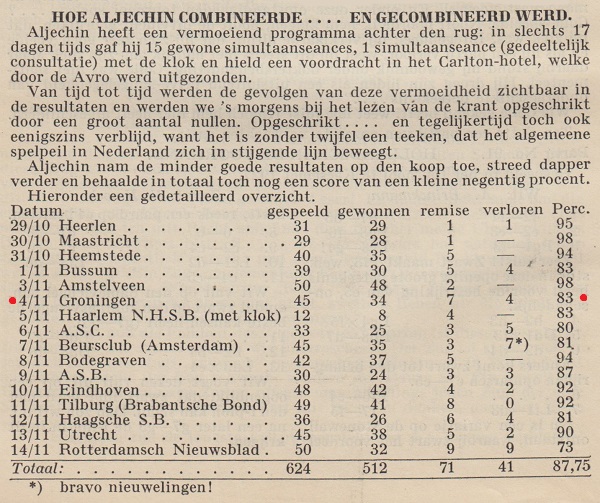
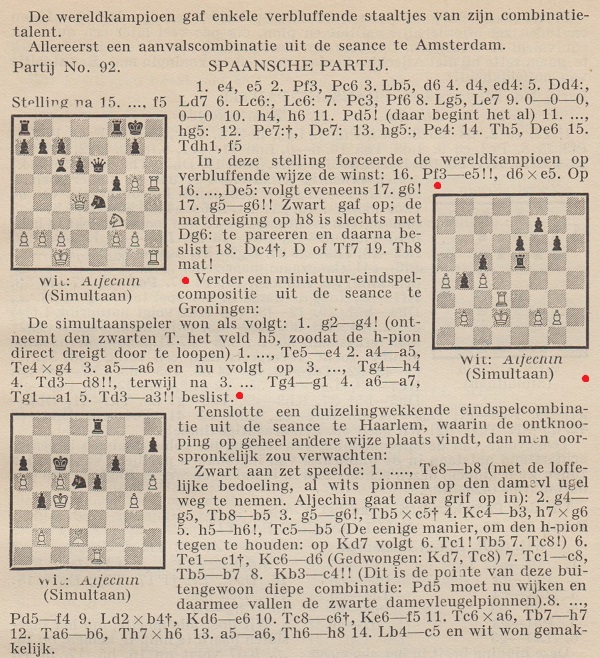
Did any newspapers of the period offer further information about the game played in Groningen?
(10158)
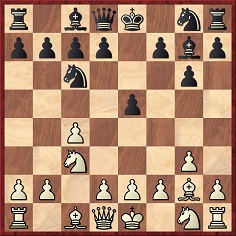
Which move is preferable, 5 d3 or 5 e3?
On pages 67 and 265 of his book on Nottingham, 1936 Alekhine gave contradictory comments about the position after 1 c4 e5 2 Nc3 Nc6 3 g3 g6 4 Bg2 Bg7:
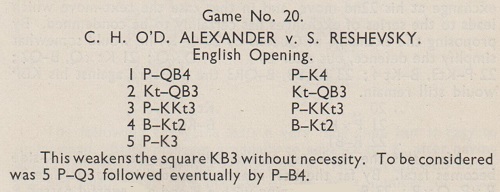
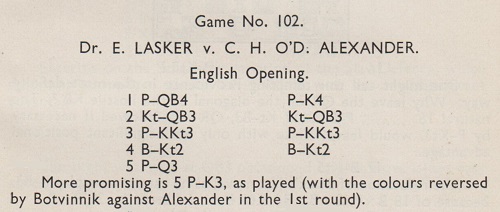
As mentioned in C.N. 2109 (see page 281 of Kings, Commoners and Knaves), the discrepancy was pointed out by T.V. Parrott on page 153 of CHESS, May 1953 and by Arthur Oliver on page 105 of Chess World, June 1962. A later reference is page 15 of Chess Life, January 1963 (in a ‘Chess Kaleidoscope’ article by Eliot Hearst).
(10172)

Position after 4...Bg7
From Yasser Seirawan:
‘Despite Alekhine’s contradictory comments, both the moves that he mentions, 5 d3 and 5 e3, are considered to be main lines of play in modern opening theory.
In his recent works on the English Opening, Mihail Marin has advocated 5 e4, and I wonder whether Alekhine might have suggested that that move weakens f3, d3 and d4. The most surprising comment by Alekhine is that after 5 d3 White may, in time, aspire to play f4; in modern games that simply does not happen.
In view of the forthcoming middlegame, modern masters would judge 5 d3 to be the prelude to a queen’s-side expansion, most often seen with the maneuver Rb1, b4 and b5, chasing away the c6-knight and improving the view of the g2 bishop.
Conversely, 5 e3 is considered rather more flexible. White signals that he intends a central expansion with Nge2, perhaps followed by the advance d4. In that line, White can sometimes also pursue a queen’s-side expansion, as mentioned above, after playing d3. The key difference is that the king’s knight is developed to e2 instead of f3, and in this case White will usually play f4, to counter-act an aggressive king’s-side expansion by Black.
In short, modern theory considers that the two moves given by Alekhine, 5 d3 and 5 e3, are equally good.’
(10176)
C.N. 10159 showed a picture of Koltanowski drawn by Henry Grob and published on page 1 of the 4 December 1936 issue of Schach-Kurier.
Richard Forster (Zurich) notes that it is one of five portraits of chess figures in Henry Grob: der Zeichner und Maler by Henry Grob (Zurich, 1965). The pages in the booklet were unnumbered, and the works were arranged chronologically. Below is his portrait of Alekhine.
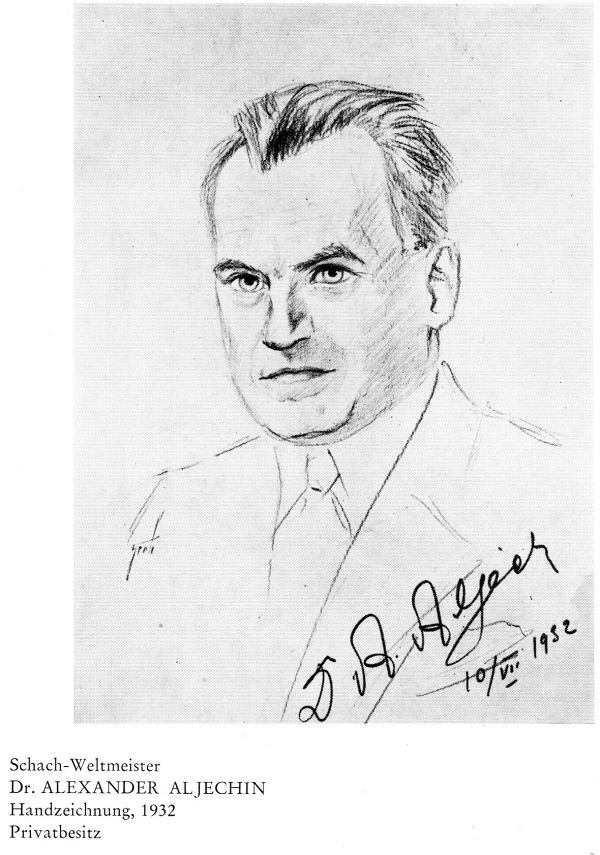
(10217)
From page 96 of Wonders and Curiosities of Chess by Irving Chernev (New York, 1974):
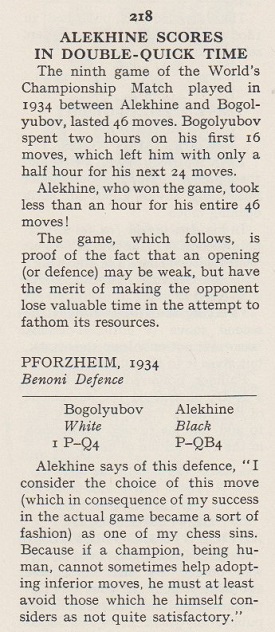
This was number 63 in Alekhine’s second volume of Best Games. The final clock times given on page 55 of Bogoljubow’s book on the match were White: 2 hours 41 minutes; Black: 58 minutes.
(10221)
From Jan Kalendovský comes this photograph published on page 27 of Atpūta, 8 December 1939:
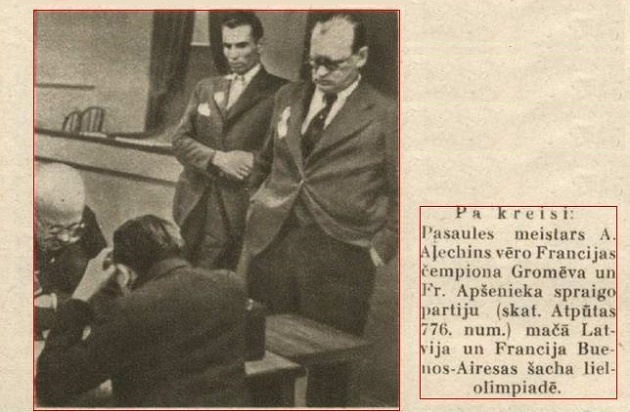
(10250)
From page 55 of Other Passports by Clive James (London, 1986):

The full poem, a parody entitled ‘Richard Wilbur’s Fabergé Egg Factory’, can be read on Clive James’s website.
(10184)
A fragment to which reference will be made in the 29...Bxh2 section of the feature article Spassky v Fischer, Reykjavik, 1972 concerns the position after 27...Bb5-c4 in the 30th match-game (also described as the fifth exhibition game) between Alekhine and Euwe, Rotterdam, 16 December 1937:
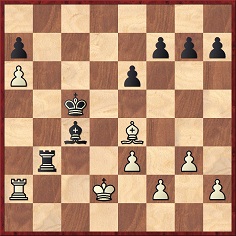
Alekhine now played 28 Bxh7. Below is the remainder of the game as annotated by Euwe on pages 200-201 of Alekhine’s match book:
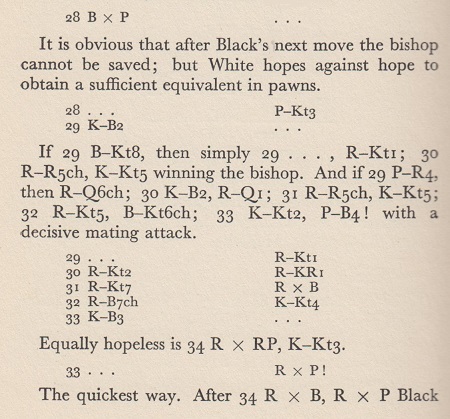
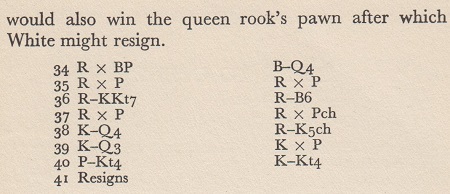
The annotations by Alekhine on page 104 of his book ¡Legado! (Madrid, 1946):
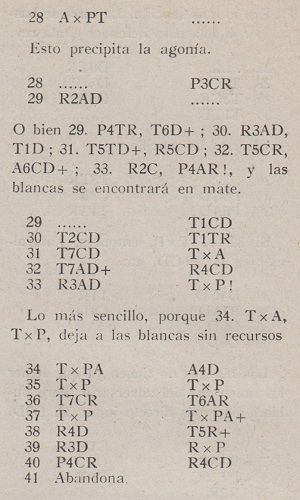
Finally, Alekhine’s remarks about the five exhibition games, from page 183 of his match book:
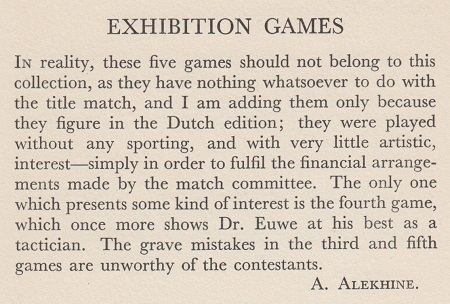
(10264)
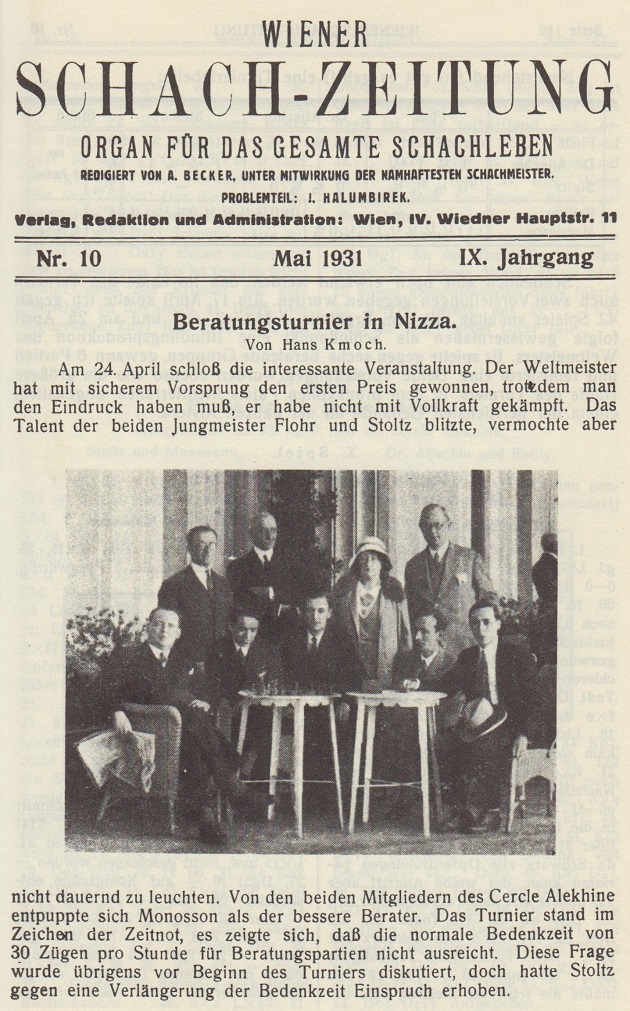
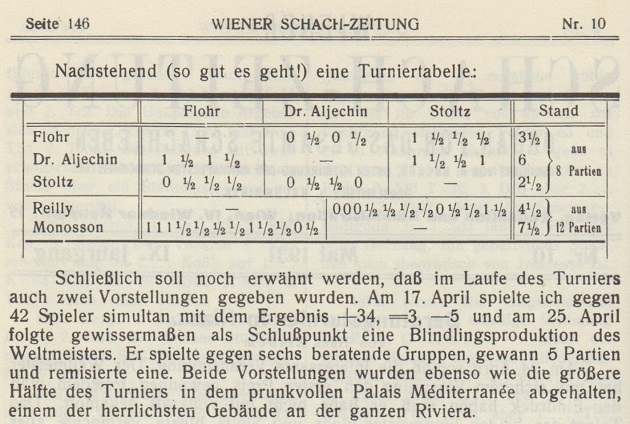
Is it possible to find a better copy of the photograph, with a full caption?
A tournament held in Nice earlier that year was won by Reilly, and a group photograph, which also included Duchamp, Mieses, Noteboom and Znosko-Borovsky, was published on page 201 of the May 1931 BCM. A clearer copy is on page 117 of the March 1981 issue.
(10269)
On page 10 of Bobby Fischer’s Conquest of the World’s Chess Championship (New York, 1973) Reuben Fine wrote regarding Alekhine:
‘When World War II ended, in 1945, all the leading masters of that day, incensed by his behavior, objected to his participation in international tournaments. The Soviets broke the boycott by having Botvinnik challenge Alekhine to a match for the title in 1946. Actually this was illegal, since Keres and I had prior claims. But Keres, born in Estonia, was a Soviet citizen, while I was no longer so interested.’
From pages 224 of the ‘revised and expanded edition’ of The World’s Great Chess Games by Fine (New York, 1976):
‘Legally there were various possibilities. Euwe might have reclaimed the title, as the last official champion before Alekhine. Or Keres and Fine could have been declared co-champions on the basis of their joint victory in the AVRO tournament. Or Euwe, Fine and Reshevsky might have played a three-cornered tournament to decide the championship. Or the free world might have chosen a champion, and the communist world been left to choose its own; then the two could have met for the world championship.’
On the next page Fine wrote with respect to AVRO, 1938:
‘As indicated before, on the basis of this victory and in light of the circumstances of international chess in the war period, Keres and I should have been declared co-champions for the period 1946-48, between the death of Alekhine and the 1948 tournament.’
Finally, a comment by Fine on page 151 of Lessons from My Games (New York, 1958):
‘Keres and I tied for first in the AVRO tournament; he was declared winner by the tie-breaking Sonnenborn-Berger [sic] system. Alekhine dodged a match in his usual skillful manner. Then the war intervened and all official chess activity stopped.’
There is a frequent lack of rigour in claims that Alekhine ‘dodged’ opponents, and it is unimpressive to find C.J.S. Purdy writing the following in a review of Lessons from My Games on pages 146-147 of Chess World, September-October 1967:
‘Reuben Fine became one of the world’s greatest players. At the time when his claims to play a match for the world title were unanswerable, he did not get to play a match because Alekhine, once he had regained his title from Euwe, did everything possible to evade a match.’
As regards possible challenges to Alekhine after AVRO, 1938, an observation on page 215 of Reuben Fine by Aidan Woodger (Jefferson, 2004) is noteworthy:
‘Fine seems not to have made any effort at all ...’
(10288)
As mentioned in C.N. 10291, Olimpiu G. Urcan has found a number of chess pictures in The Sphere. They include the following:
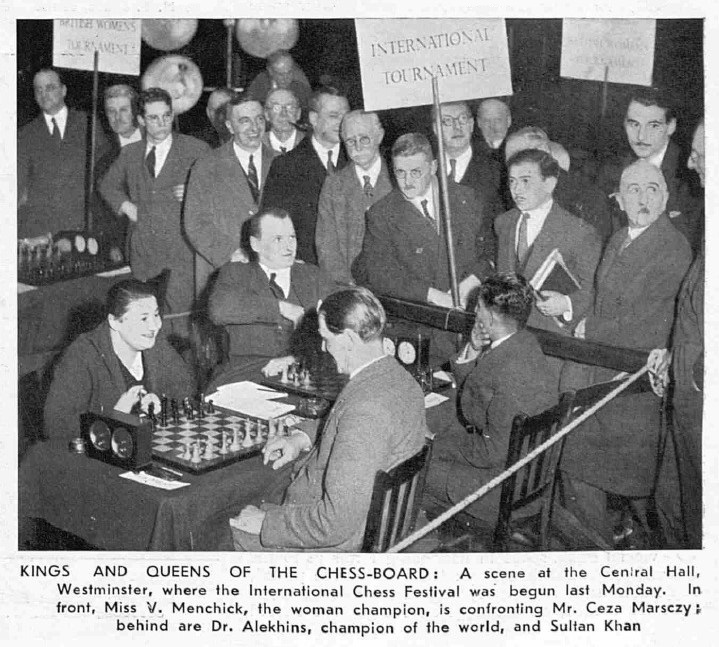
6 February 1932, page 203
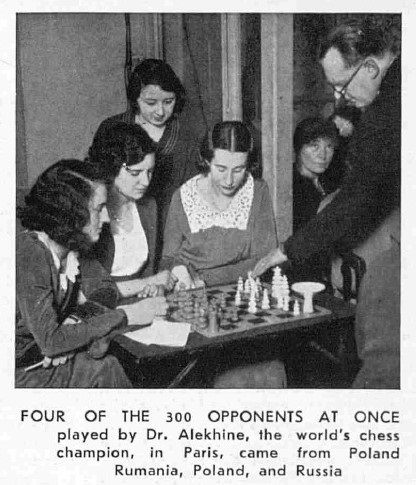
12 March 1932, page 402
From page 8 of issue one of Albrecht Buschke’s publication Chess News from Russia, 10 November 1945:
‘Shortly before Dr Lasker’s death, i.e. almost three years after the return match between Alekhine and Euwe, the first few copies of a booklet about this match had arrived from Russia. The writer happened to have a copy of this booklet in his hands when he paid Dr Lasker one of his periodical visits. Dr Lasker had hardly looked at the book when he asked the writer emphatically to leave the book with him. At the astonished question whether he, of all chessplayers, had not seen these games yet, after almost three years, the Grand Old Man of Chess had a good and valid explanation: “Oh, I know the games, of course ... they don’t interest me any longer ... what I want to study are Botvinnik’s notes to these games – they are of real importance ...”’ (Ellipses in the original.)
Botvinnik’s volume on the 1937 Euwe-Alekhine match was reprinted by Издательство “Галерия”, Moscow in 2002:
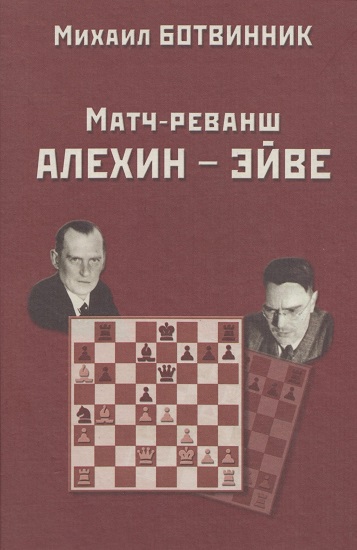
(10305)
In his 2006 edition of Chess Fundamentals Nick de Firmian’s changes included putting ‘he or she’ where Capablanca had written ‘he’. If, heaven forfend, de Firmian were let loose on Alekhine’s book on Nottingham, 1936, he would come to this note, on page 56 of the original, concerning the third-round game between Alekhine and Tylor:
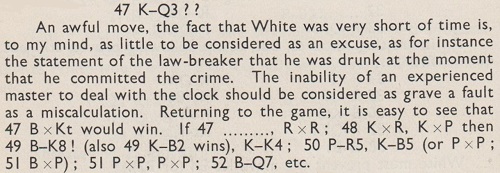
Or, in the ‘style’ imposed by de Firmian:
‘... the statement of the law-breaker that he or she was drunk at the moment that he or she committed the crime.’
(10354)
Regarding the 1937 Euwe v Alekhine world championship match, C.J.S. Purdy wrote on page 80 of Chess World, 1 May 1946:
‘Although for sheer accuracy it could not compare with the Alekhine-Capablanca match, it was, on the whole, the greatest chess match ever played.’
(10363)
As quoted in Capablanca v Alekhine, 1927, Kmoch’s article ‘My Personal Recollections of Capablanca’ on pages 362-363 of Chess Review, December 1967 included this paragraph (page 362):
‘In Kissingen [1928], my contact with Capablanca became rather close. We had long walks together, usually talking about the world championship in reference to which Capablanca always used the expression “my title”, making it seem that the title had only incidentally and temporarily strayed to Alekhine. More than once he explained to me how I could make a lot of money. Very simple: just organize the return match against Alekhine and bet as much as possible on me; you will win, that much is absolutely sure.’
On page 363 Kmoch wrote:
‘Capablanca used to see incredibly much with but a single glance at the board. There still rings in my ears Réti’s lament: “No sense in showing him a composition because he sees the solution before you have finished setting up the position.”’
(10384)
From page 113 of CHESS, May 1941:
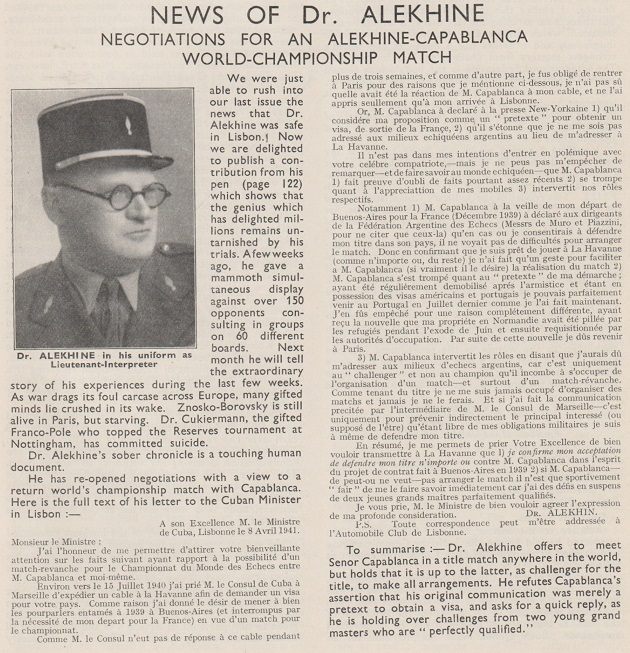
The letter was referred to on page 656 of the 1998 Skinner/Verhoeven book on Alekhine.
(10424)
From Josep Alió:
‘As mentioned on page 11 of my 1999 book Els Escacs a Tarragona, in 1944 Alekhine gave simultaneous displays in two towns near Tarragona: Reus (29 February) and Valls (5 March).
A photograph taken during the latter display (+27 =3 –0) is held by the Valls City Archives.’
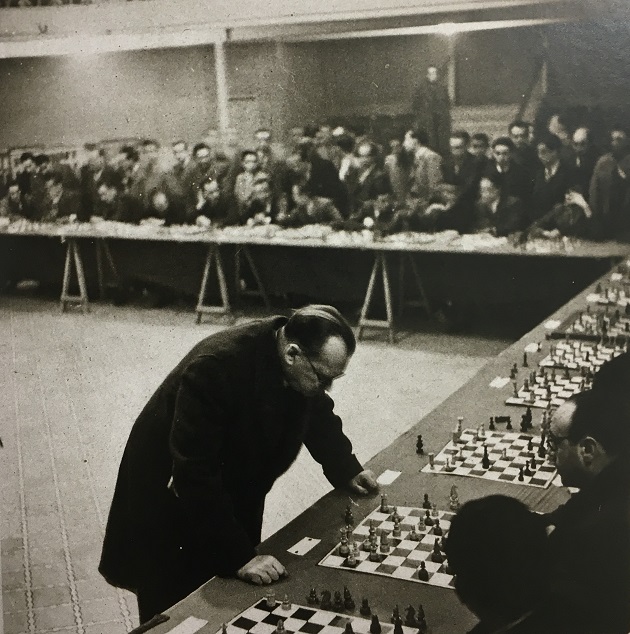
(10513)
Olimpiu G. Urcan writes:
‘On pages 229-233 of our book Arthur Kaufmann. A Chess Biography, 1872-1938 (Jefferson, 2012) Peter Michael Braunwarth and I presented clues suggesting that Kaufmann met, and played against, Alexander Alekhine in Odessa in June/July 1919. Recently, Dominique Thimognier (Fondettes, France) has discovered incontrovertible proof thereof, in Georg Marco’s chess column in the Neues Wiener Journal. Mr Thimognier points out that in the 2 October 1920 column (page 3) Marco gave a position from the familiar Alekhine v “Dr A. Kaufman” game discussed on pages 230-232 of our book. Black was indeed Arthur Kaufmann:
Furthermore, Mr Thimognier has found that in the 6 October 1920 column in the same newspaper (page 3) Marco gave the conclusion of another game played by Kaufmann and Alekhine (Odessa, July 1919):
Marco presented each item as an “original contribution for the Neues Wiener Journal”.’
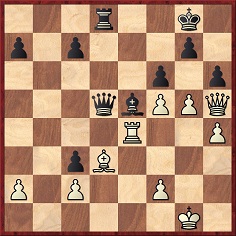
Black to move (Kaufmann v Alekhine, Odessa, July 1919)
1...Kh8 2 gxh6 g6 3 Qxg6 Rg8 4 Rg4 Bd4 5 Re4 Qxa2 6 Re7 Resigns.
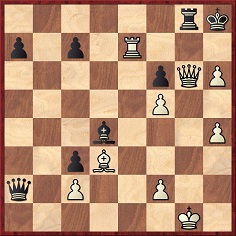
(10586)
Jan Kalendovský sends, from the archives of the Zlín Chess Club, two photographs of Alekhine giving a simultaneous display in Zlín on 17 February 1943:
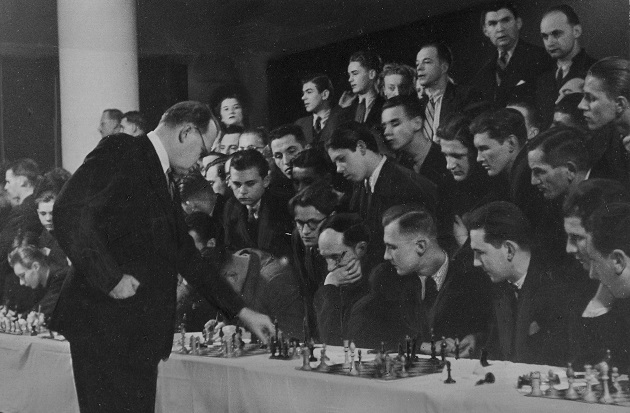
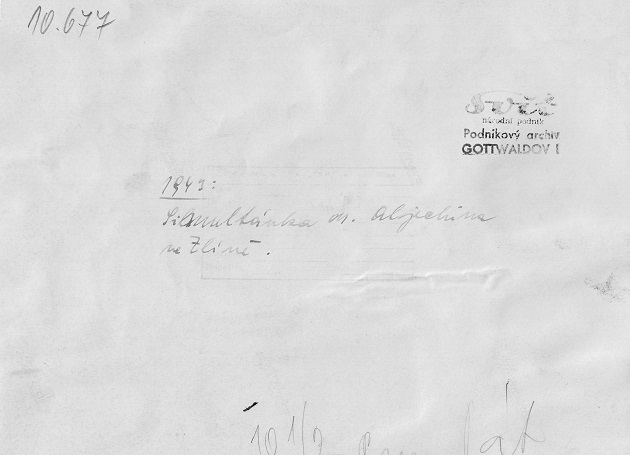
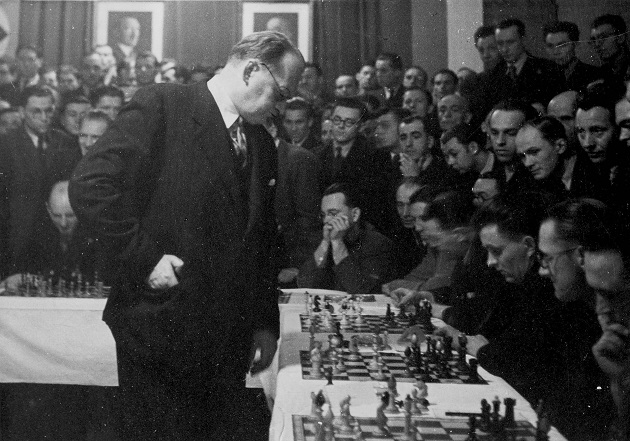
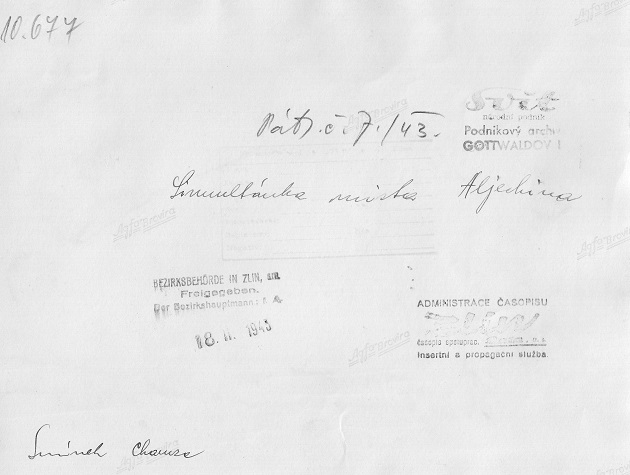
(10604)
Ross Jackson (Raumati South, New Zealand) provides two photographs which he owns:
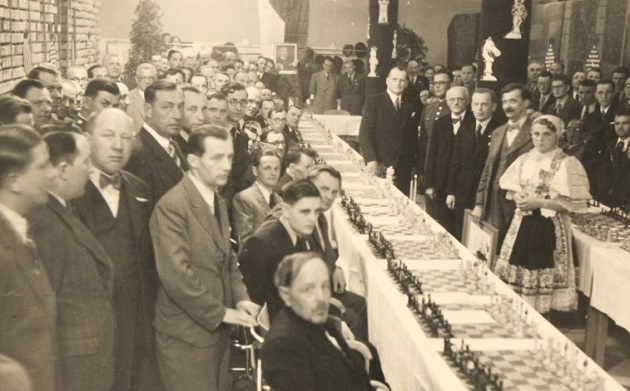
Kroměříž, 11 February 1943
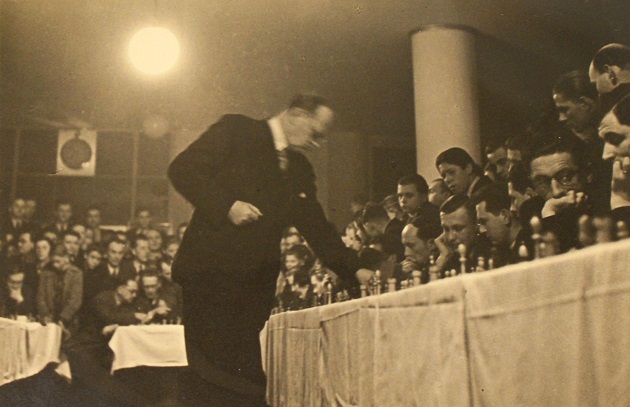
Zlín, 17 February 1943
We have added the date of the Kromeríž exhibition from the table of the world champion’s simultaneous performances in Alechin v Československu by Jan Kalendovský (Brno, 1992).
(10621)
Ross Jackson asks what is known about the claim on page 190 of The World of Chess by A. Saidy and N. Lessing (New York, 1974) that during the 1927 world championship match Jaffe sent Alekhine a cable which ‘contained an analysis of a variation of the Queen’s Gambit with a new move suggested by Jaffe, which Alekhine is thought to have adopted’.
(10674)
‘The combination, or rather series of combinations, in this game, is in my opinion the most remarkable tactical conception in chess history.’
That observation by Reuben Fine concerns Alekhine v Böök, Margate, 1938 and comes from page 531 of the November 1938 BCM, in a theoretical article on the Queen’s Gambit Accepted. Below is the relevant passage, after discussion of the moves 1 d4 d5 2 c4 dxc4 3 Nf3 Nf6 4 e3 e6 5 Bxc4 c5 6 O-O a6 7 Qe2:
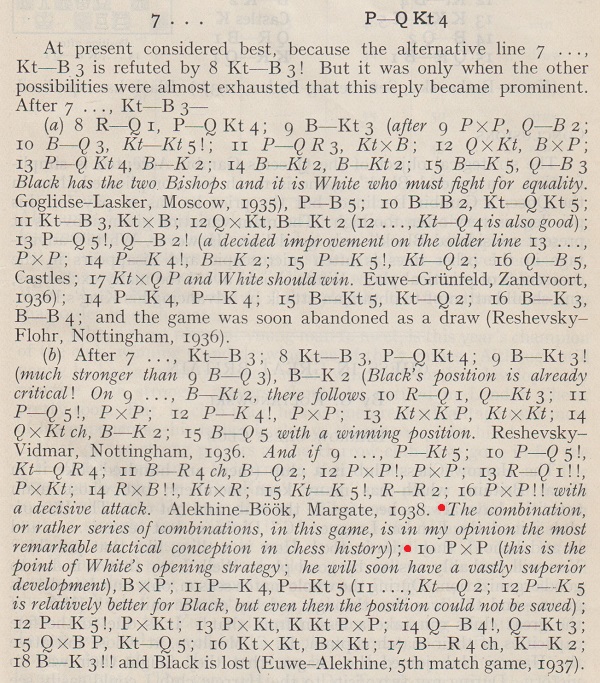
(10676)
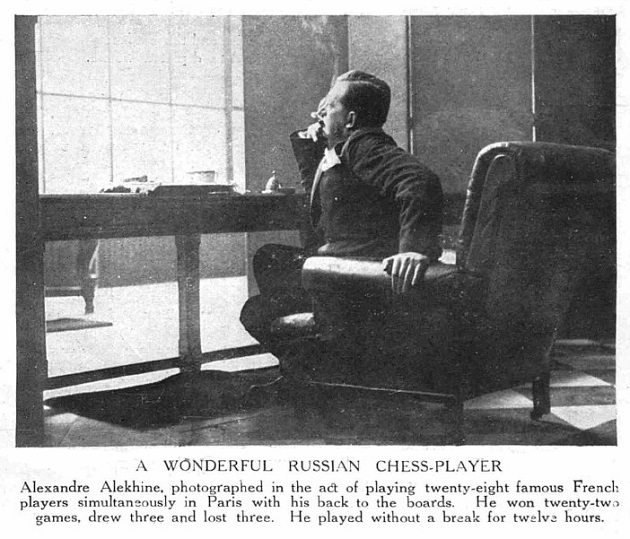
The above photograph, from page 191 of The Graphic, 7 February 1925, was shown in C.N. 10302.
Arthur Larrue (Lisbon) informs us that the Gallica website has a different shot, of high quality, taken at the same locale.
(10733)
An addition to the small number of photographs of Octávio Trompowsky is noted by Eduardo Bauzá Mercére, in Xadrez Brasileiro, May 1939, page 63:
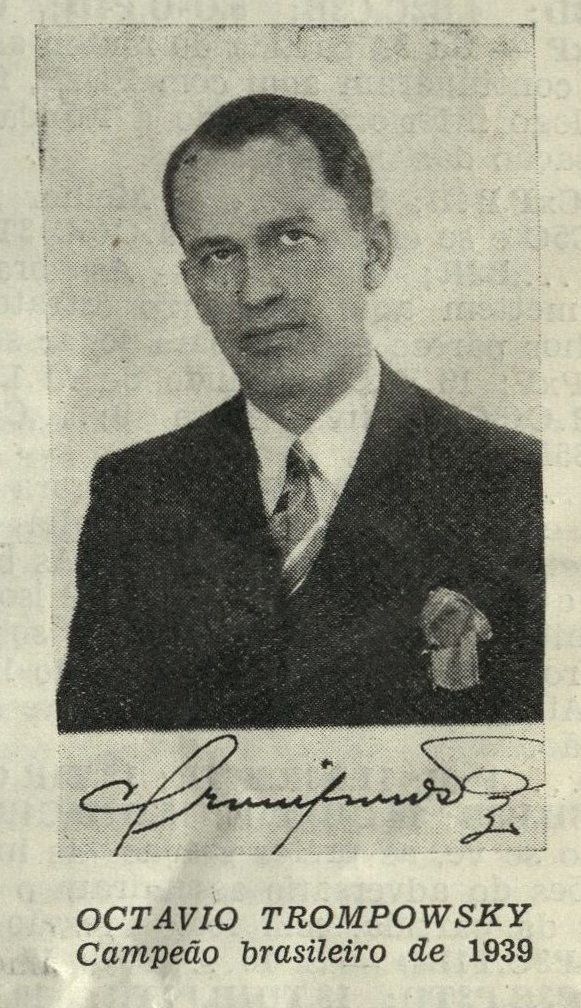
Our correspondent also mentions a photograph of Alekhine on page 83 of the June-July 1939 issue of the Brazilian magazine:
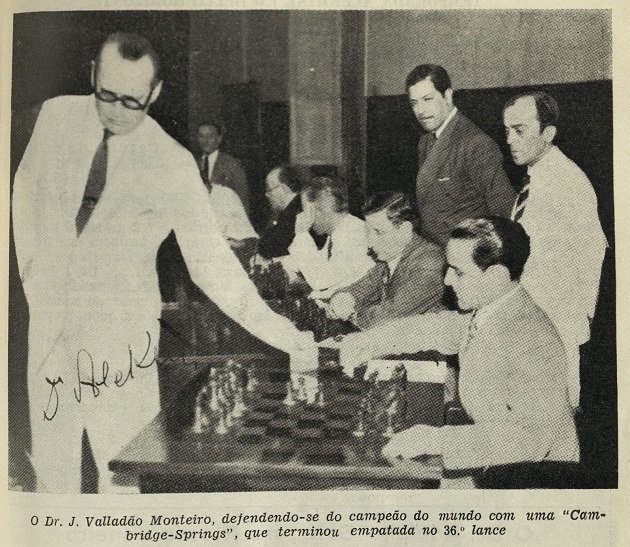
The above are the best-quality scans that we are able to show, with the assistance of the Cleveland Public Library.
Regarding Alekhine v Joaquim Valladão Monteiro, see C.N. 3270 above.
(10768)
Alekhine gained the title ‘chess champion of Europe’ by winning the Munich, 1942 tournament. From page 134 of the report in the October 1942 Deutsche Schachzeitung:
‘Das Turnier um die Europäische Meisterschaft ist ausgegangen, wie man es erwartet hat: Aljechin hat neben dem Weltmeistertitel nun auch die Europäische Meisterschaft heimführen können.’
The creation of that title is well documented in the Deutsche Schachzeitung and Deutsche Schachblätter of 1942, but what can be said about a claim that Alekhine had acquired a similar title in the 1920s? Below is a comment by Edgard Colle in a report on Hastings, 1925-26 on page 9 of the January 1926 issue of L’Echiquier:
‘Il est clair qu’avant le commencement du tournoi, la victoire d’Alekhine ne faisait aucun doute – tout au plus pouvait-on se demander si le sympathique champion d’Europe accorderait une ou deux nullités à ses adversaires, parmi lesquels seul le Dr. Vidmar était de taille à l’inquiéter.’
(10772)
Despite its innocuous title, the editorial below (L’Echiquier, December 1927, pages 783-784) delivers a message which may be summarized as ‘good riddance to Capablanca’:
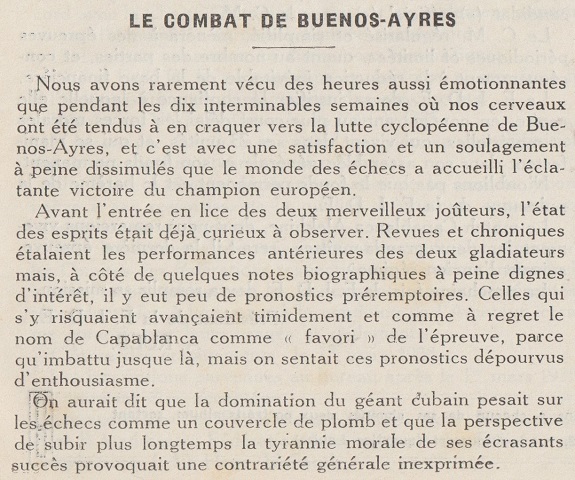
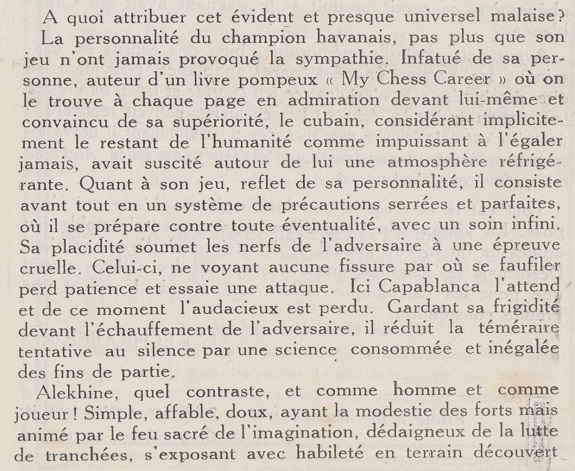
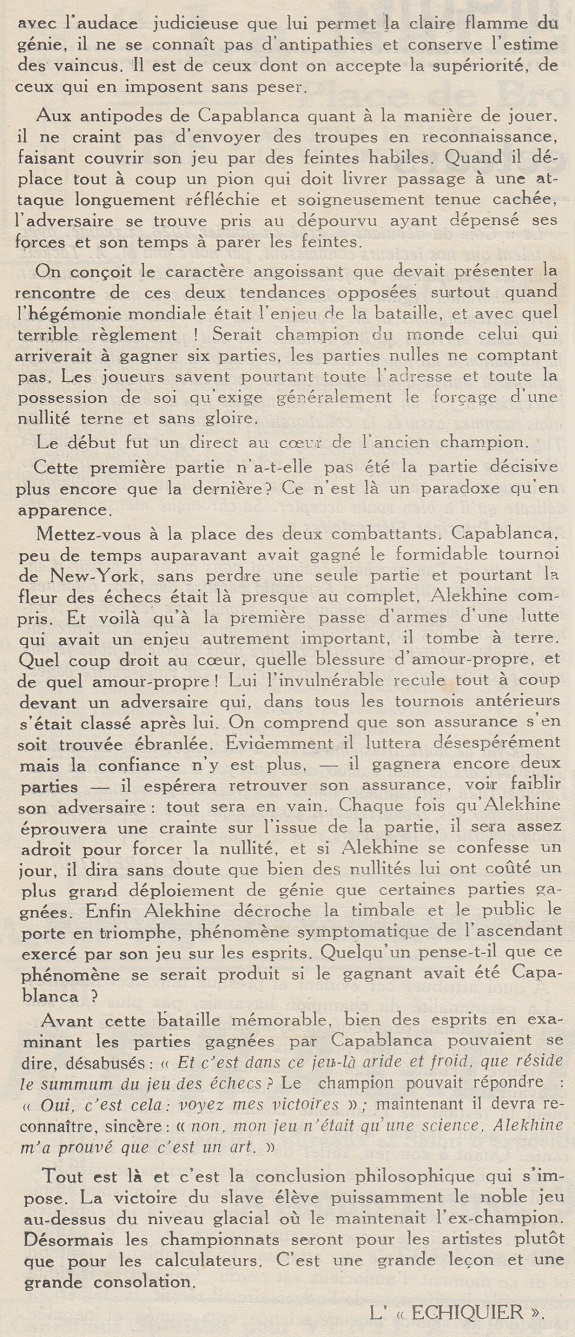
(10810)
As a contrast to the editorial reproduced in C.N. 10810, below is an article by C.S. Howell on pages 194-196 of the December 1927 American Chess Bulletin:
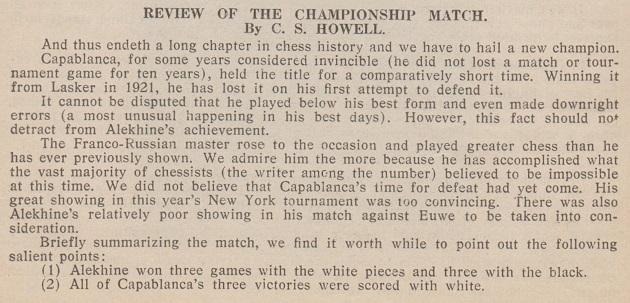
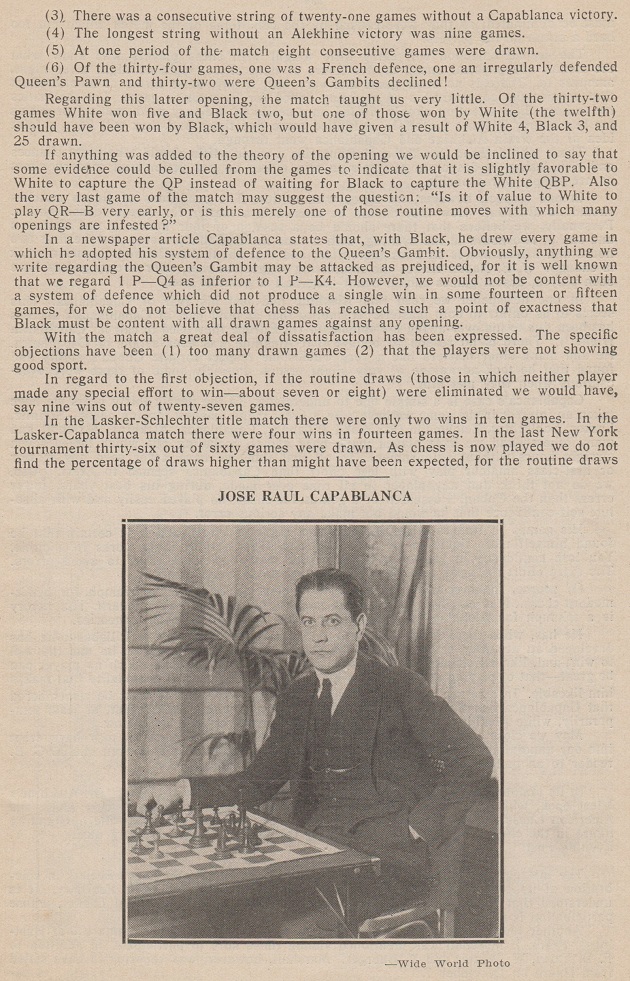
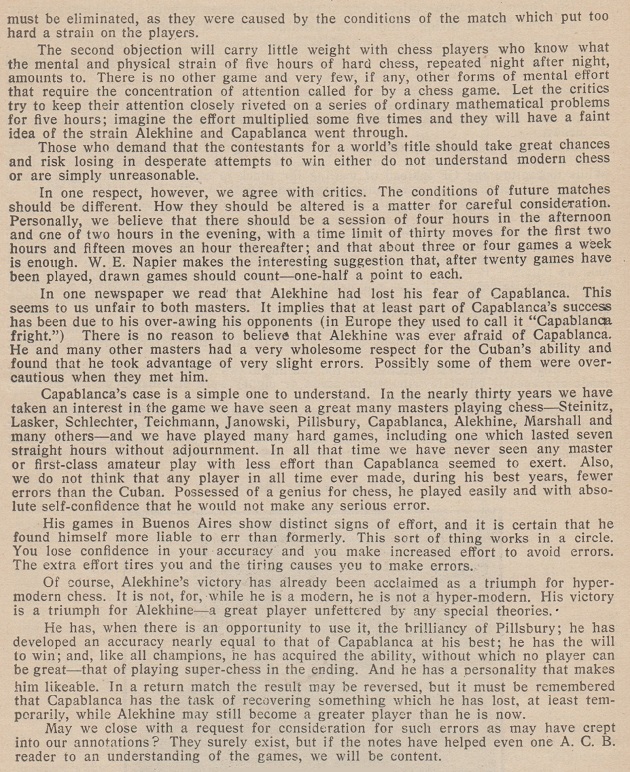
(10822)
In C.N. 7290 Christian Sánchez pointed out an interview with Alekhine by Carlos M. Portela on page 8 of the magazine Caras y Caretas, 4 September 1926, which was accompanied by a photograph of Alekhine playing the piano.
Eduardo Bauzá Mercére now provides this fine version, from Argentina’s Archivo General de la Nación, courtesy of the Ministerio del Interior, Obras Públicas y Vivienda (reference AR_AGN_DDF/Consulta_INV: 61876):
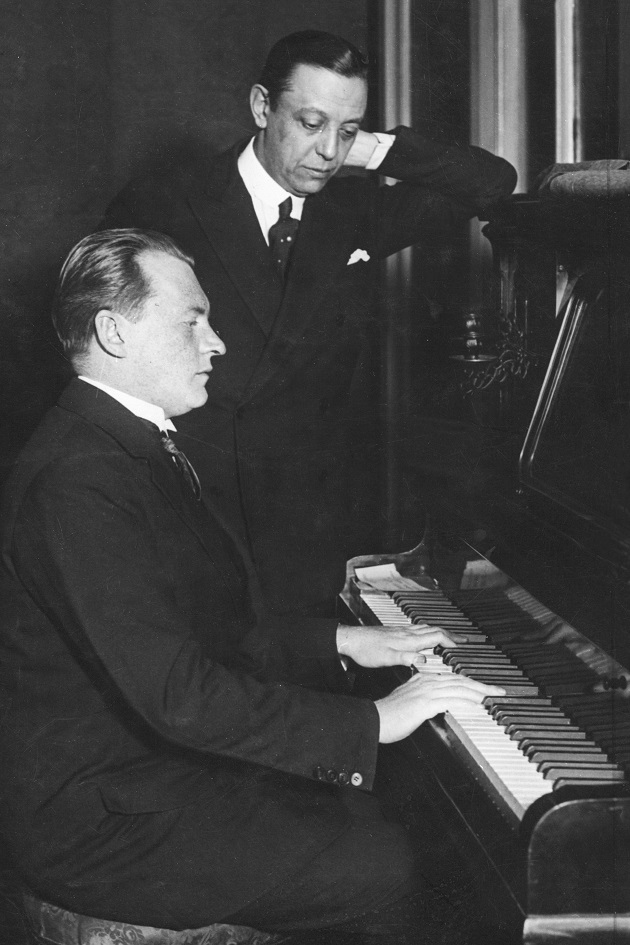
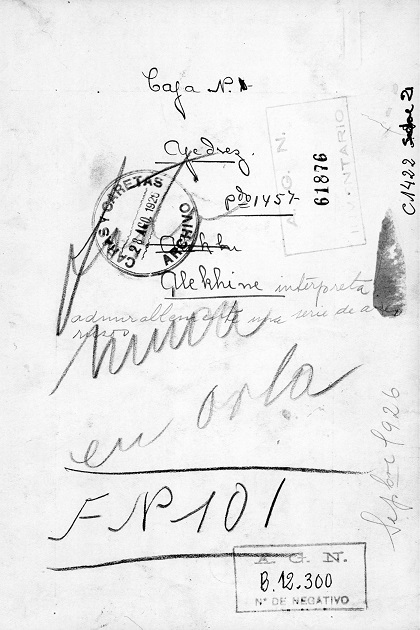
(10842)
See also Chess and Music.
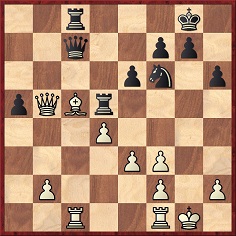
Black not to move
This position was discussed by Al Horowitz on pages 112-113 of How To Win in the Middle Game of Chess (New York, 1955), in the section about perpetual check:
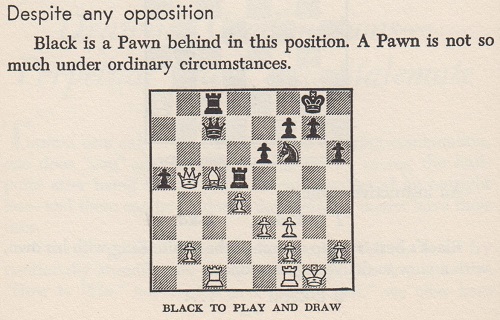
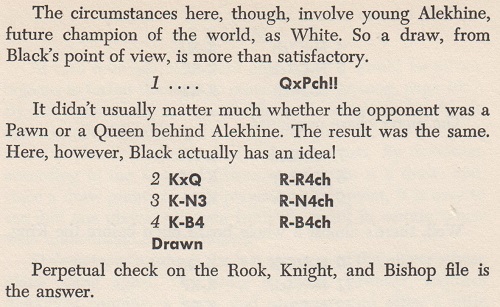
The text had previously appeared in an article by Horowitz on pages 87-89 of Chess Review, March 1954.
The play by ‘young Alekhine’ occurred when he was 30, against Teichmann at Carlsbad, 1923. The game was drawn, though later on and not by perpetual check; Teichmann could not sacrifice his queen in the diagrammed position because it was White’s move. Alekhine played 27 f4.
The situation after 26...Rd8-d5 was discussed on page 118 of the tournament book:
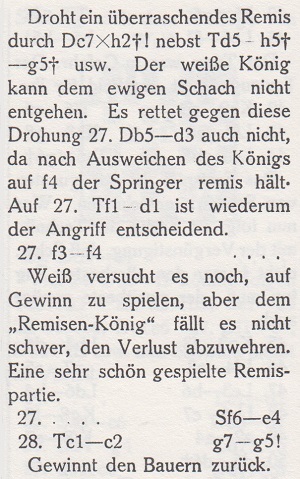
The complete game: 1 d4 d5 2 c4 e6 3 Nf3 Nf6 4 Nc3 Be7 5 Bg5 Nbd7 6 e3 O-O 7 Rc1 c6 8 Qc2 Re8 9 Bd3 h6 10 Bf4 dxc4 11 Bxc4 b5 12 Bd3 a6 13 a4 Bb7 14 O-O Rc8 15 Qb3 Qb6 16 Ne5 Red8 17 Ng6 Bf8 18 Nxf8 Nxf8 19 Ne4 Nxe4 20 Bxe4 Nd7 21 Bd6 Nf6 22 Bc5 Qc7 23 Bf3 a5 24 axb5 cxb5 25 Qxb5 Bxf3 26 gxf3 Rd5 27 f4 Ne4 28 Rc2 g5 29 f3 Nxc5 30 Rfc1 Rb8 31 Qe2 gxf4 32 dxc5 fxe3 33 Qxe3 Rg5+ 34 Kh1 Qc6 35 Rg1 Rxg1+ 36 Kxg1 Qd5 37 Rd2 Qf5 38 Rg2+ Kh7 39 Qe4 Qxe4 40 fxe4 Rc8 41 Rc2 Kg6 42 Kf2 Kf6 43 Ke3 Ke5 44 Kd3 f6 45 Rc4 f5 Drawn.
The opening was examined by Alekhine in his first Best Games book, in the annotations to his brilliancy-prize victory over Rubinstein in the first round of the same tournament.
(10867)
Pedro Jesús Ferrer Sánchez (Huércal de Almería, Spain) sends a page (unnumbered) from Viaje por el tiempo de Almería by José María Artero (Almería, 1975):
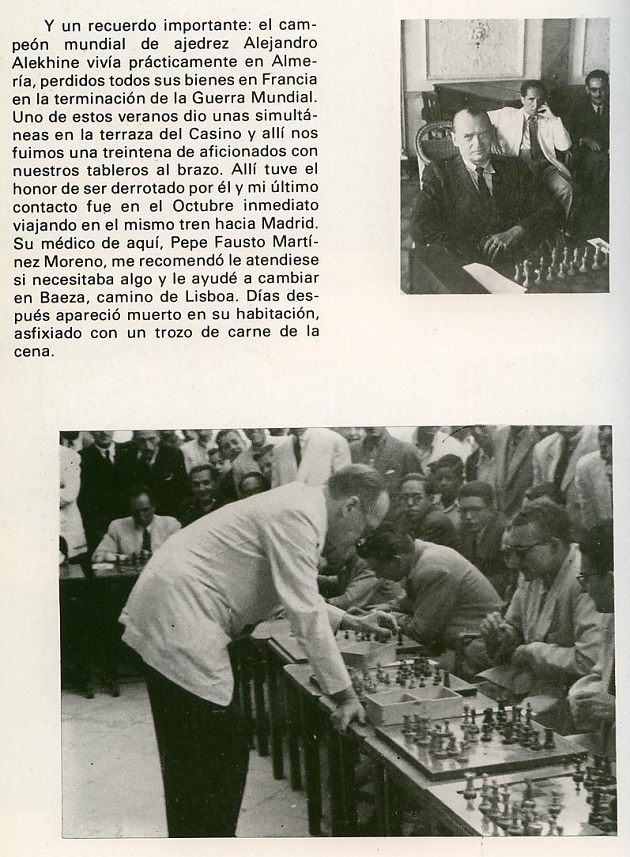
The page is shown here with the permission of the author’s family. Our correspondent adds that the first picture was taken in the Círculo Mercantil, Almería. The person immediately behind Alekhine is Francisco López Núñez, who won the Almería tournament (21-29 August 1945) jointly with the world champion. The second photograph shows a simultaneous display by Alekhine on the terrace of the Almería Casino on 30 August 1945. He is at the board of Artero García.
(10901)
Gerard Killoran notes a series of chess-related photographs at the Arkivkopia website. In particular, there is a magnificent portrait of Alekhine.
(10916)
‘Alekhine is no believer in book knowledge, and prefers to adopt lines of his own.’
Source: BCM, October 1922, page 391, in a review of the London, 1922 tournament.
(10961)
From page 16 of the San Francisco Chronicle, 28 February 1924:
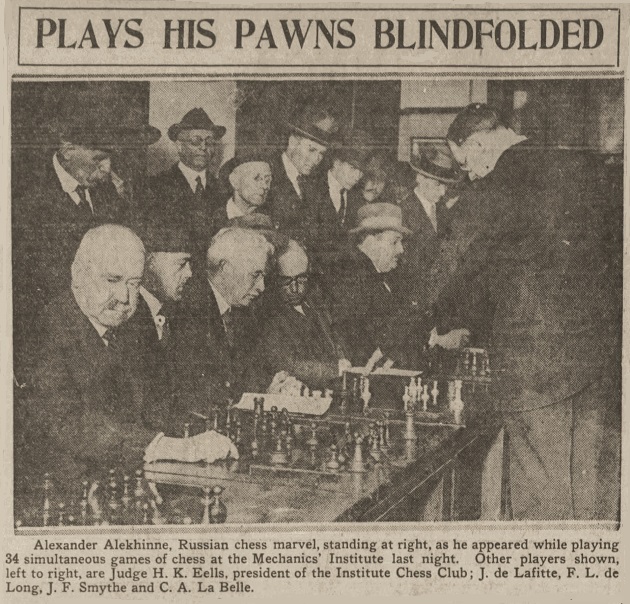
The reference to ‘blindfolded’ in the heading is not to be taken literally. Regarding the number of games played, a chart of Alekhine’s exhibitions in Canada and the United States from November 1923 to April 1924 on page 154 of the July-August 1924 American Chess Bulletin specified 32 (+24 –3 =5), figures also given on pages 217 and 771 of the Skinner/Verhoeven volume on Alekhine. The full chart was reproduced on page 3 of Alekhine in the Americas by J. Donaldson, N. Minev and Y. Seirawan (Seattle, 1992).
A curiosity about Alekhine and Neo-Chess from page 7 of the San Francisco Examiner, 29 February 1924:
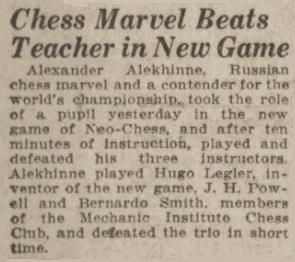
(10998)
The Dover reprint of the New York, 1924 tournament book included a few post-1924 photographs, including this one:
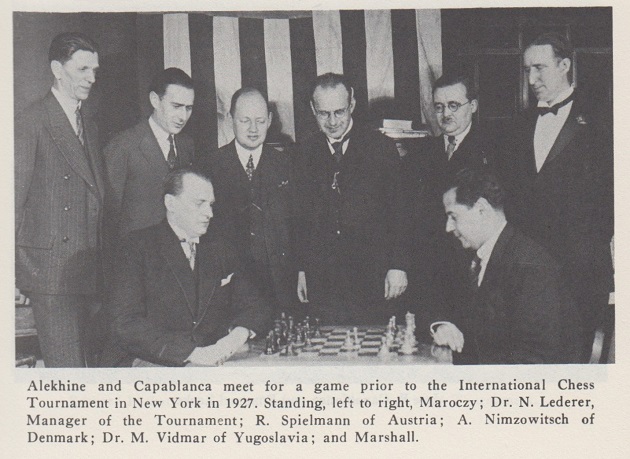
The phrase ‘meet for a game’ appears to be captionese, but is any more information available regarding the occasion?
(11021)
An unfathomable claim about FIDE [‘before the death of Alekhine in 1946’] on pages 288-289 of Who Was The Strongest? by Raymond Keene, Nathan Divinsky and Jeff Sonas (Aylesbeare, 2006):
‘Three years later [in 1993] Kasparov annihilated Nigel Short in a match that was held outside the auspices of FIDE, the World Chess Federation, which had shown itself increasingly incompetent to handle events at the highest level. FIDE soldiered gamely on with its own championship, much as it did before the death of Alekhine in 1946, but FIDE always had to make do without the world’s top two players at any given time.’
(11169)
‘Some of Marshall’s most sparkling moves look at first like typographical errors.’
This well-known remark is listed in The Chess Wit and Wisdom of W.E. Napier.
On page 194 of Great Brilliancy Prize Games of the Chess Masters (New York, 1961) Fred Reinfeld wrote:
‘Some of Alekhine’s best combinations are so startlingly original that they give the impression of being oversights. In this regard, 20 P-K4! is one of his most striking moves.’
The game was Alekhine v Alexander, Nottingham, 1936:
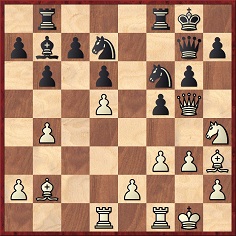
On page 196 Reinfeld commented regarding 20 e4:
‘This sly move looks like a blunder, as Black can now win a pawn.’
The game continued 20...Nxe4 21 Qc1 Nef6 22 Bxf5, and Black resigned at move 27.
(11171)
The start of an article about Alekhine on pages 41-43 of Chess Problems, Play and Personalities by Barry Martin (Beddington, 2018):
‘... his father was a landowner, a Marshal of Nobility, and a member of the Russian Duma. His mother was an heiress to an industrial fortune. Alekhine became addicted to the game of chess at the age of 11 ...’
This brings to mind page 5 of The Oxford Companion to Chess by D. Hooper and K. Whyld (Oxford, 1984):
‘His father was a landowner, a Marshal of Nobility, and a member of the Duma, his mother heiress of an industrial fortune. ... Alexander became addicted to the game at the age of about 11 ...’
(11186)
Eduardo Bauzá Mercére has forwarded some photographs which he took on 30 January 2019 at the Club Argentino de Ajedrez, Paraguay 1858, Ciudad Autónoma de Buenos Aires, 1120, Argentina. In the shot below, the Club’s display of the board and pieces used for the 1927 world championship match is intended to show the final position in the decisive 34th match-game, after 82 Re7:
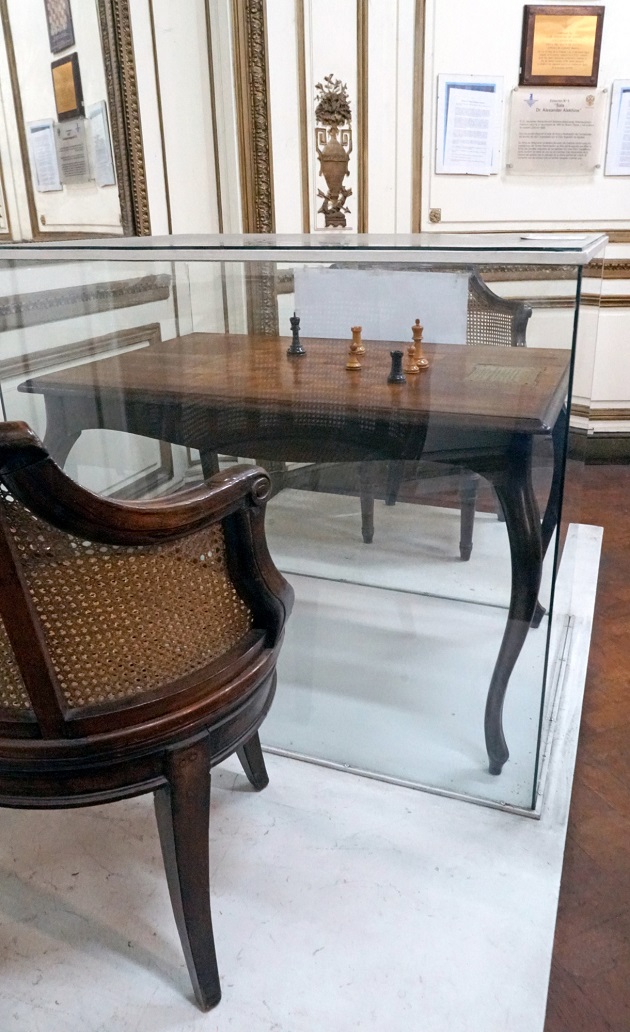
Mr Bauzá Mercére notes that the black rook is on h2, and not h1 as in the game.
We add page 4 of the Argentine newspaper Crítica, 29 November 1927:
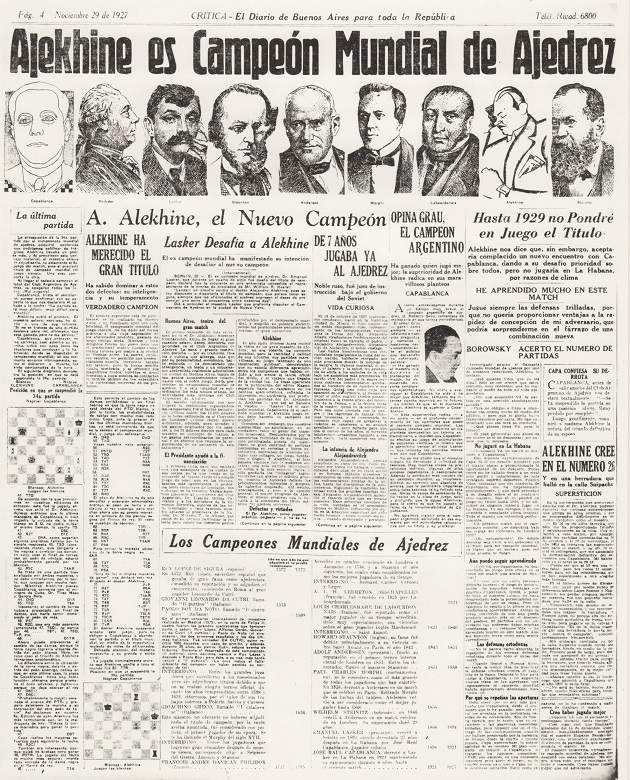
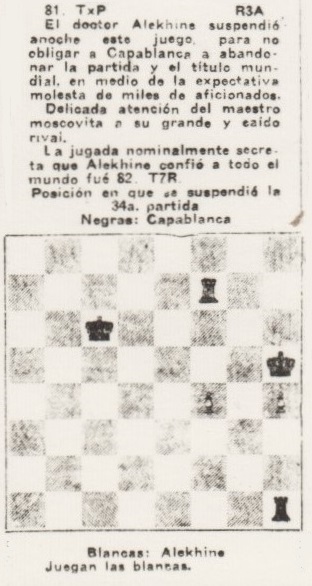
(11219)
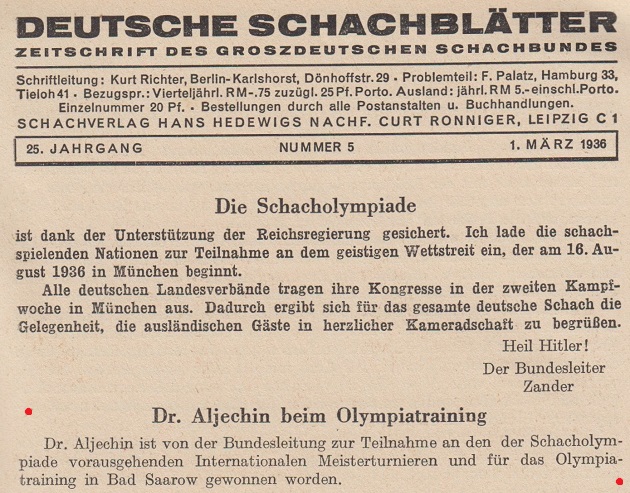
Page 65 of Deutsche Schachblätter, 1 March 1936
Another snippet, from page 38 of the March 1936 Schweizerische Schachzeitung:

Of course, no international tournament was held in Wiesbaden. For further information about Alekhine’s involvement in the training programme for German participants in the 1936 Olympiad, see page 560 of the Skinner/Verhoeven monograph on him.
The former world champion did not play in the Olympiad, but his country, France, did. It came second from bottom out of 21 teams.
(11236)
Alekhine made some notable comments about chess psychology, including a reference to Lasker, on page 150 of his book Das New Yorker Schachturnier 1927 (Berlin, 1928):
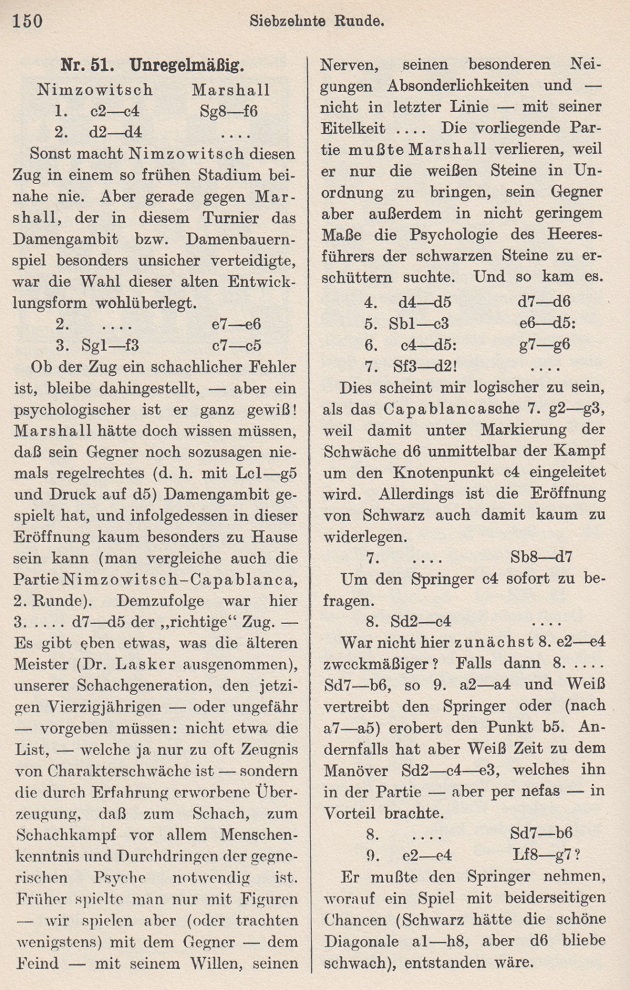
(11239)
See Chess and Psychology.
Eduardo Bauzá Mercére provides some further photographs taken by him at the Club Argentino de Ajedrez, Buenos Aires, on 25 March 2019:
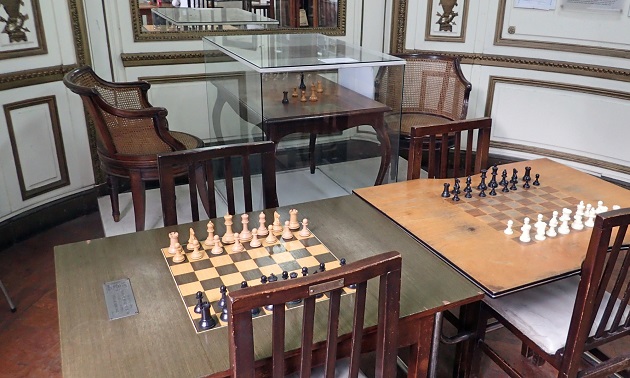
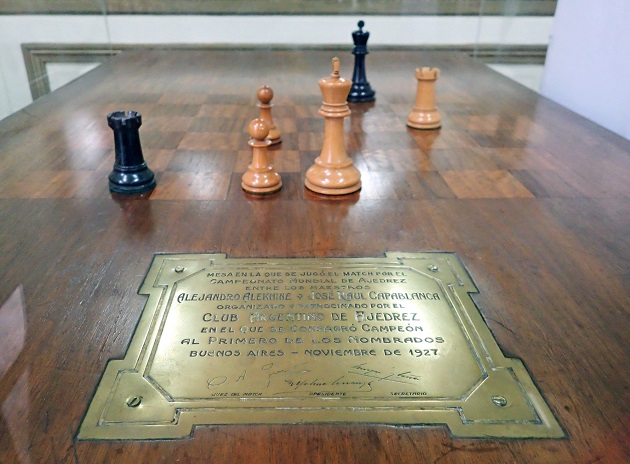
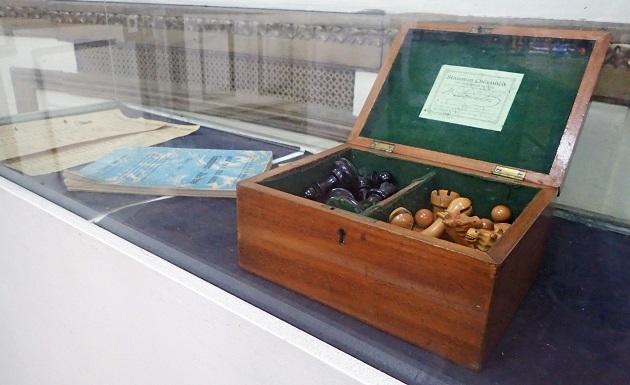
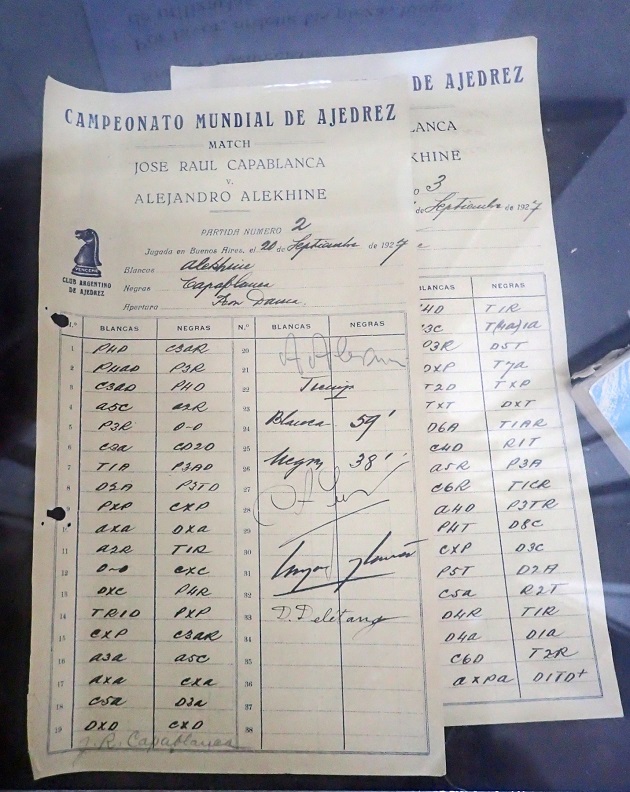
(11278)
Alekhine annotated his loss to Euwe in the 25th match-game of their world title contest on pages 224-226 of CHESS, 14 February 1936, with this introduction:
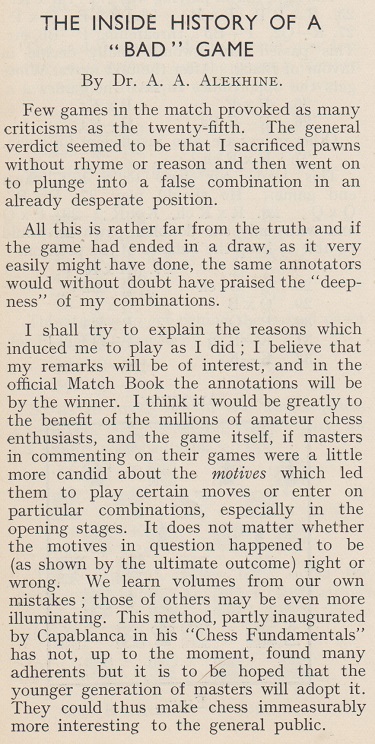
The final two paragraphs of the article, which was dated 3 February 1936:
‘A master should never trust the analysis of others without careful verification; nor should a player allow himself to be over-influenced by the state of the score in a contest, whether it be a match or a tournament, but should try instead only to solve the problem of the position before him.
Advice far more easy to give than to take!’
(11280)
From page 9 of the Illustrierte Kronen Zeitung, 15 November 1927:
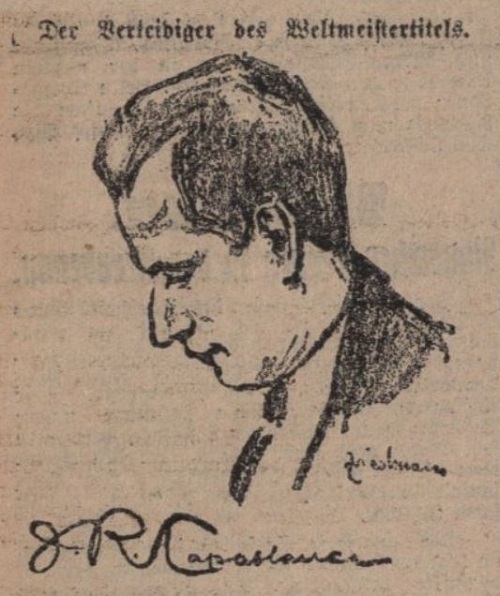
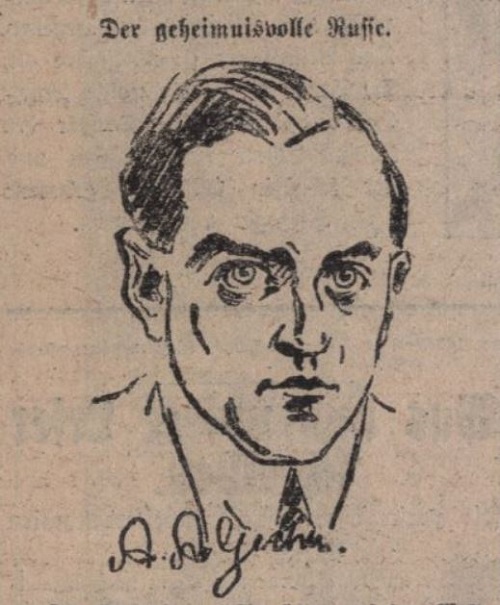
Afterword on 10 November 2020: Miriam Friedman Morris (Pomona, NY, USA) adds that the sketches were by her father, David Friedmann (1893-1980), whose work was also shown in C.N.s 3510, 4125 and 4132.
(11297)
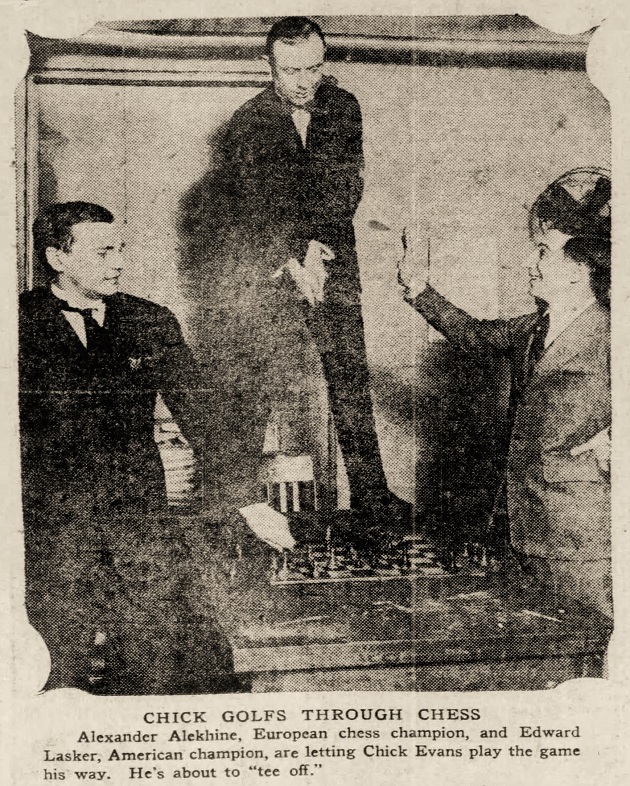
Philadelphia Inquirer, 9 February 1924, page 15
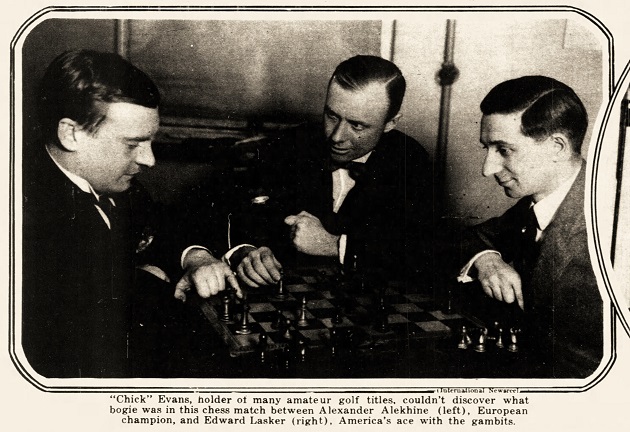
(11301)
A ‘tidied up’ version of the photograph on page 2 of the Pictorial News section of the Courier-Journal, 24 February 1924:
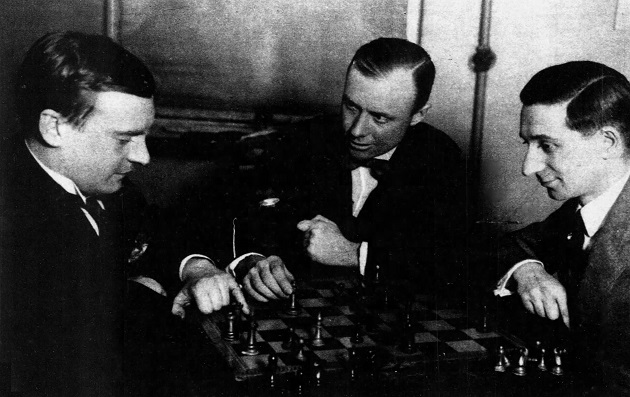
Alexander Alekhine, Chick Evans, Edward Lasker
(11306)
From page 224 of Combinations The Heart of Chess by Irving Chernev (New York, 1960):
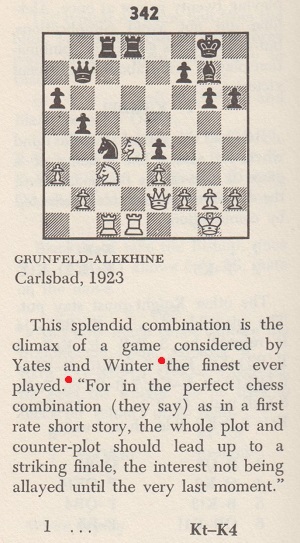
A more extensive quote attributed to F.D. Yates and W. Winter had been given by Chernev on the inside front cover of Chess Review, February 1954:
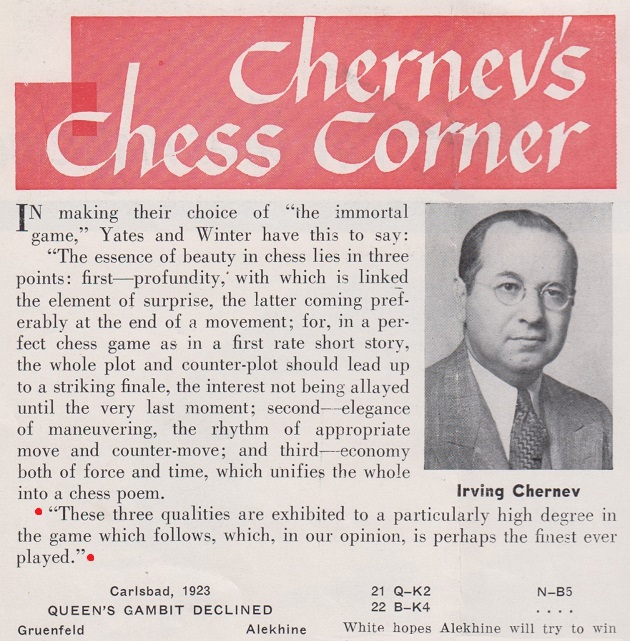
Similarly, from page 268 of Chernev’s The Golden Dozen (Oxford, 1976):
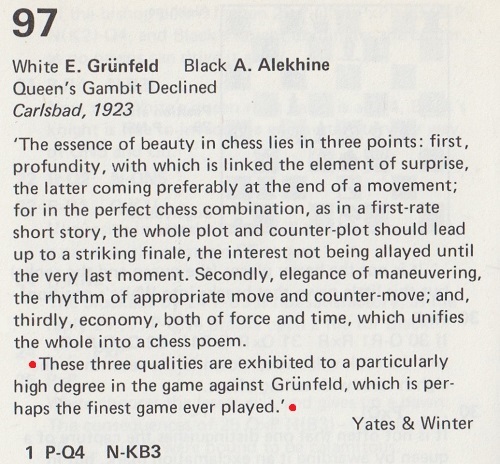
The discrepancy between ‘the finest’ and ‘perhaps the finest’ prompts verification of what F.D. Yates and W. Winter actually wrote.
In their book Modern Master-Play (London, 1929) the bulk of the text quoted by Chernev appeared on page 17, in the Alekhine section:
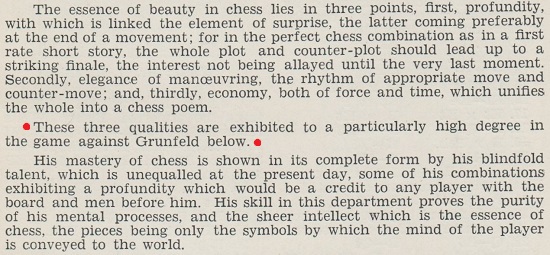
However, there is no ‘perhaps the finest game’ reference. Nor do such words occur on pages 18-19, where the game was annotated:
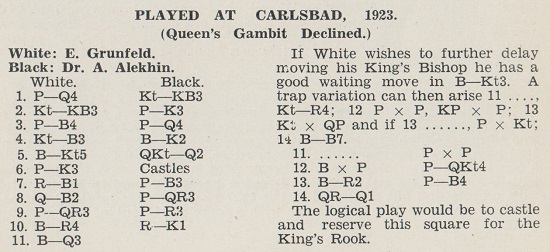
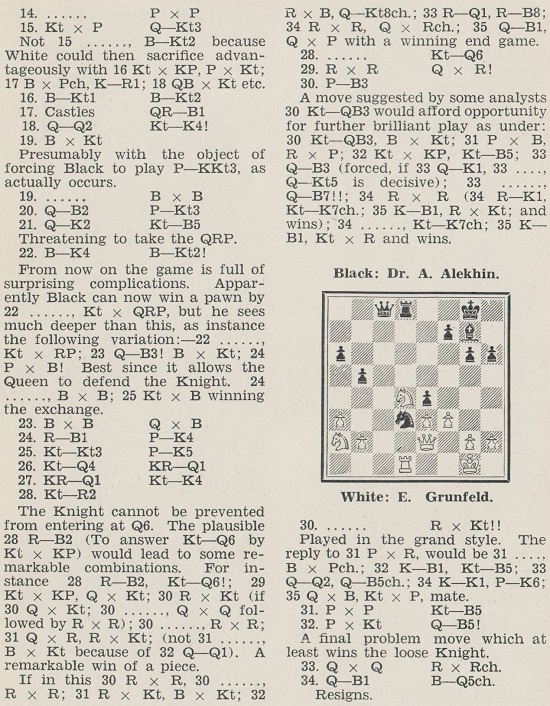
It is necessary to turn to page 6, in the Foreword, where the book’s publisher, W.H. Watts, gave the words second-hand:

(11376)
Noting that the Argentinian weekly magazine Caras y Caretas is available via the digital collection of the Biblioteca Nacional de España, Olimpiu G. Urcan has forwarded these items:
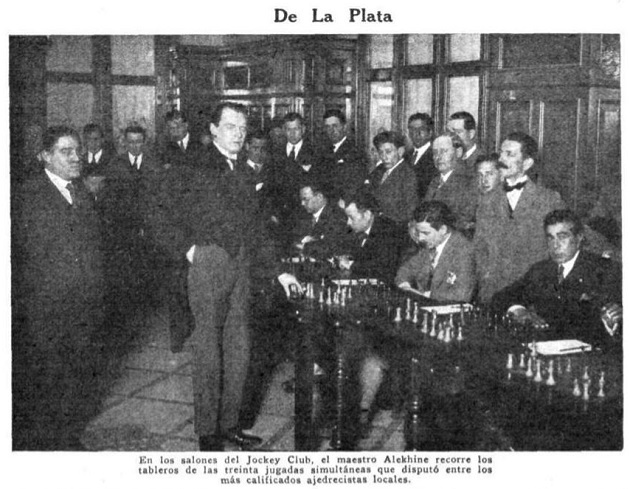
13 November 1926
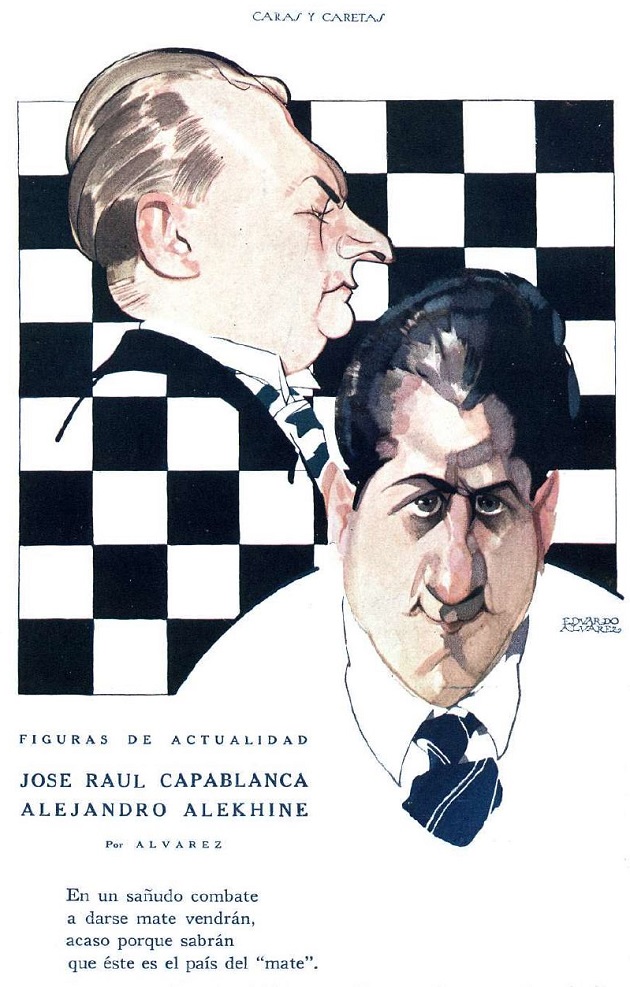
16 April 1927
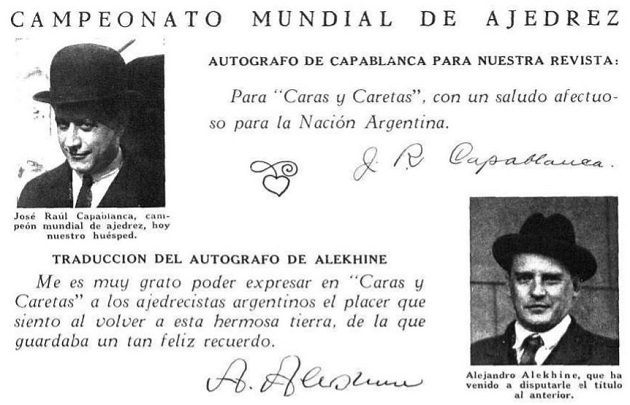
17 September 1927
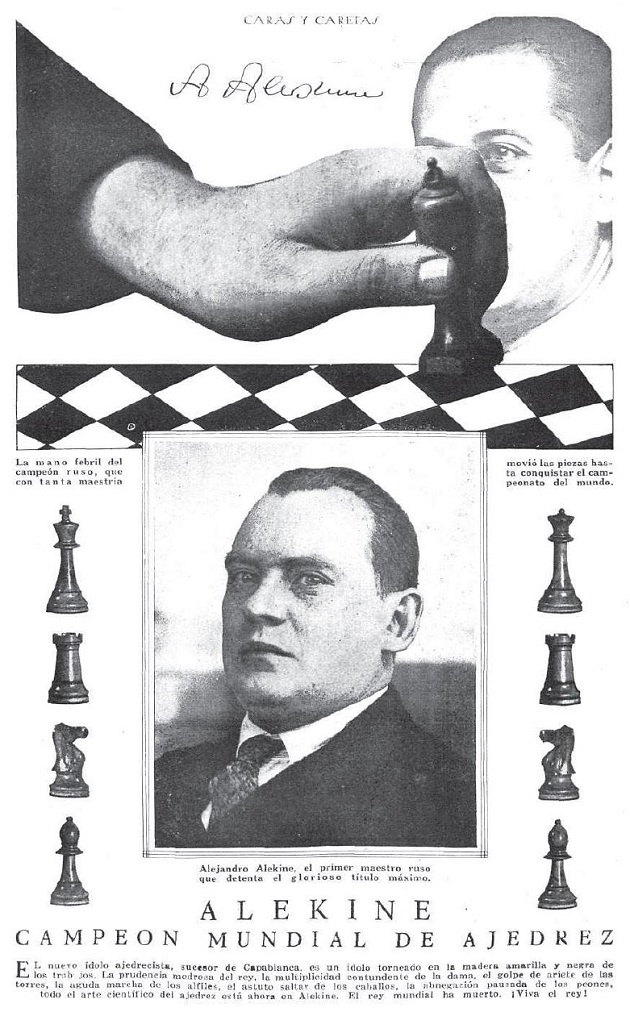
10 December 1927
Page numbers are not indicated in the material presented online by the Library. Although the interview with Capablanca conducted by Ernesto E. de la Fuente (17 September 1927) was hurried and contains evident factual errors (about his chess beginnings and the Cleveland simultaneous display), Capablanca’s remarks on Alekhine and on training/preparation/intuition are noteworthy.
(11318)
C.N. 11266 showed this photograph of Capablanca and Kostić from Carteles, August 1919, page 59:
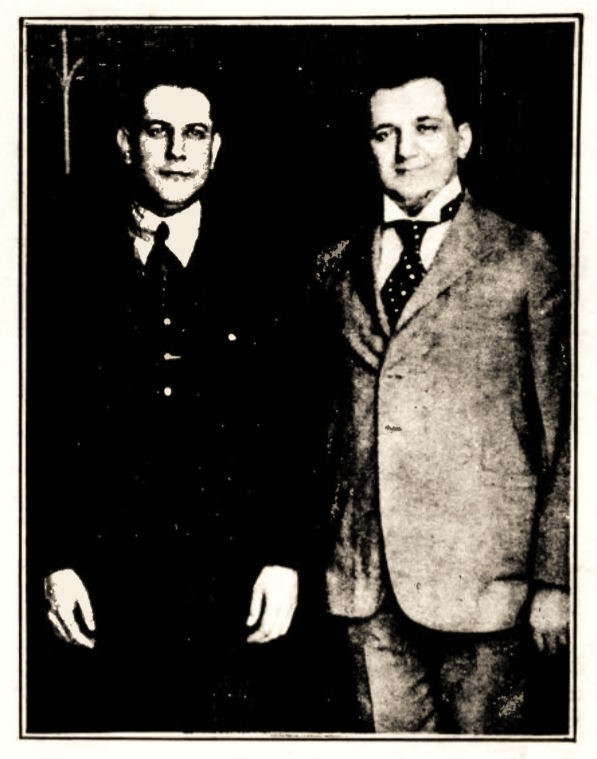
Yandy Rojas Barrios (Cárdenas, Cuba) notes a case of misidentification on page 154 of Bohemia, 15 November 1953, where Capablanca was said to be with ‘Alhekine’ in 1927:
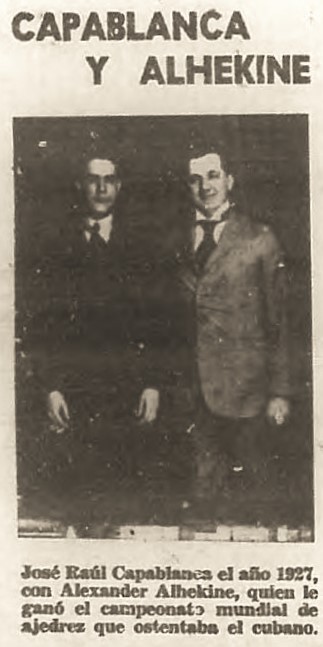
(11690)
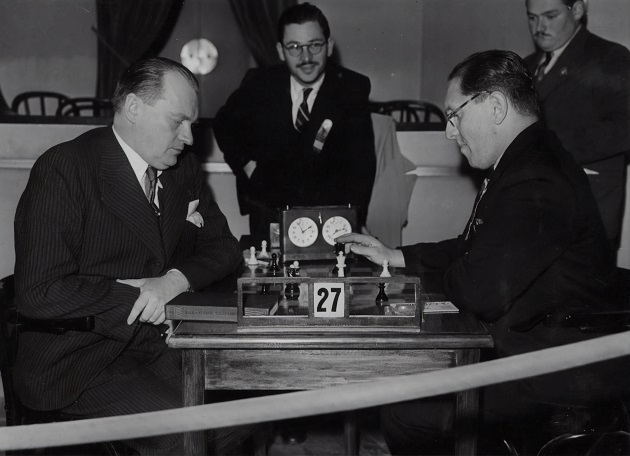
This photograph (reference AR_AGN_DDF/Consulta_INV: 135060) comes from Argentina’s Archivo General de la Nación, courtesy of the Ministerio del Interior, Obras Públicas y Vivienda. The reverse:
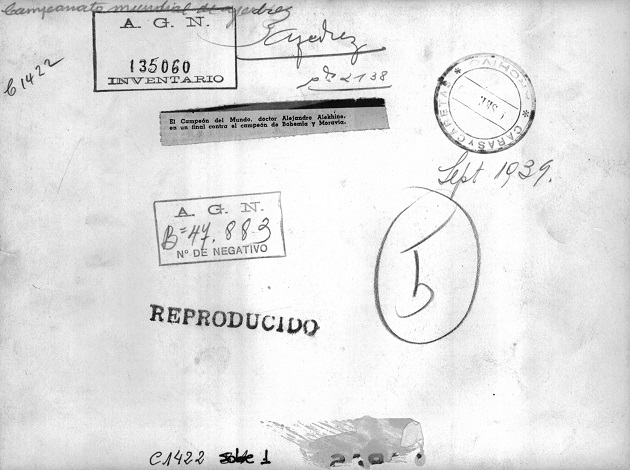
The statement that Alekhine’s opponent was ‘el campeón de Bohemia y Moravia’ (Karel Opocenský) is incorrect. It was Moshe Czerniak, and the first two letters of his surname are visible in front of him.
The book at Alekhine’s side is the second volume of Шахматный ежегодник by N. Grekov and I. Maizelis:

Our copy:

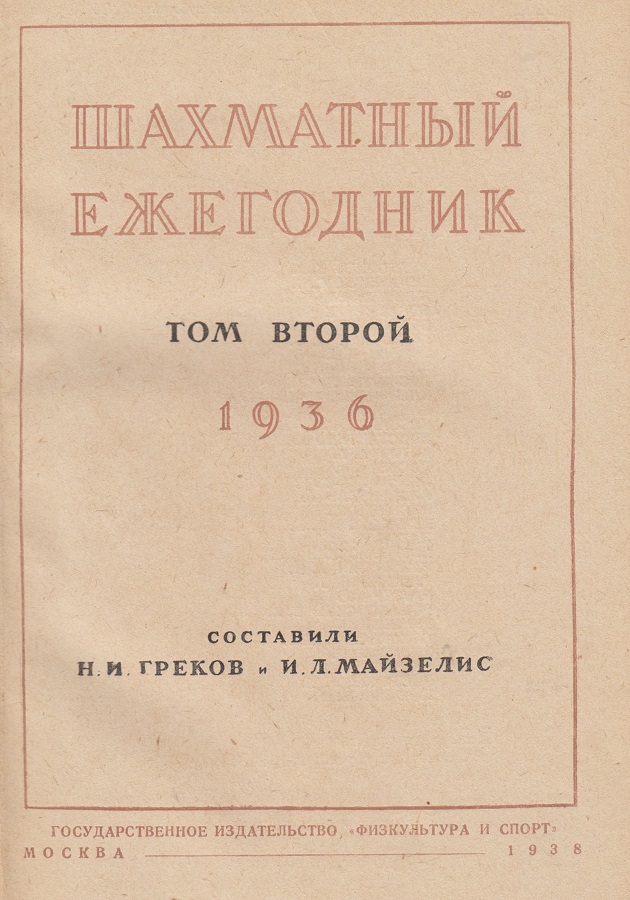
(11740)
Olimpiu G. Urcan provides another photograph (reference AR_AGN_DDF/Consulta_INV: 135394) from the Argentinian archive mentioned in the previous item:
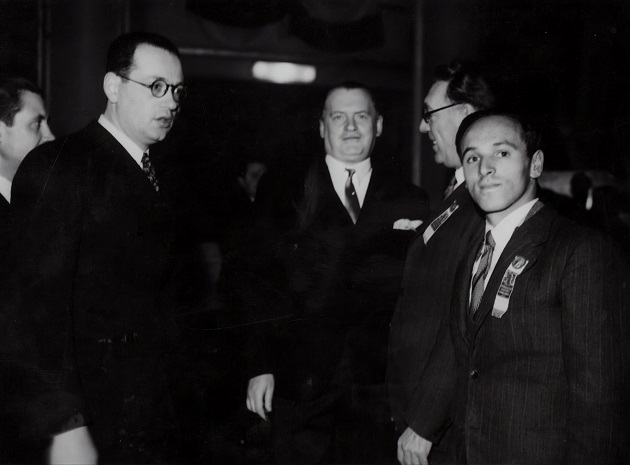
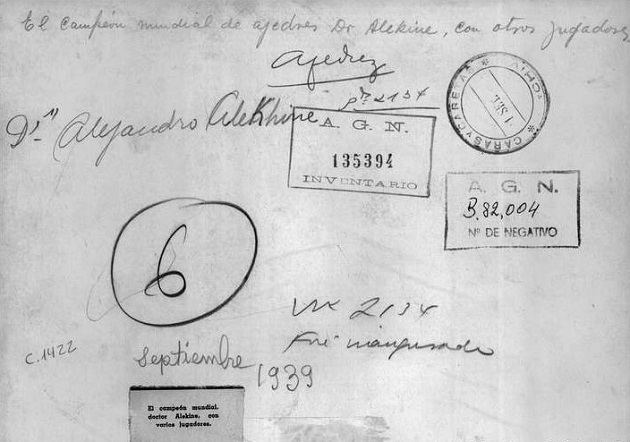
(11741)
Page 291 of Emanuel Lasker Denker Weltenbürger Schachweltmeister edited by Richard Forster, Stefan Hansen and Michael Negele (Berlin, 2009) has a shot featuring Nimzowitsch, Kmoch, Alekhine and Bogoljubow during the 1934 world championship match):
See A Series of Books on Lasker.
‘Played without board or men, this game should go down in history as one of the most remarkable games on record.’
David A. Mitchell made that remark on page 85 of his book Chess (Philadelphia, 1918):
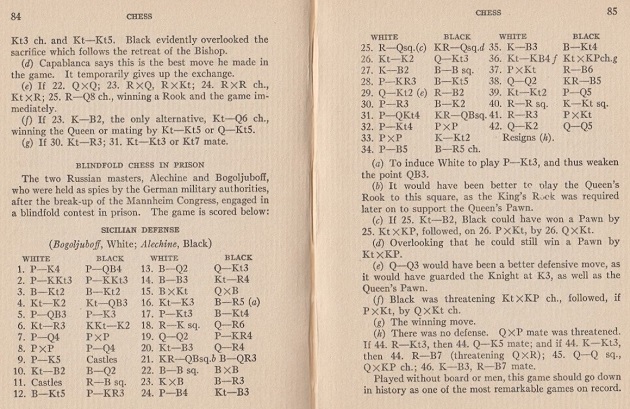
It is one of two such blindfold games in Rastatt on page 108 of the Skinner/Verhoeven book on Alekhine. The source specified (page 317 of Shakhmatny Vestnik, 1914) is shown below, courtesy of Vitaliy Yurchenko (Uhta, Russian Federation):
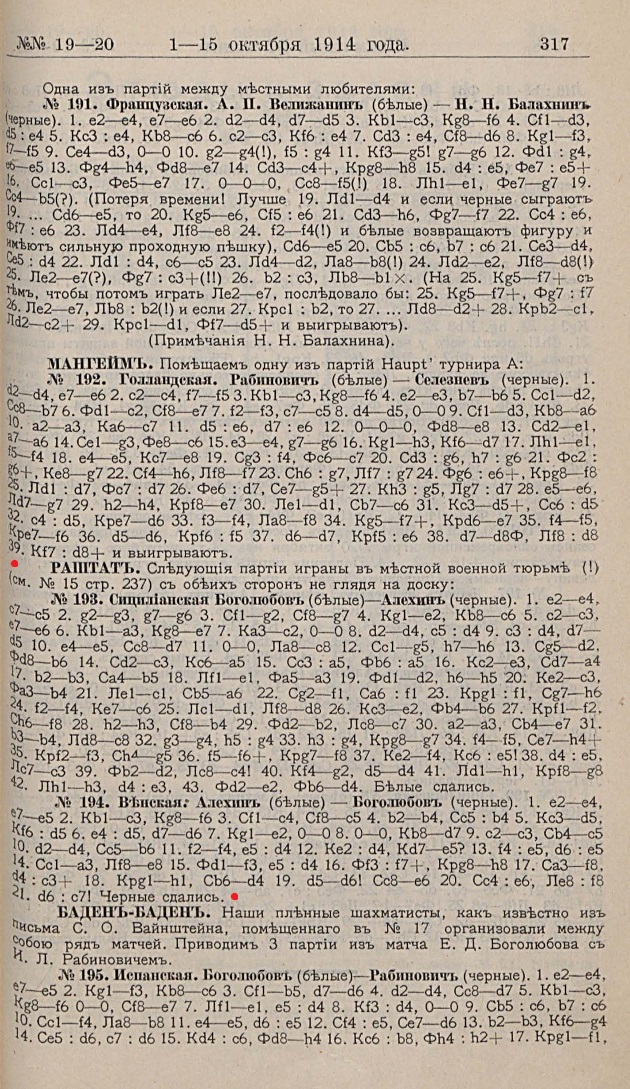
(11307)
Our feature article Réti v Tartakower, Vienna, 1910 refers to a number of games with the same motif, and a further addition, with the rarity of the (lucky) winner being Black, is shown now from page 4 of the Evening Star (Dunedin), 1 July 1933:
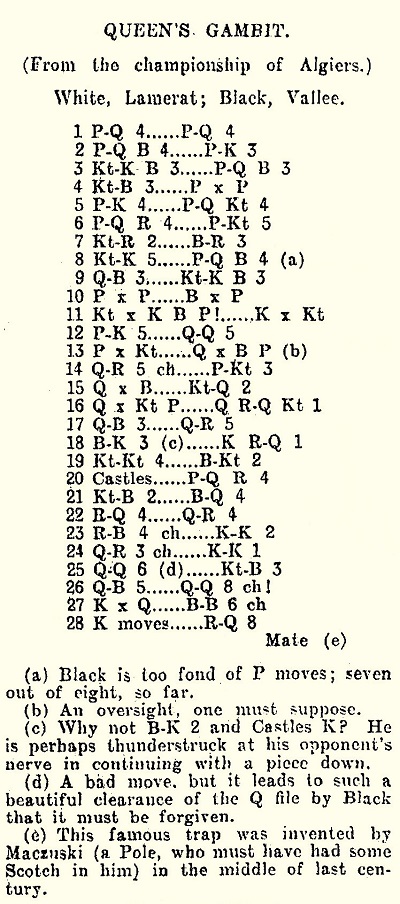
1 d4 d5 2 c4 e6 3 Nf3 c6 4 Nc3 dxc4 5 e4 b5 6 a4 b4 7 Na2 Ba6 8 Ne5 c5 9 Qf3 Nf6 10 dxc5 Bxc5 11 Nxf7 Kxf7 12 e5 Qd4 13 exf6 Qxf6 14 Qh5+ g6 15 Qxc5 Nd7 16 Qxb4 Rab8 17 Qc3 Qh4 18 Be3 Rhd8 19 Nb4 Bb7 20 O-O-O a5 21 Nc2 Bd5 22 Rd4 Qh5 23 Rf4+ Ke7 24 Qa3+ Ke8 25 Qd6 Nf6 26 Qc5
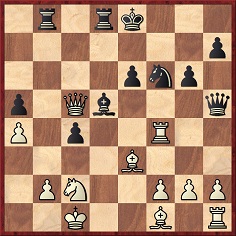
26...Qd1+ 27 Kxd1 Bf3+ 28 K moves Rd1 mate.
More information about the game and the players will be welcome.
A win by Alekhine against ‘Lamerat (champion of Algeria)’ is on page 485 of the October 1935 BCM:
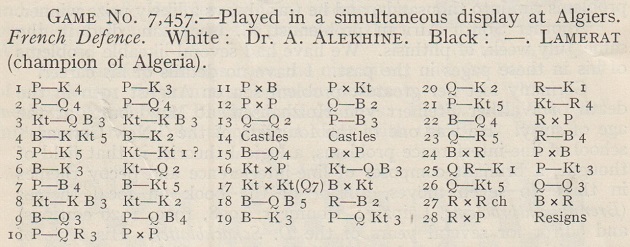
Page 513 of the Skinner/Verhoeven volume on Alekhine specified that the simultaneous exhibition took place in Algiers in December 1934.
In Jeremy Gaige’s Chess Personalia the only entry of potential relevance is for Léonce Lamérat, a problemist who had died in 1933. The Cleveland Public Library has forwarded the announcement of his death on page 258 [sic – Gaige gave ‘358’] of La Stratégie, November 1933:
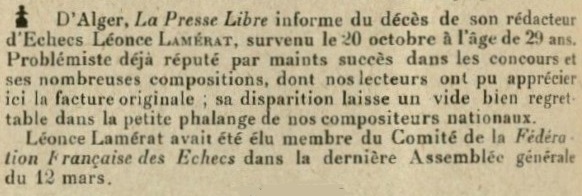
(11728)
Olimpiu G. Urcan has found this feature about Alekhine on an unnumbered page of the 8 December 1927 edition of the Argentinian magazine Atlántida:
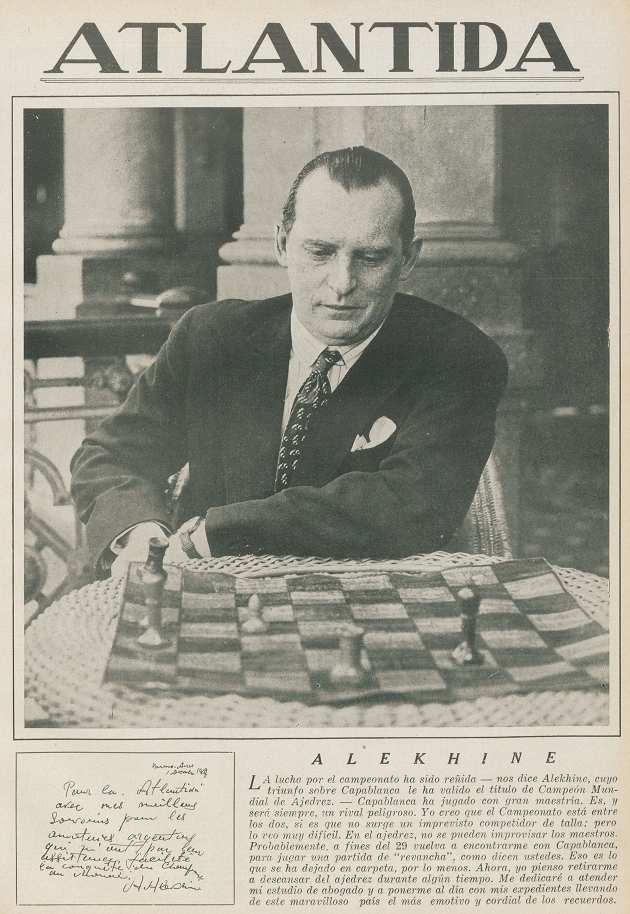
Our correspondent adds, further to C.N.s 11564 and 11599, a September 1927 picture of Alekhine’s hand (reference AR_AGN_DDF/Consulta_INV: 61887 from Argentina’s Archivo General de la Nación, courtesy of the Ministerio del Interior, Obras Públicas y Vivienda):
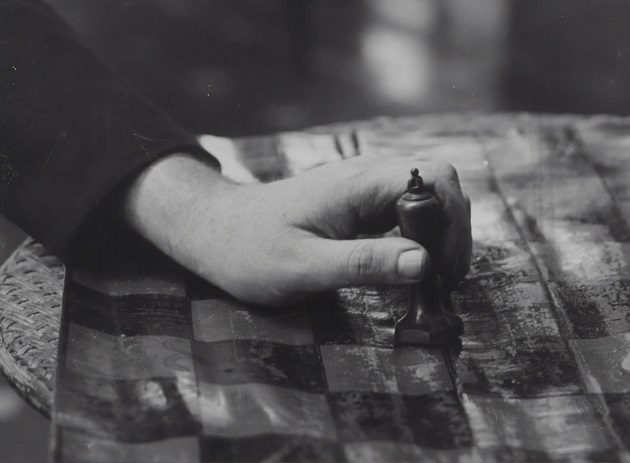
(11770)
Carlos León Cranbourne (Buenos Aires) has provided a third set of photographs, relating to Capablanca and Alekhine and including their 1927 world title match:
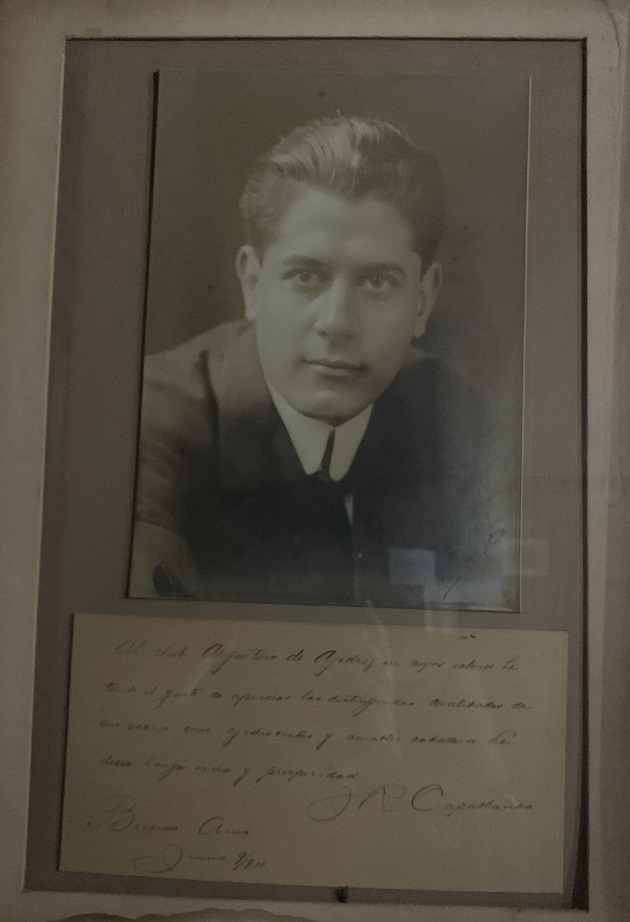
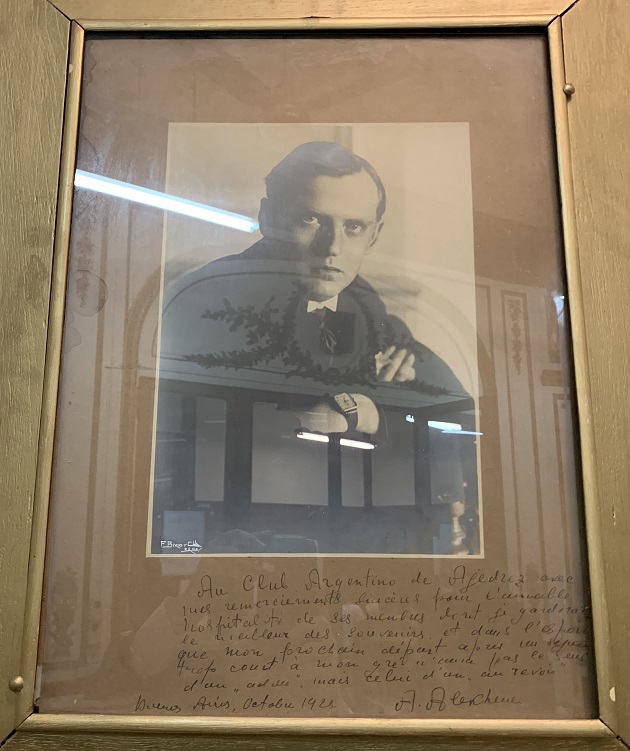
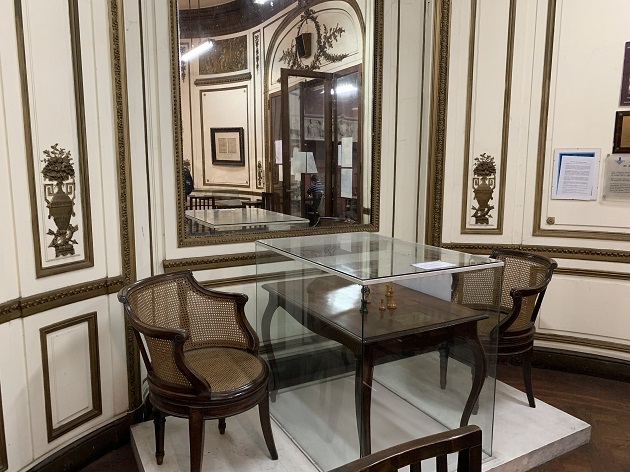
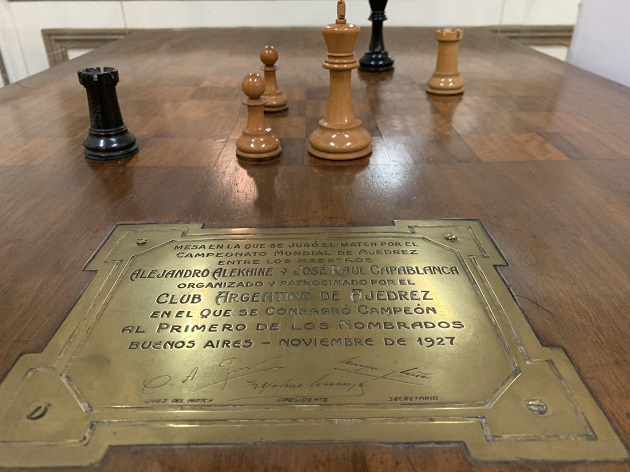
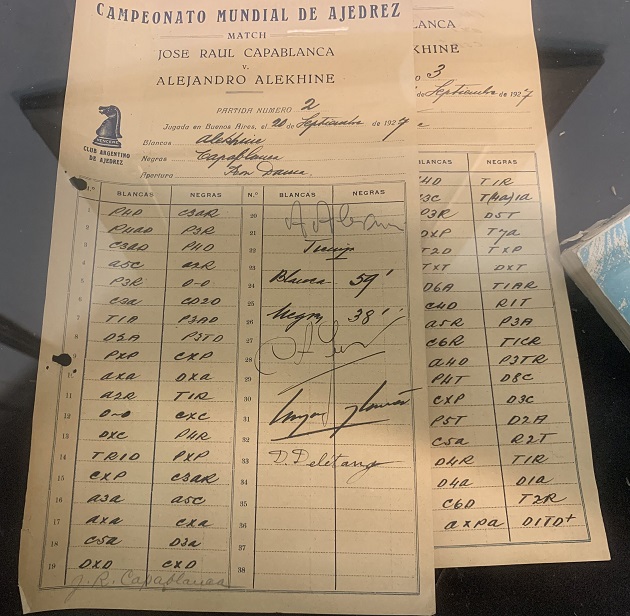
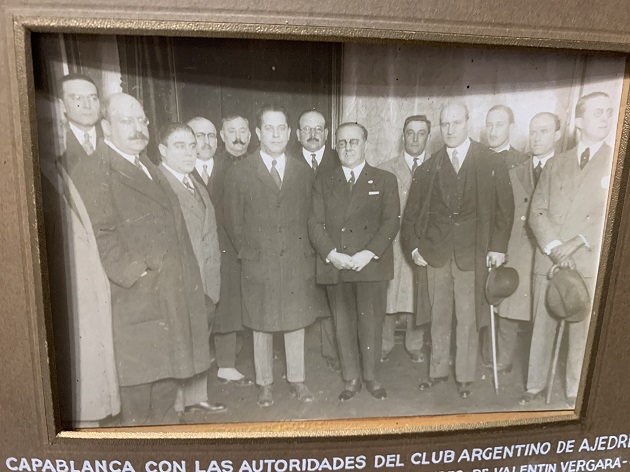
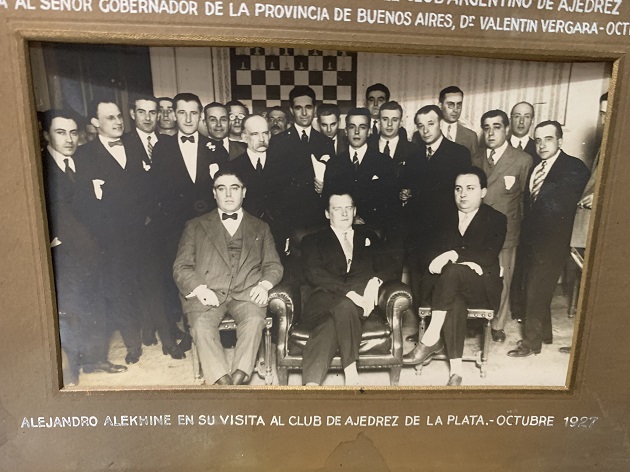
(11349)
David Prabitz (Graz, Austria) notes Vassily Smyslov’s slightly different accounts (i.e. with ‘father’ and ‘uncle’) of the first chess book that he was given as a child. Below are the Russian and English texts in three autobiographical works:
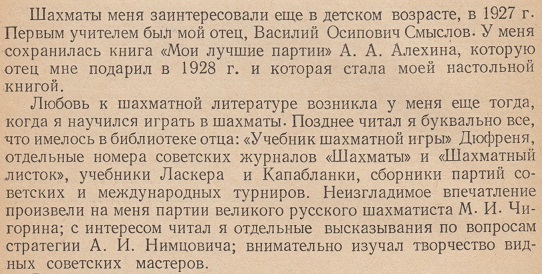
Избранные партии (Moscow, 1952), page 16
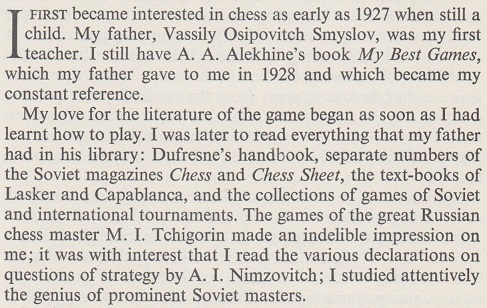
My Best Games of Chess 1935-1957 (London, 1958), page xxxiii
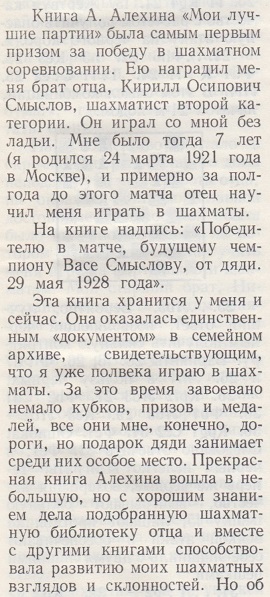
В поисках гармонии (Moscow, 1979), page 5
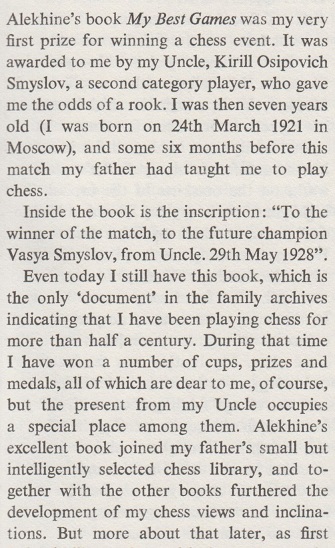
125 Selected Games (Oxford, 1983), page 1
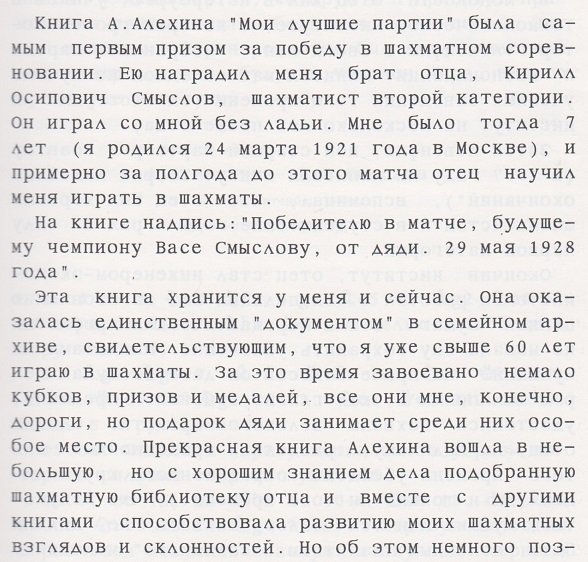
Летопись шахматного творчества (Moscow, 1993), page 7
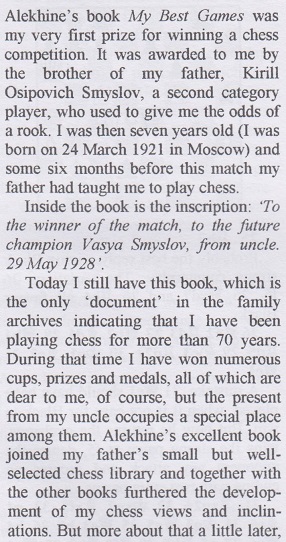
Smyslov’s Best Games, volume one (Olomouc, 2003), page 5.
The first English translation was by P.H. Clarke, and the other two were by Kenneth P. Neat.
The Russian translation of Alekhine’s first Best Games volume was published in 1927, mentioning a print-run of 5,000 copies. The second edition (1928) stated that 7,000 copies were printed.
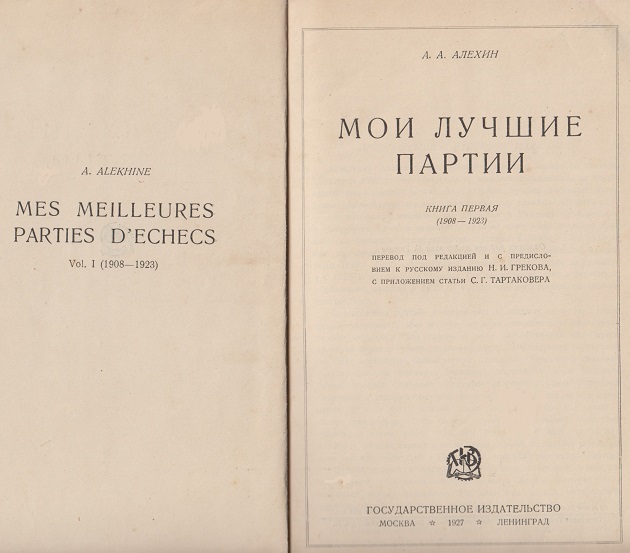
Notwithstanding the text opposite the title page, Alekhine’s book did not appear in French until 1936 and was not entitled Mes meilleures parties d’échecs. See C.N.s 4436 and 4439.
(11385)
A wild claim on page 96 of Le grand livre des échecs by Camil Seneca and Adolivio Capece (Paris, 1977):
‘Quand la Seconde Guerre mondiale éclata, Alekhine, étant naturalisé français, fut appelé sous les drapeaux et engagé dans les services secrets, surtout parce qu’il parlait et écrivait parfaitement dix langues!’
(11410)
In the fourth item below, from page 69 of Das Spiel der Könige by Alfred Diel (Bamberg, 1983), the unsourced ‘Einmal’ remark about languages which is attributed to Alekhine has no reference to French:
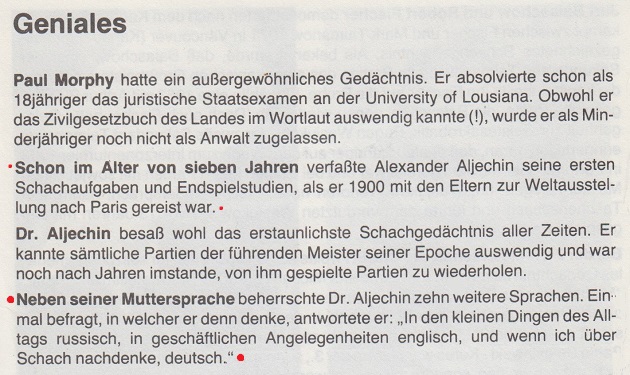
When C.N. 1160 discussed the book, unenthusiastically, mention was made of the peculiar claim in the second item, about Alekhine and the 1900 Paris Exposition.
(11414)
Regarding the large number of languages allegedly mastered by Alekhine, C.N. 8950 showed the following from page 171 of CHESS, May 1946:
‘Alekhine’s culture and intelligence were extraordinary. He was an exceptionally well-read man and had really fluent command of about ten different languages.’
As related in C.N. 8950, there has been confusion as to who wrote those words.
The CHESS article also appears to be the original source of two widely-quoted remarks ascribed to Alekhine: ‘I dominate them all’ (in 1940, concerning masters of his own generation) and ‘I cannot conceive that nothing should be left of me after my death’.
(11432)
A game annotated by Harry Golombek on page 60 of the ‘special Alekhine number’ of the BCM, March 1956:
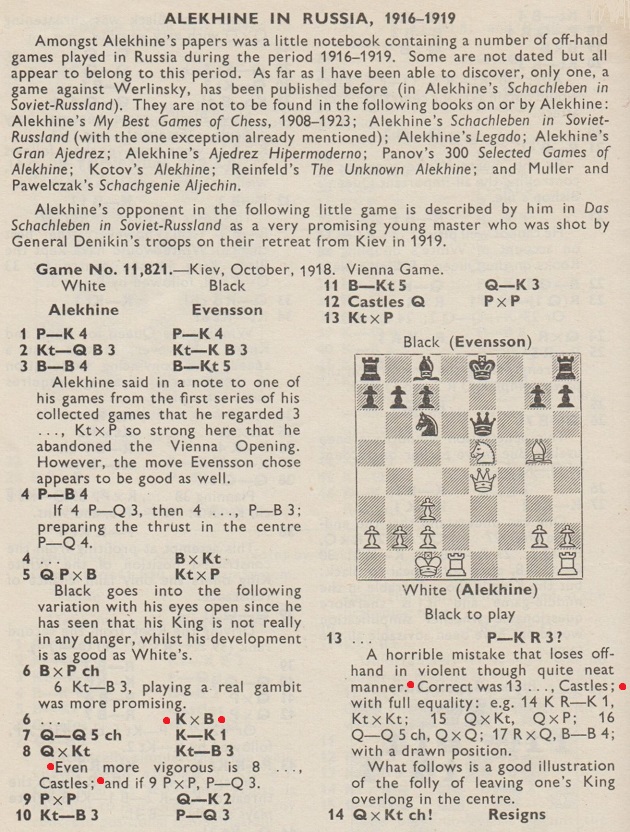
1 e4 e5 2 Nc3 Nf6 3 Bc4 Bb4 4 f4 Bxc3 5 dxc3 Nxe4 6 Bxf7+ Kxf7 7 Qd5+ Ke8 8 Qxe4 Nc6 9 fxe5 Qe7 10 Nf3 d6 11 Bg5 Qe6 12 O-O-O dxe5 13 Nxe5 h6 14 Qxc6+ Resigns.
A follow-up item by Golombek on pages 104-105 of the April 1956 BCM:
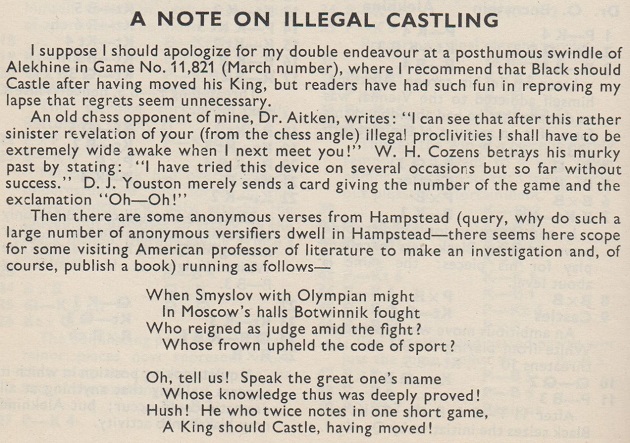

(11508)
See Castling in Chess.
Olimpiu G. Urcan provides page 17 of Diario de la Marina, 5 November 1927:
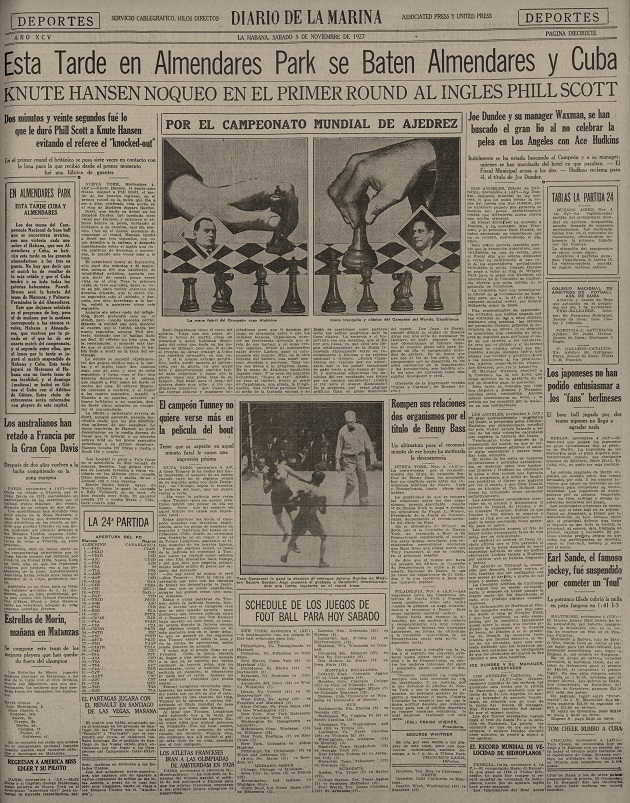
(11564)
Marcel Klemmer (Bad Segeberg, Germany) raises the subject of a famous early photograph of Alekhine and Capablanca, of which a colourized version can be found on the Internet, and asks who the figure on the left is:
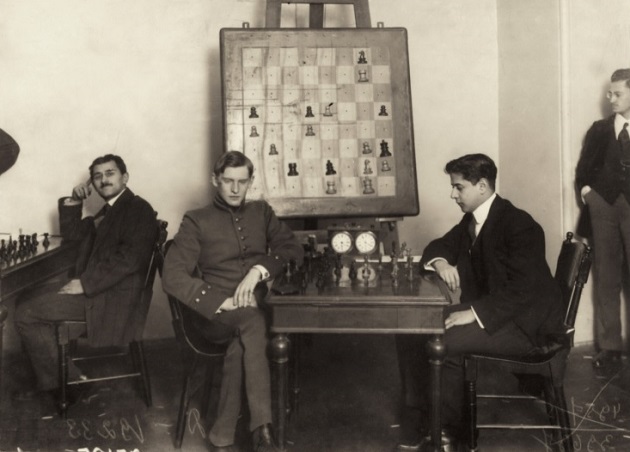
The above is the best-quality version of the photograph available to us, and readers’ assistance in identifying the figures on the far left and far right will be appreciated.
The demonstration board shows the final position in the first over-the-board encounter between the future world champions, an exhibition game played in St Petersburg on 14 December 1913; see pages 11-12 of Hooper and Brandreth’s The Unknown Capablanca. Our monograph on the Cuban had a small version of the photograph, cautiously captioned ‘St Petersburg, 1913/14’.
I. and V. Linder gave the picture in their Russian-language books on Capablanca (2005, page 183) and on Alekhine (2006, page 228), but whereas the former stated that the occasion was their first over-the-board meeting (i.e. in 1913), the latter asserted that it was their first tournament game, at St Petersburg, 1914 (an event which began in April):
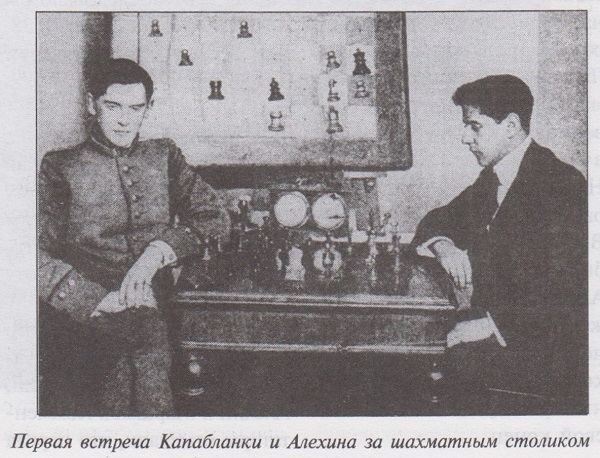
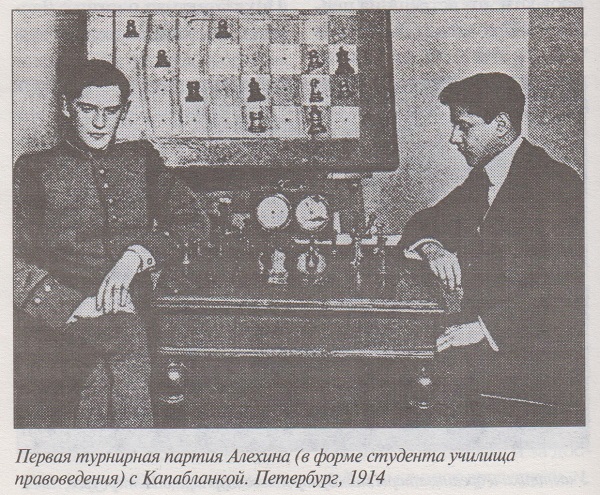
When the Linders reproduced the photograph again, in 2011, on page 45 of another book on Capablanca, the date went back to 1913:
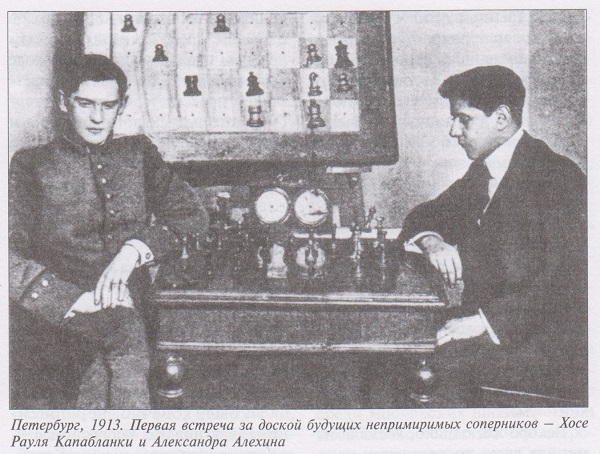
A figure standing on the right (also currently unidentified) is almost entirely visible in the version of the picture on page 38 of A.I. Sizonenko’s 1988 volume on the Cuban:
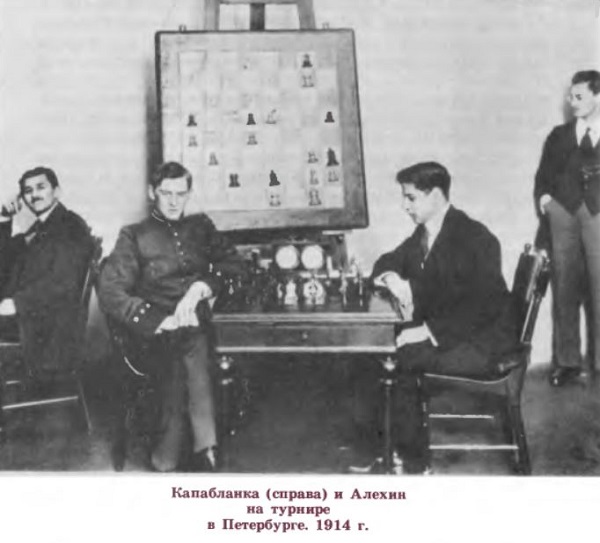
Similarly, on page 77 of a 1992 book on Alekhine by Y. Shaburov:
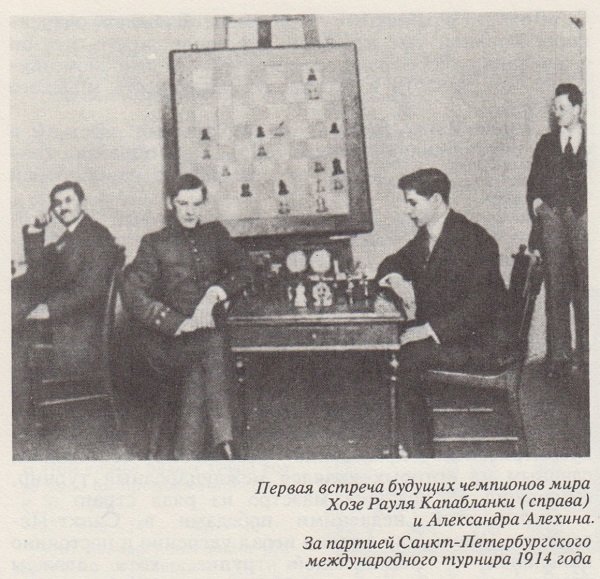
For bibliographical details concerning all these works, see Books about Capablanca and Alekhine.
Did the photograph appear in any Russian publications of the time, and, to reiterate our German correspondent’s enquiry, can the player on the left be positively identified?
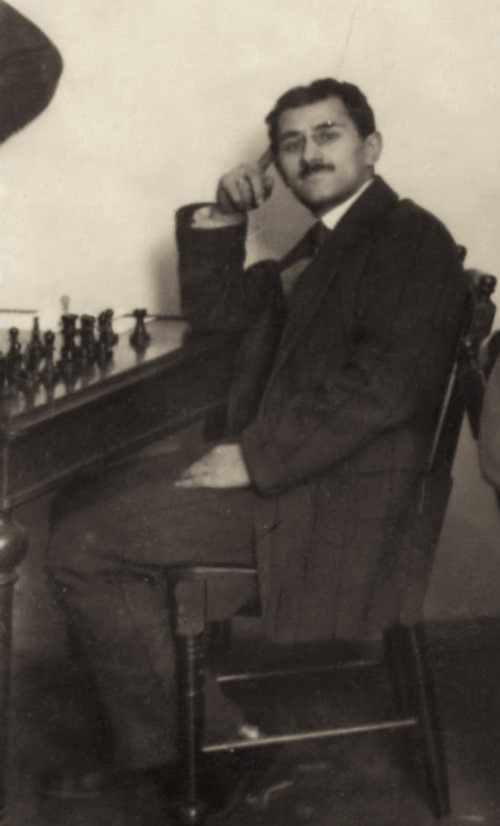
(11577)
A detail of the board position:
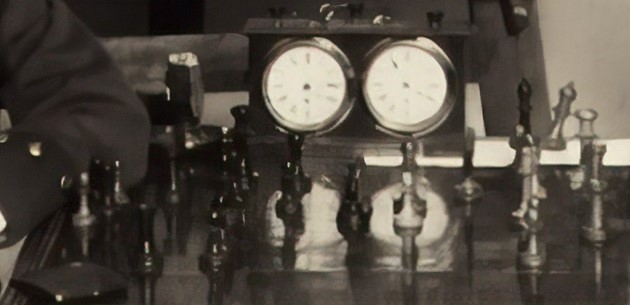
The position depicted occurred around move 18 in the Capablanca v Alekhine exhibition game (St Petersburg, 14 December 1913) mentioned in C.N. 11577.
(11581)
Yuri Kireev and Mikhail Sokolov (Moscow) send this early publication of the Alekhine v Capablanca photograph, on page 8 of the 50/1913 issue of the weekly magazine Весь мир:
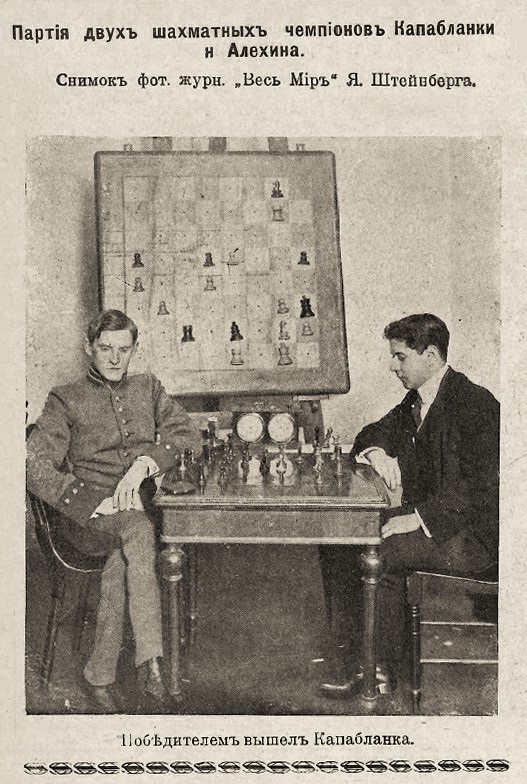
(11597)
In C.N. 11577 Marcel Klemmer asked whether the player on the far left could be identified.
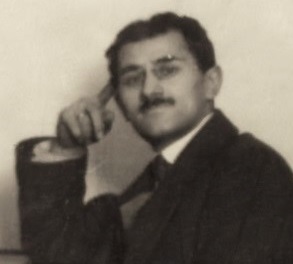
Colin Patterson (Cullercoats, England) has suggested Alexander Evenson, who won a tournament in St Petersburg in late 1913. For purposes of comparison, Yuri Kireev and Mikhail Sokolov (Moscow) have provided two group photographs:
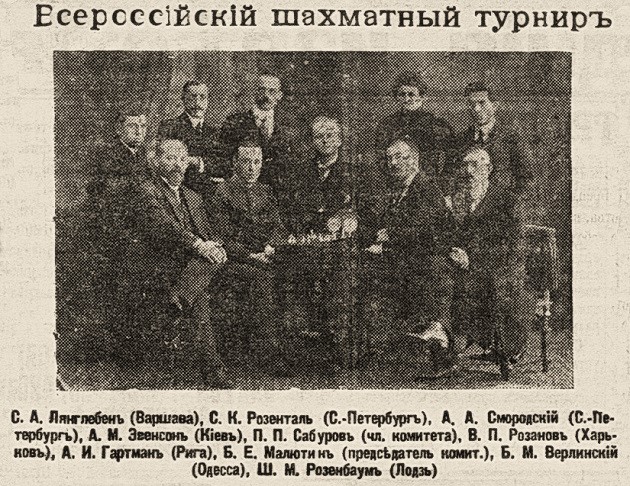
Source: Петербургская газета, 19 December 1913, page 4. Our correspondents clarify the caption as follows: Standing, from left to right: Verlinsky, Smorodsky, Rosenthal, Evenson, Rozenbaum or Gartmanis; Seated: Lyangleben, Rozanov, P.P. Saburov, Rozenbaum or Gartmanis, Malyutin.
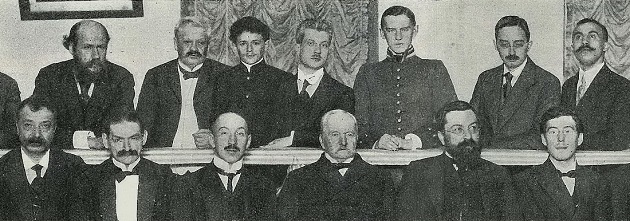
Source: Нива issue 7, 1914, page 4. Standing, from left to right: Levitzky, Alapin, Evenson, Flamberg, Alekhine, Gregory, Bogoljubow; Seated: Salwe, Sosnitsky, Malyutin, P.A. Saburov, Kutler, Levenfish.
(11710)
A recent addition to the Gallica website is a photograph of Alekhine watching a game between Lucienne d’Autremont [regarding ‘Lucienne’, see C.N. 11613] and Paulette Schwartzman. Page 950 of L’Echiquier, June 1928 referred to the presence of the world champion at that year’s French ladies’ championship in Paris:

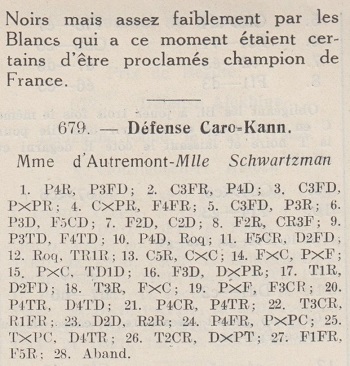
1 e4 c6 2 Nf3 d5 3 Nc3 dxe4 4 Nxe4 Bf5 5 Nc3 e6 6 d3 Bb4 7 Bd2 Nd7 8 Be2 Ngf6 9 a3 Ba5 10 d4 O-O 11 Bg5 Qc7 12 O-O Rfe8 13 Ne5 Nxe5 14 Bxf6 gxf6 15 dxe5 Rad8 16 Bd3 Qxe5 17 Re1 Qc7 18 Re3 Bxc3 19 bxc3 Bg6 20 h4 Qa5 21 g4 h5 22 Rg3 Kf8 23 Qd2 Ke7 24 f4 hxg4 25 Rxg4 Qh5 26 Rg2 Qxh4 27 Bf1 [sic] Be4 28 White resigns.
The Gallica database also has two general shots (first; second) of the tournament.
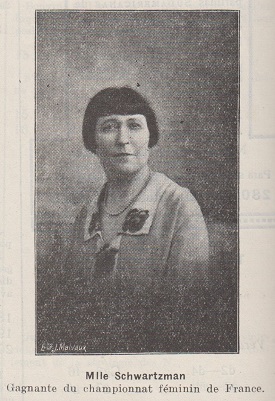
L’Echiquier, July 1928, page 970
(11602)
Dominique Thimognier notes that the Gallica website erred by giving the forename ‘Lucienne’:
‘Jeanne d’Autremont, who was born in Brest on 24 May 1899 and died in Paris (7th arrondissement) on 4 November 1979, was customarily referred to by her husband’s forename, i.e. Mme Lucien d’Autremont. However, she was born Jeanne Marie Nancy de Martel. She married Lucien Bridet d’Autremont in 1926.’
Our correspondent has provided her birth certificate (reproduction here not permitted).
(11613)
Tim Bogan (Chicago, IL, USA) submits a pair of quotations:
Page 112 of Training for the Tournament Player by M. Dvoretsky and A. Yusupov (London, 1993), in the chapter ‘Studying the Classics’ by M. Shereshevsky;
Page 90 of Chess Training for Candidate Masters by A. Kalinin (Alkmaar, 2017). The paragraph reported on a 1979 speech by Petrosian.
A general remark about the latter book is that although the imprint page promises, ‘we will collect all relevant corrections on the Errata page of our website’, a start has yet to be made.
(11630)
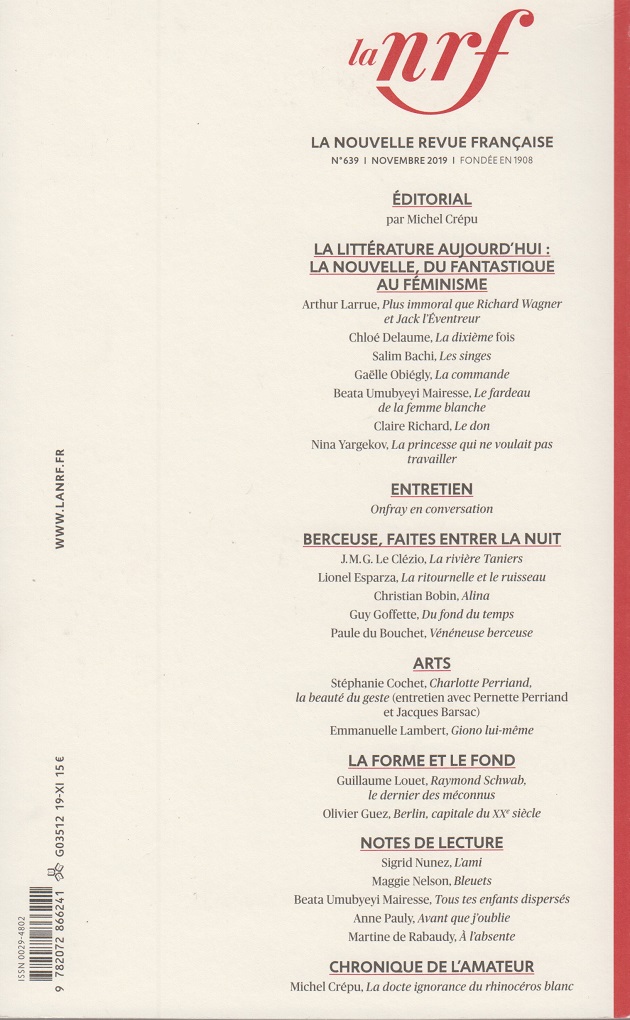
Arthur Larrue (Lisbon) informs us that a short story that he has written about Alekhine, as well as Tartakower and Najdorf, set in Buenos Aires, September 1939, has been published on pages 15-30 of the November 2019 issue of La nouvelle revue française.
The title, ‘Plus immoral que Richard Wagner et Jack l’Eventreur’, is adapted from a grossly misjudged remark about Alekhine by Harold Schonberg quoted in The Games of Alekhine.
(11653)
Addition on 13 March 2021 to Chess and Fiction:
Editions Gallimard (Paris) has just published a novel entitled La diagonale Alekhine by Arthur Larrue, a 285-page paperback:
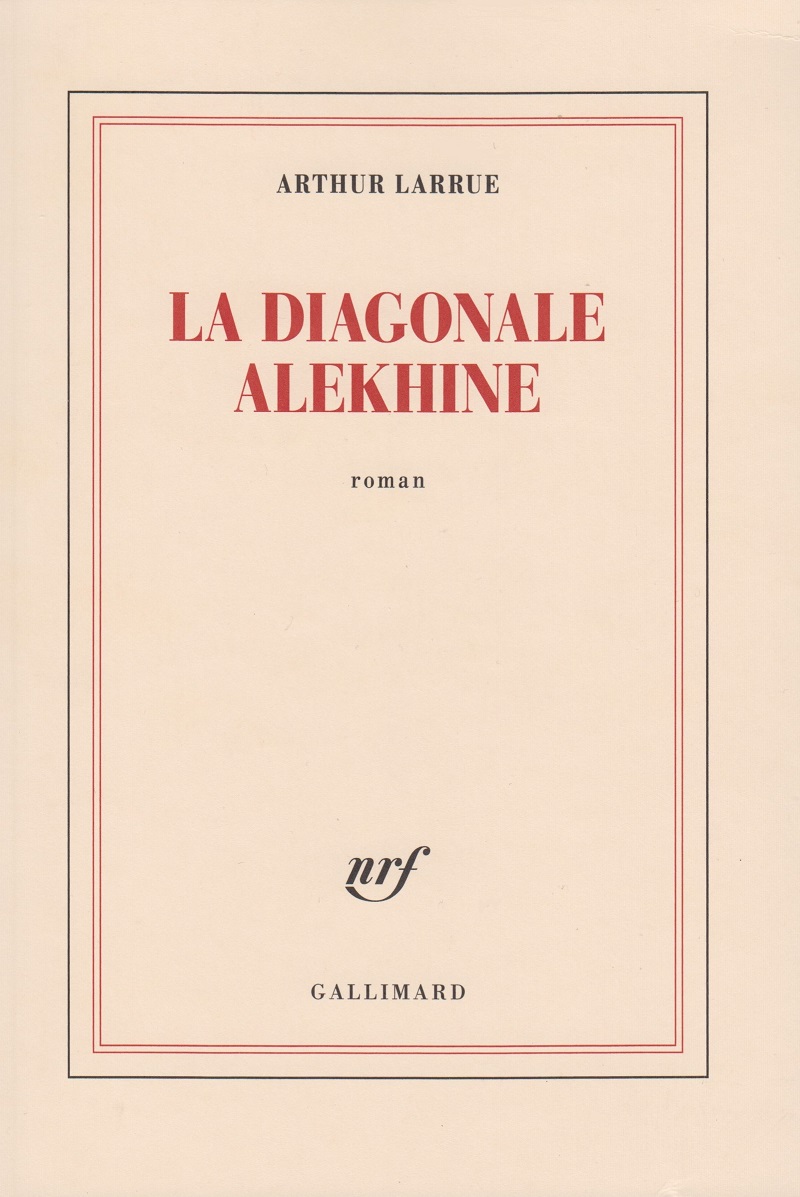
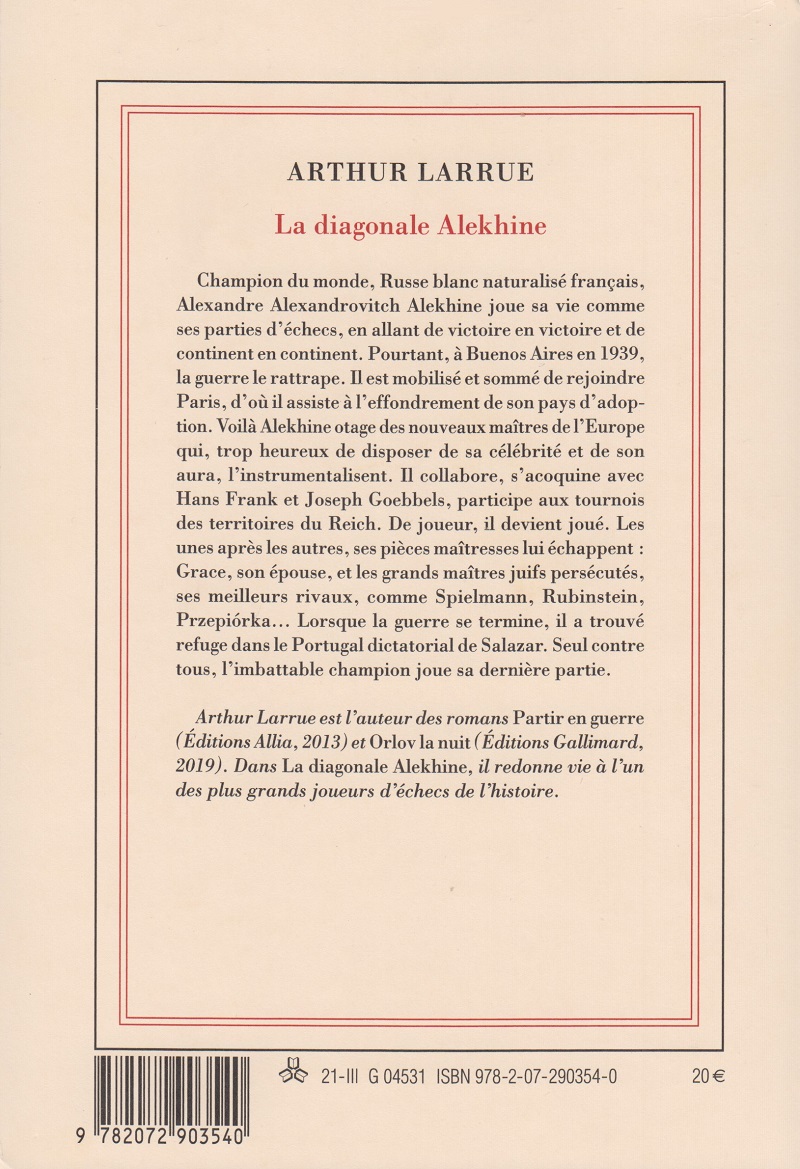
The Introduction (page 5) to Play Like a World Champion José Raúl Capablanca by Bill Jordan (‘Amazon Fufillment’, Wroclaw, 2019) begins with a paragraph which was considered good enough to reproduce on the back cover:

(11664)
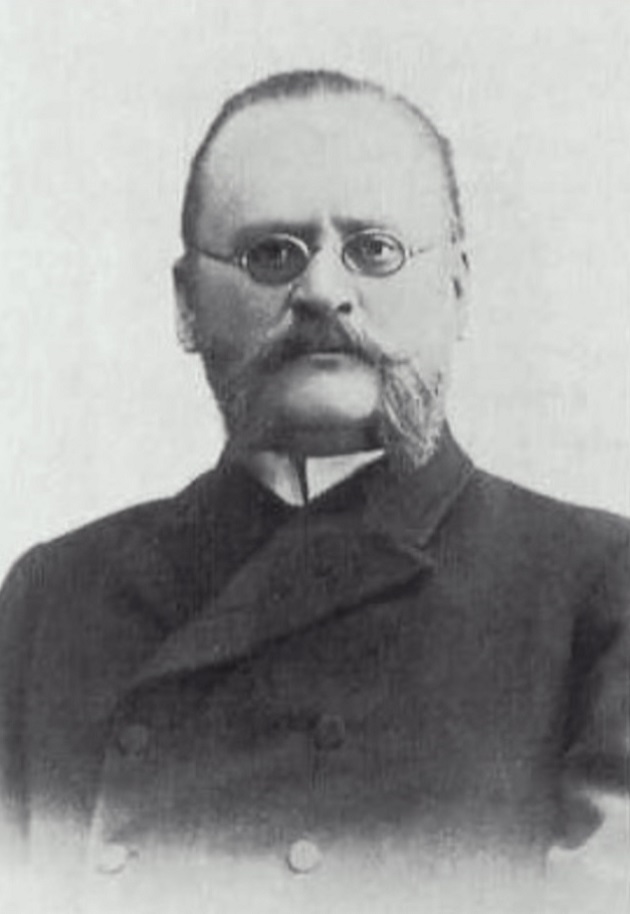
Permission from Alamy.com for us to reproduce this photograph of Alexander Ivanovich Alekhin (1856-1917) has been obtained by Olimpiu G. Urcan.
(11672)
Mr Urcan has provided a second portrait, courtesy of the Voronezh Regional Museum’s collection:
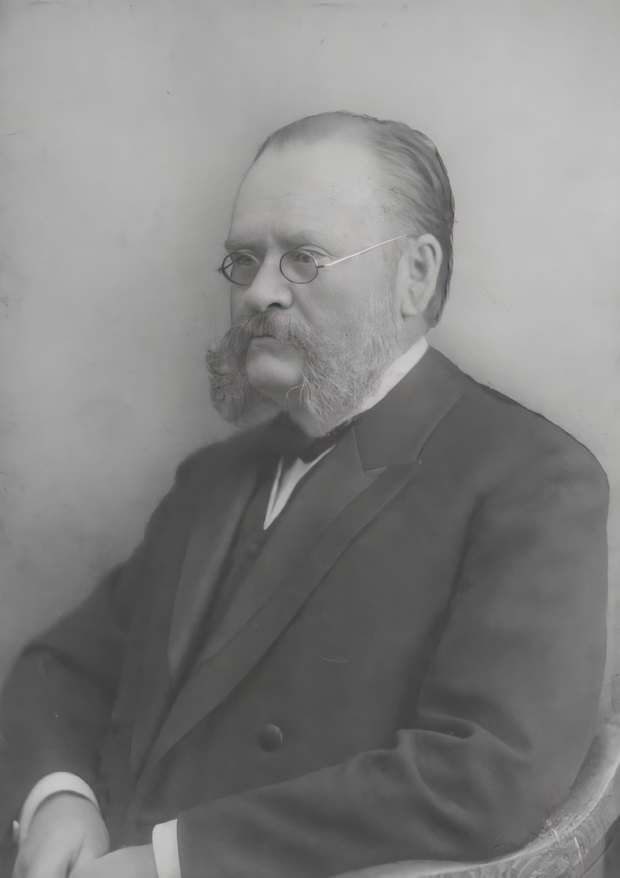
Page 3 of Crítica, 17 September 1927:
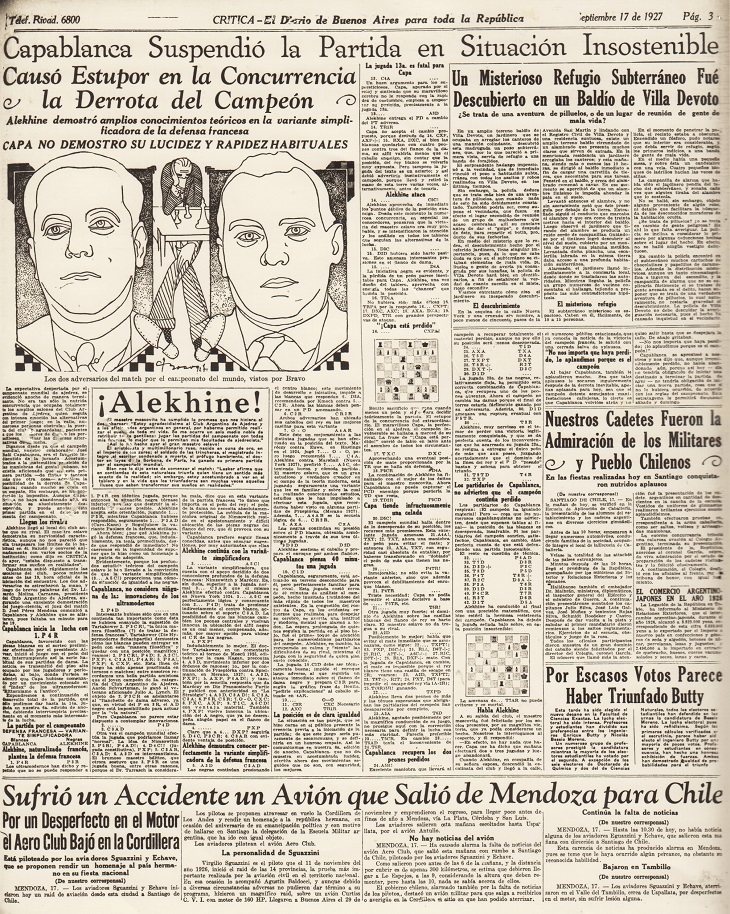
(11808)
As it would not otherwise be on-line, C.N. 2681, from July 2002, is reproduced here:
Pages 89-90 of L’Echiquier, May 1926 gave the game Alekhine v Réti, Semmering, 1926. Our copy is inscribed in ink by Réti, who added in pencil three proposed improvements to his play: 8…Kh7, 15…a5 and 21…f5. Only the second of these suggestions was mentioned in Alekhine’s On the Road to the World Championship 1923-1927.
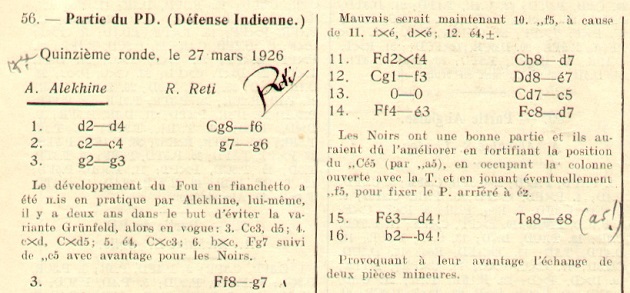
(11826)
Bernd Schneider (Solingen, Germany) recently auctioned a book which had, as its frontispiece, a photograph of Alekhine that seemed new to us. Is any information available about the picture (absent from our copy of the Dutch edition)?
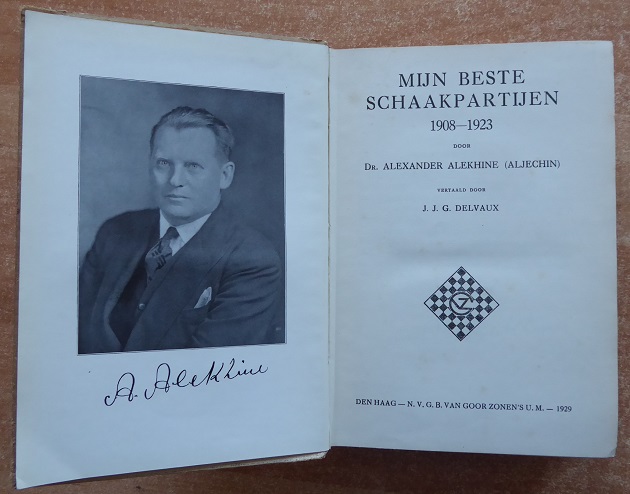
(11930)
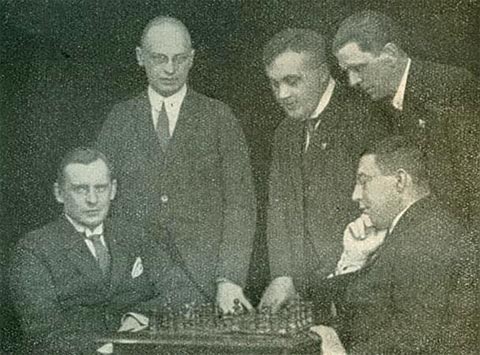
This picture was given by us in a Chess Mysteries article at ChessBase.com on 20 November 2007 with this brief information:
The photograph above shows Alekhine at the board with Rubinstein (watched by Tartakower, Bogoljubow and Maróczy). It is taken from Tartakower’s book Die Hypermoderne Schachpartie, published in the mid-1920s, and the credit reads ‘Friedmann, Wien’. Can a better copy of the picture be found?
Now, Philip Jurgens (Ottawa, Canada) asks whether anything further has come to light. Unfortunately not, to our knowledge.
(11948)
Florin Dănănău (Bucharest) supplies the following, page 4 of Ilustrațiunea Română, January 1936:
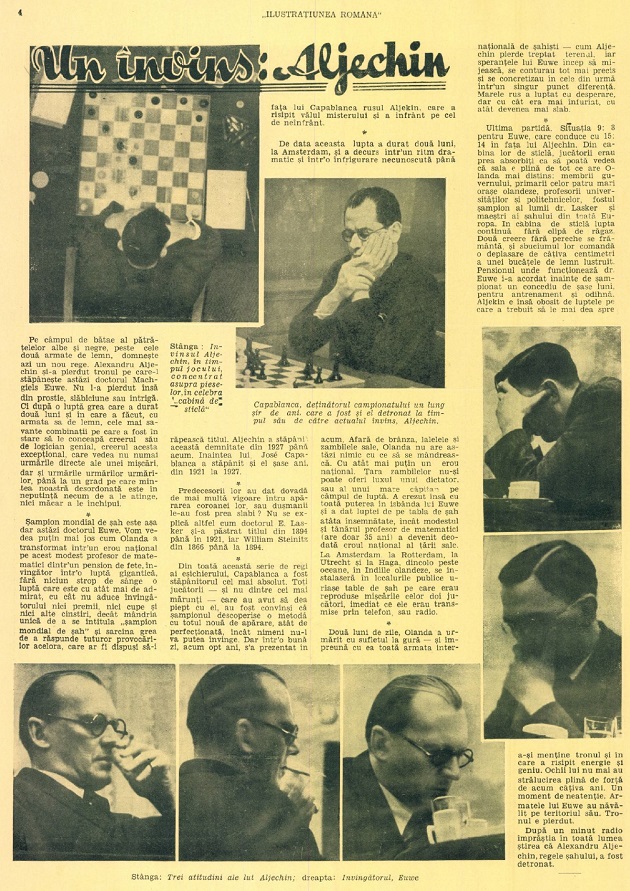
(11949)
From page 161 of The Unknown Capablanca by David Hooper and Dale Brandreth (London, 1975):
‘One is reminded of a remark made by Sir George Thomas, “Against Alekhine”, he said, “you never knew what to expect; against Capablanca you knew what to expect, but you couldn’t prevent it!”’
From page 77 of Capablanca’s Best Chess Endings by Irving Chernev (Oxford, 1978):
‘Capablanca’s clear-cut play in this ending calls to mind a comment by Sir George Thomas, “Against Alekhine you never knew what to expect; against Capablanca you knew what to expect, but you couldn’t prevent it!”’
(11976)
No pre-1975 source for this remark has yet been found.


A remark by Euwe in an interview (CHESS, September 1981, page 199):
‘Alekhine may have hoped the Germans would win because he owned several houses in Leningrad. As things went, he lost everything …’
Information about the Leningrad matter will be appreciated.
(12064)
From page 2 of the Brooklyn Daily Eagle, 10 March 1930:

(12103)
Juan Carlos Sanz Menéndez (Alcorcón, Spain) draws attention to page 51 of the Bultlletí de la Federació Catalana D’Escacs, March-April 1935:
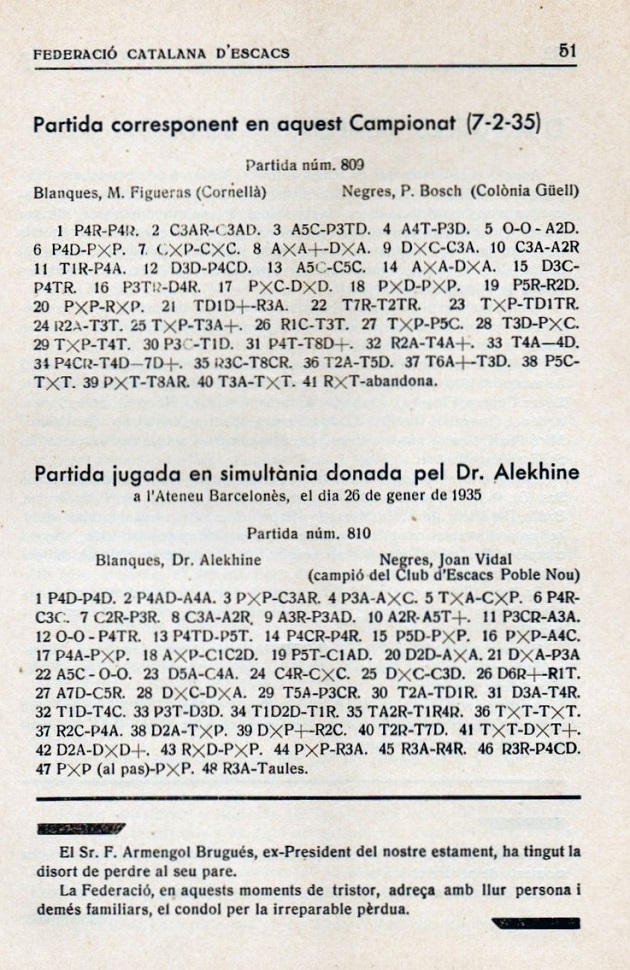
The Alekhine game against Joan Vidal played in Barcelona on 26 January 1935:
1 d4 d5 2 c4 Bf5 3 cxd5 Nf6 4 f3 Bxb1 5 Rxb1 Nxd5 6 e4 Nb6 7 Ne2 e6 8 Nc3 Be7 9 Be3 c6 10 Be2 Bh4+ 11 g3 Bf6 12 O-O h5 13 a4 h4 14 g4 e5 15 d5 cxd5 16 exd5 Bg5
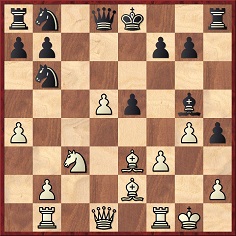
17 f4 exf4 18 Bxf4 N8d7 19 a5 Nc8 20 Qd2 Bxf4 21 Qxf4 f6 22 Bb5 O-O 23 Qf5 Nc5 24 Ne4 Nxe4 25 Qxe4 Nd6 26 Qe6+ Kh8 27 Bd7 Ne4 28 Qxe4 Qxd7 29 Rf5 g6 30 Rf2 Rae8 31 Qf3 Re5 32 Rd1 Rg5 33 h3 Qd6 34 Rdd2 Re8 35 Rfe2 Ree5 36 Rxe5 Rxe5 37 Kg2 f5 38 Qf2 Rxd5 39 Qxh4+ Kg7 40 Re2 Rd2 41 Rxd2 Qxd2+ 42 Qf2 Qxf2+ 43 Kxf2 fxg4 44 hxg4 Kf6 45 Kf3 Ke5 46 Ke3 b5 47 axb6 axb6 48 Kf3 Drawn.
Our correspondent adds the report on the event on page 1782 of Els Escacs a Catalunya, February 1935:
‘Aquesta vegada ha efectuat dues session: la primera tingué lloc el dia 26 a dos quarts d’onze de la nit en l’Ateneu Barcelonès, on es congregà una veritable multitud freturosa de seguir les incidències de la sessió. Varen ésser-li oposat a 43 jugadors de diverses categories i a dos quarts de sis de la matinada, després de set hores consecutives de joc, acabà la sessió amb el resultat de 33 partides guanyades, quatre empatades i sis de perdudes (+ 33 =4 –6). Els vencedors foren: Claret (Manresa), Dr. Julià (R. López), Vivet (Caixa de Pensions), Sererols (Comtal), Morera i Mansoso (Terrassa). Els qui empataren foren : Vidal (P. Nou), Mestres (Terrassa), Abrahams (Barcelona) i Serra Vinyes (Badalona).’
(12115)
Christian Sánchez writes:
‘Successive editions of Who’s Who present the evolving, succinct autobiography of their subjects. Through Alekhine’s entries, we can trace the timeline of significant events in his life: when he became a grandmaster, considered himself a challenger, claimed to have earned his doctorate in law, married, moved home and, even, took up bridge.
Below, firstly, is his entry on page 29 of Who’s Who 1926 (London, 1926):
“ALEKHINE, (Aljechin) Alexander, chess master, writer, and at present, student of Paris University, for Law Doctorate; b. Moscow, 1 Nov. 1892; s. of A. Alekhine, Maréchal de Noblesse of Voronej’s Government Nobility, and Member of the Douma, and A. Prokoroff, d. of the Moscow Industrial Magnate. Educ.: the Imperial High Law School for Noblemen, the Pravovedenie, Petrograd. After taking his law degree in 1914, entered the Foreign Office; his career was interrupted by the Revolution, when he emigrated to France; served voluntarily in the Great War as Red Cross representative at the front (Sign of the Red Cross, the Military Cross of St Stanislas, and the St George’s Cross); as chess player he got the title of Master at the age of sixteen, 1909, and the title of Great Master in 1914; has to his credit more than twenty international Tournaments, and holds the world’s record for Blindfold Chess (New York 1924, and Paris 1925); challenger of Capablanca for the World’s Championship in chess. Publications: Chess in Soviet Russia, 1921; New York Tournament Book, 1924; Hastings Tournament Book, 1922; publications in French and foreign periodicals; My Best Hundred Games. Recreations: riding, canoeing, tennis. Address: 211 rue de la Croix-Nivert, Paris XV.”
Changes or additions in subsequent editions:
1927: –;
1928: “Doctor of Law of Paris University; m. Nadejda Fabritsky, widow of General V. Vassilieff; [My Best Hundred Games], 1908-1923; N.Y. Tournament Book, 1927.”
1929: “Chess Champion of the World since 1927; My Best Games of Chess, 1927.”
1930: –;
1931: “Defended his title successfully 1929; Produced a World’s record score in San Remo Tournament, 1930; bridge.”
1932: –; 1933: –
1934:“on visiting Iceland, made Knight of the Order of Falcon; On the Way to the World Championship, 1932; ping pong.”1935: “m. Grace Wishaar, widow of Captain Archibald Freeman; [Blindfold Chess] Chicago 1933; [Defended his title successfully 1929] and 1934; Le Château, St. Aubin-le-Cauf, Seine Inférieure, France.”
1936: –
1937: “[Chess Champion of the World], 1927-35; on visiting French Africa was made Commandeur of the Nichum Iftikar (sic: Nichan Iftikhar) and Knight of the Ouissan Alaouit (sic: Ouissam Alaouite); Zürich Tournament Book, 1934.”
1938: “Nottingham Tournament Book, 1936; Deux Cents Parties d’Échecs, 1937.”
1939: “Chess Champion of the World; won the world’s Title from J.R. Capablanca in 1927; defended it successfully in 1928 [sic] and 1934; lost it against Dr Euwe in 1935 and regained it from him in 1937; London Tournament Book, 1932.”
1940: –; 1941: –; 1942: –; 1943: –; 1944: –; 1945:–
1946: Obituary: 24 March 1946. Shown in C.N. 9316.’
(12119)
From the ‘William Hickey’ column in the Daily Express, 13 June 1933, page 6:
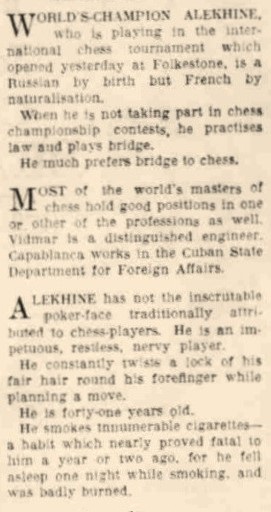
‘He much prefers bridge to chess’ seemingly comes from nowhere. The alleged fire incident mentioned in the final paragraph was discussed in C.N.s 5169 and 10859. See Chess and Bridge and Chess and Tobacco.
(12181)
On some chess outlets, the kneejerkerati are ever poised to comment on the colour of h1 in any photograph or video clip. ‘They got the board the wrong way round!’ If h1 is disappointingly white, the opportunity to air an observation is not lost: ‘At least they got the board the right way round!’ See C.N. 11471.
Olimpiu G. Urcan has forwarded a number of photographs, and firstly this shot of Alekhine (acknowledgement: the Crítica archive):
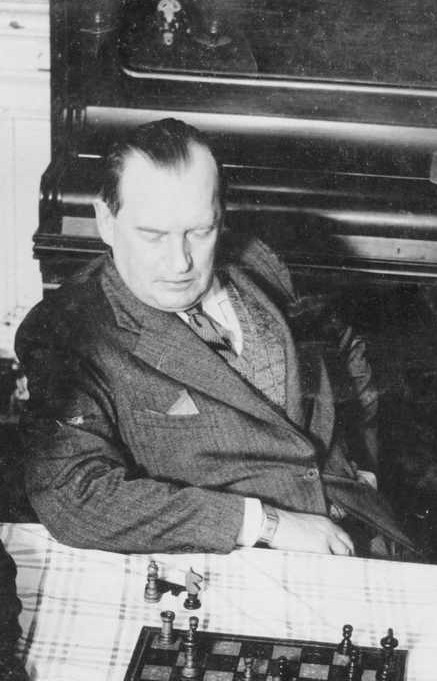
The apparent presence of pawns on White’s first rank is notable but simply explained: given that in photographs of Alekhine his wristwatch, breast pocket and (where applicable) hair parting are, or should be, on the left, the above photograph is a mirror image. Moreover, he was spectating, not playing.
The full photograph, provided by Mr Urcan from the Crítica archive and reversed below, shows the world champion watching a game between two members of Argentina’s team in the 1939 Olympiad in Buenos Aires, Roberto Grau and Luis Piazzini:
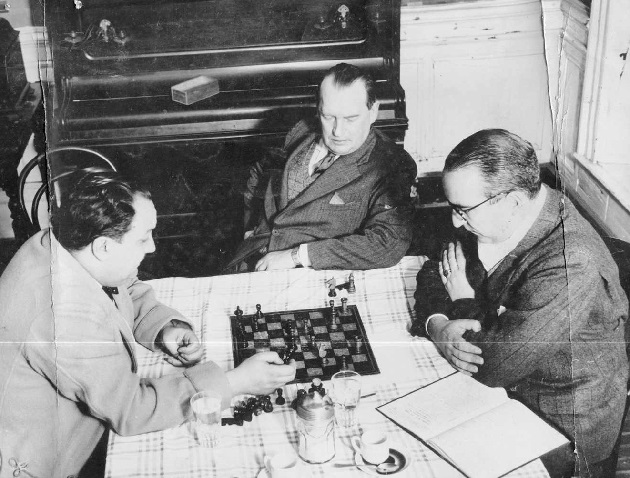
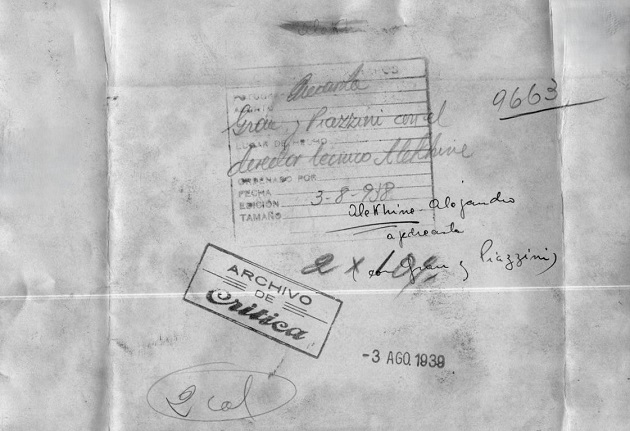
(12182)
The present general article on Alekhine complements the following more specific feature articles, and very little material from them has been duplicated here:
When Was Alekhine Born?
The Alekhine v Nenarokov Hoax
An Alleged Alekhine v Capablanca Position
An Alekhine Blindfold Game
Réti v Alekhine, Baden-Baden, 1925
‘The Immortal Blindfold Game’
Capablanca v Alekhine, 1927
A Fake Chess Photograph
Confusion over Alekhine v Najdorf
Alekhine on Carlsbad, 1929
Seven Alekhine Articles
Alekhine’s Gun
An Alekhine Miniature
Alekhine v Kimura, Tokyo, 1933
Euwe and Alekhine on their 1937 Match
Alekhine on Munich, 1941
Two Alekhine Interviews (1941)
Alekhine Renaissance
Alekhine and Alcohol
Was Alekhine a Nazi?
Mysteries at Sabadell, 1945
Alekhine’s Death
Interviews with Alekhine
Books about Capablanca and Alekhine
The Games of Alekhine
Articles about Alexander Alekhine
To the Chess Notes main page.
To the Archives for other feature articles.
Copyright: Edward Winter. All rights reserved.